For photographers who are assistants, something to note is how this ongoing job-to-job life can potentially take you off your own creative path. Our industry is one where the support staff can depend on intense job-to-job work with little time to focus on the original purpose of developing their own career. Remember why you are doing this; keep sight of valuable time and why you are doing what you are doing.
Latest Posts
Is It OK to Add Contacts to Your Mailing List Without Permission?Best Practices fro Creative Marketing Emails.


Q:
Is it ok to add people to your mailing list without asking, or should you only contact people who have given you their email address directly?
A:
People can always unsubscribe from your mailing list, so ensure there’s an option. Just make sure the work is applicable to the people you’re including. The key is to do your LinkedIn upkeep, ensuring your target clients fit your specialty.
Always Address A Person By Their Name In An Email
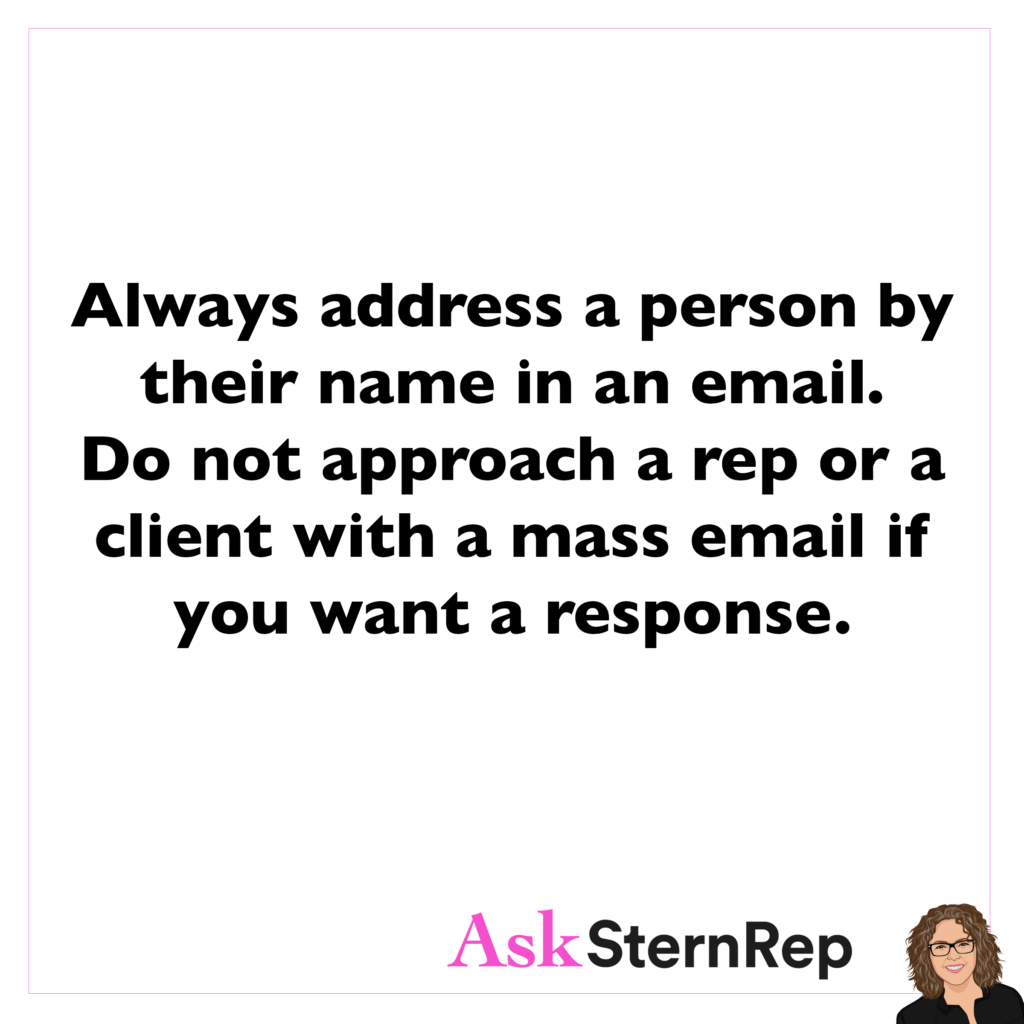
Always address a person by their name in an email. Do not approach a rep or a client with a mass email if you want a response.
Navigating Advance Payments for Big-Budget Photo Shoots


Q:
How do you navigate big corporations that are not paying advances upfront for big-budget shoots? Is it a deal breaker? Should a production company pay the upfront production expenses?
A:
Advances are extremely important but the one requirement I’d be flexible with is when we get the advance. It isn’t always before the job begins and if it’s a trusted company, I’m ok with that. If they don’t pay an advance I’d see it more as a red flag making me question if this was a trustworthy client I can rely on for payments.
Marketing Outreach Has No Set Plan For Success
Marketing outreach has no set plan for success, and we can take all those closed doors as a deterrent, or we can keep showing up—trying new ways, knowing the right moment could arise. But we must be actively out there; it’s up to us if we want the doors to open. Be in it to win it!
Should You Sign a Contract Without Promo Rights? How to Negotiate Fiar Usage Terms Without Losing the Job


Q:
I’m in the middle of negotiating a contract for a job I really want. The contract gives me no right to use the images for self-promotion, and effectively states that I could be sued for doing so.
Should I take the money and work on building the relationship, or should I fight for my rights at the risk of losing the gig?
A:
I would talk to your contact at the company and gauge their flexibility. Explain why you need to show this work in order to secure future opportunities.
Hopefully, they’ll be receptive to your concerns and willing to work with you on terms that are fair to all parties. At the very least, do your best to advocate what’s fair.
Our industry also benefits when we stand together on issues like this. I understand why you wouldn’t want to walk away from the job over this, but asking for what you need (in a respectful way) shouldn’t cost you the job.
Ask For Help And Delegate

Ask for help and delegate. If there’s something you don’t know how to do, Google it, search forums, ask a colleague, or reach out to an expert in the field. You’ll be surprised by how many people are willing to help. There is an abundance of resources at your fingertips.
Licensing Images For Social Media Platforms For Small Restaurants


Q:
Have you found a way to justify licensing images for social media platforms for small restaurants? Is this even a thing for businesses notorious for thin margins?
A:
Licensing images is needed for any usage, regardless of the budget or size of the business. What if that restaurant grows, or what if they share their images with other restaurants? Always make sure the contract is clear, and specifically show them how they can use the images only on social media (paid or owned platforms). We never know what will happen in the future, so it’s important to always protect yourself.
“Producer” Is One Of The Fastest Changing Bidding Roles
FACT: “Producer” is one of the fastest-changing bidding roles I’ve seen. Nowadays, jobs can come from producers, as clients hire them directly to do the bidding. Producers may also be one of the bidders on the job themselves, so it’s hard to track where we stand automatically. Refrain from anticipating or assuming anything about the structure when you hear the term – Producer.
“Authentic” Synonymous With “Cheap” Or “Low Production”
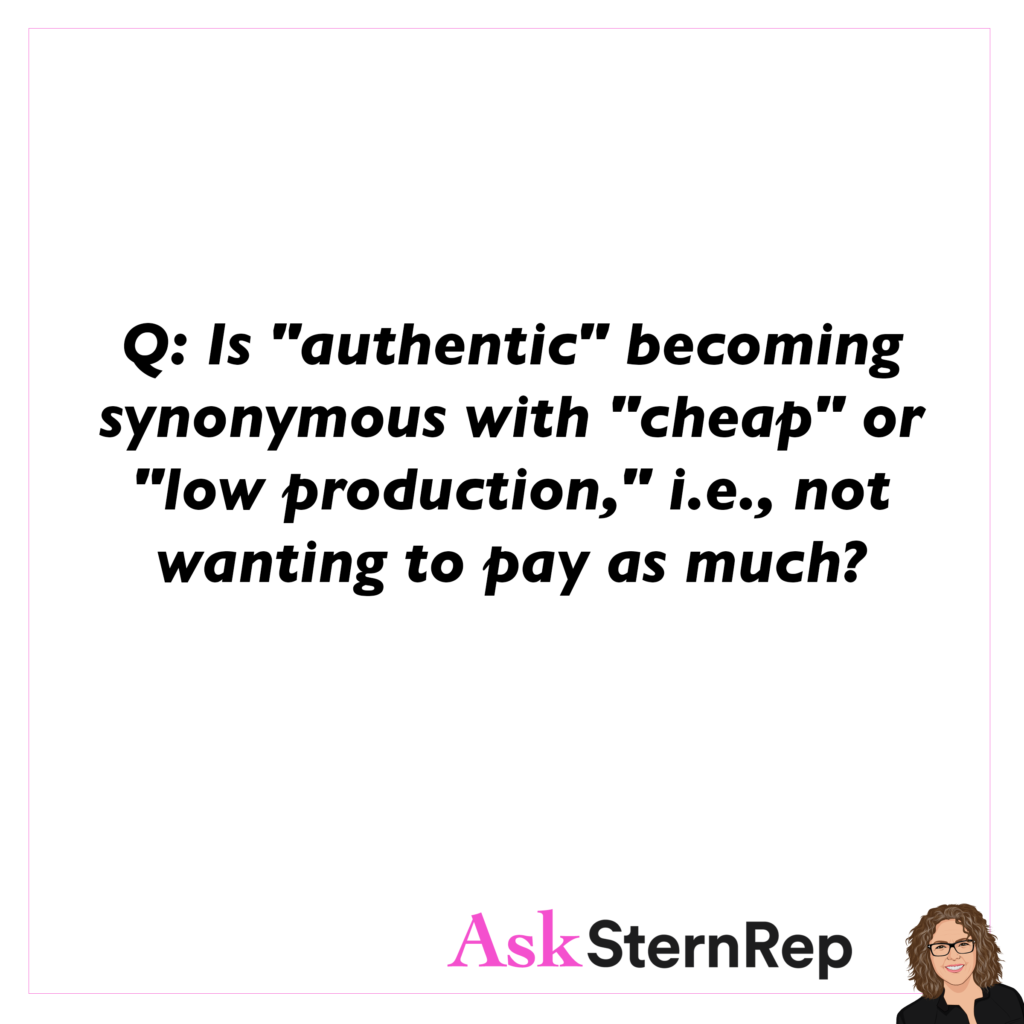
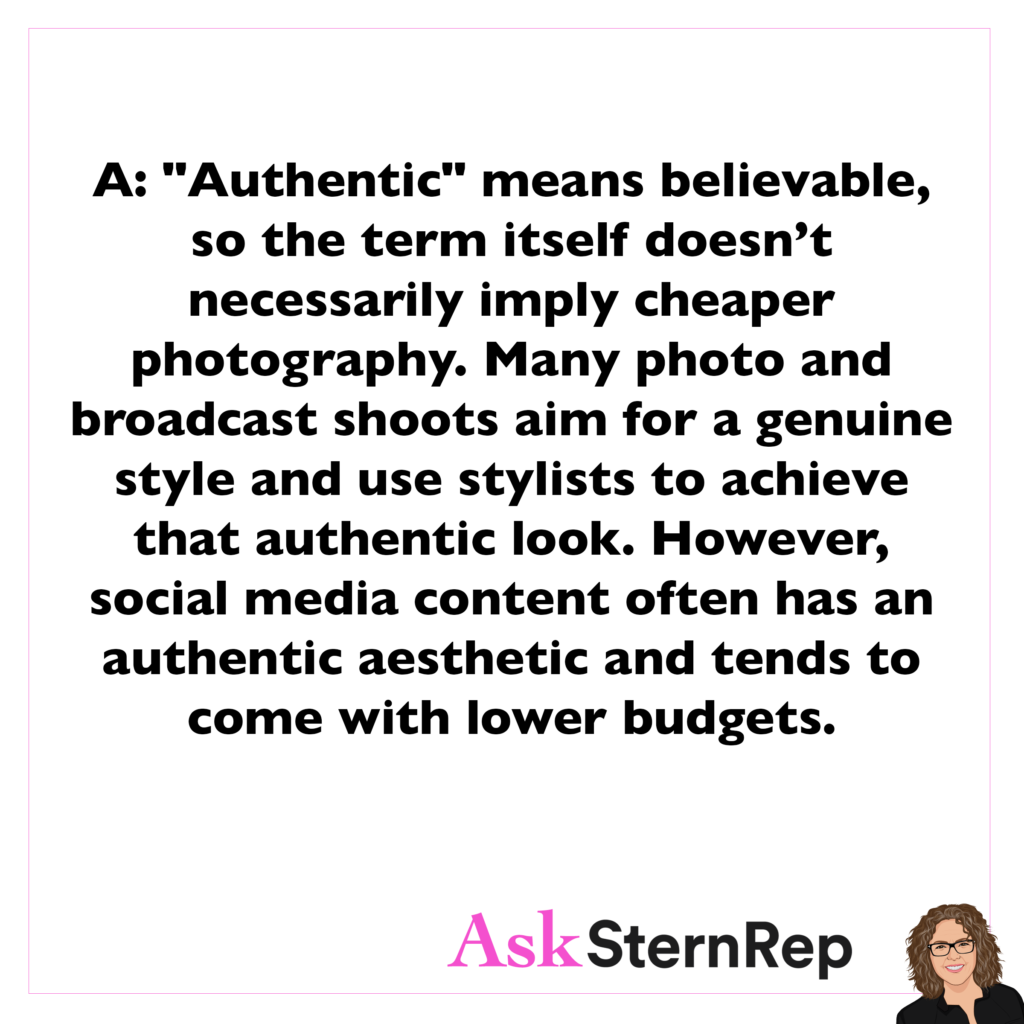
Q:
Is “authentic” becoming synonymous with “cheap” or “low production,” i.e., not wanting to pay as much?
A:
“Authentic” means believable, so the term itself doesn’t necessarily imply cheaper photography. Many photo and broadcast shoots aim for a genuine style and use stylists to achieve that authentic look. However, social media content often has an authentic aesthetic and tends to come with lower budgets.
Master Client Emails With Clear, Complete Communication

Always assume your client has less than one second for your email. Include any links they may already know. Write in full sentences that retrace the emails so they don’t need to scroll down and read old ones to understand. Speak in each email as if it’s the first one, gathering all the info. Unless of course you are responding immediately, then it can be quick “yes” or “no”, etc.
Photographers Being Content Creators


Q:
This may either be controversial or a matter of semantics, but what are your thoughts on photographers being ‘content creators’? It’s always made me feel cheapened, but maybe I’m just being stubborn?
A:
Personally, I see this issue as a financial one. If a client is paying appropriately for quality images you are proud to put your name on, that answers the question for me. “Content” is what most clients need these days, so not wanting to be a part of that could really limit your job opportunities. I’m curious to hear others’ opinions on this in the comments. What do you think?
Be Smart And Anticipate Your Clients’ Needs
Trick of the trade- be smart when needing quick answers from your clients! Fully spell out questions/topics without assuming clients remember the topic details. Unlike us, they usually have 5 or more other jobs happening simultaneously. Be the support staff, and understand their situation by repeating the details back to them with your full question so they don’t have to search through previous emails. Assume they are off-the-charts busy!
Highest-Yield Genre Of Work Right Now

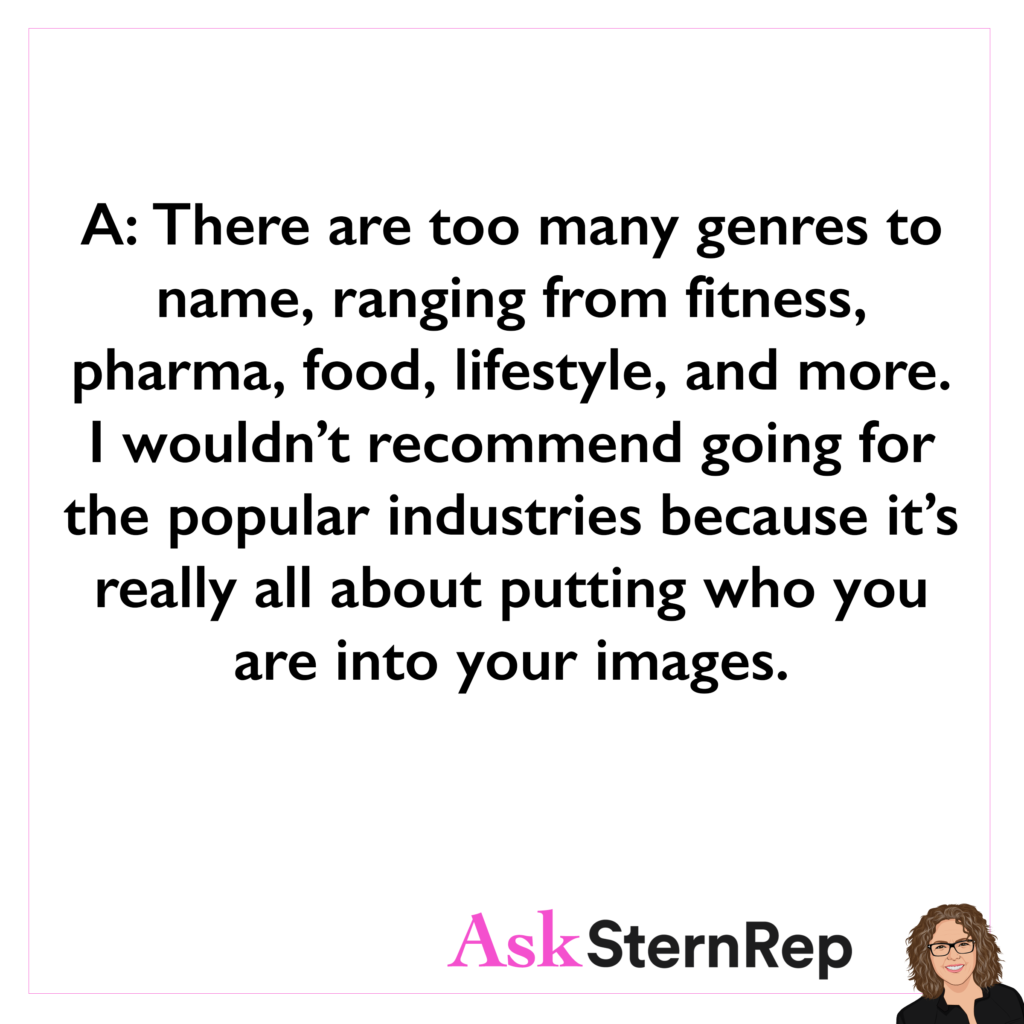
Q:
What is the highest-yield genre of work right now?
A:
There are too many genres to name, ranging from fitness, pharma, food, lifestyle, and more. I wouldn’t recommend going for the popular industries because it’s really all about putting who you are into your images.
What A Rep Needs From You

What a rep needs from you is something to say. Tests, new work, content, a story, anything to give us something to share about you.
Issues With Clients Giving Extensive Shot Lists


Q:
I’ve had issues this year with clients giving extensive shot lists. Due to time constraints, I’ve either had to do a free half-day reshoot to finish their list or missed key moments keeping track by cross-checking a list with a pen and paper. What wordage can I place in my contract to set better shot-list boundaries?
A:
Shot count lists have become secondary to clients and treated more casually in their bidding process. We must take responsibility for getting precise, specific shot counts upfront and setting limits and costs.
Here are some terms I’ve used:
- Bid based on a client-provided, exact shot list of up to 10 images, maximum, if time allows within a 10-hour day. No overtime is included in the bid.
- All costs are based on the information provided; any additional shots or changes may result in overages.
- No variations are included.
- Final image count and timing are based on immediate on-set or remote client approvals.
Being Realistic With Our Marketing Goals
SternRep’s IG Story last week hit the jackpot with specific client names viewing our story instead of the social media push for massive views. Let’s be realistic with our marketing goals, know who you are posting for, and make that happen. Getting several clients to see your work is a SCORE and WORTH your IG engagement time!
What Are The Best Ways Photographers Can Use Instagram?
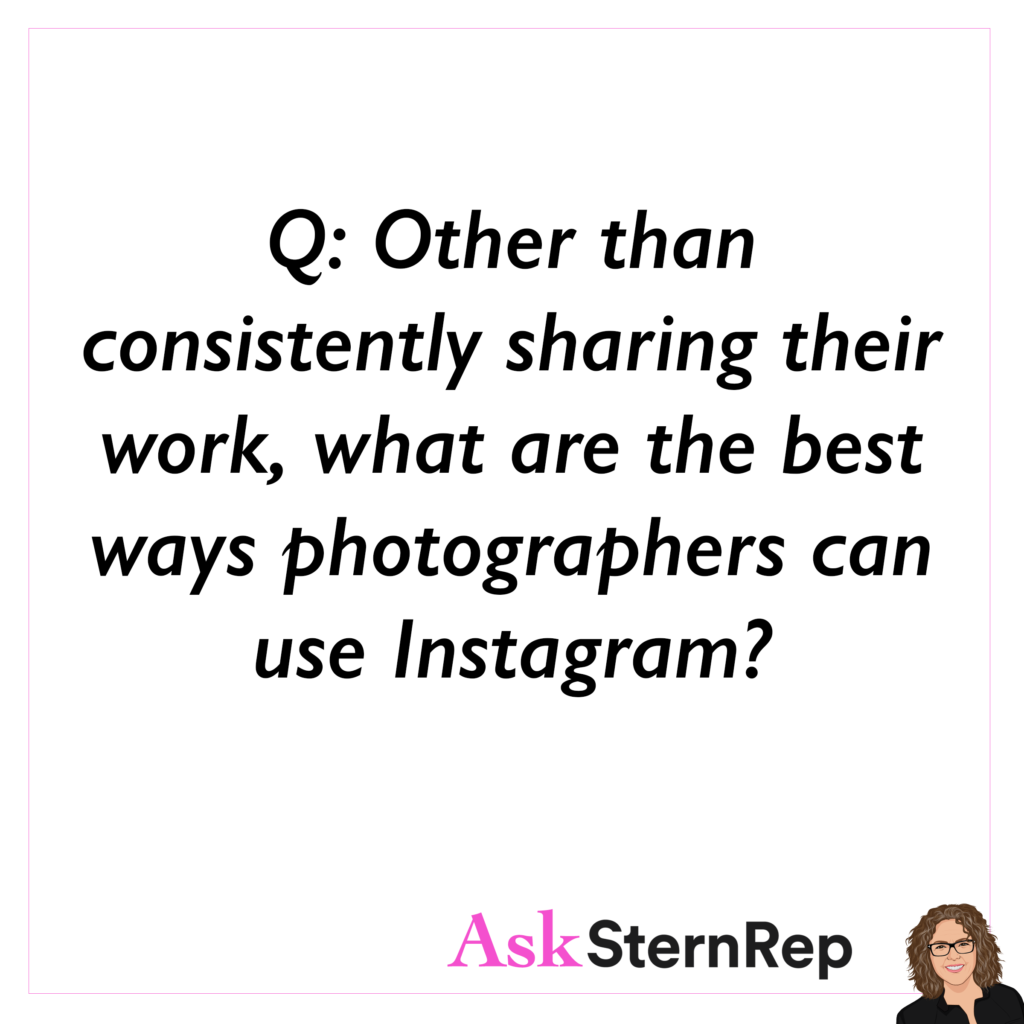
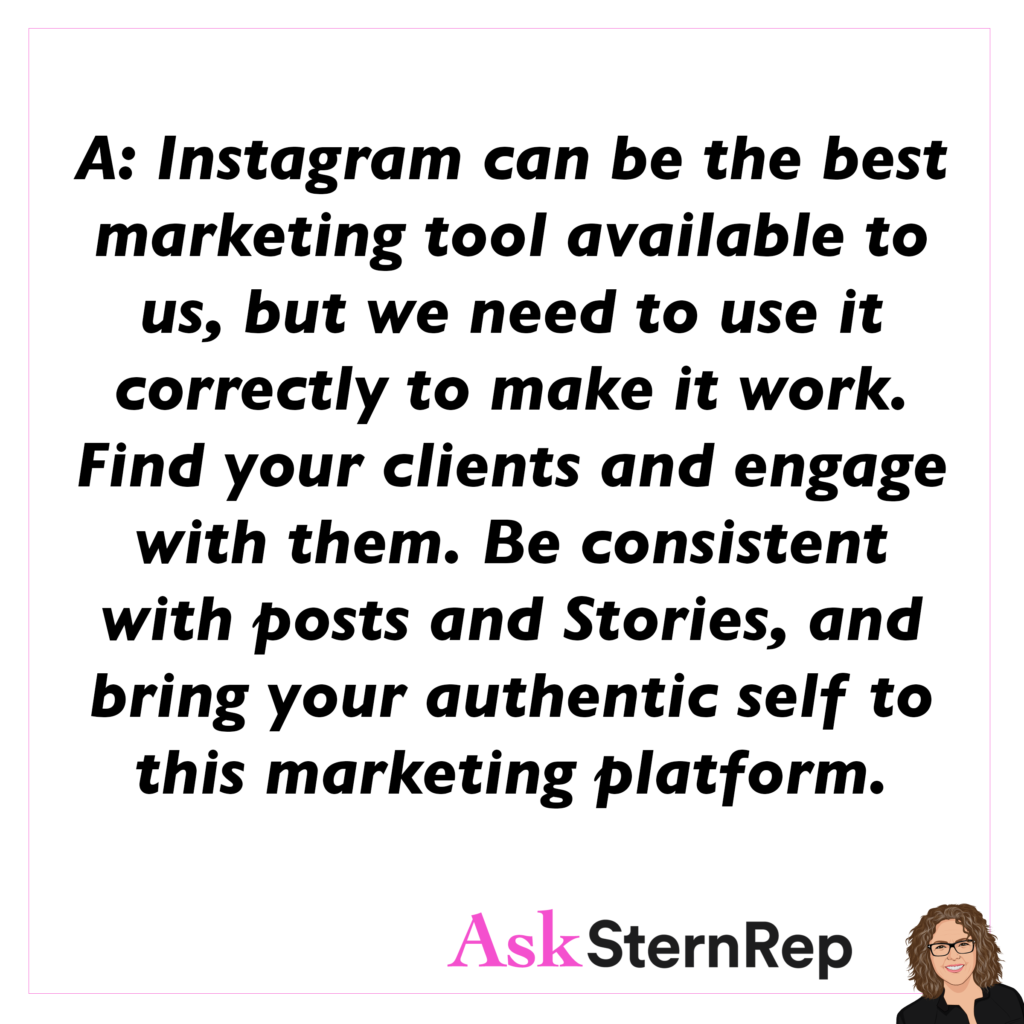
Q:
Other than consistently sharing their work, what are the best ways photographers can use Instagram?
A:
Instagram can be the best marketing tool available to us, but we need to use it correctly to make it work. Find your clients and engage with them. Be consistent with posts and Stories, and bring your authentic self to this marketing platform.
Sometimes the best sales tool is knowing when to be patient
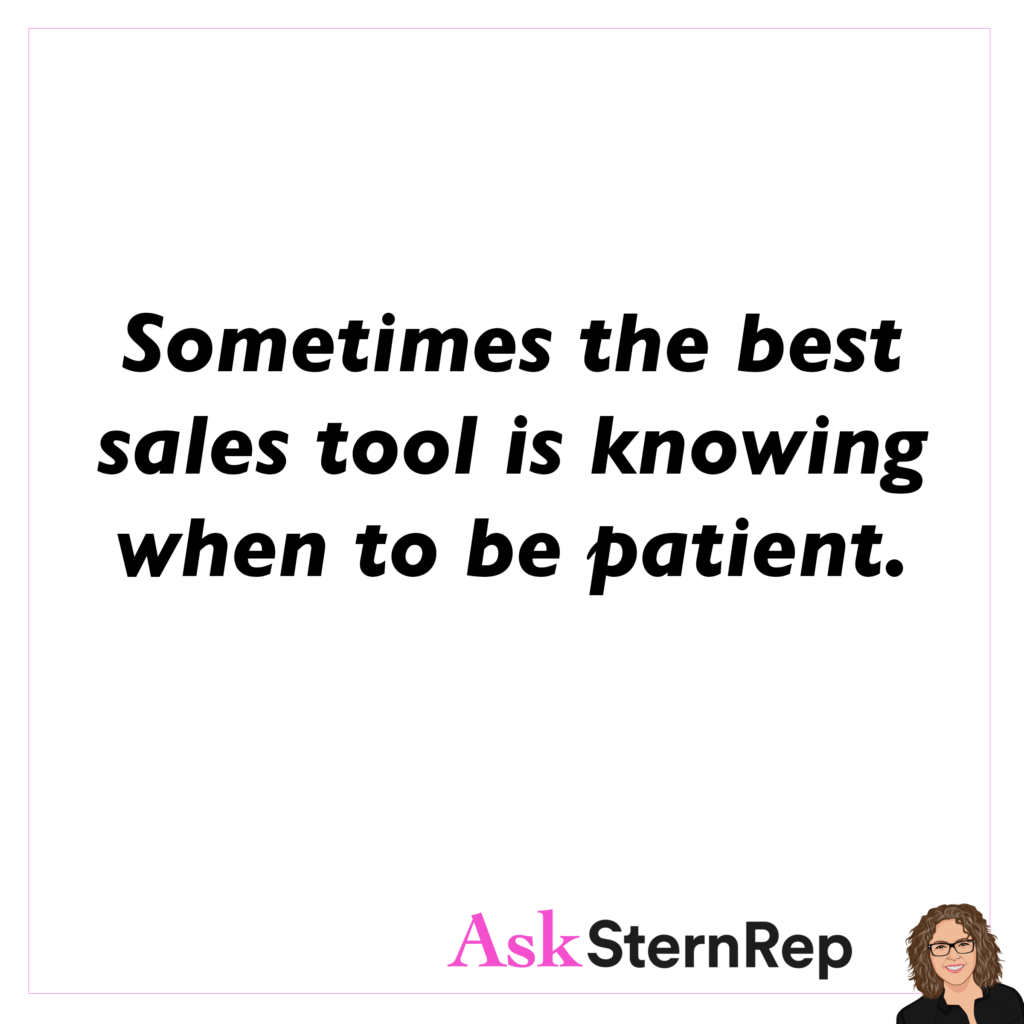
Sometimes the best sales tool is knowing when to be patient.
Charging Clients A Fee For Late Payments
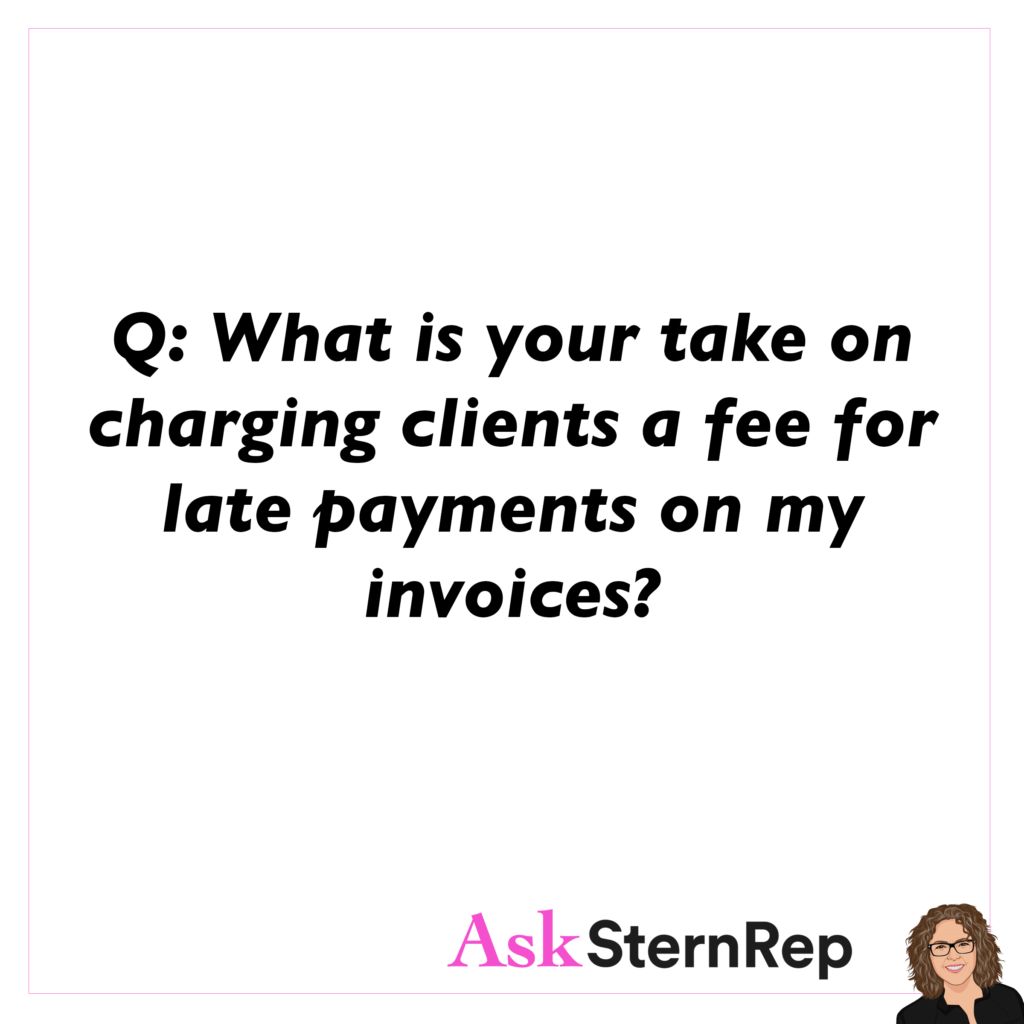

Q:
What is your take on charging clients a fee for late payments on my invoices?
A:
I hate to say it, but clients are often late with payments. We can add a late fee to our invoice, but what we have the most control over is getting a 50% or 75% advance before the job begins.
Here are the estimate/invoice terms I use:
- TERMS: Due Upon Receipt
- USAGE (granted upon full payment)
- Balance payment due before image rights are transferred to the client
- Project closing invoices paid more than 30 days from the submission date are subject to a 2% late payment charge per month starting from the original invoice date.
Bring Something Special When Bidding On A Job
Bidding on a job –
What’s the ‘special something’ you offer that will set you apart from the other bidders? How do you stand out? Have your unique skillset ready to focus on before you get on the creative call with the clients. Connect their branding goals with the distinguishing value you’ll bring so you can be the resource they are looking for!
The Nature Of Advertising Is Changing

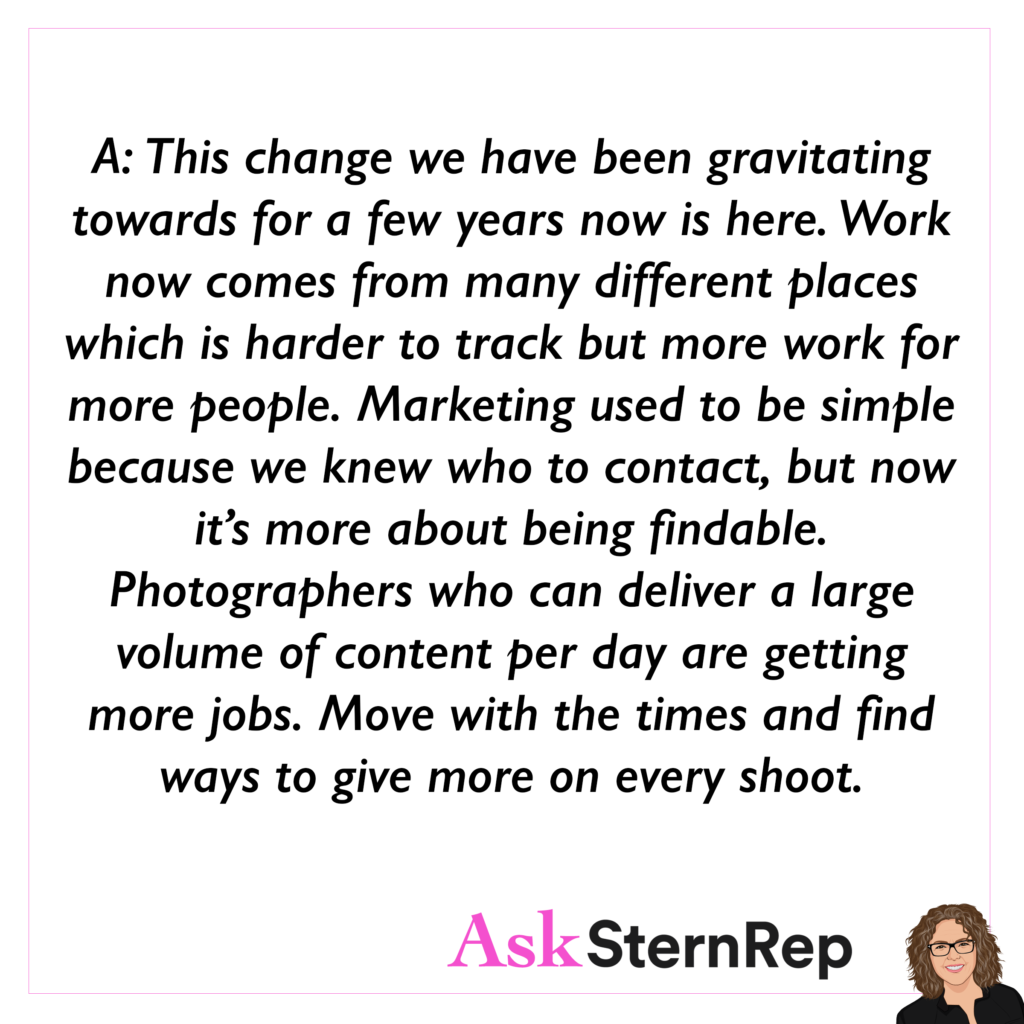
Q:
The nature of advertising is changing. What do you think the future holds for photographers?
A:
This change we have been gravitating towards for a few years now is here. Work now comes from many different places which is harder to track but more work for more people. Marketing used to be simple because we knew who to contact, but now it’s more about being findable. Photographers who can deliver a large volume of content per day are getting more jobs. Move with the times and find ways to give more on every shoot.
Consider Your Audience

Sometimes, the more you say, the less you will be heard. Consider your audience and how much time they have to read an email.
Treat others the way you want to be treated. How much time do you have to read an email or take a phone call?
How Photographers Handle Filming Video On Shoots


Q:
How do photographers handle filming video on shoots?
I’m just so used to just focusing on shooting photography on a set. Just stills, no video. My assistant usually shoots BTS videos on shoots, but that’s it. Are we supposed to hire someone to shoot video separately, and charge for it?
A:
As the agent, I’m going to answer this from the perspective of getting you the most bang for your buck. Many shoots do need you to be the overall DIRECTOR.
1. Be ready, technically speaking, to fulfill most potential job scenarios that come your way.
2. Choose the method (hire a DP, be the DP yourself, or focus on being the still photographer on motion sets) that delivers the highest quality of results in your specialized market.
3. Don’t let the fear of the unknown hold back your professional growth. Make sure to capitalize on pushing yourself to bring out the highest quality skill set you can muster!
Changes Are Among Us In The Commercial Advertising Markets
Adjust with the times! Changes are among us in the Commercial Advertising markets, and we need to ride the wave through our style- shifting constantly and leaning forward with advancing ways. Join the movement!
Starting Out In The Business And Lower Paying Jobs


Q:
Since I’m just starting out in the business, should I price myself a bit lower and work my way up? Can I get away with a smaller budget and get the same results?
A:
Normally, newer photographers can take on lower-paying jobs to help build their portfolios. Right now, you may be competing for these lower-paying jobs with more established photographers, but if you’re willing to offer additional services like extra time, post-work, video, etc., you’ll have a better chance of getting the job. Ultimately, the client wants to be reassured that you can handle the project, so make sure to reassure them and be flexible with budgets.
Negative emotional reactions do not equate to good business
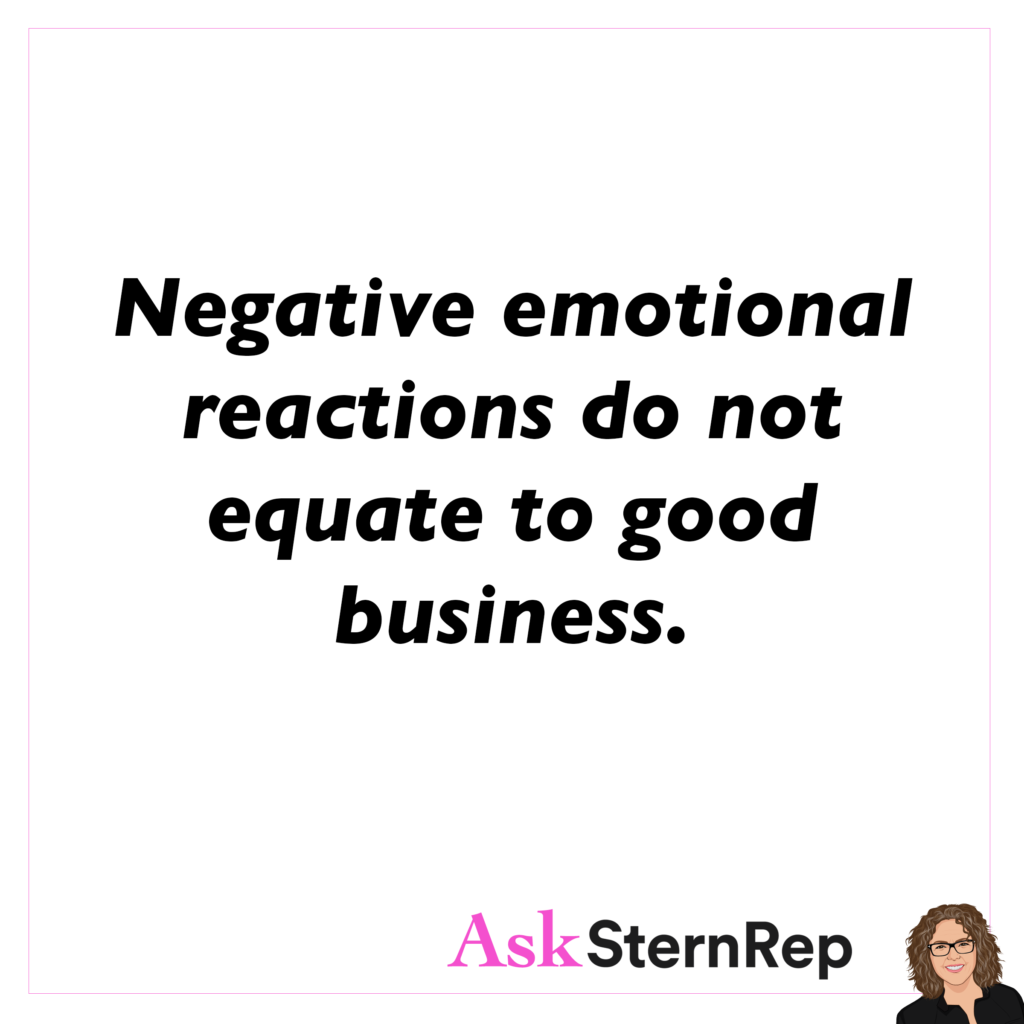
Negative emotional reactions do not equate to good business.
What To Charge For a GIF

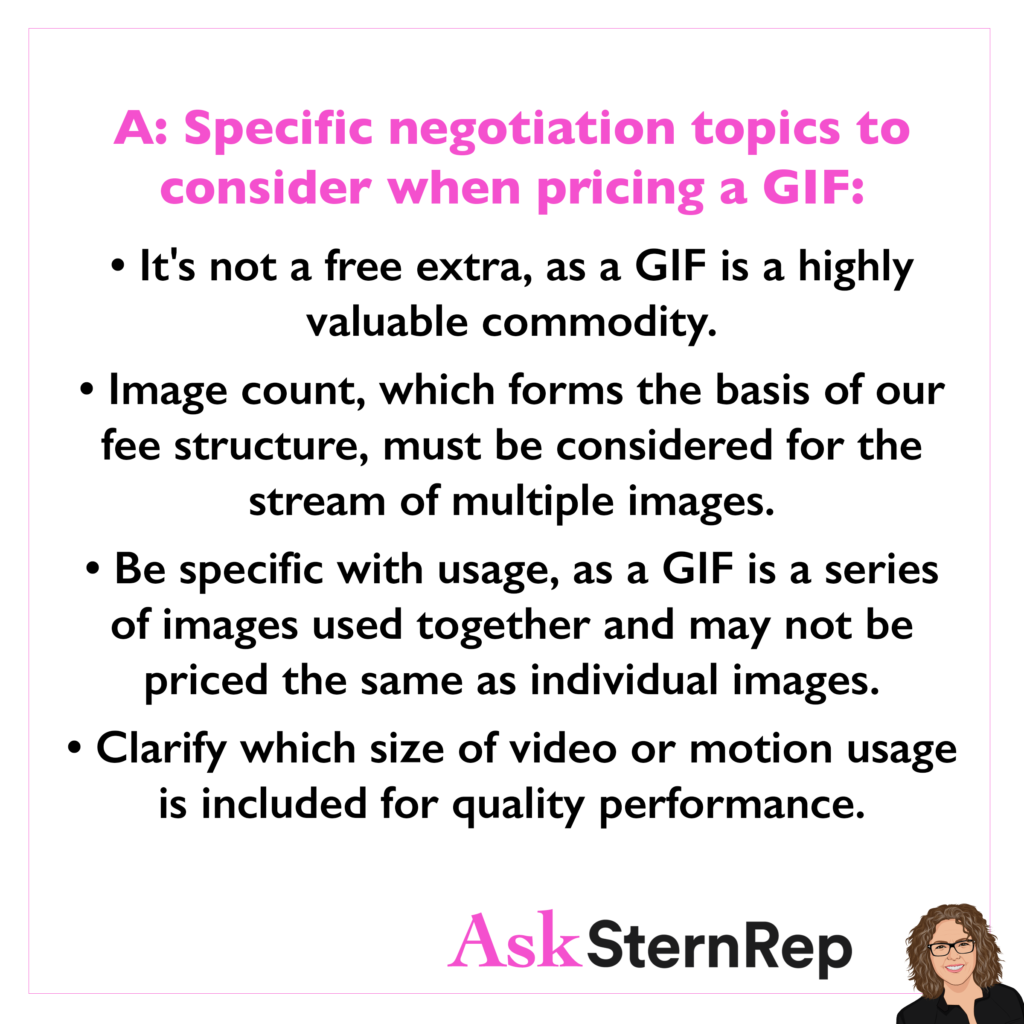
Q:
Any thoughts on what to charge just for a GIF?
A:
Specific negotiation topics to consider when pricing a GIF:
- It’s not a free extra, as a GIF is a highly valuable commodity.
- Image count, which forms the basis of our fee structure, must be considered for the stream of multiple images.
- Be specific with usage, as a GIF is a series of images used together and may not be priced the same as individual images.
- Clarify which size of video or motion usage is included for quality performance.
Marketing Outreach 101
Marketing Outreach 101:
If you want to really connect with clients, you need to be the one to go through the efforts of extending a specific invite selection of dates/times/locations all for them to easily say – “YES!”
Hold Protocol For Photographers
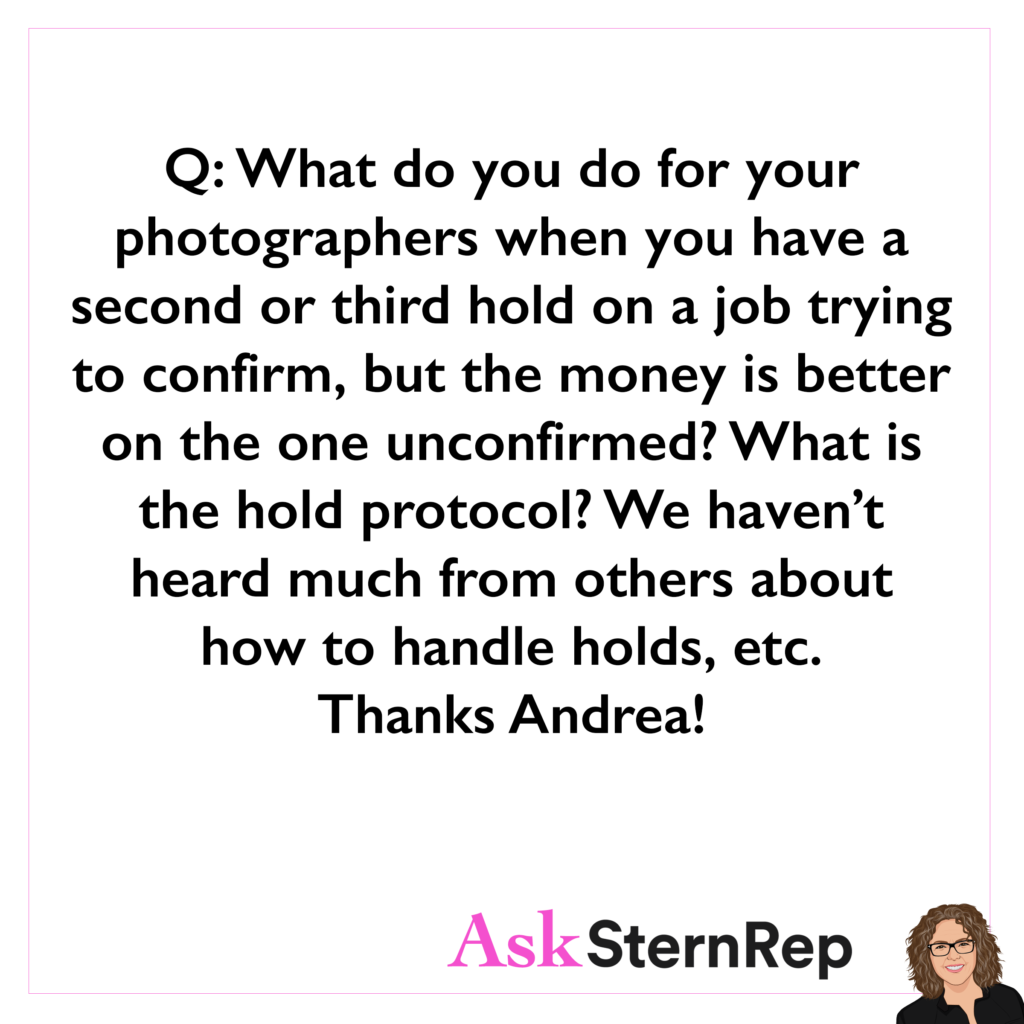
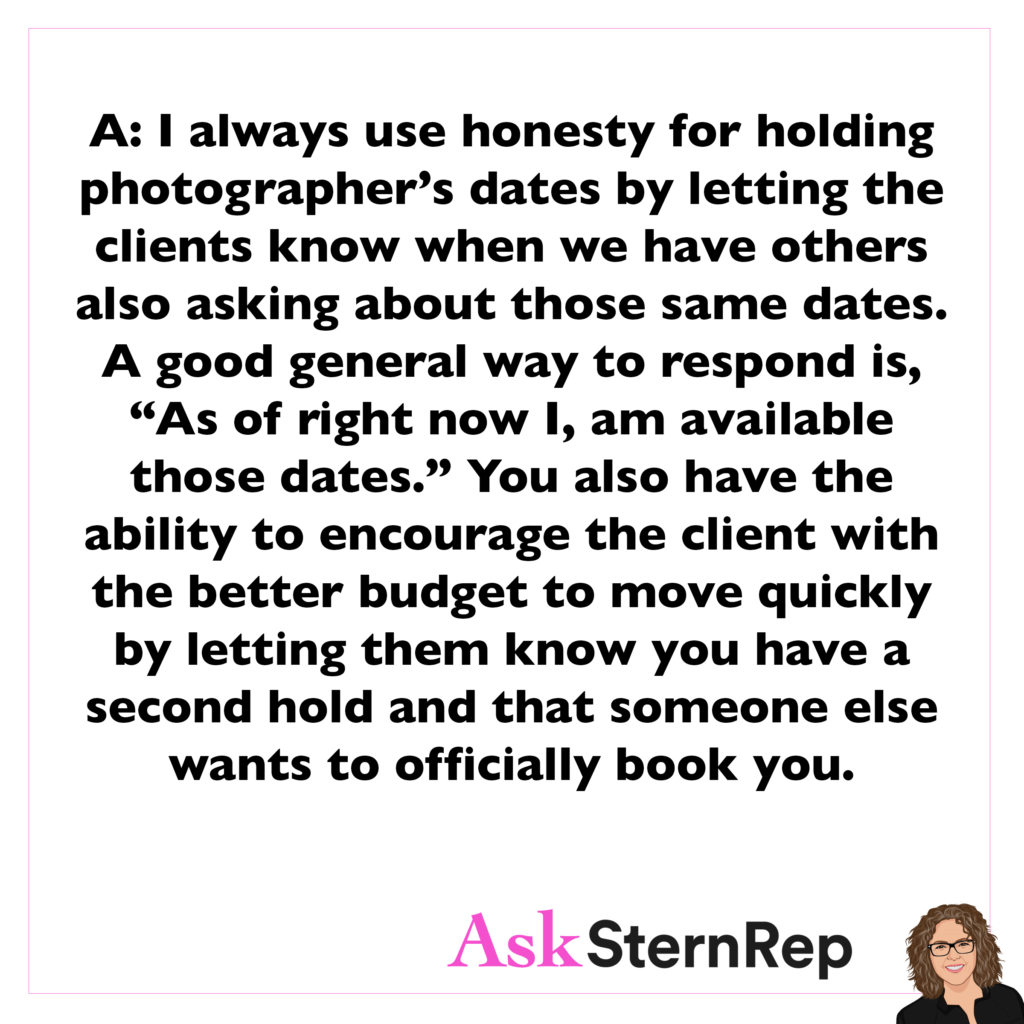
Q:
What do you do for your photographers when you have a second or third hold on a job trying to confirm, but the money is better on the one unconfirmed? What is the hold protocol? We haven’t heard much from others about how to handle holds, etc. Thanks Andrea!
A:
I always use honesty for holding photographer’s dates by letting the clients know when we have others also asking about those same dates. A good general way to respond is, “As of right now I, am available those dates.” You also have the ability to encourage the client with the better budget to move quickly by letting them know you have a second hold and that someone else wants to officially book you.
Every time I mess up, I make sure that I learned the lesson for next time.

Every time I mess up, I make sure that I learned the lesson for next time.
Charging For Every Additional Shot Taken vs. A Grouping Of Images
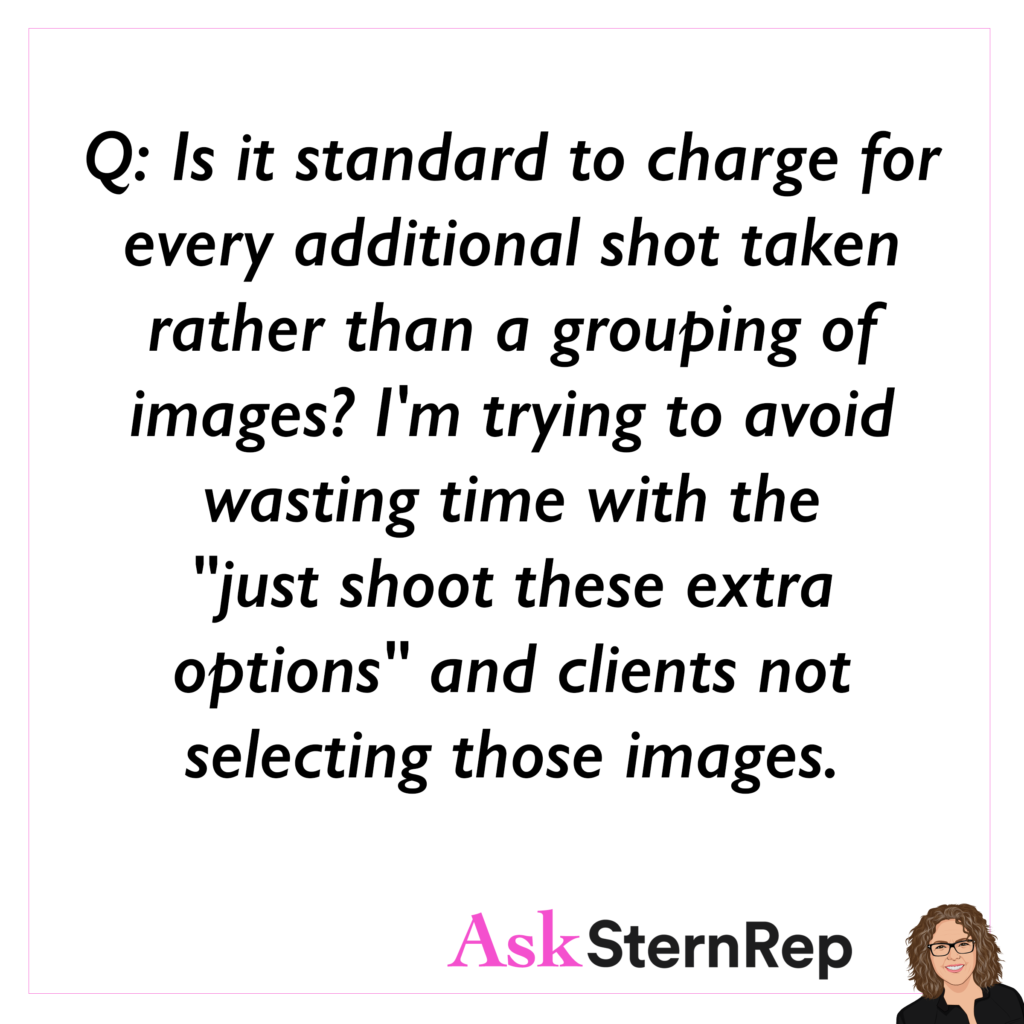

Q:
Is it standard to charge for every additional shot taken rather than a grouping of images? I’m trying to avoid wasting time with the “just shoot these extra options” and clients not selecting those images.
A:
Clients will ask for and take as many images as we let them, and I don’t blame them for that. It’s their job. We must clarify by setting financial restrictions on our estimate before we get on set. When bidding, my first question is how many images are needed, and then I set up the estimate precisely around that. When I hear “library” of images, meaning as many as can be finished per-day, I set the fees higher for those shoot days.
Putting Ourselves Out There In Natural Ways
Marketing plans must incorporate the unexpected moments of putting ourselves out there in the most natural ways.
When implementing marketing strategies, allow for flexibility, experimentation, and open-mindedness. By embracing these principles, photographers can navigate the complexities of the modern marketplace and tailor their approaches to meet the unique needs of their businesses and clients. This is a valuable reminder that adaptability and a willingness to learn are critical components of sustained marketing success.
Is It Appropriate To Send A Thank You Gift To An Agency?
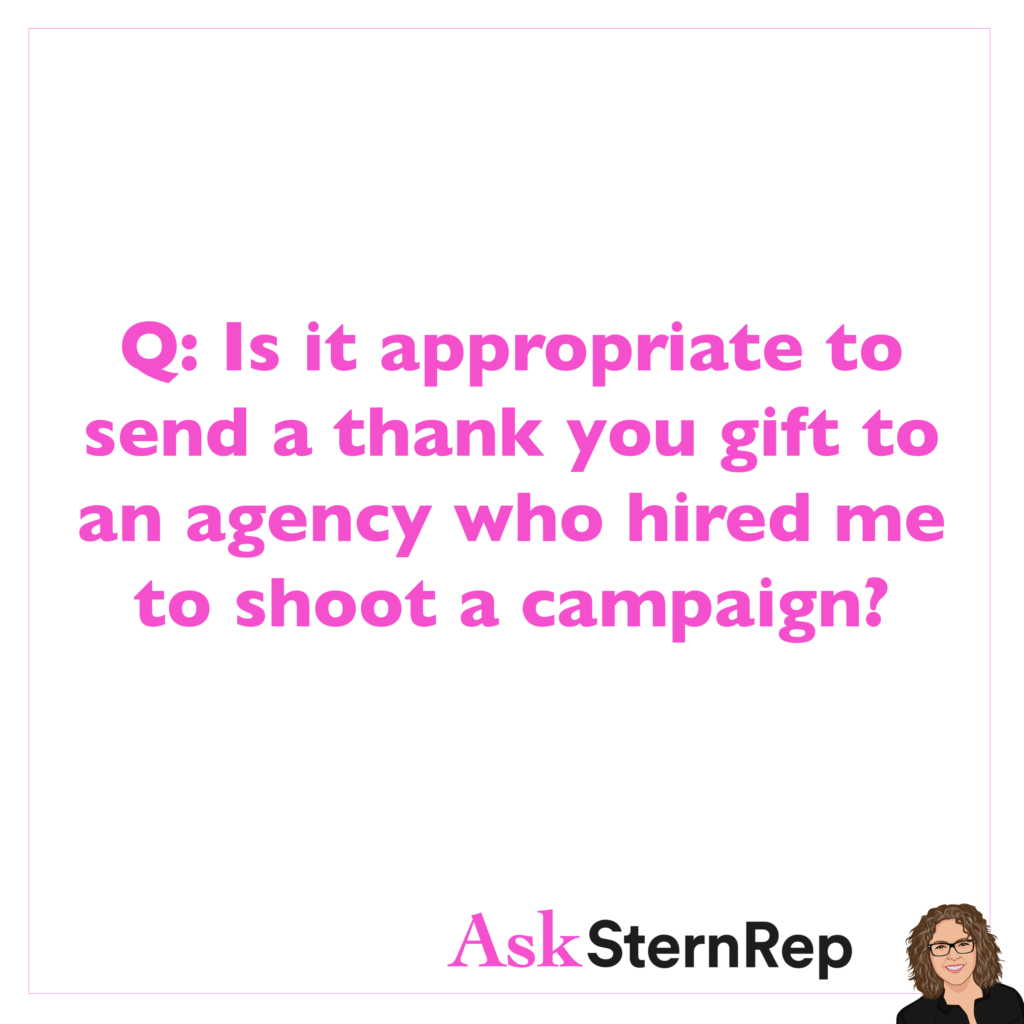

Q:
Is it appropriate to send a thank-you gift to an agency that hired me to shoot a campaign?
A:
This is a tricky one, as some agencies are fine with receiving a thank-you gift while others are not. I recommend asking them first, or even better, asking someone else at the agency you know, so you can still surprise your contact. Either way, it’s best to ask first, unless it’s something inexpensive like a basket of treats. A handwritten thank-you card is also a great way to show sincere appreciation.
Utilize Your Signature In Your Email

You look like an amateur if you don’t have an official website email address, along with a signature on the email including your web or IG link on it.
Make Portfolio Showings Happen
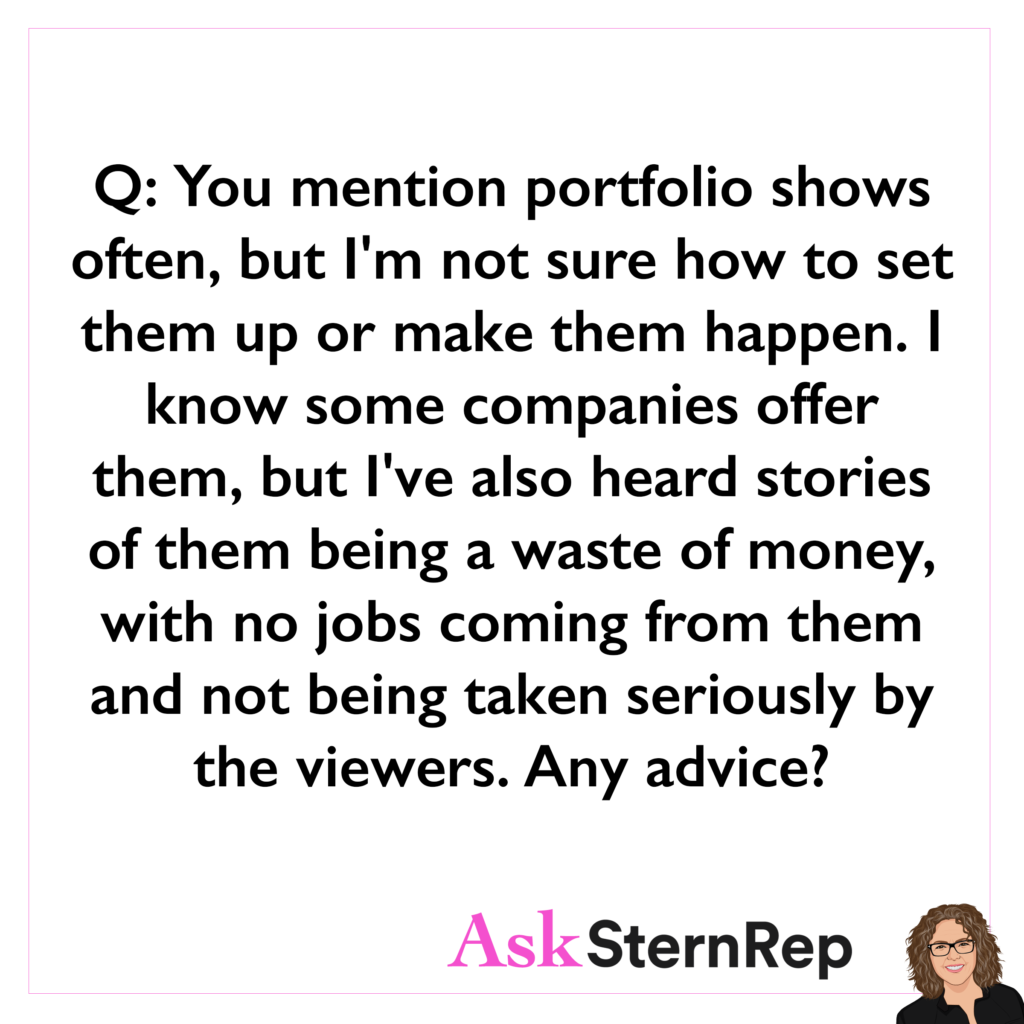

Q:
You mention portfolio shows often, but I’m not sure how to set them up or make them happen. I know some companies offer them, but I’ve also heard stories of them being a waste of money, with no jobs coming from them and not being taken seriously by the viewers. Any advice?
A:
Portfolio showings are one of the few marketing options that put us in the driver’s seat. It’s difficult to grab a client’s attention, but if we have 10 minutes of their focused time, it’s invaluable. The key is to choose the right potential clients. How many portfolio showings actually feature the right clients for us? That’s the real question.
Marketing Means “Being Remembered”
Marketing means “being remembered.” Sometimes, we spend extra money on a story or theme that identifies or connects us to our clients’ memories. Bring or show clients something specific that correlates with your work to stick in their minds and have them remember you.
Marketing has a crucial role in ensuring our brand or business is memorable to its target audience. Effective marketing is not just about immediate visibility but also about creating lasting impressions that resonate with potential customers. Be sure to seize all opportunities to engage with audiences in memorable ways, whether through thoughtful gifts, personalized outreach, or unique branding strategies. These efforts are aimed at ensuring that when the right moments arise, clients and customers will think of their brand first. The video highlights the importance of creativity and strategic thinking in marketing, showcasing how small gestures can significantly impact brand recall and customer relationships.
Marketing is a tool for memory-making rather than just visibility. Think creatively about how to engage with clients, and ensure you leave a lasting impact through thoughtful gestures, strategic branding, and personal touchpoints. The insights shared serve as a guide for marketers looking to enhance their brand recognition and customer loyalty through memorable marketing strategies.
Implement Your Personal Style When Your Work Is Art-Directed By Clients


Q:
How can a photographer implement their personal style and vision throughout their work when the majority of their work has been art-directed by their client for various and specific styles?
A:
This could be the million-dollar question that makes or breaks a photographer’s success. As busy as a photographer is, the images will always reflect a client’s vision of jobs from the past. So much of what clients want to see is what you can bring to the job for the future. The magical word is “Test.” Keep testing, no matter how busy you are. Bring your personal look into images and show who you are.
Make The Most Of Those Shower Ideas
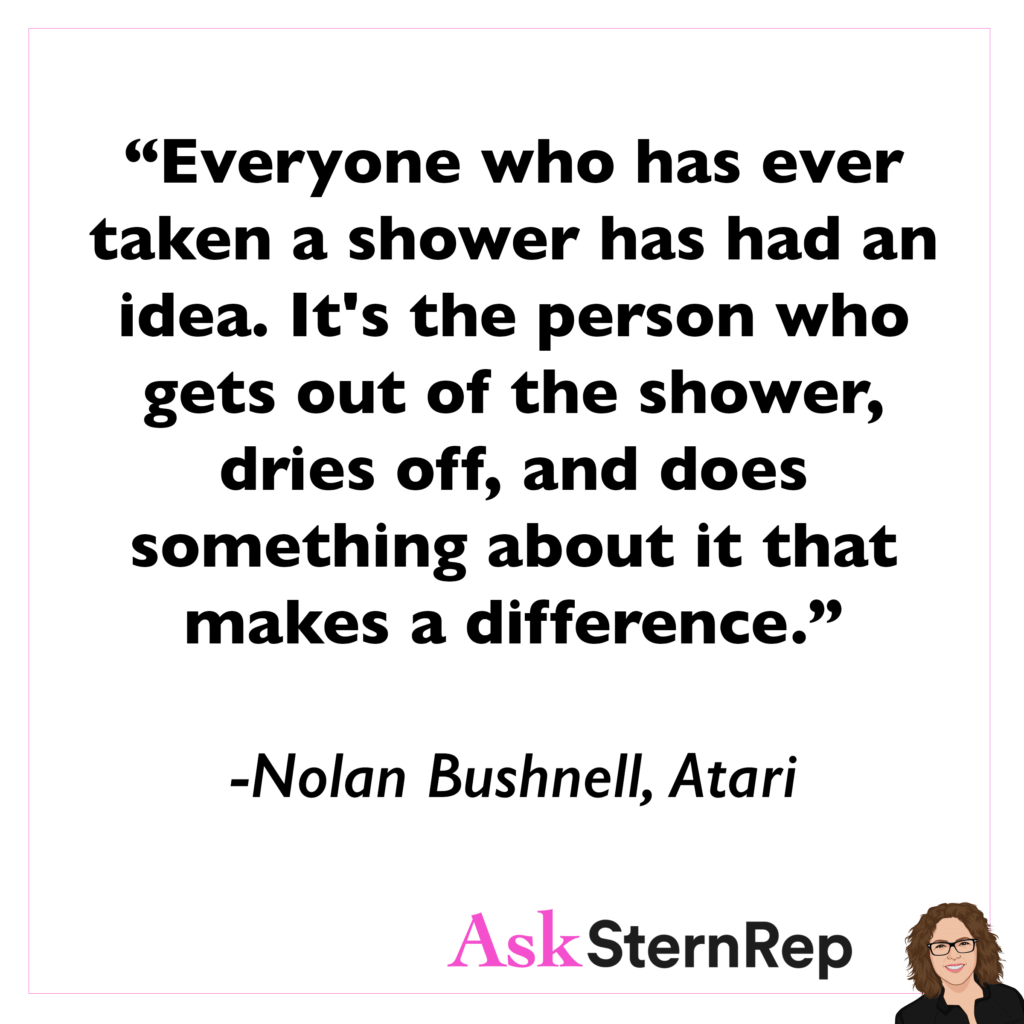
“Everyone who has ever taken a shower has had an idea. It’s the person who gets our of the shower, dries off, and does something about it that makes a difference.”
-Nolan Bushnell, Atari
Small Town Photography Budgets


Q:
I’m a Photographer in a small town, and I know I’m not charging enough. I don’t know how to charge more or reach bigger clients. I’m asking very low rates ($200 for half-day shoots and $400 for month-long progress images), but I’m still getting asked to lower my rate by people who want to work with me. How do I reach out to bigger clients, and how do I know what I should charge? Is there a simple formula or standard rates?
A:
We all wish there were a simple or standard formula for our rates. I can personally tell you that fee budget calculations don’t always make sense to equal out proportionally with the project. I’ve heard some photographers use stock image sites to see what they charge per usage, but we don’t have an overall chart for this. Based on the fees in your area, can you ask others what they are charging? My approach is how I know the average budget clients are spending, and then I speak on a human one-on-one level with a client to understand how high they can go within their budget. It is a numbers game where I try for more and use the usage terms for negotiation.
Changing The Definition Of OUTREACH
I want to change the definition of our OUTREACH. “Reach out” now means finding your way to include unknown, surprising, or unplanned approaches and constantly trying new ways.
Today, we explore the evolving nature of outreach in the business landscape. Outreach is not a static concept; rather, it is dynamic and constantly shifting, influenced by market changes and technological advancements. We need to adapt outreach strategies to stay relevant and effective. While foundational aspects like LinkedIn presence, branding, and social media are critical, but the landscape of outreach is ambiguous and requires experimentation with new methods. Outreach should be viewed as a fluid process that necessitates continuous learning and adaptation to the ever-changing environment.
Businesses need to evolve their outreach strategies in response to the shifting landscape. By focusing on adaptability, foundational tools, key contacts, and a commitment to experimentation and learning, professionals can navigate the complexities of outreach effectively and remain relevant in an ever-changing environment.
How Do You Make Initial Contact With Potential Clients?
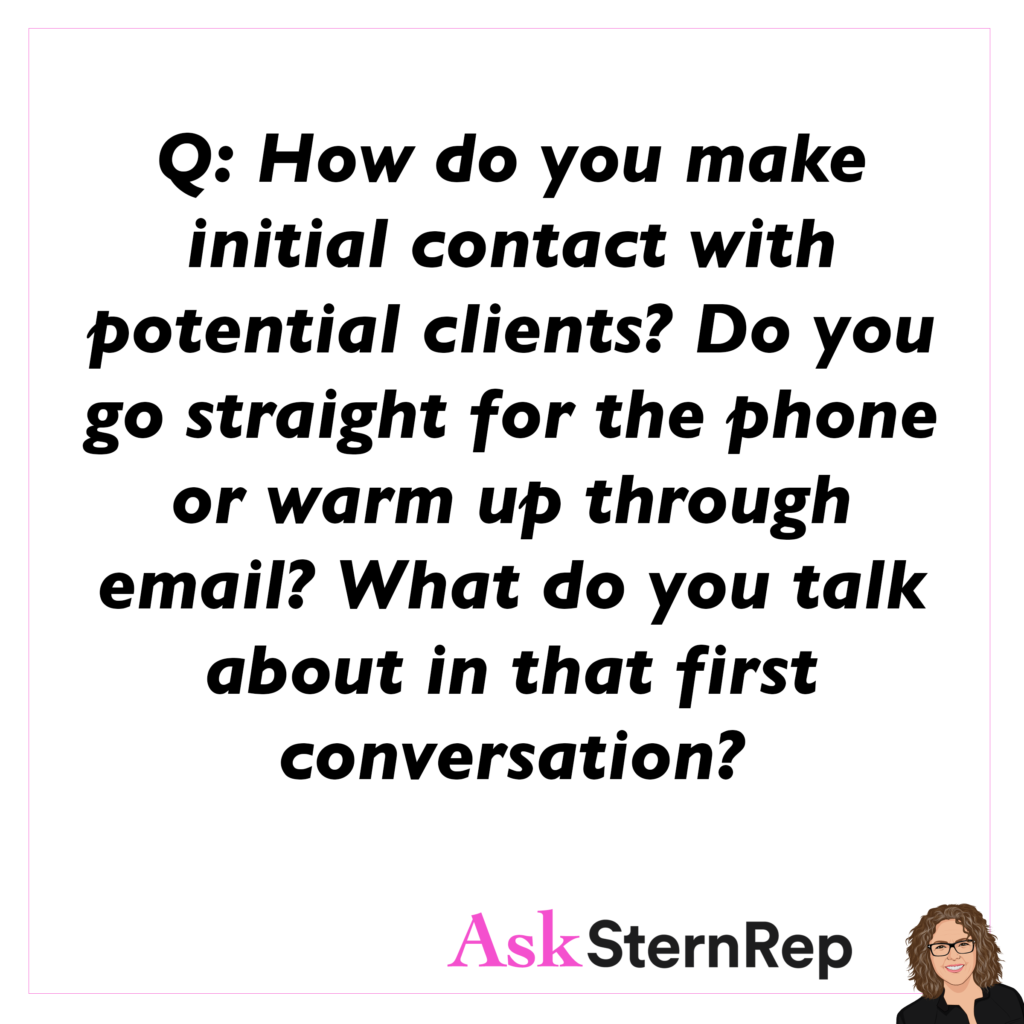
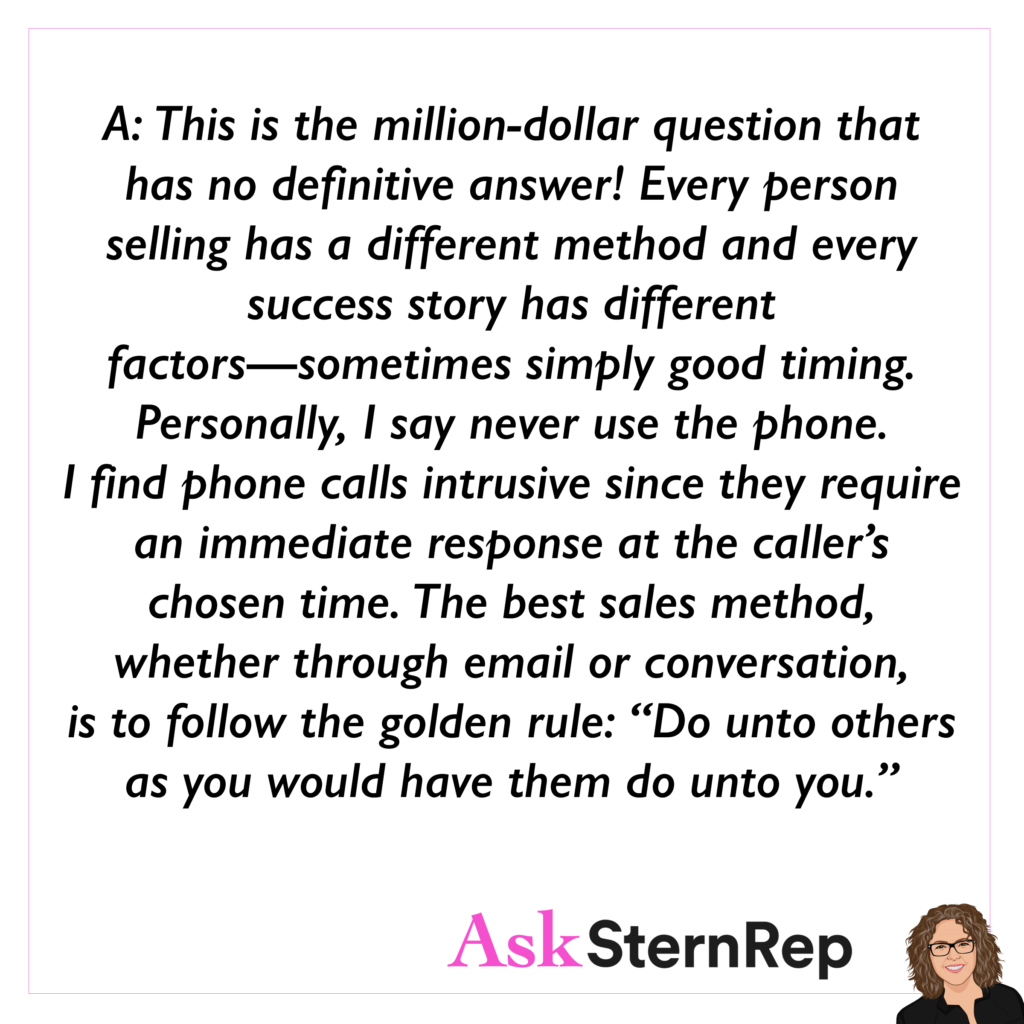
Q:
How do you make initial contact with potential clients? Do you go straight for the phone or warm up through email? What do you talk about in that first conversation?
A:
This is the million-dollar question that has no definitive answer! Every person selling has a different method and every success story has different factors—sometimes simply good timing. Personally, I say never use the phone. I find phone calls intrusive since they require an immediate response at the caller’s chosen time. The best sales method, whether through email or conversation, is to follow the golden rule: “Do unto others as you would have them do unto you.”
Mass-mailed Promos No Longer Work
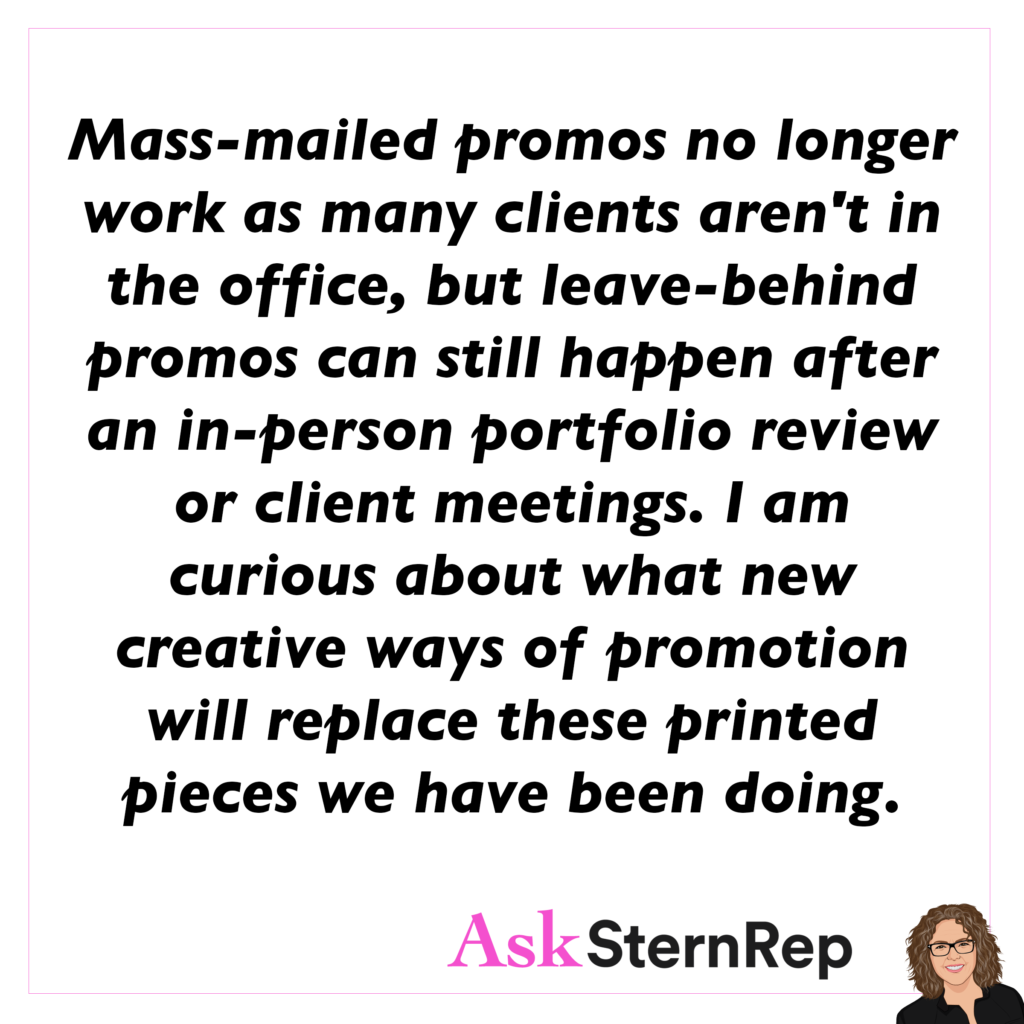
Mass-mailed promos no longer work as many clients aren’t in the office, but leave-behind promos can still happen after an in-person portfolio review or client meetings. I am curious about what new creative ways of promotion will replace these printed pieces we have been doing.
Does A Small Photography Production Need A Rep?

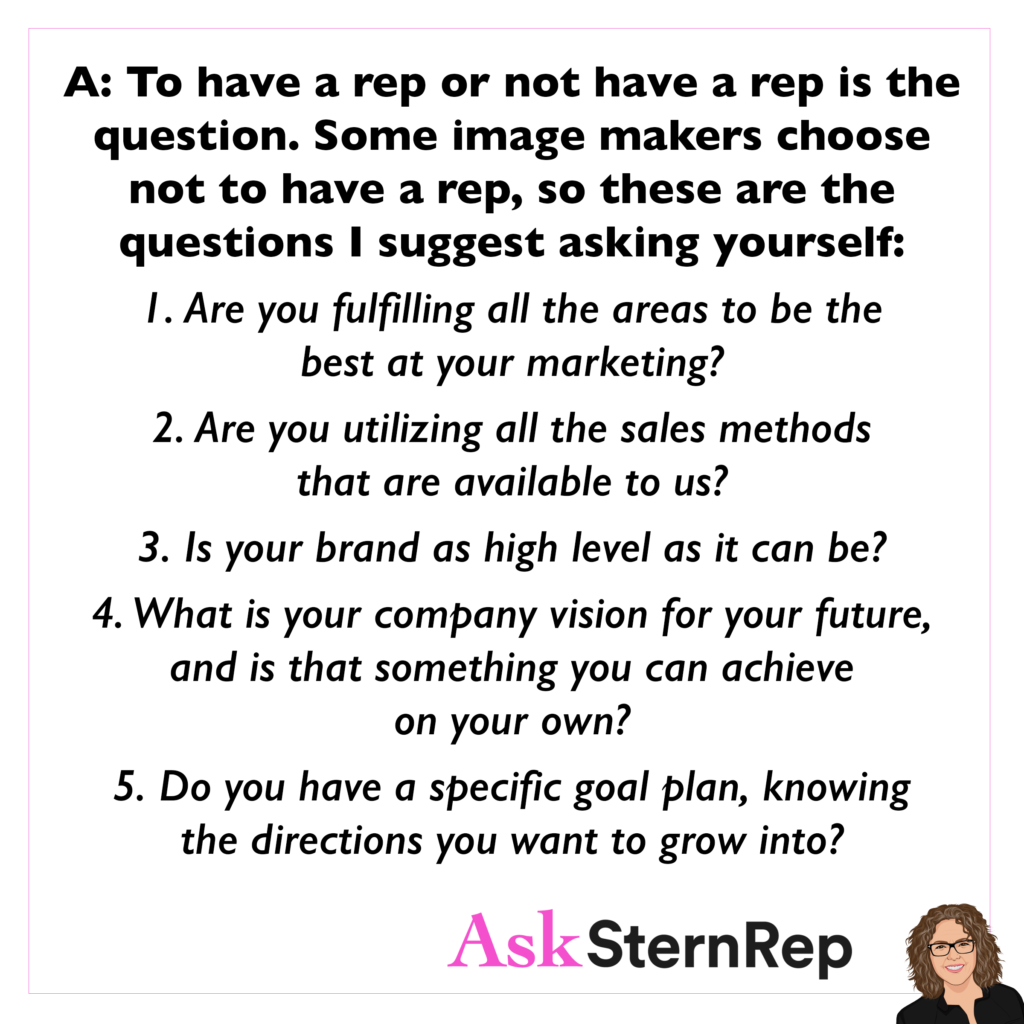
Q:
Do you think a small, 2-person photography production company needs a rep to continue to be successful?
A:
To have a rep or not have a rep is the question. Some image makers choose not to have a rep, so these are the questions I suggest asking yourself:
1. Are you fulfilling all the areas to be the best at your marketing?
2. Are you utilizing all the sales methods that are available to us?
3. Is your brand as high level as it can be?
4. What is your company vision for your future, and is that something you can achieve on your own?
5. Do you have a specific goal plan, knowing the directions you want to grow into?
Photography Is Not Just About Taking Pictures, You Must Also Be Easily Found
Image-making feels like the center of the world as, of course, it has to be your pinnacle point of focus. But then there is more – the ongoing process to be findable. Clients are showing you off to their clients, meaning you must be easily found/searchable with a timely, systematic structure to your presentation. If we skip the importance of step two, we will be climbing a constant uphill battle for success.
The dual nature of photography is both an artistic endeavor and a practical business. While the creative process is consuming and deeply personal for photographers, they must also recognize the importance of marketing their work effectively. Potential clients often face overwhelming choices and need quick access to the photographer’s portfolio to make informed decisions. Therefore, photographers must ensure that their images are easily accessible and showcase their work in a way that resonates with both their clients and the end users. This balance between artistry and practicality is crucial for success in the competitive photography market.
Photographers have to not only hone their craft but also be strategic in how they market and present their work. The creative process is undeniably valuable, but it cannot exist in a vacuum. Photographers must adapt to the realities of a competitive market where ease of access and effective communication of their capabilities can make all the difference in their success. By embracing both the art and the business sides of photography, they can create a sustainable career that resonates with clients and stands out in a crowded field.
Photographers Showcasing Huge Online Portfolios


Q:
I’ve noticed a trend of photographers at every level showcasing huge online portfolios with hundreds of images. Do you think art directors, producers, and others now prefer seeing more content? I’m inclined to follow the “less is more” trend but would love to hear your thoughts.
A:
The shift to showing more images reflects today’s portfolio platforms of social media. Consistent content is how we keep ourselves out there to be seen. Be careful not to water down your style by showing too much, but stay relevant with overall wee-branded posts available to impress and attract your clients.
Map Out Your Career Goals For The New Year
Is this a NEW year? Map out your Holy Grail list of ideal career goals from ideas that will lead you where you want to go! Why listen to anything else?
Low-Budget Job Checklist – Stock Photography
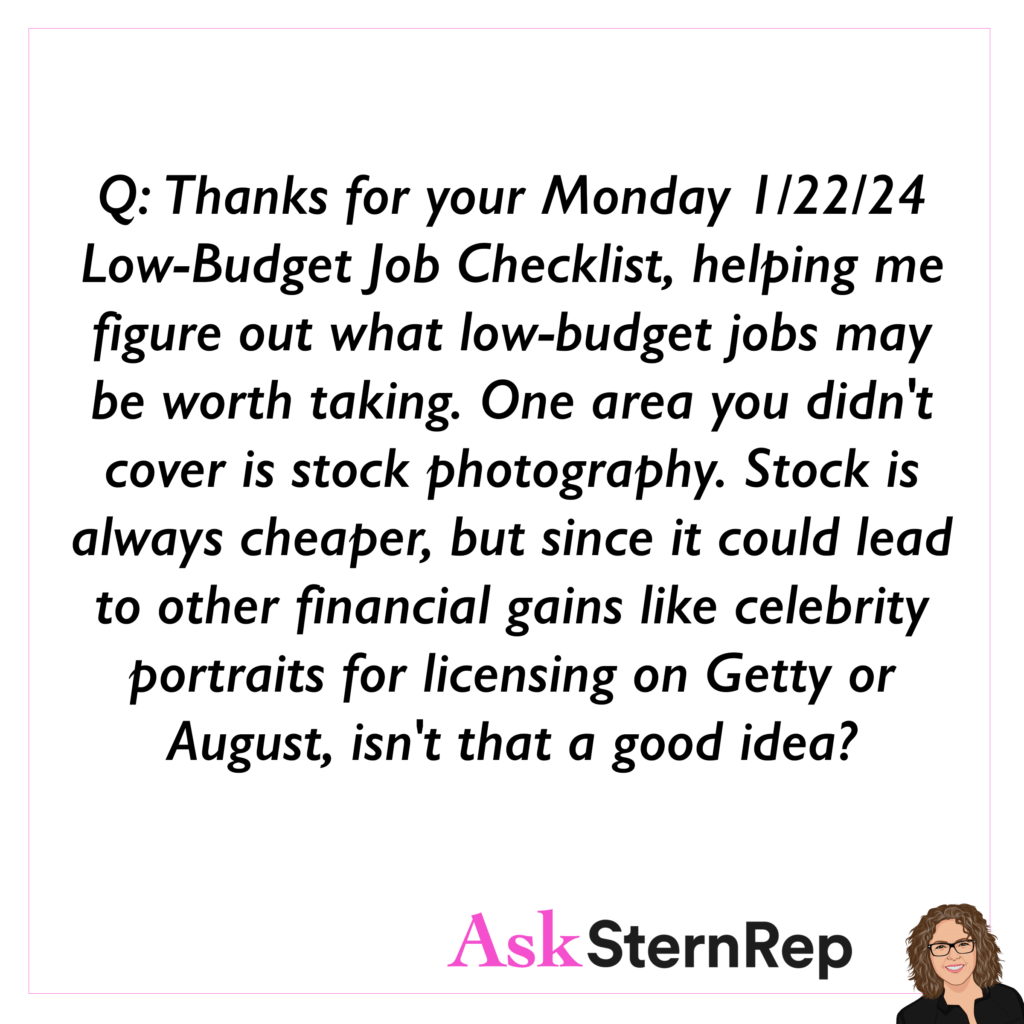
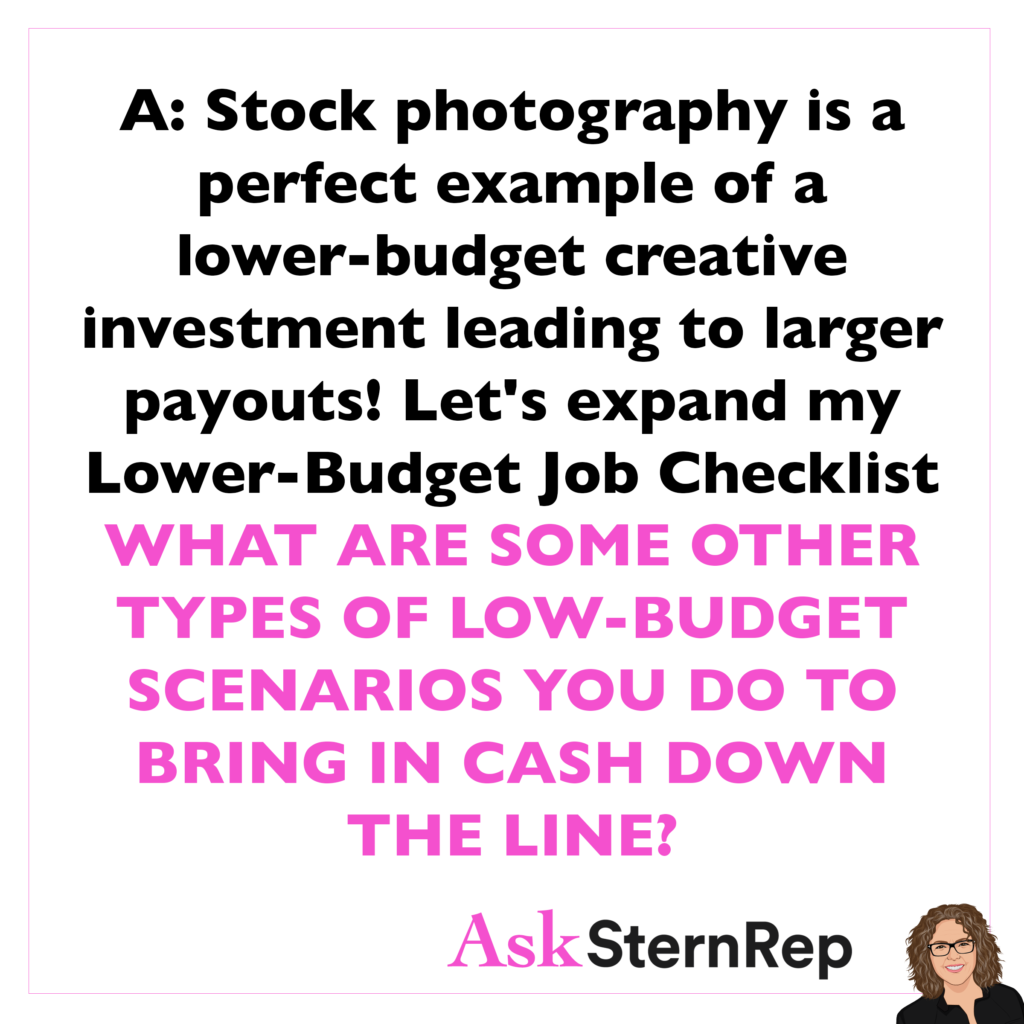
Q:
Thanks for your Monday 1/22/24 Low-Budget Job Checklist, helping me figure out what low-budget jobs may be worth taking. One area you didn’t cover is stock photography. Stock is always cheaper, but since it could lead to other financial gains like celebrity portraits for licensing on Getty or August, isn’t that a good idea?
A:
Stock photography is a perfect example of a lower-budget creative investment leading to larger payouts! Let’s expand my Lower-Budget Job Checklist – WHAT ARE SOME OTHER TYPES OF LOW-BUDGET SCENARIOS YOU DO TO BRING IN CASH DOWN THE LINE?
Using Time Off For Your Creative Endeavors
Time off means giving good-faith ideas/mindsets right back to yourself and your creative endeavors!
Take time during the holiday season to reflect on your career and creative aspirations. We should be giving, not just to others, but also to oneself by nurturing one’s creative instincts and ambitions. Embrace the holiday spirit and allow it to inspire a renewed sense of confidence, trust, and faith in their professional journeys. By taking moments to reconnect with your creativity and aspirations, you can harness this downtime to foster ideas and ignite your passion for your career.
Clients That Use Reps
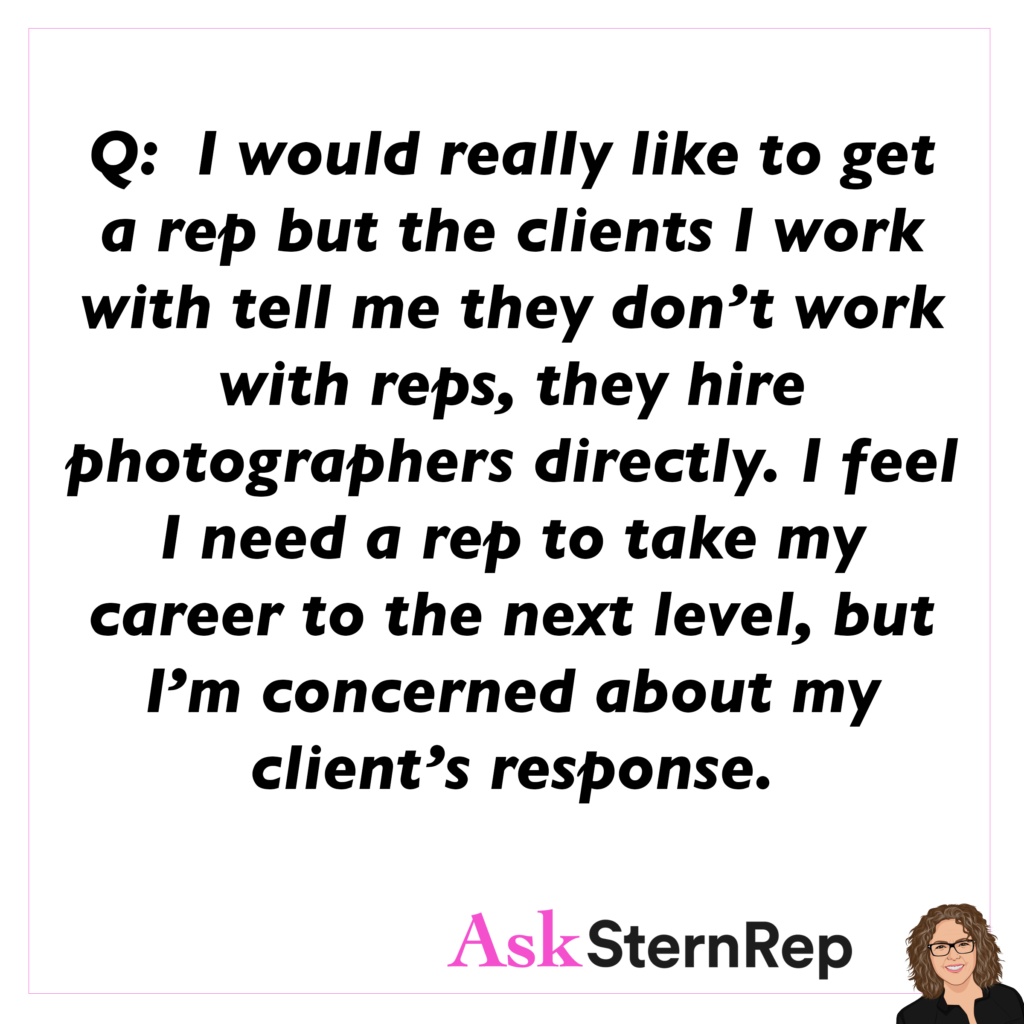

Q:
I would really like to get a rep but the clients I work with tell me they don’t work with reps, they hire photographers directly. I feel I need a rep to take my career to the next level, but I’m concerned about my client’s response.
A:
To get a rep or clients that use reps, you need to shoot the style and level that would get these jobs. I can say this to all photographers – most of the issues that arise are based on your portfolio. Start with that and look to improve it to get the results you are looking for.
Negotiation Begins With Knowing Where You Stand
Negotiation begins with knowing where you stand. When we are in the secure position of the client needing our images, we can use that to our advantage. Of course, we want to play a fair game, but to get to the best, most reasonable price – I use the ‘start high’ approach, giving me space to come down to meet their best price. Remember, we can never raise our prices; we can only lower them when negotiating.
Negotiation skills are so important, particularly when dealing with clients who require usage rights for images or other creative work. Start negotiations with a high asking price to maximize potential earnings, especially when the photographer has a unique position or exclusive rights. By setting a high initial figure, the photographer creates room for negotiation, allowing for a back-and-forth dialogue that can ultimately lead to a more favorable outcome. Photographers should view the high starting price as a strategic move rather than a fixed position, emphasizing the need for flexibility during negotiations. The underlying principle is to ensure that photographers do not undersell their worth and to capitalize on their unique offerings in the market.
This is a valuable guide for anyone involved in negotiations, especially in creative industries. Starting high, understanding one’s worth, and maintaining flexibility throughout the negotiation process provides a strategic framework for achieving better outcomes. By preparing adequately and recognizing the power dynamics at play, sellers can enhance their negotiation skills and ultimately secure more favorable terms in their agreements. Negotiation is not merely a transactional process; it’s an art form that requires insight, preparation, and adaptability.
Finding A Rep To Match Style and Skill Level
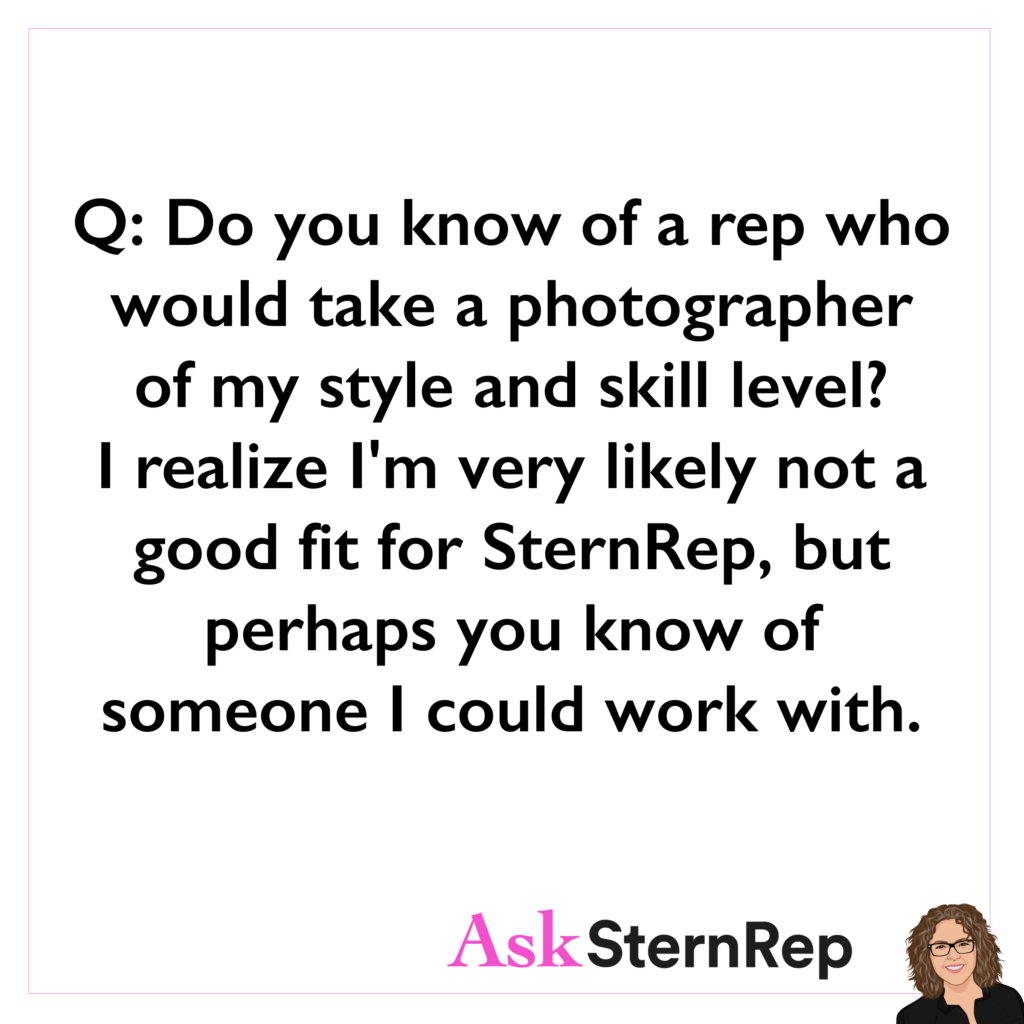

Q:
Do you know of a rep who would take a photographer of my style and skill level? I realize I’m very likely not a good fit for SternRep, but perhaps you know of someone I could work with.
A:
Questions that run through my mind when I get this question:
1. Does the photographer fit into what the rep specializes in?
2. Who are the photographer’s clientele, and do they match that rep’s quality level?
3. Does the style flow with the others on their roster?
4. Is there an agent known for this type of look/feel?
5. What level or stage is this photographer in, and are they ready for a rep?
6. Would this photographer fit into a specific location or part of the country and need a rep in this area?
7. Do I know this photographer, or do I get a good feeling from them? Can I contact other reps for them?
Shoot Tests And Constantly Evaluate Your Portfolio
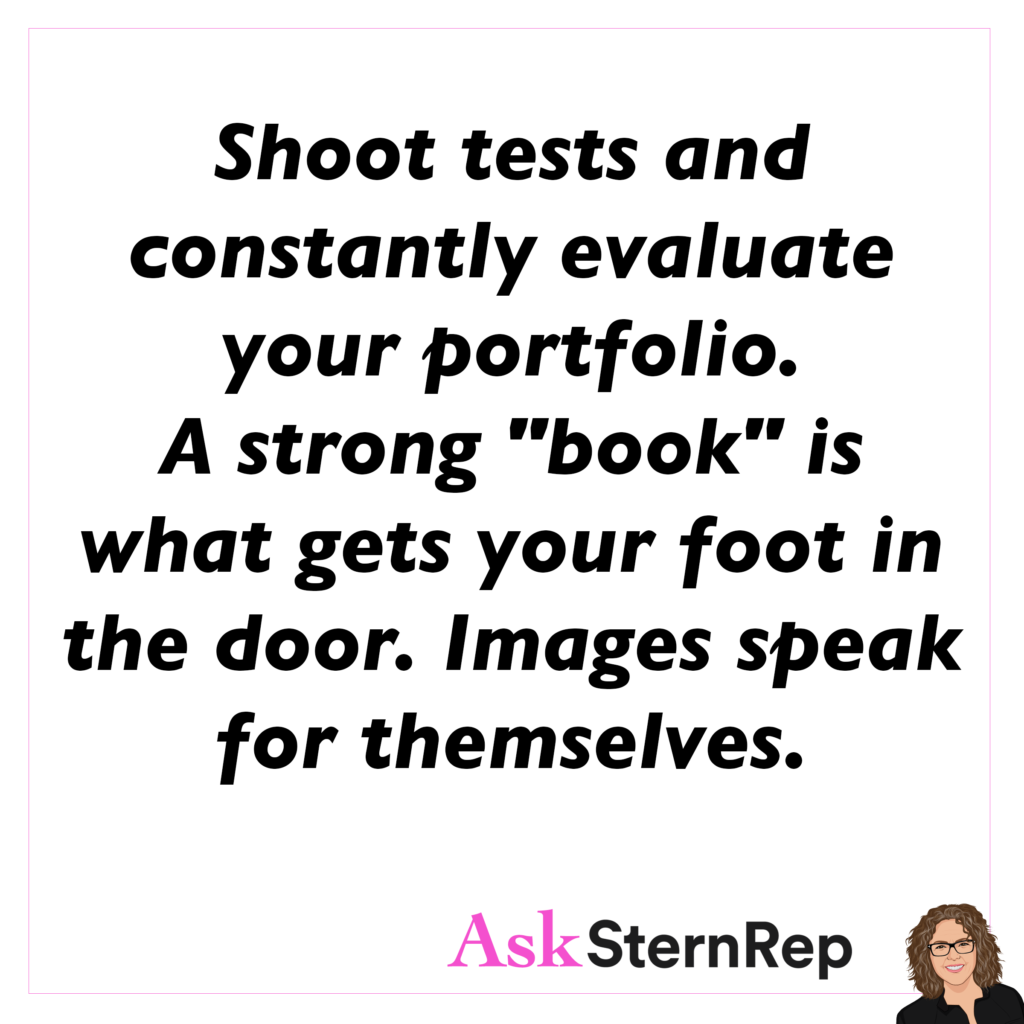
Shoot tests and constantly evaluate your portfolio.
A strong “book” is what gets your foot in the door. Images speak for themselves.
Agency Access And Spamming Promos
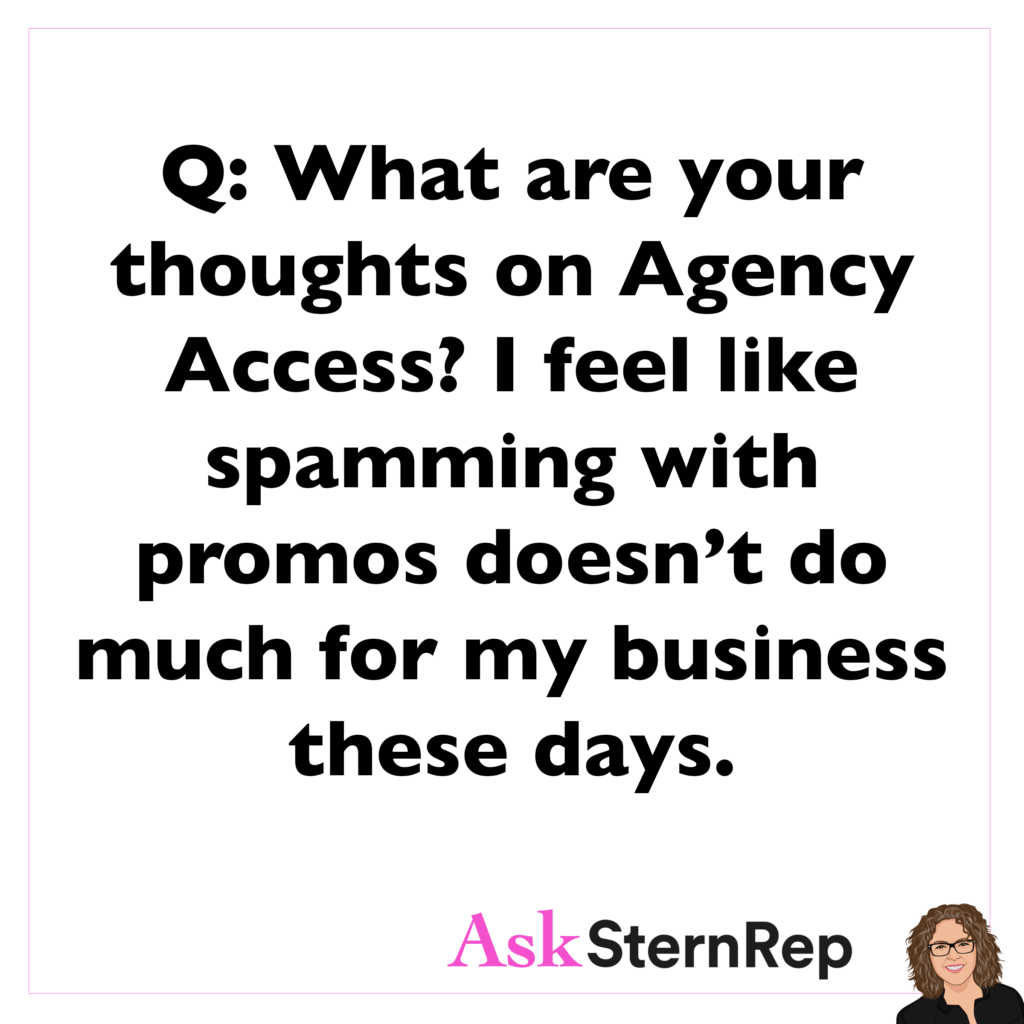

Q:
What are your thoughts on Agency Access? I feel like spamming with promos doesn’t do much for my business these days.
A:
We use what we have, but we cannot depend solely on doing any ‘one thing.’ Agency Access is not perfect so I also use Bikini List. The best way to do this is to try everything and keep trying everything.
Downtime Should Always Equate To Time to Improve
Slow times = time to improve.
No way to say that differently, as we should all keep pushing the creative clock and get better. Why waste valuable time thinking we get time off if we aren’t on a photo job? Plain and simple- we full-time freelancers are always on our clock pushing ourselves forward, or we will lose our lead in the industry.
Today, we discuss the challenges freelancers, particularly photographers, face during slow periods in their business. Instead of viewing downtime as wasted time, we should utilize this time constructively. We should continue working, even when we are not engaged in paid projects. This could involve collaborating with other professionals, exploring new creative avenues, and enhancing our portfolios. Reaching out to peers in the industry can lead to fruitful collaborations, allowing photographers to diversify their skills and expand their networks. Ultimately, turn slow periods into opportunities for growth and improvement.
Freelancers, particularly photographers, can navigate slow periods in their careers. By reframing downtime as an opportunity for growth, collaboration, and creativity, professionals can not only enhance their skills and portfolios but also build meaningful connections within the industry. Continuous improvement and maintaining a strong work ethic serve as a reminder that every moment spent working—whether on paid projects or personal development—is an investment in one’s future success.
Keeping My Portfolio Updated Using Minimal Resources


Q:
How do I spend my time (and money) wisely to not waste time keeping my portfolio updated to get me where I want to go?
A:
Testing is the strategic core to success, but it requires you to play it smart:
- When planning your test, have a client type in mind—the more specific, the better
- Put the time in to identify who does what and who the potential clients
- What are those clients presently doing with their marketing
- Dedicate the time for research and consistent follow-up through our marketing outreach platforms
- Your test and the potential client must match up to stay on course with your website/IG/image branding
Let’s Be Thankful For What is Working And Use It
Do you want to take your career to the next level?
What naturally gets you going, invigorates you, and stirs the creative juices? Let’s be thankful for what is working and USE IT to build off of those particular motivators.
Let’s have som gratitude as we enter the holiday season, particularly Thanksgiving. This time of reflection is crucial for those in the fast-paced and ever-evolving industry. Take a step back and identify the elements in your professional lives that are working well. By creating a “positive checklist,” we can focus on what is effective, fulfilling, and aligned with our goals. The message is clear: rather than getting overwhelmed by the rapid changes and challenges of the industry, we should embrace gratitude and use it as a tool for growth and direction. Take some time off to contemplate and redirect our efforts toward what truly resonates with our aspirations, allowing us to shift, grow, and thrive in our professional journeys.
Recommendations For Sites To Progress Photography Business


Q:
I was wondering if you have any recommendations for sites that discuss the specifics of progressing your photography business?
A:
In my opinion, there is no better website than aPhotoEditor. It contains all the insider information you will need to progress your business.
The SHOT COUNT Should Not Get Downplayed As The Extra Detail Of Your Fee
Why does the SHOT COUNT often get downplayed as the EXTRA detail of your fee? No, don’t give away free images! The shot count is one of the cornerstones of your rate. The best way to handle this is to break out the usage per shot in your fees, but often, clients prefer a day rate to include it all. However you set up your fee structure, remember the shot count is not some tiny additional detail as clients may suggest.
Using Others’ Images In A Creative Treatment
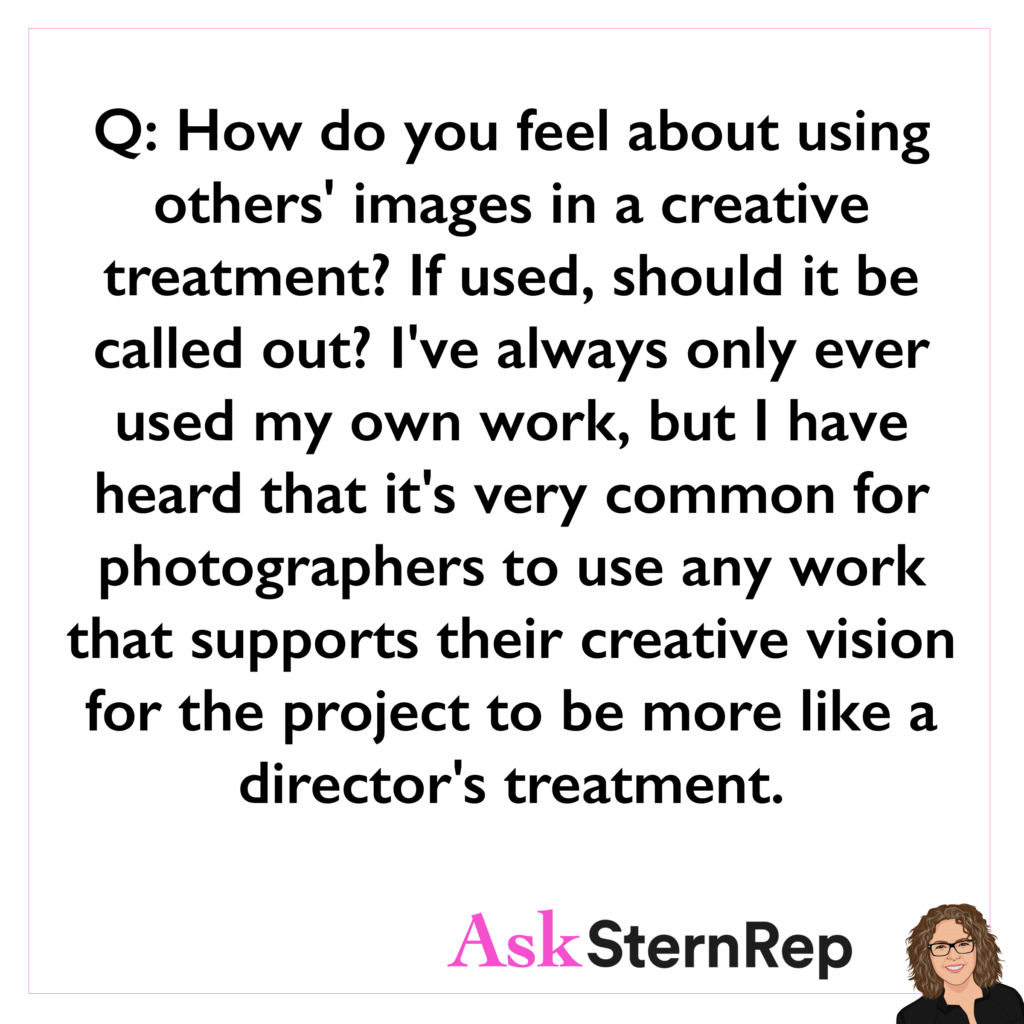

Q:
How do you feel about using others’ images in a creative treatment? If used, should it be called out? I’ve always only ever used my own work, but I have heard that it’s very common for photographers to use any work that supports their creative vision for the project to be more like a director’s treatment.
A:
Using other artists’ images in your treatment may be misleading that they are yours. I suggest putting those images in a section labeled “inspiration” to avoid confusing the situation. Certain treatment production topics are expected to have others’ images, such as Props, Wardrobe, Locations, etc.
Clients Usually Cannot Provide Specific Prices
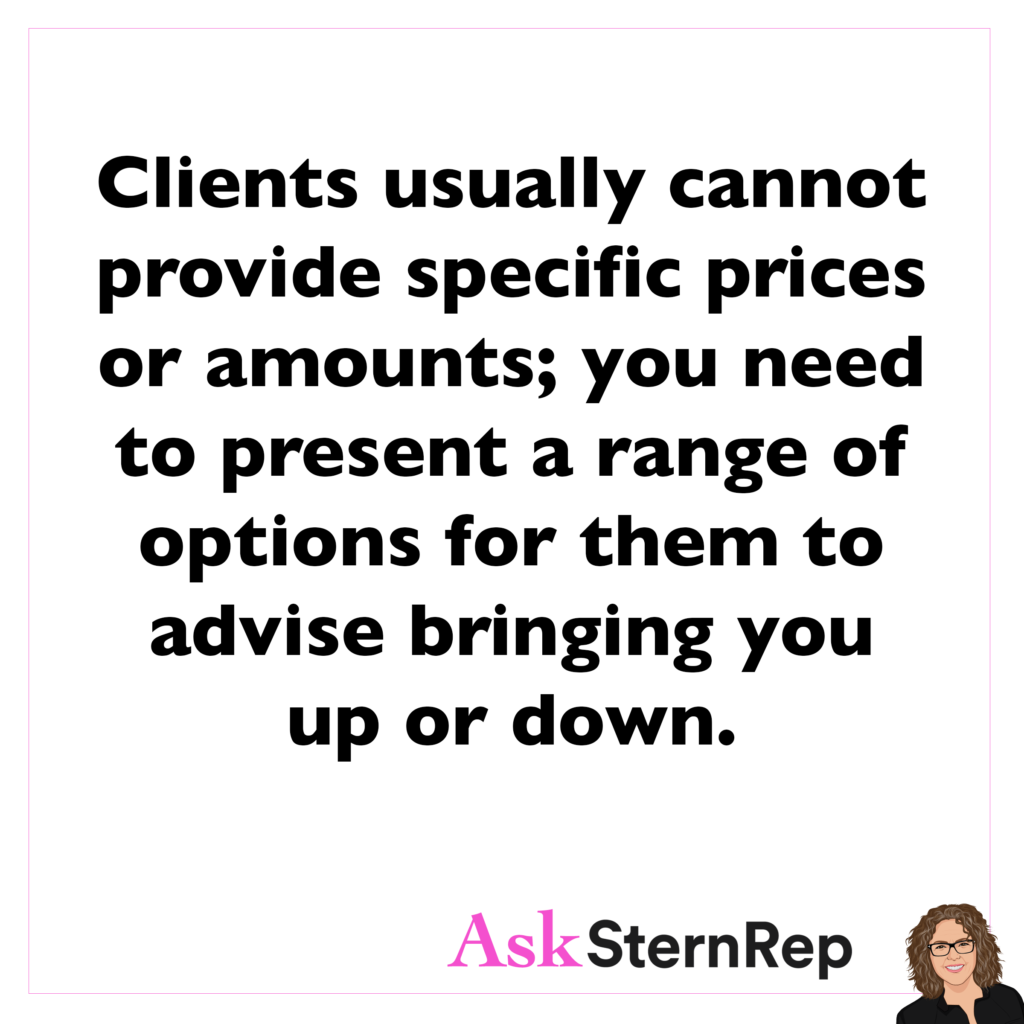
Clients usually cannot provide specific prices or amounts you need to present a range of options for them to advise bringing you up or down.
What Are Some Things To Avoid When Cold Emailing?
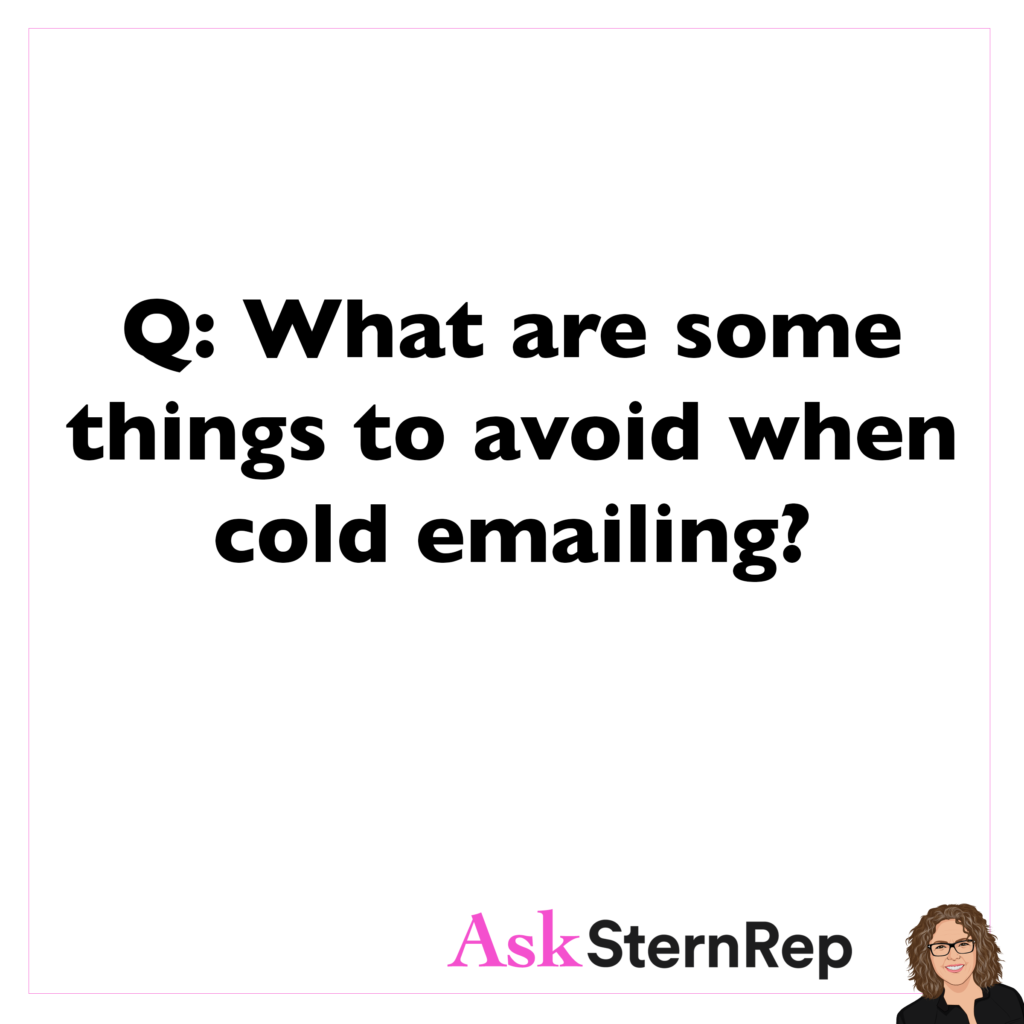

Q:
What are some things to avoid when cold emailing?
A:
The most important part of a cold email is to avoid sounding cold. I try to be in the moment to write as I speak, keeping it as “not staged” as possible.
- Sound human
- Avoid unnecessary words = short and to the point
- Add a touch of human flair
A “Pitch” Can Be Your Proactive Way of Introducing What You Can Offer
What is a PITCH?
A ‘pitch’ can be your proactive way of introducing what you offer to potential clients, usually through an emailed Treatment-style PDF.
Three types:
1. Images of your style matching the type of work they do
2. Production company methodology of what you handle and provide
3. Specific conceptual concept project idea
*Thank you Mary Dail (Big Leo Productions-@bigleoproductions) and Traci Terrick (Poppy Creative Agency- @poppycreative), for our Friday discussion on “pitches.”
At What Bid Price Do You Include A Treatment?


Q:
At what bid price do you include a treatment, and when do you decide the production is too small to require a treatment? I have a cut-off in my head, but I’m a grumpy old-timer.
A:
When you are up for a job that you want based on financials, opening the door, or creative exploration, you put your time into an awesome treatment. If it’s a low-budget, one-time situation, you can create a PDF of the appropriate images without writing a detailed production plan for every category. Either way, using an A+ design that stays strong with your branding is key.
Prompt Follow-Up for Credibility and Success

In any business interaction, remember to follow up immediately so you are believed and taken seriously.
The Rising Importance Of Content for Photographers And Clients


Q:
When you talk about the rising importance of “content,” are you referring to the necessity for photographers to post more and better content, the necessity for clients to produce more content and hence hire photographers more often, or both?
A:
When I refer to the importance of content, I am talking about both: photographers need to create more content, as do clients. We must constantly create and post content in today’s business world to make our work findable. Years ago, the marketing process was more challenging to show our work to clients, so this could actually be a win/win if we accepted it and joined the content party.
Understanding The Clients’ Needs Will Help Us Get The Job
Bidding a job can be a quickly played, fast-paced, reactive decision game anticipating how the client could respond. The wrong move can cost us the job. We want to be honest about what we can do for their budget, but sometimes, we must educate the client to understand the situation and how we can best serve them. Be a part of their side of the process, join forces with them, and play the team player role.
Email Promos Getting Through Email Filters

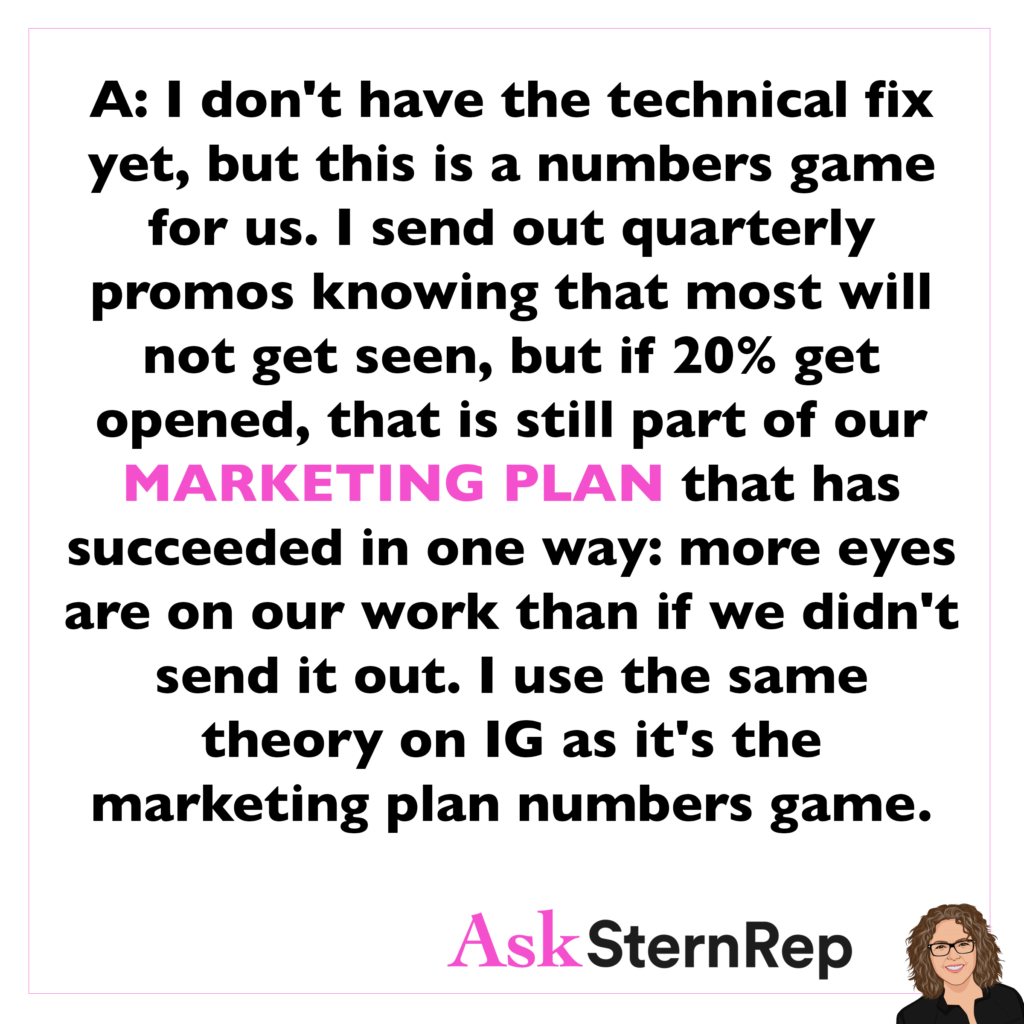
Q:
Is there a suggestion on what else to do to get blocked email promos through clients’ email filters?
A:
I don’t have the technical fix yet, but this is a numbers game for us. I send out quarterly promos knowing that most will not get seen, but if 20% get opened, that is still part of our MARKETING PLAN that has succeeded in one way: more eyes are on our work than if we didn’t send it out. I use the same theory on IG as it’s the marketing plan numbers game.
Strategies for Successful Creative Calls with Clients
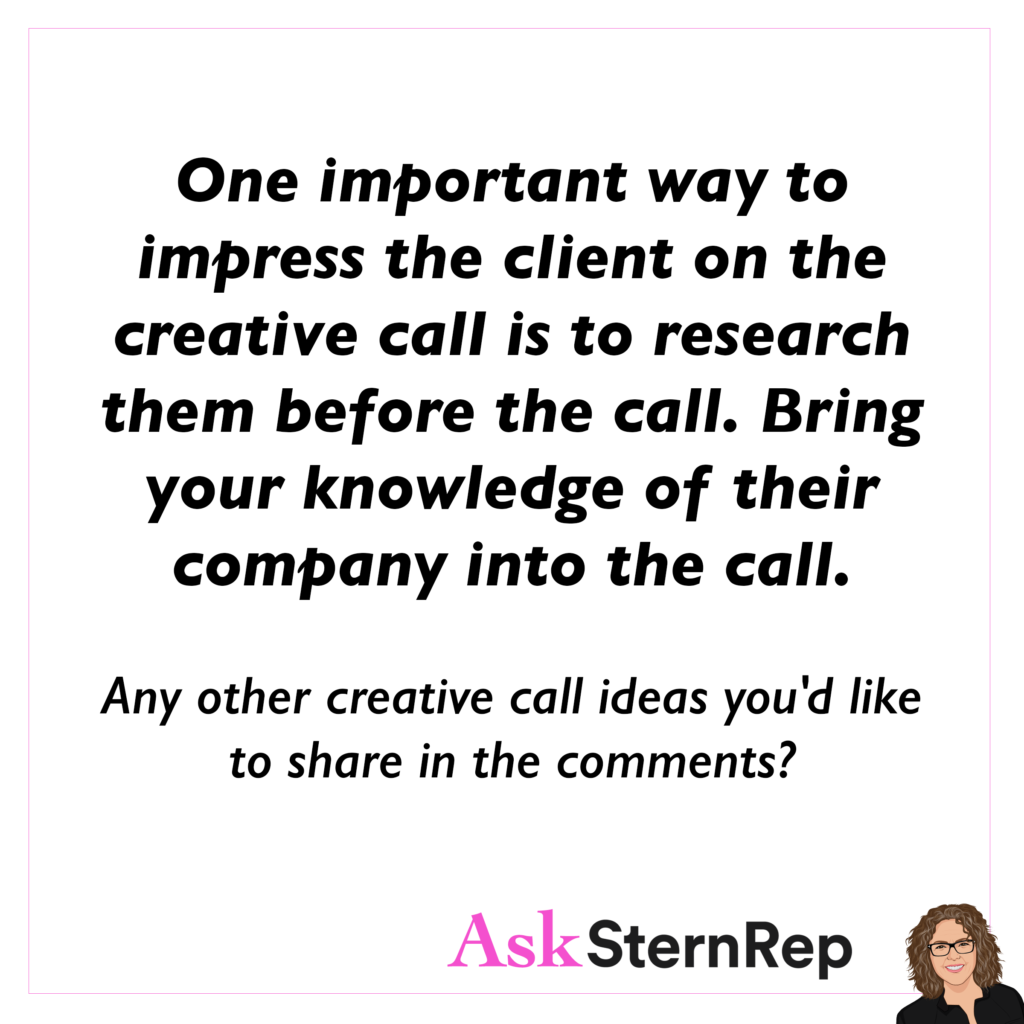
One important way to impress the client on the creative call is to research them before the call. Bring your knowledge of their company into the call.
Any other creative call ideas you’d like to share in the comments?
How Crucial Are Portfolio Viewings?


Q:
I often hear portfolio viewings are crucial, yet I’ve never seen any locally or within driving distance. Should I consider traveling to a larger area such as NYC to have this done?
A:
Yes, a one-on-one or group showing with your portfolio is extremely valuable. I’d highly recommend these for photographers at any stage of their career. Bring them some chocolate!
You Are Your Marketing Department and Business Owner
Big truth: REPS NEED MATERIAL. I always say, “Give me something to say and something to show.”
Big Untruth: I’m a creative/artistic business owner, so I get the day off when I’m not on a paid job.
You are your marketing department, whether you are repped or not, and just like any business owner, you must constantly feed the marketing of your business. Your growth is based on your new ideas, and this never stops! You are being hired for your ideas, and your idea-making skill-set must be seen constantly in your marketing.
Penalty Fee For Usage Infraction


Q:
You mentioned the idea of a “Penalty Fee,” and I’ve never priced this before. I price usage fees, so how does that change for a penalty fee when a client has used my images without paying for them?
A:
Fees in our industry are in constant flux, and there is no one standard across the board. I get creative, and as I am not sure this is the same standard for other reps, a “Penalty Fee” has worked well for me. Clients don’t want to use our images illegally; I find they are unaware of this and want to fix the problem. I price this as a one-charge double rate of the original fee.
Maintain Professionalism On Shoots
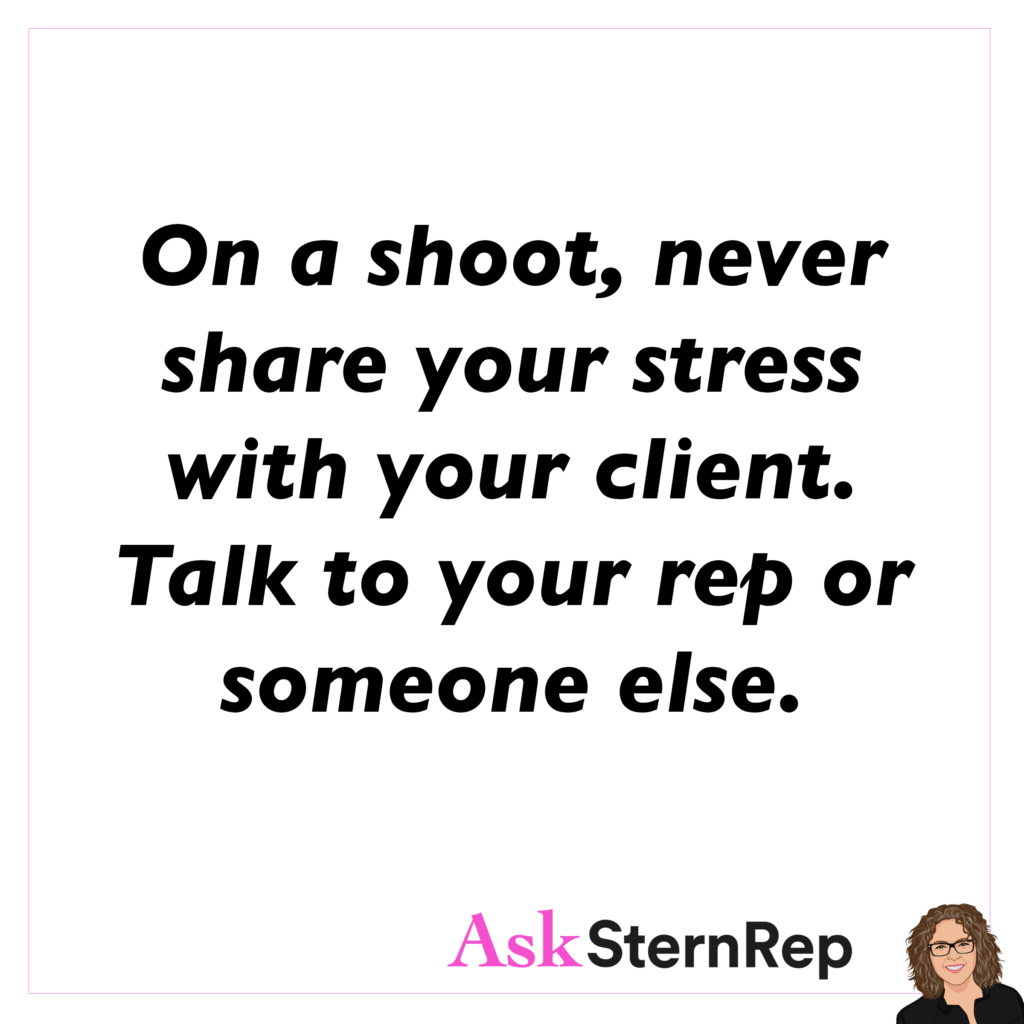
On a shoot, never share your stress with your client. Talk to your rep or someone else.
A Treatment That Stands Out From Other Photographers
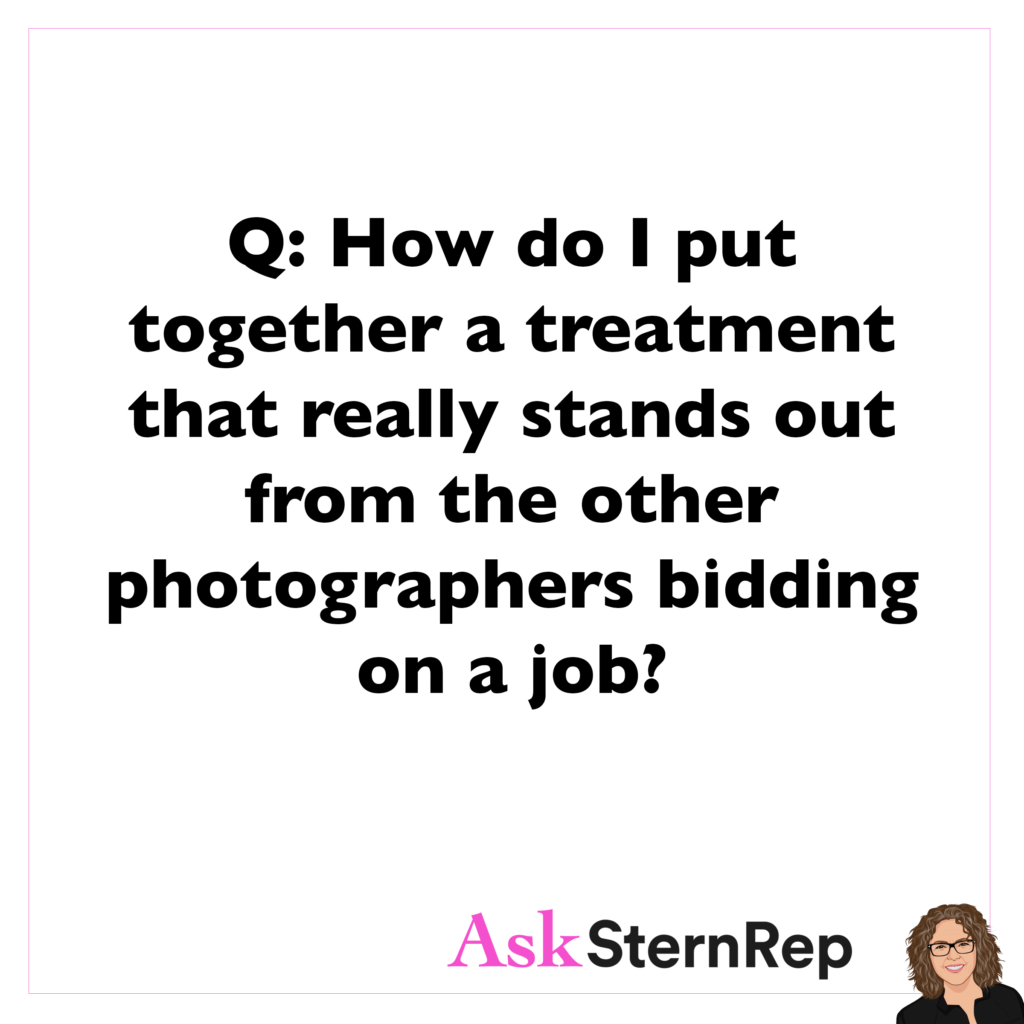

Q:
How do I put together a treatment that really stands out from the other photographers bidding on a job?
A:
Treatments can get you the job. A well-designed and well-written piece is most important. Use a designer and a writer unless you are really good at both of those.
Treatments are very common now, and even if they don’t request one, I recommend sending one in. The treatment should show the type of profession you are and what you’d bring to the job. Explain the technical aspects of how you’d shoot, then cover the important elements of the shoot like locations, talent, wardrobe, lighting, etc.
Everything Is Changing In The Photography Industry
The question we are all dealing with is, WHAT’S GOING ON RIGHT NOW? Everything is changing, leaving us to question the status of our careers.
1. Accept that it is changing; thus, we must adapt.
2. Images are even more “Lofi” – imperfect production quality matching the social media realness.
3. What are you good at, and what can you bring to this situation?
4. Clients are getting more for their money and paying less.
5. Your role may need to fulfill other categories, and you can charge for those – like stylist, creative, storyboarding, pre-production, post-production, etc.
6. Keep yourself as fresh with testing as possible- be as NOW as ever!
Email Promos Are Barely Working
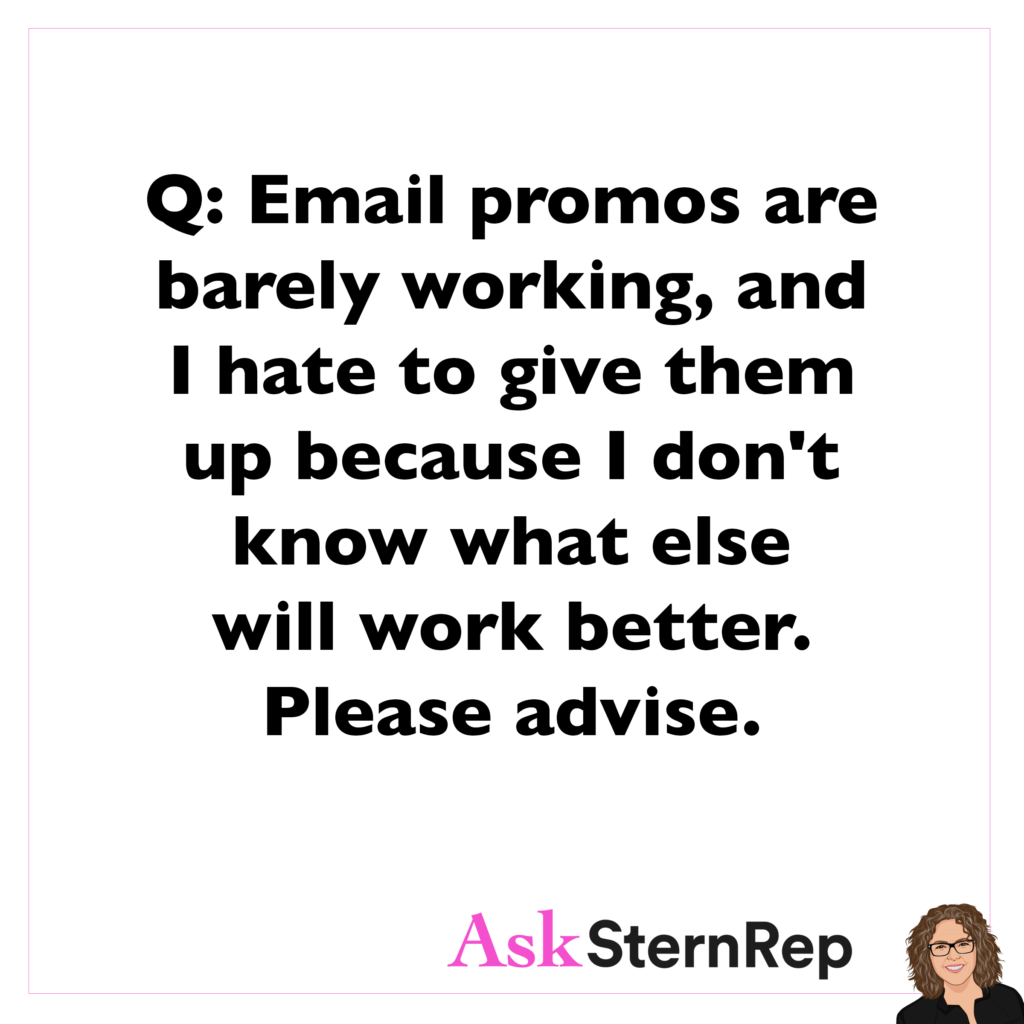
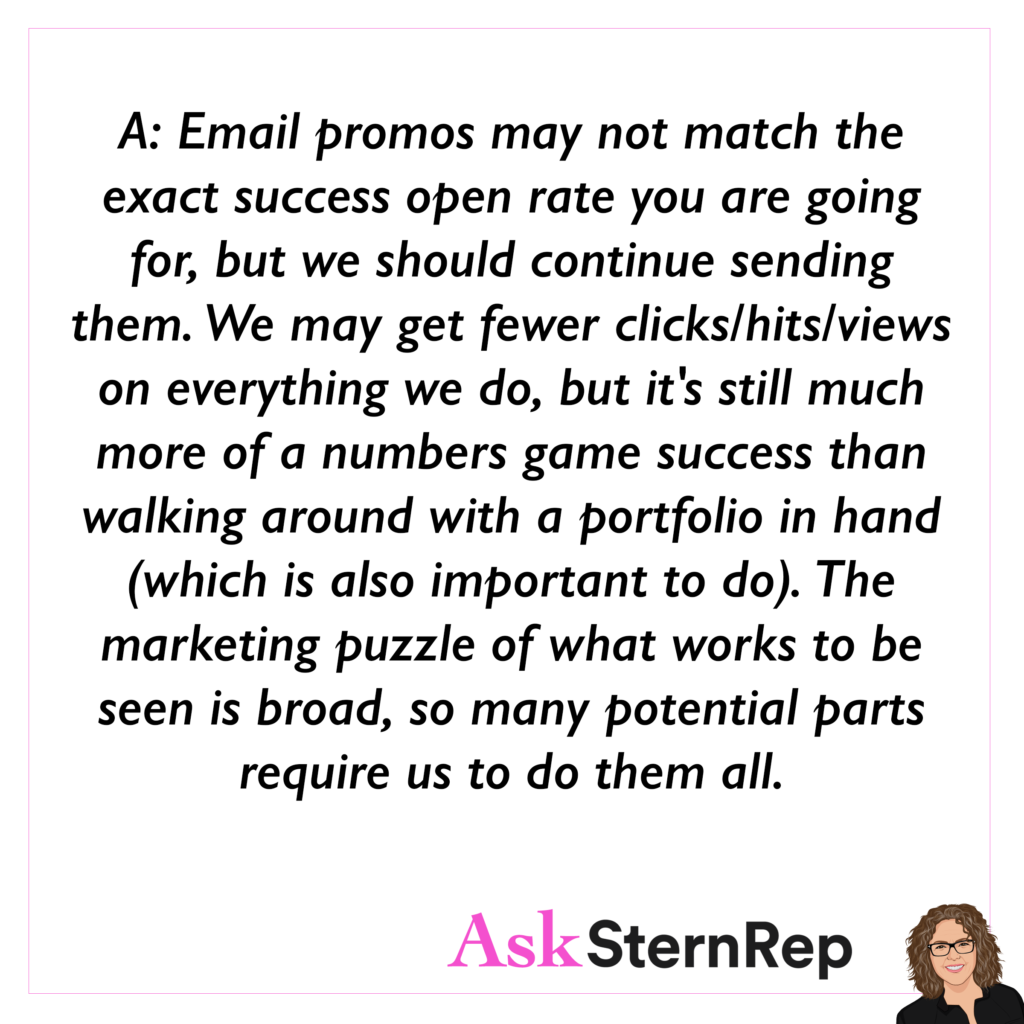
Q:
Email promos are barely working, and I hate to give them up because I don’t know what else will work better. Please advise.
A:
Email promos may not match the exact success open rate you are going for, but we should continue sending them. We may get fewer clicks/hits/views on everything we do, but it’s still much more of a numbers game success than walking around with a portfolio in hand (which is also important to do). The marketing puzzle of what works to be seen is broad, so many potential parts require us to do them all.
Elevate Your Email Subject Lines To Ensure Your Messages Get Noticed

Making the subject line of your email stand out is the most important factor in getting it read. Here are a few of my ideas; please share your own in the comments!
• Be specific with your topic.
• Make it catchy and interesting.
• Use your topic as a reference to what you want them to remember you for.
• Include a question mark.
• Say their name.
A Rep’s Process To On-Board A New Photographer


Q:
What is your process after you’ve on-boarded a new photographer? After discussing where the photographer wants to go and where their work would be a great fit, what is your strategy in regards to marketing? What is a rep’s game plan?
A:
“Marketing Outreach” is a big topic; I could write a few pages! The overall strategy depends on what stage they are at in their career. Here is a started checklist:
- Website portfolio revision and clean-up stage
- Dream client list creation
- Testing needed for long-term roadmap clarity
- Spruce up and revamp all portfolio and listing sites like Behance, LinkedIn, IG, etc.
- Get the word out (big topic)
- Create the schedule for who does what and when
Beware Of Licensing Terms In Contracts To Include Still vs Motion Terminology
As times change, we have to accept how our clients will need our still images for all sorts of motion. We must now be aware to add “still photography only” to our licensing terms. Using still images for motion is a large option that should be paid for instead of granted unknowingly.
Can A Part-Time Photographer Get An Agent?
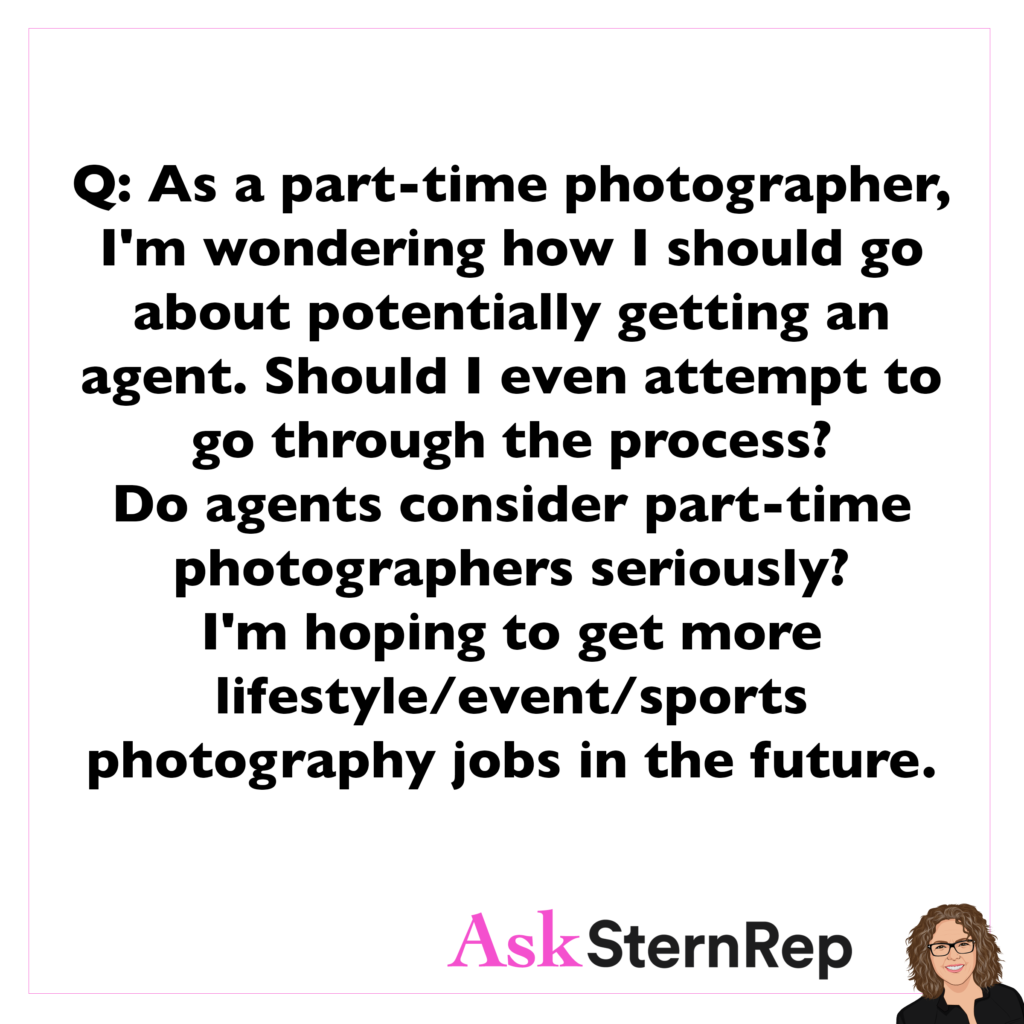

Q:
As a part-time photographer, I’m wondering how I should go about potentially getting an agent. Should I even attempt to go through the process? Do agents consider part-time photographers seriously? I’m hoping to get more lifestyle/event/sports photography jobs in the future.
A:
Reps will require full-time photographers, but we will help to make you full-time if we see a promising portfolio style/look/vibe that matches what clients are looking for. It’s usually back to the same thing – your portfolio. That is the bottom line truth of what makes or breaks everything we are going for.
Ensuring Clarity and Security in Your Bidding Process
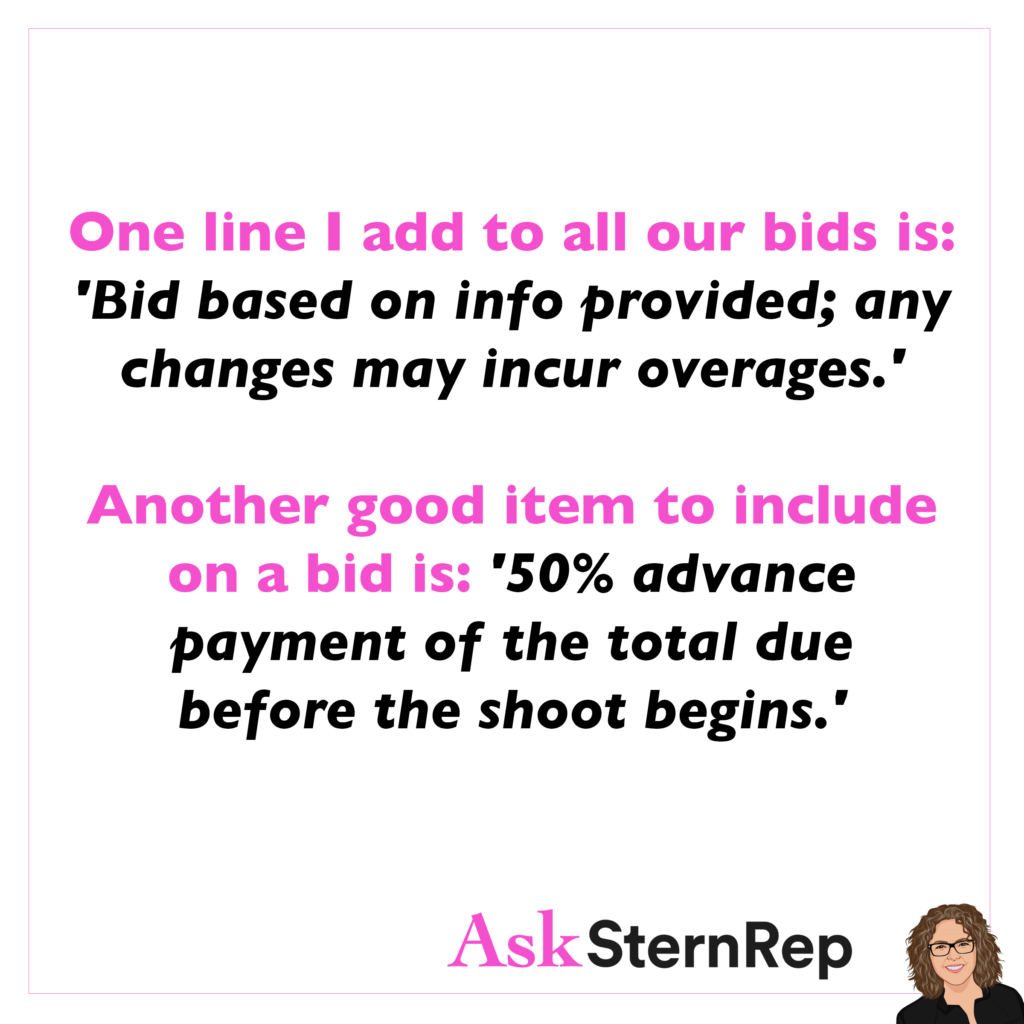
One line I add to all our bids is: ‘Bid based on info provided; any changes may incur overages.’
Another good item to include on a bid is: ‘50% advance payment of the total due before the shoot begins.’
How Do You Know When Your Book Is Strong Enough?


Q:
How do you know when your book is strong enough to start marketing to potential clients? I’ve heard you only get one shot and only one first impression.
A:
You get more than one shot because clients in larger cities change over often. When a client sees potential in your book, they will often want to see where you take it and be the one to help launch your career. Your book is strong enough when you start bidding on jobs.
Do Not Spend Money Before Completing Signed Paperwork
Money spent before completing signed paperwork is dangerous for us. Watch your back by beginning production only after your budget is legally official per your estimate. Do not skip the Purchase Order and Advance Invoice procedure due to the rushed schedule every job tends to demand. It’s not worth the risk.
Clients Ghosting You After Engaging In Several Emails


Q:
The hardest part of this business is dealing with clients ghosting you after engaging in several emails.
How do you get clients to give a quick update???
A:
“GHOSTING” is the new norm due to overworked, busy clients. Potential ways of getting responses include a clean-up of how we communicate:
1. Our note needs to be short, concise, clear, and fast.
2. End ours with the question instead of asking it in the beginning.
3. Assume it’s not good news and would be time-consuming for them to form their words, so you can ask in a way that allows them to say “yes” or “no.”
4. Listen to the ghosting as a business cue to take stock of why the client doesn’t need you right now.
Maximizing Instagram for Photography: Why It’s Essential and 3 Key Reasons to Elevate Your Presence

Instagram IS IMPORTANT.
I’m sorry to say it, because I know it can feel like a bit of a nag, but it can’t be ignored.
3 reasons to up your Instagram game today:
1. It’s FREE marketing.
2. Clients often look at your Instagram before your website.
3. The game has changed, and Instagram is now an intrinsic part of the advertising paradigm.
Staying On Brand While Constantly Reinventing Ourselves

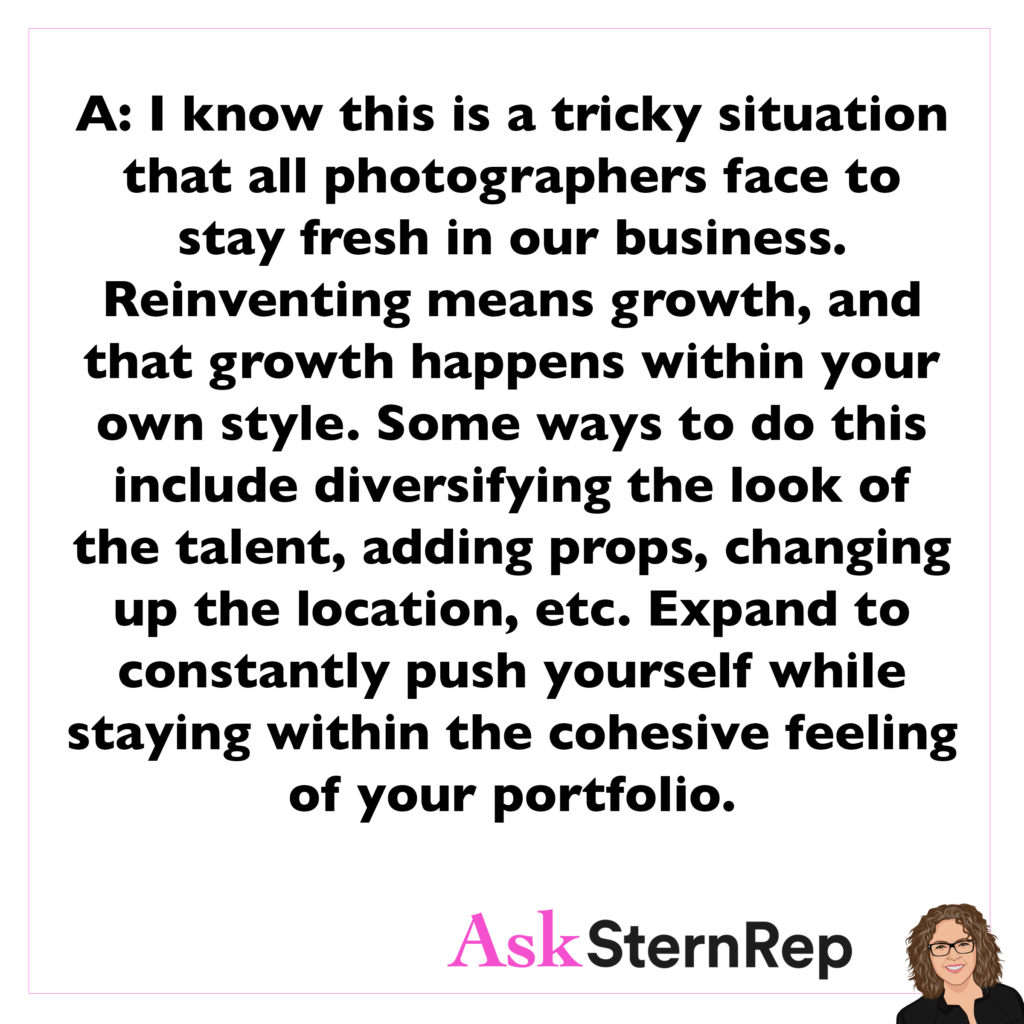
Q:
Wait, so on one hand, we’re supposed to stick to shooting what we love rather than trying to chase trends, but on the other hand, we have to keep reinventing ourselves?
A:
I know this is a tricky situation that all photographers face to stay fresh in our business. Reinventing means growth, and that growth happens within your own style. Some ways to do this include diversifying the look of the talent, adding props, changing up the location, etc. Expand to constantly push yourself while staying within the cohesive feeling of your portfolio.
When We Don’t Hear Back From Clients After A Bid
When we don’t hear back from clients after submitting our bid for the job, I can almost guarantee (most often) that it is because they don’t have a budget anywhere close to our total. Assume that- before spending too much time and effort trying to follow up to make the job happen.
Commercial Jobs Going To Another Photographer


Q:
I’ve had a couple of commercial jobs go to “another photographer” recently with the further suggestion that they would like to work with me in the future. I’m curious if it’s common practice to inquire as to how the client made their decision. Something like, “I would love more information in your decision-making process to better shape my offering.” Is there a good way to do this, or do I thank them for the opportunity and that I would also love to work with them later?
A:
We all want honest client feedback, but the truth is, it’s almost impossible to get. I tend to get the real story when I know them personally, and it’s a one-on-one discussion instead of an email. You can ask, but unfortunately, I see it as a more general nicety that will not be taken seriously on their end. The best way I know to handle this is to find out who did get the job. You then look at their site to make a comparison. See what they focus on, their overall streamlined style, and what we can learn from this comparison.
Turning Failure into Success

Every failure is a golden opportunity to improve. Lost a job to someone else? Use it as inspiration to work harder.
Approaching Clients That Would Be A Good Fit
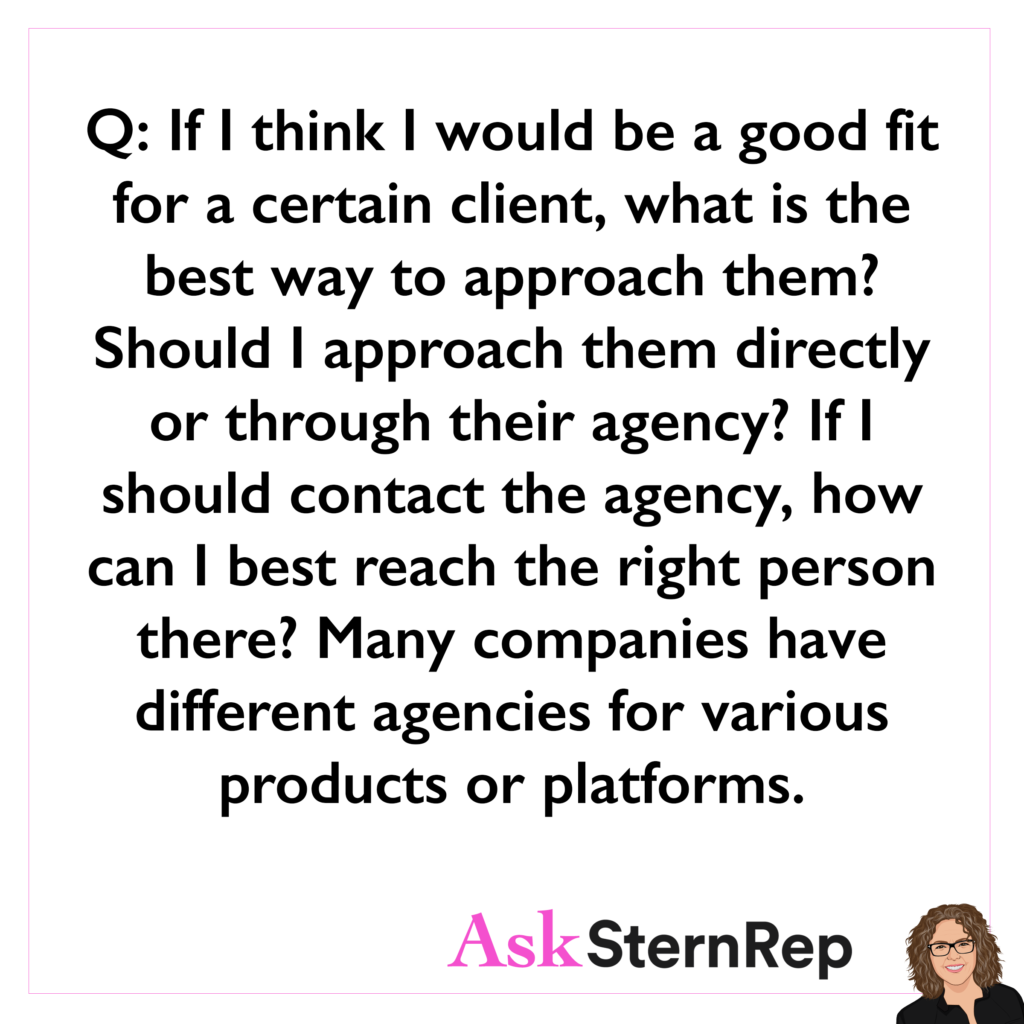

Q:
If I think I would be a good fit for a certain client, what is the best way to approach them? Should I approach them directly or through their agency? If I should contact the agency, how can I best reach the right person there? Many companies have different agencies for various products or platforms.
A:
Yes, approach the client directly and also get in touch with their agency. Try as many ways as you can think of. Be creative and innovative; find ways to get their attention. To find the right person, ask around. I highly recommend LinkedIn, as people tend to respond to it. Go get ‘em!
Overage Fees Are Our Responsibility If Not Outlined In Our Approved Budget
Overage fees for changes/additions are our responsibility to request financial coverage that is not already included in our approved budget.
Dealing with financials before agreeing to or starting the changed work is one of the many “unsaid” standard business practices covered by the photographer/director/producer.
I’m in a situation where we’re working with a client who constantly asks for changes. At the same time, they never mention the budget or how much the changes will cost. It’s always up to us to ask, inform them, explain the implications, and then get permission. It feels awkward, but it’s something we’re expected to do right away. Don’t make the changes and then ask—that’s riskier. Ask immediately because they want the changes to happen quickly. Make sure to cover yourself, even adding a bit of padding to account for potential changes. If this is a client who constantly makes changes, try to set yourself up to protect yourself.
Is My Work Worth Repping?

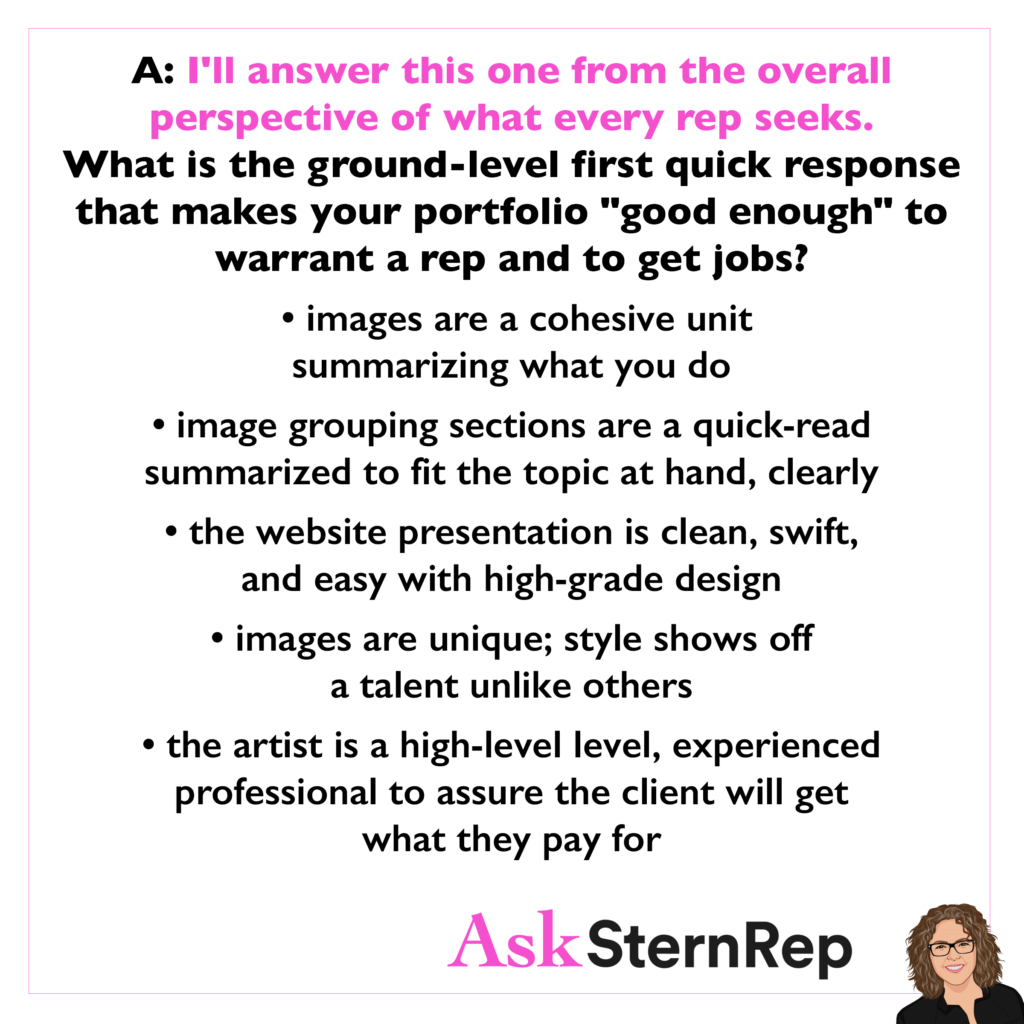
Q:
Is my work worth repping–as in, am I good enough to warrant a rep and good enough to get jobs?
A:
I’ll answer this one from the overall perspective of what every rep seeks. What is the ground-level first quick response that makes your portfolio “good enough” to warrant a rep and to get jobs?
- images are a cohesive unit summarizing what you do
- image grouping sections are a quick-read summarized to fit the topic at hand clearly
- the website presentation is clean, swift, and easy with high-grade design
- images are unique; style shows off a talent unlike others
- the artist is a high-level level, experienced professional to assure the client will get what they pay for
Success Tips For Photographers Include Managing Pressure and Building Supportive Teams

The secret to success for photographers is not to show their ‘cards’ under pressure. Relax and always remind yourself that everything gets done in the end with a great supportive team. Diva photographers are a thing of the past, and no one wants to work with them, whether they are high-profile and talented or not. People want a light-hearted, fun set with NO DRAMA.
How To Reach Out To New Clients
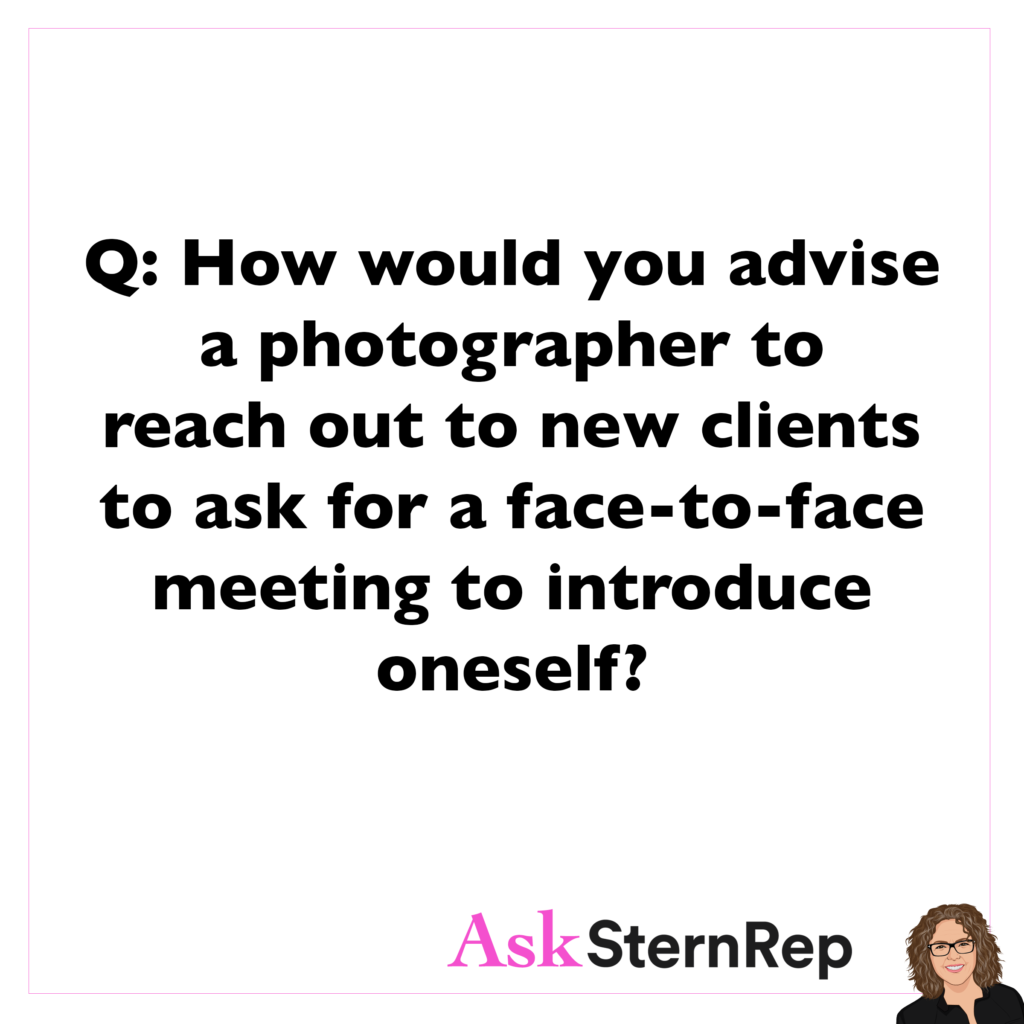
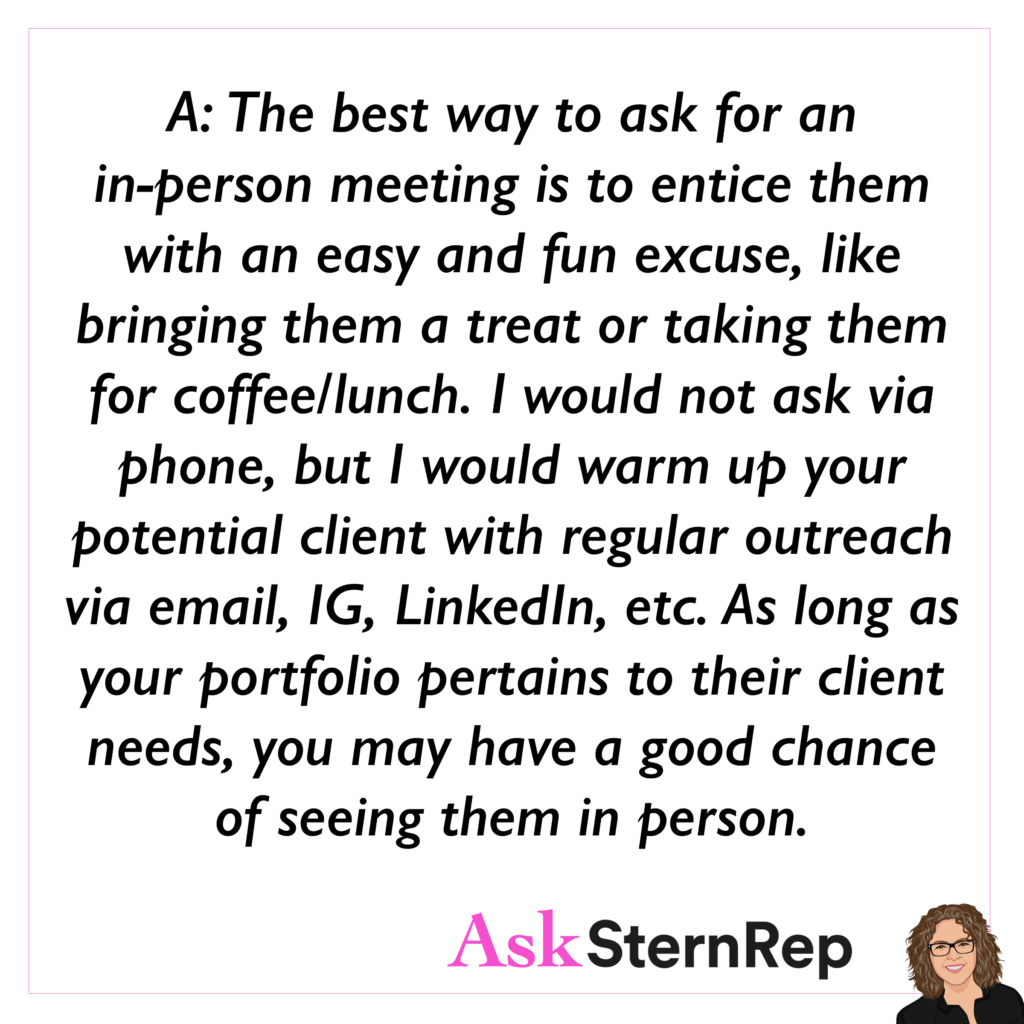
Q:
How would you advise a photographer to reach out to new clients to ask for a face-to-face meeting to introduce oneself?
A:
The best way to ask for an in-person meeting is to entice them with an easy and fun excuse, like bringing them a treat or taking them for a coffee/lunch. I would not ask via phone, but I would warm up your potential client with regular outreach via email, IG, LinkedIn, etc. As long as your portfolio pertains to their client needs, you may have a good chance of seeing them in person.
Bidding A Job Must Clearly Show Details In Order To Get Paid Appropriately
Bidding a job must clearly spell out all the details that our numbers are based on. We risk paying out of our pockets if we ASSUME clients will know our bid-based parameters, such as shot count, the production building time needed to avoid overages, how many rounds of retouching changes are included, etc. Risking miscommunication is our timely responsibility to manage before it occurs.
I’m seeing a lot of trouble happening with photographers because we tend to assume it’s hard to cover everything. We assume that clients are going to know our restrictions or understand what we meant by specific dates, production costs, or other details. Everything needs to be spelled out clearly, including timing and scheduling. Do clients understand the schedule? We have to stay on top of it to ensure they do, even if we’ve already stated it or made it clear in an email. Don’t assume anything, whether it’s how many images you’re going to shoot, how many images are included in usage, or anything else related to your production. If you’re doing a big production and need the client’s approval by a certain date because you require a specific amount of time to start and finish before the shoot date, that has to be clearly stated in the bid and reiterated in an email. Make sure clients know everything, and don’t assume they understand anything.
Rep Relationships With Roster


Q:
Hi Andrea! I want to ask what your relationships are like with your roster. Have you met with them all in person, even those not in the same city/state? How often do you meet in person with your roster? Is this important?
A:
SternRep is a smaller agency with a smaller roster, and we like to keep it more personal in a teammate way. We don’t have to meet in person these days, but we all want to get a good sense of who we are and how we work. Knowing as much as possible before committing to a long-term contract can save us a lot of time. I like to ask around to get other’s input. When I started repping, I’d ask the photographer’s assistants and producers how the photographer treated the crew on set. That was my quick, detective way to find the kind people. Ask around!
Craft a Winning Portfolio: Target Specific Clients and Secure Every Bid
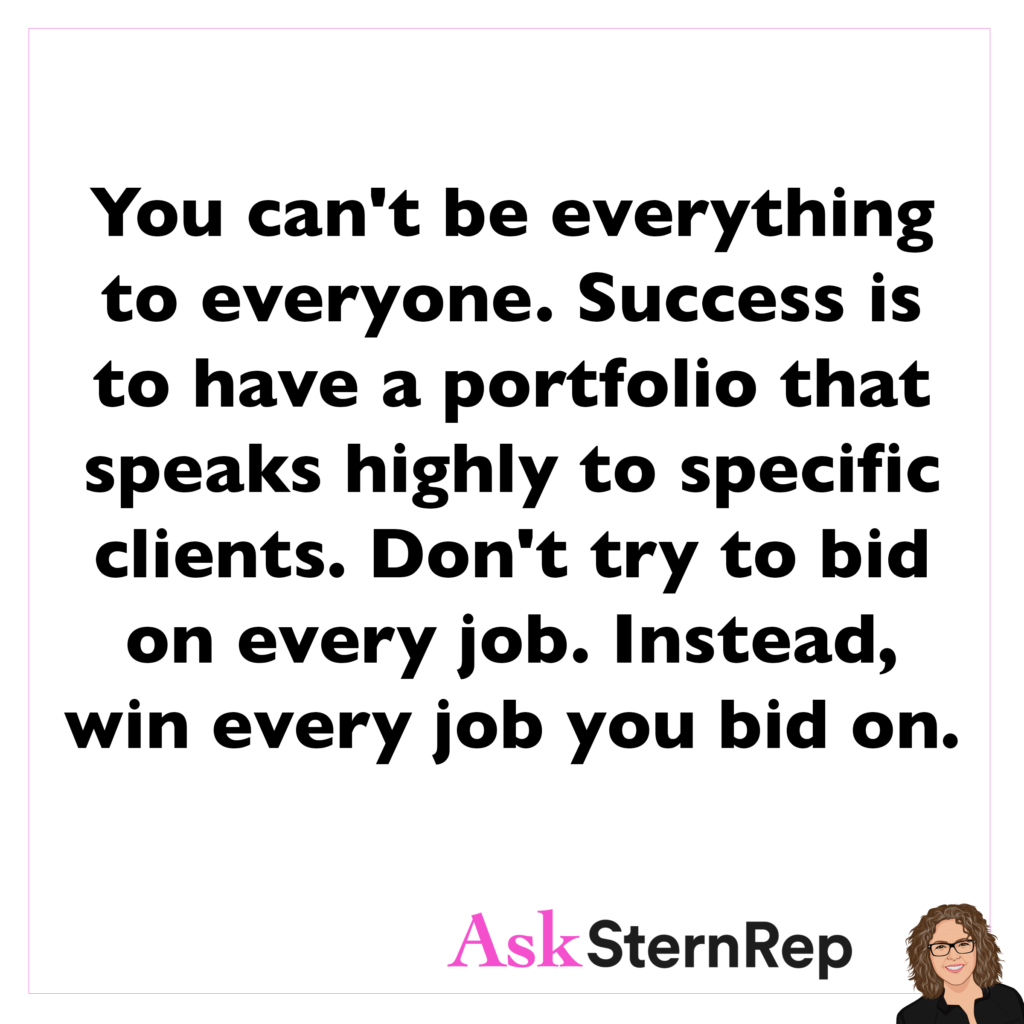
You can’t be everything to everyone. Success is to have a portfolio that speaks highly to specific clients. Don’t try to bid on every job. Instead, win every job you bid on.
How To Reach Out To New Clients
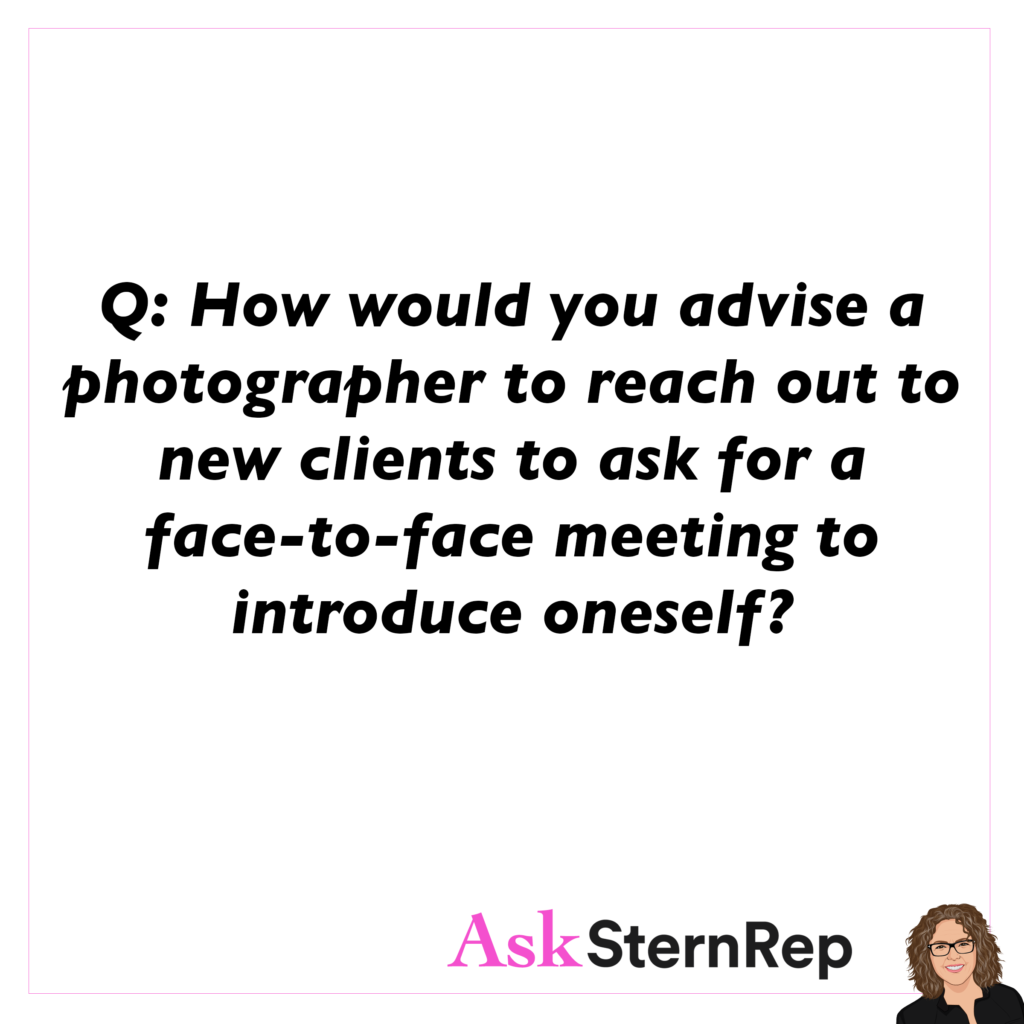
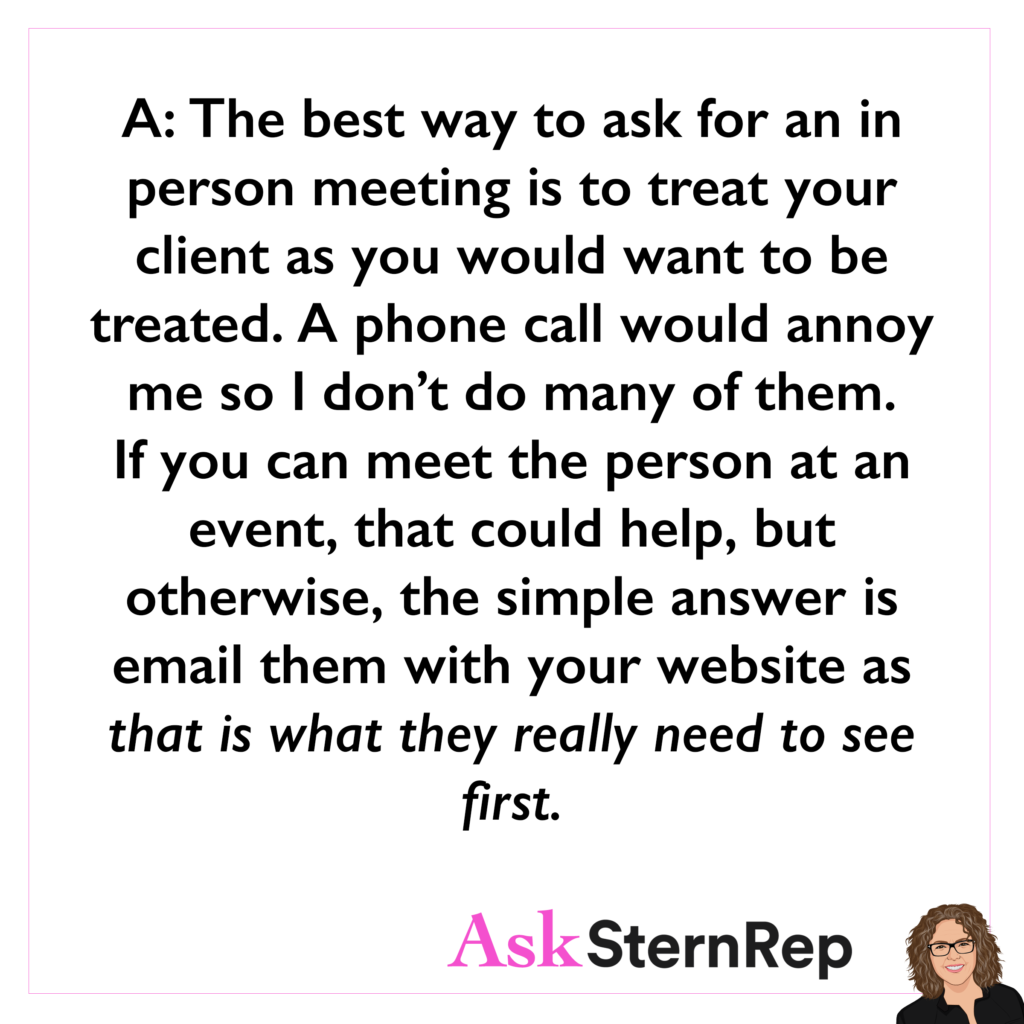
Q:
How would you advise a photographer to reach out to new clients to ask for a face-to-face meeting to introduce oneself?
A:
The best way to ask for an in-person meeting is to treat your client as you would want to be treated. A phone call would annoy me so I don’t do many of them. If you can meet the person at an event, that could help, but otherwise, the simple answer is email them with your website as that is what they really need to see first.
The Best Way To Stay In Front Of Clients Is With ENGAGEMENT
The #1 way to stay in front of clients is free and available at our fingertips, and yet we tend to ignore half of what we need to do- ENGAGEMENT. Sorry, I know it’s time-consuming, but why spend time and money on other marketing resources and ignore the one tool most guaranteed to work? Be your-human-self with comments and views, actively connecting as a real person.
If I were asked what the most important tip for a photographer is, I’d say something you might not want to hear. You hear us, Ranee and me, talk about this all the time on AskSternRep and SternRep: engagement on Instagram. Instagram—give me a minute, please. I know it’s the one place where we’re almost 90% sure clients are active. Where else are they actively engaging? Nowhere. Emails? LinkedIn, maybe? But on Instagram, they’re definitely there.
However, it’s not enough to just show our work. We have to engage with them so we show up in their stories and feed. We have to be the active ones—that’s the key. I know it might not be what you want to hear, but it’s really, really true. Please don’t hate me for saying it!
Too Old To Start A Commercial Photography Career


Q:
I have a question and be brutally honest. Is 45-years old too old to start a commercial photography career?
A:
NO! In contrast to popular opinion, our industry is not ageist. Clients don’t even know our ages until the creative call Zoom. The deeper answer is that clients seek young-minded, fresh imagery to match their goal of catching their youthful audience’s attention. You can do that at any age if you can explore new ideas instead of getting stuck on old styles.
A General Good “Sales” Rule

A general good “sales” rule: Ask questions instead of overloading your clients with information.
The Importance Of Treatments
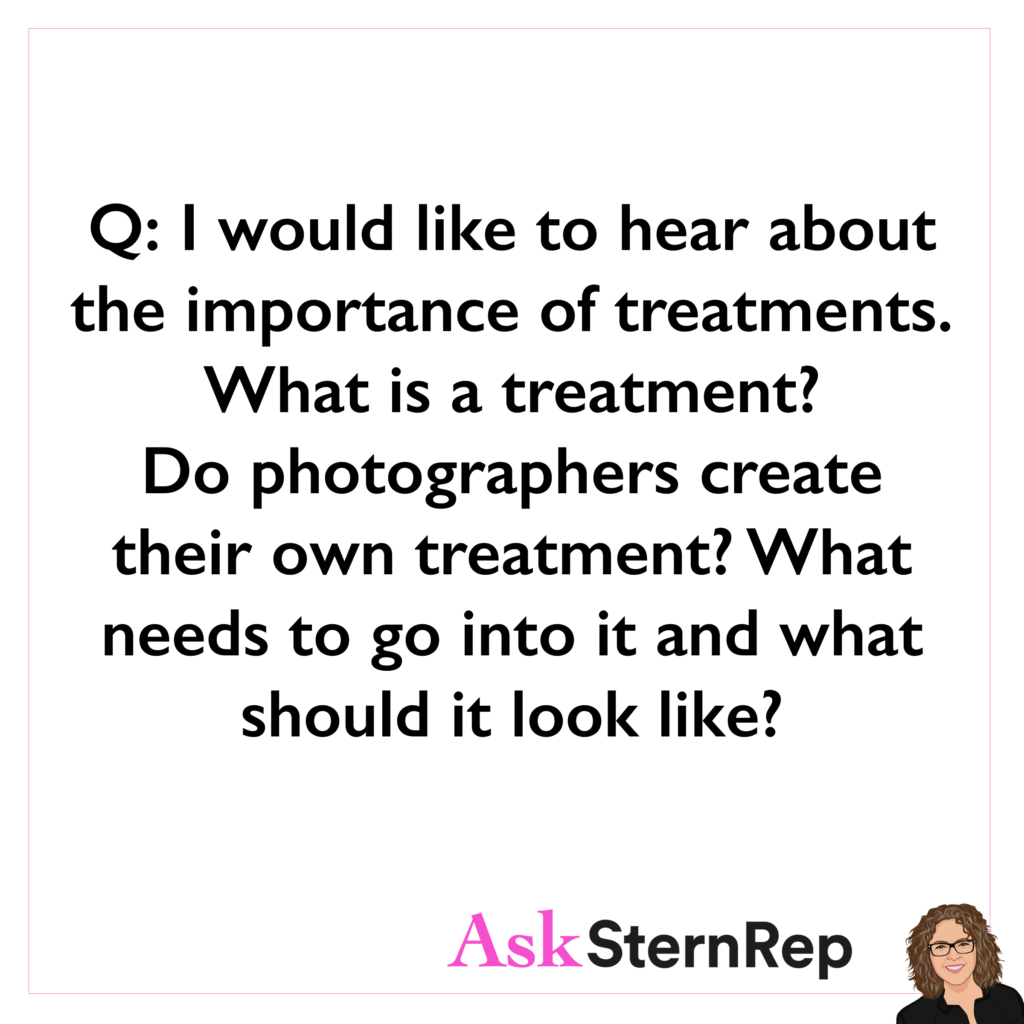

Q:
I would like to hear about the importance of treatments. What is a treatment?
Do photographers create their own treatment? What needs to go into it and what should it look like?
A:
A great treatment is one of 3 keys the photographer needs to get the job:
1. The Portfolio
2. Creative Call
3. The Treatment
A treatment is a pdf full of all the info to show the creative how the photographer will approach the job. It will include samples of images, locations, talent, wardrobe, etc.
Yes, photographers create their own treatment, and I have to say it’s like getting their teeth pulled. They are not writers and normally their portfolio speaks for them. This takes a sales type of “showing off” that photographers are uncomfortable with in general.
It needs to look slick and put together because the creative will read this to know what the photographer is bringing to the project, how they work, how they see this job, and how well they can deliver a packaged expression of their work.
Usage Renewal Prices Based On Duration Options
USAGE RENEWAL prices based on duration options are not split perfectly into divided values.
Two reasons:
1. We prefer the client to choose the more expensive, longer-term option.
2. Images may be more powerful, holding higher value when seen for a shorter time.
I deal with a lot of client requests regarding usage licensing rights, and they often want to know the price difference between various durations. It’s important to understand that the cost for different durations isn’t simply a matter of dividing a longer period by the number of shorter periods within it. For example, the cost for one month isn’t just one-twelfth of the cost for a year.
The impact of using an image for a shorter period, such as one month, can sometimes be greater, so we need to raise the value for shorter periods of time. It doesn’t work to just evenly divide the cost over time, and clients might not realize this. They might expect the price for a shorter duration to fit into the longer duration’s price equally divided, but that’s not the case. It’s important to know this and price your services fairly.
What’s The Best Way To Get New Work In Front Of The Right Audience?
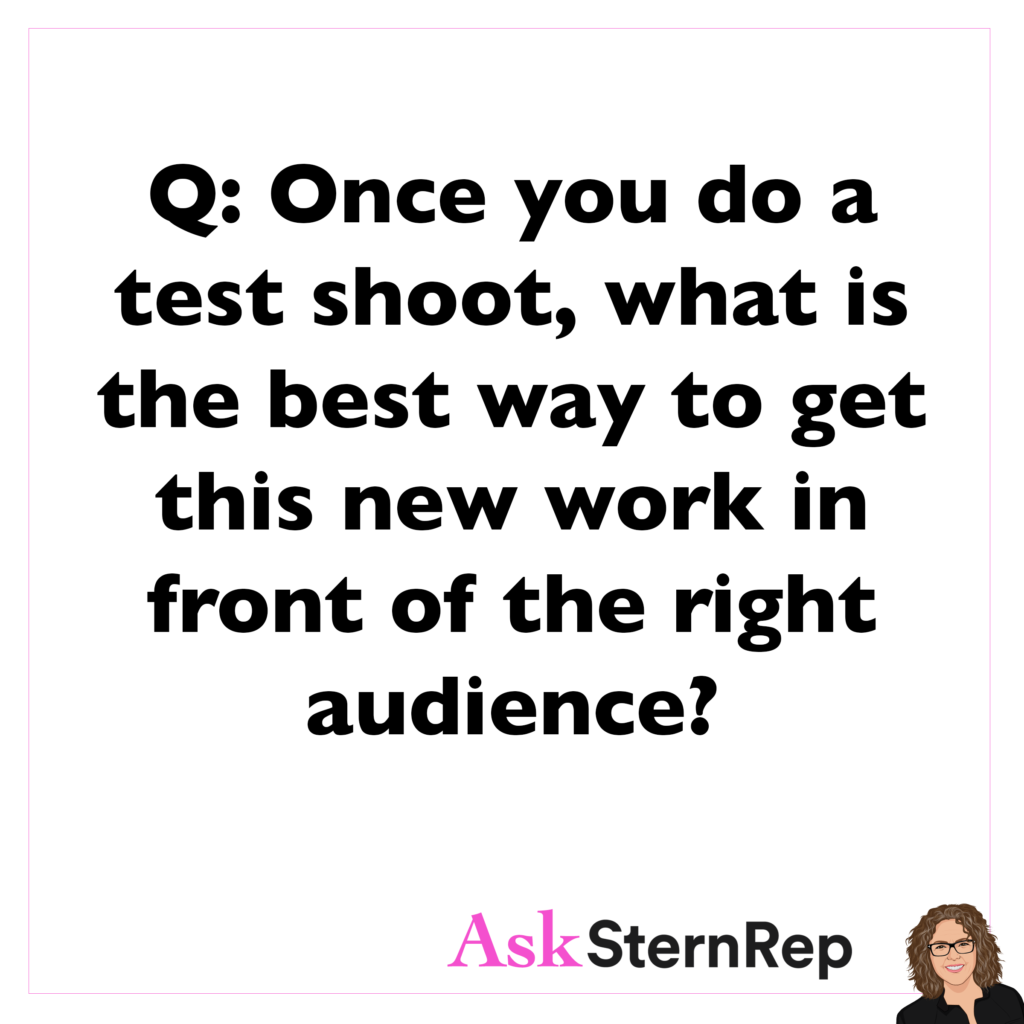

Q:
Once you do a test shoot, what is the best way to get this new work in front of the right audience?
A:
As a rep, this is one of my favorite topics because this is the purpose of testing. Reps and consultants’ goals are all about shaping the long-road path. I call this- “growing forward.” Every test should have a client in mind, and with that comes the OUTREACH follow-through to share the images with the appropriate “warm” and “cold” potential clients. Outreach happens on all platforms, including personalized communication, to upgrade clients to a warmer level than where they are now. You want to be good enough to be on their list when that specific type of project comes up. This is either a monotonous process or a fine-tuned, distinct, mapped-out marketing plan.
Don’t Take It Personally
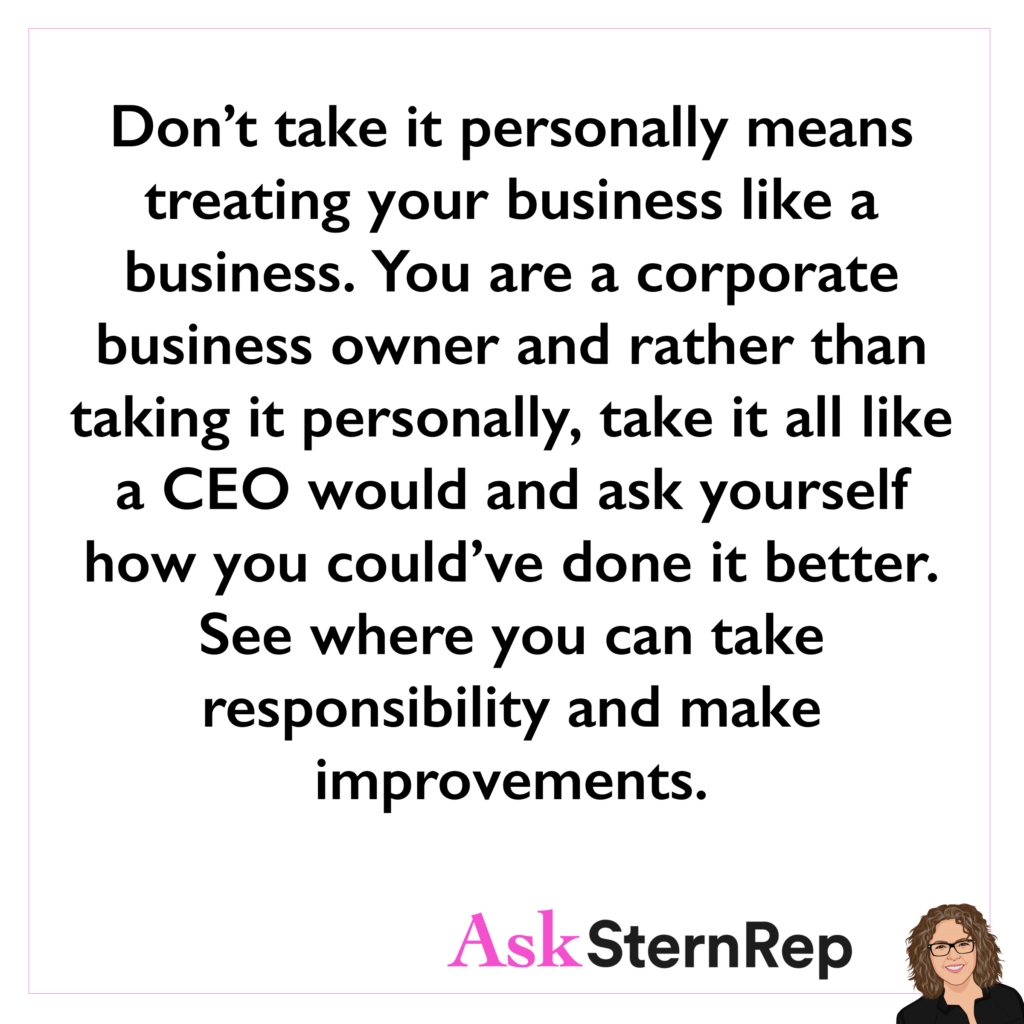
Don’t take it personally means treating your business like a business. You are a corporate business owner and rather than taking it personally, take it all like a CEO would and ask yourself how you could’ve done it better. See where you can take responsibility and make improvements.
Designing A Website As A Photographer

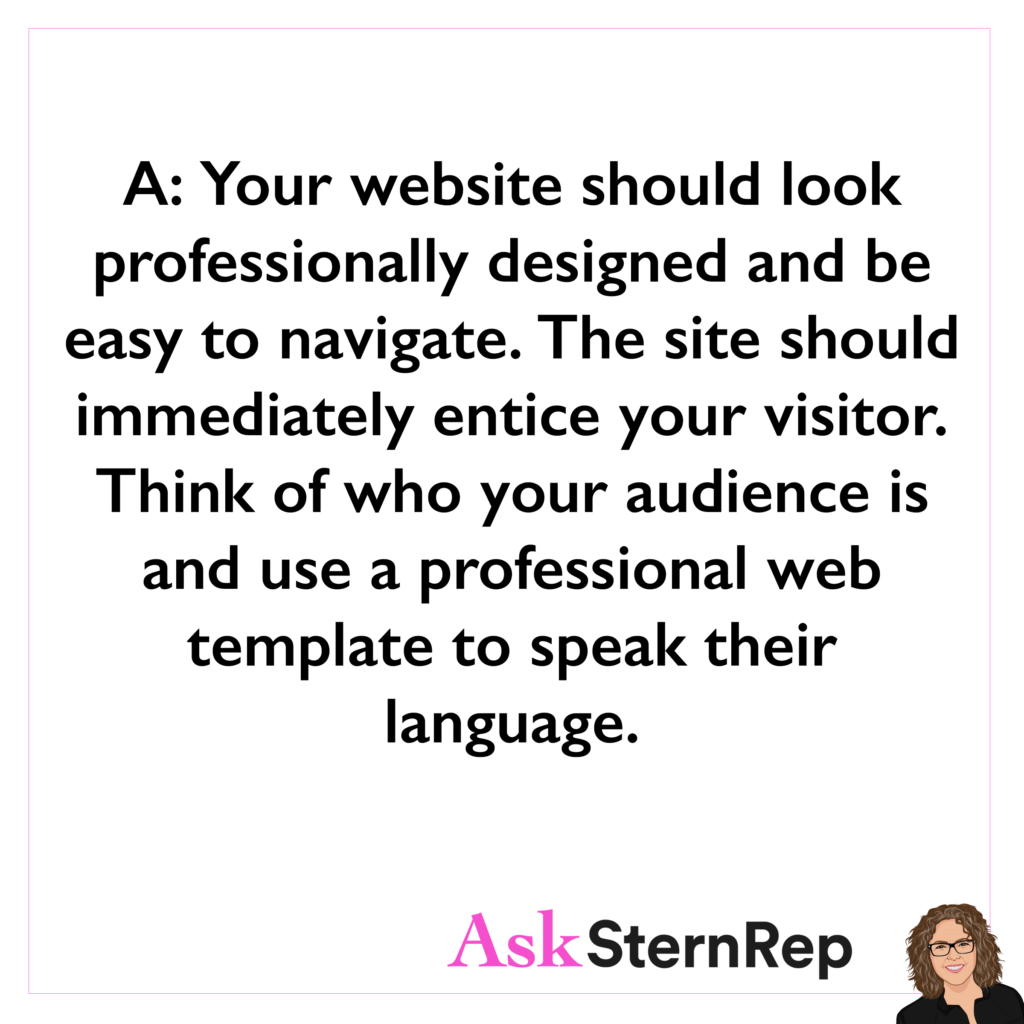
Q:
What are some things to keep in mind when designing a website, as a photographer?
A:
A: Your website should look professionally designed and be easy to navigate. The site should immediately entice your visitor.
Think of who your audience is and use a professional web template to speak their language.
Email Promos Are Not Getting Through To Clients
Facing A Fact: Our 3rd party email promos are not getting through due to the client’s email filters.
Lessons to be learned:
-Even though this has been true for a while now, hearing it directly from a client makes it even more real.
-We cannot rely on email promos as our single source of marketing.
-We can use the ‘clicked on’ info as even more valuable to see who is seeing our work.
-Outdated promotion tactics have a place, but we have to stretch out and find less capacity ways to reach out.
I’ve been in denial about email promos actually landing in our clients’ inboxes. I received an email from a client, an art producer at a company, and this is what she said: “I think they’re more likely to open an email from me, as third parties have some tough email filters to get through and land in an inbox.” Of course, we all know this, but I haven’t really been facing the reality. I send out a lot of emails and spend money on them, but the promos might not be getting through as often as I thought.
I still think they’re worth doing, but they’re not landing as much as they should because of these companies’ email filters. One solution is to ask my contacts to send out the promos themselves. Another approach could be to use Instagram DMs or to engage with clients we’re already connected with on LinkedIn, perhaps posting or sending promos there. We need to find other ways to get our images seen by people who might not know us yet. I have to accept this and figure out alternative methods to reach our audience.
Do Cost Consultants Have A Realistic Grasp Of Time And Costs?


Q:
Do you find that cost consultants have a realistic grasp of the time and costs needed for a job, so the negotiation isn’t a “difficult” process?
A:
The facts on cost consultants:
1. Their job is to find ways to minimize our costs. They must find areas to lower by comparing the other bids and their past experience.
2. We don’t have to agree to every minimizing request as long as we explain our pricing reasoning.
3. They will be experienced with a realistic grasp of the job’s timing and costs if this client repeatedly does the same type of job.
4. Sometimes, the cost consultant is helping lower our budget if we are the #1 pick for the job.
Photographers of All Ages Must Embrace Continuous Reinvention for Career Success

As a photographer’s career progresses they must continue to reinvent themselves. A photographer must explore and grow to show what they can bring to the job. This is a young-person’s career unless photographers of every age commit to staying hungry for fresh inspiration and new ways to communicate their vision.
The Standard “Book” For Representation

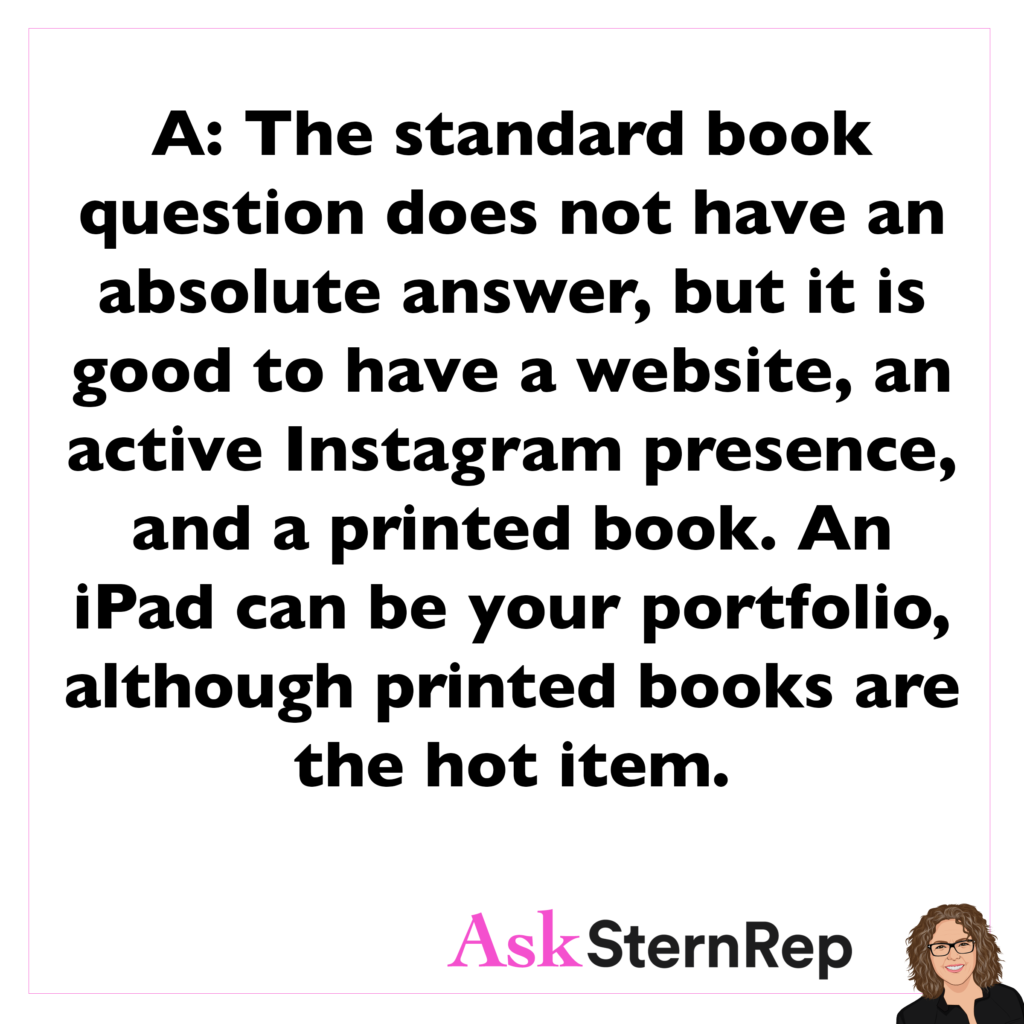
Q:
What is considered a standard “book” for somebody seeking representation…
Is it a website? A physical book? Something else?
A:
The standard book question does not have an absolute answer, but it is good to have a website, an active Instagram presence, and a printed book. An iPad can be your portfolio, although printed books are the hot item.
Finding Your Strengths And Weakness In Your Marketing Plan
As business owners, we must get our Marketing Plan in place to direct all the potential areas we should spend our time and budget on. Know all available options for crystal clear analysis of what is working, what to try, and what needs our attention. You are a business, so have a plan.
https://asksternrep.com/download-pdf-files-for-market-strategies/
We hear a lot about marketing budgets, and yes, they’re important, but even more crucial is having a marketing plan. That plan needs to adapt, shift, and constantly change with the times. The one constant truth about our business is that it’s always evolving, so we have to stay on top of that. I suggest checking in with your marketing efforts about four times a year or so.
Look at what you’re learning from your Google Analytics, SEO, and methods for getting email promos out there—it’s really challenging. Consider the effectiveness of sites like LinkedIn and Instagram, and whether you’re engaging and connecting with people. All of these aspects are part of your marketing plan.
Also, know what you are best at. Is it presenting to clients one-on-one in person, or is it sending them a printed portfolio? Whatever your strength is, master it, and then make sure to analyze and refine all the other parts of your marketing plan. Stay proactive and keep evolving your strategies.
Stay Strong In Your Style

Stay strong in your style. Don’t compromise your voice to be everything to everyone or you will get lost in the mix. It is your unique vision and execution which will set you apart from the pack and get you the job!
The Secret To Being A Successful Creative


Q:
What is the secret to being successful as a creative?
A:
It is to be open to listening instead of being so busy with everything you already know.
What Is The Quick Trick To Marketing Ourselves?
What is the trick to Marketing? Quick answer: Relationships.
How to do this: Try everything, see what sticks, but only base some of your future marketing on what you learned in the past. I know this is tricky; we must try it all, keep experimenting, and DO NOT LIMIT OURSELVES only to what has worked in the past.
We all know how important marketing is in our business—it’s everything. Yet, there is no set plan for it; there is no absolute, definite “this must happen.” Of course, your website needs to be correct and up-to-date, but marketing as a whole has to be more experimental. I see it as throwing spaghetti against a wall and seeing what sticks. However, we can’t rely on just one approach over time; we have to continuously try new things.
Marketing is heavily based on relationships. I often get calls from clients I didn’t even know would remember my name, but we had a nice connection a year ago or even three years ago. When you get yourself on a list, clients remember you and want to stay in touch. The more we put ourselves out there, the better. We need to try everything, see what sticks, and not solely rely on what’s worked before. Do more of what works, but also explore every possible avenue to connect with clients.
When Things Are Difficult, Find a Solution

When things are difficult, find a way through. Throwing your hands in the air or collapsing in frustration, these things do not move you forward. Pause, collect yourself and then take an action to move forward.
The Key To An Amazing Creative Call
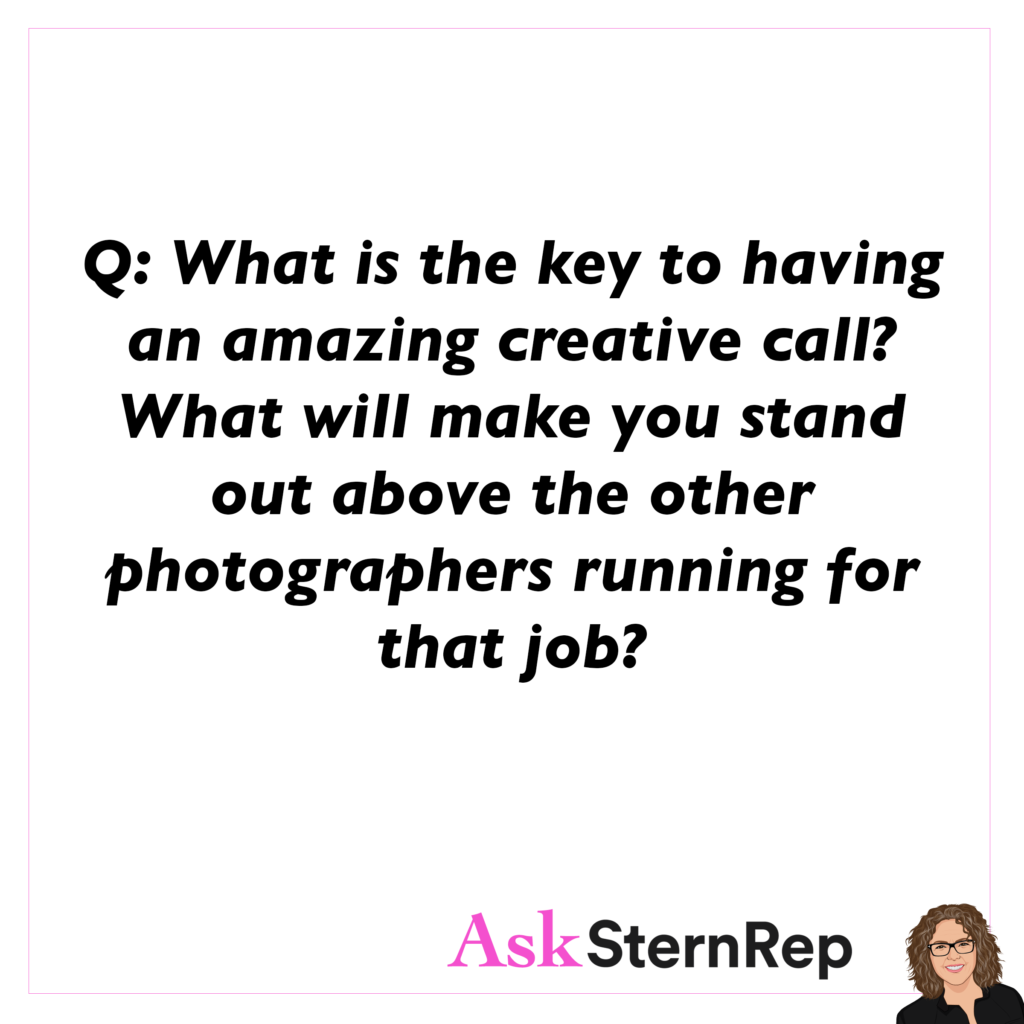
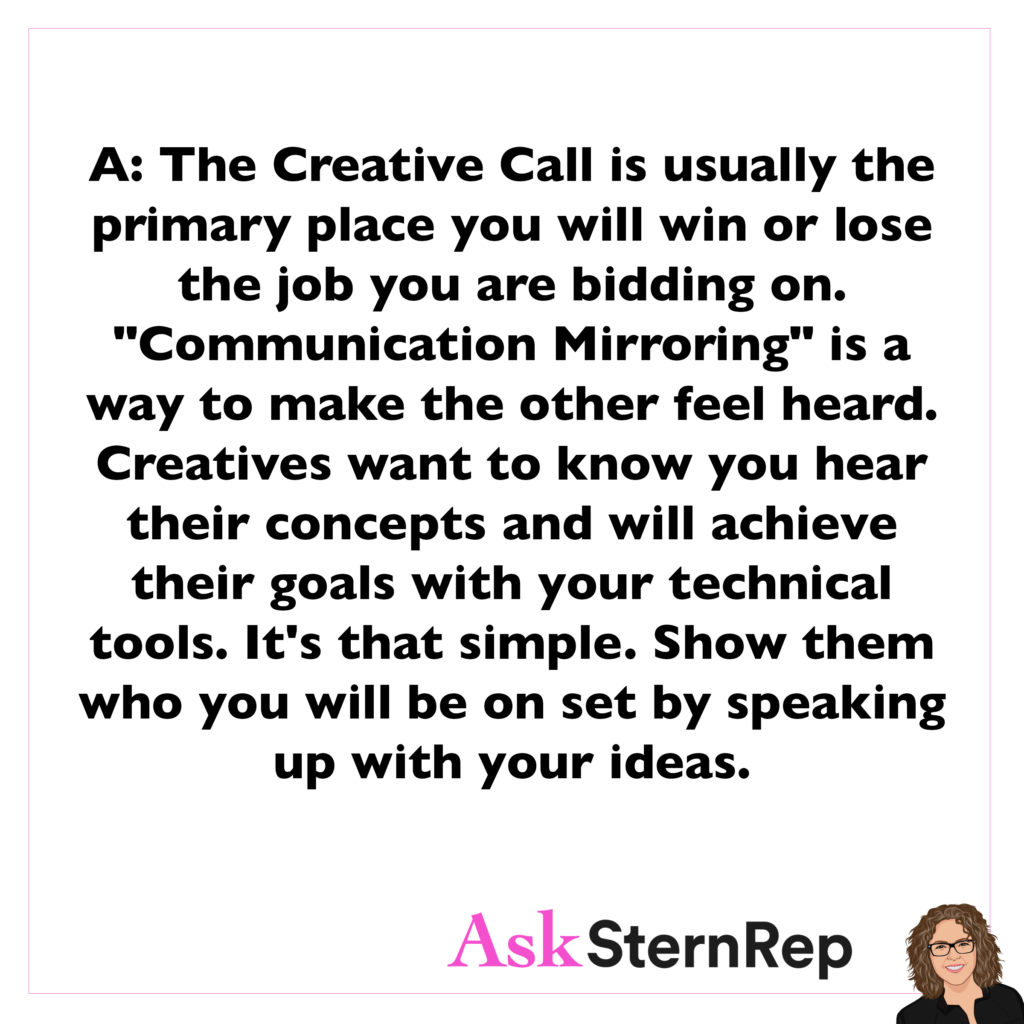
Q:
What is the key to having an amazing creative call? What will make you stand out above the other photographers running for that job?
A:
The Creative Call is usually the primary place you will win or lose the job you are bidding on. “Communication Mirroring” is a way to make the other feel heard. Creatives want to know you hear their concepts and will achieve their goals with your technical tools. It’s that simple. Show them who you will be on set by speaking up with your ideas.
Fact-Checking Clients To Better Improve Our Bidding
Bidding on a job requires fact-checking client answers. Often they are slow to come in or don’t get responded to. What do we do? Try a new way – make your questions form a cohesive list to be answered by attention-getting dashes, bullet points, or (my fave) numbers.
You know when you’re bidding on a job and the contact at the agency or client isn’t responding to your questions? It seems like they’re missing something. I assume they’re rushed and don’t have time to go through a full email, or maybe there’s too much chatter instead of getting to the point. We need to make our emails extremely clear and concise. Don’t be afraid to keep asking the same questions until they get answered.
I know we don’t want to make the person uncomfortable or make the communication awkward, but you have to keep asking. Try doing it in a different style; perhaps they’ll understand better if we lay it out differently, using bullet points, dashes, or numbers—numbers are very helpful in an email. If that doesn’t work, consider trying a phone call; maybe they’re not into emails, and that’s why it’s not working. The important thing is to keep trying, even if it feels awkward.
Pros And Cons of Being Represented
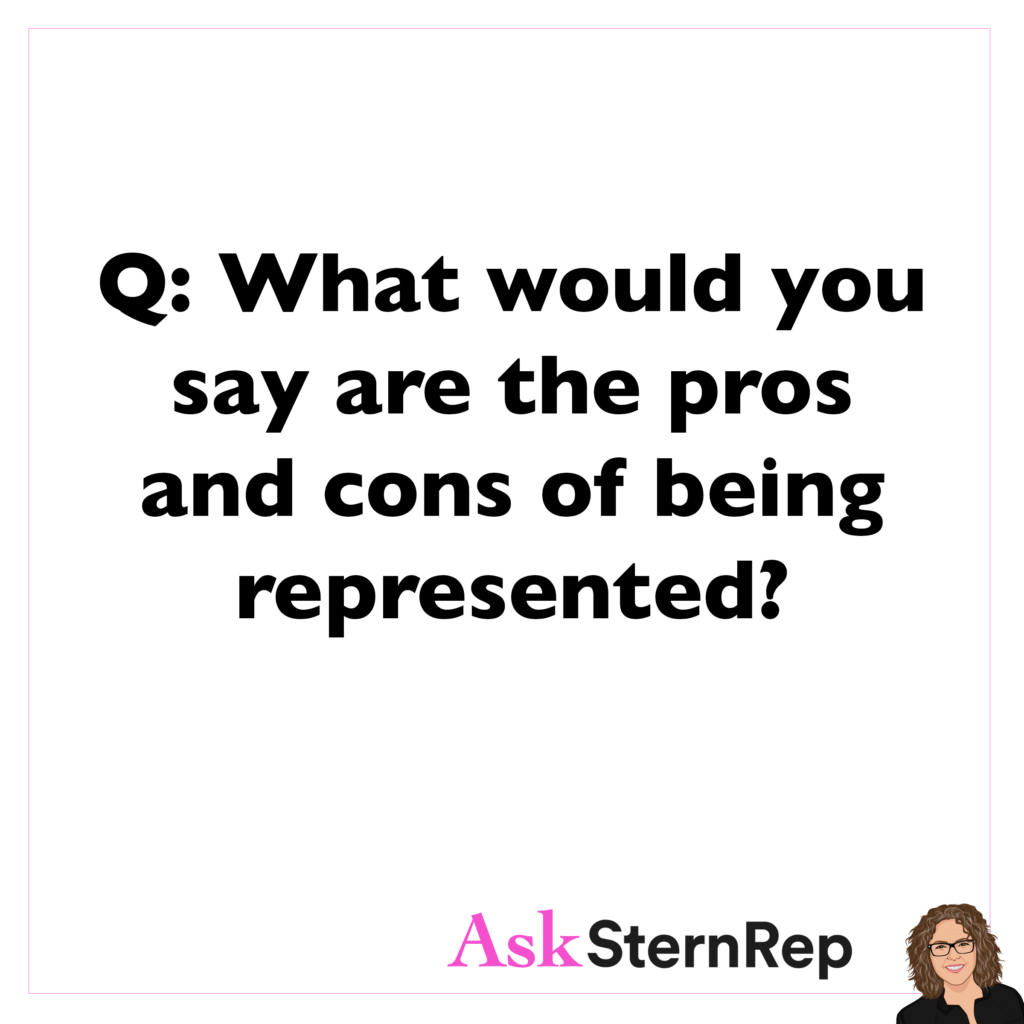
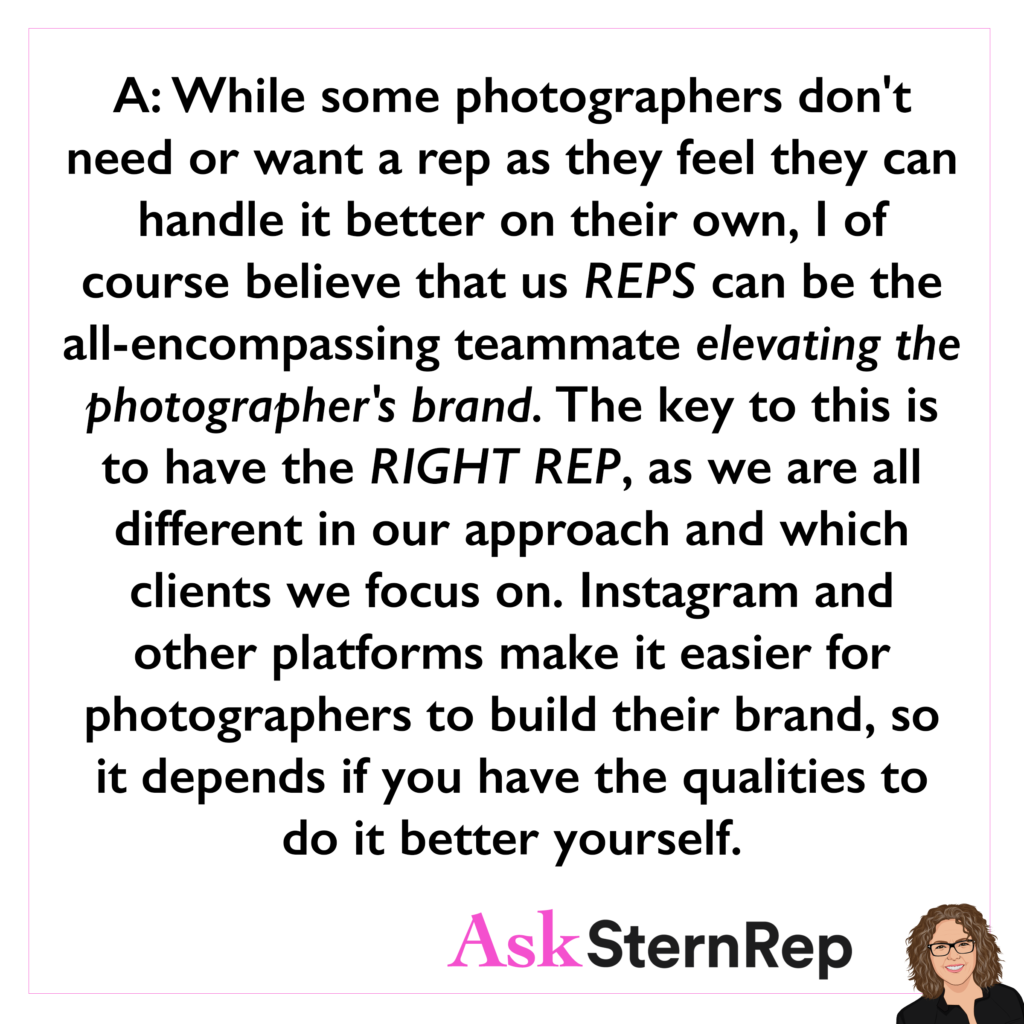
Q:
What would you say are the pros and cons of being represented?
A:
While some photographers don’t need or want a rep as they feel they can handle it better on their own, I of course believe that us REPS can be the all-encompassing teammate elevating the photographer’s brand. The key to this is to have the RIGHT REP, as we are all different in our approach and which clients we focus on. Instagram and other platforms make it easier for photographers to build their brand, so it depends if you have the qualities to do it better yourself.
This is YOUR Business, You Are Not Just An Artist

This is YOUR business. Do you have insurance? Are you tracking expenses and income? Do you have a business license? You are not just an artist anymore, you are a business owner, so take control and handle all necessary details.
Is It Important For A Photographer To Assist?
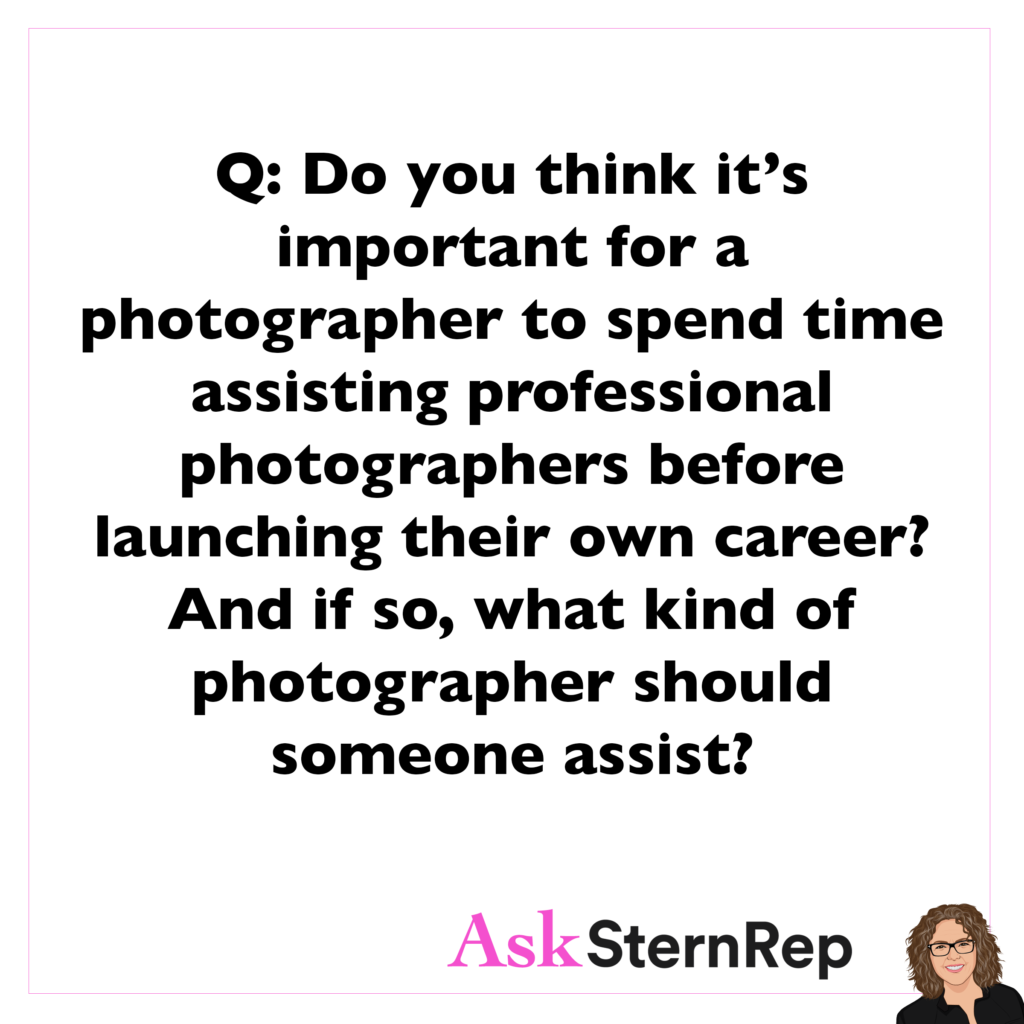

Q:
Do you think it’s important for a photographer to spend time assisting professional photographers before launching their own career? And if so, what kind of photographer should someone assist?
A:
This really depends on the photographer and what they need to learn. Some photographers never assist and end up wildly successful. However, assisting can be extremely informative and build your confidence. If a photographer needs to learn what an editorial or commercial advertising job is like, then they can assist any type of photographer in that market. If they need to learn more about the technicalities of cars or people projects, then they should assist a photographer who does that kind of work. Figure out what you need to learn and assist in that. Or jump right in to build your own education. There is no absolute right answer here.
Asking Clients Why You Didn’t Get The Job Is a Valuable Resource
Learning why we DID NOT get the job can be the most value-packed free resource, and I’m surprised by how available it is to us if we ask. With a bit of timely follow-through, we could potentially receive the clear strategic feedback every business needs.
I’m finding that we can get more information about why we didn’t get certain jobs if we put some effort into asking. It’s strange, but for some reason, clients seem more open to sharing the specific reasons why we weren’t selected. We just have to ask them and make sure we pose the question. It’s not that hard; we just need to put ourselves out there.
A-La-Carte Rep Commision
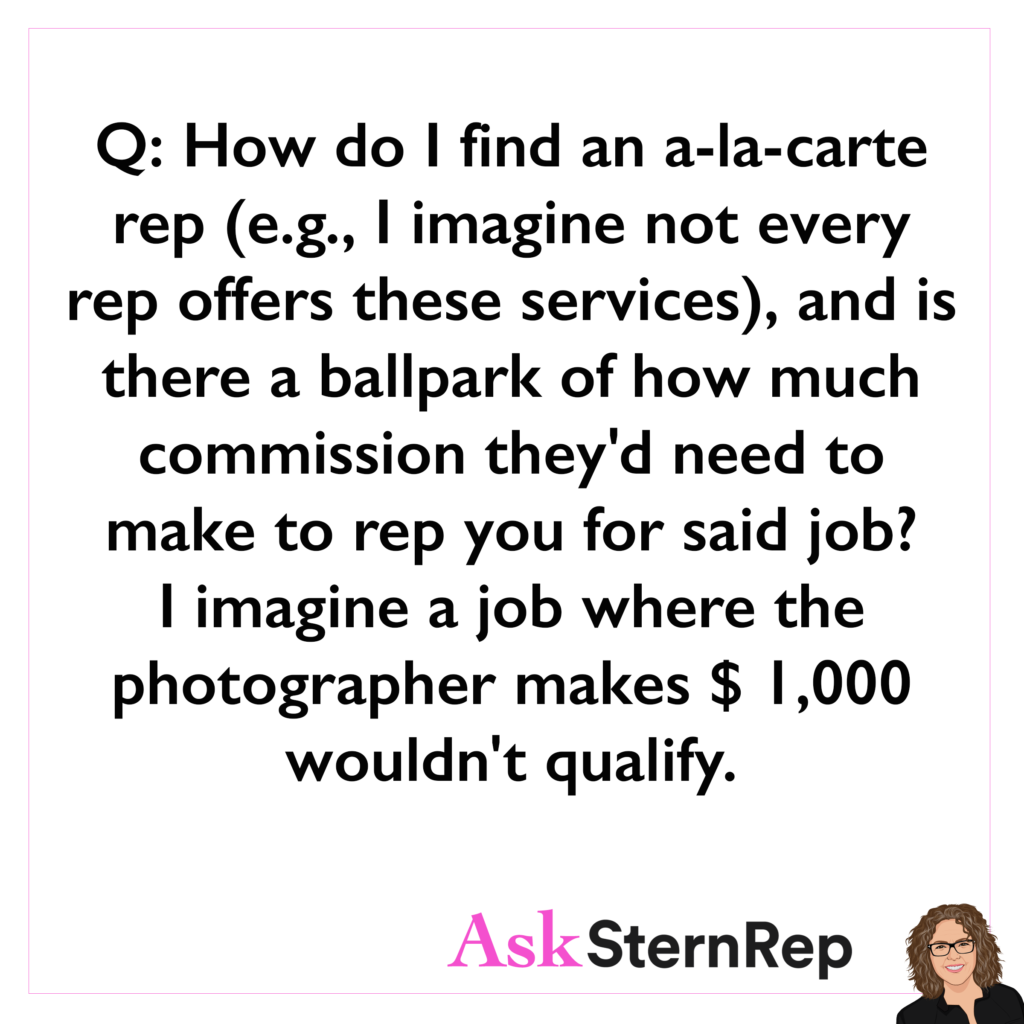

Q:
How do I find an a-la-carte rep (e.g., I imagine not every rep offers these services), and is there a ballpark of how much commission they’d need to make to rep you for said job? I imagine a job where the photographer makes $ 1,000 wouldn’t qualify.
A:
Most reps do “a-la-carte” repping; others, like consultants, producers, and Wonderful Machine, do this for a commission or hourly rate. A $1,000 fee does not sound worth “a-la-carte repping” for anyone, including you unless this client carries a long-term high value for your branding.
Test With Purpose

Test with purpose.
- Who is the client you are targeting?
- What is the feeling/vibe you want to achieve?
- What is the message you are relaying in this project?
- How are you using styling, lighting, talent, and the right environment to target your desired audience?
Does A Rep Evaluate A Certain Project Is Right For A Certain Photographer?
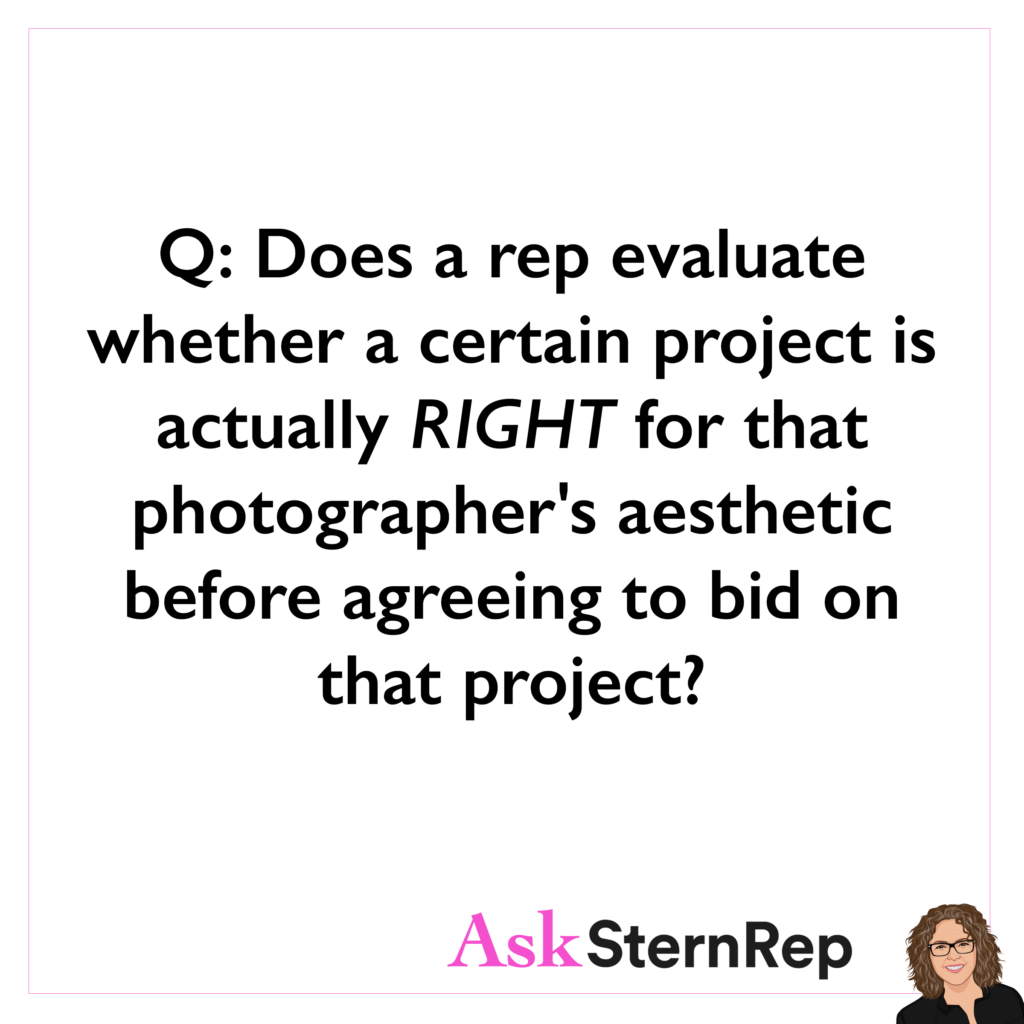

Q:
Does a rep evaluate whether a certain project is actually RIGHT for that photographer’s aesthetic before agreeing to bid on that project?
A:
Yes, reps help shape the work that may be helpful (or not) to a photographer’s career. Reps are the managerial presence to keep the focus on track. I’ve seen time wasted and directions sway by taking on off-path time-consuming projects. Consultants are also a good source of these short-term or long-term considerations; photographers should carefully readjust with focal goals.
Work Exchange For Experience and Portfolio Work
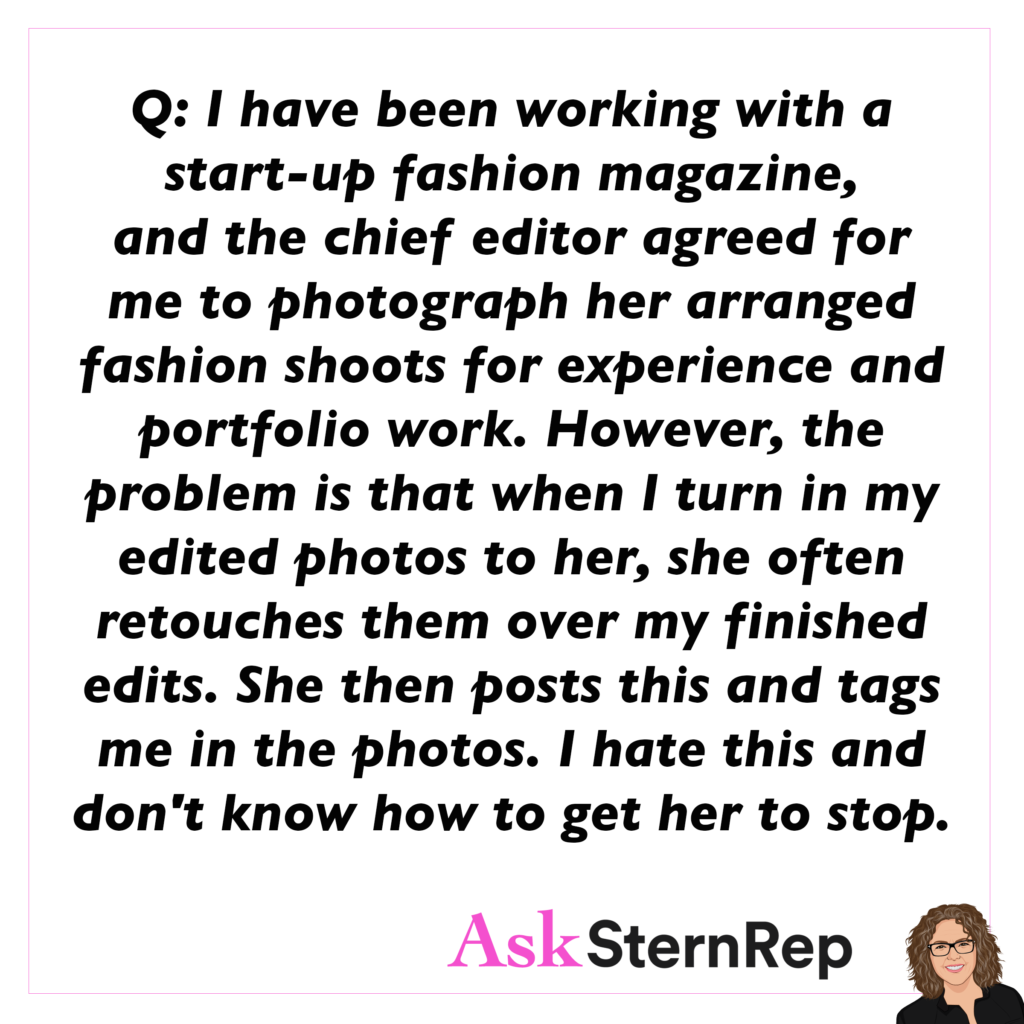

Q:
I have been working with a start-up fashion magazine, and the chief editor agreed for me to photograph her arranged fashion shoots for experience and portfolio work. However, the problem is that when I turn in my edited photos to her, she often retouches them over my finished edits. She then posts this and tags me in the photos. I hate this and don’t know how to get her to stop.
A:
I’ve heard all types of photographers get upset about this topic where clients change the final retouched images. In my business, we cannot control clients from retouching images as they like. We may demand that we do the retouching in-house, but all of this must be agreed upon before the job estimate is approved. We can control whether we grant permission for the client to tag the photographer’s name or not.
When Things Are Challenging In Your Business

When things are challenging, find a way through. Giving up during difficult or slow times means you are only involved in half of your business. When it’s not easy, take a moment to dig deeper to know where you want to go and if any shifts are needed. Be wise and make critical decisions out of proactive action instead of reactive inclinations.
Can A Photographer Be Represented By More Than One Rep?


Q:
Can a photographer be represented by more than one rep, in different locations?
A:
Reasons photographers may want more than one rep:
- Think of reps/agents as “market-focused,” as we have our brand clients, and if you have two types of careers happening, you may want a rep covering a different market focus.
- Reps can offer full-time or temp-rep style representation where you can get to know many reps and how we work.
- Location can affect your rep choices depending on whether your type of work is region-focused.
How To Show Clients They Can Trust Us
Clients need to trust us if we want to create open and honest communication. One way to keep it honest is to change the bidding categories they requested on the 1st revision instead of adjusting other costs/conditions they may not notice.
I have a personal tip regarding estimating when bidding on a job. When I send a bid and the client responds with changes or questions, I sometimes feel uneasy about modifying other aspects of the bid that weren’t part of the original discussion. If I do make changes, I have to assume that the client may not read through the entire estimate again and might miss the updates, which can come off as sneaky or unprofessional.
Therefore, I believe it’s important to inform the client if any additional changes are made beyond those initially discussed. This transparency is something I find extremely valuable, and I wanted to share it with you.
Shooting Tests With Models As A Trade Deal


Q:
In building my portfolio, I test often with many models as a trade deal. The problem with this is when I send the model the raw images, they ask for all of them. I don’t want my name associated with all the images, so how can I set this boundary to only share the best images?
A:
All photographers – make every term on your test or job estimate form clearly agreed upon BEFORE the job begins.
Term topics to cover:
1. A certain amount of final images to be shared.
2. Retouched/finished images are to be used only and cannot be edited in use.
3. Usage rights permitted for the model and photographer need to be clearly stated and agreed upon in an official talent release form.
4. Payment to models must occur on the same shoot day.
4. Copyright is the photographer’s, and the photographer must agree upon any other usage by the model in perpetuity.
Be Your Own Career’s Director
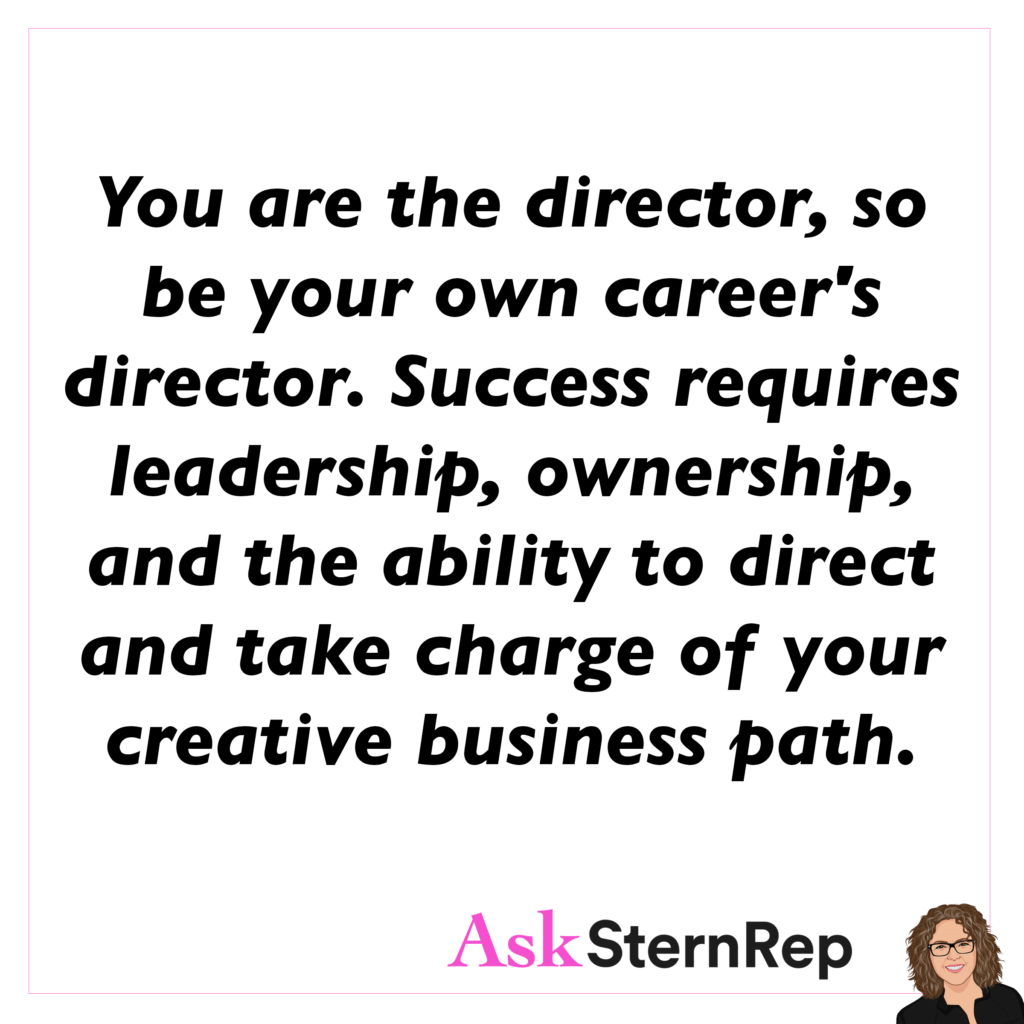
You are the director, so be your own career’s director. Success requires leadership, ownership, and the ability to direct and take charge of your creative business path.
Re-Use Of An Image


Q:
What does “re-use” mean?
A:
Re-use is when an image is purchased to be used beyond its original licensing agreement. For any new, not yet agreed upon licensing in the original bid contract, the client must pay an additional fee to use the image. Of course, there is so much more info about this as clients often aren’t keeping track of what usage rights they have or for how long. We have to keep an eye on this, which is not an easy situation.
Use The Creative Call To Close The Deal And Get The Job
Take that Creative Call as the opportunity to close the deal and get the job. Show up as you would in any conversation. Be present and respond by sharing your opinions/thoughts/ideas/excitement throughout the call. They are wondering who you are, and this is your opportunity to give them a sense of who you would be on set.
The creative call is a crucial part of the process for getting a job in the commercial advertising industry. While the treatment, bidding, and portfolio are important, the creative call is when the potential client wants to interact with the photographer and see what kind of person they will be on the shoot. During the call, it is important to listen carefully to the shot list and other details, but also to be ready to jump in and express ideas or technical knowledge. Sharing personal experiences or perspectives on camera angles, fashion, coloring, lighting, and other aspects of the shoot can demonstrate creativity, passion, and professionalism. The creative call is an opportunity to showcase who the candidate will be on set and how they can contribute to the success of the project.
Take Advantage Of The Spare Time Between Jobs

Take advantage of the spare time between jobs by getting all your prep work done. Be ready to pounce. Remember to distinguish off-shoot days from extra time, creating lower quality, frantic, and last-minute production stress. Get your checklist in order with all the necessary pieces like bid forms, dig tech and crew, retouchers, location scouts, stylists, producers, and TEMP REP (if needed).
Palm Springs Photo Festival Portfolio Review
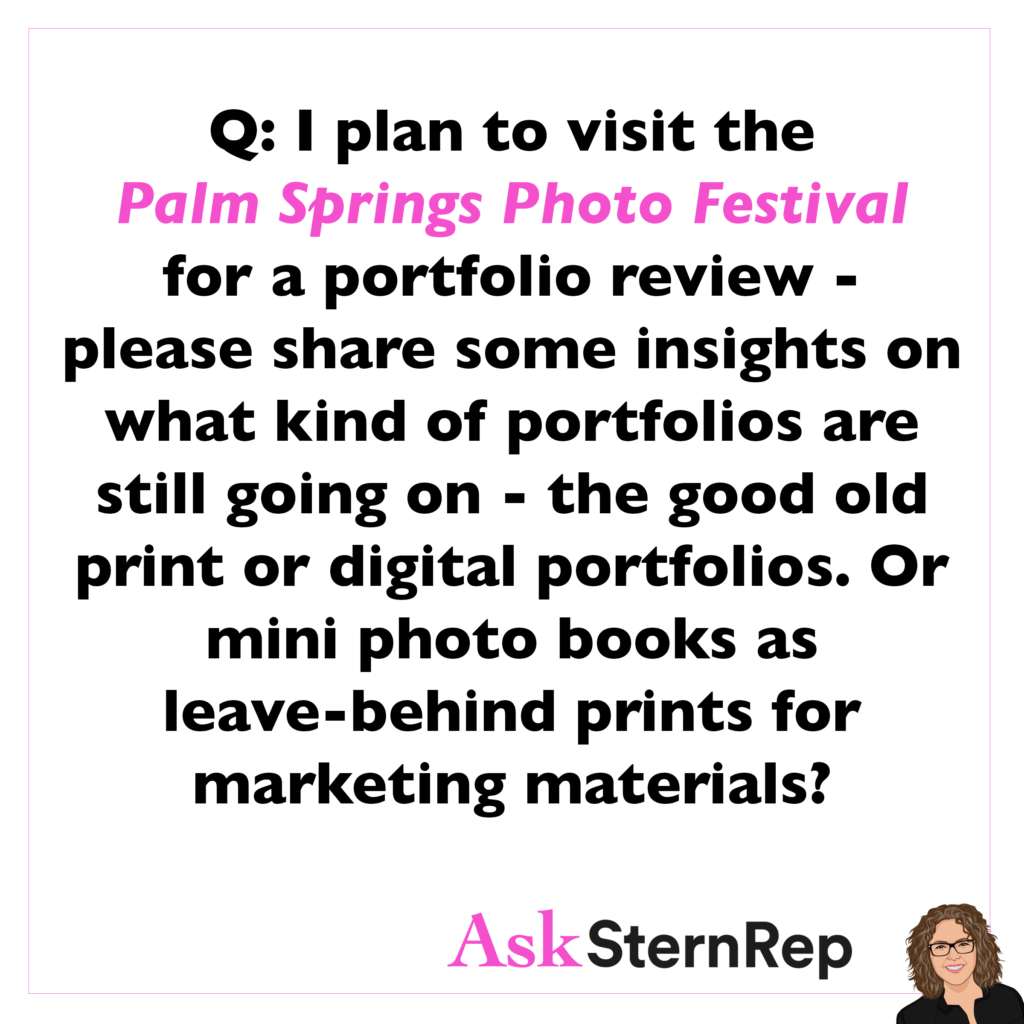
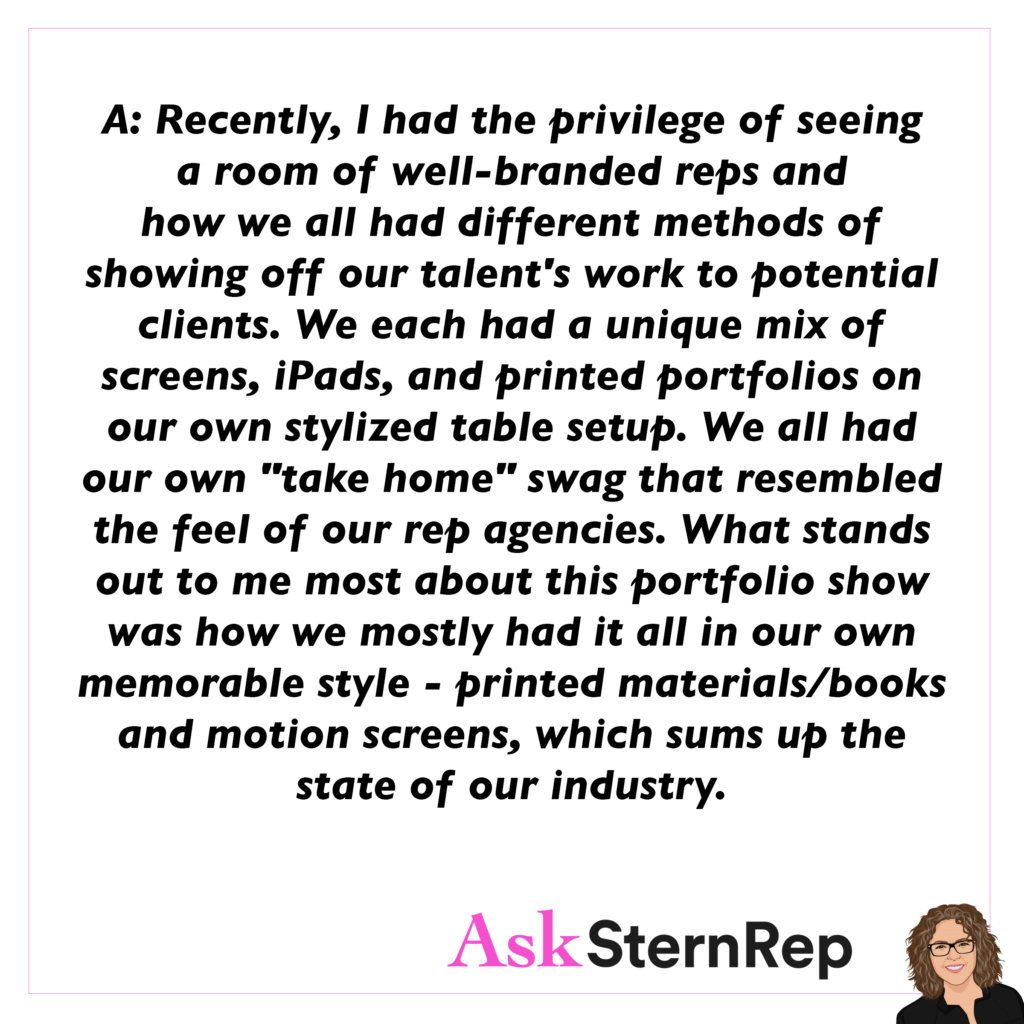
Q:
I plan to visit the Palm Springs Photo Festival for a portfolio review – please share some insights on what kind of portfolios are still going on – the good old print or digital portfolios. Or mini photo books as leave-behind prints for marketing materials?
A:
Recently, I had the privilege of seeing a room of well-branded reps and how we all had different methods of showing off our talent’s work to potential clients. We each had a unique mix of screens, iPads, and printed portfolios on our own stylized table setup. We all had our own “take home” swag that resembled the feel of our rep agencies. What stands out to me most about this portfolio show was how we mostly had it all in our own memorable style – printed materials/books and motion screens, which sums up the state of our industry.
Communicate WIth Your Client To Aid In Negotiation
NEGOTIATING TIP 101:
Get the most information in the shortest amount of time with a good old-fashioned client Phone Call. Use the phone time wisely to get those “awkward to ask” questions about budget, first choice, competition, and lowest bid topics. It’s that one-to-one camaraderie with off-the-cuff, less self-aware personalized touch moments.
Negotiating over the phone is more effective than doing it in person or via Zoom. In our experience, more information is shared once people warm up and get to know each other on the phone. We’re unsure why this is the case, but perhaps people may be less aware of themselves on the phone, making them more likely to share information. We recommend trying an old-fashioned chat for negotiations.
Following Up With Potential Clients Who Open Your Newsletter


Q:
How do I follow up with someone who appears to have opened my newsletter repeatedly, but I don’t have any relationship with them, and their agency doesn’t appear to do work that aligns with mine? This makes it hard even to know what to send as a follow-up. It’s hard to know how to open the conversation without the incredibly creepy “I see you’ve been opening my newsletter a lot this week.”
A:
SUCCESSFUL MARKETING = ENGAGEMENT
Our long-term marketing efforts are the goal, as we know how creatives move around rapidly from one client to another. While you have the correct landing info for the ones who open your promos – USE IT! Get on LinkedIn, Instagram, or their personal website, or email them and connect so you can take advantage of this rare (and expensive) opportunity.
The Key To Getting More Out of Your MARKETING
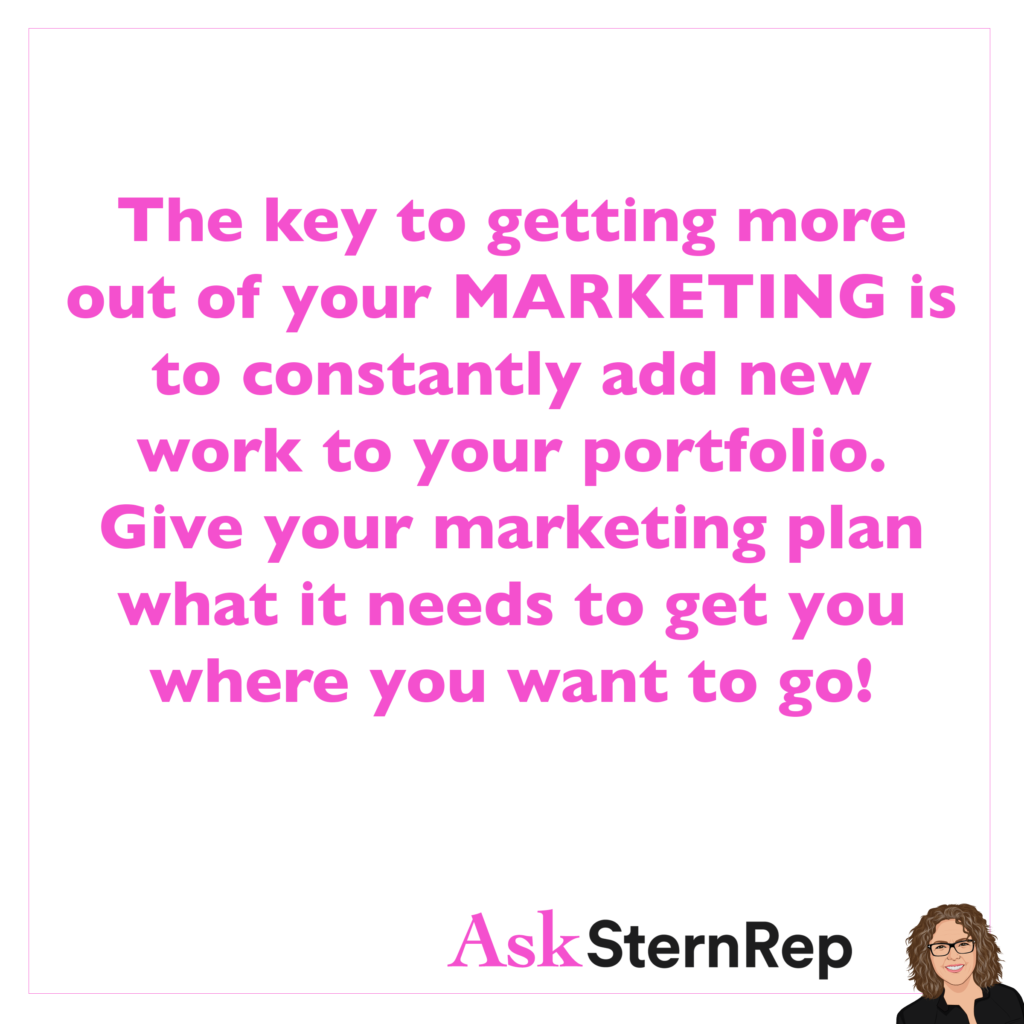
The key to getting more out of your MARKETING is to constantly add new work to your portfolio. Give your marketing plan what it needs to get you where you want to go!
How Do I Market Myself As A High-Profile Photographer?

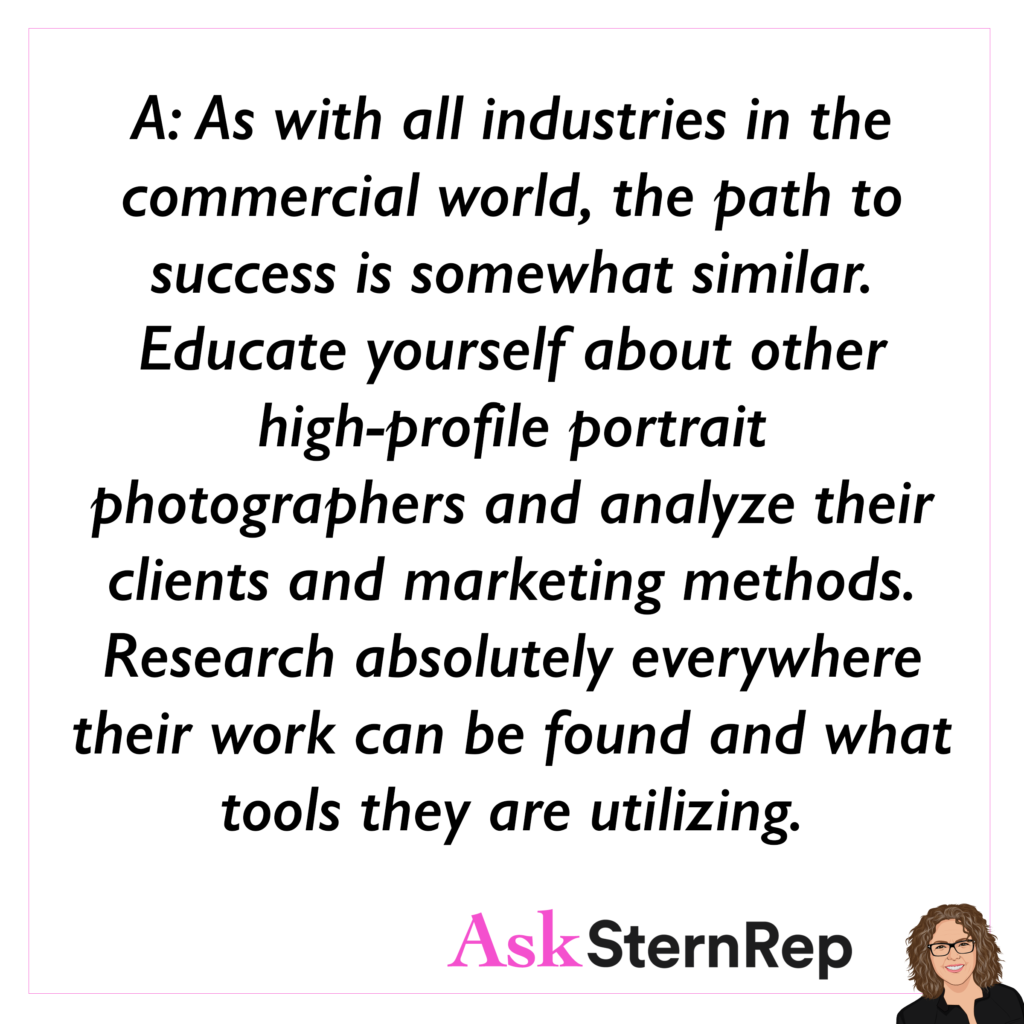
Q:
I want to brand myself as a high-profile portrait photographer. How and where can I market myself? Who would be my major potential client? How should I reach them?
A:
As with all industries in the commercial world, the path to success is somewhat similar. Educate yourself about other high-profile portrait photographers and analyze their clients and marketing methods. Research everywhere their work can be found and what tools they are utilizing.
The One Correct Business ‘Roadmap” Is A Myth
The one correct business ‘roadmap’ is a myth. I notice people in our business assuming there is an ideal way we should all strive for, but that is not what’s happening out there. Trust me, each of us is doing this differently, and your ideal plan should depend more on who you are vs. any set formula we all need to keep up with or fit into.
Photographers in the business do not have a set of norms for how to conduct their business. Each photographer has their own way of running their business, what kind of clients they want to attract, and what they are aiming for. There is no one set way of doing things, and each photographer has their own unique strengths and ways of getting themselves out there. Observing photographers from all over the world, as well as the six we represent, everyone is a bit different and we should figure out how they want to do things. There is no one pattern to follow, and photographers should focus on what they are great at, what they want to test, and how they want to shape their book. It is important to know that there is no set way to do things and photographers should not try to fit into a mold just because everyone else is doing it.
Who To Connect With When Approaching A Big Ad Agency
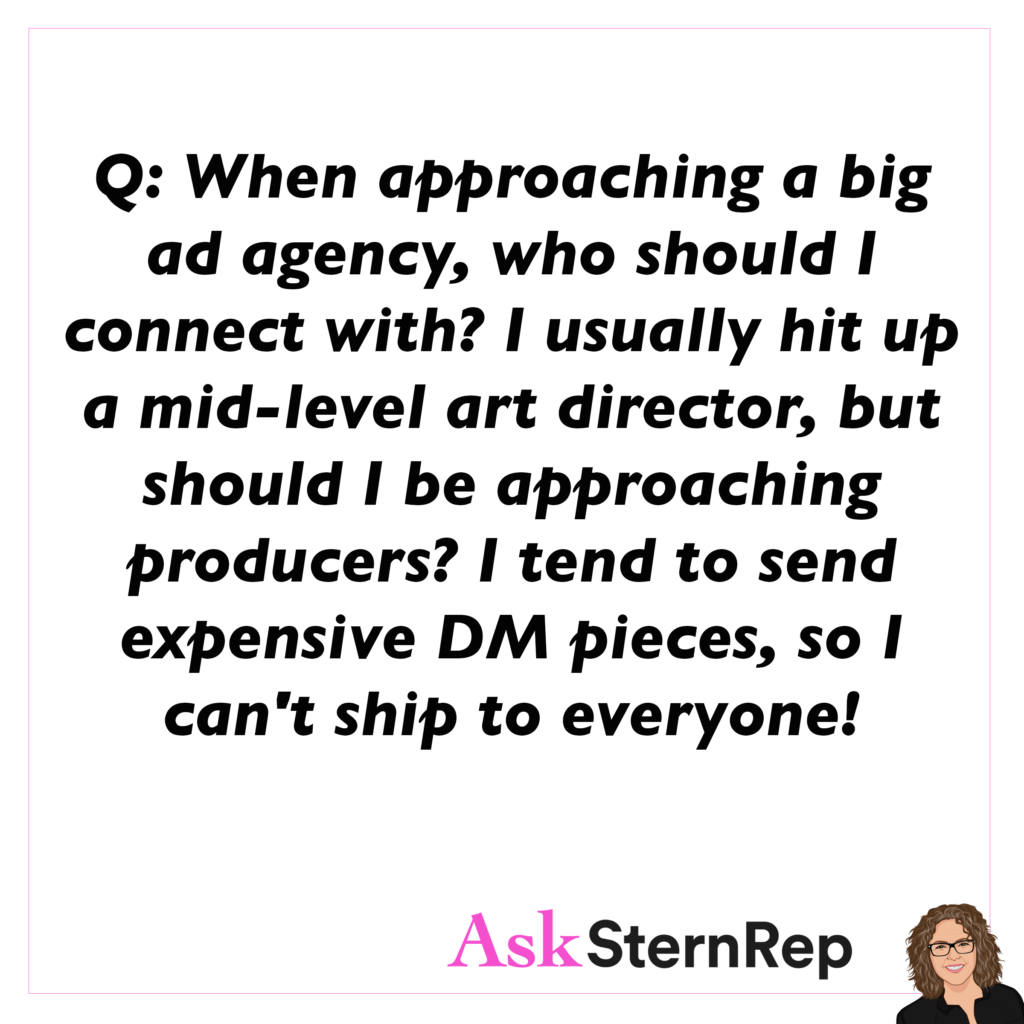
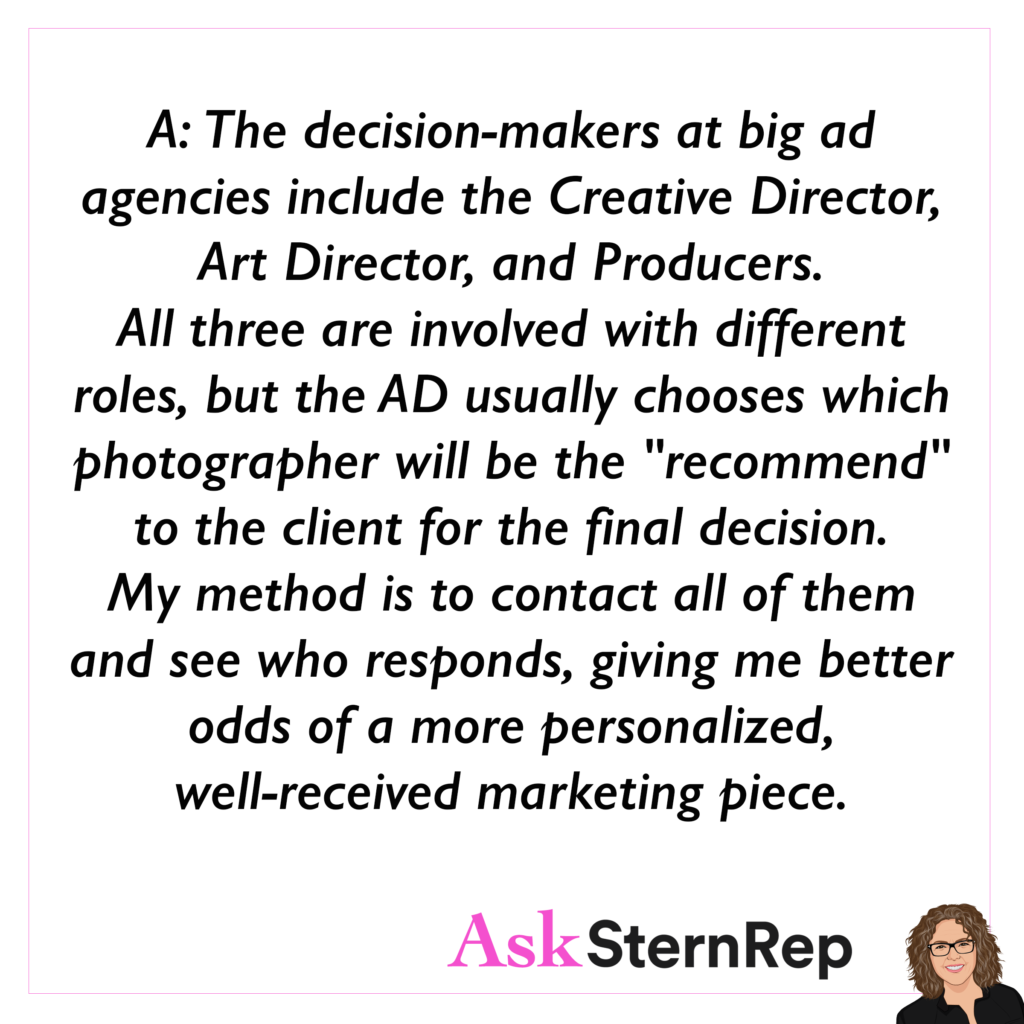
Q:
When approaching a big ad agency, who should I connect with? I usually hit up a mid-level art director, but should I be approaching producers? I tend to send expensive DM pieces, so I can’t ship to everyone!
A:
The decision-makers at big ad agencies include the Creative Director, Art Director, and Producers. All three are involved with different roles, but the AD usually chooses which photographer will be the “recommend” to the client for the final decision. My method is to contact all of them and see who responds, giving me better odds of a more personalized, well-received marketing piece.
How To Use Estimates To Our Advantage

I know we all want to send correct estimates, but sometimes, not knowing all of the detailed bid info, I see the opportunity to get one more round of feedback after I submit the estimate. I use it to my advantage.
Do You Turn Jobs Away Because of Low Budgets?


Q:
Do you have to turn jobs away because of low budgets, or do you make it work? If you photographers are in a slow period, does that make you more open to taking on these jobs?
A:
I do have to turn jobs away regularly because of low budgets.
My checklist to consider these lower-budget projects:
- Can this lead to future larger-paying jobs with this client or others?
- Is this a paid test that will benefit my photographer’s portfolio?
- Will the usage rights be controlled to match the budget?
- Would this be a regularly reoccurring client where fees add up as a regular gig?
- Does adding the client name to your client list help?
- Is there any chance of the low budget restricting the job quality, and if so, this is a definite NO WAY.
How To Avoid Getting Trapped In Bid Prices
Save yourself from getting trapped in bid prices without correct production tasks by naming your estimate as a BALLPARK BID. Your costs can be listed as menu options instead of included in your total. “Costs may change depending on the information provided.” All the ways to be as accurate as you can with the information you’ve been given.
When bidding on projects with incomplete information, it is advisable to make ballpark bids to protect oneself from potential changes in costs. The use of TBD (to be determined) for uncertain details such as usage, and menuing out all possible options, can help emphasize that there may be fees associated with certain aspects of the project. It is important to make it clear that all estimates and bids are subject to change depending on new information and to avoid trapping oneself into fixed prices. The use of clear language in emails and estimates can help ensure that there are no misunderstandings or surprises later on.
What Is Expected At In-Person Portfolio Showings
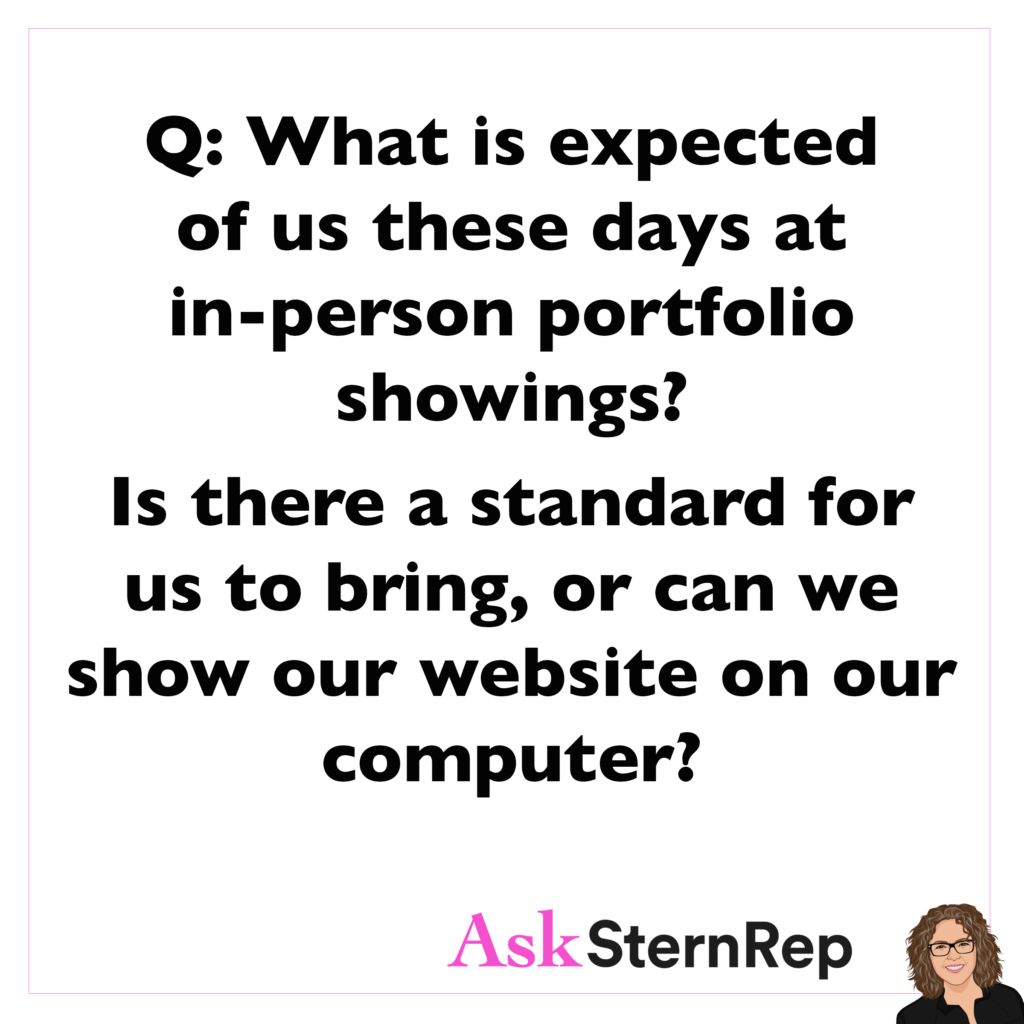

Q:
What is expected of us these days at in-person portfolio showings? Is there a standard for us to bring, or can we show our website on our computer?
A:
Think about it: this is your one opportunity to show the client you are a skilled pro ready to impress. To stick in their memory make sure you bring options to show it all in a concise professional manner to make it easy and memorable. Our industry is now multileveled, and we have to present ourselves as tech/style specialists with screens for motion and some type of portfolio for stills.
Sometimes It’s Best Not To Show Your New Work Just Because It’s NEW

Sometimes it’s best not to show your new only because it’s NEW. We always want to show how busy we are in our world of heavy-flowing content, but most importantly, the work has to stay consistent with your style.
Is There a Database of Reps Sorted by Speciality?


Q:
Is there a database or list of reps out there sorted by spaces they specialize in?
A:
The best database list for reps I have seen is on Workbook.com, but their industry specialty can be found by looking up the top photographers in that market to see who reps them.
My Assignment For You
My Assignment For You:
Take a holiday.
Notice how it feels to STOP carrying the everyday subliminal undercurrent of freelancing.
Take a break.
I Need a Fresh Start In My Marketing And Attitude

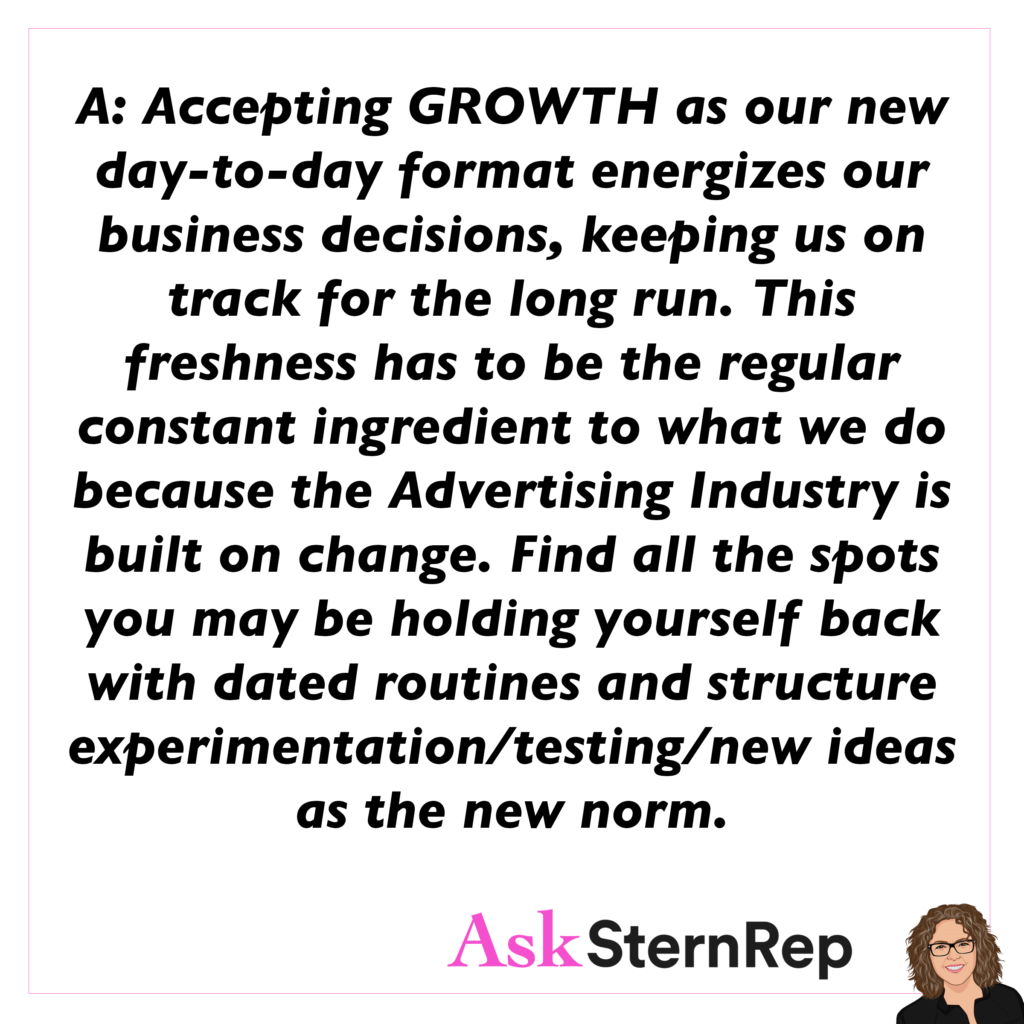
Q:
I need a fresh start in my marketing and attitude, as I had a rough year last year (business-wise), which affected the rest of my life. How do I bring a fresh approach to my business this year?
A:
Accepting GROWTH as our new day-to-day format energizes our business decisions, keeping us on track for the long run. This freshness has to be the regular constant ingredient to what we do because the Advertising Industry is built on change. Find all the spots you may be holding yourself back with dated routines and structure experimentation/testing/new ideas as the new norm.
My Assignment For You
My Assignment For You:
Take a holiday. Notice how it feels to STOP carrying the everyday subliminal undercurrent of freelancing. Take a break.
The holiday season is a good time to take a break from running your own business and relax. Even though January 1st is rapidly approaching, it is important to take a break and let yourself be recharged. Set a goal for the holiday season, such as cleaning off your desk and organizing your office, but only if you have the time for it. The main focus should be on taking a break and enjoying the holiday season. This will help you to come back in January with full energy and inspiration.
How Can I Take A Break When I Want So Much More?

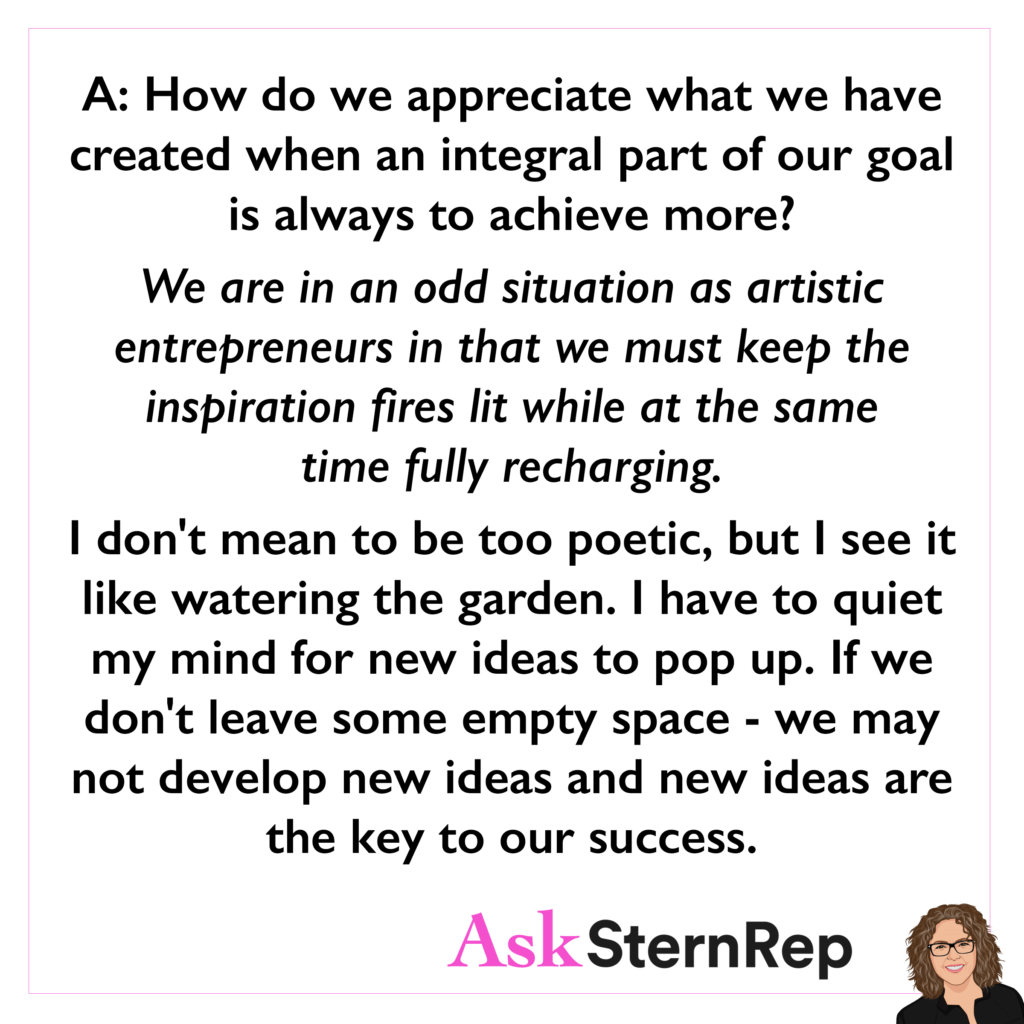
Q:
How can I give myself a break and feel good about the success I experienced this year when I really want so much more?
A:
How do we appreciate what we have created when an integral part of our goal is always to achieve more? We are in an odd situation as artistic entrepreneurs in that we must keep the inspiration fires lit while at the same time fully recharging. I don’t mean to be too poetic, but I see it like watering the garden. I have to quiet my mind for new ideas to pop up. If we don’t leave some empty space – we may not develop new ideas and new ideas are the key to our success.
Top Two Recommendations When Searching For a Photo Rep
TWO TOP RECOMMENDATIONS WHEN SEARCHING FOR A REP:
1. Your reasons for needing a rep should lead to the questions you cover with agents to ensure they supply the specific areas you need help with.
2. Who are the clientele you want to be in front of? Go for the reps who are already in your client’s mix. Whoever the rep works with is where you will be getting attention.
We provide two key recommendations for photographers looking to find the right representation. Firstly, photographers need to evaluate whether they actually need a rep in the first place. While reps were once invaluable for getting into clients and photographers, there are now many other ways that photographers can promote themselves and get their work seen. Therefore, photographers should assess their needs and determine whether a rep is necessary for them. Secondly, photographers need to consider the clients that the rep covers. Different reps specialize in different areas and have relationships with specific clients. Therefore, photographers should look for a rep that handles the areas that they need and has relationships with clients that would be a good fit for their portfolio. Photographers need to ask reps about the clients they cover and whether they handle the areas that the photographer needs. Ultimately, finding the right rep is about finding someone who can help the photographer get their work seen by the right clients.
Will It Help To Lower Prices To Bring In More Clients?
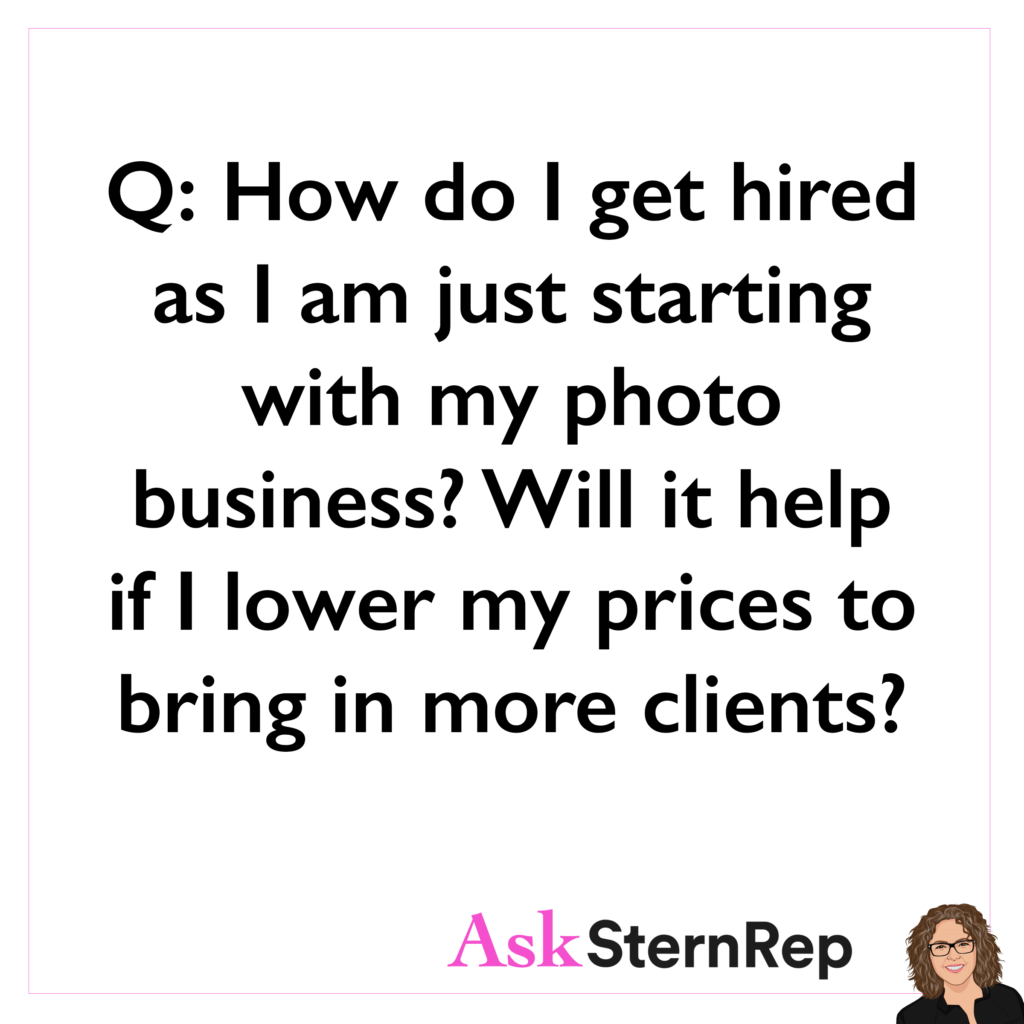

Q:
How do I get hired as I am just starting with my photo business? Will it help if I lower my prices to bring in more clients?
A:
Newer up-and-coming photographers can be more flexible to help build their portfolios. The flexibility of giving more of your time, post work, and more options like video can help get you started. Still, be mindful of the long-term by not lowering the value of your image usage licensing rate.
Can Commercially Utilized Images Be Sold As Future Prints?

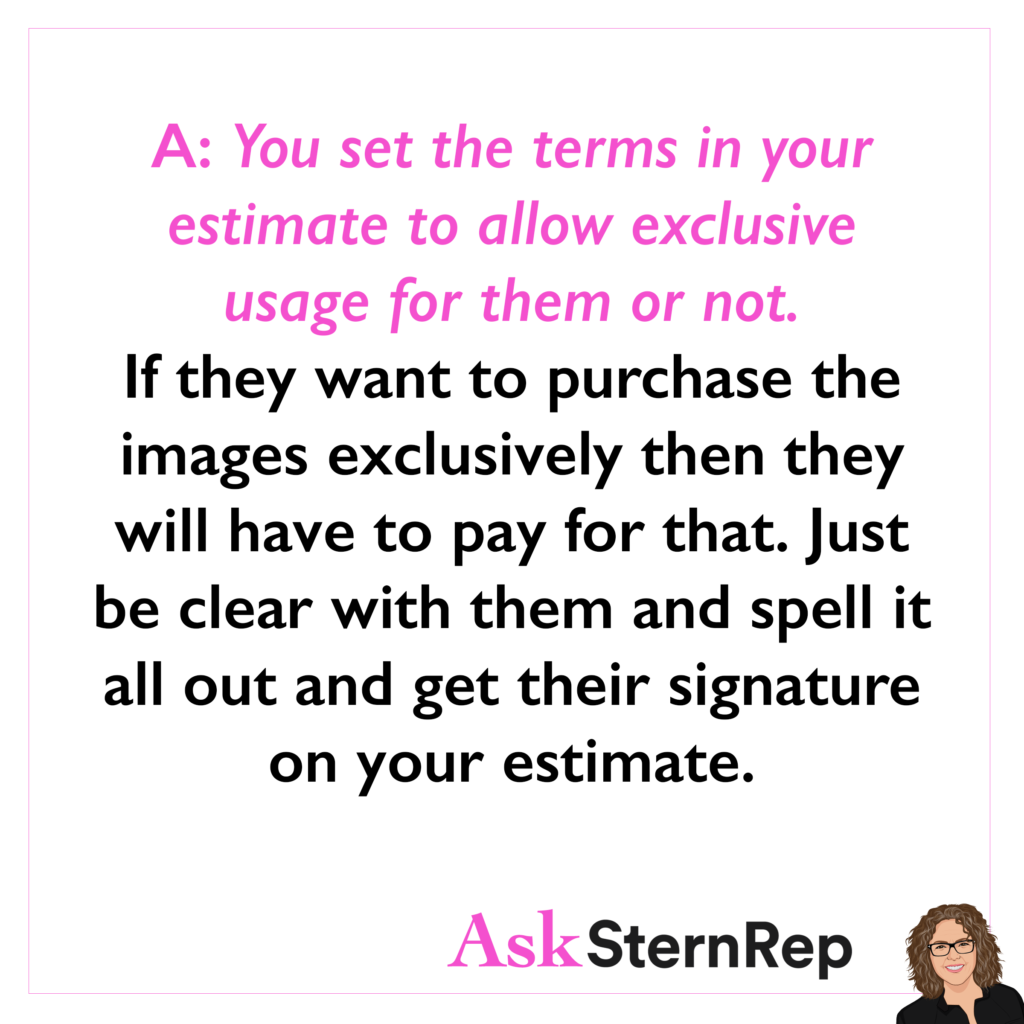
Q:
Will booking a job where the images are to be used commercially prevent me from selling them in the future as prints?
A:
You set the terms in your estimate to allow exclusive usage for them or not. If they want to purchase the images exclusively then they will have to pay for that. Just be clear with them and spell it all out and get their signature on your estimate.
Learn More About the Budget Before Making Your Estimate
STOP WASTING TIME DOING ESTIMATES YOU DON’T NEED TO DO!
It’s wild how many bidding requests we get from random clients that don’t even pertain to us. We must find out the budget before we waste our time. Even though that is the exact info clients usually refuse to give us, we have to push through by asking if their budget is between certain amounts. That type of “yes/no” question usually sparks a client to respond if it’s over what they have available to spend. Give it a try.
Do not waste your time doing estimates you don’t need to do. Photographers should avoid wasting time on estimates and calculations for clients who may not have the budget for their services. Instead, photographers should ask for a budget range upfront, so they can quickly determine if the client’s budget aligns with their own rates. By doing this, photographers can avoid spending time on clients who cannot afford their services and focus on those who can. Self-employed photographers need to be mindful of their time and avoid wasting it on unproductive activities.
Do Reps Take A Cut Of Usage Fees?


Q:
Do reps take a cut of usage fees? If so, is there a standard amount?
A:
Yes, traditional reps are paid a commission of all fees based on your time and image value. Our commission (normally 25% or 30%) is for all photography fees, including usage, prep, travel, day rates, creative fees, shot fees, and sometimes post-work.
Reaching Out To Clients To Create Their Content


Q:
I reach out to clients with my ideas to create their content, but they often interpret this as non-paid free work. How do I offer my concepts as a business offer instead of a free-be?
A:
Two ways to handle this:
- Include pricing (or a pricing range) in your request to put it on the table without potential confusion.
- Go for the clients who always pay for content instead of those using unpaid images.
My Nip + Tuck THANKFULNESS Assignment For You
My Nip + Tuck THANKFULNESS Assignment For You:
1. Take a cold, hard look and evaluate where you need a healthy attitude boost in your career.
2. Which area of your work-world can you adjust the frustrations with an optimistic slant?
3. What positive may you be missing because of an old inner theme that may not work for you anymore?
Thanksgiving holiday provides an opportunity to reflect on what we are thankful for and adjust our attitudes in our careers. It is essential to stay positive and fuel ourselves with positivity to stay creative and achieve long-term career goals. As we navigate the rat race of our careers, we may face challenges, but we must accept how things are and find ways to be grateful for our careers. Thanksgiving week is an excellent time to check in and ensure that we have the right attitude to achieve our long-term career goals. Staying positive and grateful is crucial to staying creative, and it is why we Stern rep, and hopefully, you can connect with that enthusiasm.
How Can I Take a Break When Business Has Been Up and Down?

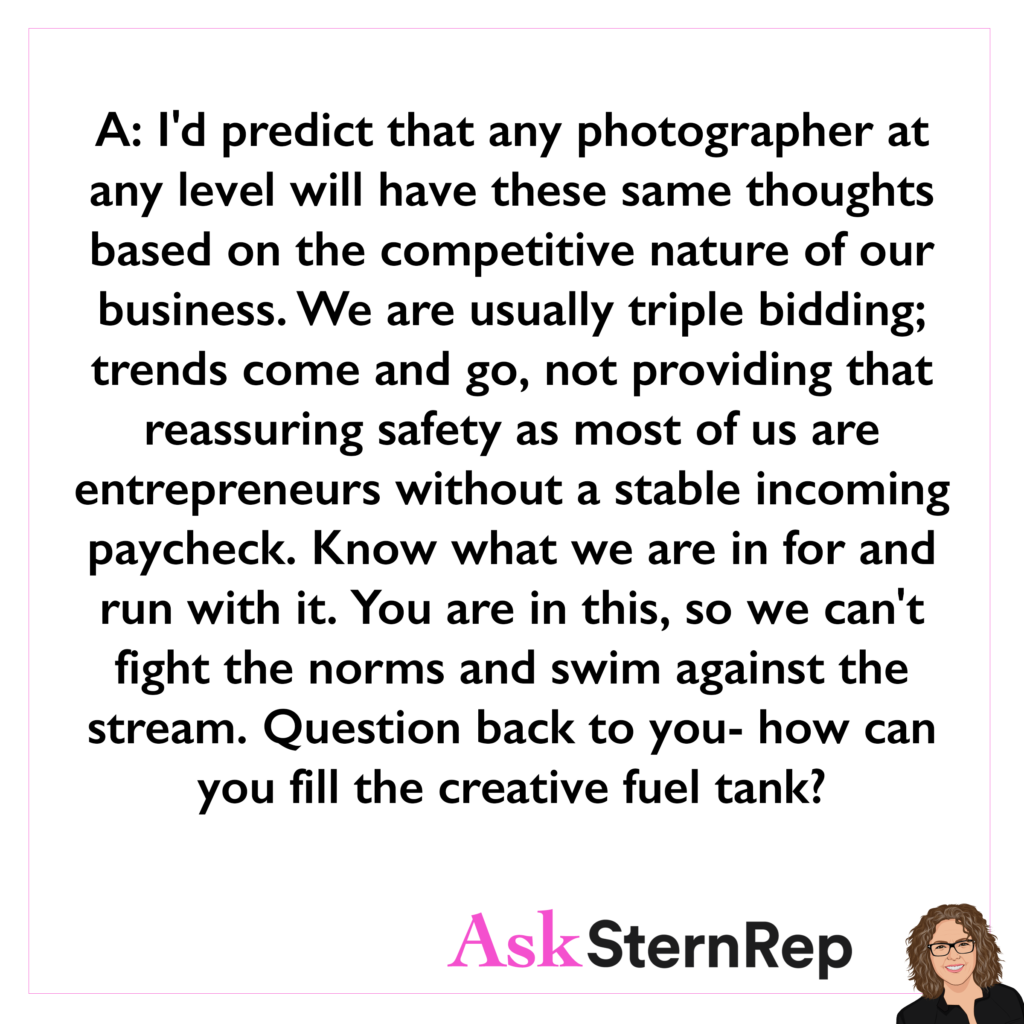
Q:
Holidays are coming soon, and I’m not feeling that cheerful attitude as business has been so up and down for me. It is hard for me not to worry about it and relax by taking a break. I’m a photographer for the long haul, but I’m not sure how to stop and enjoy this rat race. Any advice?
A:
I’d predict that any photographer at any level will have these same thoughts based on the competitive nature of our business. We are usually triple bidding; trends come and go, not providing that reassuring safety as most of us are entrepreneurs without a stable incoming paycheck. Know what we are in for and run with it. You are in this, so we can’t fight the norms and swim against the stream. Question back to you- how can you fill the creative fuel tank?
Connecting With A Client Is The Best Sales Pitch
The BEST SALES PITCH I can recommend is to humanize what we call “sales” by listening. So simple and yet the most powerful way to negotiate, stay in front of clients, or sell ourselves. Take the first hello moment on a Zoom call, notice something about them, and ask a question. Connect by listening to get your foot in the doors.
The best sales pitch is to humanize the clients and be real, honest, and listen to them. Humanizing the clients means to understand them, empathize with them, and treat them as individuals, not just as potential customers. Being real and honest means to not make false promises or exaggerate the product’s capabilities. Listening to the clients is crucial as people want to be heard and understood. It doesn’t take very long to notice something about them and ask them a question, which can help build a rapport and establish a relationship. The best sales pitch is to recommend the product or service that meets the client’s needs and wants, not just to sell something for the sake of making a sale. The key is to build trust and credibility with the clients, which can lead to long-term relationships and referrals.
Should I Always Submit A Treatment With My Bid?


Q:
Should I always submit a Treatment with my bid?
A:
Yes! It’s the way of our world now, where it used to only be for commercial directors. Even if they don’t ask for one, I highly recommend always creating a treatment if you want to get the job. You can always hire treatment creators listed on our Pros for Hire on www.asksternrep.com
“A La Carte” Reps

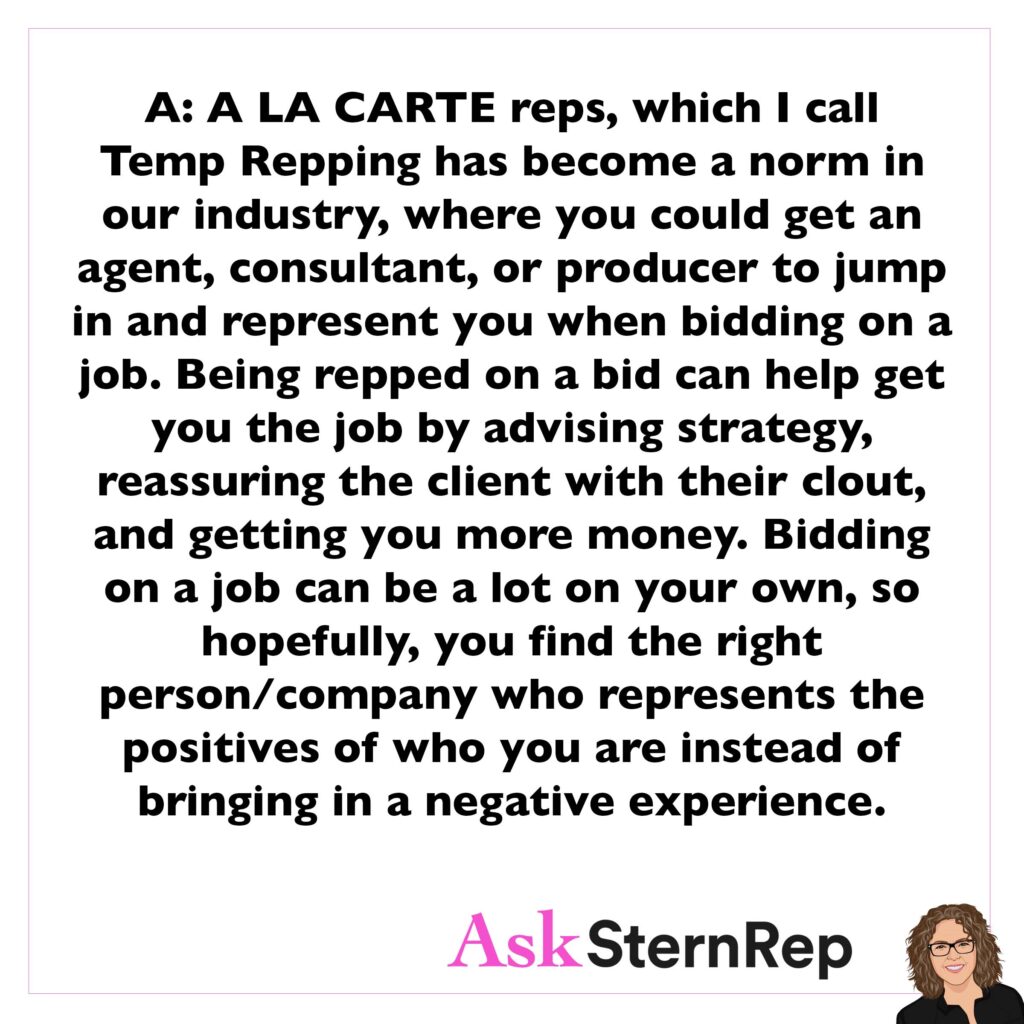
Q:
Can you explain more “a la carte” reps and what are some valuable a la carte options which should be avoided?
A:
A LA CARTE reps, which I call Temp Repping has become a norm in our industry, where you could get an agent, consultant, or producer to jump in and represent you when bidding on a job. Being repped on a bid can help get you the job by advising strategy, reassuring the client with their clout, and getting you more money. Bidding on a job can be a lot on your own, so hopefully, you find the right person/company who represents the positives of who you are instead of bringing in a negative experience.
What Key Term Should You Be Putting on Your Estimate?
An estimate term that should be on the top of all bids: “Estimate is valid for 15 days from date of issue.” Don’t get stuck with prices that are no longer accurate.
The validity of an estimate for music services is only for 15 days from the date of issue. The pricing mentioned in the estimate cannot be regarded as valid for a year since prices can change due to various reasons. For example, if a client has a hold on a particular stylist and talent and they come in after three weeks, the prices might not be the same, and the people on hold might not be available. The estimate’s validity is crucial since there are many elements at play, and clients need to be aware of the timeline.
How Should Photographers Handle Job Date “Holds”
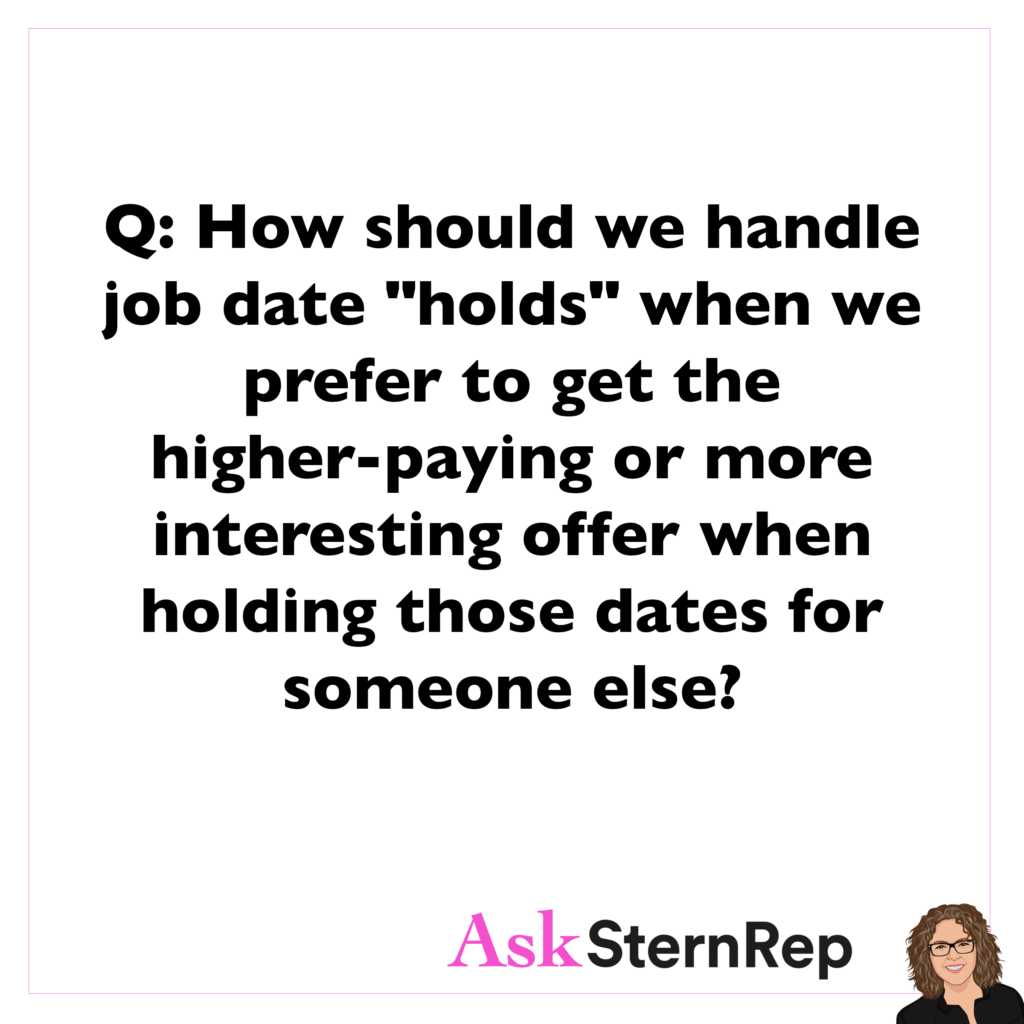
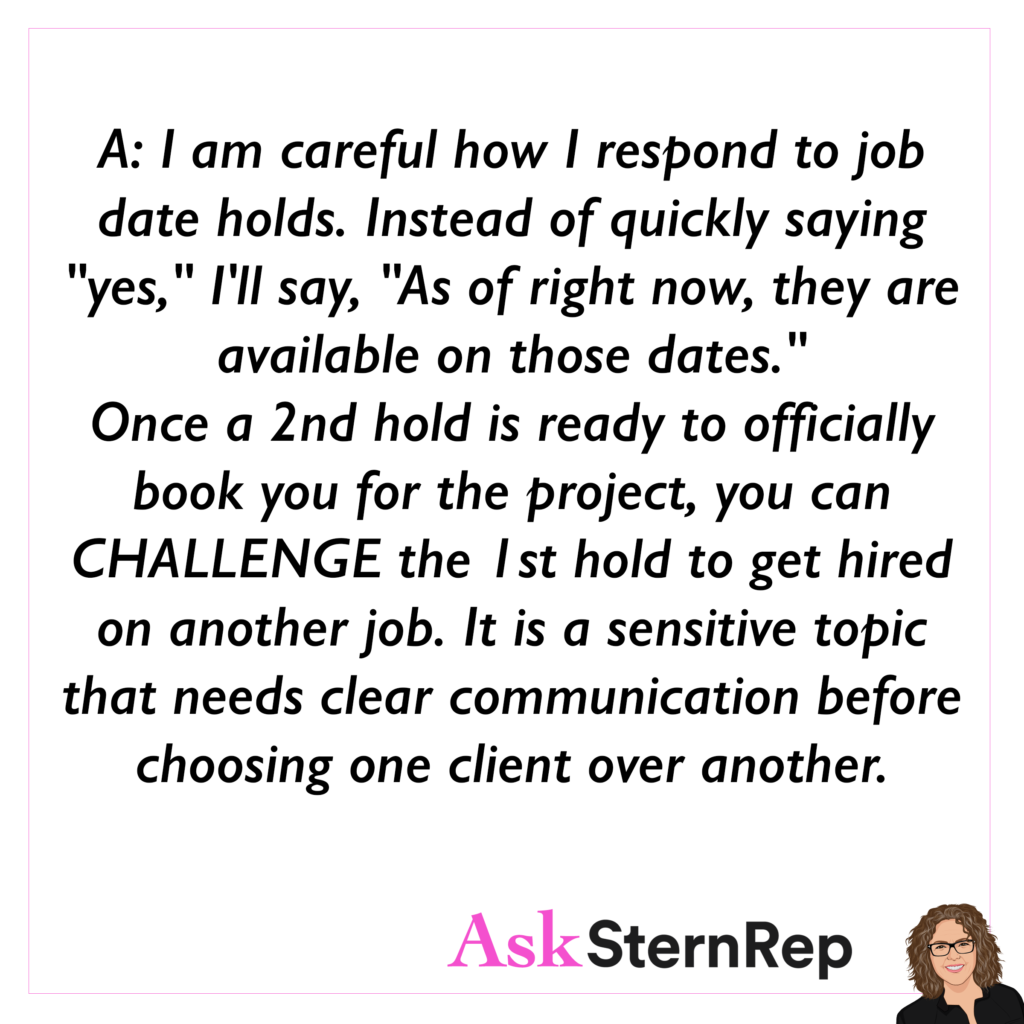
Q:
How should we handle job date “holds” when we prefer to get the higher-paying or more interesting offer when holding those dates for someone else?
A:
I am careful how I respond to job date holds. Instead of quickly saying “yes,” I’ll say, “As of right now, they are available on those dates.” Once a 2nd hold is ready to officially book you for the project, you can CHALLENGE the 1st hold to get hired on another job. It is a sensitive topic that needs clear communication before choosing one client over another.
Meeting With A Rep


Q:
A rep recently reached out to me for a meeting. Any advice on how to approach it? Things I should look for? What should I ask or not share?
A:
The more rep meetings you can take, the better, as it will give you a feel for how different we all are personally and financially. My golden rule is that whoever the rep is with you is most likely who they are with clients. You need to like this rep as they represent who you are; they are your voice and brand. Do your research -do their clients match your portfolio and social media, and how will you fit in with the branding of their roster? Questions to ask – do they charge/how much, how would they go about marketing you, which clients do they see you working with, etc?
How You Market Yourself Depends On How Different Clients Find Can You
Photographers wanting to bring in clients with larger budgets must ask where low-budget clients find you. Where are you putting yourself that gets noticed, and how to reach out further? Marketing is not something we do one time, spend our marketing budget, and sit back and wait. It has to be this ongoing trial of new ways, new unproven avenues of networking exploration changing over time to bring in an assortment of mixed-budget clientele.
Some photographers are being offered lower usage and creative fees than their day rates by their repeat clients. If photographers want higher rates, they should focus on attracting clients who value their work and are willing to pay a premium for it. The importance of marketing oneself across all platforms to attract a diverse range of clients with varying budgets. We also receive requests for lower amounts than we find acceptable, but we also receive larger requests, indicating a mix of clientele. The key takeaway is that photographers should focus on marketing themselves to attract clients who value their work and are willing to pay a fair price for it.
Should I Thank a Client For a Job With a Gift?

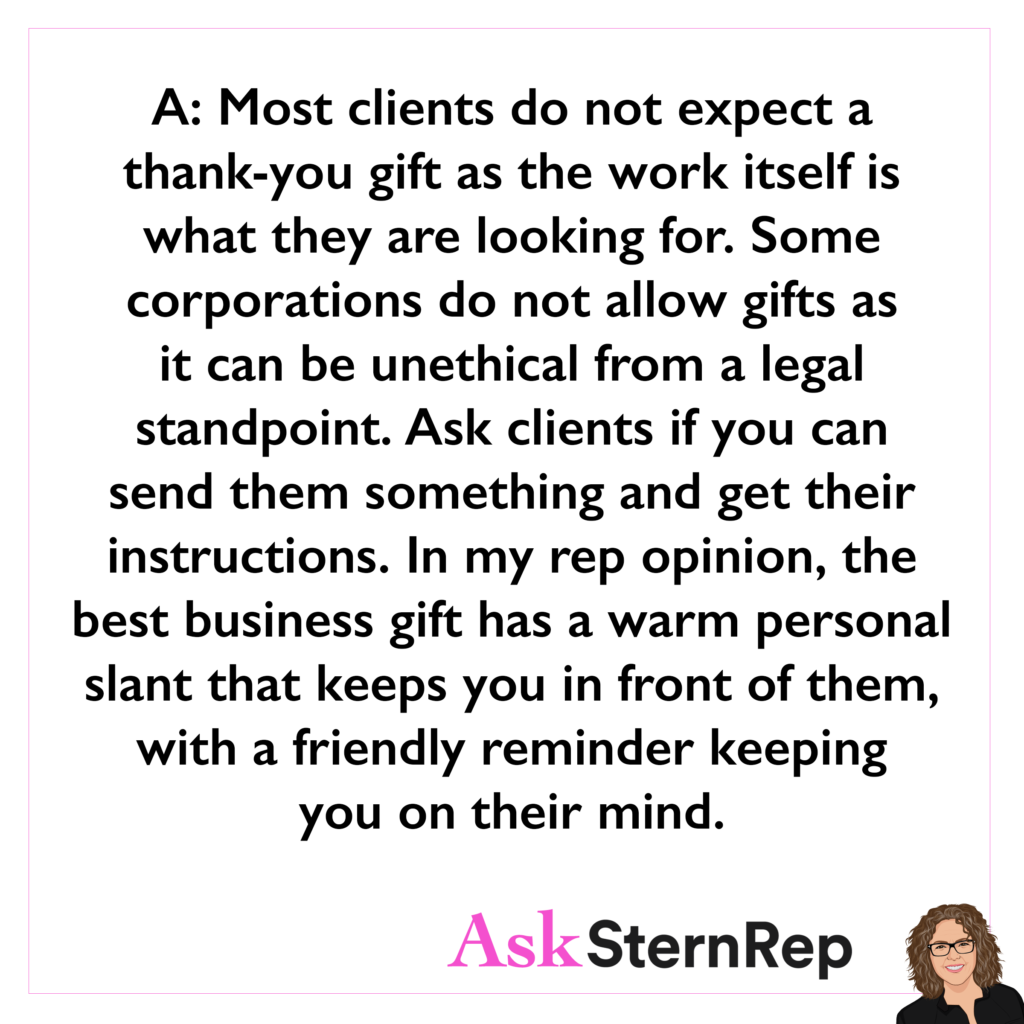
Q:
Should I thank a client for a job with a gift?
A:
Most clients do not expect a thank-you gift as the work itself is what they are looking for. Some corporations do not allow gifts as it can be unethical from a legal standpoint. Ask clients if you can send them something and get their instructions. In my rep opinion, the best business gift has a warm personal slant that keeps you in front of them, with a friendly reminder keeping you on their mind.
Should Photographers Tag Crew Info on Social Media?


Q:
I’ve been chatting with photographers about the issue of tagging/adding crew info in the IG comments of a job image. Some don’t want to give credit because they don’t want others to hire their crew, and others think it’s only fair to give everyone credit where credit is due. Is there an industry standard for this?
A:
I may not give the most honorable or “right” answer to this, but as a rep, my opinion is based on what will help you. For example, if a client wants to be tagged, it will help you to tag them. If your crew will appreciate it and want to work with you more, or they have a large following, and you’d benefit from it potentially being reposted, it can be a win/win. You should feel good about your decision, whether to feel good-hearted or not tagging to get a clean design; your call.
Discussing The Pros And Cons Of Email Promos With Many Remote Clients
Email Promos are the way to go.
Years ago we would diversify with mailer promos, but nowadays, it’s challenging with many remote clients. The unsuccessful percentage of clicks and opened emails may discourage us, but how many opportunities do we have for 100 or 1000 potential clients to view our work? I invest in email promos even as many don’t get opened; the ones that do can be priceless.
We are so excited about a recent successful email promotion. We sent out a lot of email promos using a list called the Bikinilist and received two immediate responses to bid on this photographer. While the numbers may not always be on their side, sending out a big list can really pay off.
Should I Pay For Advertising On Social Media?


Q:
What are your thoughts on photographers paying for advertising on social media? At times, it feels like degrading to our work, but on the other hand, why not pay to place your photos in front of the right people (and grow your audience)?
A:
If you can find a way to pay for social media that really works, then you should do that. It can be tricky to get images in front of the right people, so depending on your correct client contact list make sure you are paying for the right audience.
After-The-Fact Unpaid Usage Conversation


Q:
A local city magazine used images from another client’s project without permission and even made one image on their cover. The client alerted me and apologized profusely. They know third-party rights are not in their contract. What’s the best way to have an after-the-fact payment conversation? And should I ask the magazine or my client?
A:
My way of handling any unpaid usage or third-party sale without our approval is to have a conversation informing them that this will need to be paid for immediately. Usually, clients are afraid of prosecution and will eagerly respond to settle this immediately. I will discuss the fair price and often set an additional “penalty” fee for using images without licensing rights. Both clients are involved in sharing high-resolution images without your permission.
Defining Usage Terms Specific To Your Client And Their Product
USAGE TERMS values fluctuate depending on how long an image will hold its value. When a product or look is not changing over time, the term “unlimited duration” should be priced higher, knowing it has longer usability.
In the world of image licensing, the usage terms and values are not always consistent across the board. For instance, the term “unlimited duration” may hold different values for different clients, depending on the rate of change in their products over time. For example, if a company is advertising cars that change every couple of years, the value of an unlimited duration license is not as high as it would be for a client whose product is relatively stable. Therefore, it is important to structure pricing based on the client’s needs and intended use of the licensed image. The value of the license needs to measure up to the client’s requirements.
I Want My Portfolio To Feel More Like Me


Q:
I want my portfolio to feel more like me, but it keeps looking like the companies who hire me. I know this is holding me back, but I don’t know how to change this constant process of jobs feeding my portfolio.
A:
Photographers, step one leads to step two. Even those who begin with a clear personalized style path will someday have to balance it to keep the long-term goal in line. The more routine we become, the less artistically inspired it gets. If photographers aren’t testing, the shorter our careers can become. Sorry, cold, hard fact.
Defining Usage Rights and NOT Leaving Anything Open to Interpretation


Q:
I photographed musicians now asking for permission to use the images without credit in perpetuity on their social media when the job I was paid for was for “promotional material.” I expected the images to be used across socials when they’re playing shows, etc., but I’m now feeling spooked by their large usage request. Do you think they’re just covering themselves by asking for general social media usage?
A:
WARNING TO ALL PHOTOGRAPHERS
When setting your licensing usage rights terms, DO NOT leave anything open to interpretation. Spell out all usage terms by saying too much vs. too little. Never rely on clients to understand your assumptions. IMMEDIATELY see the AMA USAGE GLOSSARY and stick to it! Do not risk losing your fair income and lower usage pricing for all photographers
How Can We Best Interpret Cues From The Creative Call
Let’s learn from my mistake. A client’s fast turnaround request for a creative call to review their creative deck had us moving quickly, assuming the bid would be due shortly after that. Why wouldn’t we start the treatment asap? Days later, I knew it was a false alarm when I didn’t hear a peep about the bid specs. Very reputable client, so no funny business, just me reacting too fast with many assumptions. Their creative call was to choose their three bidders. Lesson learned.
A lesson learned from a missed opportunity to bid on a job in the creative industry due to a lack of bid specs. We received at the last minute a request to bid on a job, but did not receive bid specifications until after we had already spent time and money on creating a treatment. Ultimately, the client chose other photographers to bid on the job, leaving us with wasted resources. The lesson learned is that without bid specs, one may not actually be officially bidding on a job.
Initiating Contact With New Clients
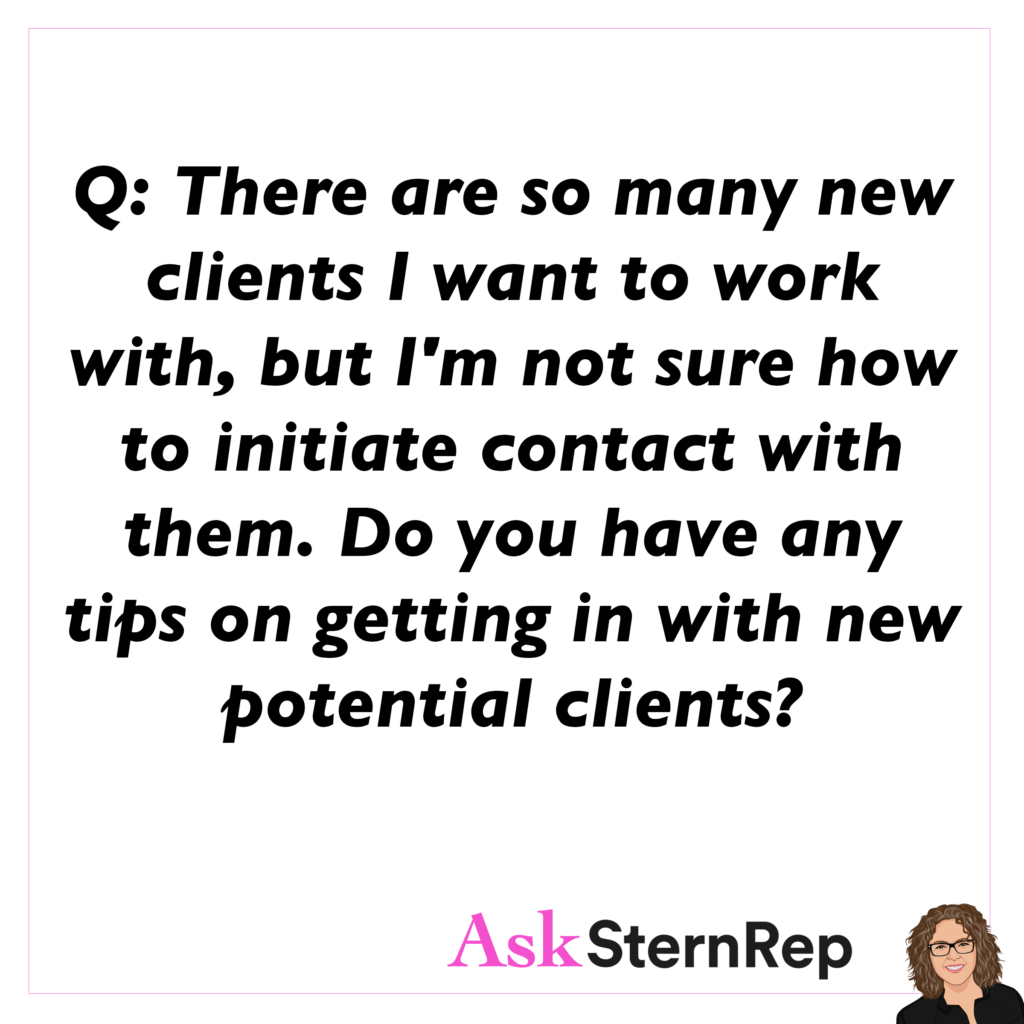
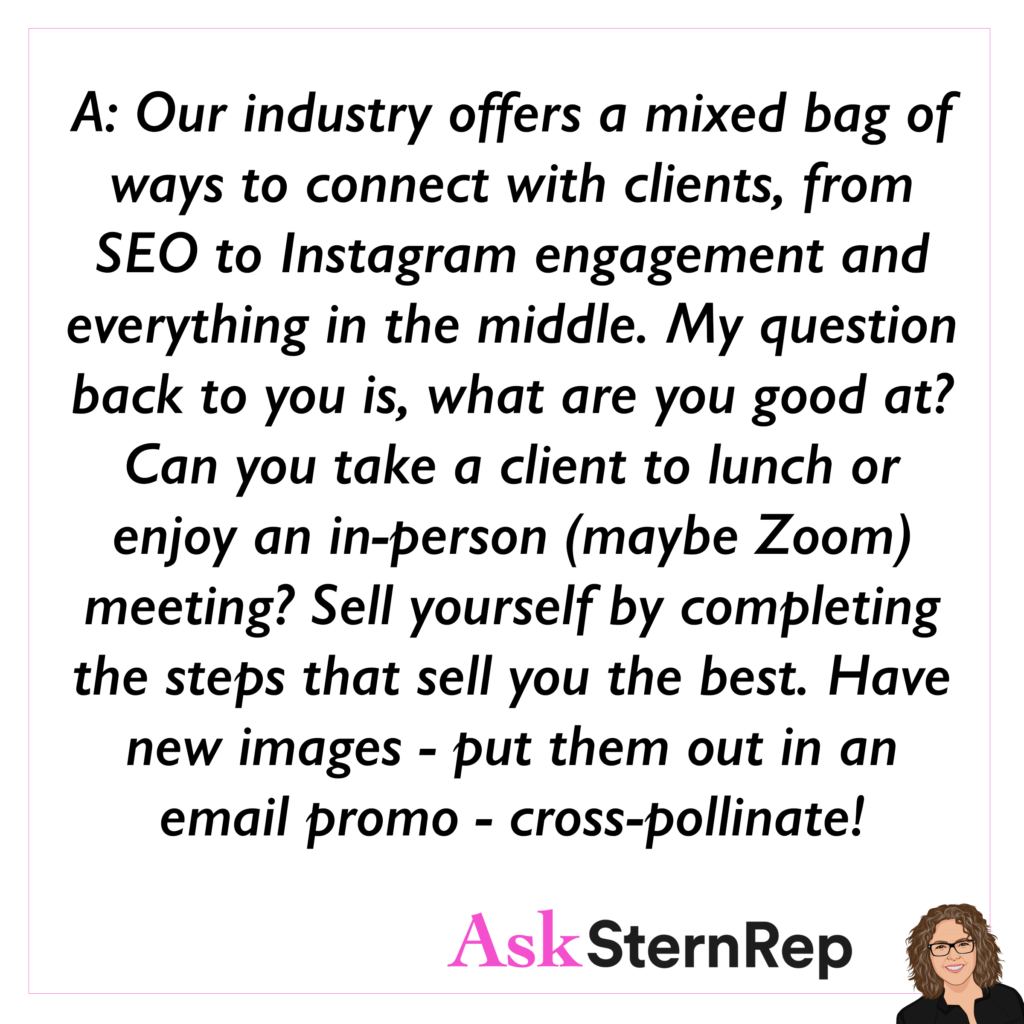
Q:
There are so many new clients I want to work with, but I’m not sure how to initiate contact with them. Do you have any tips on getting in with new potential clients?
A:
Our industry offers a mixed bag of ways to connect with clients, from SEO to Instagram engagement and everything in the middle. My question back to you is, what are you good at? Can you take a client to lunch or enjoy an in-person (maybe Zoom) meeting? Sell yourself by completing the steps that sell you the best. Have new images – put them out in an email promo – cross-pollinate!
Do Portfolio Reviews Bring In Work?
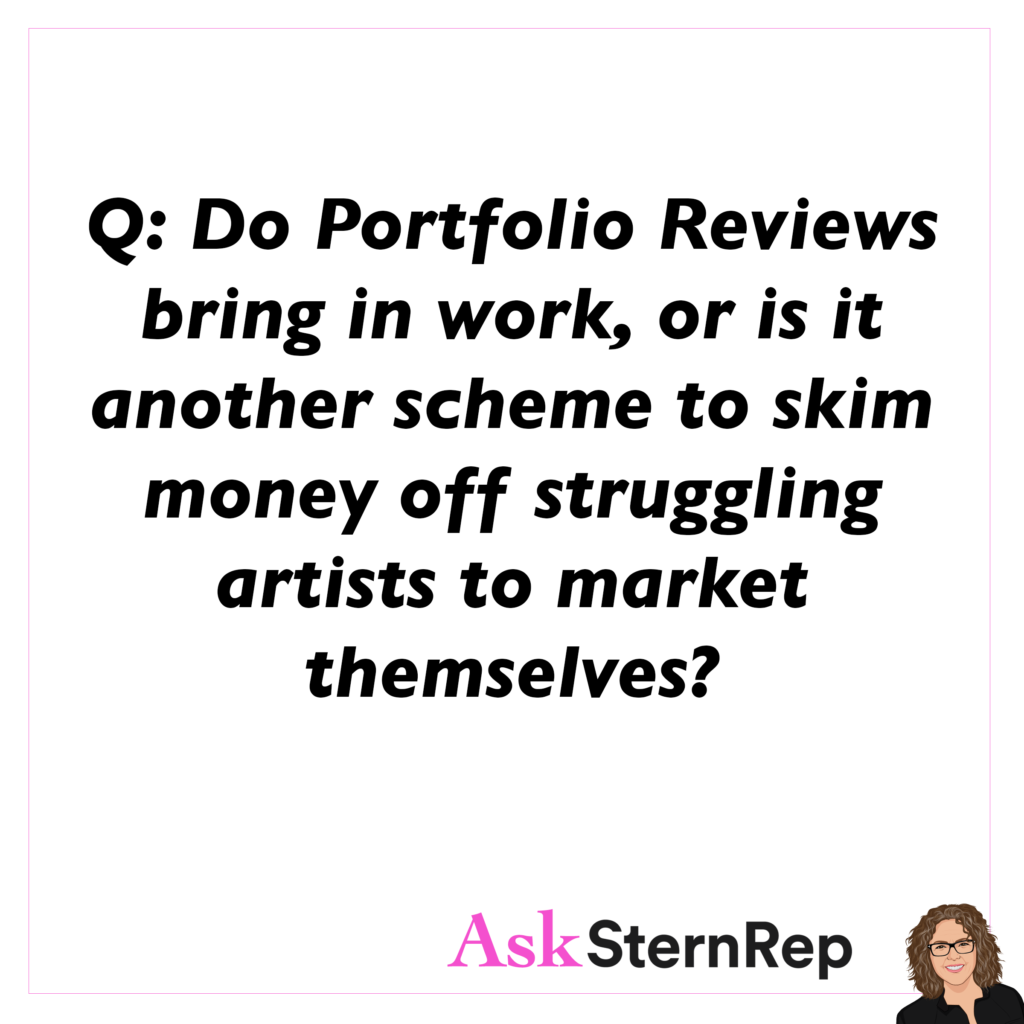

Q:
Do Portfolio Reviews bring in work, or is it another scheme to skim money off struggling artists to market themselves?
A:
Portfolio reviews are one of the best ways to get your work in front of potential clients, but you must do the prep work to meet with the right clients for your brand. You are wasting your time (and money) if you don’t research your target market.
How Do We Hone Our Most Effective Marketing Strategies?
Set aside time for one of our most effective marketing strategies – connection. Specific key clients choosing who to hire are the creatives – the art director and the creative director. Hit them up, and make a dent at least enough for them to consider you when the time is right. They cannot choose what they do not know.
The marketing process for the photography industry can take many forms but can be simplified based on the time available. If there is ample time, we advise you to connect with the creatives such as the creative director and art director, who are usually the ones choosing the photographer. It is important to dedicate time to researching and engaging with these key decision-makers on LinkedIn and Instagram. This type of marketing takes more focus and time but can be well worth it in the end.
How Many Images Should Be On My Website Portfolio?


Q:
How many images should I be showing on my website portfolio?
A:
My advice with portfolios is not to show too many images if they make you look like 2 or 3 different photographers. Have a strong and cohesive streamline, and fro that, you can show as many as you have on a scroll-down website because the viewers can stop scrolling if they’d like.
Marketing Budget

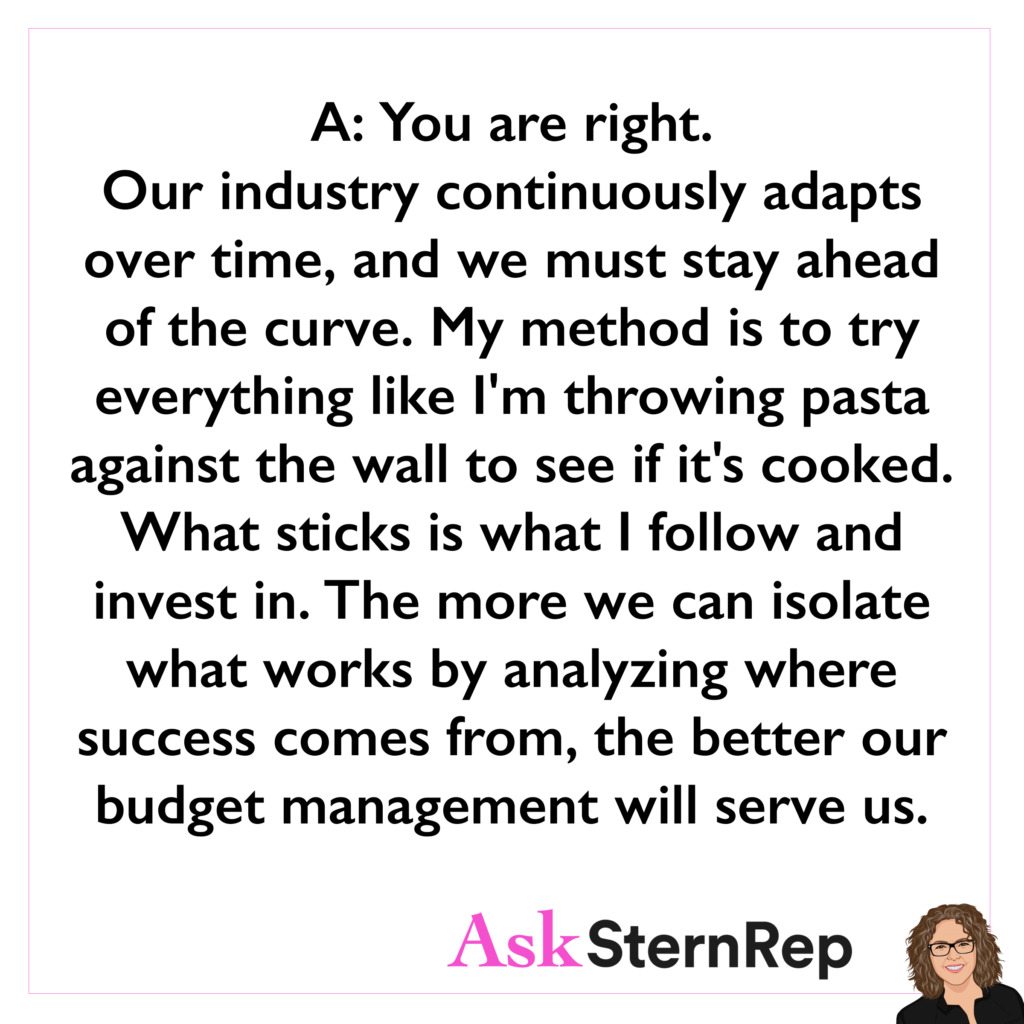
Q:
I am setting aside my marketing budget for the rest of this year, but I don’t exactly know what to spend it on. Our marketing options seem to change, or doing one thing isn’t enough to really bring in the attention I want to be getting. Help!
A:
You are right. Our industry continuously adapts over time, and we must stay ahead of the curve. My method is to try everything like I’m throwing pasta against the wall to see if it’s cooked. What sticks is what I follow and invest in. The more we can isolate what works by analyzing where success comes from, the better our budget management will serve us.
Bidding Prices Should Include Time Spent Working With The Client
Client Management Time
Bidding Prices should incorporate the real cost of the time-consuming back-and-forth process because your business time = money. Just as we charge for the equipment you own, the same goes for managing your time.
Value your time in the bidding process. Part of the bid that is often overlooked is the time spent negotiating with clients and managing their expectations. While this time may not be explicitly spelled out in the bid, it is important to factor it into the overall cost of the project. We recommend adding this time to the creative fee, prep days, or production fee to ensure that it is covered. By doing so, we ensure that we are compensated for the time spent on client management, which can be a significant portion of the project. Ultimately, the goal is to have a bid that accurately reflects the time and effort required for the project, including the time spent managing the client.
Producer vs. Photographer
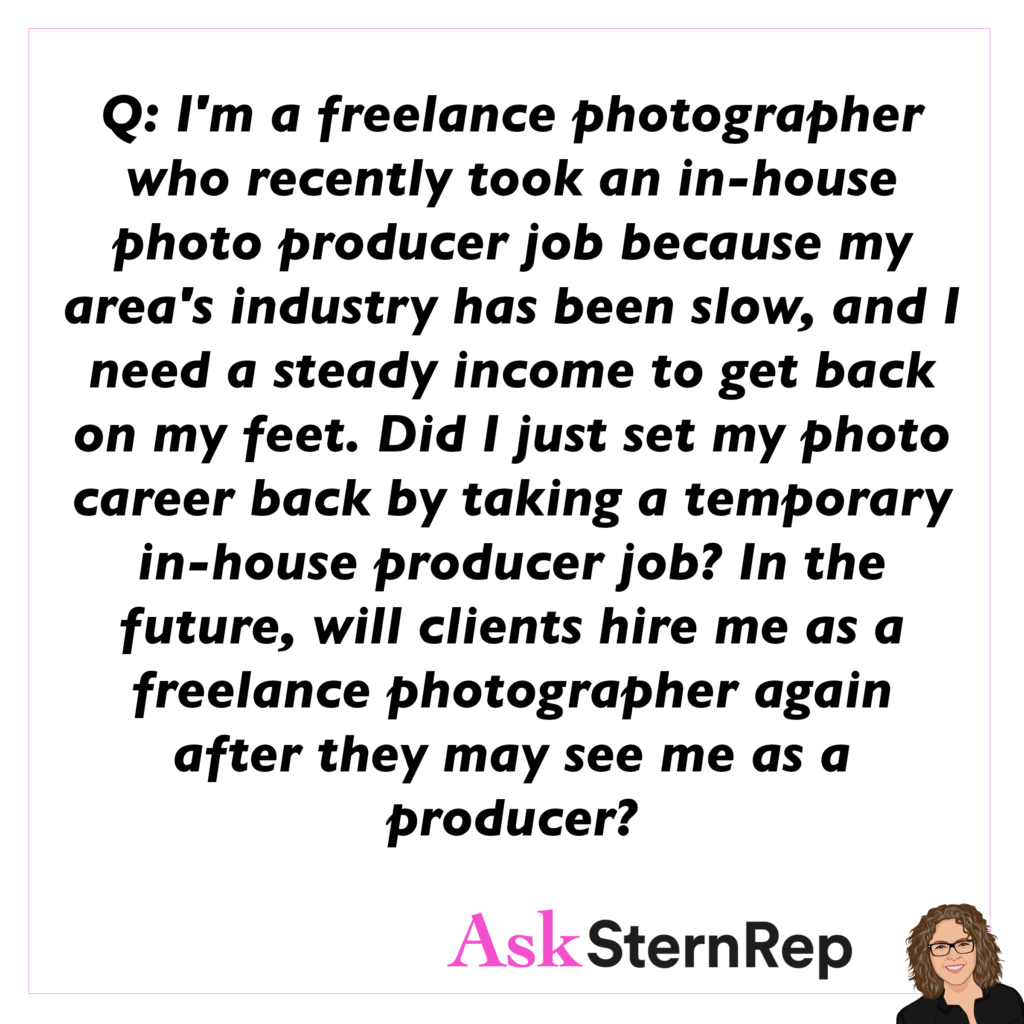

Q:
I’m a freelance photographer who recently took an in-house photo producer job because my area’s industry has been slow, and I need a steady income to get back on my feet. Did I just set my photo career back by taking a temporary in-house producer job? In the future, will clients hire me as a freelance photographer again after they may see me as a producer?
A:
The plain and simple answer across the board is dependent on your branding, which is dependent on two sticking points:
- Will you be branding yourself correctly for clients to consider you when looking for a photographer?
- Will your photo portfolio be strong enough to impress clients?
Long-Term Business Planning Helps Guide Our Daily Decisions
Long-term business planning must include the pieces of our career that got us here. That part of ourselves that started us off still needs our attention, and the key is to find those potentially unexpected ways of including satisfying achievements back into our business.
Reflecting on the importance of maintaining a sense of satisfaction and fulfillment in one’s career. It wasn’t a long-term business plan that got us into photography, but rather the feeling of satisfaction we got after completing a project. Hold onto that feeling and use it as a driving force for long-term success, even if one’s career path takes unexpected turns. Ultimately, maintaining a sense of fulfillment and satisfaction is crucial for success in any career.
Finding A Rep
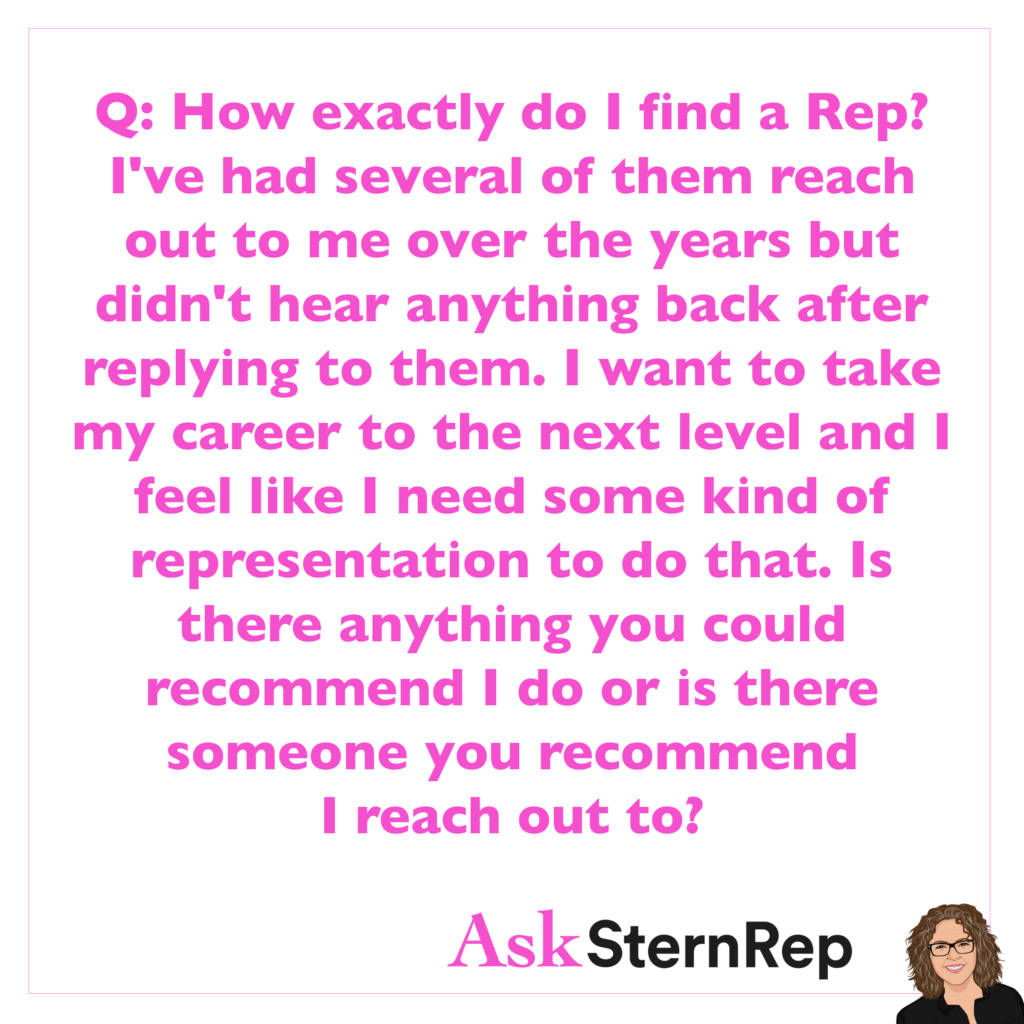
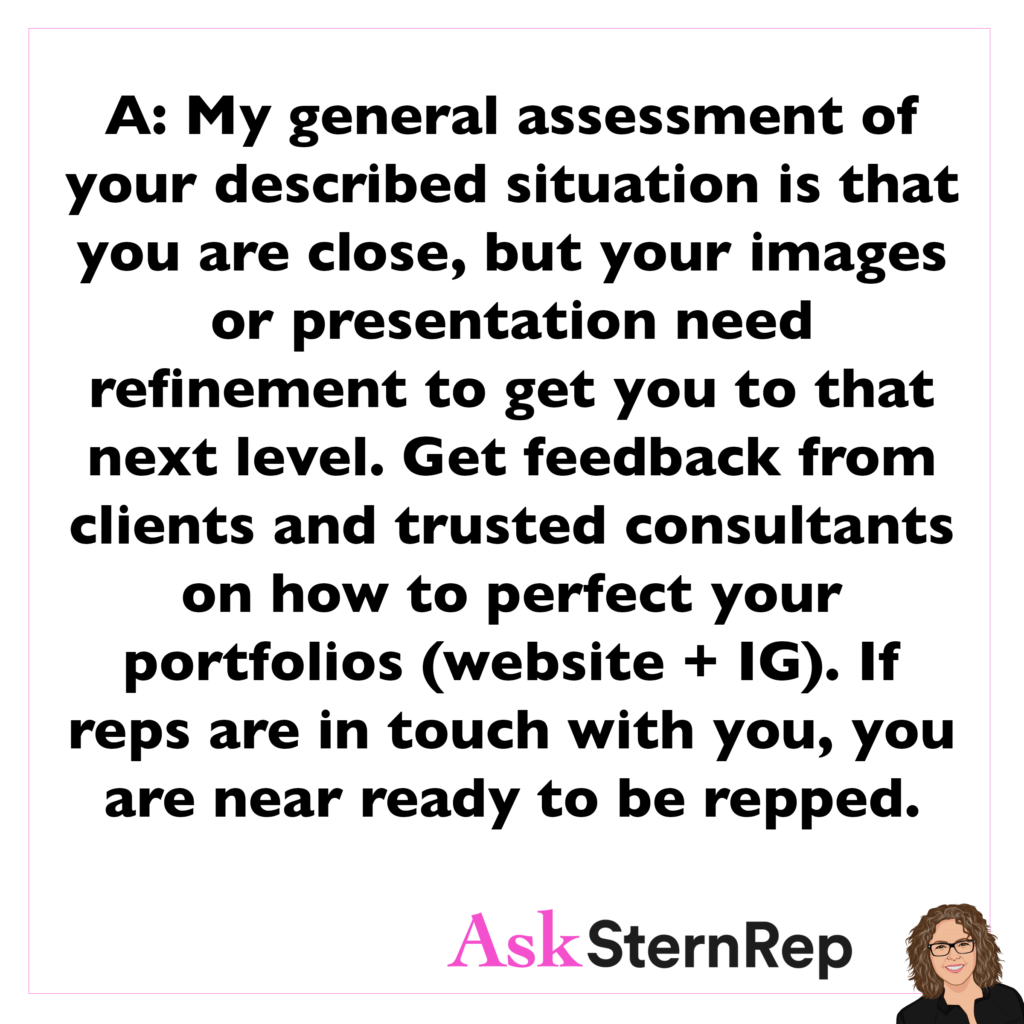
Q:
How exactly do I find a Rep? I’ve had several of them reach out to me over the years but didn’t hear anything back after replying to them. I want to take my career to the next level and I feel like I need some kind of representation to do that. Is there anything you could recommend I do or is there someone you recommend I reach out to?
A:
My general assessment of your described situation is that you are close, but your images or presentation need refinement to get you to that next level. Get feedback from clients and trusted consultants on how to perfect your portfolios (website + IG). If reps are in touch with you, you are near ready to be repped.
How Specialty Impacts Commercial Photography Creative Fees
What is your specialty? One CREATIVE FEE component that may get overlooked in fee formula calculations is how much the client needs you for this campaign. The specialization you bring to a project goes a long way, and you should be paid for it.
When setting a creative fee for a project, it is important to consider how specific and unique your creative skills are to that particular project. This can involve evaluating whether your look or style matches the needs of the project better than others and whether your particular skills and experience make you the best fit for the job. By taking into account these factors, you can justify charging a higher creative fee for your work.
Media Kits


Q:
I have a question regarding media kits. I’m a photographer who wants to make pictures rather than focus on getting followers (or being an influencer). The last brand I worked for shared the images and got so many likes, but when I post the same thing, crickets. What should I put in a media kit to turn this around and spin other benefits like hiring a creative team who can think bigger?
A:
Most will not like my answer, but it is all about back-and-forth ENGAGEMENT. Client connection is the name of the game for creative freelancers. It’s what every rep is doing, and most photographers don’t invest the time researching, contacting, and engaging in communication targeting potential clients. Whether you hire someone to do this for you or do it yourself – the answer is simple, but it takes time and focus.
Photographers Are The Creative Carrier Of A Client’s Vision
Once hired for a project, you have a role as the creative carrier of a client’s vision to become a reality. They look to you to lead the technicalities, shaping their investment in their best interest. Be that leader mapping out the best way for them to achieve their goals. You’ve accepted this job as their DIRECTOR every step of the way.
As a photographer, it is important to be the director of your shoots, even if you are not feeling it at times. Clients are looking for someone to bring out the vibe they are seeking in the talent and crew, and to feel comfortable and secure. This means overseeing everything, even if there is a producer on set. Being the director is crucial to ensuring the success of the shoot and the satisfaction of the client.
Is Your Rep Right for You?
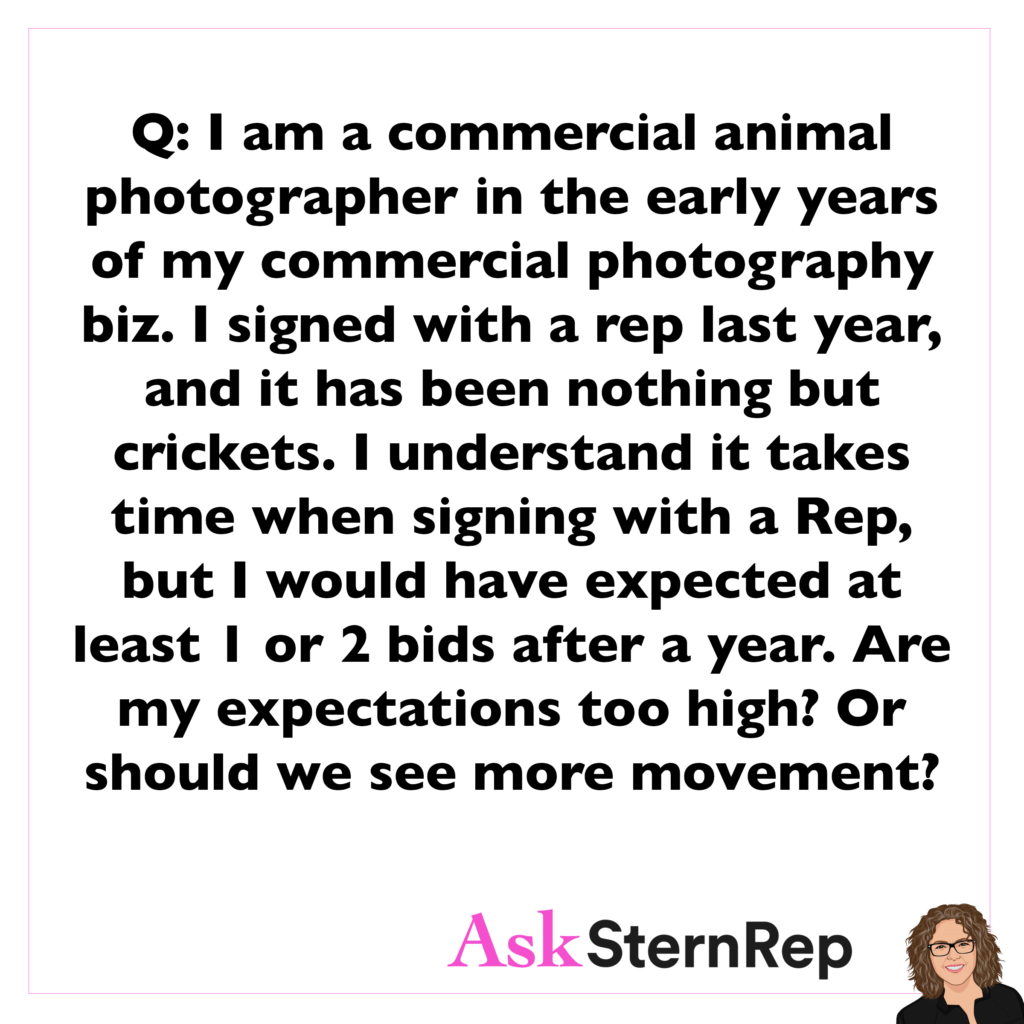
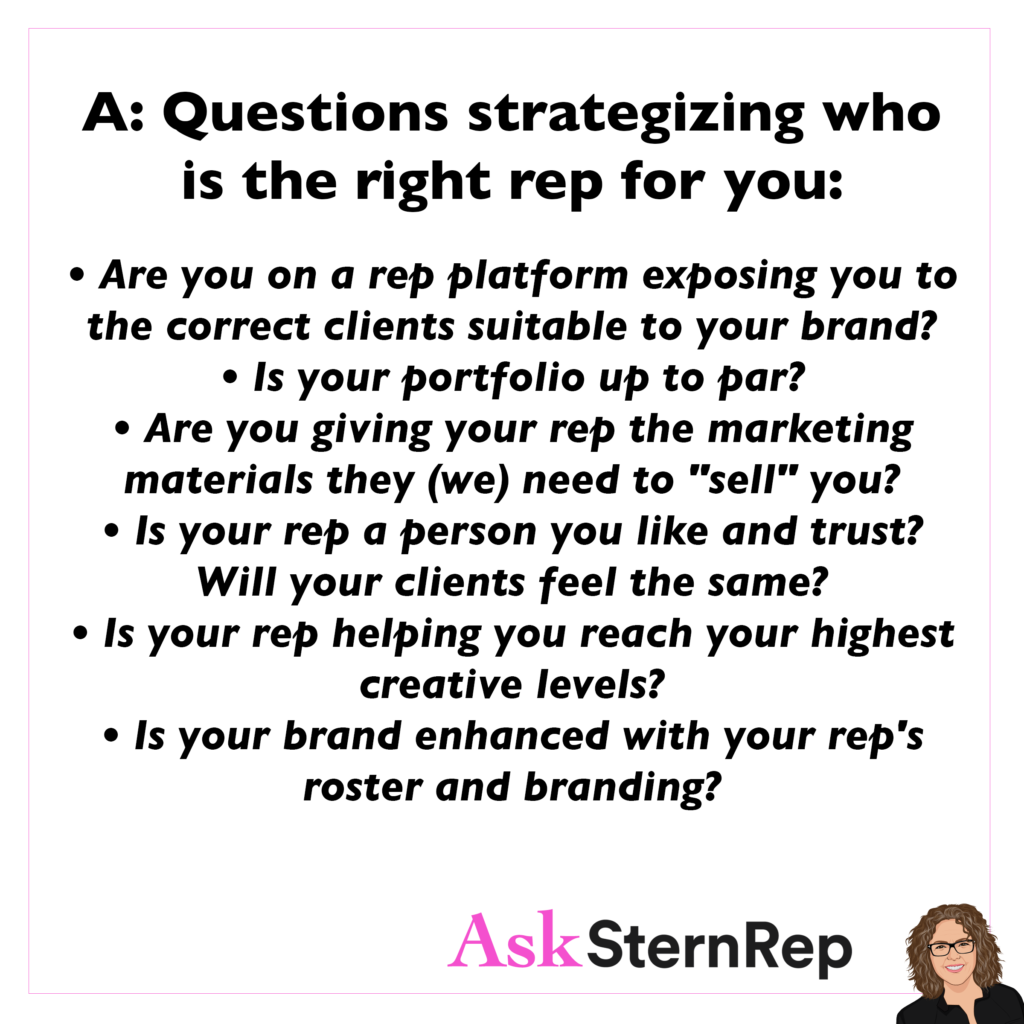
Q:
I am a commercial animal photographer in the early years of my commercial photography biz. I signed with a rep last year, and it has been nothing but crickets. I understand it takes time when signing with a Rep, but I would have expected at least 1 or 2 bids after a year. Are my expectations too high? Or should we see more movement?
A:
Questions strategizing who is the right rep for you:
- Are you on a rep platform exposing you to the correct clients suitable to your brand?
- Is your portfolio up to par?
- Are you giving your rep the marketing materials they (we) need to “sell” you?
- Is your rep a person you like and trust? Will your clients feel the same?
- Is your rep helping you reach your highest creative levels?
- Is your brand enhanced with your rep’s roster and branding?
Seize The Moment By Taking Advantage Of Opportunities As They Arise
Seize the moment!
Commercial advertising is one of the most fast-paced, busy sectors, creating this norm of not getting responses to all we put out there. Each dialogue situation requires thinking fast on my feet and strategizing for the highest gain in return. My “sales” mind looks for those few golden accessible opportunities to have our valuable resource’s attention to ‘use it before we lose it.’
As a Rep, I want to discuss the importance of seizing opportunities in the moment, and not letting them slip away. This business is fast-paced and full of multitasking, so it’s important to have a handy tool for getting things done quickly and efficiently. We have examples of missed opportunities, such as not following up with a producer for contact names, and not taking advantage of a job opportunity by not structuring an email in a way that could benefit the company.
Other Artists’ Work in Your Treatments

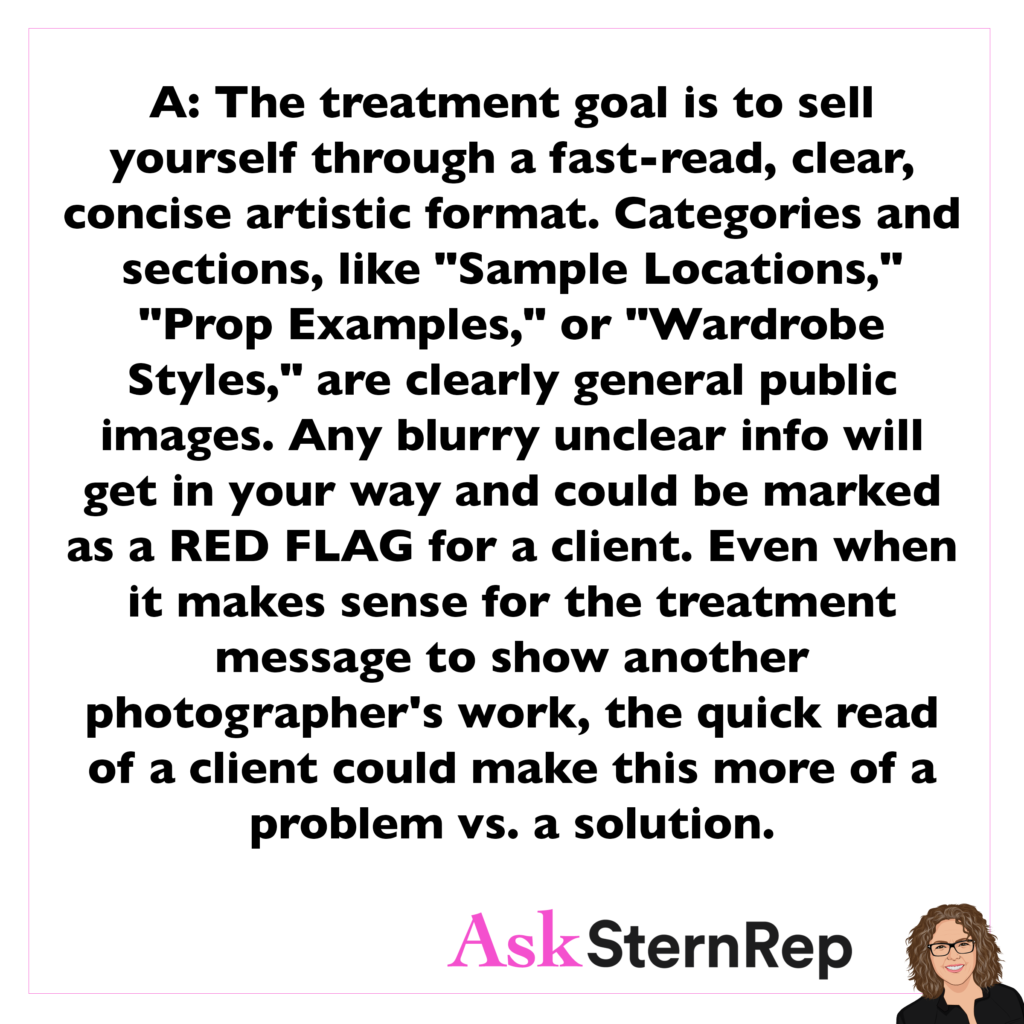
Q:
I discussed with other photographers whether putting other artists’ work in your treatments is acceptable. I’d love to know your perspective on this. Also, if you do, how should it be said that it’s not your work?
A:
The treatment goal is to sell yourself through a fast-read, clear, concise artistic format. Categories and sections, like “Sample Locations,” “Prop Examples,” or “Wardrobe Styles,” are clearly general public images. Any blurry unclear info will get in your way and could be marked as a RED FLAG for a client. Even when it makes sense for the treatment message to show another photographer’s work, the quick read of a client could make this more of a problem vs. a solution.
How Honest Should We Be When A Client Asks For Our Availability?
How honest should we be when a client asks for our availability? Dates of potential jobs shift and change constantly. How to not lose one job because of a “hold” from another is what we are up against. I have learned that clients present their shoot dates and usually have more flexibility than we are receiving. One way I like to phrase it is, “Right now, we are not officially booked on another job at that time.”
A lesson we learned about holds and availability. A client we wanted to work with had mistakenly assumed that the photographer they wanted to work with was unavailable on certain dates, based on a previous conversation. The client decided to look elsewhere for a photographer. The lesson learned was that it’s important to be honest about availability but also to make it clear that a job hasn’t been bid on yet and that there’s still a possibility of availability. We suggest doing a “first hold challenge” to ensure that the job is secured before cutting off availability.
Using a Rep for Larger Brand Clients

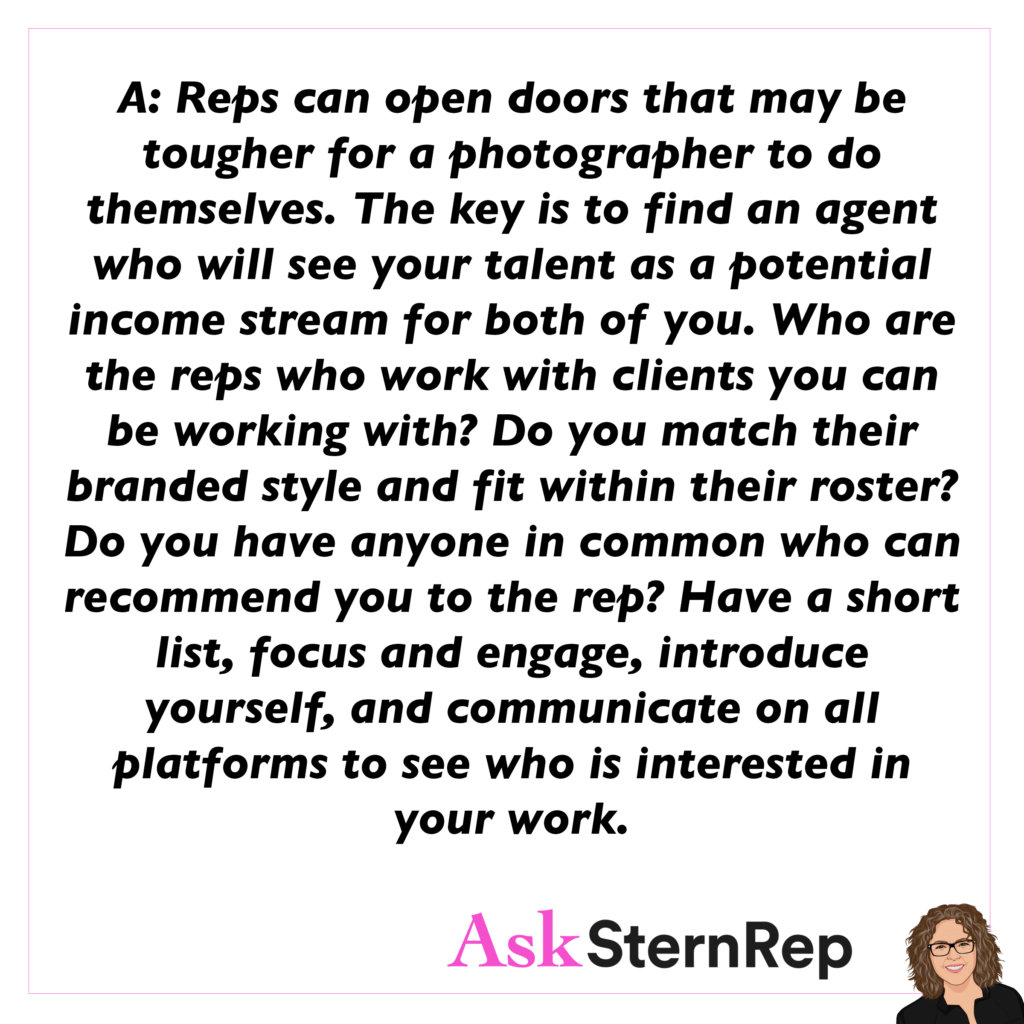
Q:
I want a rep to help me get larger brand clients. I’m working with good mid-level clients, but I’m at the cusp and ready to see which larger clients I can work with. What steps should I take to find the right rep to help me take my career to the next level?
A:
Reps can open doors that may be tougher for a photographer to do themselves. The key is to find an agent who will see your talent as a potential income stream for both of you. Who are the reps who work with clients you can be working with? Do you match their branded style and fit within their roster? Do you have anyone in common who can recommend you to the rep? Have a short list, focus and engage, introduce yourself, and communicate on all platforms to see who is interested in your work.
Reaching Overstimulated Clients In a Predominately Visual Industry
As visual business owners, our approach is all about the quick-read impact of reaching overworked and overstimulated clients. I look to trigger all senses to be absorbed and stick to their memory. We have an assorted potential toolkit with our IG, dm’s, emails, and promos to get noticed. Consider your client’s busy eyes and how to set the incoming pace for them to pause and absorb what we are selling.
As business owners, it is important to consider how clients receive our message. One approach could be to use all the senses to help the message sink in. For example, using words on reels with images can enhance the visual experience, while using dashes or capitals in emails can make the message more impactful. Leaving space between lines can also make the message easier to read and understand. Ultimately, it is important to remember that we are in a visual business, especially in fields such as photography.
OVERTIME
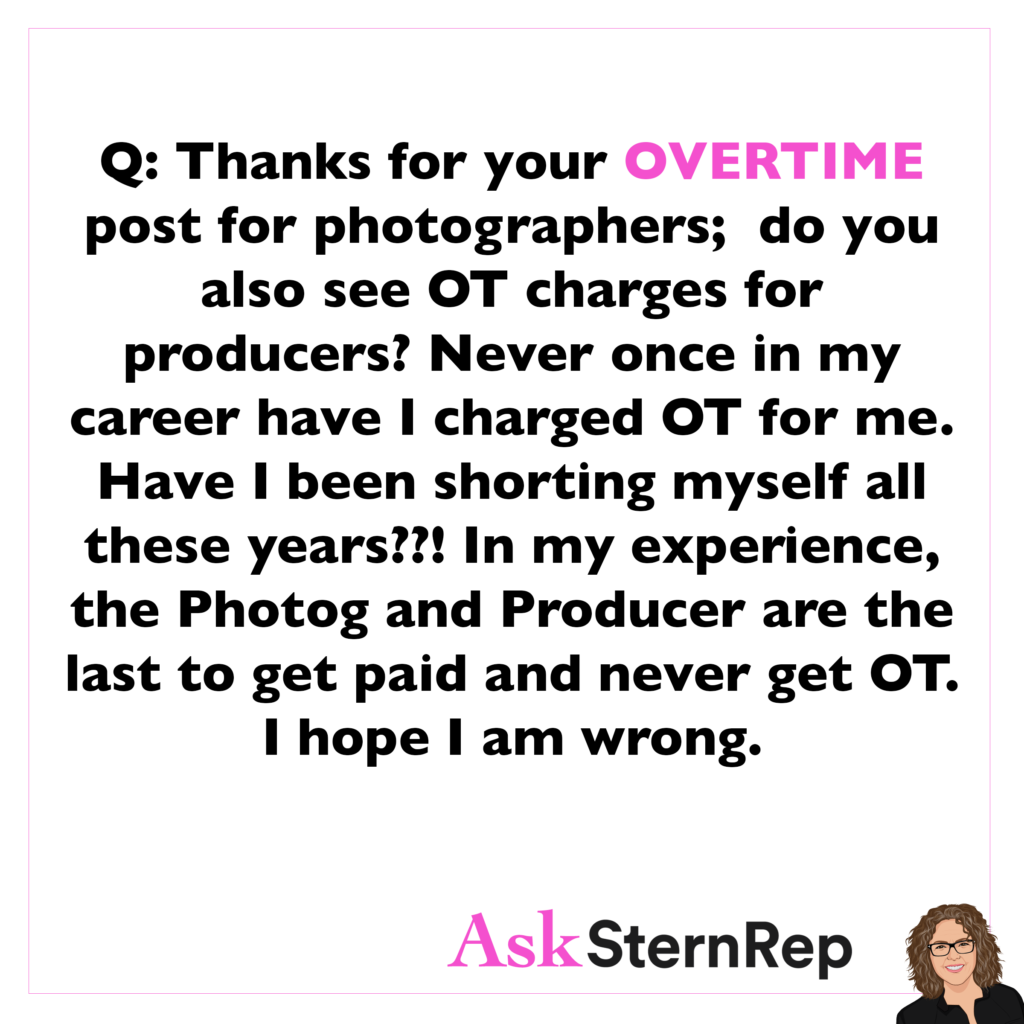
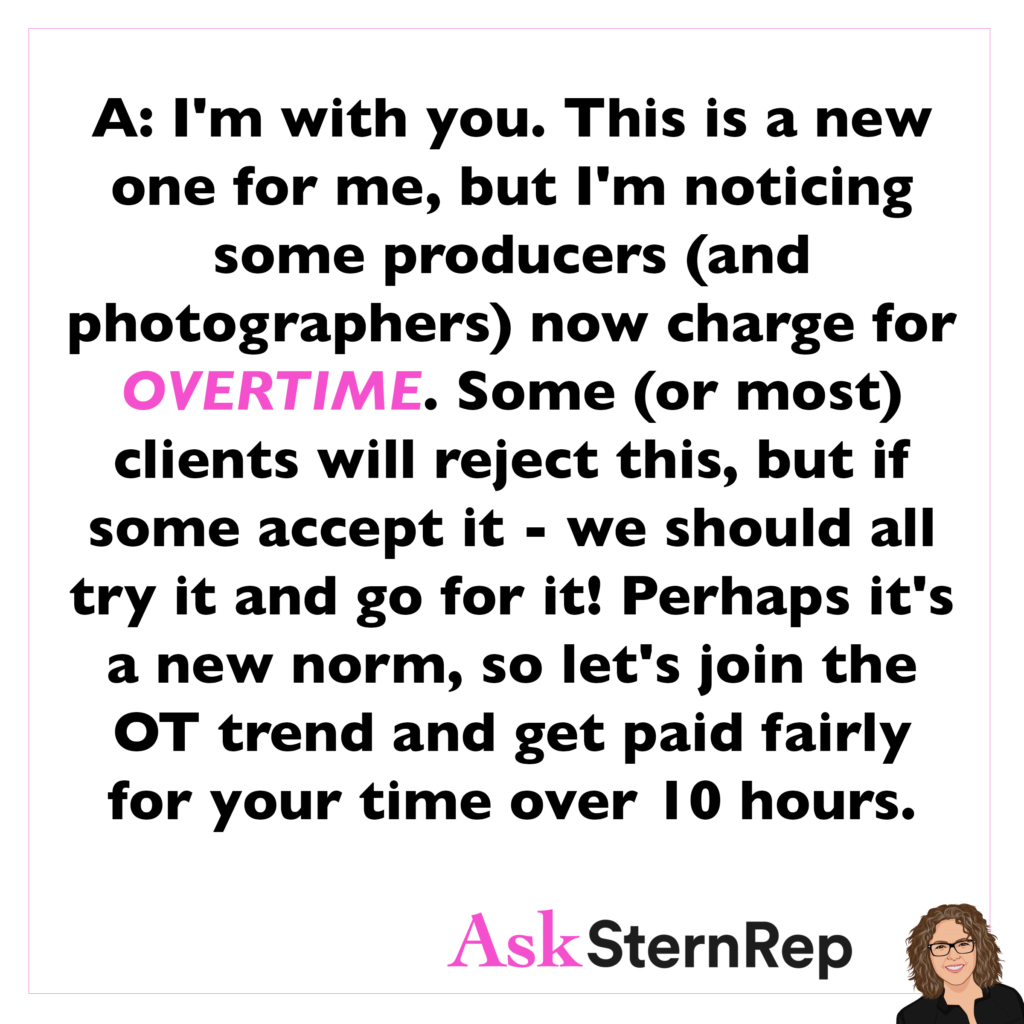
Q:
Thanks for your OVERTIME post for photographers; do you also see OT charges for producers? Never once in my career have I charged OT for me. Have I been shorting myself all these years??! In my experience, the Photog and Producer are the last to get paid and never get OT. I hope I am wrong.
A:
I’m with you. This is a new one for me, but I’m noticing some producers (and photographers) now charge for overtime. Some (or most) clients will reject this, but if some accept it – we should all try it and go for it! Perhaps it’s a new norm, so let’s join the OT trend and get paid fairly for your time over 10 hours.
Using Discounted Rates To Work With a Certain Client
You’ve been told the potential client’s budget, and you’d like to meet it but don’t want to be held to that amount in the future – use the words “Discounted Rate” as the best excuse not to guarantee that same rate next time. Even better, put a discounted percentage subtracted under your actual total to show the deal they are getting.
“Discounted rate” is a term used to protect oneself from future pricing when bidding for a job that has a lower budget than what it should actually cost. By taking off a certain amount from the total bid, one can still get the job, have the desired images for their portfolio, and protect themselves from future pricing demands. This approach is useful when the client is desirable and the type of images is beneficial for the portfolio. This way, the bidder is protected from being trapped into meeting the same requirements in the future. It is also possible to avoid listing out prices and just providing the total amount to be charged for the job.
Making The Most Out Of Zoom Portfolio Reviews

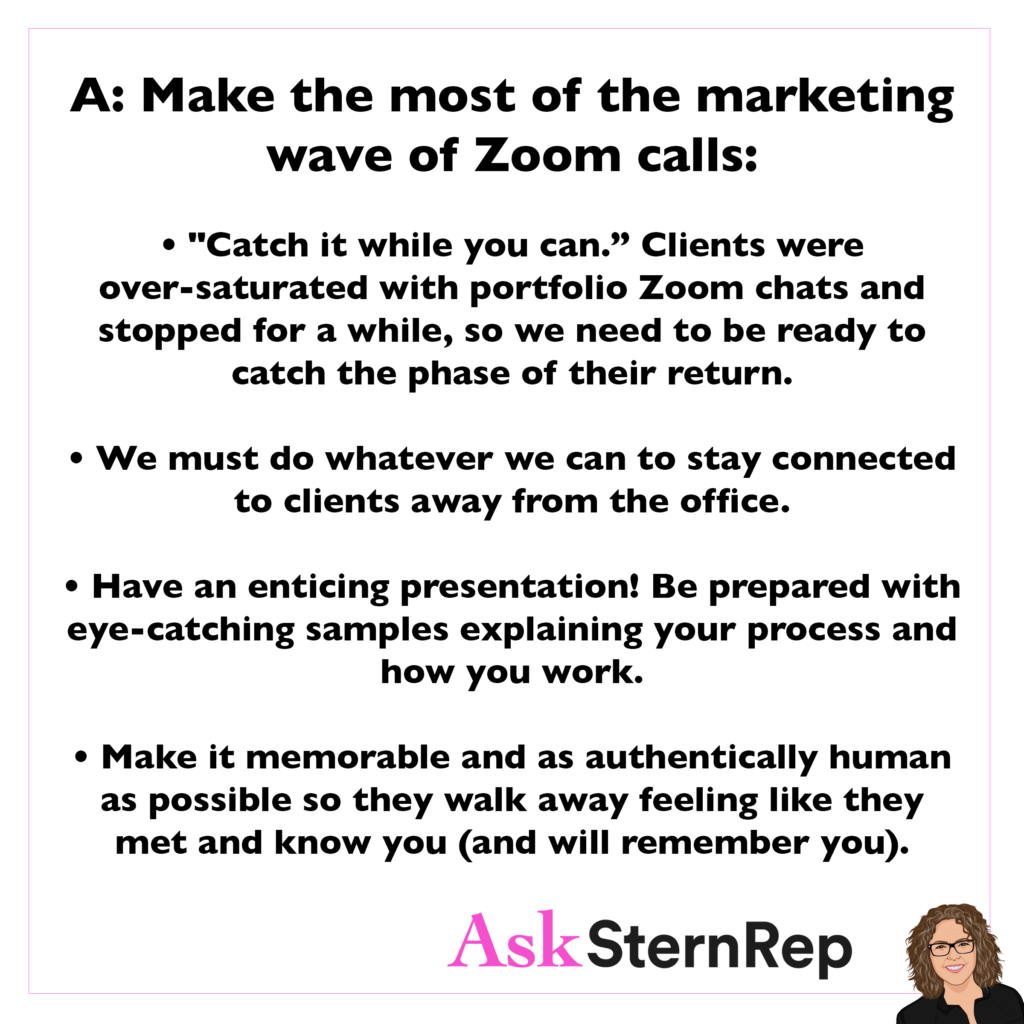
Q:
Do you have advice on preparing for and making the most out of Zoom portfolio reviews? Do photographers create a slideshow that they present and click through? It feels very different and possibly harder to stand out/be memorable than an in-person review.
A:
Make the most of the marketing wave of Zoom calls:
- “Catch it while you can” -Clients were over-saturated with portfolio Zoom chats and stopped for a while, so we need to be ready to catch the phase of their return.
- We must do whatever we can to stay connected to clients away from the office.
- Have an enticing presentation! Be prepared with eye-catching samples explaining your process and how you work.
- Make it memorable and as authentically human as possible so they walk away feeling like they met and know you (and will remember you).
Retouching Rates Can Be Ambiguous, Protect Yourself By Making It a Day Rate
Retouching rates leave ambiguity when it’s based on per image, so one way to protect your time spent is to make it a day rate. As you track your time, the client can be aware of the image(s) progression and even try to speed it along, helping them achieve more out of that 10-hour day they are paying.
When pricing retouching fees, it is important to be careful as clients and photographers may have different interpretations of what is being done, what is being supplied, and how many revisions are allowed. Feedback can become intense if not priced accordingly. One way to handle this is to charge a day rate for one 10-hour day, based on time instead of production level or the number of images. This makes it more about the retoucher’s time rather than the amount of images being worked on.
A La Carte Rep
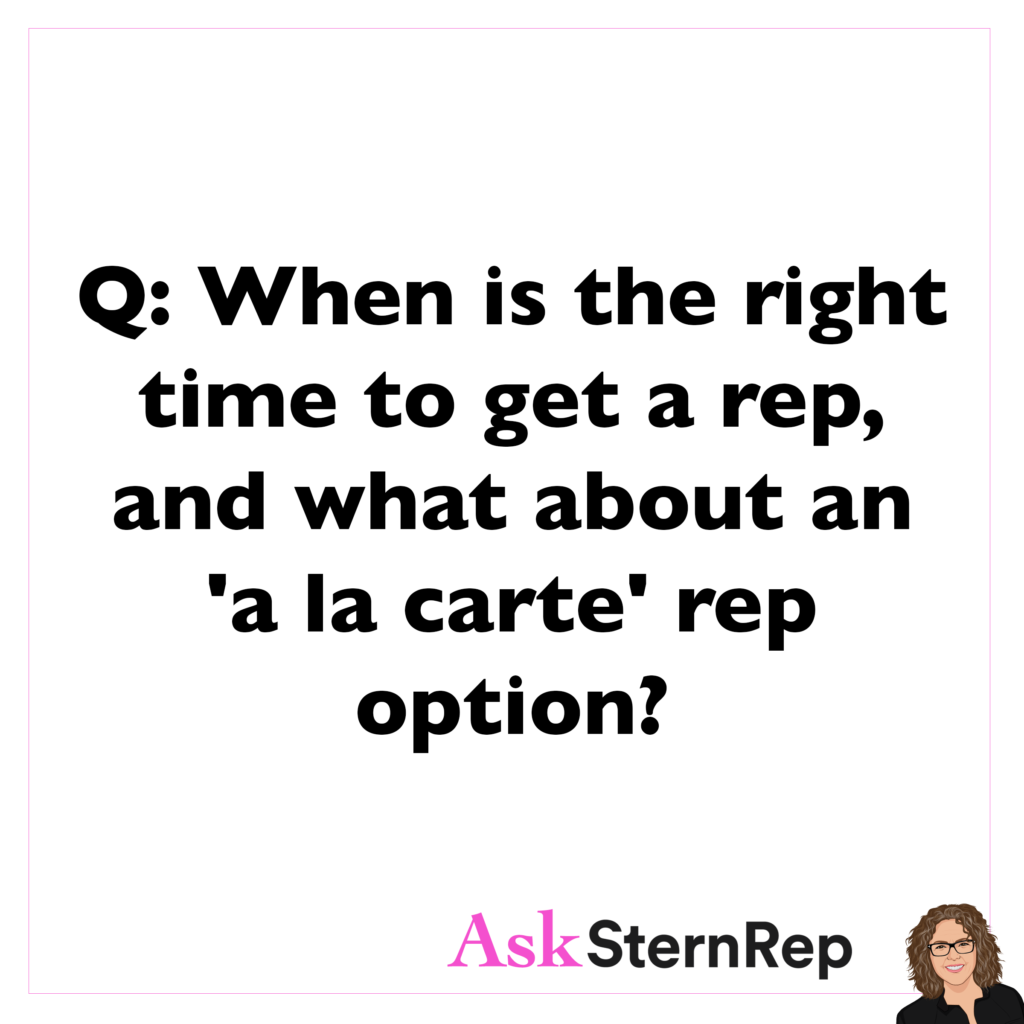

Q:
When is the right time to get a rep, and what about an ‘a la carte’ rep option?
A:
The time to get a full-time rep is when your work is at the level where you both gain financial success by teaming up. Until that point, “a la carte’ rep situations are plenty. It’s also a great way to know reps and see who can help you most in ways that cater to your work style.
Cover Yourself Before The Job Begins By Getting An Advance
Cover yourself by getting a 50% Advance Invoice BEFORE the job begins. You have more power in the game with clients on your side to get you paid and not delay the photoshoot vs. trying to convince them to hurry up after the job begins.
It is important to get an advance on your invoices. It is recommended that 50% of the job awarded should be invoiced in advance, and this should be included in the estimate and terms before the start of the shoot. If the request for advance payment is made after the shoot has begun, the client may have more flexibility and less urgency to make it happen. Pushing for an advance invoice before the shoot begins shows a level of professionalism and sets clear expectations with the client. Clients are more likely to respond positively to a clear and organized approach, and this can help build trust and credibility in the business relationship. Overall, advance invoices are an essential tool in the photography industry, and their importance should not be overlooked.
Refusing to Sign an Estimate

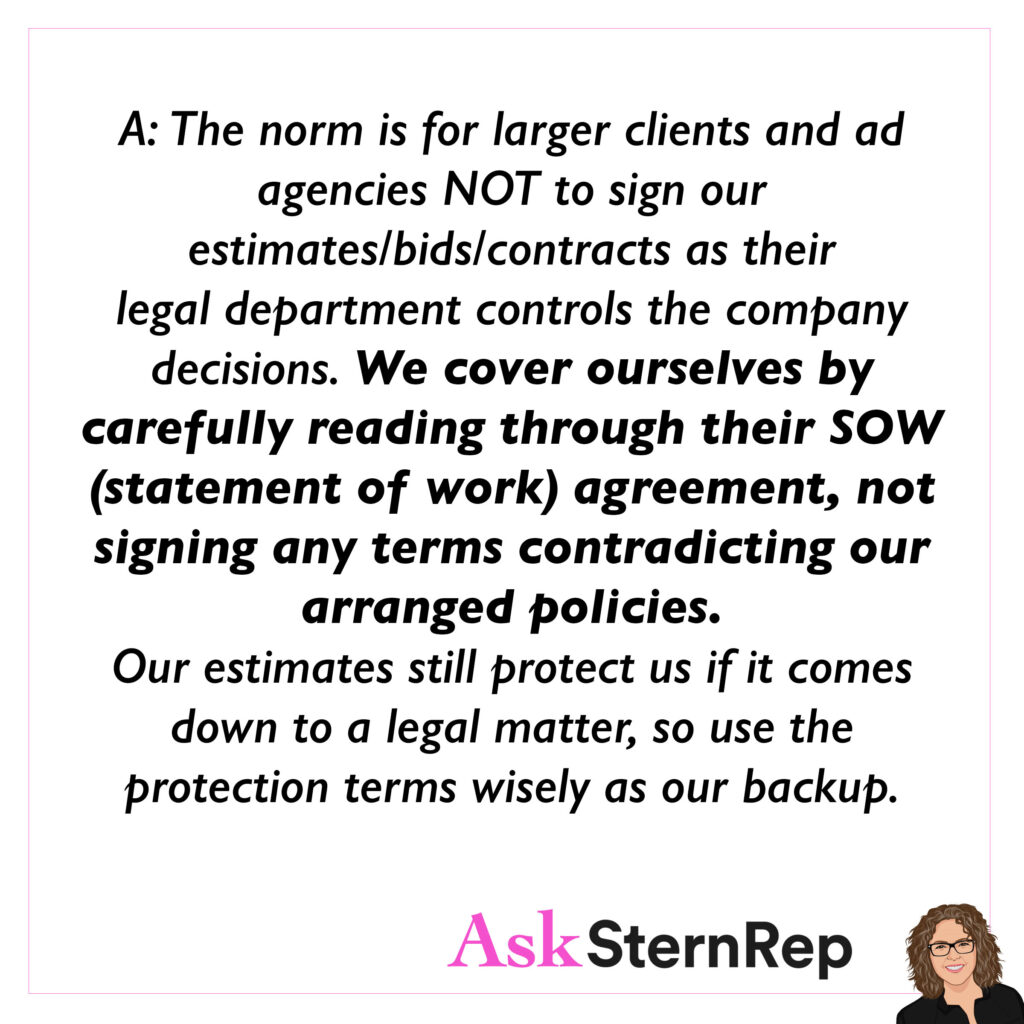
Q:
When you tell us always to provide an estimate, what if they refuse to sign your estimate, saying legal will only allow them to work off their agreement? How do we respond to cover ourselves?
A:
The norm is for larger clients and ad agencies NOT to sign our estimates/bids/contracts as their legal department controls the company decisions. We cover ourselves by carefully reading through their SOW (statement of work) agreement, not signing any terms contradicting our arranged policies. Our estimates still protect us if it comes down to a legal matter, so use the protection terms wisely as our backup.
How Rates Are Based On More Than Your Time
Rate sheets, rate cards, and day rates do not have to be the same across the board. Rates are based on more than your time, amount of images, and usage terms. Your unique creative experience and the client’s budget affect your fees, making ‘one single rate’ for every project an incorrect business model system.
Day rates in the photography industry are not fixed and can fluctuate depending on various factors such as the artist’s level of experience, usage, and the client’s budget. Negotiation skills and a sales mindset are crucial in determining the day rate for a particular job. The assumption that day rates remain the same once a certain level of success is achieved is incorrect. There can be a range of prices to consider, and it is not necessary to stick to one specific price.
Questions To Ask Your Future Rep
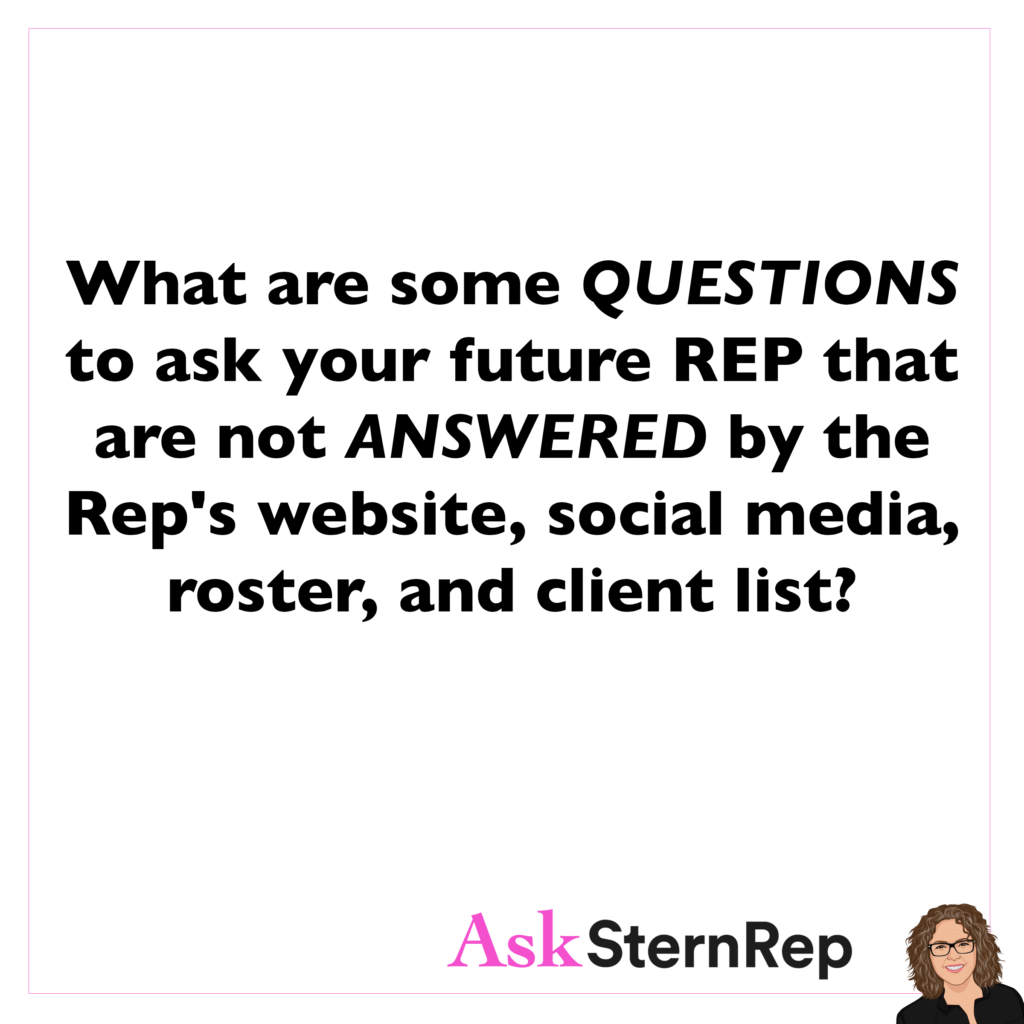

Q:
What are some QUESTIONS to ask your future REP that are not ANSWERED by the Rep’s website,
social media, roster, and client list?
A:
QUESTIONS to ask your future REP which are not ANSWERED by the Rep’s website, social media, roster, and client list:
Severance terms?
Requirements from me?
Do you charge any monthly fees?
Which direction do you see me moving forward in or succeeding in?
Which parts of my portfolio could use more fleshing out “testing” attention to reach my highest potential?
Additional Usage Pricing Options
Additional usage pricing options are the one client request which gives us more flexibility than the other bid costs since they do not add to the bid total. My approach is to come in higher on these since it won’t make or break a bidding situation, allowing the wiggle room to be lowered after we get the job.
Discussing the benefits of pricing oneself for additional options for usage when negotiating a photography job. By having control over additional usage terms, a photographer can negotiate for more options and flexibility in their fee. This allows for more negotiation and freedom, as photographers are not held to a strict usage amount in their fee. Furthermore, additional usage terms are optional and can be used as a bargaining tool to ask for more money or benefits. This approach can provide more financial security and opportunities for photographers in their industry.
Bidding Without Getting The Job
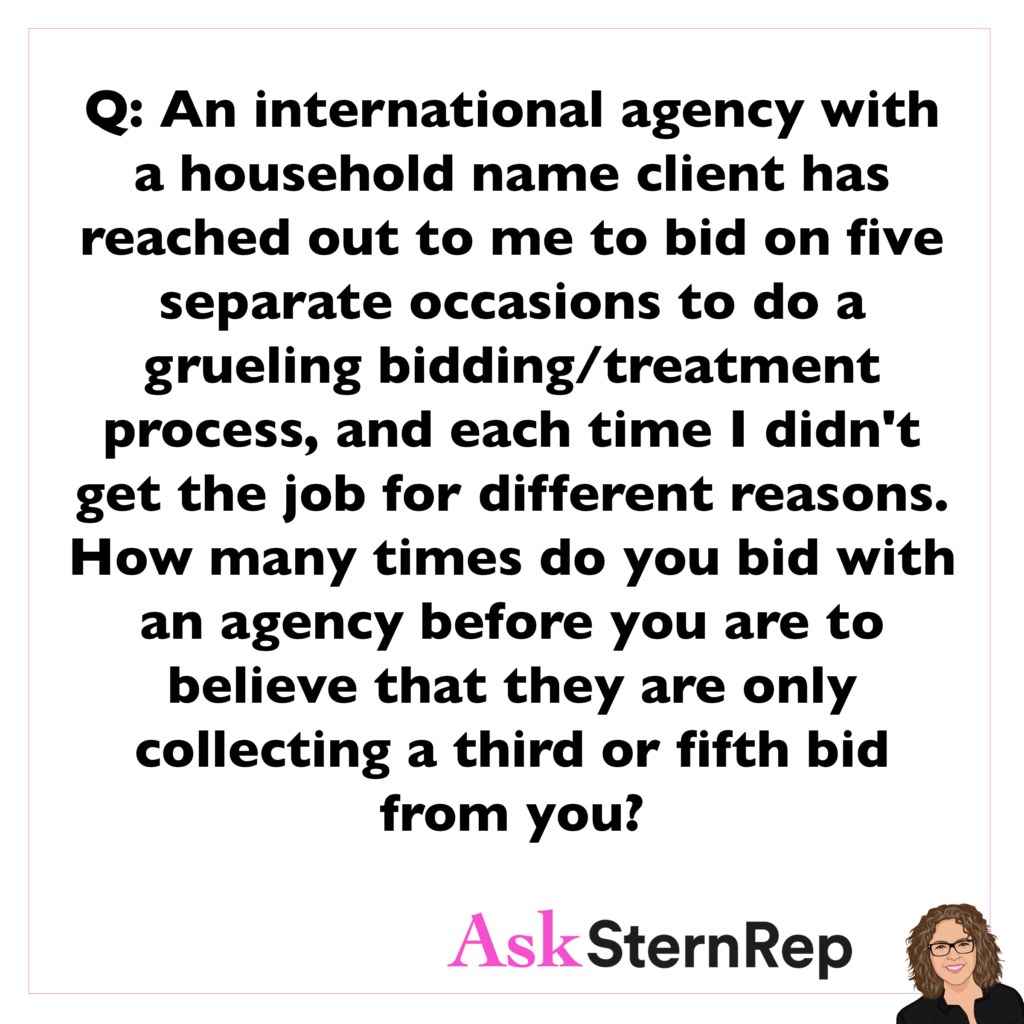

Q:
An international agency with a household name client has reached out to me to bid on five separate occasions to do a grueling bidding/treatment process, and each time I didn’t get the job for different reasons. How many times do you bid with an agency before you are to believe that they are only collecting a third or fifth bid from you?
A:
Bidding’s long-term goal is to keep yourself well-footed inside the agency doors with the ever-evolving creatives and clients. Repetitive bidding may indicate that you are in the door but must strengthen the relationships and your work to get further in. See the open door as an entry invitation. Invite them to dinner and ask the Creatives what they look for, taking your relationship to the next level.
Photographers’ Overtime Rates
Photographers’ overtime rates (after 10 hrs) are charges I was only using for the crew. Now I’m seeing some clients approve this as a normal request. I’m changing my bidding plan to include OT rate information (10-12 hrs= 1.5x hourly rate, after 12 hrs= 2x hourly rate) on every estimate.
The topic of whether photographers should charge overtime for themselves, not just their crew, is a new and uncertain area for many photographers. We put the question out to our Facebook group and received a variety of responses from different clients and photographers. Despite the differing opinions, we suggest that photographers should try to include overtime in their estimates and see if clients are willing to accept it.
Sales Tax For Digital Goods


Q:
I recently moved to a state where it is required to pay sales tax for digital goods. As a commercial photographer, how appropriate is it to charge sales taxes to my clients?
A:
Sales tax laws have been changing, and no matter how you deliver your images, some states like Kentucky and Texas now require photographers to charge clients sales tax after we have invoiced them a certain amount.
If you know of a good resource for this, please share it in the comments.
Our Marketing Plan Must Be Flexible
OUR MARKETING PLAN should not be defined solely by what we know from last year. We must stay ahead of the evolving ebbs and flows, depending on the concept that what worked last year gets old quickly in our business. If we rely on what worked before as our one course of action, we will lose out on all the potential nuances of our progressive industry.
The biggest mistake in marketing planning is to stick rigidly to a set plan. Marketing involves going with the flow and being open to trying new things. If engagement is received on social media, it’s important to follow up and see who else at the company might be interested. Staying up to date with new technologies and algorithms is also important, and being open-minded and flexible in approach can lead to natural progression and success.
How Effective Is Behance?
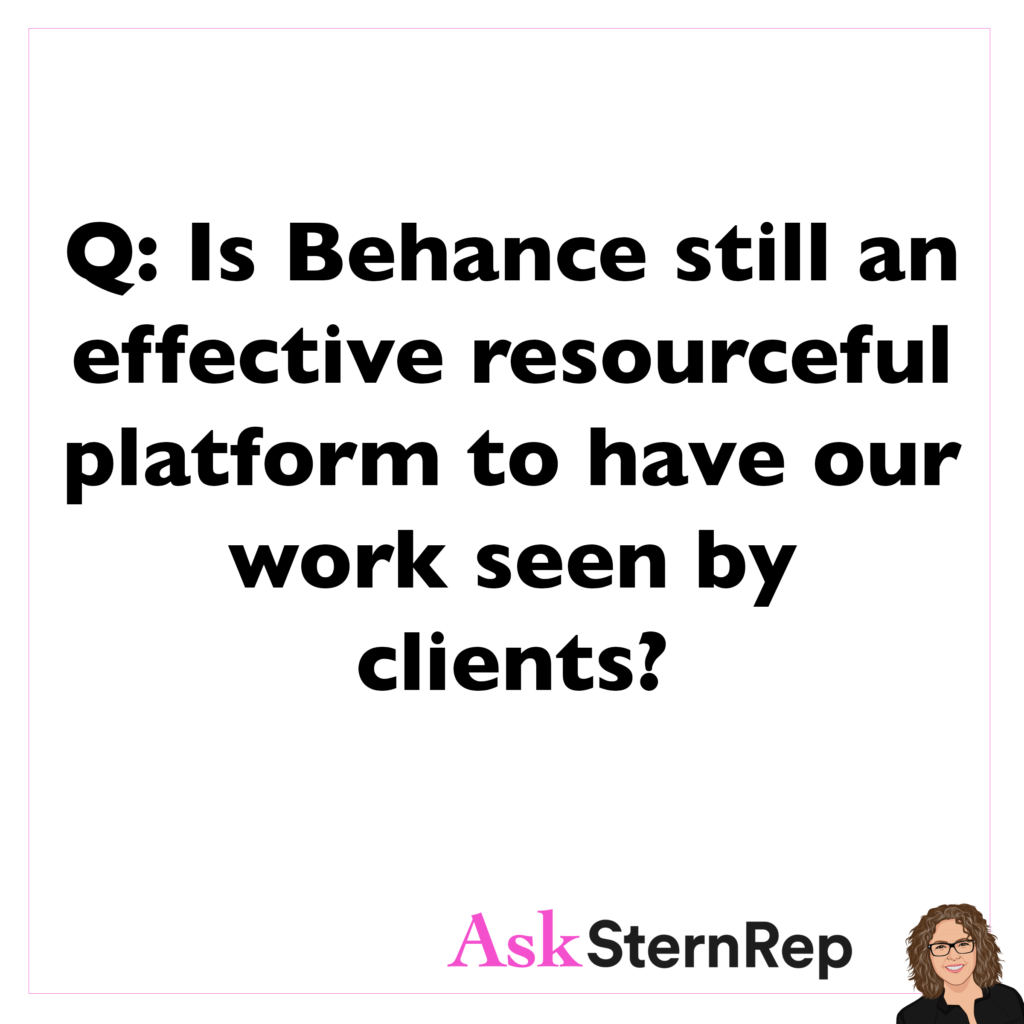

Q:
Is Behance still an effective resourceful platform to have our work seen by clients?
A:
I have received bid requests for my photographers found on Behance. The difference with Behance is how creatives use it for their work, similar to Instagram and LinkedIn. Going where the art directors, creative directors, and designers spend their time is a tried and true way to go.
Strategic Category Padding To Deal With Bidding With Larger Clients
Bidding with larger clients usually means dealing with cost consultants asking us to reduce their selected costs. The better we prepare with strategic category padding, the more we can keep in our budget and respond with reasoning explanations of why costs need to stay the same.
When bidding for a job with larger clients, it is common for clients to hire cost consultants to review and fine-tune the bid. The cost consultants’ job is to reduce prices, so it is expected that some areas will be padded. This can include crew size, producer time, equipment rental, and even meals. To prepare for cost consultants, it is recommended to pad some areas knowing they will be reduced. For example, inflating prices a little bit or bringing up prep days with the expectation of being asked to reduce them. It is important to adjust for cost consultants on the client side to secure the job.
Tagging Clients on IG
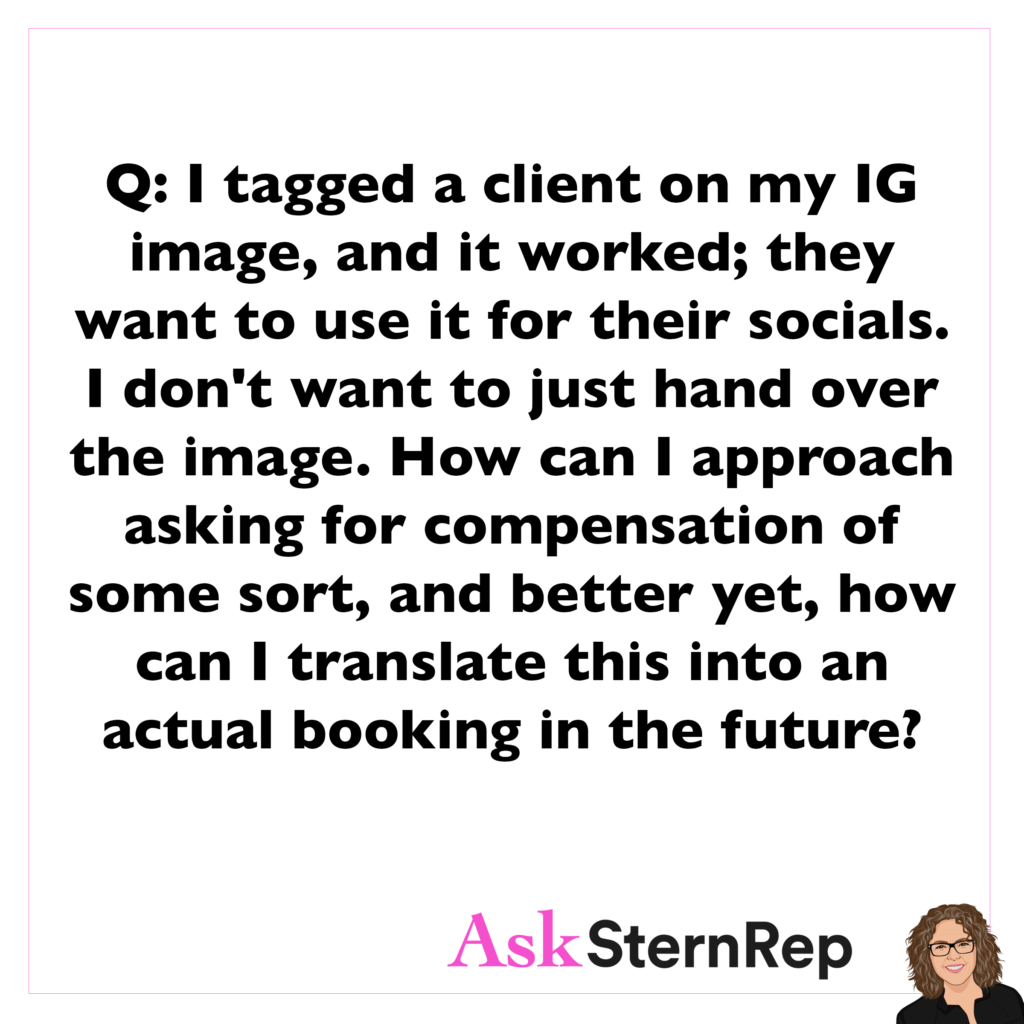

Q:
I tagged a client on my IG image, and it worked; they want to use it for their socials. I don’t want to just hand over the image. How can I approach asking for compensation of some sort, and better yet, how can I translate this into an actual booking in the future?
A:
Tagging clients on IG is one strategic door-opening marketing tool, but it is more of a way in vs. a way to sell that image. How?
- Usually, the social media manager will not have a budget to purchase image usage for IG.
- You’ve created the rare opportunity of having their attention for one response.
- Use this door-opener to get the “photography hiring” contact information.
- If your image is shared, get your name tagged to use this for your benefit.
- Take this experience as a conversation starter on LinkedIn, where you will talk to the correct potential clients.
Always Provide An Estimate
Always provide an estimate. Don’t tip-toe around this when a client doesn’t request a bid from you. If all details are emailed to you, discussed on the phone, or you approve their pdf, send them your estimate to cover yourself with all potential mishaps.
When a client approaches you for a job and provides you with a contract, they may assume that all the necessary details are included. However, it is important to submit an estimate to ensure that both parties are on the same page. An estimate includes information on prices, what is covered, and what is not covered. It is also important to include a job description and details on any additional items such as travel expenses or equipment. By providing a clear estimate, you can avoid misunderstandings and ensure that the client understands what they are paying for. Even if the client does not ask for an estimate, it is highly recommended that you provide one.
When Is The Right Time To Get a Rep?
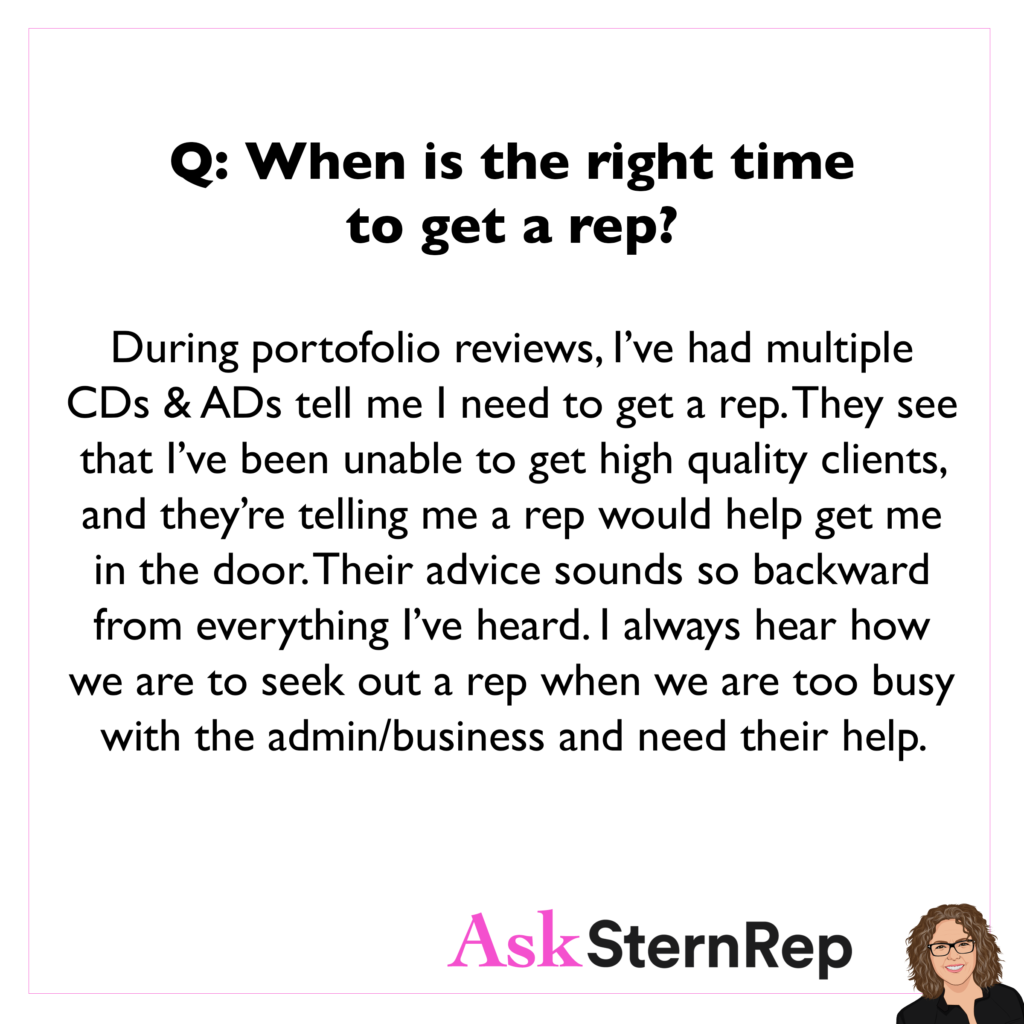

Q:
When is the right time to get a rep?
During portfolio reviews, I’ve had multiple CDs + ADs tell me I need to get a rep. They see that I’ve been unable to get high-quality clients, and they’re telling me a rep would help get me in the door. Their advice sounds so backward from everything I’ve heard. I always hear how we are to seek out a rep when we are too busy with the admin/business and need their help.
A:
I’m glad you asked this because it always sounded strange when I heard the popular theory on getting a rep when you can’t handle all your business alone. My experience has been repping photographers looking for help to open client doors. If you can potentially make more money with a rep on your side, and if the rep can make money with you, it sounds like a win-win!
Overages Can Be Tricky
Overages can be tricky. If you are on set or prepping on production, they ask for more, and you’d like to say yes, wait for that exact overage cost to be approved – preferably in a traceable email, signed estimate, or even their overage PO. The magic word is APPROVED. Get your overage cost approved BEFORE you begin spending that extra amount.
It is important to account for overages in estimating project costs. Overages refer to additional charges that may be incurred when changes are made to the original project specifications. We advise that overages should be approved by the client before they are incurred. For instance, if new props or backgrounds are added to a project, the client should be informed that additional fees will be incurred.
Recognized Company With Low Rate


Q:
I’ve spent time sending samples of my work for a company I thought I’d be perfect to work with. They finally responded with some interest in me by holding some dates, but they released me. What shocked me was the rate of $1500 for the shoot. Is this normal? I understand I am just getting started, but it felt low for the company’s size and brand recognition.
A:
Kudos to you for getting your work out there to the companies you want to work with. That is step one. I see the increase of $1500 rates due to a heavily saturated industry with more in-house marketing clients, more photographers, and more marketing opportunities for all of us to be in direct contact with our dream clients. Take the feedback as a stepping stone to growing your dream client list, increasing your marketing options, and fine-tuning your testing/branding focus.
Giving Your Marketing Plan a Purpose
Marketing Outreach:
15-20% of our time and budget should be spent reaching out to BRING IN clients. Have a point, giving your outreach a purpose. The outreach cornerstone is about having something to say to make it work. New images/website/feed, new ideas, or recent experience brings a relatable interest point to reaching out.
Marketing outreach should account for 15 to 20 percent of our time and budget. This effort should be directed at both current clients, with whom we have a relationship and need to stay in touch, and potential clients we don’t yet know.
How do we do this effectively? I bet every rep out there would agree that we need to have a clear point, a relevant question, or a meaningful statement tailored to their work, their location, or their industry. Whether we’re commenting on Instagram, engaging on LinkedIn, emailing, or inviting someone to lunch, we should always have a clear objective.
Think about what you’re up to—how you’re growing your business, any new equipment you have, what you’re learning, or your recent experiences. Have something substantial to say and make sure to convey it to the person you’re reaching out to.
Digital Usage Rights and Billboards
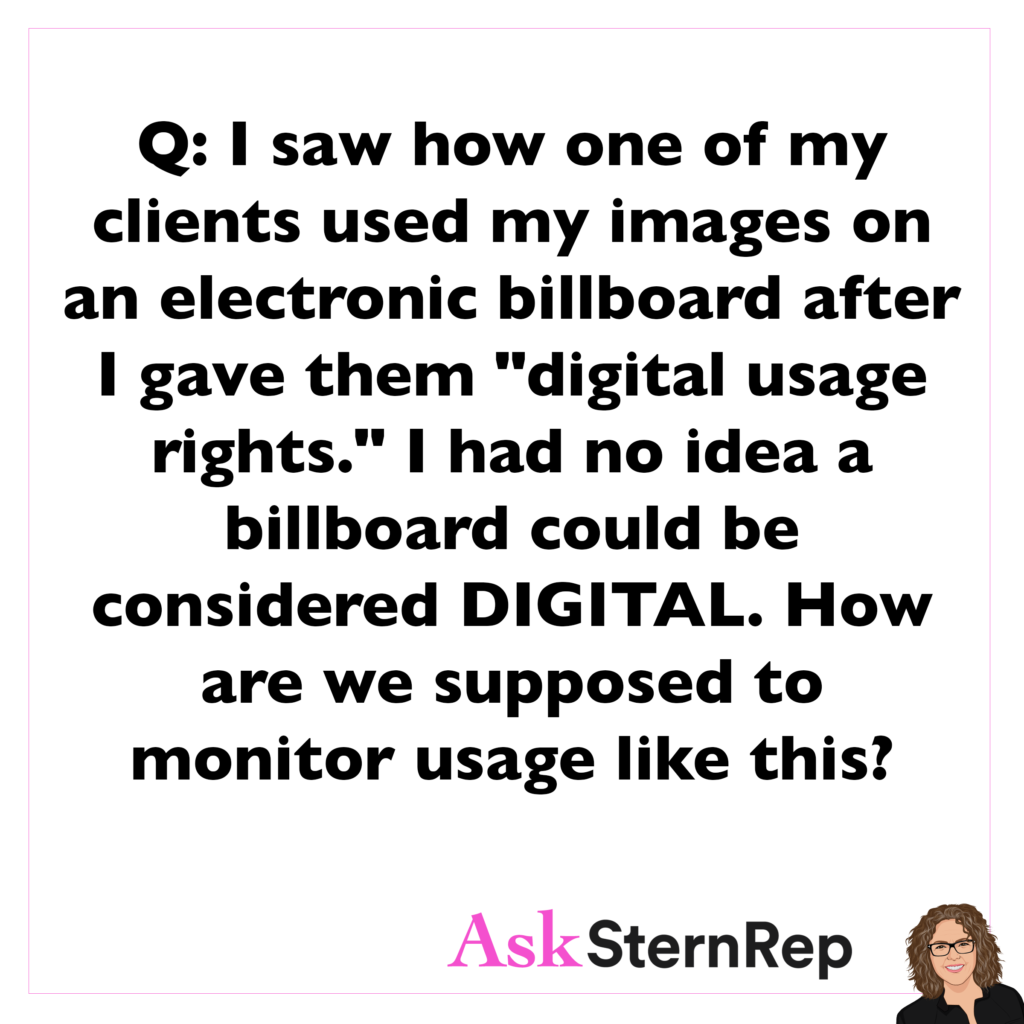
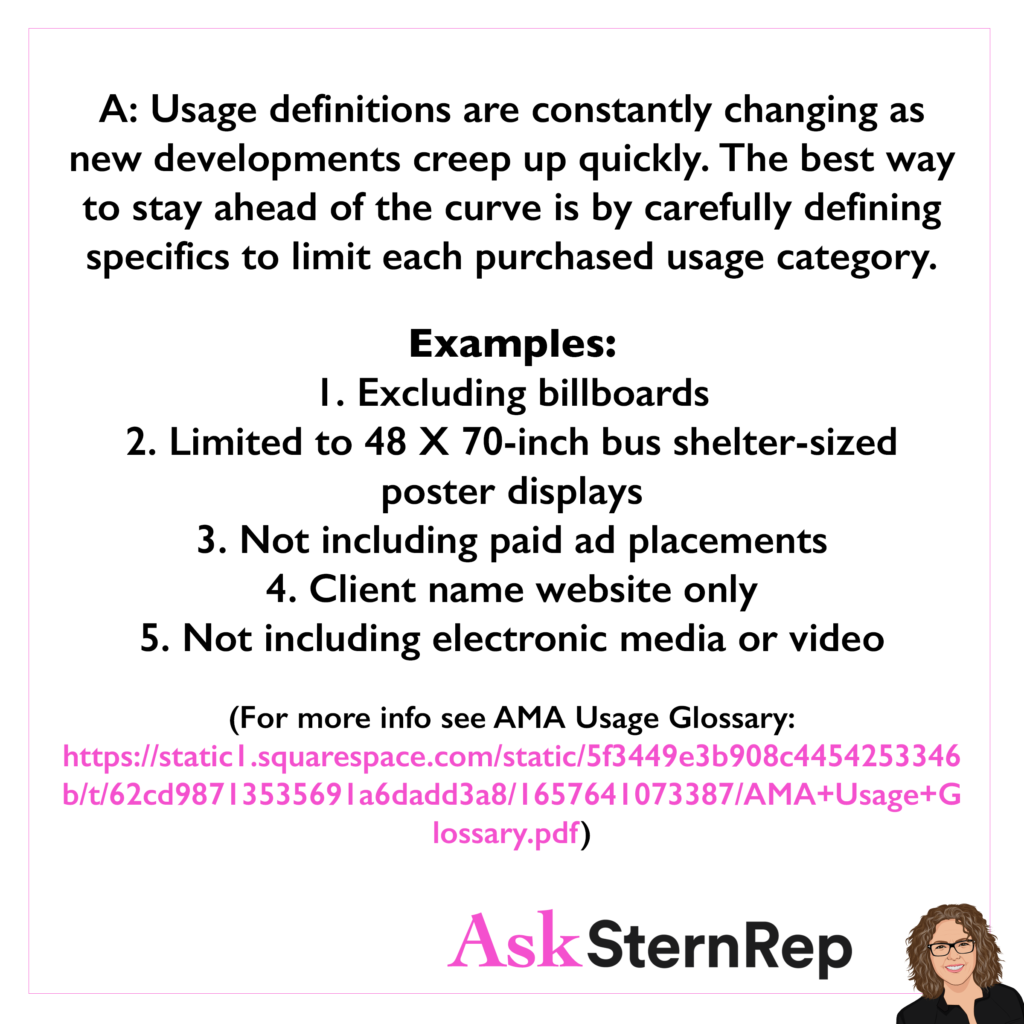
Q:
I saw how one of my clients used my images on an electronic billboard after I gave them “digital usage rights.” I had no idea a billboard could be considered DIGITAL. How are we supposed to monitor usage like this?
A:
Usage definitions are constantly changing as new developments creep up quickly. The best way to stay ahead of the curve is by carefully defining specifics to limit each purchased usage category.
Examples:
1. Excluding billboards
2. Limited to 48 X 70-inch bus shelter-sized poster displays
3. Not including paid ad placements
4. Client name website only
5. Not including electronic media or video
(For more info see AMA Usage Glossary: https://static1.squarespace.com/static/5f3449e3b908c4454253346b/t/62cd98713535691a6dadd3a8/1657641073387/AMA+Usage+Glossary.pdf)
Success in the Photo Business Does Not happen by Sitting Around
Success in the photo business does not happen by sitting around waiting for the phone to ring.
Step 1: Research ‘Marketing Strategy Planner’ options. (asksternrep.com/downloads)
Step 2: Construct your personalized skillset kit.
Step 3: Put it into action with no holds barred.
Step 4: Rejection implies it’s time to maneuver your particular way in.
Conclusion: not one required way to do this; find your way.
Tenacity is important when it comes to achieving success. There is no rulebook or guidebook to follow, and the only guidebook that exists is what each individual has to offer. Each photographer should do things their own way and find their own paths to success. We provide a marketing strategy planner on www.asksternrep.com, but we emphasize that individuals should find their own ways and not be discouraged by closed doors or rejection.
– Tenacity is important for success in the photography industry
– There is no concrete rulebook or guidebook to follow
– Each individual must find their own path to success
– Don’t be discouraged by closed doors or rejection
Printed Portfolios
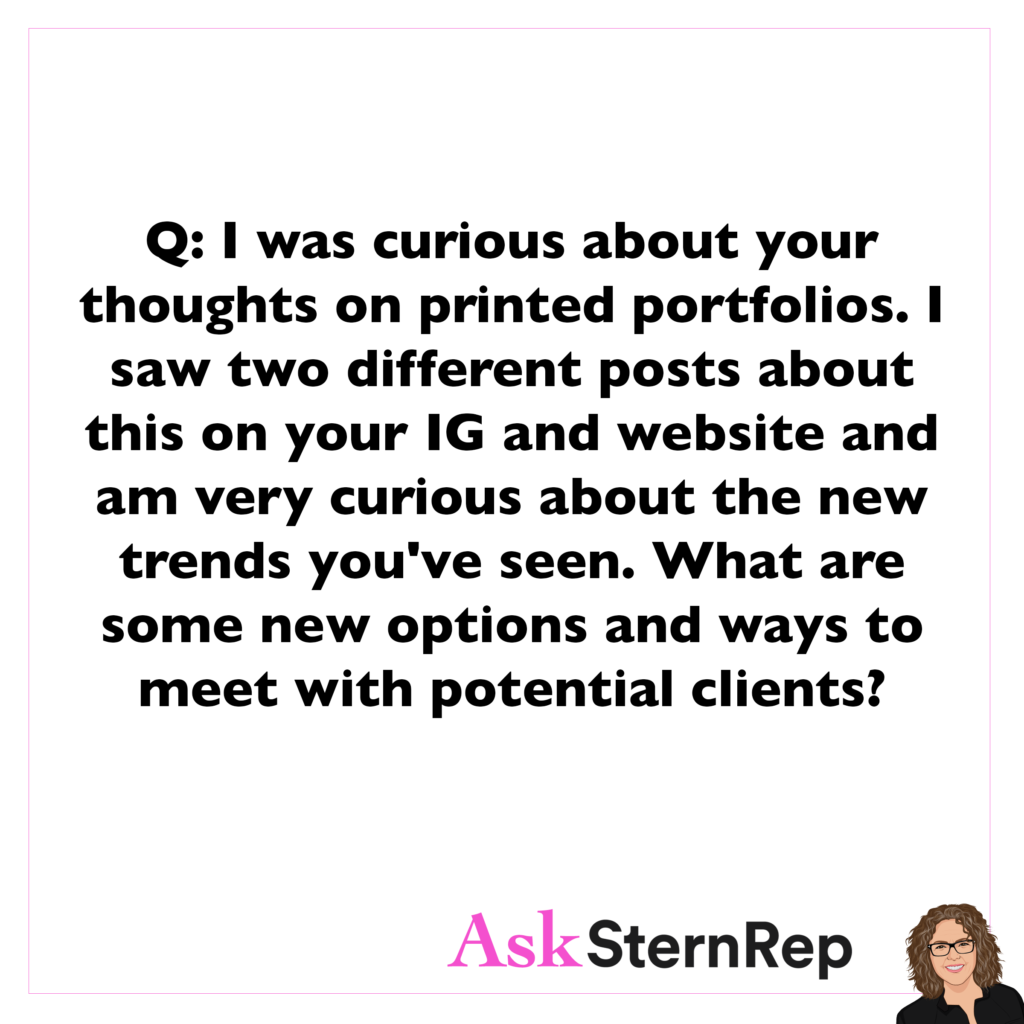
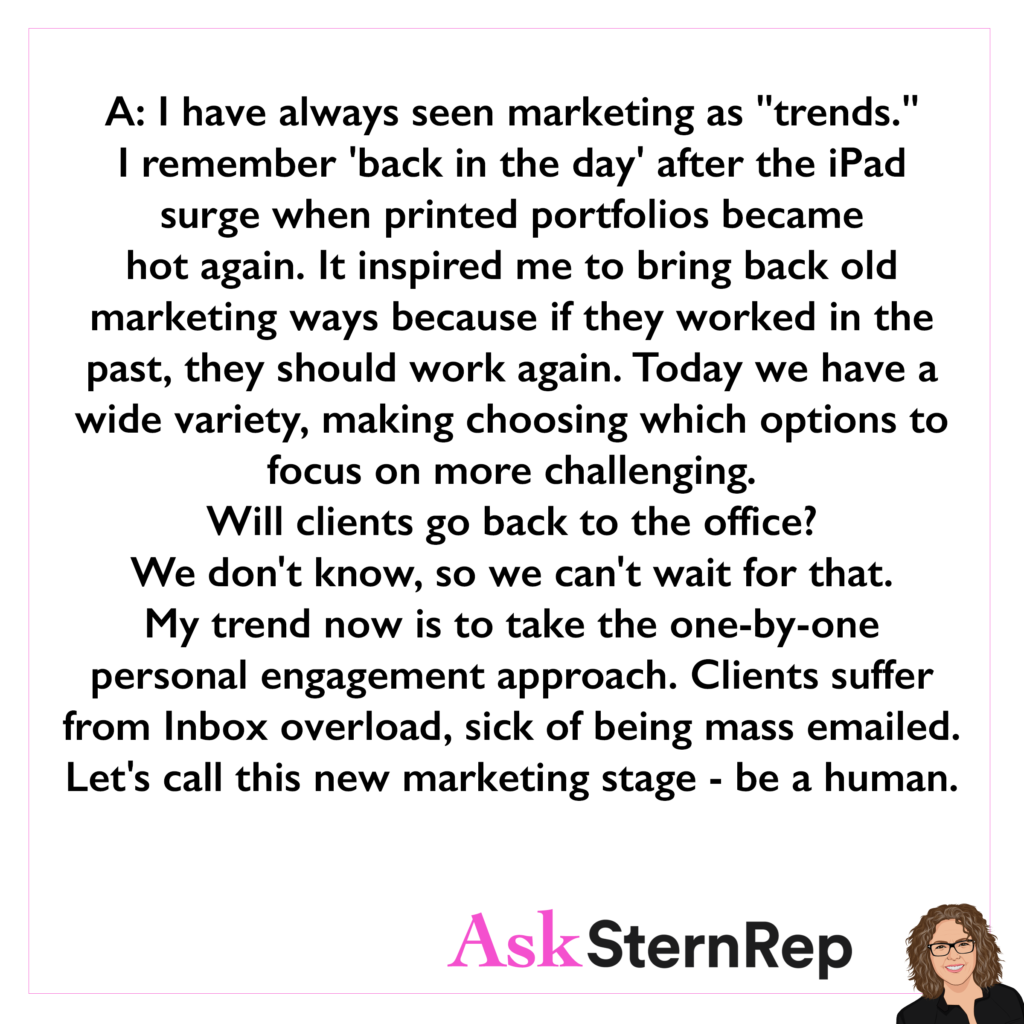
Q:
I was curious about your thoughts on printed portfolios. I saw two different posts about this on your IG and website and am very curious about the new trends you’ve seen. What are some new options and ways to meet with potential clients?
A:
I have always seen marketing as “trends.” I remember ‘back in the day’ after the iPad surge when printed portfolios became hot again. It inspired me to bring back old marketing ways because if they worked in the past, they should work again. Today we have a wide variety, making choosing which options to focus on more challenging. Will clients go back to the office? We don’t know, so we can’t wait for that. My trend now is to take the one-by-one personal engagement approach. Clients suffer from Inbox overload, sick of being mass emailed. Let’s call this new marketing stage – be a human.
BUSINESS ANALYTICS Begin with Researching your Competition
BUSINESS ANALYTICS begins with researching your competition.
Use your rival’s success as your master’s degree guidebook for potential improvements – what exactly sets them apart, and what do clients captivated by in their images? What are the high-line business standards seen on the top competitor’s website and Instagram that we need to use as a wake-up call?
Raising your creative level in this industry depends on understanding who the best of the best are—those you’re competing against or hope not to be competing against when triple bidding on a job. Knowing who these top competitors are and why they are successful is fundamental to improving your own work.
Researching your competitors is not just inspirational; it’s also crucial for understanding their business strategies. Look at their websites: is it their image flow, coloring, or production value that stands out? When they test, do they use wardrobe stylists, prop stylists, or experiment with different lighting?
Study what makes them appealing to clients and what sets them apart. Analyze their approach and think about what you can add to your own site and images based on your findings. Be your own analyst of that type of competition and use that knowledge to elevate your own creative and business practices.
Marketing and Business Challenges

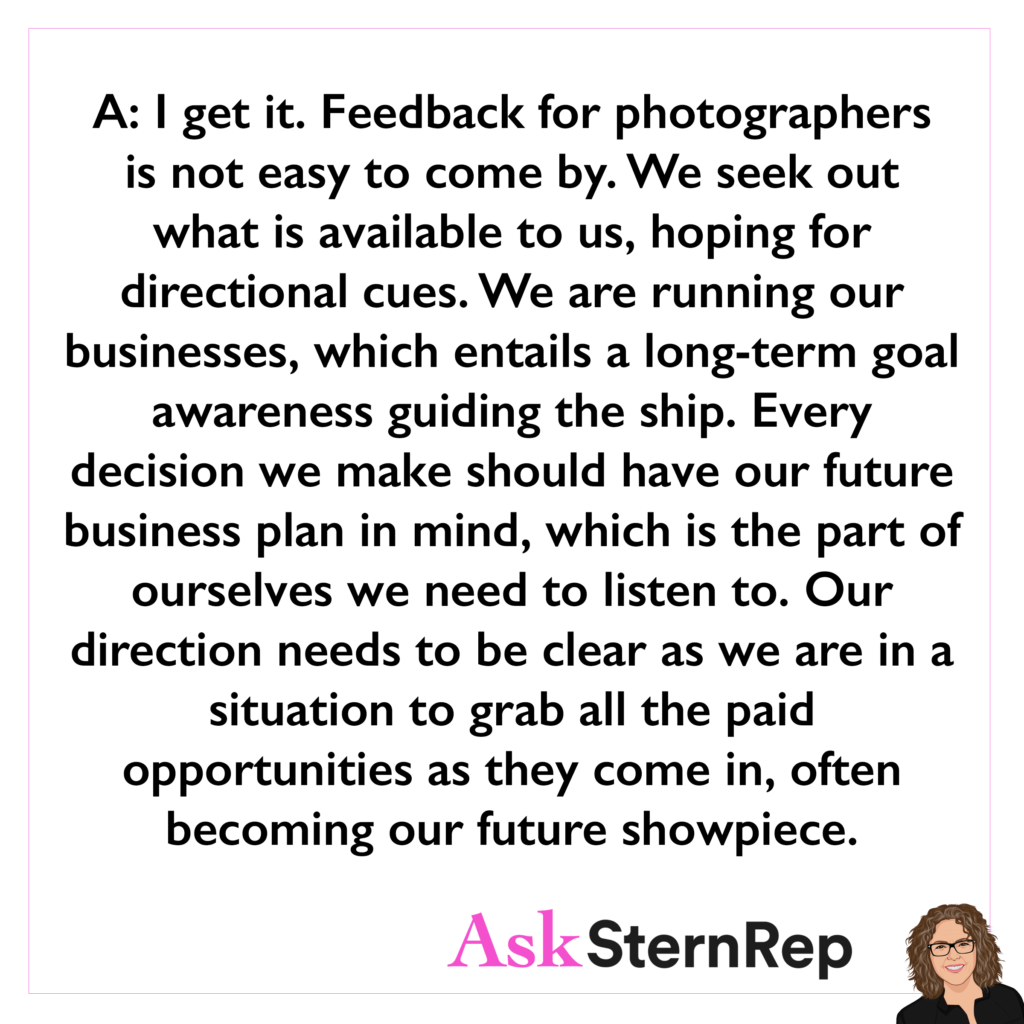
Q:
I was a wedding photographer and then got into commercial photography. The challenge was having a wedding-forward website in the commercial world. I worked with a rep company for the website edit, which looked beautiful, but I was told to switch to a standard industry website for easier navigation. Since then, I’ve lost massive business, and my traffic and SEO rankings have dropped severely. Because of this, I want to put headshots and wedding work back on my site and listen to myself instead of someone else.
A:
I get it. Feedback for photographers is not easy to come by. We seek out what is available to us, hoping for directional cues. We are running our businesses, which entails a long-term goal awareness guiding the ship. Every decision we make should have our future business plan in mind, which is the part of ourselves we need to listen to. Our direction needs to be clear as we are in a situation to grab all the paid opportunities as they come in, often becoming our future showpiece.
Our Bid Is Our Last Chance Of Having Any Control Over Getting The Job
Our bid is our last chance of having any control over getting the job. We may assume our numbers will be similar to other bidders, but I’m telling you those bid facts are often different for each bidder. Clients move quickly, speaking to each photographer/rep, sometimes unable to closely monitor the specifics of our bids. It’s our responsibility to call out the details of our pricing, making the particulars crystal clear and spelling out any potentially blurred categories. Don’t leave it to chance!
It is significant to include all essential information in a bid to prevent costly mistakes. Clients know their budget and don’t always share this information and they encourage bidders to provide comprehensive details in job descriptions. This includes mentioning props, stylists, and locations, rather than assuming the client will handle it. Take control of the bidding process as it may be the last chance to have any control over obtaining the job.
Building Bigger Productions


Q:
All my work so far has been just me or me and one assistant. I want to start building up to bigger productions. It makes sense to start with a personal test project or two to expand my portfolio, practice working under new conditions, make connections with possible crew members, etc. How do I gradually build up my productions, and in what order should I start adding crew, e.g., prop & wardrobe stylists, HMU, digital tech, producer, etc.? Or does that depend on the specifics of each job?
A:
Production Value is one of our highest industry-level rating metric systems controlling photographers’ careers. Why? Clients want to know what to predict if they hire you. They want to see proof that you can control the outcome of their project and not leave it to a moment of chance. In saying that, we must also incorporate the market’s popular trends toward a natural editorial feel of “realness.” Aside from having a consistent, steady message in your overall portfolio, commercial advertising requires high-quality styling. Whether it’s food, hair/makeup, wardrobe, or props – stylists are the #1 factor in raising the production value of a photographer’s portfolio.
Don’t Be Too Busy To Focus On Your Long-Term Career Intentions
Don’t be too busy to focus on your long-term career intentions. Our freelance industry is distracting and zooms by quickly; we could wake up and feel shocked that we let time get away from us. Spend at least one-third of daily busyness aiming at the desired career path.
Don’t be too busy for your career, especially for those in the freelancing industry. Freelancers may feel that they have the luxury of not working on days when they are not on set or in the office, but this is not true. Freelancers must be accountable and keep themselves on track by setting goals, scheduling their time, and mapping out how they will achieve their goals. They must make the most of their time, working towards their office goals every day, whether they are working or not. Be disciplined and stick to a schedule in order to succeed in this fast-paced industry.
Marketing Budget Formula


Q:
How should I spend my marketing budget this year?
I have two options:
1) I have a listing agent who reaches out to specific clients.
2) I can do online or in-person portfolio reviews.
Neither one is cheap, but I can commit to doing at least one of them this year, and would like to, as I’m trying to land at least one more corporate or ad client this year. I’m also hoping to expand my reach, and not always be hired locally/regionally.
A:
SternRep’s Marketing Budget Formula is the overall breakdown of the available imagery placed in all potential places attracting the attention of potential clients.
We call this combo- InReach and OutReach; working in tandem. Our marketing budget covers our time and hiring help in all areas, used to gain insightful feedback on what works.
InReach:
Step one – updating quick + easy landing spots (website, IG + BeHance) for clients to see/find the work.
Step two – consistent content creation show-pieces for LinkedIn posts, promos, portfolio pdf, IG Reels, articles/blogs for SEO, etc., all drawing traffic to landing spots.
OutReach:
Step one – personal and mass engaging on all platforms generated by the timely content we have to show.
Step two – setting up reviews/meetings/showings/calls taking the connection a step further.
Step three – follow-up across all mediums on a well-scheduled system.
The Creative Call Has The Most Impact on Landing You The Job
Once your foot is in the triple bidding door, the creative call has the most impact on landing you the job. Listen for the moments to interject, not based on their inviting pause, but because you relate or understand the scene they are describing and know how to make it happen.
The most important way to stand out in a job interview, especially in the creative industry, is through the creative call. It is an opportunity for you to showcase your ideas and connect with the client on their story and concept. The portfolio and bid are important but the creative call is where you can have the most influence as you’re on the call with them and able to share your ideas and add to their story. Clients want to hear your ideas being added to their own and want to know that you will join them in bringing their vision to life. It’s important to speak up and share your thoughts and ideas, whether it’s through a question or a statement. This is where you can show how you think and stand out from other candidates.
Saving a Client Relationship

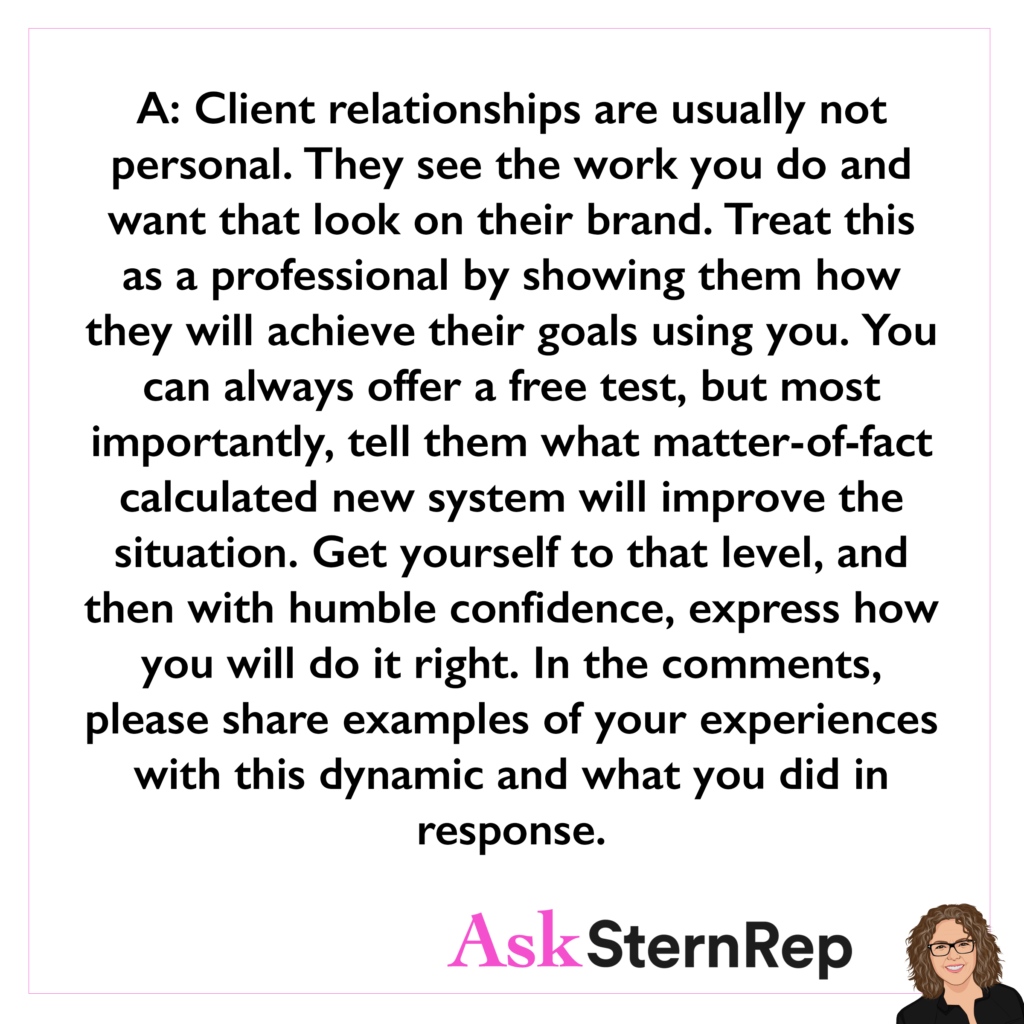
Q:
How do you try to save a client relationship after messing up repeatedly?
A:
Client relationships are usually not personal. They see the work you do and want that look on their brand. Treat this as a professional by showing them how they will achieve their goals using you. You can always offer a free test, but most importantly, tell them what matter-of-fact calculated new system will improve the situation. Get yourself to that level, and then with humble confidence, express how you will do it right. In the comments, please share examples of this dynamic and what you did.
Business Problems Require Business Responses
Business problems require business responses.
Please do yourself a favor, and cut to the chase by pinpointing the issue you want to solve by addressing the facts, gains, and losses speaking directly to their business sensibility.
Business challenges will come up, and they are naturally going to tap into our emotions. How do we handle this? We shouldn’t respond emotionally, even though that’s our instinct and feeling. Instead, our reaction should be business-based if we want to solve the problem and address what’s really happening.
We need to focus on how the issue is affecting our business—whether it’s causing a gain or a loss. By tapping into their business mindset, we can ensure the discussion remains rational and professional, rather than personal.
Rep’s and Marketing
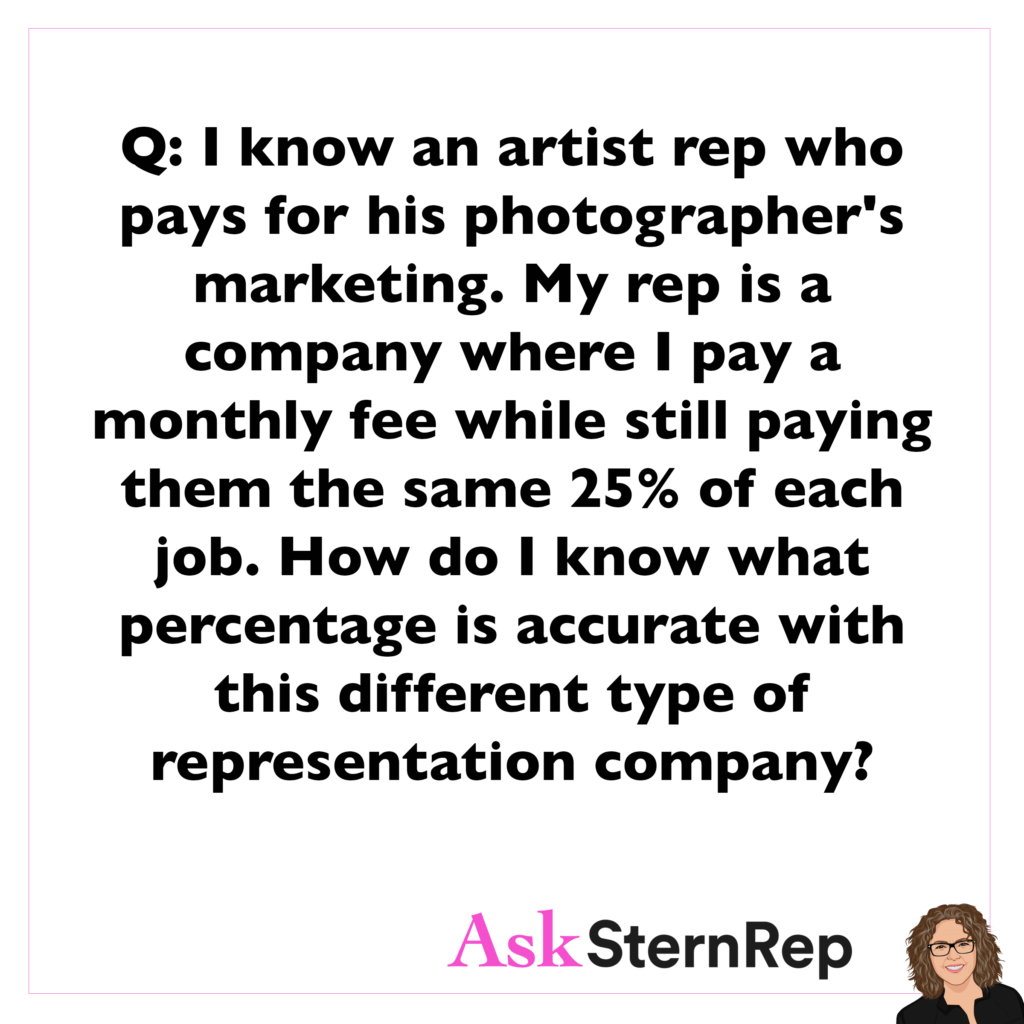

Q:
I know an artist rep who pays for his photographer’s marketing. My rep is a company where I pay a monthly fee while still paying them the same 25% of each job. How do I know what percentage is accurate with this different type of representation company?
A:
The rep/agent/marketing company configurations are more diverse due to the increase of photographers in our industry, each with different fee structures, making it challenging to compare. We have reps, marketing companies, and networking promotional directories removing the easy comparison of who does what and how much to pay. I’ve even opened a wing called Temp Rep due to the large number of photographers needing bidding representation. Which platform(s) best fit your client base awareness while fitting into your annual salary percentage allotted for marketing? My rule on this is -the expense should eventually pay for itself. The simple answer is to pay for what works for you.
Creative Calls are an Opportunity
Creative calls are the one bidding opportunity to be human to human.
Clients want a sense of you; even if they already know you, they will want a clear grasp of how you perceive this project. An expression is not always through your comments, as you may be listening to the majority of the call. Be the active listener as they will hear your reactions of nodding in agreement and overall upbeat presence.
The creative call is your chance to grab the client’s attention—it’s one of the three key ways to secure the job you’re bidding on. How do you make the most of it?
Create a strong presence, as if you’re sitting across from them at a table. React and respond actively, mirroring their cues to connect on a personal level. Tilt your head, smile, and maintain eye contact to show you’re engaged. Avoid looking bored, tired, or distracted. Use this opportunity to capture their attention and increase your chances of getting the job.
Beauty Photography Business


Q:
I’m trying to get into the beauty photography business by going for smaller brands in my local area, but I’m finding it very hard to create leverage in this industry. I’ve tried email marketing, and sometimes their PR domains are blocked. Instagram messages think I want to “collab” with them. I’m unsure how to start networking with consumer package companies. What do you recommend I can do to be seen by commercial clients?
A:
We all face similar challenges to get in front of potential clients, as described here, no matter which area of photography we focus on. Of course, it begins with a strongly branded portfolio showing you off quickly and succinctly. After that, it’s a potluck of strategic moves knowing which you are getting done and which need more attention.
Check out my Marketing Strategy Planner on “Downloads” –https://asksternrep.com/downloads/ where I map out all the potential ways I use to rep photographers to the appropriate clients. Pick a few favorites on my pyramid chart and see what works for you.
Stay Active With Others In The Business
Photographers don’t have to be loners. Staying active with others in our business can tap into that business place in ourselves we all look to recharge. It’s there, at our fingertips, ready for us to relate to those who get the intricate subtleties that keep our business afloat.
Why, oh why, do photographers feel they have to be so alone in our business? That’s a misconception. When you’re regularly connected with people—whether it’s on Clubhouse, Zoom, or in person with a group—you’re engaging with your business on a deeper level. It’s important to make your work communal; it’s about culture and community. You need to create this for yourself. We don’t have to keep our careers so isolated. Engaging with others brings excitement and is incredibly valuable. Trust me, it’s worth doing.
APA Talks: Pulse of the Industry | The Instagram Advantage
In today’s world, Instagram is the one-stop-shop marketing tool available for photographers in the commercial advertising industry. From caption writing and engagement to content planning – Andrea Stern, Ranee Vespi, and Hugh Kretschmer share their wisdom and knowledge on the impact of Instagram as a marketing tool in this APA LA Pulse of the Industry conversation The Instagram Advantage: What are we supposed to be doing on Instagram?
Listen to explore the advantages of Instagram for commercial photographers and discover how it can help your business grow!
Learn more about American Photographic Artists (APA) at https://apanational.org/
Photographers! Are you looking for support with your portfolio, marketing or Instagram? Visit ASRconsulting to see how we can help you!
Visit our free business resource for photographers: https://asksternrep.com/
Marketing Plans
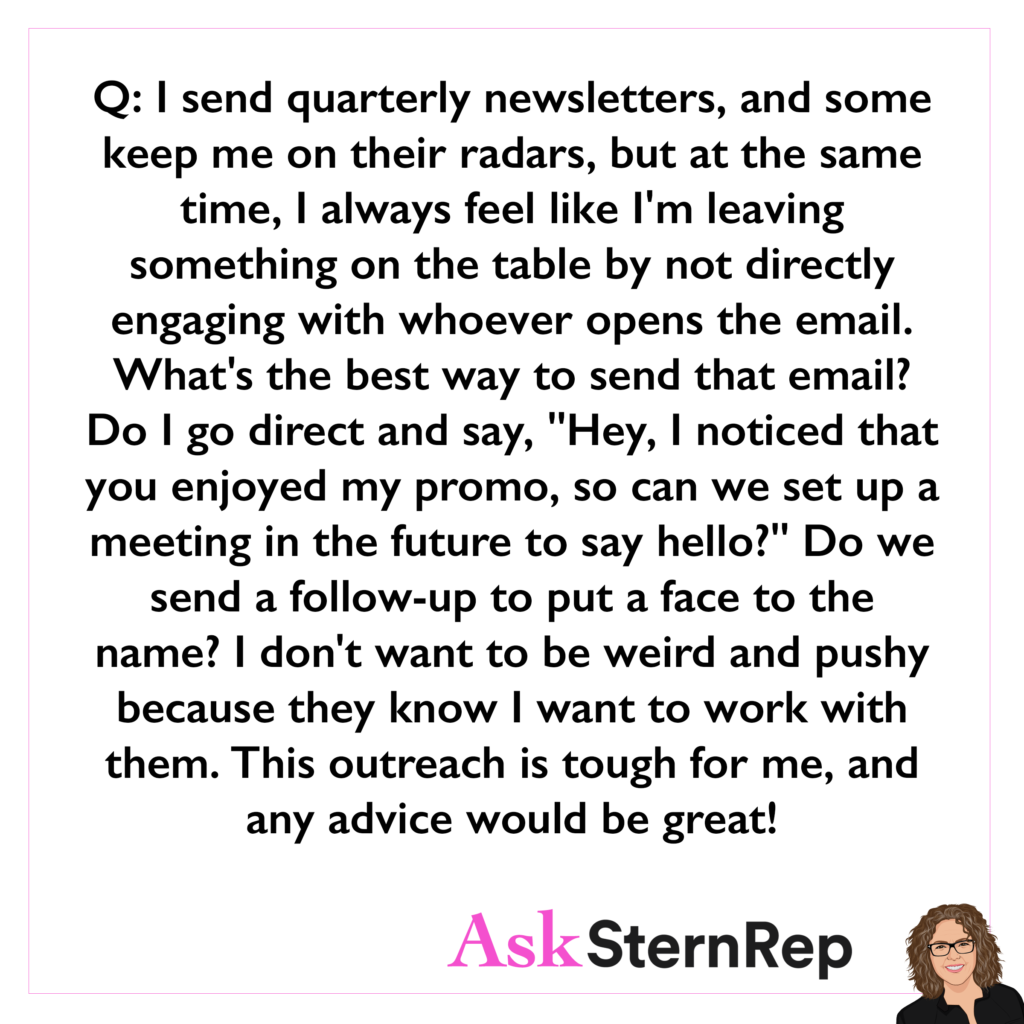
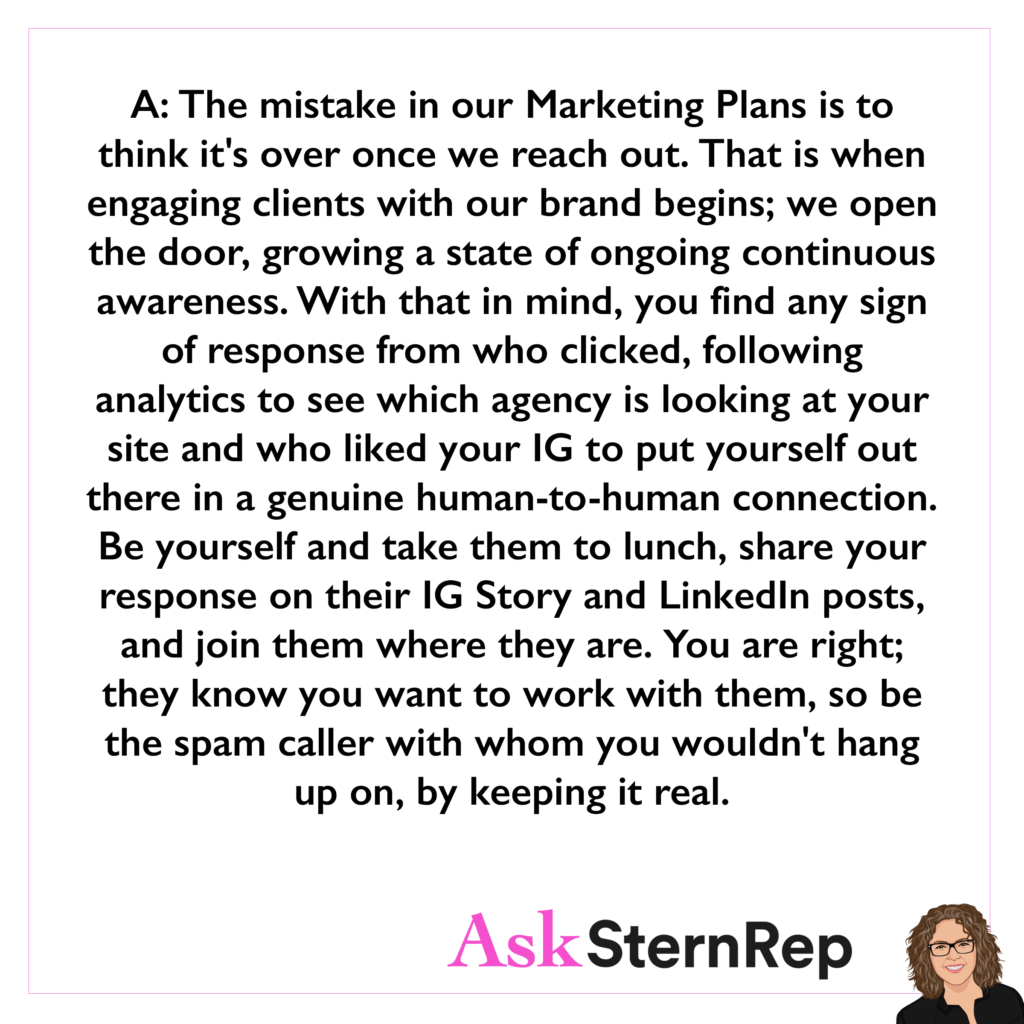
Q:
I send quarterly newsletters, and some keep me on their radars, but at the same time, I always feel like I’m leaving something on the table by not directly engaging with whoever opens the email. What’s the best way to send that email? Do I go direct and say, “Hey, I noticed that you enjoyed my promo, so can we set up a meeting in the future to say hello?” Do we send a follow-up to put a face to the name? I don’t want to be weird and pushy because they know I want to work with them. This outreach is tough for me, and any advice would be great!
A:
The mistake in our Marketing Plans is to think it’s over once we reach out. That is when engaging clients with our brand begins; we open the door, growing a state of ongoing continuous awareness. With that in mind, you find any sign of response from who clicked, following analytics to see which agency is looking at your site and who liked your IG to put yourself out there in a genuine human-to-human connection. Be yourself and take them to lunch, share your response on their IG Story and LinkedIn posts, and join them where they are. You are right; they know you want to work with them, so be the spam caller with whom you wouldn’t hang up on by keeping it real.
Benefits of Having a Rep Bid on Your Job
One benefit of having a rep bid on your job is this world of secret handshakes. It requires us to pick up on the right time to indirectly ask about pricing amounts + totals. I’m not sure why it goes down this way, but clients usually do not come out and tell us what needs to be changed to get the job. Reps get used to this negotiation system and can often find out information that is a bit hidden. I call it the “rep’s language.”
Having a rep on your side when bidding for a job can be incredibly helpful. I recently experienced this during a bidding situation on Zoom. Before speaking with the producer and photographer, they wanted to chat with me alone—almost like a secret language between us. They know that a rep will ask the right questions and uncover key details.
Clients often don’t feel comfortable directly saying, “We need you to be this much lower because we really want you to get the job,” especially in a triple-bid situation. The secrecy and indirect communication can be challenging. A rep understands this dynamic and can step in to ask the crucial questions, such as whether we need to adjust our bid by a specific amount.
Clients might not feel correct giving us all the information directly, but they are usually more open to a rep asking. It’s all about mastering this negotiation tactic—the “secret handshake” that a rep can expertly navigate. If you don’t have a rep, consider finding a temporary one. And if you do have one, make sure to appreciate their invaluable support.
Serious Client vs. Shopping Around
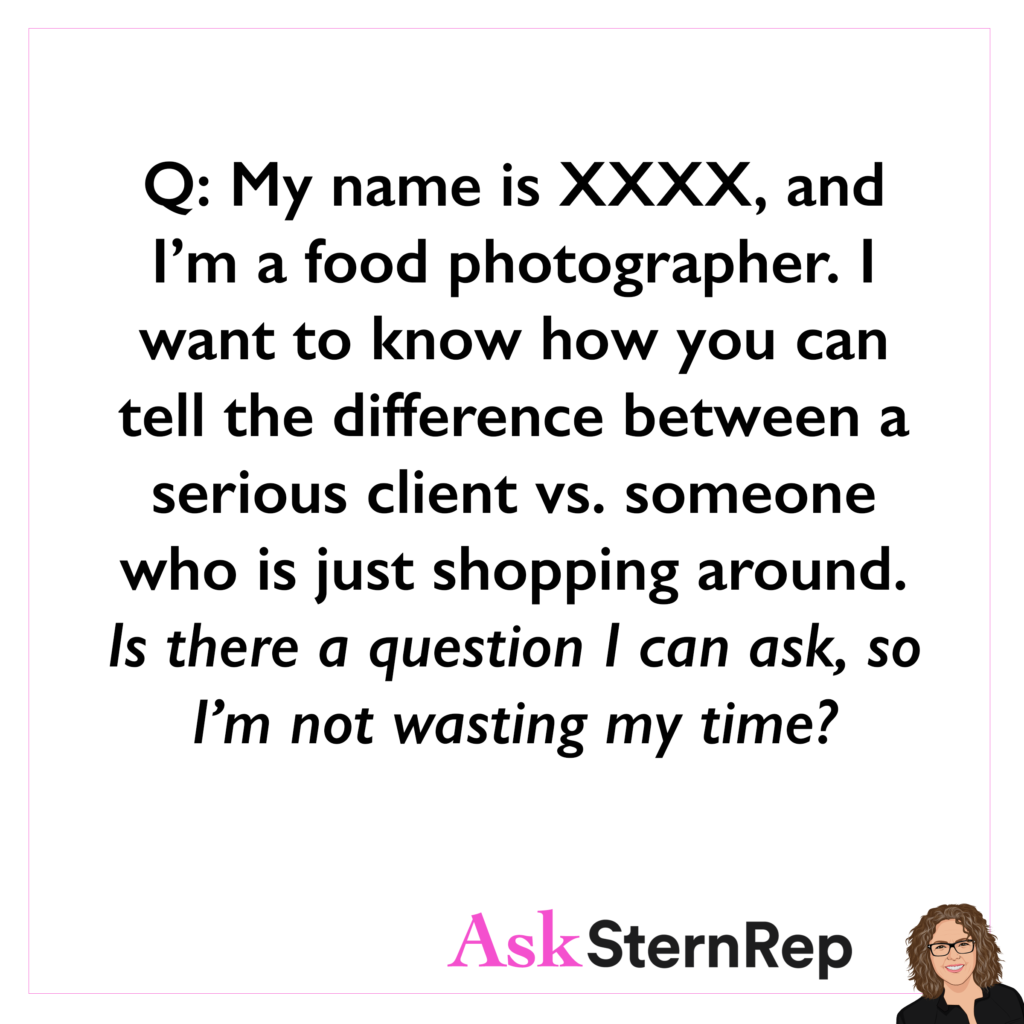

Q:
My name is XXXXXX, and I’m a food photographer. I want to know how you can tell the difference between a serious client vs. someone who is just shopping around. Is there a question I can ask, so I’m not just wasting my time?
A:
I have found this “shopping around” of low-budget clients happens mostly for food photographers found on Google. Start-ups without an ad agency or marketing team expect photographers to do the creative work for them, so it’s up to us to quickly find out if they can afford us. Normally we base our costs on the project’s information, but with these calls, I go in reverse and give them a budget range to see if we should continue in the mad sleuth process of digging into their shot list, backgrounds, surfaces, etc. My line is, “Sounds like a fun project that may run somewhere between 10k to 30k, depending on your shot list. Let me know when you have the specifics so I can run this by our food stylist to see how many images can happen per day.”
For more specific ideas addressing these types of “blind bid” requests, go to www.asksternrep.com – https://asksternrep.com/2022/01/19/dont-waste-time-doing-estimates-with-information-we-dont-have/
and this one – https://asksternrep.com/2021/12/22/is-this-estimate-request-worth-your-time/
When Your Business Is Off Track
You know when your business is not lining up and things are off track. Instead of throwing in the towel, look around for available support options. Reach out to those who can bring in a fresh new perspective, helping you see further beyond what you already know.
When business gets tough—when you’re bidding on jobs but not winning them, writing treatments that aren’t hitting the mark, or facing slow times with few emails coming in—you might feel disconnected from your clients or uncertain about who your dream clients are. It’s time to shake things up. Keep your business active by reaching out and exploring new perspectives if you want to stay relevant and fresh.
Change things up by considering hiring a consultant; you can find listings on sites like AskSternRep.com. You might also look for a new mentor, do some research on websites, or explore new ways to improve. For example, consider hiring an intern or experimenting with new email promo strategies. Look at new design features and shake things up. Use the slower times as an opportunity to enhance your business and make it even better.
Negotiating a Rep’s Percentage


Q:
Has there ever been a case of a photographer negotiating down their rep’s percentage? Does this simply lead to bad morale in the relationship? Is there a workable solution to this or might parting ways be the best option?
A:
Reps are negotiators, so there are workable solutions to commission percentages. “House” accounts are the standard norm for lower commission rates based on fair compromises. The one thing you don’t want to do is slow down your rep’s time/effort by removing financial gains. My answer is to determine the undercurrent issue – is this a teammate who brings a quality you need in your career trajectory? If not, well, that may be the answer.
Requests For Day Rates
Requests for nondescript day rate fees from unknown clients can be tricky. We don’t want to waste our time, but of course, we don’t want to push away potential clients.
My fast and easy way of handling this is to give them an immediate minimum to maximum price range, clarifying this is often our day rate range depending on shot count, usage, and types of shots.
This rate spectrum allows them to continue the conversation if their budget is close to our prices.
Day rate requests from unknown clients can be very tricky because we often lack crucial information about what they’re asking for. When they ask, “How much are you?” it can be challenging to provide a precise answer without knowing their needs.
Today, I responded by saying that the rate typically ranges from $5,000 to $12,000, but it really depends on factors like usage, the number of shots, and what we’re shooting. I made it clear that I’m available and invited them to let me know if they’re interested. This approach allows for further discussion without limiting the conversation. If their budget is, say, $4,000 or $4,500 and my photographer is interested in the project, we can still explore the possibility without being constrained by a fixed rate.
Raising Prices
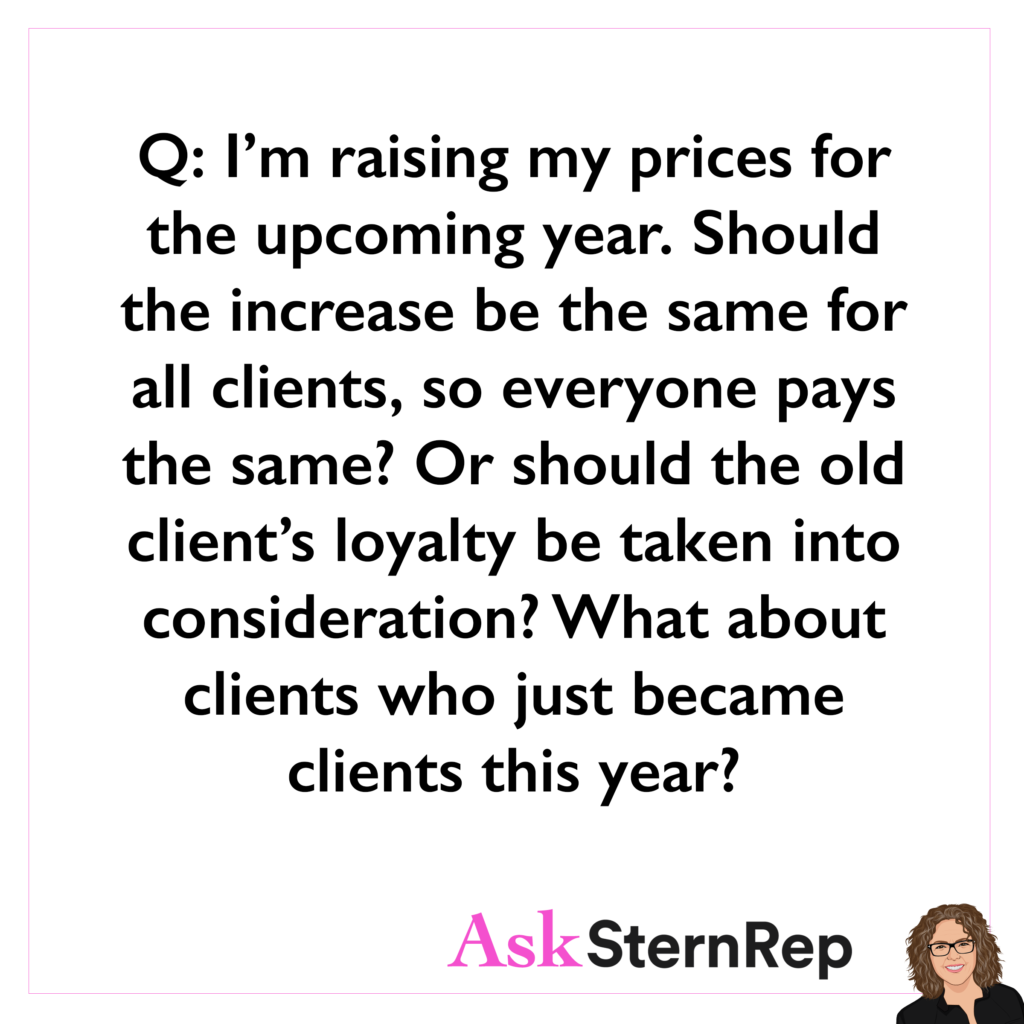
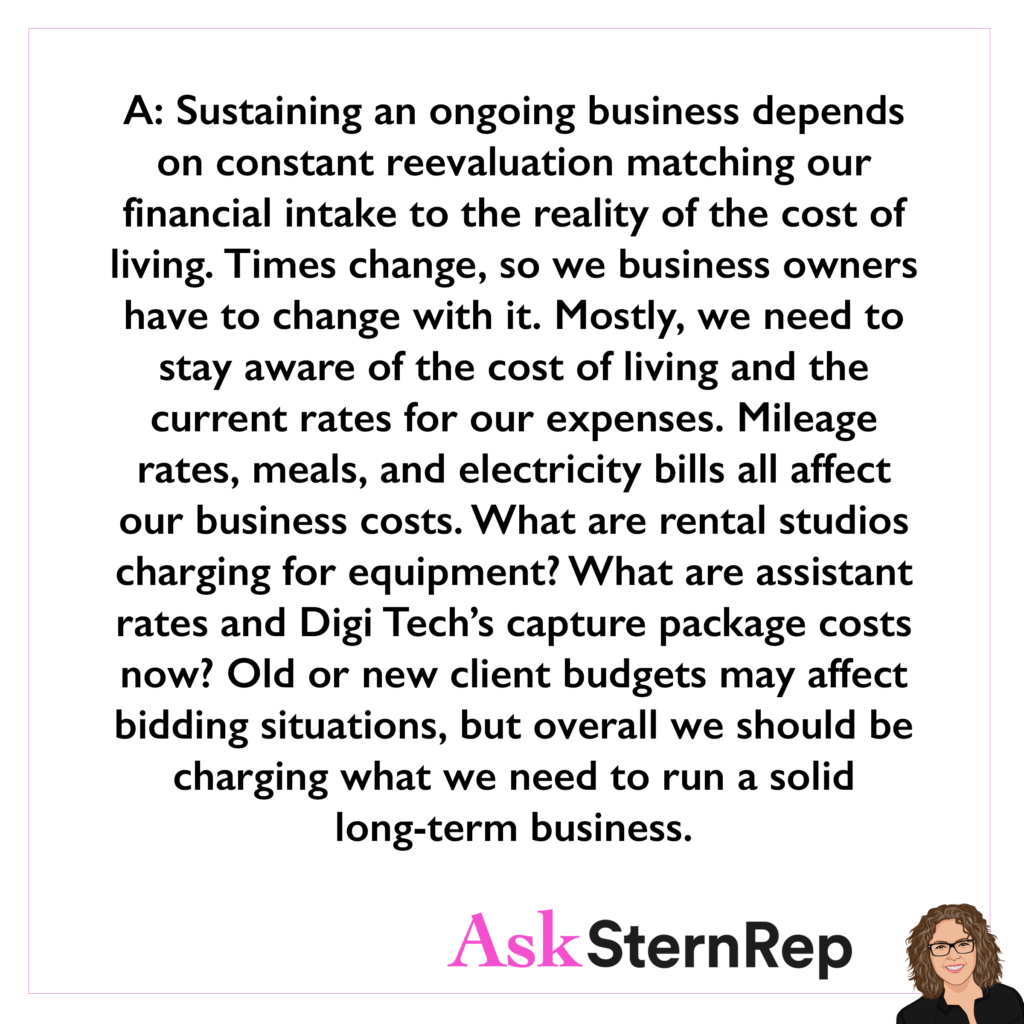
Q:
I’m raising my prices for the upcoming year. Should the increase be the same for all clients, so everyone pays the same? Or should the old client’s loyalty be taken into consideration? What about clients who just became clients this year?
A:
Sustaining an ongoing business depends on constant reevaluation matching our financial intake to the reality of the cost of living. Times change, so we business owners have to change with it. Mostly, we need to stay aware of the cost of living and the current rates for our expenses. Mileage rates, meals, and electricity bills all affect our business costs. What are rental studios charging for equipment? What are assistant rates and Digi Tech’s capture package costs now? Old or new client budgets may affect bidding situations, but overall we should be charging what we need to run a solid long-term business.
Marketing Misconception
A Marketing Misconception is to think of self-promotion material as needing to be new unseen work. Not true.
Self-promotion means utilizing your branded portfolio style to catch the attention of YOUR client market.
Create different groupings of themed images that fit together with a new catchy phrase that will inspire clients to dive deeper into your existing portfolio.
A marketing misconception that could be hindering us is the idea that we can only showcase new, recently shot, unseen images. That’s not true. Self-promotion is about utilizing the branded style of our portfolio to catch the attention of our target market.
So, how do we present images we’ve already shown? Consider introducing a new theme, category, or reframing the existing group of images. Perhaps you present them in a more editorial, artistic, or personal context than before. For example, you could organize them by seasons like summer or fall/winter to show old images in a new way.
Find a way to reframe what you’re showcasing because the goal of our marketing is to encourage clients to dive deeply into our existing portfolio—whether on our website or Instagram feed. Utilize what we already have to get them to explore further.
Non-Discussed Usages


Q:
After delivering agreed-upon images as a trade, the client wants to use them for other non-discussed usages. Is it too late to have them sign a contract?
A:
Any job without a contractual agreement will most likely lead to confusion because clients do not understand copyright and licensing image rights. I know the goal is to be casual and create a friendly relationship with clients, but if they love the images, this turns back on us making a miscommunicated mess. It’s never too late to offer them a contract, but the risk outweighs the gains of handling this after the fact. I recommend Blink Bid – https://blinkbid.com/commercial-photography/ or @blinkbid.
Overage Estimates
Overage estimates get us paid for any financial changes after the job amount is officially approved via signature or purchase order. Be careful not to approximately declare an overage amount until officially sending in the overage estimate for approval. This overage estimate requires approval of its own PO or a revised original PO reflecting the revised costs.
Protect yourself with an overage estimate. After bidding on a job and securing it, production begins, but the job might not have started yet. If the client makes changes, you need to provide an overage estimate.
Here’s a lesson I learned the hard way this morning: We made some changes, and I gave the client an immediate amount based on my initial thoughts. I should have waited to complete the full estimate process, as that’s when you consider additional details and costs. The client received approval from their ad agency based on the initial amount I provided, and I didn’t realize they would act on that before I finalized the estimate.
To avoid this situation, don’t provide a specific price immediately. Always present an overage estimate first to ensure you’re covered for any additional costs.
Legal Obligations to a Bid


Q:
When you submit a bid – are you legally locked into it?
A:
My answer to this is not from a lawyer but my own rep opinion: Why submit a bid if you don’t want to be locked into it? Perhaps you get busy and are offered a higher-paid job? Whatever the reason is, you would probably lose that client in the future if your availability changes after providing them the 1st hold. I say be honest and give them a 2nd hold if this is the issue. Be upfront if this is a client you want to keep. Once either of you signs a contract, you may have legal issues, so you can protect yourself by including the term – “Estimate is valid for 14 days from the date of issue.”
Getting Back On Track With Our Business
Getting back on track requires more than hopping back to where we were before. Fine-tuning the business tools*, making sure they are up to par, and matching the level of achievement we are setting our sights on. What we put into this is what we get out of it.
*See our Marketing Strategy Planner on AskSternRep.com
Setting our goals and understanding our intentions are crucial. We need to determine where we want to go and ensure that the path we are on aligns with our current objectives. To get back on track and move forward, we need to evaluate the tools that will help us reach our goals.
Assess the following:
- Website: Is it current and effective?
- Branding Identity: Does the branding, including the logo, still represent who you are and who you want to be?
- Social Media: How is your engagement on Instagram? What about LinkedIn?
- Lists and Email Promos: Are your lists and email campaigns performing well?
Conduct a comprehensive review of what you’re putting out there. Identify what’s working, what’s not, and what needs attention. Determine where you can get the necessary help and whether you’re working with the right designer. Assess your budget for these tools and resources.
By evaluating these areas, you can lay out a clear plan to get your business to where you want it to be.
Setting Goals to Stay Motivated


Q:
How do I set my goals when it feels like nothing is working out? I’m feeling discouraged as many of my email promos are bouncing, and things like portfolio reviews aren’t leading to anything. Do I quit? So much of this business is self-motivated that I feel lost and unsure how to have a clear sense of what to do.
A:
WE CAN’T BE GUIDED BY WHAT IS SET UP NOT TO GO OUR WAY. The odds are not on our side in this business. Standard triple bids set us up for failure, email promo open rates are under 20%, and clients barely respond. Career decisions come to play with strategic and well-mapped-out logical analysis. Break down the areas of this career that work for you, what brought you into this and gets you going, and then propel your future directional decisions off of that.
5 STEPS/WAYS TO IMPRESS A REP WITH YOUR WEBSITE
5 STEPS/WAYS TO IMPRESS A REP WITH YOUR WEBSITE
- BRANDING/identity – reveal the quick lowdown of WHAT YOU DO as we land on your site.
- DESIGN – placement and, size of images, overall spread cleanly mapped out with clear intention.
- SCROLLING – keep us active, getting busy as soon as we arrive so that we stay.
- SEARCHABILITY – consolidate your options into clear groupings inviting us to click deeper into a fine-tuned search.
- STATIC HEADER – reminding us who you are no matter where we go on your site.
Here are five steps to impress a rep with your website:
- Branding: Clearly communicate your identity right away. Your website should quickly convey who you are and what you do.
- Design: Use a top designer to ensure your site’s design is professional and well-executed. Pay attention to the placement and size of your images; it should be visually appealing and thoughtfully arranged.
- Scrolling: Make scrolling easy. Avoid requiring us to click or navigate complicated menus to see more content. Ensure the overview is straightforward and fast to access.
- Searchability: Make your site easy to search. Organize content into clear categories and groupings, allowing us to quickly find what we need and take action.
- About Page: Provide a concise, engaging overview of who you are on your About page. Reps want to get to know you quickly and efficiently.
Overall, ensure your website is fast, easy to navigate, and professionally designed. Reps judge websites quickly, so make sure yours stands out.
Video Motion Business

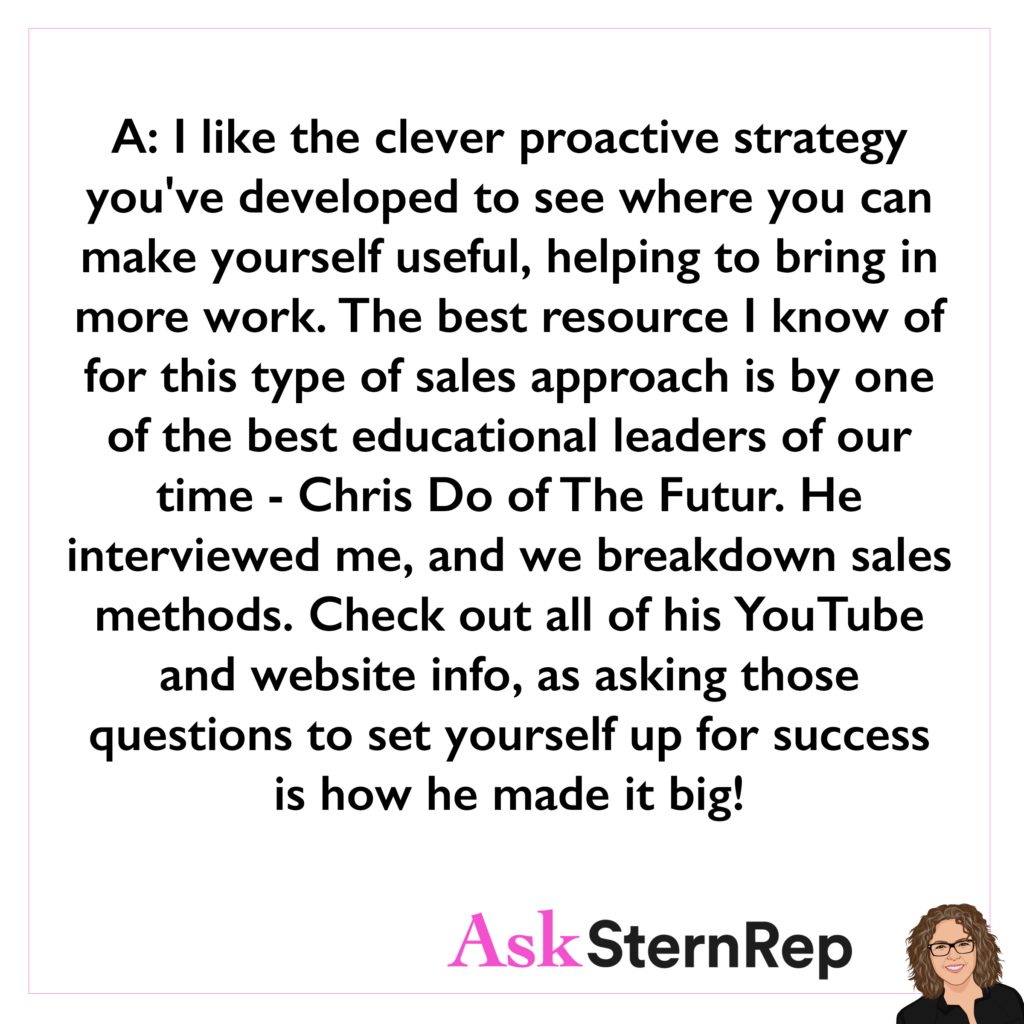
Q:
As I’ve entered the video motion business, I see how clients sometimes need help figuring out what they need. I’ve started asking them questions to help break down what they need and how I can help, Too often, I can’t get their answer, so I tend to make decisions for them. How do other people handle this? Any advice?
A:
I like the clever proactive strategy you’ve developed to see where you can make yourself useful, helping to bring in more work. The best resource I know of for this type of sales approach is by one of the best educational leaders of our time – Chris Do if the Futur. He interviewed me, and we breakdown sales methods. Check out all of his YouTube and website info, as asking those questions to set yourself up for success is how he made it big!
Yin and Yang of Creative Business
Success as a Creative Business requires a simultaneous balance of our daily work mode coexisting with our recharged creative tank. It takes both of these parts of our business, yin and yang, working together to set ourselves up for true long-term satisfaction.
Success in a creative business hinges on the fundamental balance between taking action and replenishing your creative energy. We’re in this for the long haul, not just for short-term gains. It’s essential to honor our creative needs by taking time to recharge.
Enjoy your breaks and use this time to fill up your creative tank. While you’ll return to work after the holidays, taking this time off is crucial for maintaining your long-term creative goals. Remember, replenishing your energy now is an investment in achieving the success you’re aiming for.
When Work is Slow
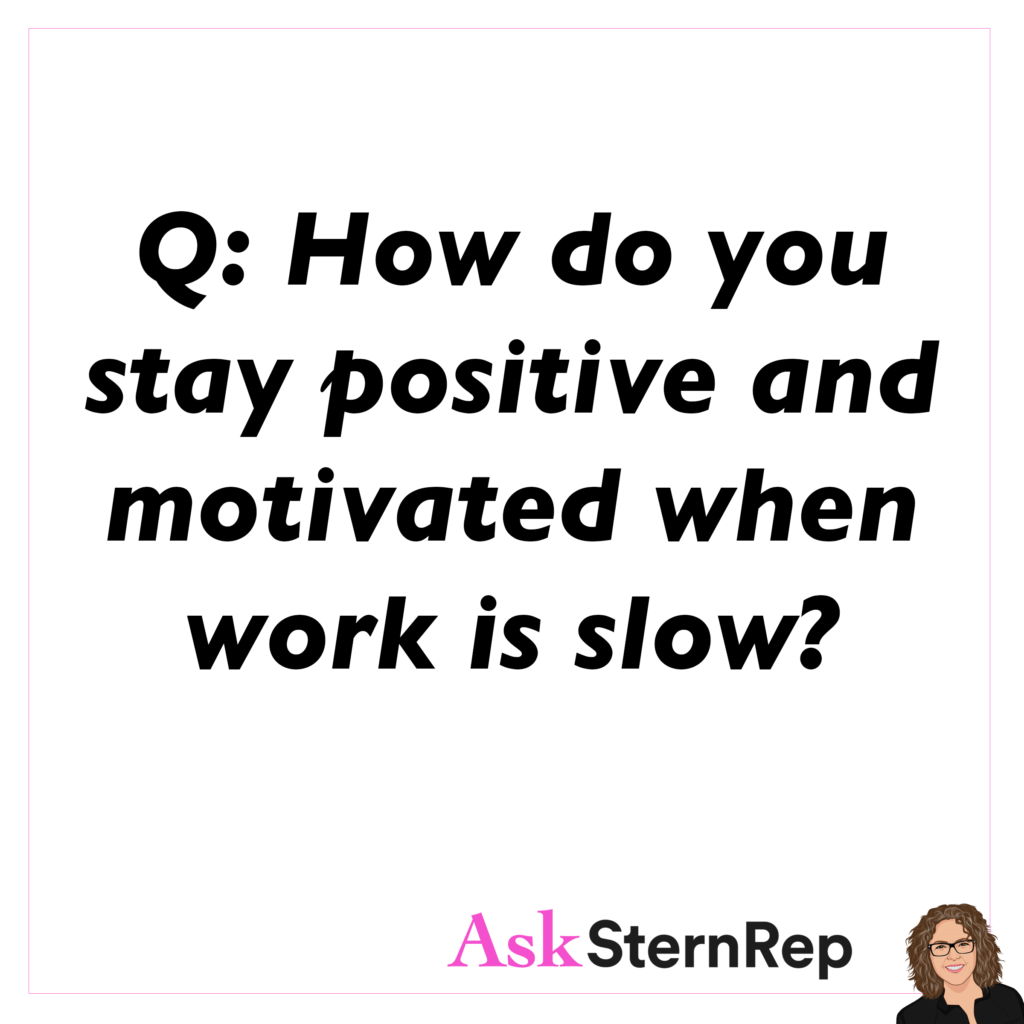

Q:
How do you stay positive and motivated when work is slow?
A:
When incoming requests slow down, I keep my attitude in check by shaking up my routine norm. One way I give myself a recharge buzz is by connecting to genuinely close clients I haven’t talked to in a while with a good old-fashioned personal phone call. I ask them questions about our changing industry to help educate myself from their perspective. Knowledge and ideas keep me motivated, providing me with more action plans.
An Email Promo Mistake
#1 mistake with email promos is thinking clients will take the extra step to see more.
Our human tendency is to rush to delete emails. It almost brings us joy to delete. Don’t fall into this trap by wasting the top of your email with space or your logo. Immediately show the goods, making your point even if it’s deleted without a scroll to see more.
The number one mistake with email promos is assuming that clients will scroll past the big logo at the top. Instead, place the main content—the meat and potatoes—of your email promo right at the top.
The goal is to make your email fast, straightforward, and engaging. People tend to delete emails quickly to clear their inbox, so make sure your key message is visible immediately. Capture their attention right away to encourage them to scroll down and see more.
After a Campaign Shoot


Q:
Hi Andrea, how do you charge clients after a campaign shoot, after they made the agreed amount of selects, they ask for additional images with no edits for them to have extra content for product pages, emails, etc? Thank you!
A:
This is your golden opportunity to create some package deal options for them to buy more image usage.
Improve Your Odds to Get The Job: Expert Insights on Temp Repping for Commercial Photographers

Photographers in the commercial advertising industry can face complex unmapped territory, especially when invited by a client to submit a bid to get a job. Photographer’s agents are the trusted resource supervising every step of the bidding process to ensure it goes smoothly, helping land the job. Finding a rep to help with bidding negotiation can get tricky; we here at AskSternRep are all about demystifying the photography business, so our team sat down with our founder and photographer’s representative of SternRep, Andrea Stern, for a Q&A on Freelance Temporary Representation.
AskSternRep Team: Let’s start with the basics: what IS Temp Repping, and how is it priced?
Andrea Stern: “Temp Rep” is how I join forces with un-repped photographers on a per-project or per-client basis when they want a rep’s help on their bid request, image licensing rights, copyright ownership, reuse, or renewal fees. Whether a photographer only needs me behind the scenes for advice or wants me to be their voice communicating the negotiation with the client, I bring my 100% dedication to treating each case with my utmost attention.
Temporary Representation is how I jump in to be on the photographer’s side wherever they need it. I’ll oversee the bidding process, assessing our needs to get this job. Do you have the right producer, or will we create the bid for you to produce your job? Are we getting all the correct information from the client to support an accurate estimate? Are your bid terms clear and set up to protect you on this specific production? Let’s make the best of the creative call and your treatment without leaving any money on the table when we land this job.
I charge a commission on the photographer’s fees between 15 – 25% only if we get the job. No charge if we don’t get the job; I get paid if you get paid.
ASR: How and why did you start offering Temp Repping?
Andrea Stern: Temp Repping created itself in 2015 when photographers who knew me started reaching out, needing a freelance rep as they didn’t want to negotiate jobs independently. At the same time, it worked on both ends of the business as client-direct brands and producers started reaching out with mass searches for photographers for a specific project. When I could be helpful on both sides, it was easy to do what I enjoy most no matter what the configuration looked like – I rep photographers to help them get the job. The commercial advertising business started shifting this way, where broader doors were opening, making it easier for un-repped photographers to get their foot in the door.

ASR: How often do you Temp Rep for photographers?
Andrea Stern: Over the years, it’s become a regular recurring position as many photographers can use a rep temporarily. These mainly happen not on a one-time basis but more of an ongoing relationship we are building. It’s a great way to get to know the specifics of each photographer and how they work.
I have worked with over 100 un-repped photographers bidding with clients, including Magnolia Bakery, Sonic Drive-In, Audi, HGTV, Chevy, Merrell, NFL, Adidas, ESPN, Sunbrella, DirectTV, Jack Daniels, State Farm, Delta, Pacifico, HP, Lexus, Target, Disney, Purina, Airbnb, Priceline, Timberland, Darigold, Chase Bank, Bosch, Duluth Trading Co, and Title Nine.
ASR: How does a photographer know they need a Temp Rep? How is it helpful?
Andrea Stern: Almost every job I bid on with my photographers involves a team, as that is how our business works. When bidding on a project that feels over a photographer’s head regarding ease, communication, finances, and production, they should always involve support. Clients may get nervous if it’s a more significant production and the photographer is on their own.
The benefits of having an agent represent a photographer in our commercial advertising industry are endless if you can trust the Rep you are working with. A representative offers solid protection on the bidding process by overseeing terms, treatment editing, etc., and will get them paid fairly. It astonishes me that every photographer wouldn’t seek a rep’s help on every bid.
ASR: What criteria can help photographers decide if they need to get a rep involved when asked to bid on a job?
Andrea Stern: When a photographer is asked to bid on a job, the first thought should be to consider whether they should bring in a rep. If they’re unsure whether it’s worth it to bring in an agent, some great questions photographers can ask themselves are:
- Do you feel comfortable/confident doing this alone?
- How big is this job? Is there a high enough budget for this project to pay a rep 15%, 20%, or 25% of your fee?
- Will a rep’s support make you an even stronger candidate to be awarded this job?
ASR: How does the process begin, and when should the Rep be looped in with the client?
Andrea Stern: When you receive a bid request, you should first decide if you want a rep to work with you on it before even responding. If we are representing you, we should be there from the start, as it’s well worth our commission to warm up the relationship with the client from the get-go. The more seamless the bidding process communication will be as soon as you get the agent involved.
ASR: Does being repped when bidding on a job influence an advertising agency’s opinion on how they will respect working with that photographer? Or does a rep sometimes freak out a client, signaling they will be more expensive to work with?
Andrea Stern: Clients familiar with reps are the ad agencies, and clients who tend to be unfamiliar with agents are smaller client brands with in-house marketing. I’ve seen how the type of client can affect the bidding process, so this goes into our team planning strategy before we move forward. Not to boast, but I haven’t met a client I can’t warm up quickly. I accept this challenge as one of my skill sets, where I begin with a soft and personal tone breaking that age-old harsh reputation that agents can have. However we approach this, it is a discussion where we consider the pros and cons, coming up with our game plan together.
ASR: Is there a “bid minimum” you like to have in mind when entering a temp rep engagement? (For example, should a job prospectively be at least 10/20/30K to interest you in offering your services?)
Andrea Stern: Generally, budget is not my deciding factor as to who I will Temp Rep; it is more about the type of industry. I’m unfamiliar with editorial, fashion, publication, or photojournalism rates, so I would not feel as helpful as I do with commercial advertising projects, so I stick with those.
ASR: Is there a limit to the jobs you would Temp Rep for one photographer?
Andrea Stern: No, the more times I work with a photographer, the better. I become more comfortable the more we work together. I base a lot of my negotiation on how that photographer works, so getting to know them more only helps me give more to each project.
ASR: Can a Temp Rep situation lead to joining a rep’s roster?
Andrea Stern: Yes! A couple of my Temp Repping situations have turned into full-time repping. Vinnie Finn, for example, started that way. Vinnie called me to help bid on a wine project in Sonoma County and several long-term projects after that. We had a great thing together; the longer we worked together, the more we knew we could do even better by joining forces full-time.
A Temp Rep situation can lead to an official rep engagement – so if a photographer is looking to get a rep, this can be a perfect way to get to know each other.
My suggestion for un-repped photographers is to research reps who match their style and type of clientele, ask around and do your due diligence to create a short list of reps who may be right for you. Get to know each other as we all have unique ways of working; get a rep who speaks accurately for you, even during a stressful job situation.
It’s a big commitment, and I’ve seen photographers regret signing on with reps; don’t rush the process, and make sure you get to know them first.
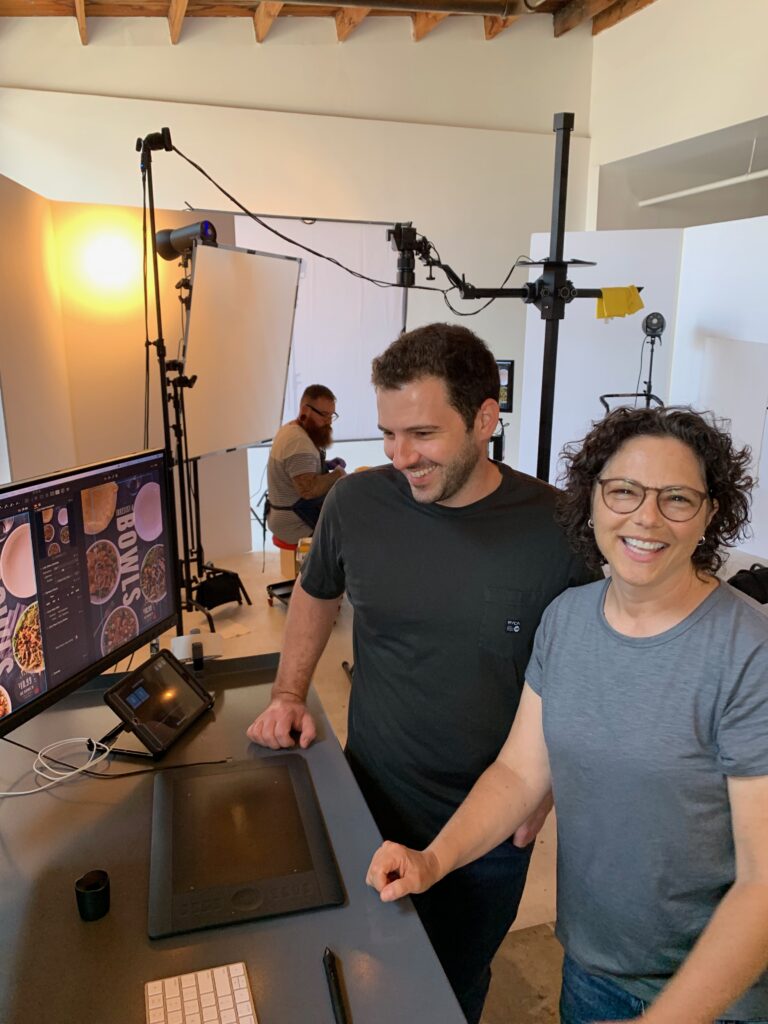
ASR: Why would a rep want to take on a Temp Rep job with a photographer?
Andrea Stern: Well, not to sound crass, but we are business minded and here to make money. We have what it takes, so why not put our skillset into action with the right opportunities? A rep does have a reputation to consider, so we want to represent those who will build our clientele and not damage our brand. We do have to be careful as our name goes into these temporary situations, and our company depends on building relationships. After the checks and balances, we will enjoy the opportunity if we can make money with you.
ASR: What do you enjoy most about Temp Repping?
Andrea Stern: The best part of my job is the relationships I create. If I can be helpful to get a photographer paid and well taken care of, then I’m all in. I enjoy selling the photographer with my moment-to-moment negotiation process, looking for ways to solidify the photographer’s relationship with the client. There’s a genuine advocacy to all of this, which is the most enjoyable part about repping- the confidence, belief, and cheering for talented photographers.
ASR: Any success stories you can share?
Andrea Stern: A photographer I have temporarily represented on a regular basis since 2017 has me listed as the agent to contact directly for incoming requests on their website. I am trusted without much back and forth to make decisions as they know I will get the best done for them. It’s a nice way to work, Temporary Repping but based on a solid long-term relationship.

We were in a situation where a company used two images after the usage rights expired. The client needed to be financially penalized for that unowned usage term and then wanted to extend the usage for three more years. This negotiation was a situation I could get the photographer paid more than they were expecting, which was extremely satisfying to make a successful renewal deal with one of our highest financial payoffs.
I knew I could start with a high rate, as the client wanted to avoid getting into a legal battle for their illegal photography usage rights. We got $140,000 for the two images for (3) years of packaging, social media, print, OOH, and in-store usage. It was fun to shock the photographer with that payment amount and feel that sense of success, but success is much more than that.
This long-term relationship with the photographer stands out to me as a real success because they permitted me to speak freely on their behalf, getting them compensated to the best of my ability. It’s nice to have that trust with photographers who use me as their Temporary Rep, but it doesn’t feel temporary.
Interested in temp-repping with Andrea?
Get in touch! Andrea@SternRep.com
Photographers Are The Package Deal
Photographers are the package deal of stills/video/motion.
All are one and the same, treating each with equal importance as we raise our area of expertise to fulfill our client’s needs.
Being a photographer no longer means just focusing on stills. You need to keep up with the times, which includes incorporating video and motion into your work. This means creating GIFs, cinemagraphs, and having a reel as a director, whether you shoot it yourself or have a team help you. Your reel is as crucial as your website portfolio.
Both your website and reel need to be showcased on your Instagram as well. Video should be a strong element of your Instagram presence. If you don’t take video and motion seriously, it could significantly impact your career. So, get on it and stay ahead.
Finding an Up-and-Coming Rep to Grow With

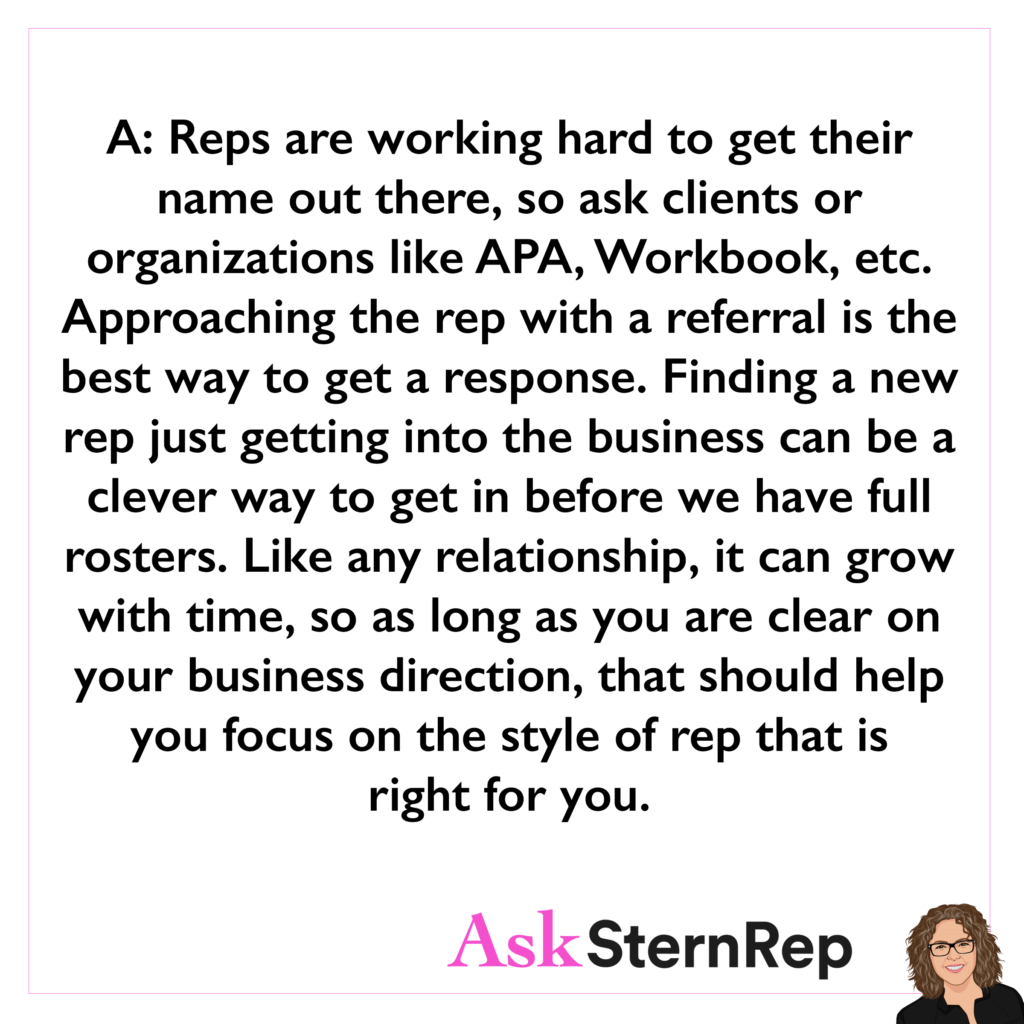
Q:
I have myself listed with a couple of agent services, but I’d like to be repped full-time for more outreach efforts. Is there a way to find an up-and-coming rep to grow together with? How does one approach a rep?
A:
Reps are working hard to get their name out there, so ask clients or organizations like APA, Workbook, etc. Approaching the rep with a referral is the best way to get a response. Finding a new rep just getting into the business can be a clever way to get in before we have full rosters. Like any relationship, it can grow with time, so as long as you are clear on your business direction, that should help you focus on the style of rep that is right for you.
Long Lasting Career
Photographers, if you are like me, you want this career to last long and not be a one-trick pony blip on your path.
As important as your work may seem, that fades. Bring the deeply satisfying joy into your career now; that is the road to stay on.
I have a personal insight to share with you, and maybe you can relate. The more I’ve been in this job—over 25 years now—the more I realize how much I love it and how passionate I am about being a rep, both in this role and in social media. However, as I grow older, I also see that life is bigger than just my job and career. Other things in life are more significant.
So, how do I navigate this? I find that by continually shifting my career to include what I love—like working with certain photographers, building meaningful client relationships, and engaging with you—I feed my passion and maintain my excitement. If I didn’t truly love it, I don’t think I could keep doing it. My advice is to keep loving what you do and direct your career in a way that allows you to stay passionate about it.
Comparing Yourself To Others

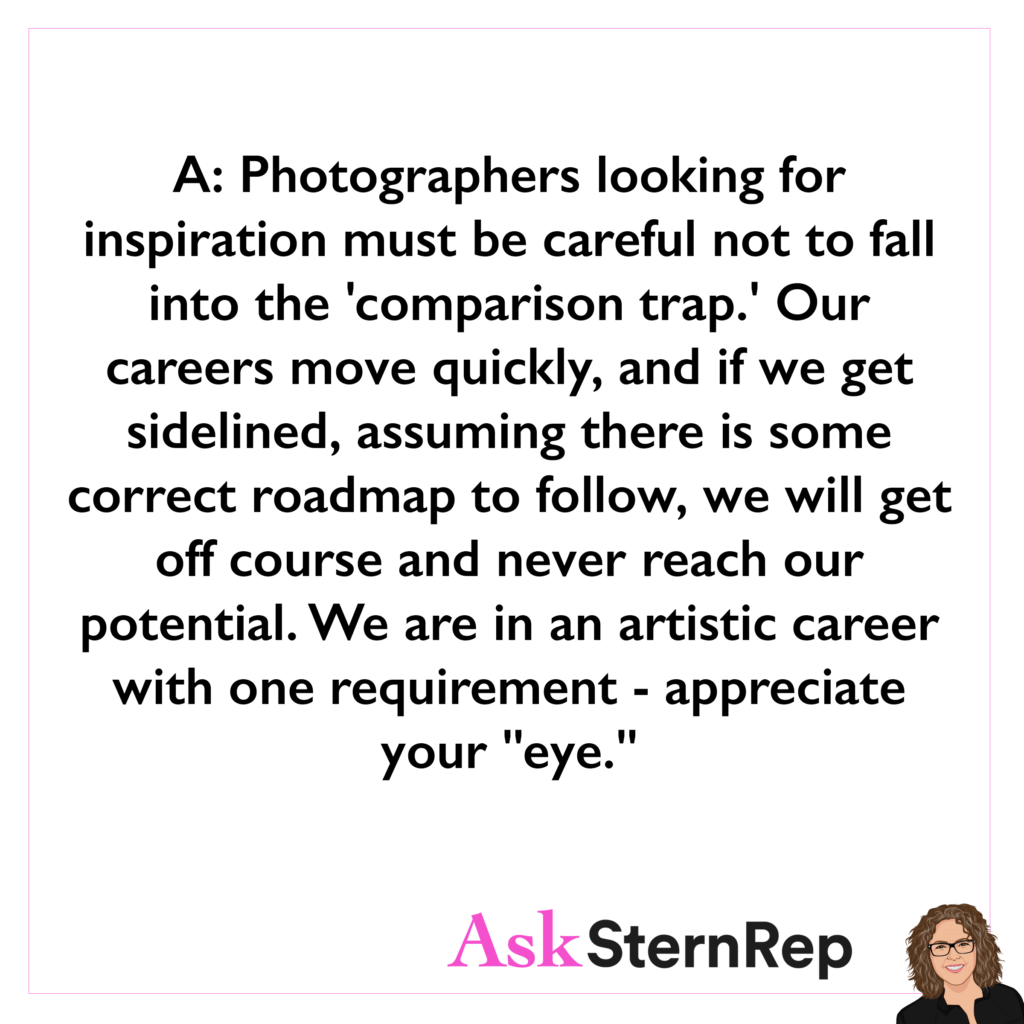
Q:
How can a photographer get out of the loop of comparing themselves to others and their careers?
A:
Photographers looking for inspiration must be careful not to fall into the ‘comparison trap.’ Our careers move quickly, and if we get sidelined, assuming there is some correct roadmap to follow, we will get off course and never reach our potential. We are in an artistic career with one requirement – appreciate your “eye.”
Thanksgiving Holiday Assignment
Thanksgiving Holiday Assignment:
- List 5 ways your business is right on track.
- List 5 areas where your business needs your attention.
Ready For Artist Representation


Q:
I know I’m ready for artist representation, but unsure where to find one. Should I go to Lebook and meet folks (if so, should I only attend the ones in the markets I want to work in)? Word of mouth/asking friends?
A:
The long-term commitment of a rep is not something to settle for a person you happen to run into but should be a well-researched exploration matching your goals with that rep’s overall focus. Personal introductions are extremely helpful but remember, this decision cannot be based on desperation and should be made with confident assurance that your value will increase with the right representation.
Ageism is NOT About AGE
Ageism is Not about AGE.
Ageism is any age photographer who gets tired, stops pushing the boundaries, and stops testing and exploring.
Younger photographers don’t own the exciting, hot, trending markets, but they often seem more available to lean into newness with an open mind.
Signed to Two Agencies at the Same Time


Q:
I am a photographer that is currently signed to an agency, the contract is nearing completion, and they have asked if I want to renew the contract. Another agency has expressed interest in signing me at the same time. Is it possible to be signed to multiple agencies as a photographer/director?
A:
No absolute rule on this, but it isn’t something I recommend for a commercial advertising photographer/director. Other industries may work like this, but clients in our world would be confused. Our goal is to have our clients know, think of, and contact us. If we offer too many contact associations, we may create more of a branding identity mishap vs. a sharp, concise system to register in their memory.
Freelancing and Feedback
Being freelancers doesn’t mean we have to do this alone, protecting ourselves from our competition.
The defensive stance of guarding our experiences blocks the one source of spot-on bona fide feedback.
Spam Filters
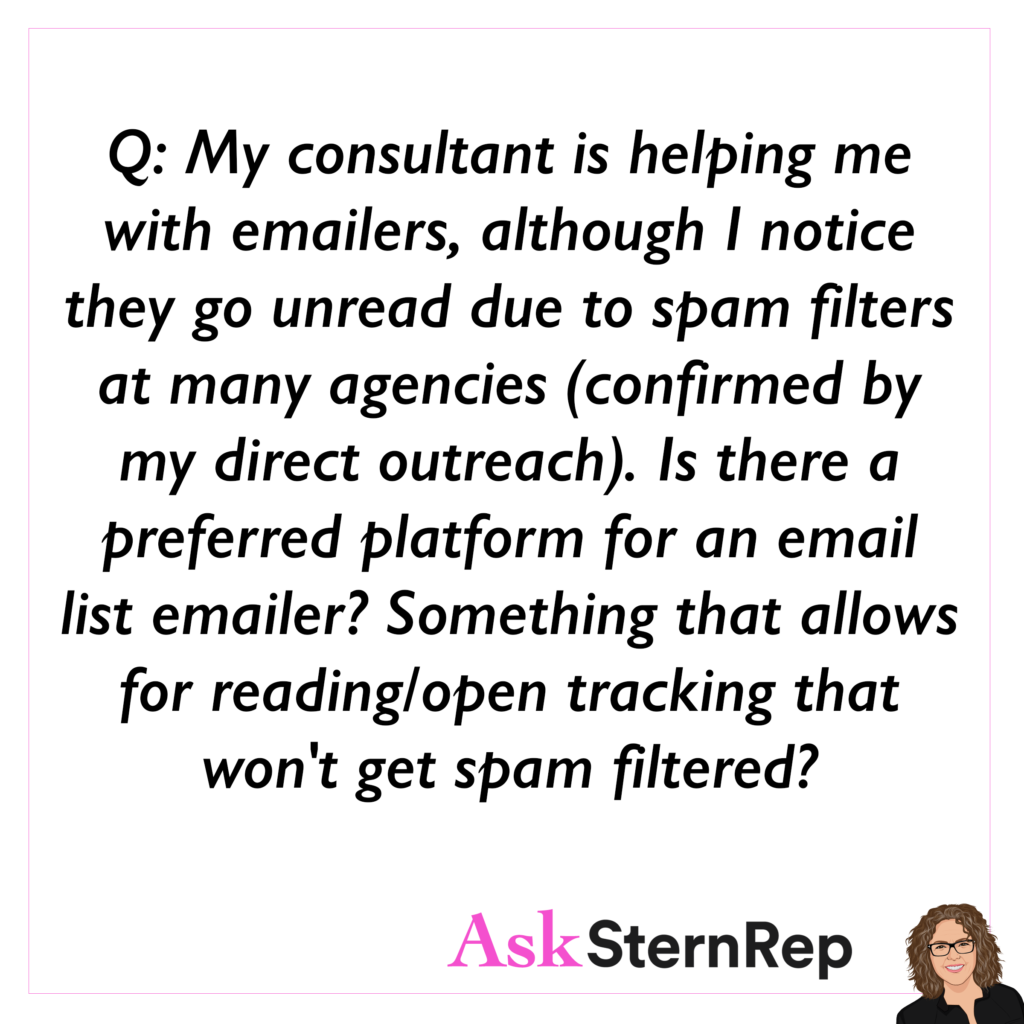

Q:
My consultant is helping me with emailers, although I notice they go unread due to spam filters at many agencies (confirmed by my direct outreach). Is there a preferred platform for an email list emailer? Something that allows for reading/open tracking that won’t get spam filtered?
A:
Every client has a different email guarded system that we can’t control. Clients tend to move around from company to company so often that we must constantly revise our lists. The one solution I go for is to get as many approved emails and try to send them in a multitude of ways. I’ll do just an email for anyone to open and click. Next to IG, monitoring this system is the 2nd best way to be seen by the most people in one day. If we stay on this as regularly as possible, along with our IG engagement, we can cover a lot of ground, even if the results look insignificant.
Impress Your Clients and Crew
Put this in our business toolkit:
In the midst of crazy production, the human element cuts right through it and can speak volumes. Impress our crew + clients with sincere kindness during stressful intensity to make the best of it and create a lasting impression.
Image Licensing Rights With No Contract


Question:
My long-time restaurant client plans to publish a cocktail book showcasing their cocktail recipes, all of which I have shot. She asked me about image licensing rights because I was so green when this started and did not send them contracts (I know, big fail). Ideally, I would like to send her a new contract for the images she’d like to use in the cocktail book, and I was wondering if this was the best course of action.
Answer:
The root of the issue with no contracts is how you and the client were both green. Uncontracted clients may assume they own the copyright without needing your usage approvals. The overall solution is to follow up with all uncontracted clients before an issue arises, verifying your image ownership and assuming usage rights. Talk to your clients, make this a two-way conversation asking what they’d like to use the images for in the future and become part of their long-term solution… for a price, of course.
Bidding A Job Means Accurate Prices
Bidding a job means accurate prices, but who is to say what is accurate?
Numbers are only accurate if both parties understand the basis of each cost. If one item’s price depends on another item’s cost or a specific aspect of the shoot is changed, make it clear before it screws up your pricing.
Remember, expect clients to make changes after you submit your bid. Define each line item’s price clearly as an estimate cannot have too much information. Cover yourself!
Clients Not Paying to Retouch Work
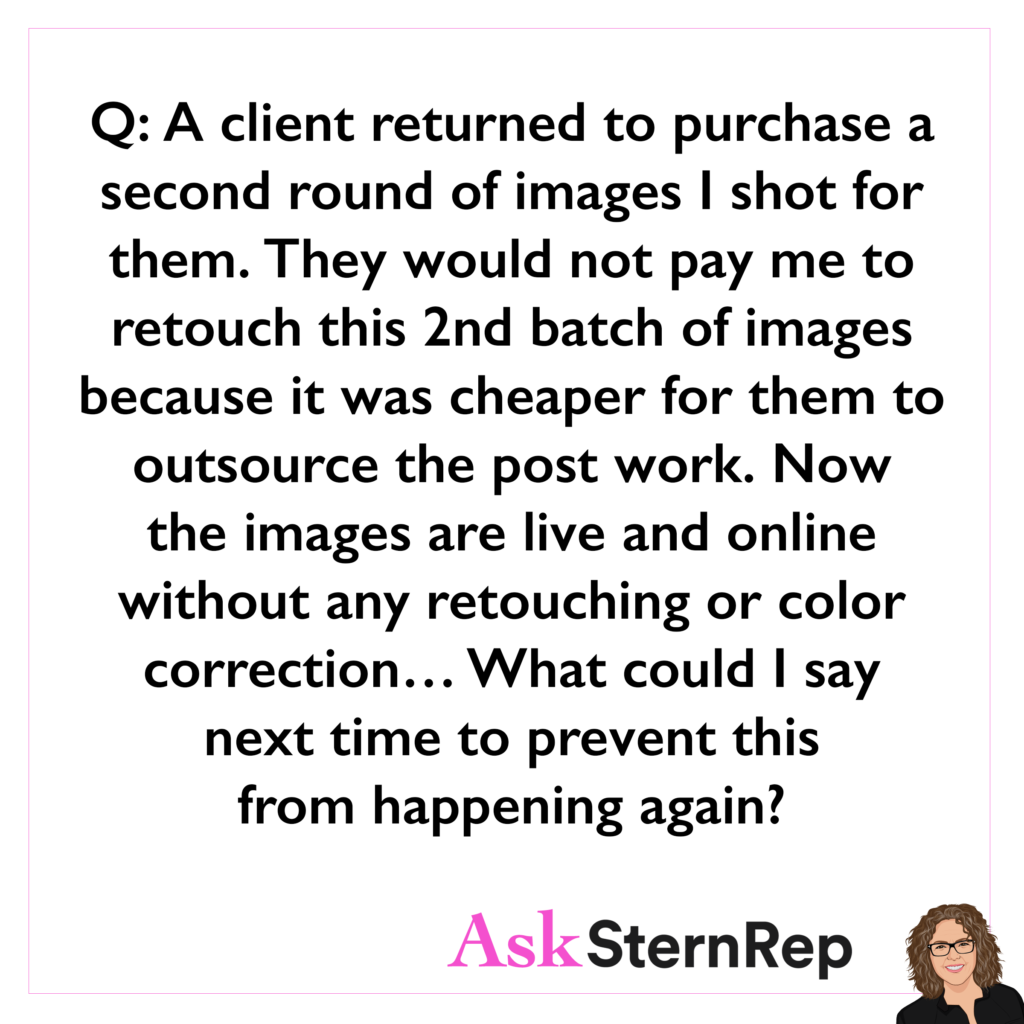

Q:
A client returned to purchase a second round of images I shot for them. They would not pay me to retouch this 2nd batch of images because it was cheaper for them to outsource the post work. Now the images are live and online without any retouching or color correction… What could I say next time to prevent this from happening again?
A:
I don’t mean to be harsh, but the only thing you can do about this is offer cheaper retouching or request that your name not be associated with the images. Depending on their contractual terms, you can retouch them your way and show them off on your site and IG. Other than that, they have full rights to retouch/crop/manipulate the images you shot any way they choose.
Bidding and Negotiating is an Opportunity
You are up for a job. Bidding and negotiating is the open door opportunity to get the client to understand how you are best for this project based on your approach. Our challenge is to align our ideas to match what they are going for. I see it like a maze of gated doorways as we look to follow the one that opens. Throw out your ideas and see what sticks with a question format allowing them a chance to redirect your ideas toward their goal.
Motion and Stills

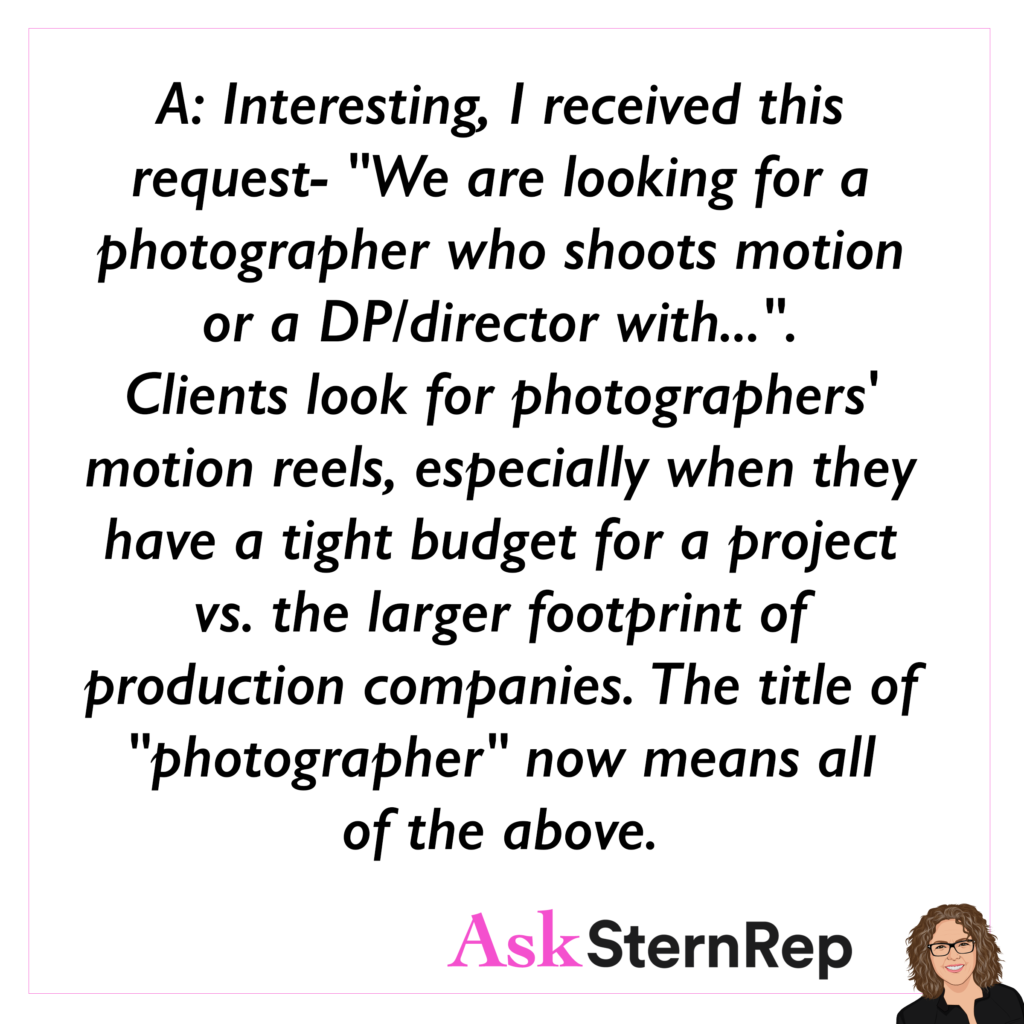
Q:
Along with shooting stills, does it make sense to create a short 15-45 second motion spec for a product? Would that take away the title of “photographer” from us?
A:
Interesting, I received this request- “We are looking for a photographer who shoots motion or a DP/director with…”. Clients look for photographers’ motion reels, especially when they have a tight budget for a project vs. the larger footprint of production companies. The title of “photographer” now means all of the above.
How To Create An Effective Photography Portfolio That Gets Jobs in 2022
The importance of a photographer’s portfolio cannot be overstated. A strong portfolio is the number one way to get hired in commercial photography. I hate to say it, but even a photographer with a terrible rep can still get work with a great portfolio.
Marketing has so many parts to it, but your portfolio will get you the job or not get you the job. We talk about treatments and creative calls; everything we do is essential, but they’re supplemental to your portfolio. That’s what is going to make or break you. It’s the portfolio. It’s everything.
Your portfolio should not just be the jobs you have already photographed; it should include the jobs you want to be photographing.

What is a Portfolio?
Nowadays, a photographer’s portfolio can be seen in many ways – on a website, in a physical book, on an iPad, and Instagram + TikTok. A portfolio should showcase your best work – either for a client or self-assigned.
Three things clients look for in a portfolio:
- The seamless message of your style with a purpose.
- An emotional story, the audience is pulled into feeling, striking a chord with their brand’s message.
- The reassurance that their customers feel this emotion if they hire you.

What Goes into Shaping a Portfolio
Quick Tip: Focus specifically on the client/industry you most want to be working with and shape your portfolio around that market. Start with one area and master it. Then you can expand and grow.
1. PORTFOLIO RESEARCH
Industry education and research will help you master the “objective” eye, giving you the skills to edit your work. Familiarize yourself with photographers doing the kind of work you want to make, especially those doing it on a high level. Study them. Understand the difference between a cohesive portfolio with a clear through-line and those with many different styles. Identify your visual instincts and apply them every time you shoot. Learn to become objective in your opinions to be the best judge of your work.
2. CHOOSE THE STYLE
The constant honing-in and forward growth of what your style is about will bring you the control clients can depend on. Clients are always on the hunt for photographers shooting similar vibes as the message their company is portraying. If they are a tech company, they will want to see life scenes created around tech equipment, or a food client will want to see life happening around similar food environments. Build your portfolio showing the look and feel your ideal clients cater to by using “spec” concepts to grab their attention.
3. ATTITUDE (TESTING)
Owning who you are and finding ways to express it allows clients to know what they get by hiring you. Never underestimate the power of self-assigned projects. Integrating work into your portfolio conceptualized and executed by you is one of the most pivotal ways to expand your photography business into new ventures.
Consultants can be game changers because they know the business and how to shape your website/portfolio to fit the current market. When you aren’t hearing back often from clients, give a consultant a try and see what they have to say.
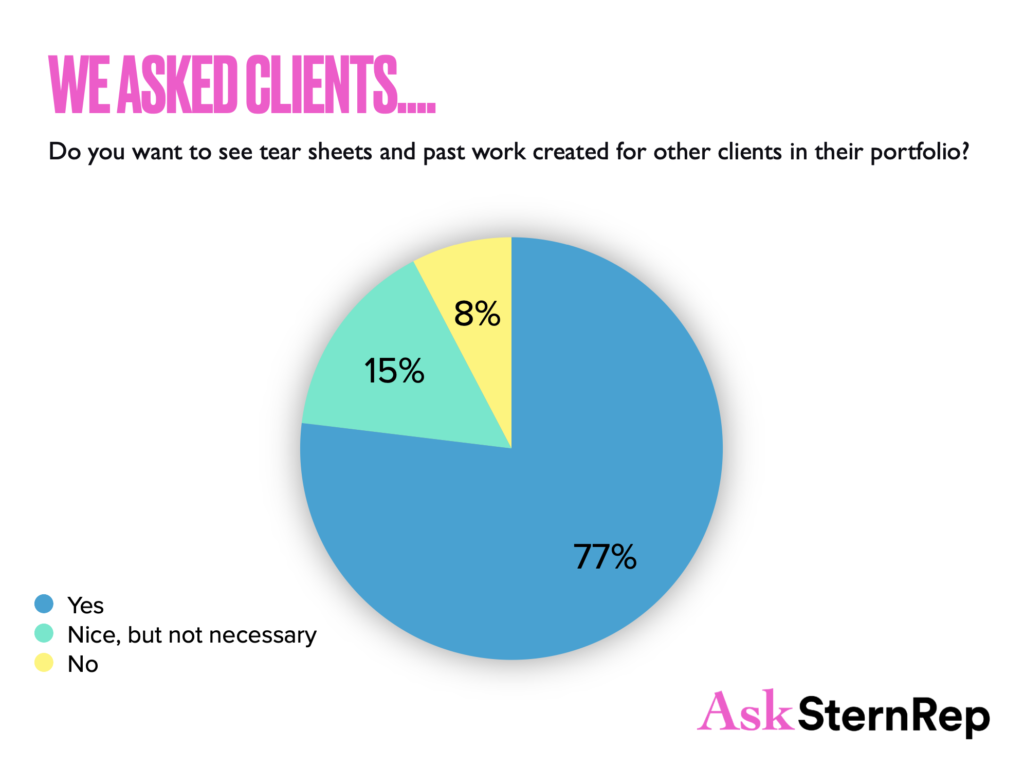
Websites
There are so many things that are right and wrong about websites – one thing we know for sure is they have to be fast. Include an overview on your website because clients won’t have time to click on different topics. They want a quick read to see if you are suitable for the job. The overview
brings you up a professional level, confidently having them scroll your best images without needing to click and search to get an immediate cohesive impression.
Since websites need to be easy, quick to read and serve the purpose of showing off your images in a constructive way that makes sense, select a company like Photofolio that has many different layouts. If you want to create your design, companies like Squarespace, Format, and PhotoShelter can be good options, but Photofolio has all the details already figured out for you.
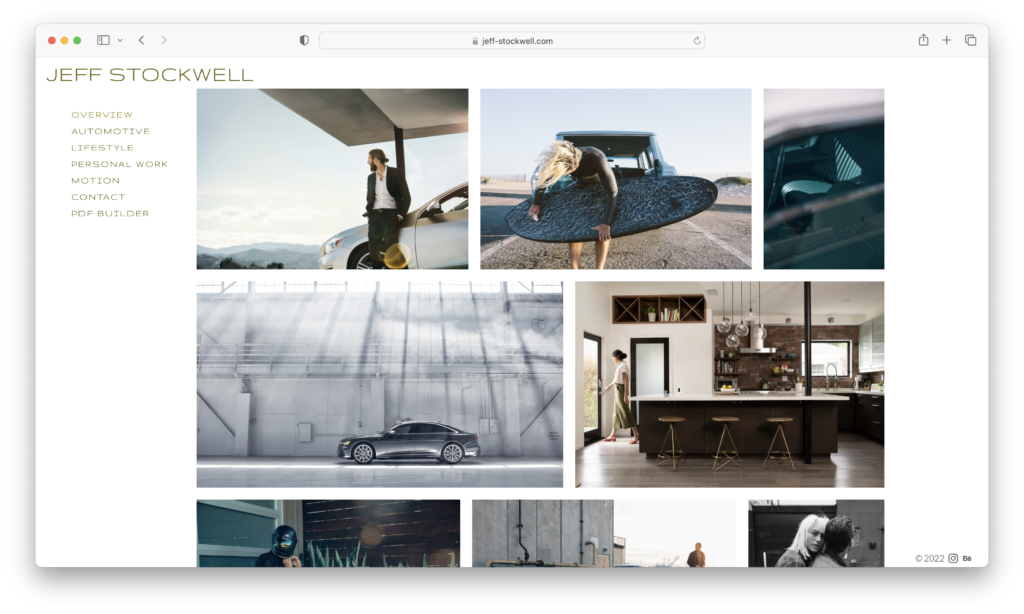
What hurts your website:
- Confusing categories.
- A short scroll down or side to side with clicking involved.
- Self-designed without professional standards.
- Dated work showing images with older looks and styles.
- Inconsistent mistakes (spelling, repeated images, etc.).
Physical Portfolio Books
Printed portfolios can allow the viewer a much-needed break from screens. I prefer one image per page, as it will enable the image to sink in without distraction and project confidence. Exceptions to this could be if you’re using a designer and they are creating a specific look with multiple images per page. But I usually lean towards less is more.
I know photographers who present their work on printed 8x10s inside a beautifully made box as a way to stand out. The client can always see your website or social media feeds to get a fuller picture of your work. Create a well-designed package that feels like you and understand that the presentation might change to reflect current trends in a year or two. Keep it fresh – the bottom line is you want the client to see your style while having your images speak louder than the actual portfolio.
Today’s world is indeed an all-digital space, which is why a printed book can stand out even more. It’s old school, but it can demonstrate your style and allow people the luxury of taking in each photograph more thoughtfully than clicking. It can also provoke more conversation than simply clicking through a series of images. I highly recommend printed portfolios.
Quick Tip: A handy rule for promos and portfolios is never putting the date on them because it makes them unusable very quickly.
Have your IG work for you instead of against you. We all know that Instagram is the way to be seen and discovered – it’s a portfolio and email promo coming together. We must stick to the times and lead the way if we want to get the jobs.
Websites and Instagram are two places you must keep strong and constantly updated, allowing them to sell you. Some clients will go to your website, and some will go to your IG account – some will go to both. Just as your website has your ABOUT section, which brings a bit of personal info to it – the same goes for Instagram. I suggest your Highlights be 80% portfolio images and 20% more personal or BTS.

Personal images should still be images that are interesting and educational to your clients. They want to know who you are and your hobbies, but they don’t need to know what your pets look like. They love seeing fun locations they’d want to visit, knowing where you are working, and learning interesting information about you.
You should post to Instagram as much as you’re comfortable. You don’t have to post daily, but it’s great if you can. The main thing is to be consistent – every two weeks is the minimum. You don’t want to be a month out from posting something and a client to come to your account and see that you haven’t posted in a month or two – you don’t look current, which can work against you in getting the job.


Portfolio Reviews
Portfolio reviews are a savvy way to get that one-on-one memorable personalized attention. These in-person and online events can connect you with the right potential clients that may offer valuable feedback. Be ready with your purpose to get the most out of your online/zoom portfolio reviews. What do you want to get out of it? Have your points of interest and questions ready to keep the topic flowing in the direction that fulfills your goal.
Standalone: Portfolios image selection has a different purpose with Ad Agencies vs. Client Direct work. Client-direct companies will be more understanding of various types of images. Ad agencies have so many photographers to choose from with an ever-changing artistic flow that they will choose the one who specializes in each specific topic repeatedly. The smaller, in-house companies will often use one photographer for all their photo needs. If Ad Agencies are your goal, identify your specialty and commit to excellence in that category.
What to Have Ready for a Portfolio Review
We know you probably aren’t a salesperson if you’re reading this, but you are a creative business. You need a sales or elevator pitch for portfolio reviews. It should express who you are or how you dealt with something on a shoot that makes you more valuable to them. You need to know your client, who they work with, and what scenarios might come up for them. Have a few stories or topics to discuss that show you can handle the job. Have these talking points ready so when you’re in the moment, you have these keywords to remember if there’s an awkward moment of silence or you only have one minute to make an impression. How are you going to say what you need to say? What would you say to this person? What do you want from this person? Do you want to take them to lunch? Do you want to have a meeting? Do you want to talk to them about an idea you have? Have it prepped and ready.
Do’s and Don’ts of Portfolio Reviews (in-person and online)
Do:
- Research the reviewers, especially on LinkedIn before choosing them.
- Use that research for those you weren’t able to see by connecting on LinkedIn.
- Make sure technicalities are in order – double check technical specifications.
- Have a plan set in advance for who is controlling the screen – you or them.
- Start with an icebreaker to make a personal connection.
- State your intentions – Do you want a job or feedback?
- Prep questions and topics specifically for them and what they work on.
- Listen and ask questions instead of talking too much.
- Find out what format your reviewer prefers – most like a prepared pdf but I like to see the website so I can remember the photographers in the future.
- Give them a take-away pdf leave behind.
- Remember the reviewers are exhausted, so be personable and give them a reason to smile.
- Reference other same event reviewers’ perspectives to see if they align with the current reviewer’s opinions (helps reviewer collect their thoughts).
- Have an “elevator pitch” ready to go or an interesting educational story to share about an image of how you handled some situation.
- Give a goodbye gift like chocolate or something personal to them, as the gift goes a lot way and will be remembered (in person).
Don’t:
- See irrelevant people for your topic when choosing reviewers as it can be a waste of time for both of you.
- Lose the connection you just made.
- Mail to people’s private home addresses without asking.
- Waste time on unimportant matters, as they go very fast.
- Talk too much – it can distract clients from seeing the images.
- Show too much work – tailor your portfolio to the reviewer.
Quick tip: We have better odds that clients will remember our work if we don’t speak as they flip through the portfolio pages.
Portfolio Reviews to Watch For / Favorites:
- Reps/Consultants (ASRconsulting) – Hire a consultant or rep that you trust to review your portfolio and offer feedback and insight
- APA – American Photographic Artists
- ASMP – American Society of Media Photographers
- AtEdge
- FotoWorks
- FocusOnWomen
- Art of Freelance
- Agency Book Showings – Request a portfolio review with a creative agency or watch for agencies to share an event for portfolio reviews
Where to Promote Your Portfolio
The business of photography depends on who sees our images; we have to find every potential method to put ourselves out there. Depending on your type of photography, we have some excellent options today with companies like Komyoon, Workbook, At-Edge, Blvd, Behance, Wonderful Machine, PhotoPolitic, LeBook, Production Paradise, and Found. They all have different purposes; go through them and see where you fit best. I suggest asking clients you want to work with where they look for new talent. After you give one of these a try, you can SEO your website and use Google Analytics to see where the traffic is coming in. It’s a timely process with no easy answer, but if you pay attention to your analytics, you can see what works for you.



Your Portfolio Defines Your Clients
PORTFOLIO means the collection of images defining the clients you work with and the style sensibility you will provide clients to reach their goals.
Continuously striving for this long-term past and future balance will land you jobs.
Two Kinds of Photography at the Same Time

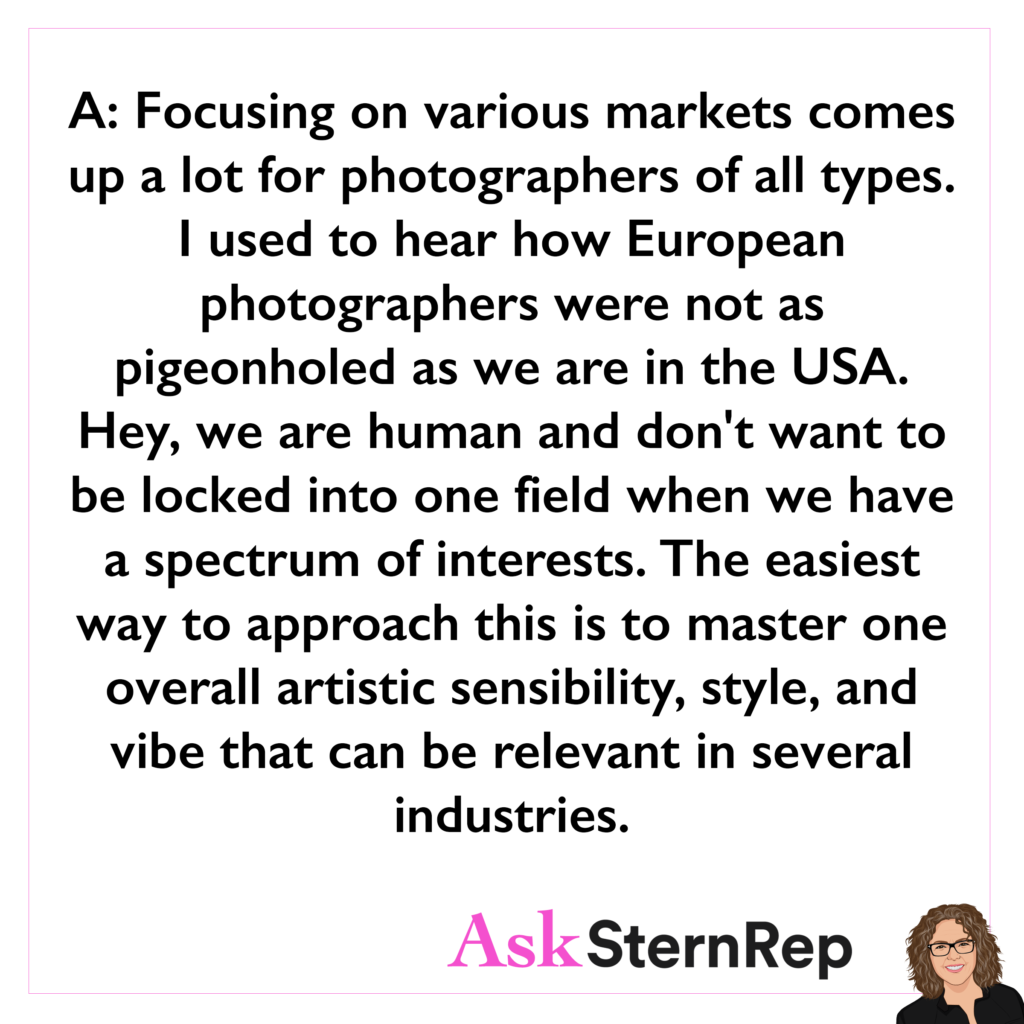
Q:
I want to get into Fashion and Lifestyle commercial photography. Can we do two kinds of photography at the same time?
A:
Focusing on various markets comes up a lot for photographers of all types. I used to hear how European photographers were not as pigeonholed as we are in the USA. Hey, we are human and don’t want to be locked into one field when we have a spectrum of interests. The easiest way to approach this is to master one overall artistic sensibility, style, and vibe that can be relevant in several industries.
Business Lulls
Business lulls in the creative field are a part of the norm. What we do with them can help us wake up those creative spurts, feeding the machine and opening new avenues to more unconventional unexpected new ideas. I like to take a step back, change my ways and notice something I didn’t see before.
Working With A Rep
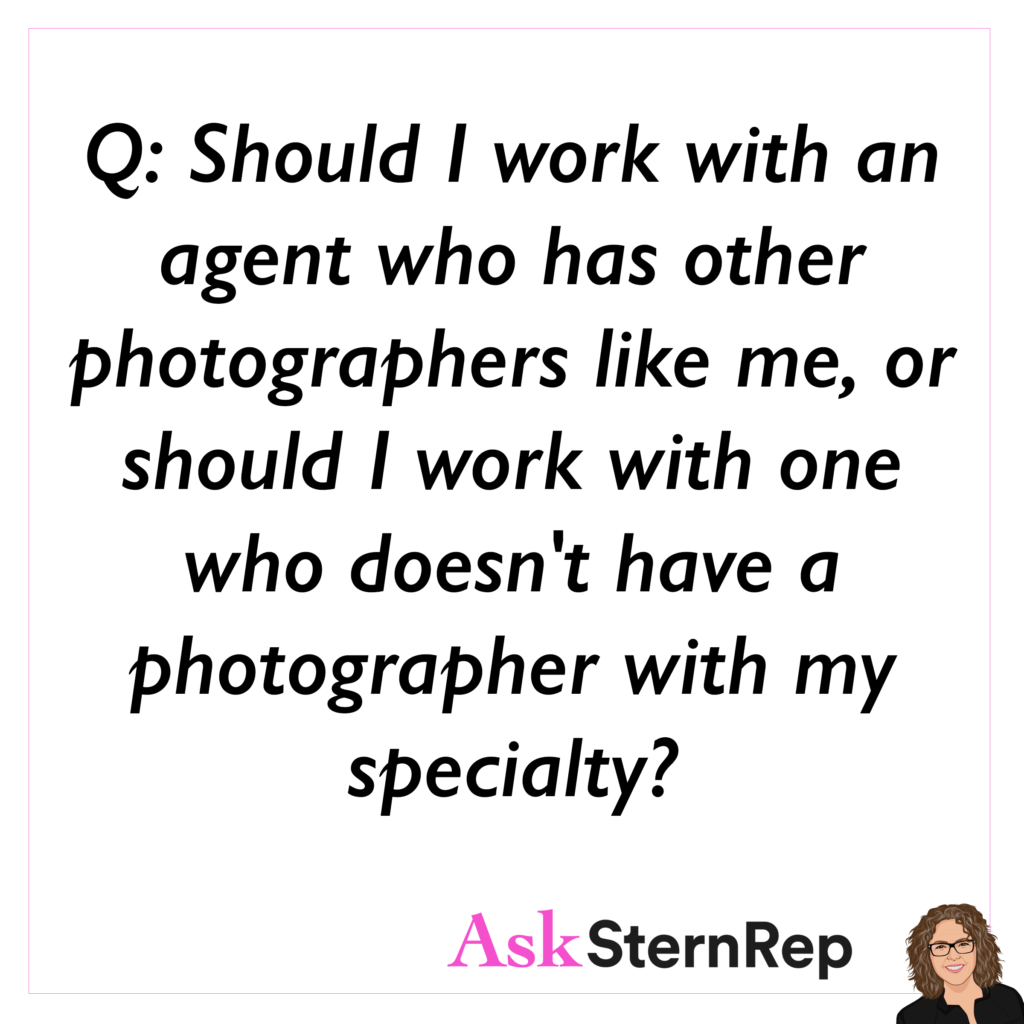

Q:
Should I work with an agent who has other photographers like me, or should I work with one who doesn’t have a photographer with my specialty?
A:
The first major step in the rep search process is the skillset every photographer must master to succeed – I call it “the objective eye.” You have to be able to judge a “good” image and a “good” grouping of images. Will your work fit well within the rep’s roster, highlighting and amplifying your brand? Your well-curated viewpoint begins with a snap of the shutter and continues into portfolio/feed promotion. The rep requirement checklist grows from there, but this starting point should shape your search.
Photographer’s Office Hours
Photographer’s office hours can be challenging as it’s not exactly what we signed up for. Or is it? “Office hours” keep us plugged into work mode with random actions motivating us to keep going. Have your resources and your people, and reach out to those you want to connect with for no clear-cut reason. Plug yourself into all that keeps the office activated.
Low Rate Job

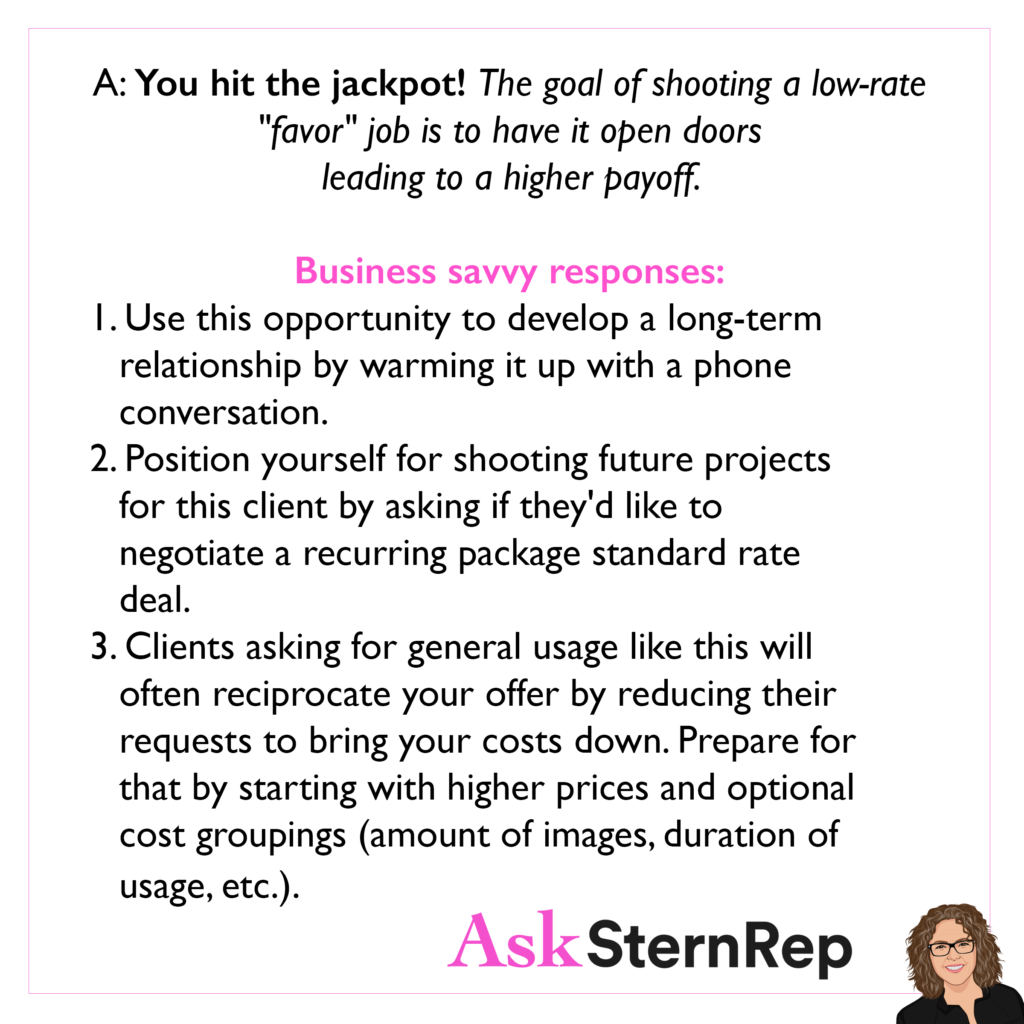
Q:
I shot an event for a startup event company at a very low rate and included a “no third party usage” term in the contract. A top five ad agency working with the new alcohol brand requested rights for unlimited usage in perpetuity for the images. What is the tactful, business-savvy way to respond?
A:
You hit the jackpot! The goal of shooting a low-rate “favor” job is to have it open doors leading to a higher payoff.
Business savvy responses:
- Use this opportunity to develop a long-term relationship by warming it up with a phone conversation.
- Position yourself for shooting future projects for this client by asking if they’d like to negotiate a recurring package standard rate deal.
- Clients asking for general usage like this will often reciprocate your offer by reducing their requests to bring your costs down. Prepare for that by starting with higher prices and optional cost groupings (amount of images, duration of usage, etc.).
How to Find a Photo Rep
A photography agent or photographer representative is an additional public persona getting you exposure, findability, and raising your stature with their reputation, connections, and business knowledge. A photographer’s rep is a powerful negotiation voice – getting you paid as much as possible while protecting you with legal oversight. They are your teammate partnership working alongside you, managing the business direction while overseeing the progression of your craft.
“A photo rep knows the business side of creative careers. To put it bluntly, we protect and sell you.”

The myth that damages photographers’ careers is to assume the rep is doing all the public connecting and then not doing it yourself – perhaps 10-15 years ago, that was true, but now, it can kill your career. Repped or not, the role of marketing must be a fine-tuned, consistent plan of action based on your circumstances. The essential component of having a rep has changed with the times – they are no longer the one operation to take your career to that next level.

Social media has created an open market for you to participate in, opening doors reps used to open for you. These days a photographer’s marketing strategy demands high-level repetition mixed with A-level instantaneous curated direction allowing clients to get that quick read as they search for who to bid on a job.
“Photographer representatives can take a photographer’s marketing to the next level, but they need their active participation to make this work.”
Five Ways to Begin Your Photo Rep Search
- Assess the size of the photography agency. Do you want a big rep agency or an individual rep? Think about if you want more of a hand-held catering to who you are or to be one of many fitting into a company conglomerate? Every photographer has different needs, and knowing which type of situation makes you tick even better should be your goal.
- Consider location. Do you want a photo rep near you or is what you do more focused in a particular city or area? For example, if you’re in high fashion photography, you’d need a New York rep.
- Look at the rep’s style. Every rep has a different curated vibe. Do you belong within that vibe? Or do you stand out in a way that doesn’t belong?
- Review the rep’s clients. Who are the clients that the rep works with regularly? Do you fit within the client roster of that rep or rep agency?
- Think about the competition. Many reps have the same kind of photographers, and you’ll be competing with them for jobs. For example, I rep three car photographers –I’m often bidding two of my photographers together against each other. My photographers trust me on this but will it bother you that your rep is not just for “you” all the time?
What to Look for in a Photo Rep
- Be sure the photo agent is moving along with the times. They should be active in social media. Look at their social media – how proactive are they? A rep isn’t an influencer, but they are promoting your work. How can they do that if they aren’t on Instagram.
- Look for a well-designed website with good functionality. Easy functionality with a style sharpness that stands out.
- Consider their response to your email – was it in a warm or hurried tone? You can usually get a sense of where they are from the email response. If they don’t respond, that’s a sign that they’re either not very responsive or not interested.
- Talk to other photographers about reps. You can find out about a rep’s reputation by asking others. It would be great to understand what didn’t work for one photographer with a particular agent. It may not bother you, but it could also be a reason to look elsewhere.
- Look to see if the rep on LinkedIn. If a rep isn’t on the platform, I don’t know what they’re doing. An agent has to be active in all these prominent ways. It’s what we are today – no way around it.
How to Get a Photo Rep
If you are repped and looking for a change, you can be honest about why you’re seeking a change. If you have not been repped and are new to the business, keep your email short – reps know your intention immediately. It’s not easy to say no, so email a question or relatable topic to encourage building a relationship vs. needing us to figure out how to say no creatively – if we are interested, we will accept talking further. We are happy to see a quick rundown of your situation, giving us a sense of the kind and confident person you are. However, the more you say to us, the more we don’t read what you say. Make it easy for a rep who gets many of these emails daily.
“Treat reps like any other client you want to work with. The goal is to always stay in front of prospective clients in a way that works best for them.”
Whether it’s a printed mail or email promo, don’t limit yourself to just these two methods; remember, the marketing doors are your oyster to try new ways until it works. Be open to discovering fresh new ways to keep yourself out there in this rapidly ever-changing world.
What Not to Do When Approaching a Photographer’s Rep
- Do not call people. Email first, then set up a call if the rep responds with interest.
- Don’t waste the rep’s time by sending them work that doesn’t apply to their lists. Research the rep’s style and aesthetic before making contact.
- Don’t send mass emails, and be careful that you’ve spelled the rep’s names accurately.
The Ideal Photographer and Photo Rep Relationship
The ideal photographer and rep relationship is all about a growing team trust with complementary perspectives. You won’t always agree on things – I see it like I earn my commission by throwing ideas like pasta against the wall to see what sticks, and the photographer needs to work with me, expressing what is right for them along the way. We do this together, exploring new ideas in our consistent approach and keeping up with the times to always grow forward.
“Remember, the right rep for you is about that team effort promoting the best of you to get to a constantly better place.“
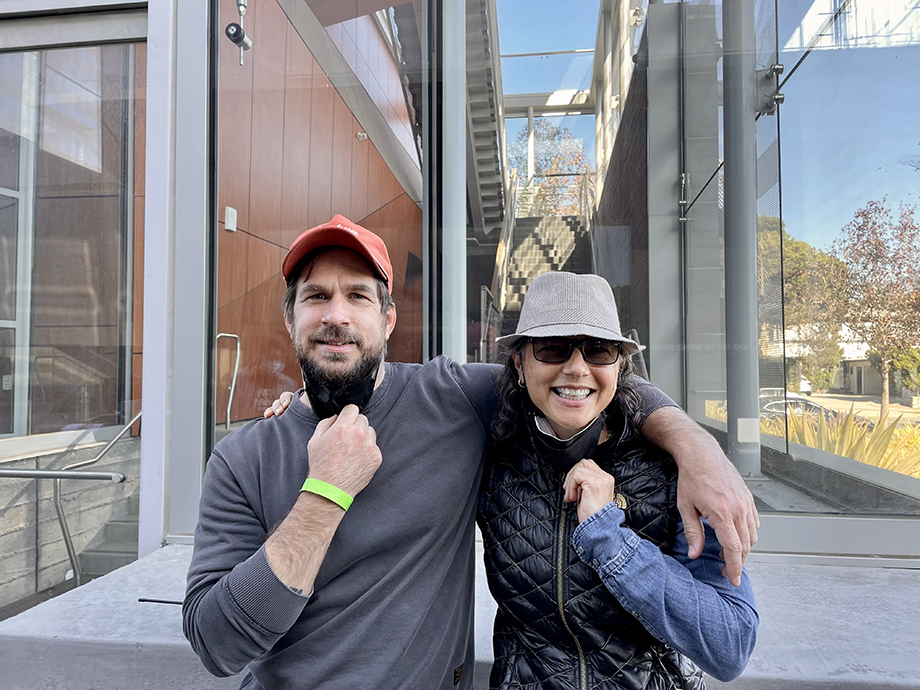
Search for Reps Online
More Information
APA ALL ABOUT REPS Webinar Part 1
Bid Requests Asking for Our Price
When we get bid requests asking for our price, but they don’t have the project information, I hear, “I don’t do this often, I don’t know how this works, and I expect you to do most of our job – so inform us what our $500-$3000 budget will get us.”
Four ways I respond:
- I cannot give a cost without more information.
- It sounds like this will end up being between 10k-30k, give or take some, depending on your job specifics.
- This may be at least 10k, so we can discuss this to get more exact if that is near your budget.
- I am available to help create this job for you, and here are my option ideas to git within the 3-8k budget or the 10-12k budget range.
Consistency of Questions on the Creative Call
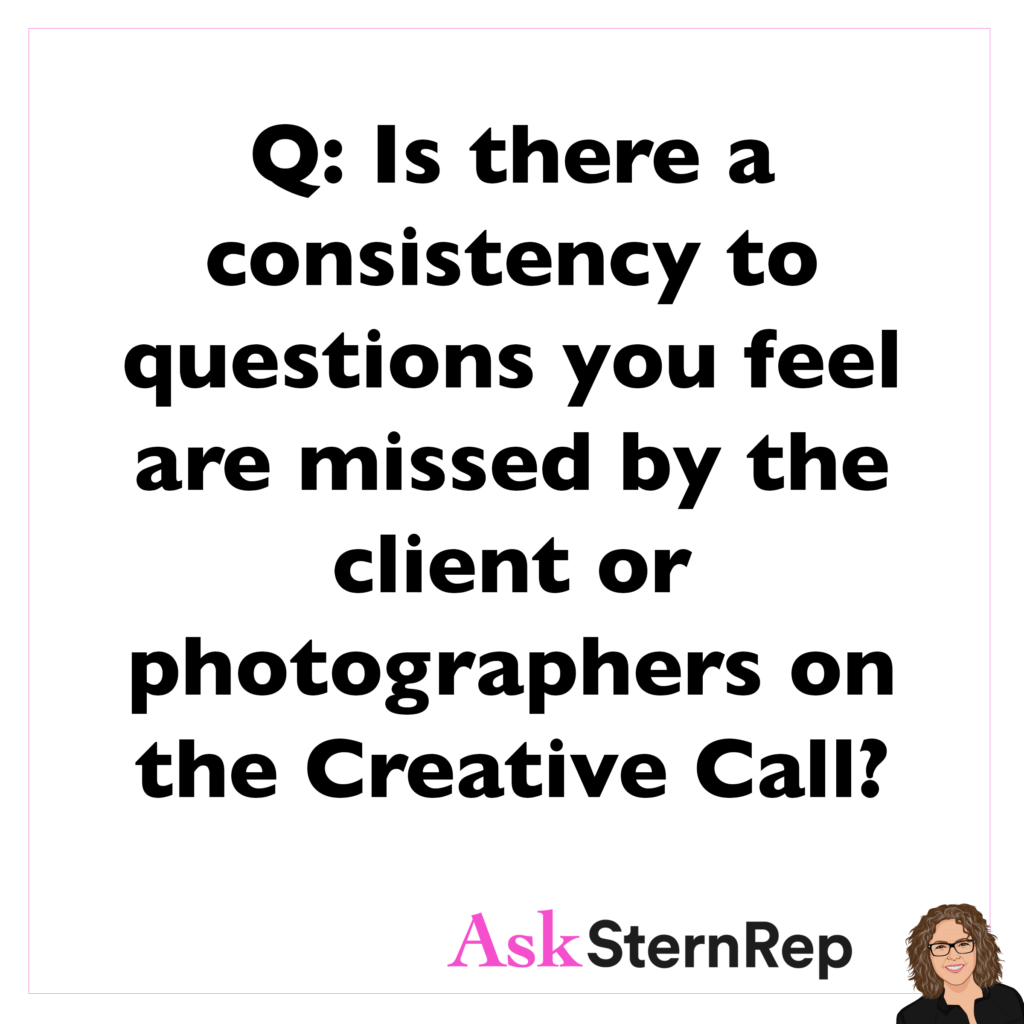

Q:
Is there a consistency to questions you feel are missed by the client or photographers on the Creative Call?
A:
The creative call is almost as important as your portfolio of images to push you as the job’s front-runner. Questions during the call can be a way to get your point across by asking while suggesting; I call it a “loaded question.” I notice photographers not exactly missing questions per se but missing opportunistic moments to share the approach in a question format.
Video Usage
Be Aware: A usage term getting overlooked right now is VIDEO usage. It’s standard to see “no broadcast usage,” but we cannot assume that means no video or motion usage.
The two are no longer interchangeable. Price accordingly.
Bids vs Estimates
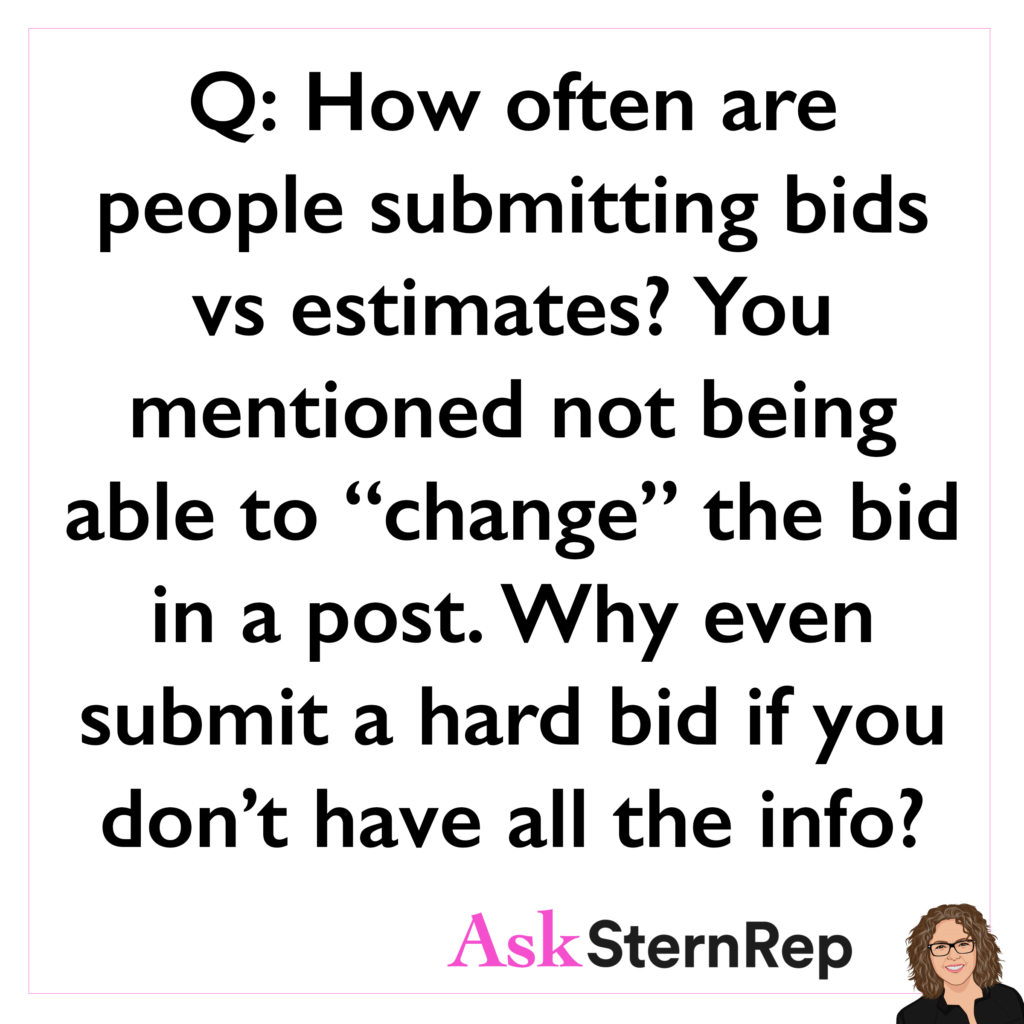
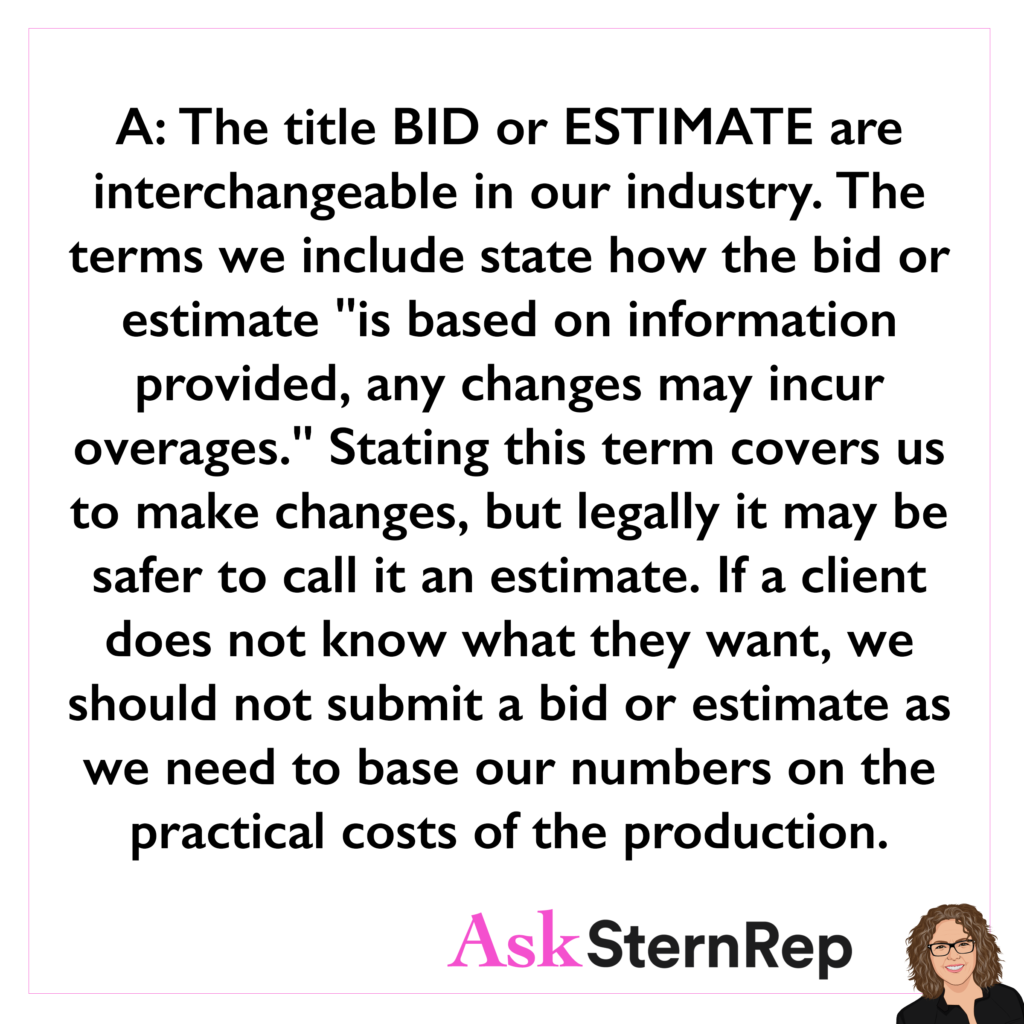
Q:
How often are people submitting bids vs estimates? You mentioned not being able to “change” the bid in a post. Why even submit a hard bid if you don’t have all the info?
A:
The title BID or ESTIMATE are interchangeable in our industry. The terms we include state how the bid or estimate “is based on information provided, any changes may incur overages.” Stating this term covers us to make changes, but legally it may be safer to call it an estimate. If a client does not know what they want, we should not submit a bid or estimate as we need to base our numbers on the practical costs of the production.
Exciting Job, Low Budget
When offered an exciting job for a low budget, you can always offer your time and usage licensing for a discounted rate while having the client handle all production. If you feel you can create high-quality images, these jobs require clear terms of what you are and NOT including.
Sample Negotiation:
Client: How much would it be to shoot this?
You: I don’t have enough information to give you an accurate price. What is your budget?
Client: We have $2000.
You: For a $3500 discounted rate, I would do this for one month of social media for four final images within an 8 hour shoot day, and that does not include any production expenses only my time.
Ready for a Rep

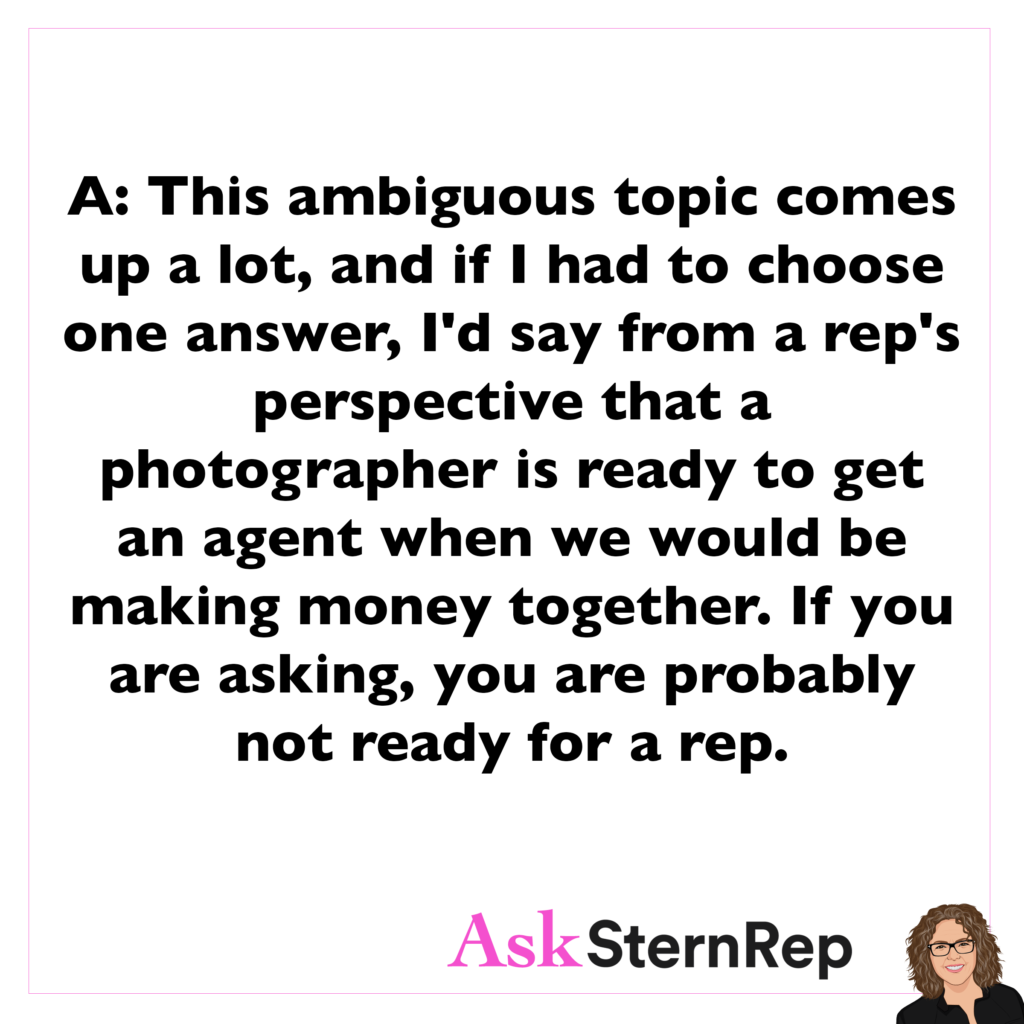
Q:
How do you know when you’re ready to get a rep?
A:
This ambiguous topic comes up a lot, and if I had to choose one answer, I’d say from a rep’s perspective that a photographer is ready to get an agent when we would be making money together. If you are asking, you are probably not ready for a rep.
Add This Term To Your Estimate
Add this term to your estimate, protecting you from any verbiage where ad agencies do not pay you until they receive payment from the client they represent.
“BOTH THE CLIENT AND CLIENT’S CLIENT ARE WHOLLY AND SEVERALLY RESPONSIBLE FOR PAYMENT IN FULL BEFORE ANY RIGHTS ARE LICENSED.”
Professional Connection on Instagram


Q:
If I get a new professional connection on Instagram, is it overkill to email them as well?
A:
The correct answer for this is about consistent engagement. That can happen on LinkedIn, emails, lunches, portfolio showings, IG Stories and feed commenting, etc. The one engagement I don’t recommend is an inbox DM. Why? Every other type of engagement keeps your client in control where a DM message to a new professional connection is what Facebook used to be – the more personal space saved for friends. Warm up professional contacts to see if they eventually become a friendship; otherwise, we can become too pushy, and instead of marketing, it becomes “anti-marketing.”
Listen Carefully on Your Creative Call
Listen for the details mentioned on the creative call like it is a comprehensive test of who you will be on set if they hire you.
The main goal of this call is to show how you hear their vision and put their trust in your hands. If you prove you are not a capable listener by missing the small stuff, you may be blowing their belief that you will hear them on the big stuff.
Essential Marketing Tools
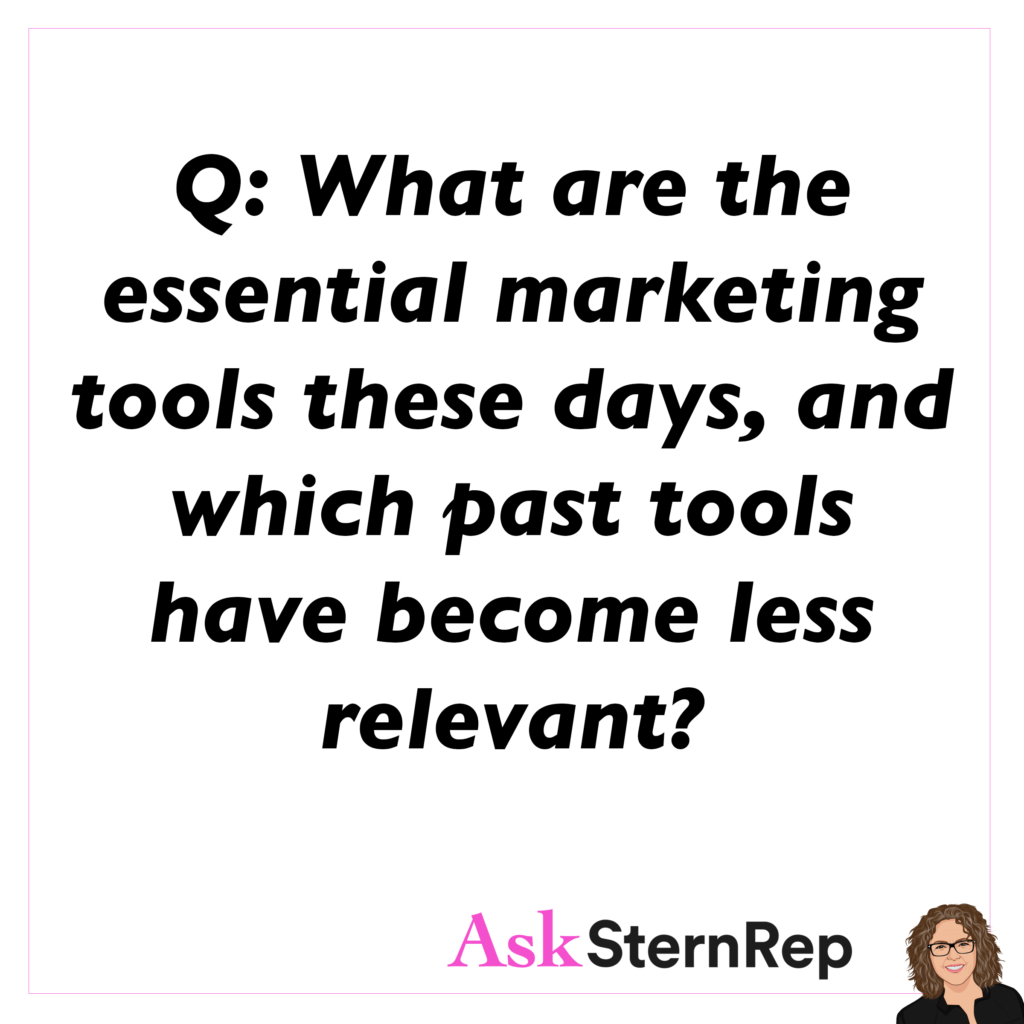

Q:
What are the essential marketing tools these days, and which past tools have become less relevant?
A:
Marketing tools tend to come and go, but the KEY is to be the leader of the pack by instilling new ways or the return of the old ones. Printed promos and portfolios are on the out, but I’ve seen it happen before; someday soon, they will be back. My job as a rep has always been about expanding and cultivating new marketing routes to see what works. I jumped on Clubhouse initially but no longer saw the marketing benefits as strongly as doing my webinar and podcast to be showcased on my YouTube. If a marketing trend goes cold, the right question is, what is the new replacement I can do asap?
** Marketing tools chart available on www.asksternrep.com downloads
What is Your Special Something?
What is your special something? What do you offer that is your secret sauce, your tipping point, what do you offer that sets you apart?
Maximize your SELLING POINTS by reassuring the client they are in good hands, relying on your specialty to get the job done.
Showing Clients’ Work With or Without Permission
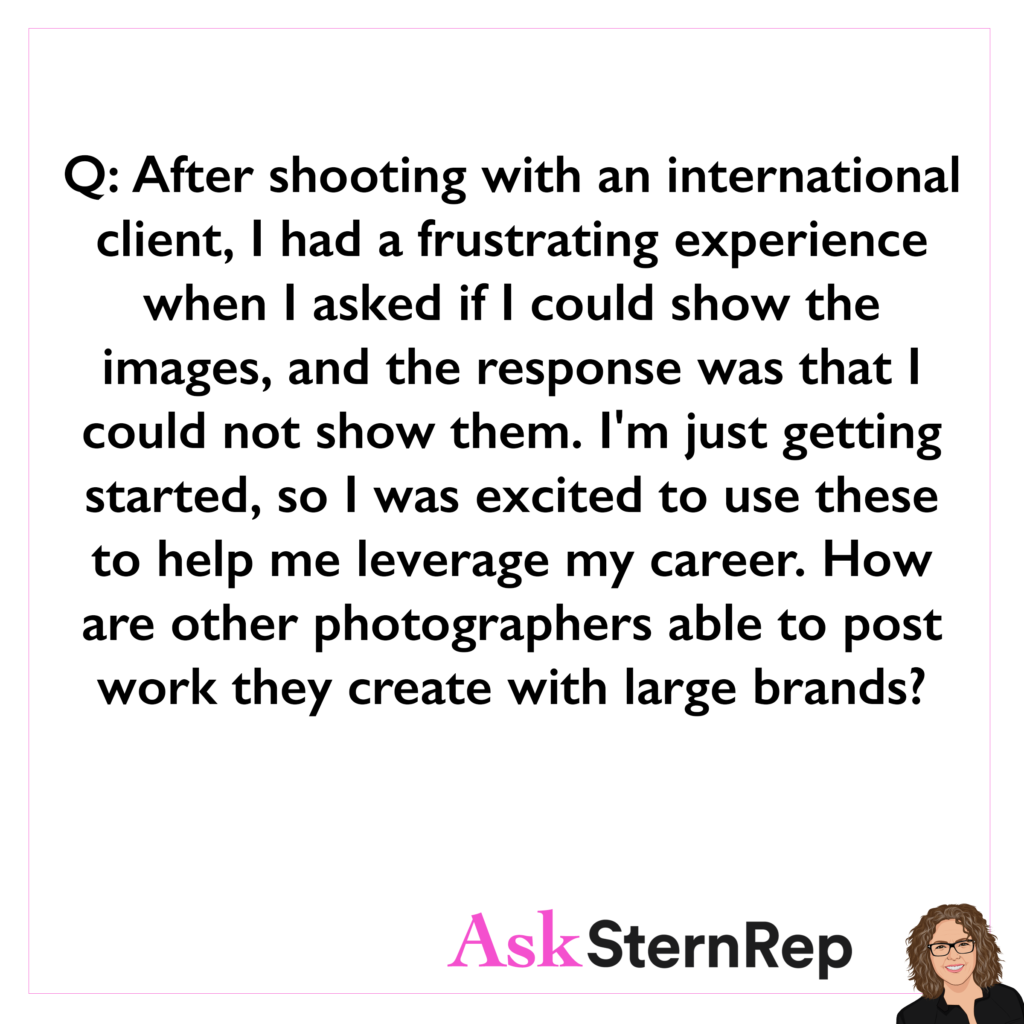
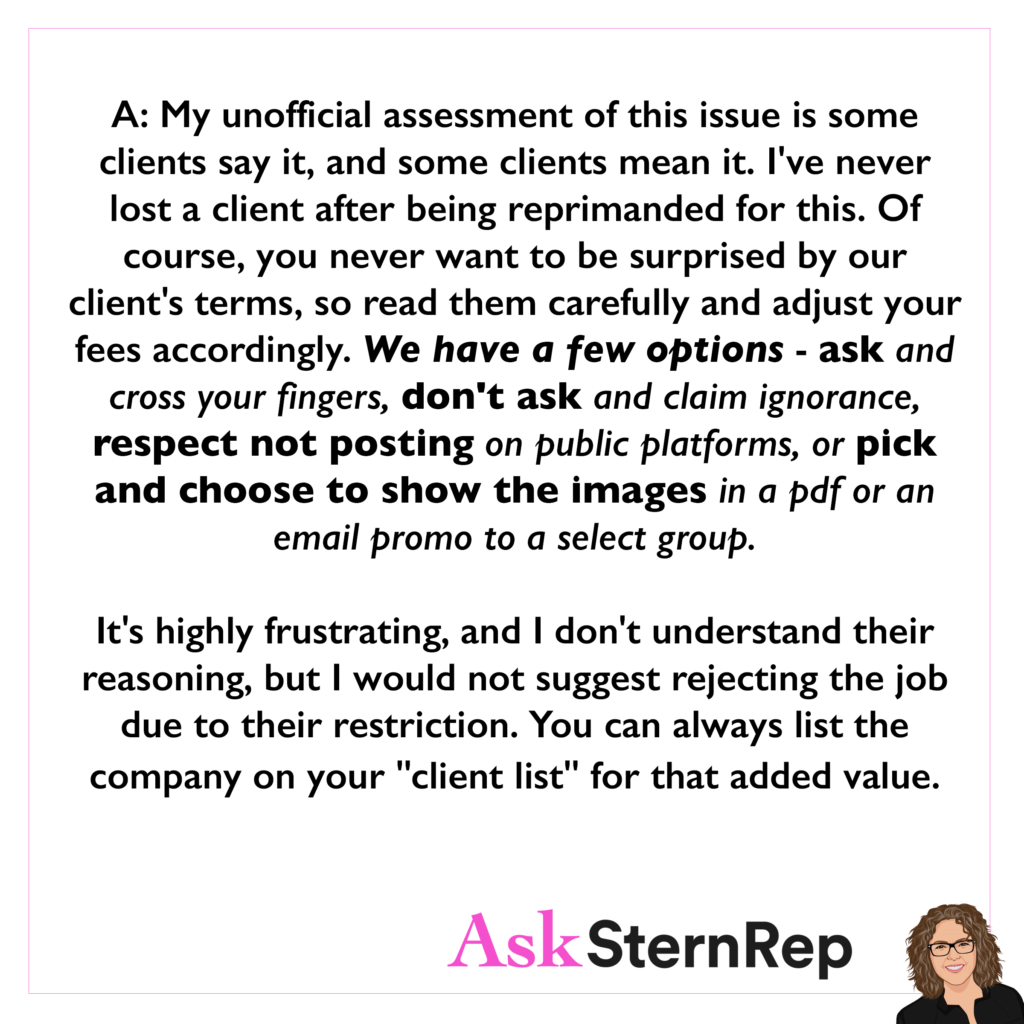
Q:
After shooting with an international client, I had a frustrating experience when I asked if I could show the images, and the response was that I could not show them. I’m just getting started, so I was excited to use these to help me leverage my career. How are other photographers able to post work they create with large brands?
A:
My unofficial assessment of this issue is some clients say it, and some clients mean it. I’ve never lost a client after being reprimanded for this. Of course, you never want to be surprised by our client’s terms, so read them carefully and adjust your fees accordingly. We have a few options – ask and cross your fingers, don’t ask and claim ignorance, respect not posting on public platforms, or pick and choose to show the images in a pdf or an email promo to a select group.
Licensing Term
Include the number of final images into your licensing term as a safeguard setting the tone that your usage fee increases if they add more images.
Client Work Posted Without Permission

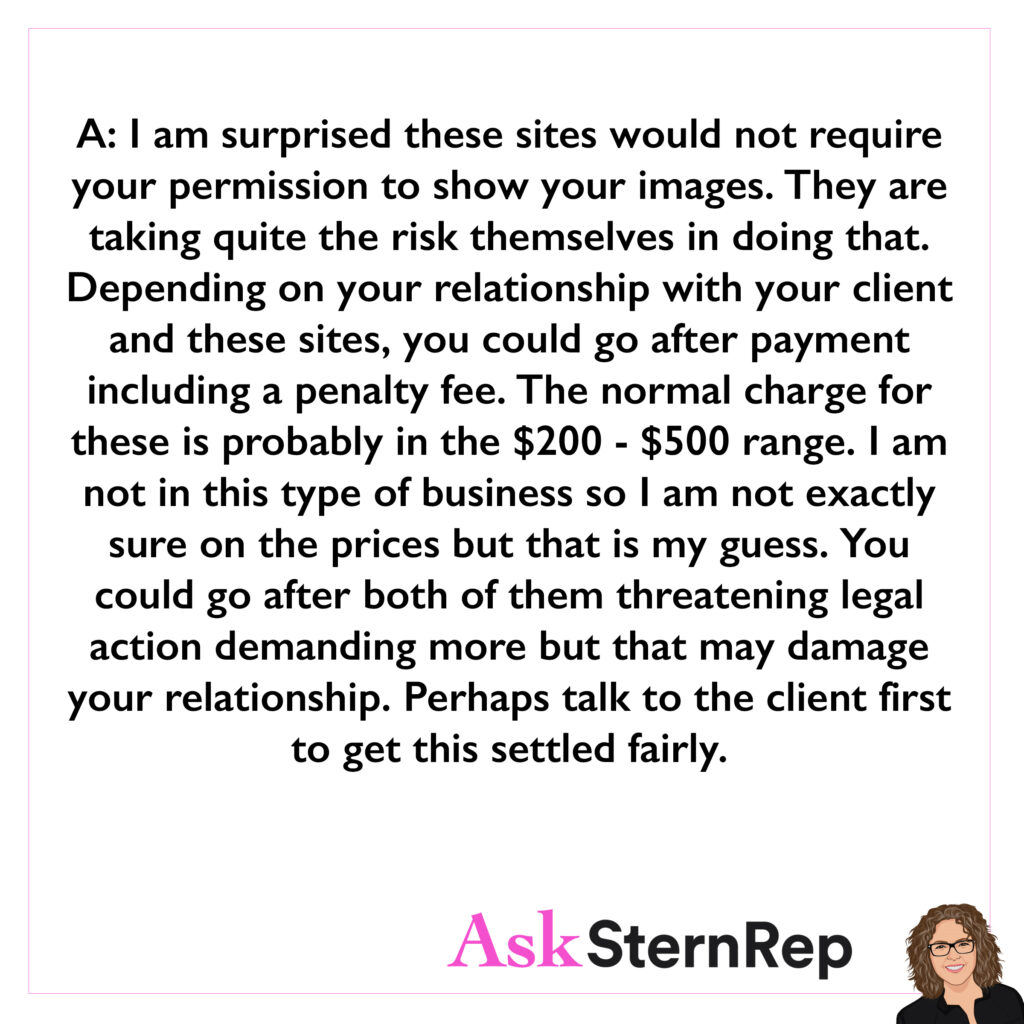
Q:
I’ve had a lot of my client work posted in articles like Hypebeast, WWD, and Complex without my permission or crediting my name. How much do people charge for usage like that? How do I deal with charging if clients keep getting my work up on big-name articles like this without consent?
A:
I am surprised these sites would not require your permission to show your images. They are taking quite the risk themselves in doing that. Depending on your relationship with your client and these sites, you could go after payment including a penalty fee. The normal chare for these is probably in the $200-$500 range. I am not in this type of business so I am not exactly sure about the prices but that is my guess. You could go after both of them threatening legal action and demanding more but that may damage your relationship. Perhaps talk to the client first to get this settled fairly.
Give Your Marketing Outreach a Purpose
Save time and make the most of each marketing outreach session by sticking with a similar theme.
OUTREACH Helpful Tips:
- Stick to one main message to copy and paste, just swapping in their name and something personally related to them.
- Focus on one company or one type of client to use the same overall message.
- Start with mutually connected people to find the right contacts and use who you know to warm up the conversation.
- Have one specific point of timely information giving a purpose to your message.
15 to 20 percent of a photographer’s marketing budget and time should be spent on outreach to potential clients, whether they are past clients or new ones. Having a specific point or question to ask when reaching out is essential, as it shows that you have taken the time to understand the client’s work or interests. Whether connecting through social media or in-person meetings, it is important to have something meaningful to say and to share updates about your own business growth and progress. By doing so, you can establish a rapport with potential clients and increase the chances of securing new business.
Usage Rate For A Client’s Social Media Content
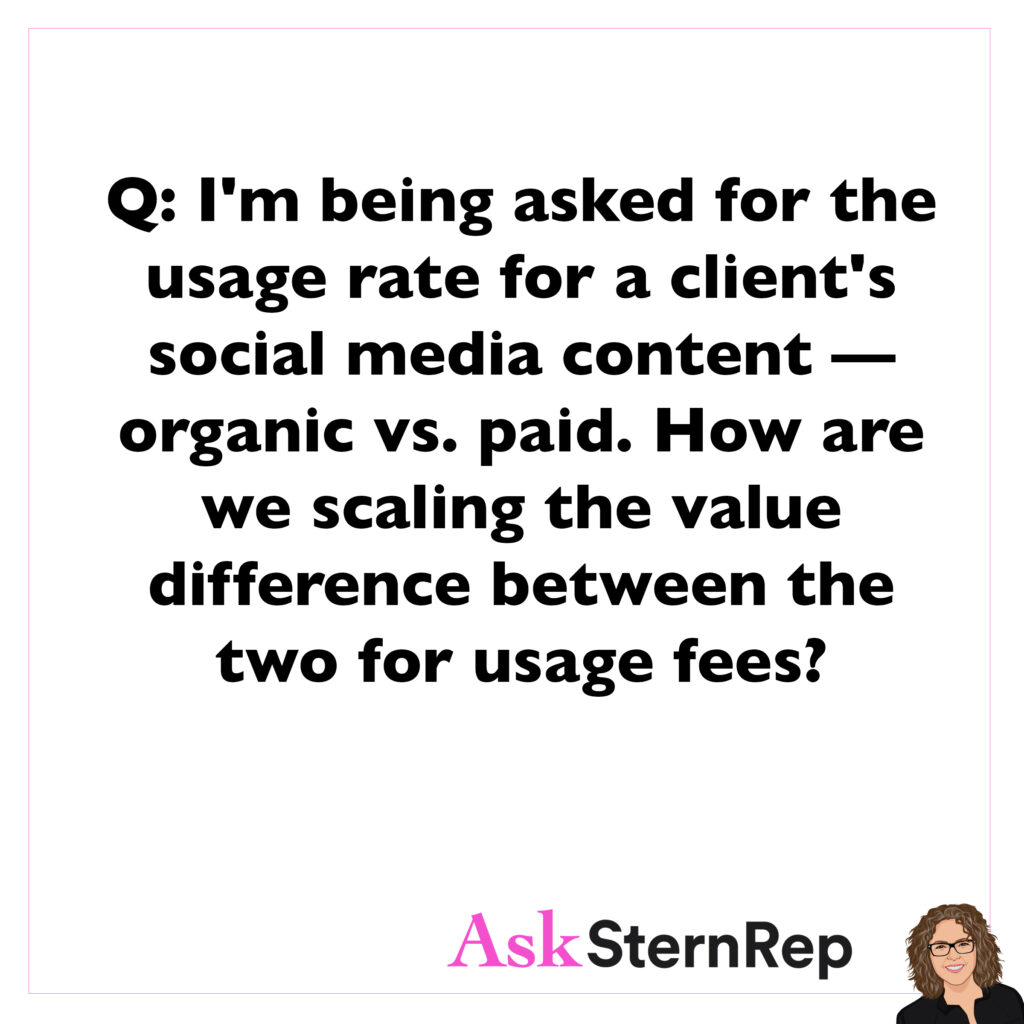
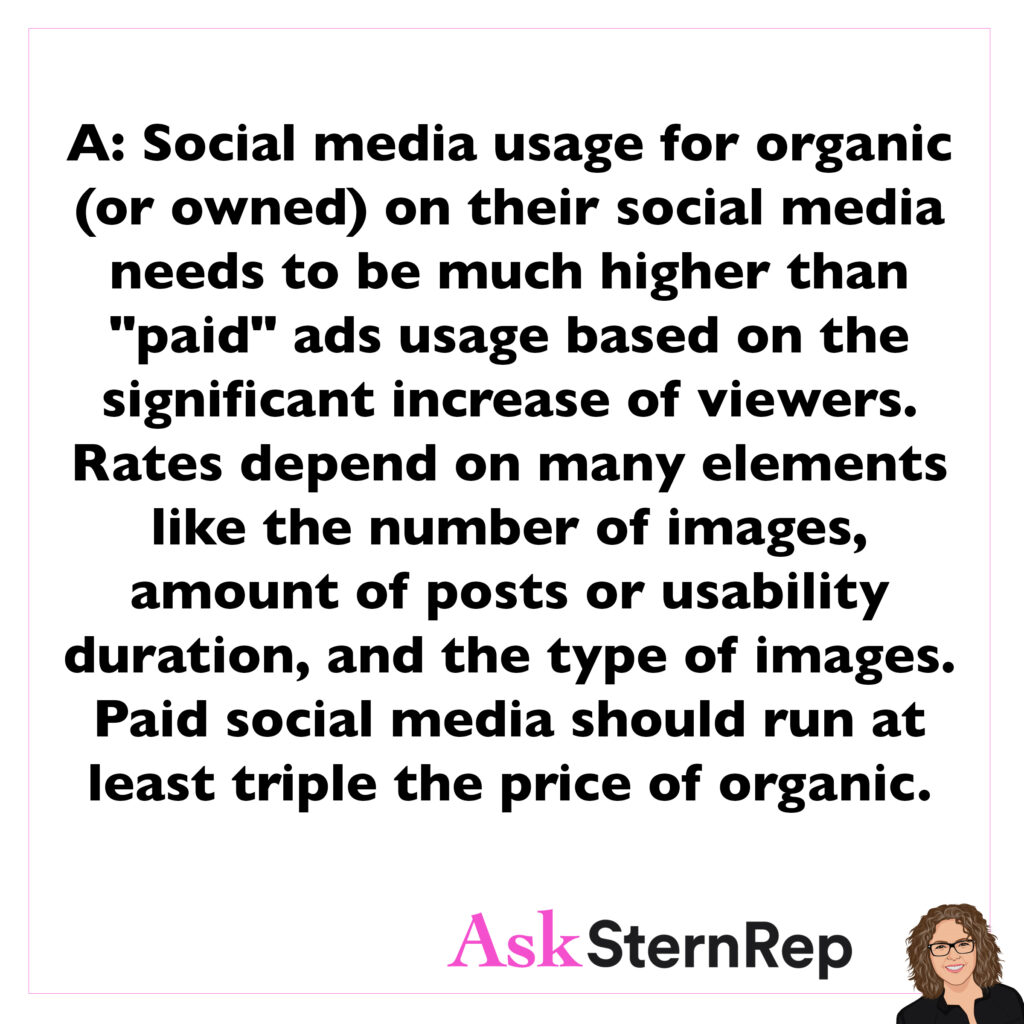
Q:
I’m being asked for the usage rate for a client’s social media content – organic vs. paid. How are we scaling the value difference between the two for usage fees?
A:
Social media usage for organic (or owned) on their social media needs to be much higher than “paid” ads usage based on the significant increase of viewers. Rates depend on many elements like the number of images, amount of posts or usability duration, and the type of images. Paid social media should run at least triple the price of organic.
Knowing the Client’s Budget
Knowing the client’s budget, I like to sneak in $500 more to get as much as possible without my response risk being too high. My response is to stay within their playing field but still do my job to get us paid as much as possible.
Preferred Format for Emailing a Portfolio


Q:
When a prospective client asks us to email them our portfolio, what is the preferred format? A ready-made pdf portfolio or a unique online webpage and gallery put together specifically for that prospective client?
A:
Clients often prefer a specific submission of your work representing each project, be ready to do this regularly. The one place I do not recommend sending images from is Dropbox. They need fast, easy, clear groupings of images to zip through, comparing you to the other bidders. You can ask which they prefer, but a pdf is the norm.
Moving Forward
Stepping forward is not about knowing the precise direction you are going; it means you are actively advancing.
You are in the trendsetting business of getting hired to help move clients forward. This exploratory motion is the infrastructure of a long-term career in the creative industry.
Paying For Usage Rights


Q:
A client hiring me for a shoot was confused about paying for usage rights. Is there any foolproof way to educate clients about image licensing and why photographers should be paid what they deserve?
A:
Explaining licensing usage rights to clients means you are dealing with clients who are not used to paying much for their photography. Know what you are getting into, and keep close supervision once paid duration ends. APhotoEditor has an easy-to-understand explanation we can use to help educate these types of clients-
www.aphotoeditor.com/2010/02/05/ad-agency-guide-to-photography-usage-terms/
Bidding Can Sometimes Lead to an Intense Panic Mode
Bidding can sometimes lead to an intense panic mode like we are in a time pressure machine that feels so real. Last-minute production decisions involving many people can feel like a monumental crisis. I’ve seen it and felt this panic myself as it will rise and then simmer down with a flick of a switch.
Know that this potential frenzy state of emotion could be a regular piece of the bidding puzzle.
Do’s and Dont’s of Cold Emailing Potential Clients and Reps


Q:
What are the do’s and dont’s of cold emailing/dm’ing potential clients + reps?
A:
1. Contact the correct people who look for your type of work, don’t waste their time.
2. Use their name (spelled correctly).
3. Keep it short.
4. If you are copying and pasting, make sure it isn’t blue, looking like it’s been reused.
5. Sound like a human; imagine if you were receiving this email/dm.
6. If you are asking for something, make it only one request.
7. Ask a simple question for us to respond to so we don’t spend time thinking about how to answer.
The 3 Steps Clients Look for in Your Portfolio
The 3 Steps Clients Look for in Your Portfolio:
- The seamless message of your style with a purpose.
- An emotional story, the audience is pulled into feeling: striking a chord with their brand’s message.
- The reassurance that their customers feel this emotion if they hire you.
What’s Your Opinion of IG?


Q:
What’s your opinion of IG? Do you think the pros outweigh the cons? And do you think only posting BTS/announcements as opposed to actual photos would be career suicide?
A:
My overriding opinion about choosing any type of marketing is all about IG. We can’t dance around this; telling half the story is like saying we want to show clients we can handle providing images for their marketing needs, but we can’t do it ourselves. We have to be doing at least the basics, or it’s equal to not having a website (oy!). Only posting BTS/Announcements would be using it as a temporary, occasional publicity outlet which would send out the message that you don’t feel confident in your completed work.
The Biggest Myth of Your Photography Business
Biggest myth is thinking you have to be the one doing it all, taking every opportunity to save some cash and do it your way. Photographers, you don’t have to do it all to run your business. Short-sighted vs. long-term eye on the prize goal, you choose which way to spend your time investing in your company.
When a Photographer Secures a Rep


Q:
Once a photographer secures a rep, can we feel relieved, knowing that the rep will secure work for us regularly, like once a month or more? I believe this is an essential question since photography is a precarious profession, and I’m curious if representation can mitigate this.
A:
Simple answer: NO
Think of it like this: a rep can open doors, but it will still be you, with your same portfolio showing up to those meetings.
We have the contacts, and you have the goods. The question is more about what are you needing to land the jobs? Is the answer something where a rep can help you grow your portfolio and make you more findable or credible with exposure? Figuring this out before you look for a rep may help you not waste any time determining the right path for you.
Where Your Bid Total Stands With The Client
Don’t you want to know where your bid total stands with the client?
It can be helpful to have an excuse to check in on your bid after submitting it.
If the client left out some piece of info about the job, I could put in a low price, knowing they may come back to ask for more.
That check-in can allow us to feel out the budget and see if there is room to bump up the price.
Estimate For A Corporate Shoot

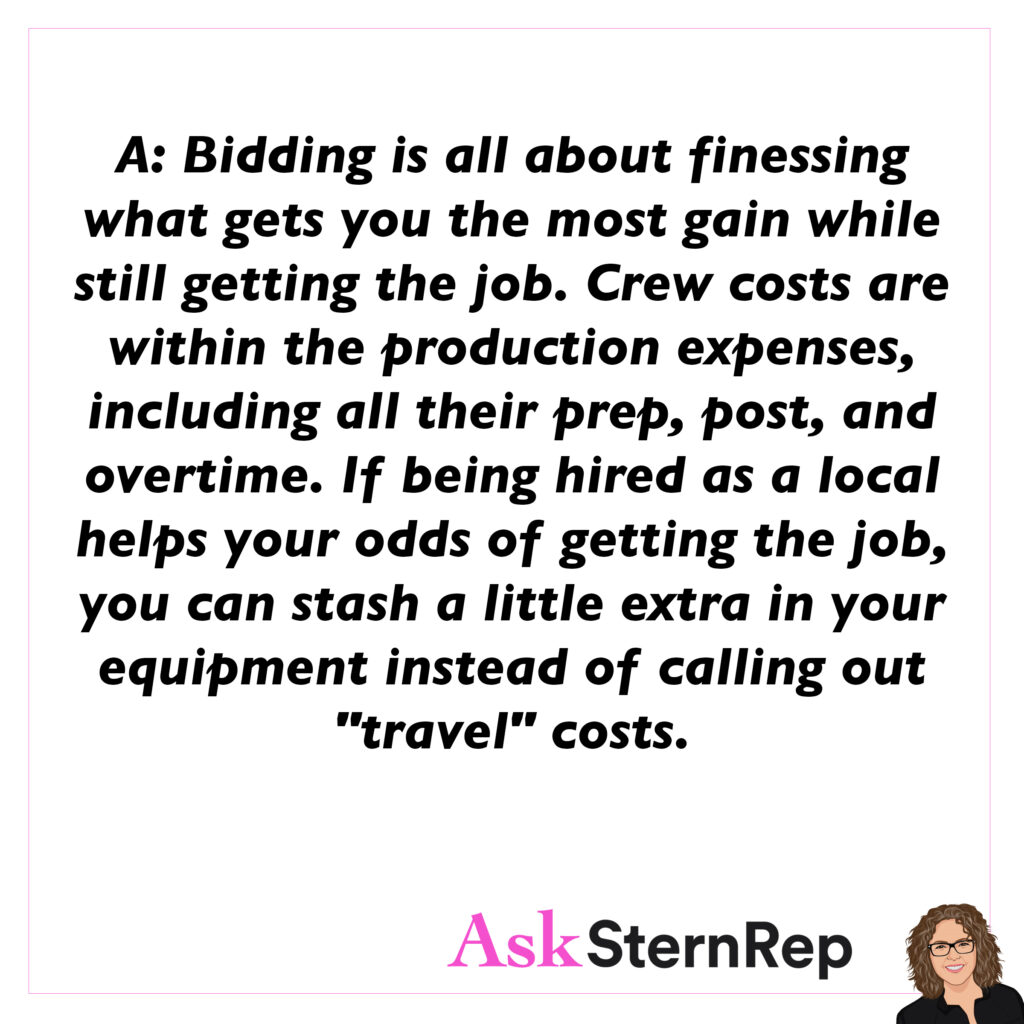
Q:
I’m putting together an estimate for a corporate shoot. I usually charge for travel days, should I also have a line item for crew travel days, or is that something I should be covering? Any advice?
A:
Bidding is all about finessing what gets you the most gain while still getting the job. Crew costs are within the production expenses, including all their prep, post, and overtime. If being hired as a local helps your odds of getting the job, you can stash a little extra in your equipment instead of calling out “travel” costs.
Timing Matters!
Timing matters!
Outreach can be unpredictable, but sometimes you have that distinct positional placement of being right in there freshly on a client’s radar. Timing can be the key to fully opening the door when it’s been slightly cracked open for us. Use it or lose it is the saying that comes to my rep mind.
Buyout
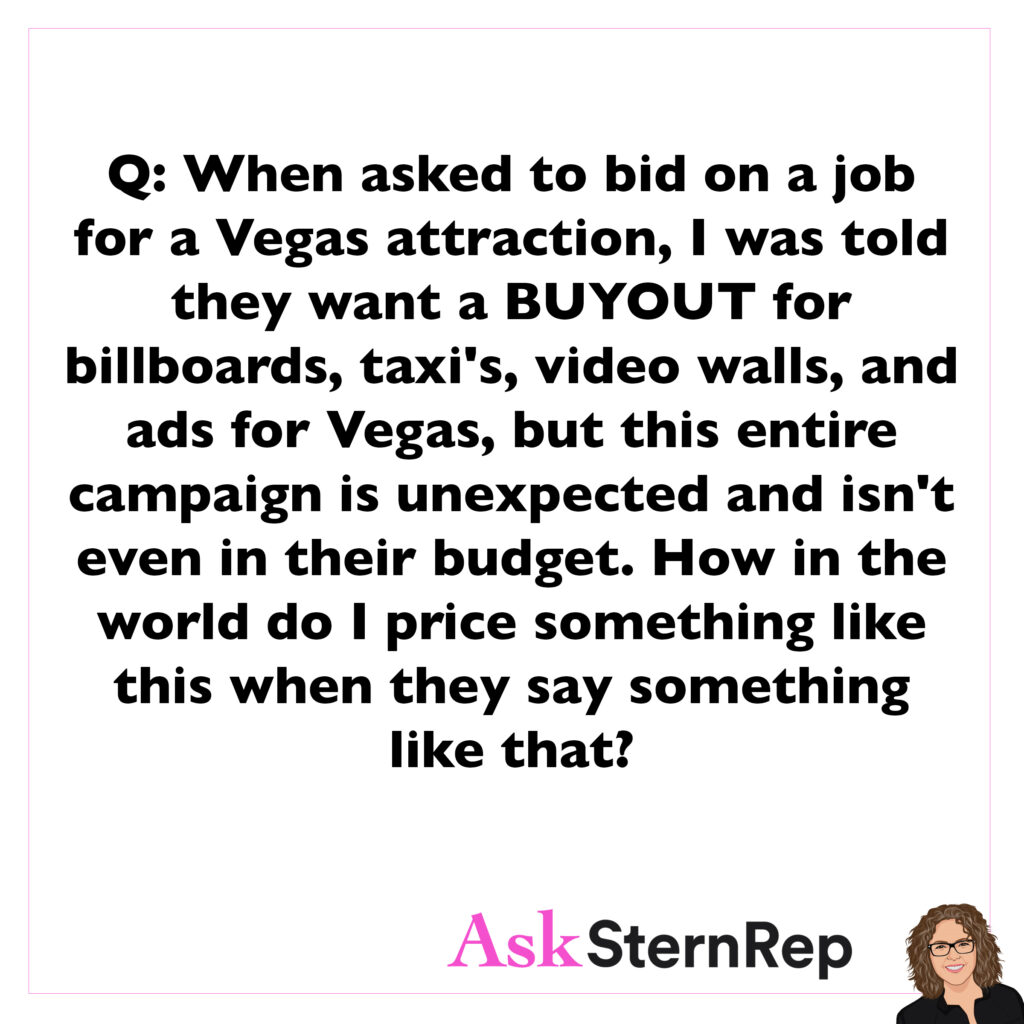

Q:
When asked to bid on a job for Vegas attractions, I was told they want a BUYOUT for billboards, taxis, video walls, and ads for Vegas, but this entire campaign is unexpected and isn’t even in their budget. How in the world do I price something like this when they say something like that?
A:
When I hear this from a potential client, I hear, “We are looking to get a good deal with the lowest bidder.” This is a sales tactic that gives you a sense of what they are looking for. If you have any “down & dirty” ideas that will get them more bang for their buck with less of a production, this is that type of photoshoot. My warning in this situation is to have your estimate terms clearly state what IS and what IS NOT included in your bid. No surprises!
Untold Language of Our Business
One of the untold languages of our business during triple bidding is when the response to your bid is requesting you to increase a particular line item usually means you are not the first choice. Ouch. I know it’s not easy, but it is best to know where you stand and what you are probably dealing with.
Instagram Influencer Photoshoot
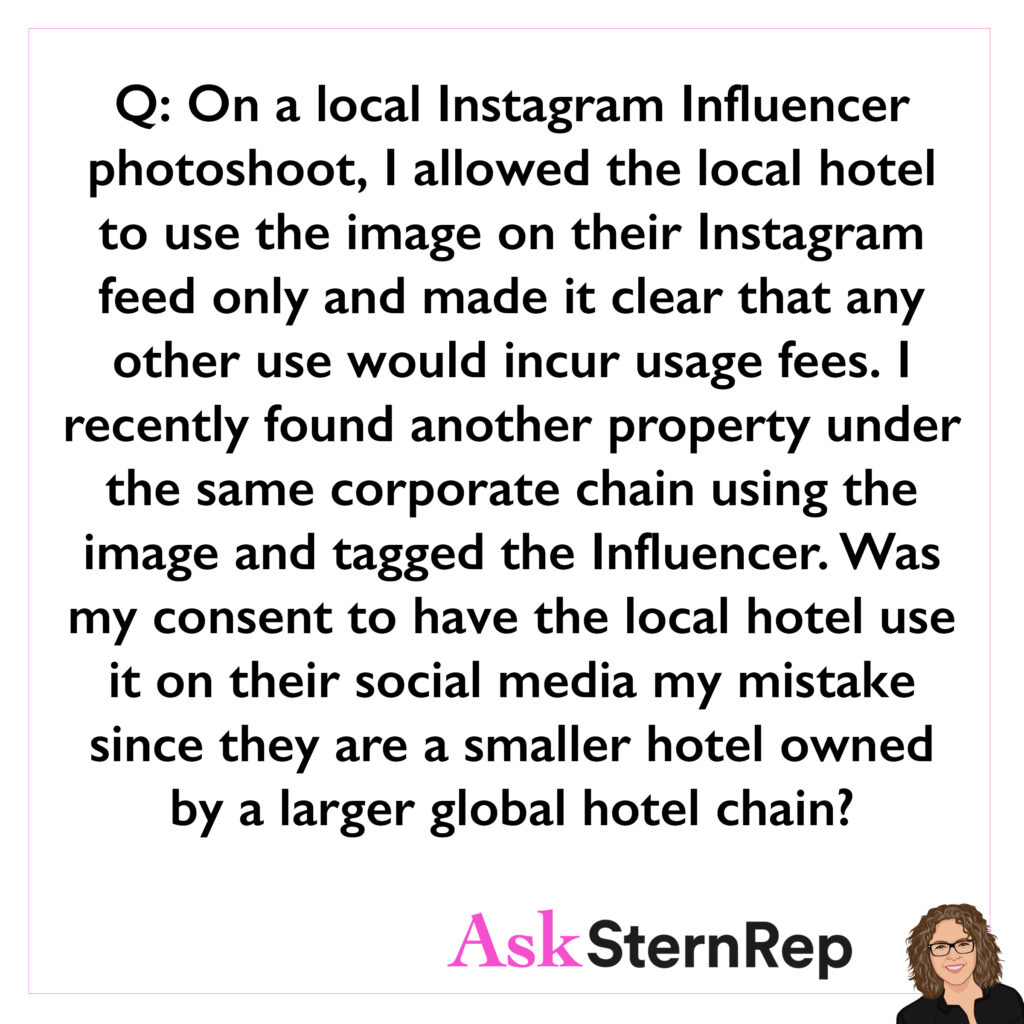

Q:
On a local Instagram Influencer photoshoot, I allowed the local hotel to use the image on their Instagram feed only and made it clear that any other use would incur usage fees. I recently found another property under the same corporate chain using the image and tagged the Influencer. Was my consent to have the local hotel use it on their social media my mistake since they are a smaller hotel owned by a larger global hotel chain?
A:
Influencer social media posts lead to unclear third-party usage that we should be getting paid for. I’ve temp-repped these situations by explaining to the negligent part how licensing needs to be granted by the photographer and not the Influencer. The challenge for us is we have Influencers giving away our usage rights as they often believe they own the images. Originally our terms need to be clearly stated on a signed estimate and explained, so all parties are clear. After that, we can go after them to get paid, which is often a process of educating everyone involved. One company I’ve heard to help photographers get paid for their images used without permission is https://pixsy.com.
Don’t Let Your Comfort Zones Limit Your Decisions
Don’t let your comfort zones limit your decisions. You are an artist and, in that job definition, means a requirement of experimentation. We are in a business based on broadening out through trial and error, not controlled by what you already know.
Artist = Uncomfortable
Client Killed A Project
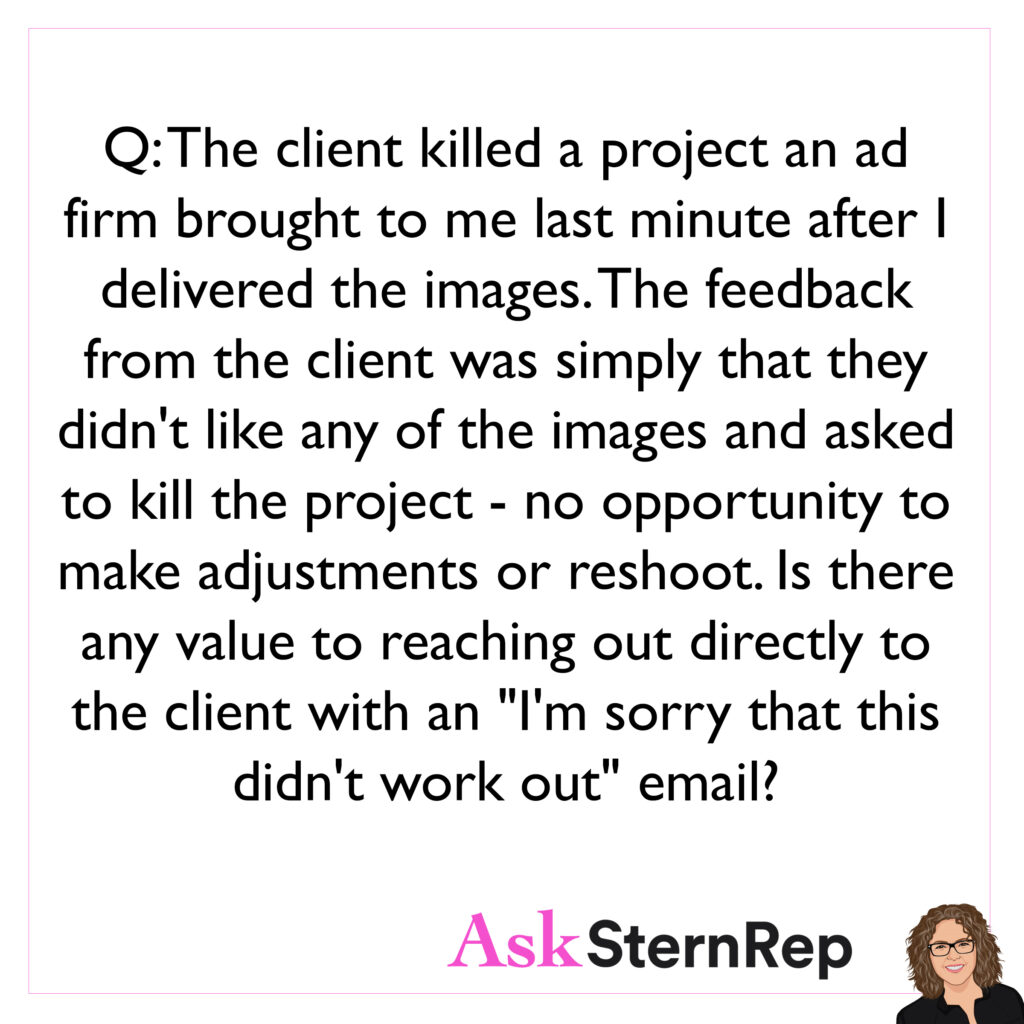
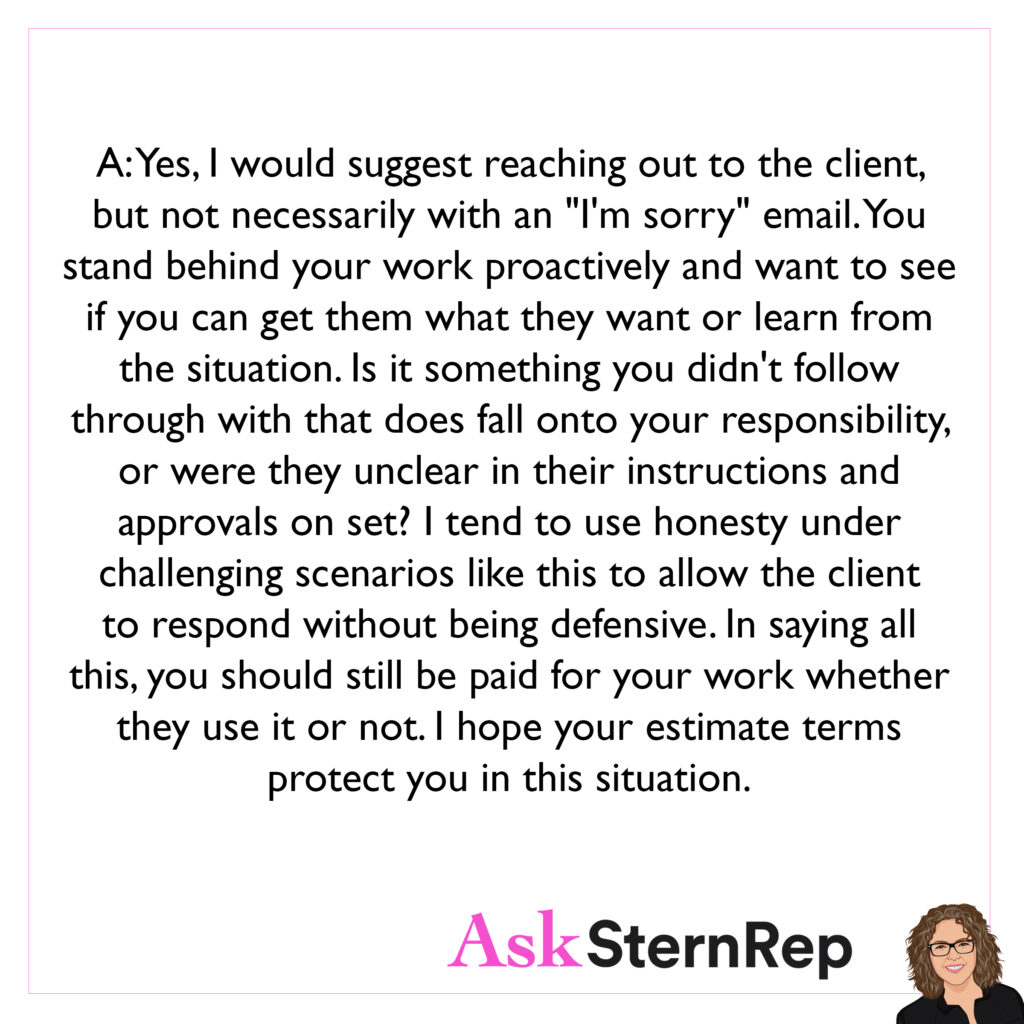
Q:
The client killed a project an ad firm brought to me last minute after I delivered the images. The feedback from the client was simply that they didn’t like any of the images and asked to kill the project – no opportunity to make adjustments or reshoot. Is there any value to reaching out directly to the client with an “I’m sorry that this didn’t work out” email?
A:
Yes, I would suggest reaching out to the client, but not necessarily with an “I’m sorry” email. You stand behind your work proactively and want to see if you can get them what they want or learn from the situation. Is it something you didn’t follow through with that does fall onto your responsibility, or were they unclear in their instructions and approvals on set? I tend to use honesty under challenging scenarios like this to allow the client to respond without being defensive. In saying all this, you should still be paid for your work whether they use it or not. I hope your estimate terms protect you in this situation.
Personal Work
Personal work should be boosting the process of getting clients to know who you are.
Ask yourself, does this image emphasize how I think or what I offer clients when they hire me?
All in all, this is about sharing what runs your creative engine.
Reaching Out To Get Represented
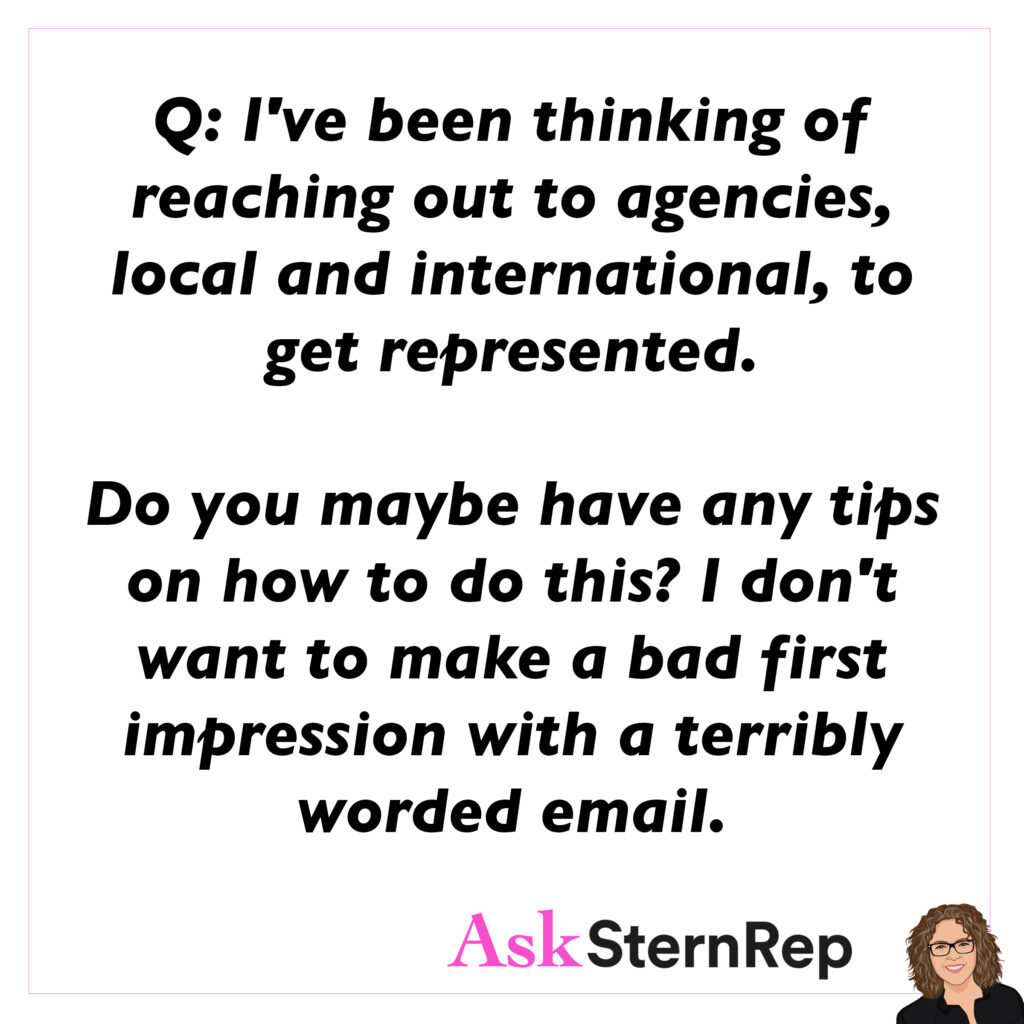
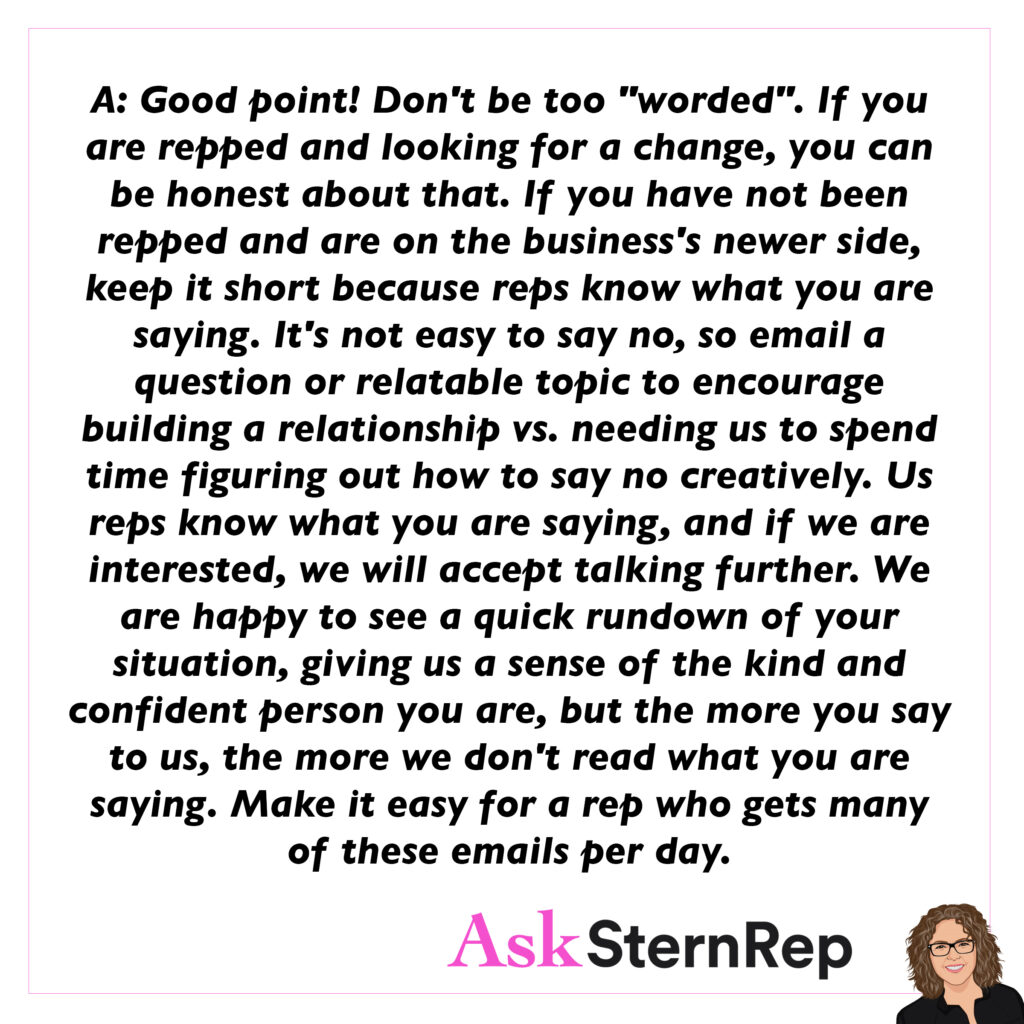
Q:
I’ve been thinking of reaching out to agencies, local and international, to get represented.
Do you maybe have any tips on how to do this? I don’t want to make a bad first impression with a terribly worded email.
A:
Good point! Don’t be too “worded.” If you are repped and looking for a change, you can be honest about that. If you have not been repped and are on the business’s newer side, keep it short because reps know what you are saying. It’s not easy to say no, so email a question or relatable topic to encourage building a relationship vs. needing us to spend time figuring out how to say no creatively. Us reps know what you are saying, and if we are interested, we will accept talking further. We are happy to see a quick rundown of your situation, giving us a sense of the kind and confident person you are, but the more you say to us, the more we don’t read what you are saying. Make it easy for a rep who gets many of these emails a day.
Finding The Right Rep Checklist
Finding the Right Rep Checklist:
- Who reps competing photographers you admire?
- Which reps work with the clients you want to be working with?
- Referrals work best, so ask those in the biz like a paid membership resource you are on, consultants, and clients for their rep suggestion.
- What type of reps branding best fits your style?
- Start with a “Temp Rep” situation to get to know if you work with the same approach on a project.
- What marketing platforms are most important to you, and which reps meet your standards in their marketing?
- The most important one is the rep’s reputation. Ask around and get some good reports on those you can trust.
Images For Broadcast
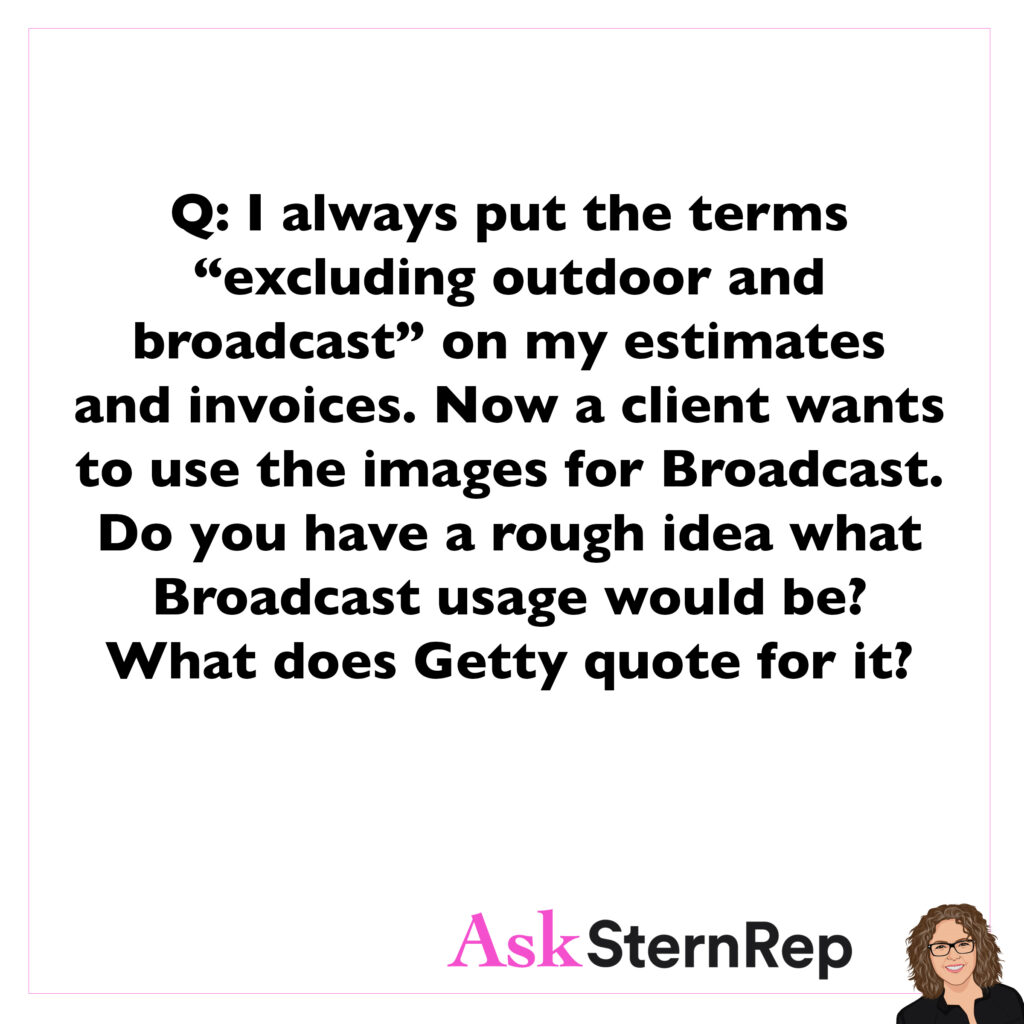

Q:
I always put the terms “excluding outdoor and broadcast” on my estimates and invoices. Now a client wants to use the images for Broadcast. Do you have a rough idea of what Broadcast usage would be? What does Getty quote for it?
A:
The only reason to fill the usage terms of what is excluded would be to educate a client who may not know much about licensing rights or as a teaser to encourage them to use it for OOH or Broadcast. Legally, they can only use it for what you are granting them. Getty may have something you can look at on their site, but I don’t use it. All fees are random as there is no set amount for Broadcast or others. I’ve seen fees go across the board, so I hate to rely on one set of numbers. Broadcast is large, so you can double or triple what they paid in usage for the other usage. I find negotiating tactics are the real answer to these questions because it depends on the client’s budget.
Commit Yourself to Regular Testing
Photographers, don’t let your busy, complicated life in the freelance world get you sidetracked from your pursuit as an A+ level long-term photographer.
Commit yourself to scheduled regular testing to explore and experiment, seeing how far your creative eye can take you.
Testing is that golden nugget to take yourself to the highest level and make it last.
Personal Work on Instagram


Q:
Here’s one for you! Sometimes I wonder how much personal work I should share on Instagram. I feel it occasionally adds a pop of color or style to my feed, mixed in with my client work. But I don’t want to overdo it. Hmmm.
A:
Your apprehensive response is correct. At the moment, your Instagram feed may feel like a daily update, but you have to approach this as your long-term business referral selling point. You don’t want to overdo the personal work in your feed, as the timely or obscure twist could work against the quick, powerful read of what you will bring to a project.
How To Get The Job
HOW TO GET THE JOB:
Be the director the client will hire you to be, from start to finish.
Have your plan in mind and confidently share it as, “This is the way to go,” to achieve their goals.
There is no need to buffer it with safe comments like, “My opinion is…” when you want to be hired as the creative lead carrying out your creative vision.
The Purpose of the Creative Call


Q:
Do you think the purpose of the Creative Call is to give a verbal and preliminary treatment to clients before the actual treatment?
A:
Yes, the creative call is when we introduce our verbal treatment, noticing the back and forth reactions sparked by the hot topics clients want to discuss. We use this call to monitor how the 2-way conversation flows, giving us a more concise roadmap to our treatment.
Be Prepared To Discuss Your Costs With Your Client
When bidding on a job, clients may ask us to dive deeper into the basis of the costs. Put your business mind to work by understanding what the client needs to hear from you.
Our estimates cover us for unexpected real-life additions like grip truck availability, insurance changes, crew covid testing results, overtime, etc.
Our bids are not as black and white as clients would assume, so get ready to explain the gray areas in ways that speak their language.
Charging for Interior Shoots

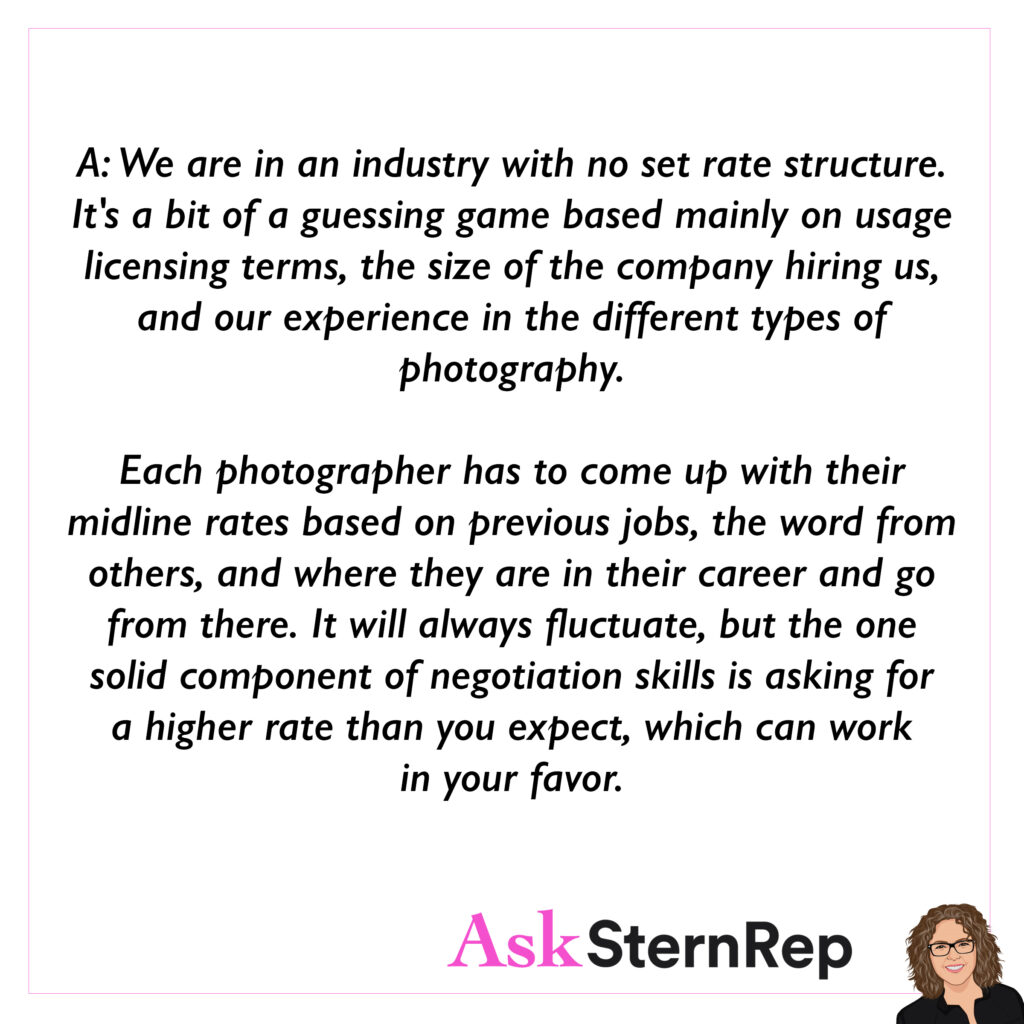
Q:
How do I know what to charge for interior shoots? The scaling of projects is all over the place.
A:
We are in an industry with no set rate structure. It’s a bit of a guessing game based mainly on usage licensing terms, the size of the company hiring us, and our experience in the different types of photography.
Each photographer has to come up with their midline rates based on previous jobs, the word from others, and where they are in their career and go from there. It will always fluctuate, but the one solid component of negotiation skills is asking for a higher rate than you expect, which can work in your favor.
A Professional Lesson
One of the best professional lessons I learned was to keep negatively emotionally charged reactions in check.
Frustration is a normal part of our business but unleashing that onto people we work with is not cool and not professional. Don’t risk it even if it feels rational at the moment.
If You Failed to Fully Deliver on a Client Project
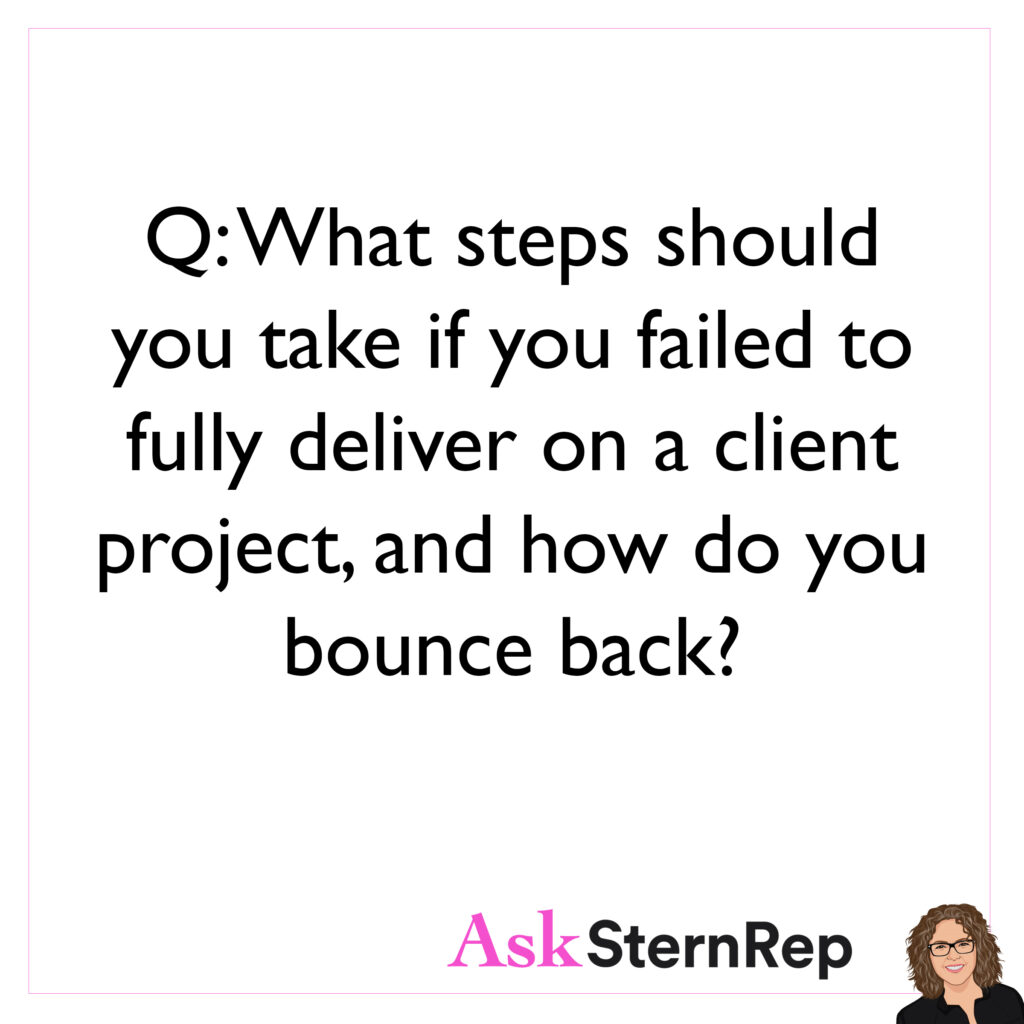
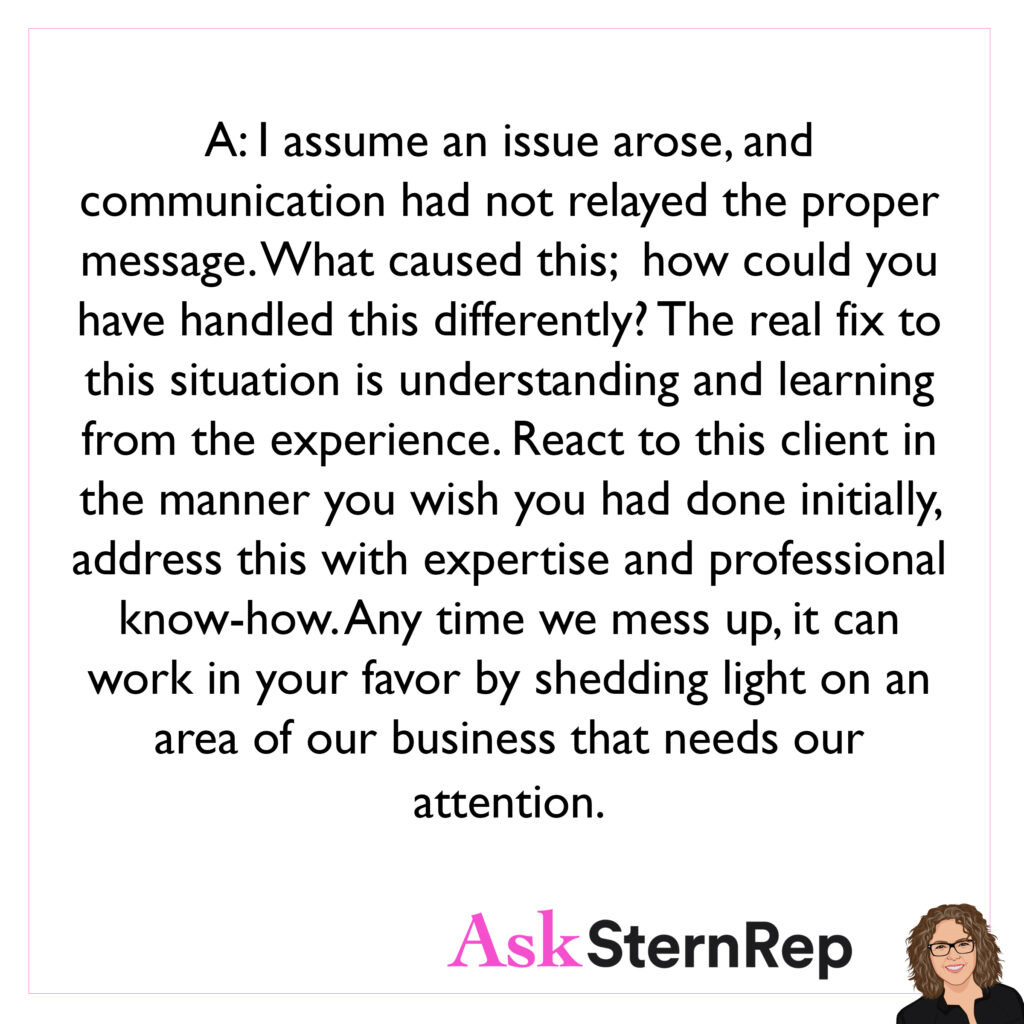
Q:
What steps should you take if you failed to fully deliver on a client project, and how do you bounce back?
A:
I assume an issue arose, and communication had not relayed the proper message. What caused this; how could you have handled this differently? The real fix to this situation is understanding and learning from the experience. React to this client in the manner you wish you had done initially, address this with expertise and professional know-how. Any time we mess up it can work in your favor by shedding light on an area of our business that needs our attention.
Marketing Promo Types for Photographers
A promo type that will work for one client may not work for another; that is why I use all four of these methods to get my promos out.
Four Promo Types:
- Mass email promo showing an individual project or a specific theme with one or more images.
- Mass newsletter email promos are a summary update sharing news with a collection of images.
- One-Sheet promo is an attachment on a short email not needing to be scrolled, creating a warmer, more personable email.
- Printed mailers or leave-behinds with the hopes of being easily saved by clients come in many shapes and sizes designed to show off your work’s branded vibe.
As you may notice, I did not include a pdf attachment on my promo list as they can often be mistaken for dangerous spam materials when sent by strangers.
The Importance of a One-Sheet Attachment Promo in an Email
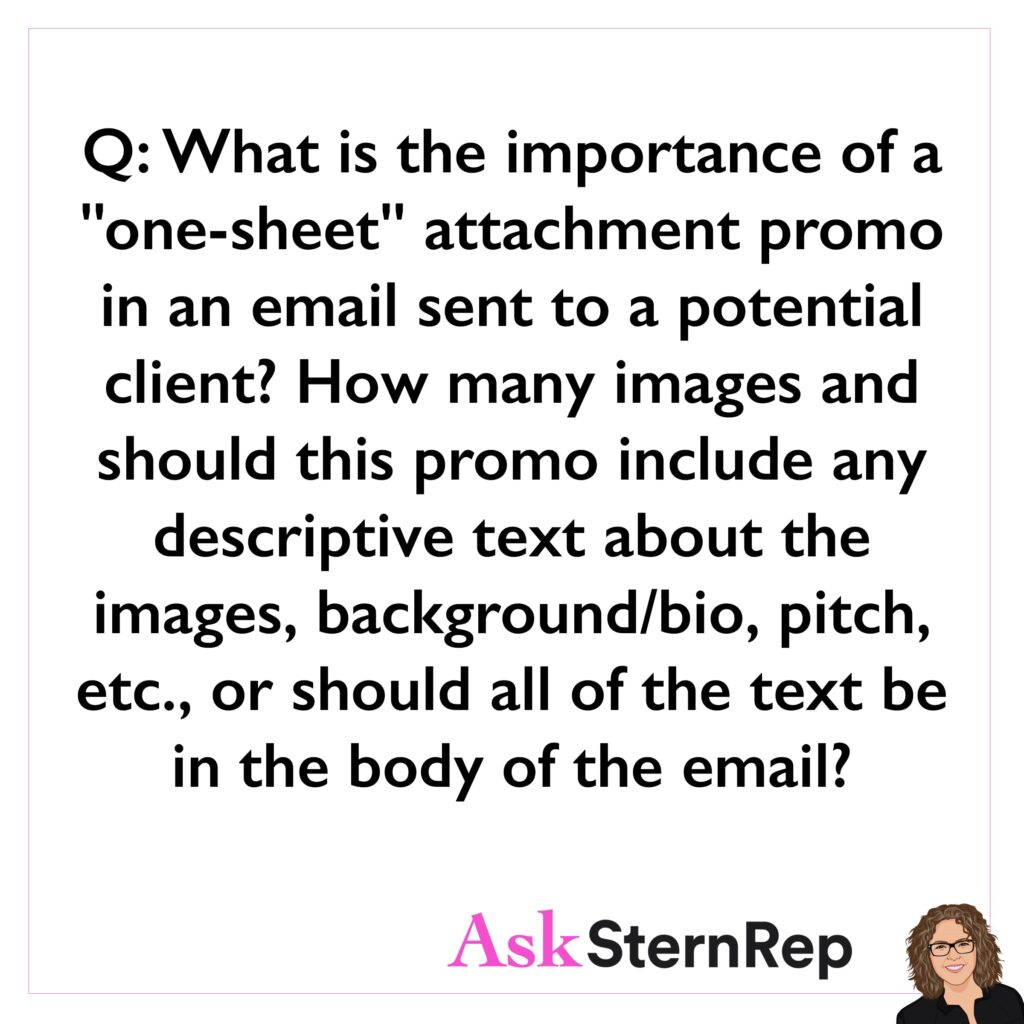

Q:
What is the importance of a “one-sheet” attachment promo in an email sent to a potential client? How many images and should this promo include any descriptive text about the images, background/bio, pitch, etc., or should all of the text be in the body of the email?
A:
When saying hello in an email, it can be good to have a fast visual sampling looking like it belongs in that email. The key to a one-sheet promo is that it’s a quick relatable read of a small number of images only, not needing that extra step of being clicked to open.
Rep Mentality
Every photographer can have that REP MENTALITY mindset, no matter your situation. Your job is to continuously keep your REP (Mentality) excited by actively feeding your marketing supply chain.
Are Elaborate Promos Worth The Money?
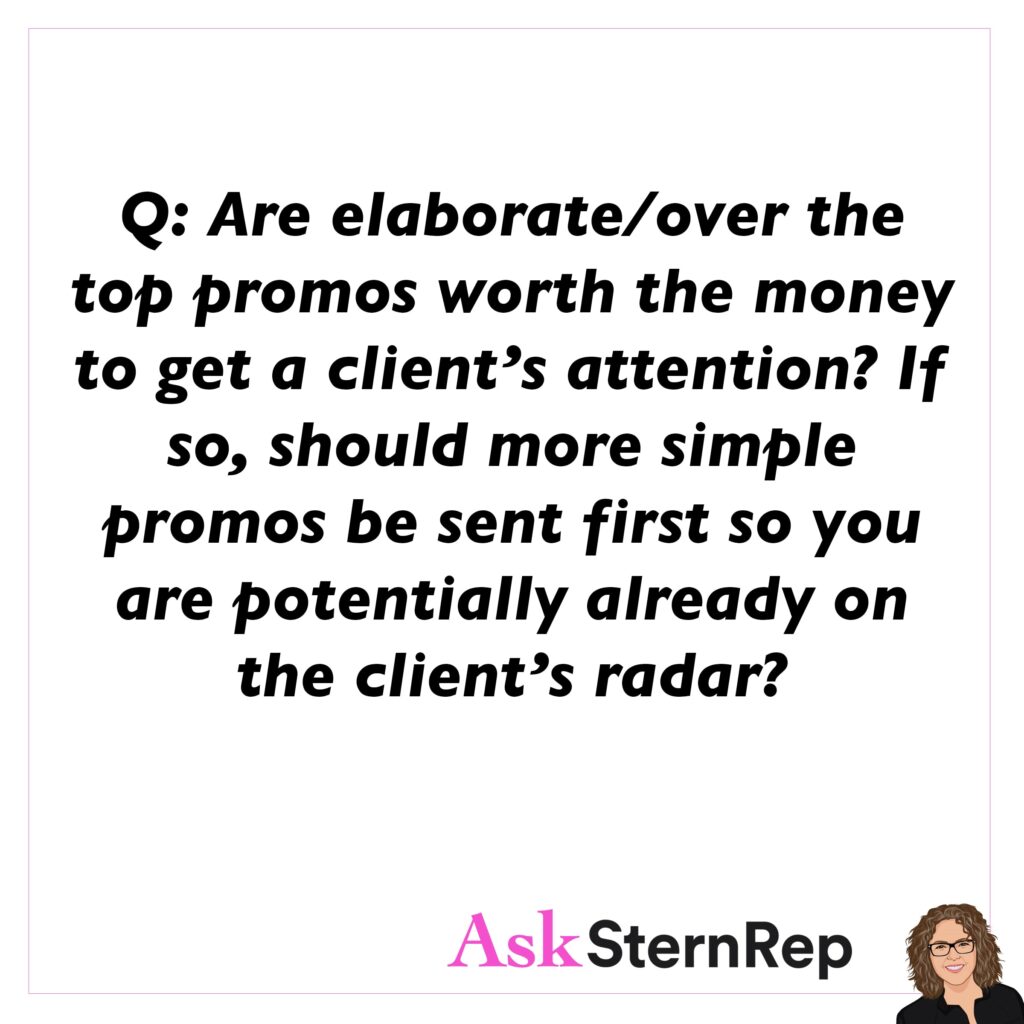

Q:
Are elaborate/over the top promos worth the money to get a client’s attention? If so, should more simple promos be sent first so you are potentially already on the client’s radar?
A:
Depending on your budget, I like to stick with consistent, well-designed promos with a quick, concise message. The expensive promos we can send or hand to clients could be a striking piece that ends up on their wall, getting the attention of a long-standing art piece. I’ve seen this happen, but it’s like going to Vegas and playing the High Roller risky games.
Negotiation Points Relating to Creative Fees
Negotiation points to use when clients ask specifically for a eduction in Creative Fees:
- Scaling down any area of their usage terms.
- Trimming amount of images, variations, and angles on the shot-list.
- Reducing the number of final images included in usage terms,
- Limiting shoot days hours maximum.
- Time-saving production tasks they take over like prop shopping, producing, retouching, casting, scouting, etc.
- Predetermined creative concepts/shot list they supply before the shoot day begins.
- Guaranteed faster final payment and/or larger advance payment before the shoot begins.
- Bulk discounted rate based on future projects
Email Promo Clicked Lists
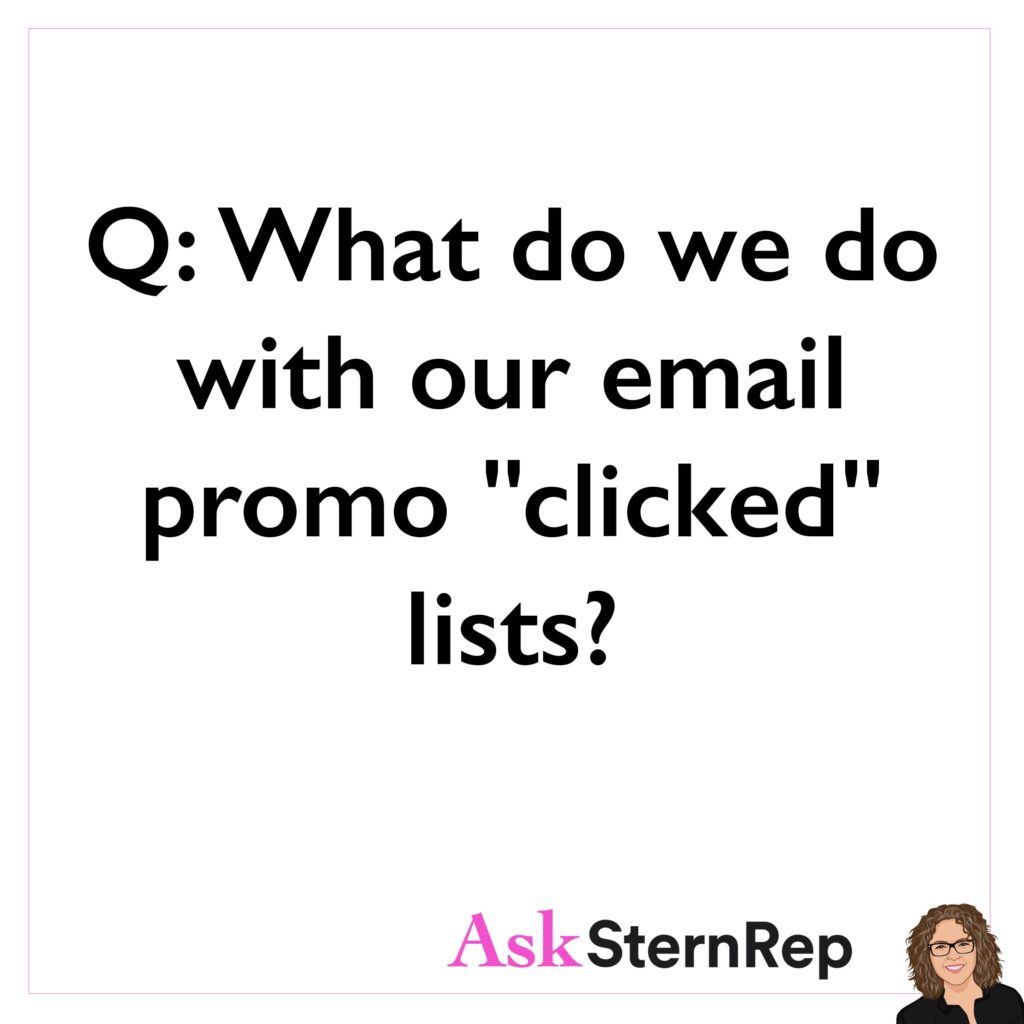

Q:
What do we do with our email promo “clicked” lists?
A:
To know who CLICKS from our email promo to our website supplies valuable feedback shaping our marketing direction. Analyzing this relevant resource can be what you need to know.
- Put them on a hotlist and use every method to follow up with them, including following and engaging on IG.
- Look up all the others at that agency or company on Agency Access, yodelist, and LinkedIn to get them on your lists. If your work is applicable for one person at that place, I will put money down that the same is true for the others.
- If one of your top dream list clients didn’t have any clocks, you know you have some changes to make.
- Compare the marketplace segments clicking percentages to see which category of clients your work is attracting vs. which types are not being drawn in.
- When you get an unusual amount of clients or lack of clicks from one email, use that to analyze what was different, like your subject line, the time or the day of the week, wording changes or design.
You Are a Business Owner With a Marketing Mentality
Photographers come from the training to be a photographer. I get it, but we must treat it as a business for this training to pay off. 24/7, you are now a business owner with a Marketing Mentality, always by your side and ready to go. What company can exist without marketing and self-promotion? We have to open up our sights, taking this where we want to go.
Do You Always Expect Clients To Negotiate?
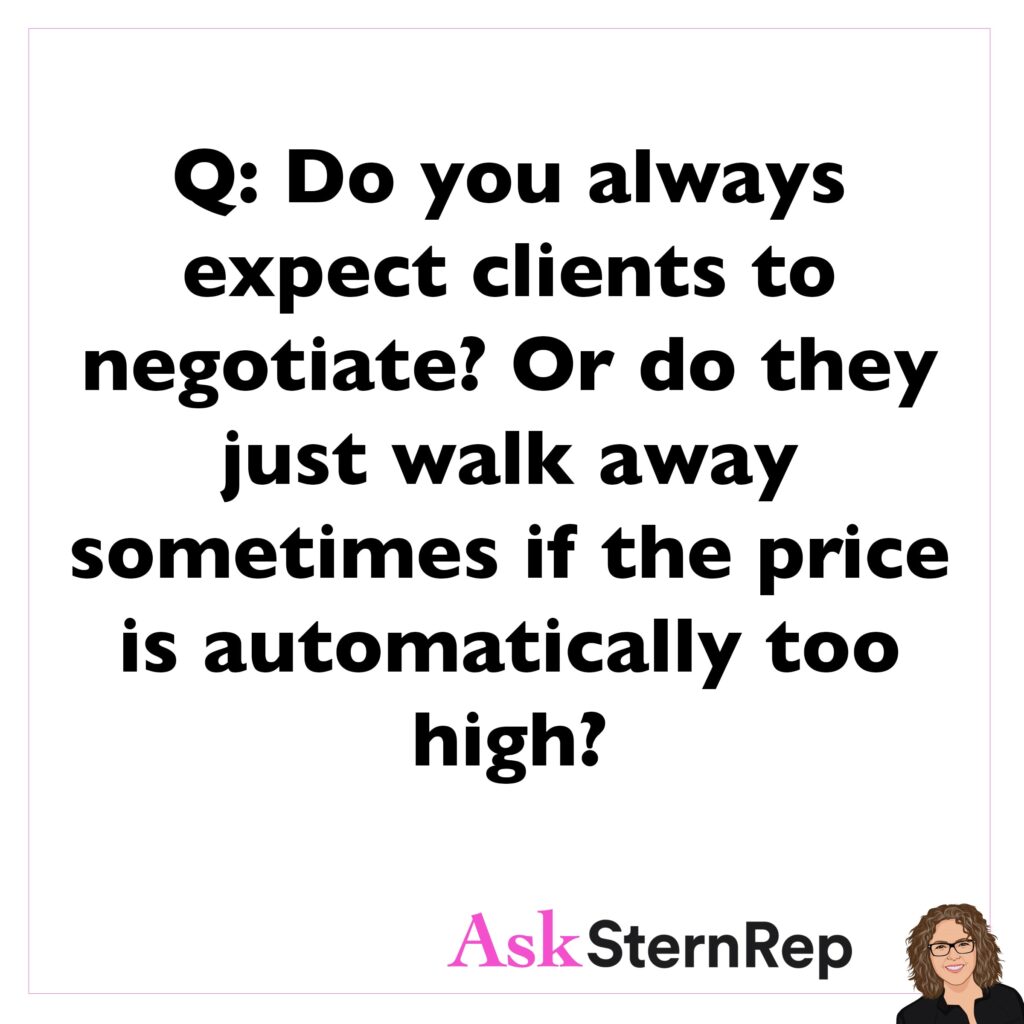
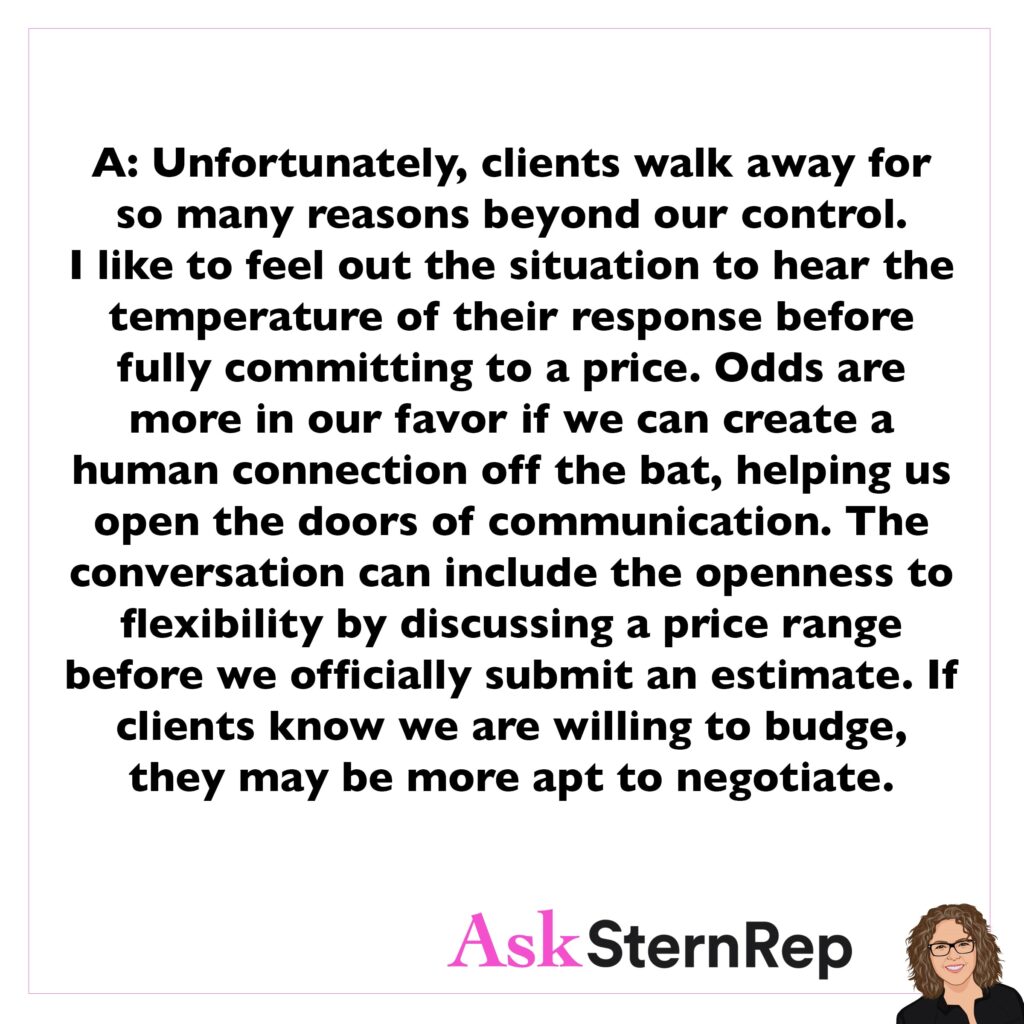
Q:
How do I leverage this abundance of accolades and high end client work to get more exposure? My past mailers and hand curated Do you always expect clients to negotiate? Or do they just walk away sometimes if the price is automatically too high?
A:
Unfortunately, clients walk away for so many reasons beyond our control. I like to feel out the situation to hear the temperature of their response before fully committing to a price. Odds are more in our favor if we can create a human connection off the bat, helping us open the doors of communication. The conversation can include the openness to flexibility by discussing a price range before we officially submit an estimate. If clients know we are willing to bridge, they may be more apt to negotiate.
Bid Prep Step One
BID PREP STEP ONE:
Being ready to go with a solid inventory of crew + producers based on different bidding scenarios and locations can help you (me) avoid the regretful danger zone of losing a job we didn’t need to lose. Be ready to reach out without relying on only a few contacts because it could be too late by the time we hear back. Some jobs are pressure-cookers where the fastest one wins! Building a comprehensive crew and producer list has to happen way before the bid requests come in.
Leverage Client Accolades To Get More Exposure
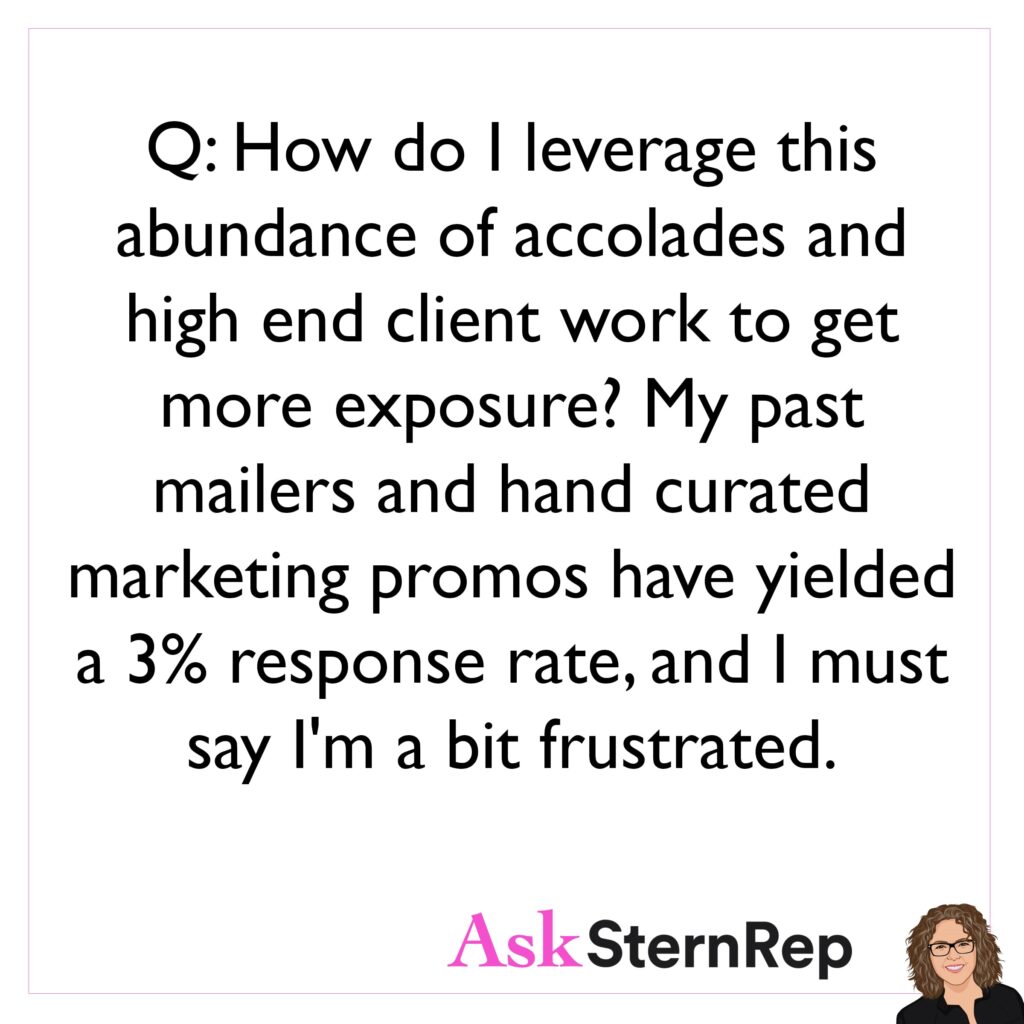
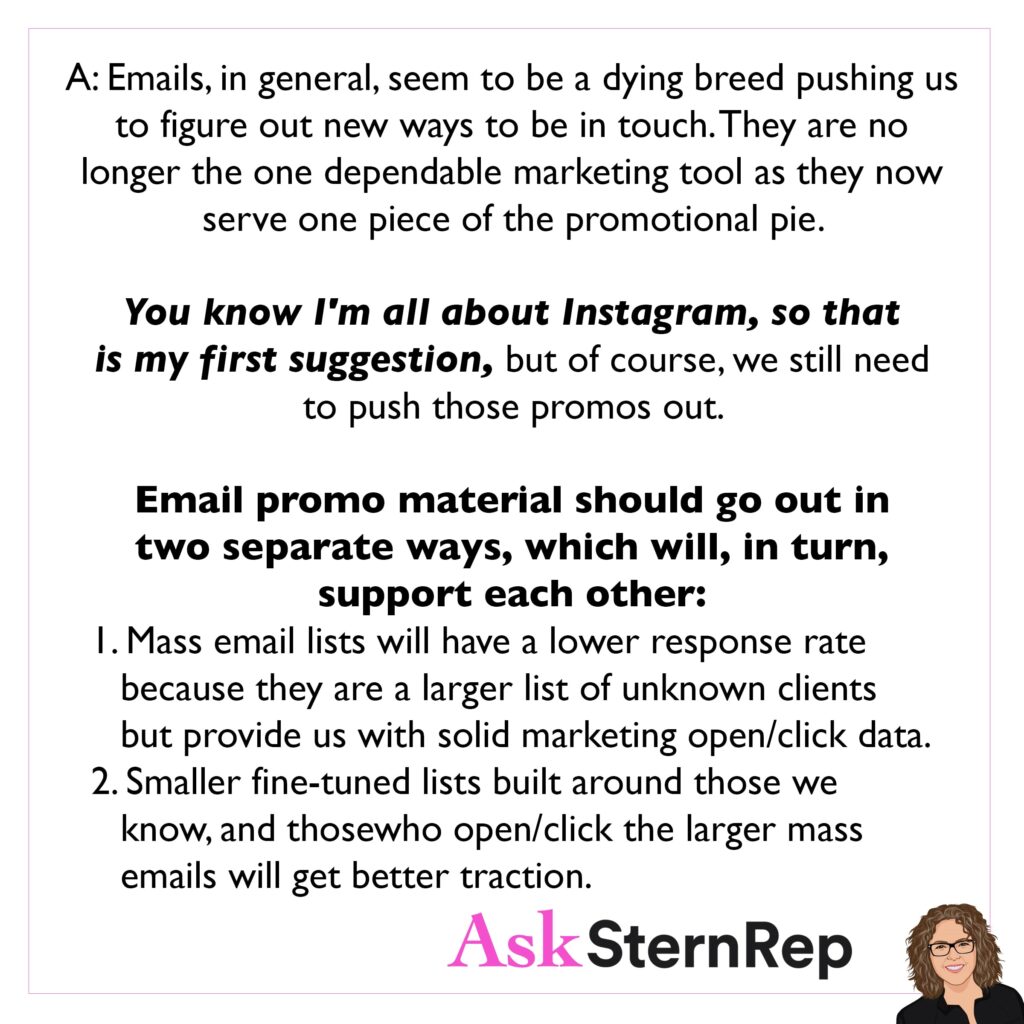
Q:
How do I leverage this abundance of accolades and high end client work to get more exposure? My past mailers and hand curated marketing promos have yielded a 3% response rate, and I must say I’m a bit frustrated.
A:
Emails, in general, seem to be a dying breed pushing us to figure out new ways to be in touch. They are no longer the one dependable marketing tool as they now serve one piece of the promotional pie.
You know I’m all about Instagram, so that is my first suggestion, but of course, we still need to push those promos out.
Email promo material should go out in two separate ways, which will, in turn, support each other:
- Mass email lists will have a lower response rate because they are a larger list of unknown clients but provide us with solid marketing open/click data.
- Smaller fine-tuned lists built around those we know, and those who open/click the larger mass emails will get better traction.
The Niches We Fit Into
What niches we fit into and what titles we call ourselves are beneficial but not the only part of our business path decision-making process.
Our business minds alone cannot always run the show. The challenging piece is where one direction or opportunity may take us, which must be the guiding force. We can’t get too stuck on our business titles when we are in a creative career like this; growth and opportunity lead the show
Cinematographers vs Photographers


Q:
Why can the best cinematographers serve the story and change their look for each script, depending on the requirements of the script, but if a photographer does that, they are condemned, overlooked and discarded for being a “generalist?”
A:
We get to choose two types of paths: technically savvy with a lot of variety or those who provide a more specific curated style, look and feel. Both options can work, giving you a long-lasting accomplished career, usually depending on your situation, the size of your market, and your skillset. I’ve repped both of these and found the careers of generalists depend on the relationships they build, and the specialists get jobs for their portfolios.
How Do Photographers Get Started?
How do Photographers Get Started?
3 Step Formula for All Photographers:
1. PORTFOLIO RESEARCH
Regular education and research of our imagery industry will help you master the “Objective” eye, giving you the skills to edit your work.
2. CHOOSE THE STYLE
The constant honing-in forward growth of what your style is about will bring you the control clients can depend on.
3. ATTITUDE
Owning who you are, finding ways to express it allows clients to know what they get by hiring you.
Does A Photographer’s Personal Work Define Their Style?


Q:
Do you think it’s a photographer’s personal work that defines their style?
A:
As Amy V. Cooper would say, “This is one JUICY question!” The definition of personal work can mean two very different things. Personal could mean family dinners and travel images, or it can mean testing similar types of scenarios helping to grow even stronger. Personal testing work takes a photographer’s style to that next level. It is how the craft is freely explored and shaped with 100% focus from within creative inspiration vs. an industry trend or client’s guided brand decisions.
What’s Helping You Run Your Photo Business?
What’s out there helping you run your photo business?
Let’s share our favorite resources.
Here are My Top Five:
- www.pixsy.com – get paid when your images are being used without your permission.
- www.hunter.io – valuable email formats for every company.
- www.aphotoeditor.com – loaded with today’s industry info.
- www.adweek.com/agencyspy – find the updates on the companies you want to work with.
- www.adsoftheworld.com – know who has worked on which ad.
Testing With Brands on Social Media


Q:
I photographed some products at home (self assigned). I tagged the brand, they saw my work via DM. A few months later they came out with a campaign that is almost identical to what I shot. This has happened to me 3 times with 3 different companies, so I don’t think I’ll be shooting sample things and posting them on Instagram, maybe on my portfolio but that’s it…not sure. What are your thoughts on this?
A:
It is hard to prove when a company uses your copyrighted images for their concepts, but that is one way to approach this. Before posting the images, make sure you register your copyright if you foresee going down the legal path.
My REP thought is this guidepost of encouragement showing you are right on the money with your direction instead of using this as a reason to lower viewings of your images. You have something hot happening here that may need a slight fine-tuning to strengthen the unique magic you offer.
Marketing Tip = Timeliness
Marketing Tip = Timeliness
Immediate follow-up is one way to secure your position in a client’s memory.
Use the open door at the moment to open the doors of your future through LinkedIn, IG, a handwritten card, send a plant, an email or any type of old-fashioned follow-up whether you get the job or not. Go with what works by using the moment to your advantage.
Bidding for Branding Services


Q:
I was invited to bid for what developed into branding services for a white-labeling startup company. The company to whom I was “bidding” did not actually provide a specific scope, brief or RFP. Such is how it grew into a “branding” project. Their communication with me wasn’t very responsive. I interpreted it being more like an RFI, providing them with the following:
- A list of typical deliverables.
- A list of things not included.
- A budget range with minimum & not-to-exceed amounts.
- An explanation of how scope development was needed to pinpoint the actual cost of services.
- Scope development was included in the minimum.
What is your opinion on my approach on the above mentioned project?
A:
This request sounds like the massive amount of undeveloped clients using social media mass photographer reachability to save them money. You’ll need to quickly assess if this is a reliable potential client or an “info for free” mass request.
They are asking you to be their creative development ad agency so you can:
- Do that for free.
- Give them your hourly rate for that type of branding work.
- Tell them to contact you again when they have their shot list spec sheet prepared.
Five Ways To Protect Ourselves From Sales Tax Laws For Photographers
The California law states that for a photography sale to be non-taxable, you cannot supply any form of tangible personal property, including Hard Drives. You can only upload the photos to a computer owned by the customer or send them via electronic transfer.
Five ways to protect ourselves from the vague Sales Tax laws for Photographers:
- Change “Hard Drive” to Image or Digital Management.
- Have your retoucher electronically send images to the client directly.
- You digitally transfer all the images.
- Out-of-state clients with no offices in your state don’t require sales tax.
- Uploading all images to the client’s business computer is the official legal procedure.
Providing A Brief or a Deck With An Estimate

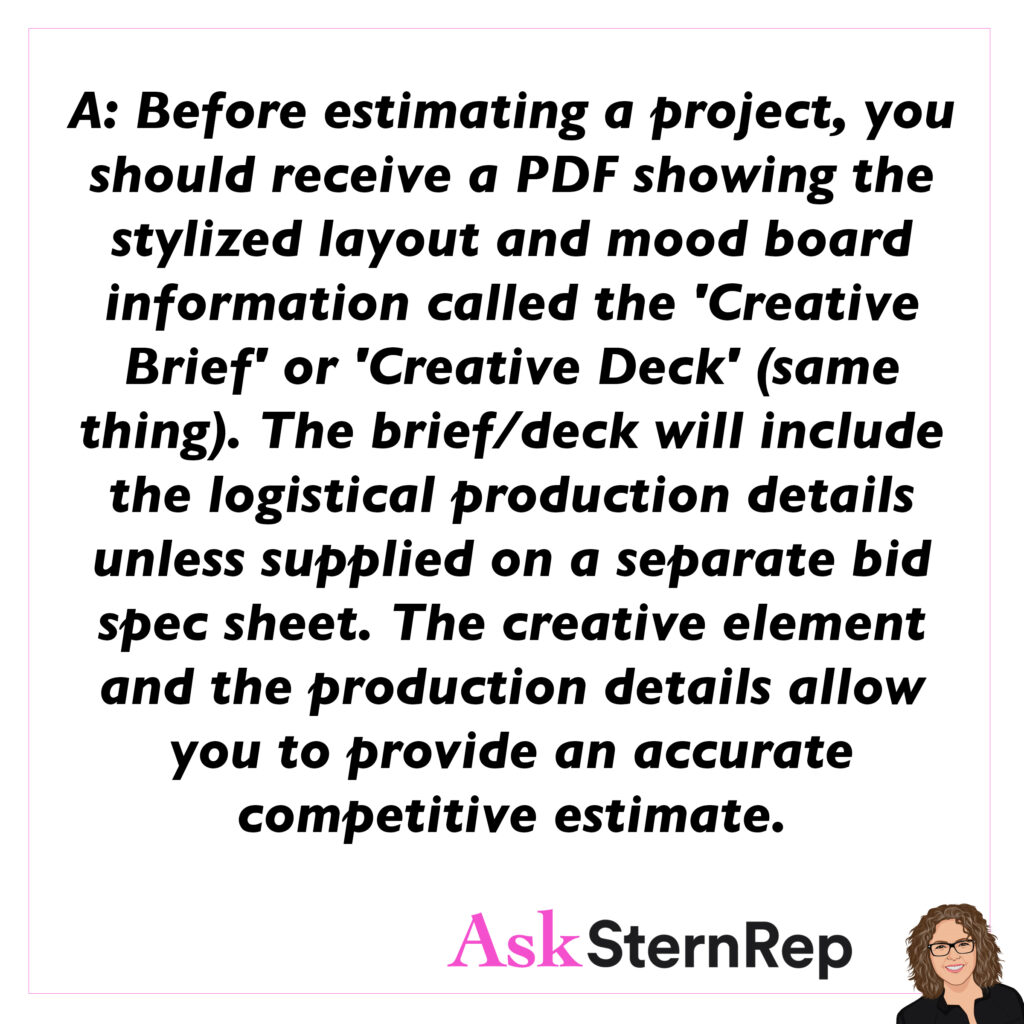
Q:
What’s the difference between a brief and a deck? Do these usually have all the information I need to do an estimate?
A:
Before estimating a project, you should receive a PDF showing the stylized layout and mood board information called the ‘Creative Brief’ or ‘Creative Deck’ (same thing). The brief/deck will include the logistical production details unless supplied on a separate bid spec sheet. The creative element and the production details allow you to provide an accurate competitive estimate.
How to Set Up Your Instagram to Bring in Jobs
When done right, Instagram is a free marketing platform that can consistently get your work in front of the right clients and help you grow your business. This Webinar will not be about turning you into an Influencer. We highlight practical strategies that every commercial photographer can deploy to shape their creative presence and optimize Instagram to build an audience that can help create a sustainable business. Originally aired as part of APA Chicago’s workshop, “Industry Experts Talk Photography Growth Strategies for 2022”.
Co-host: Photographer + SternRep/AskSternRep/ASRsocial Creative Director Ranee Vespi https://www.raneevespi.com
Apply now to ASRsocial→ https://www.bit.ly/ASRSOCIAL
Don’t Spend Time On Your Marketing By Looking Like Another Mass Spam Junk Email
Don’t waste all that you put into your Marketing by looking like another mass spam junk email.
Here are some simple ways to have potential clients take our marketing to that next level by clicking to see more.
Easy ANTI-SPAM Checklist:
- Send your emails only to the correct contacts.
- Sound like a human to human with real words as if you are talking.
- Email new images without repeating yourself
- No need to sound “sales-like” as they know why you are contacting them.
Building A Relationship With A Potential Dream Client


Q:
What do I do if I’ve developed a solid synergistic relationship with a potential dream client (who found me!) over numerous emails working out the nitty gritty of a potential project they wanted a cost on, sent the estimate, then got ghosted? I’ve already followed up once (1 week after) now it’s another week after that and not a peep. So disappointing…
A:
Business is business, and as much as clients become our close contacts, we have to remember the ultimate truth that this is their job. We work in an overworked industry where no one has a lot of time.
- Don’t take it personally.
- Your contact means well, but they are busy.
- Set a future date where you will email a kind and lightly humble email, understanding they are busy while blaming your curiosity for checking in on what became of that project.
- Move on to what matters and how to bring your portfolio up to a level not to get passed up for jobs because the real issue is not that they didn’t respond but that you probably didn’t get that job.
How Photographers Can Get Their First Jobs
I get asked a lot about how photographers can get their first jobs.
Let’s call this the INTRO stage as you are meeting the right people in the right places.
Get experience finding opportunities in the areas you want to be working in, and with your confident demeanor, the people in your circles will know who to call when they are hiring.
When Contacting A Potential Client


Q:
When first contacting a potential client, should I say something like, “Here is some new work I’ve done?” Or if you don’t have new work to show, is it too blunt to say you want to work together? Is there etiquette to follow up if you don’t hear from them? I don’t want to be that person that bombards them unsolicited over and over.
A:
I always say we should talk to people as we want to be talked to. When you sense someone is “selling” to you, don’t you want to delete, hand up or walk away? Clients know you want to work with them; that’s a given. The more you can sound like yourself, mentioning the fun location or an educational equipment reference gives them something to remember you by, The real stuff never gets old.
ASRsocial is Open for Business

We are currently accepting applications for photographers who could use a revamp on their Instagram + will be taking on a limited number of clients. Price options will vary depending on individual needs.
ASRsocial is an out-of-the-ordinary social media management service working exclusively with commercial advertising photographers’ looking for new ways to jumpstart their Instagram account.
Photographer agent Andrea Stern is behind-the-scenes, with creative director Ranee Vespi of @sternrep and @asksternrep being the lead contact as we give to you what we have discovered together.
Andrea Stern of @asksternrep/@sternrep: “Have your IG work for you instead of against you. We all know that Instagram is the way to be seen and discovered right now. It’s the new portfolio show and the new email promo. We have to stick to the times and lead the way if we want to be getting the jobs.”
ASRsocial offers:
- Critique of Instagram + Website by SternRep/AskSternRep’s Social Media team, including rep Andrea Stern
- 1-on-1 Coaching with Ranee Vespi, SternRep/AskSternRep’s Creative Director
- Individualized Instagram Strategy
- Personalized Packages
- Branding You as a PERSON, not just as a Photographer // Show your authentic self on Instagram
- Engagement System Plan
- Design + Scheduling Feed
- Content Creation
Apply now→ https://www.bit.ly/ASRSOCIAL
Don’t Waste Time Doing Estimates With Information We Don’t Have
We can’t be spending our time doing estimates on information we don’t have.
I’m hearing a ton of complaints from photographers wasting useless time on estimates that don’t turn out to be the real deal. I hear you! With no bid spec sheets, I get many of these requests that won’t reveal the budget upfront, so I focus on the points that help me see if this client is even ready for an estimate. Our goal is to quickly open up the communication doors, giving us a clearer sense of what we are dealing with.
My quick first step estimating questionnaire:
- What is the Usage?
- What is the specific Shotlist?
- Do you have a creative deck with the layouts + mood-boards?
- What are the talent rates?
- Do you have stylists you like to use?
- When is the creative call?
Estimates, Full Buyout, and Usage Rights


Q:
It was mentioned on your APA-LA webinar on Estimates a range of 8K-$16 for a full buyout. I got a job inquiry for 2 days, 120 images. They demanded a full buyout. I want $10k for the usage rights, plus my day rate. I didn’t get the job because they don’t want to pay this amount for the usage rights. What do you do? Reduce the $10k or keep your position? At the end I chose to keep my position, but I do need jobs…
A:
Usage rates have no definite set amount, so it’s a bit of an educated guessing game. The other guessing game is when clients use the term “full buyout,” which means they own the copyright or unlimited usage for an unlimited duration. Bidding a job requires negotiation to make sure everyone speaks the same language to reach a mutual agreement. In this case, your $10k usage rate request for 120 images is more than reasonable.
Top 5 Business Goals for Photographers
Five Business Goals for Photographers
- Updated portfolio to show off the tightly branded type of work you want to get vs. a resume of work you have done over the years.
- Modified marketing direction plan keeping up with the times and even one step ahead.
- Buttoned up admin downtime work to avoid last-minute scrambles with equipment, crew, treatment and estimate templates, insurance, payroll, taxes, finances, etc.
- What don’t you know? Outsourcing is key.
- Practice that “CAN-DO” attitude in sync with our industry’s fast and furious evolving climate.
Free Shoot And Usage


Q:
I did a free shoot with a celebrity who has a restaurant for a magazine story. When they asked to use the image for a virtual beer tasting event, we kindly allowed them to use it for free. They took that as a blanket usage for all social media without our permission. What kind of contract can we use for approved usage terms with a zero balance? What is the best way to deal with this when we are not charging for the initial use?
A:
Assume when you are photographing in the editorial, portrait, and entertainment industry, you work with people who do not understand copyright and usage terms. Begin with the perspective that you must put everything in a signed contract no matter your fee. Every photographer must have an estimate form signed by the client BEFORE starting the job. “Freelancers” do not mean free from protecting our business. A freelancer means you create your contract with legal terminology available to us on resources like blinkbid.com.
It’s A New Year
It’s a New Year.
Business owners, now is the time to step forward with what does work. The more we know can sometimes hold us back. Not being experienced in something cannot guide the business model. Now is the time to jump into what ‘really matters’ by doing what we don’t already know.
Moving Countries, Not Industries

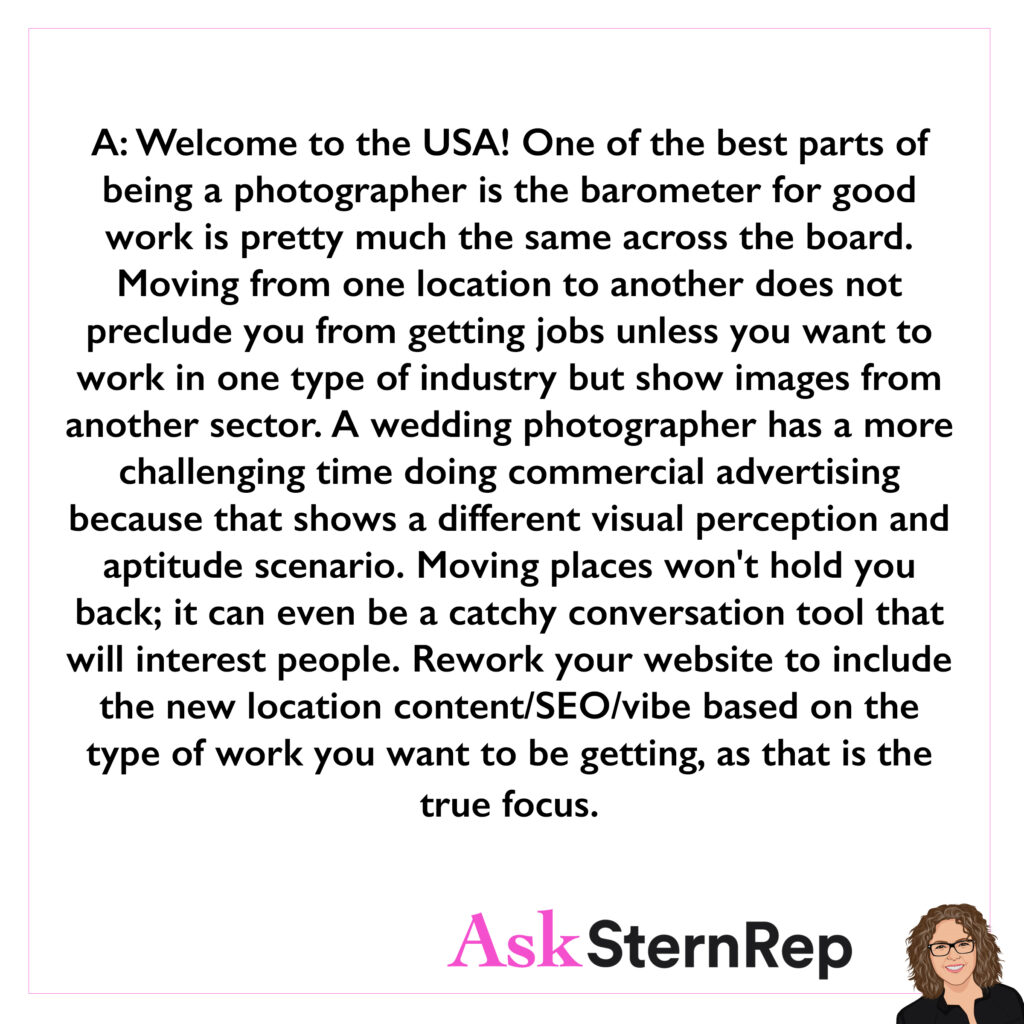
Q:
Hello! I’m a well established Swedish commercial lifestyle and outdoor photographer. I also shoot film and direct. My wife is American, and we are planning to move to Minneapolis soon. The transition from Sweden to the US is a pretty big step. I’ve been thinking of creating a second website that I can promote in the US for SEO and content. I want to meet with reps and, of course, brands and agencies. But as I’m not familiar with the market over there, I don’t know where to begin. What would be a good place to start?
A:
Welcome to the USA! One of the best parts of being a photographer is the barometer for good work is pretty much the same across the board. Moving from one location to another does not preclude you from getting jobs unless you want to work in one type of industry but show images from another sector. A wedding photographer has a more challenging time doing commercial advertising because that shows a different visual perception and aptitude scenario. Moving places won’t hold you back; it can even be a catchy conversation tool that will interest people. Rework your website to include the new location content/SEO/vibe based on the type of work you want to be getting, as that is the true focus.
Owners Need Time To Refuel
As business owners, we are responsible for scheduling time to refuel.
The long-term game plan of a quiet mind creates the metal space to hear new ideas.
Take this job requirement “business” holiday as the tool to clear the path of where you want to go.
Creative Concepting Fee

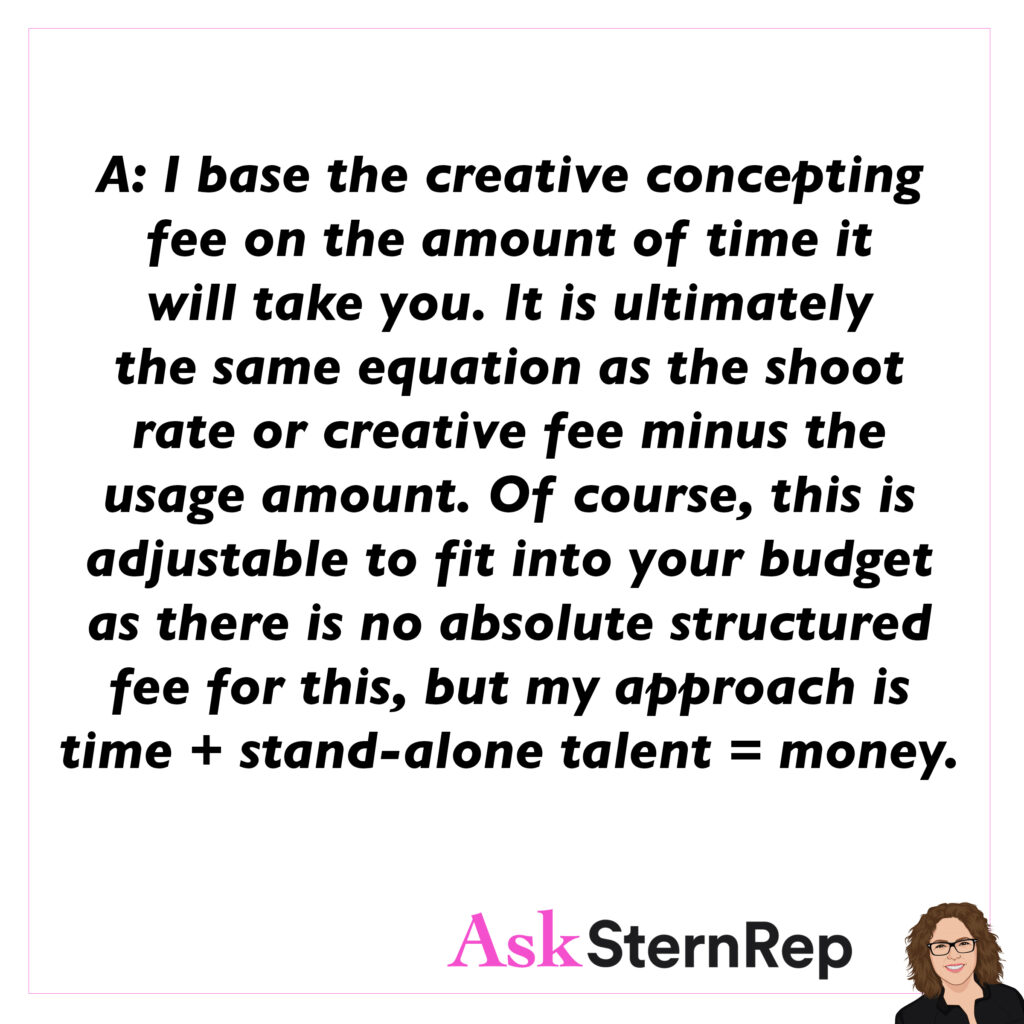
Q:
I feel like I’ve hit a wall with my business. I’m bidding on some jobs, but I’m not getting them. Clients want to get a crazy amount of images per day, and the budgets have shrunk. I’m struggling to stay on top of my game. Advice
A:
I base the creative concepting fee on the amount of time it will take you. It is ultimately the same equation as the shoot rate or creative fee minus the usage amount. Of course, this is adjustable to fit into your budget as there is no absolute structured fee for this, but my approach is time + stand-alone talent = money.
Is This Estimate Request Worth Your Time?
Is this estimate request worth your time?
If only we could find out the budget, that would make it all so simple, but clients tend to keep that to themselves.
3 ways I open up the conversation by presenting the question differently:
- Name a high amount to question what they have in mind.
- Under or over a certain amount can help to get a yes or no.
- A range amount $ between $ offers a safe and manageable option.
Line Item to Cover Admin Prep Work


Q:
What would I put as a line item on my invoice for hourly random admin things? This came up recently when I had a client send me so many pages of documents to fill out; they’re also calling me and winding up on calls for hours and having me send proofs in multiple different ways. I want to bill for that time since it’s excessive but I don’t know what to call it. I would love any insight you have!
A:
Every bid I do has prep days to cover admin organizational time. I’ve even put an in-person pre-production meeting line item in the bid with a $0 amount to show that our prep time is not free.
It’s good to spell out your terms with all the specifics, as far as which tasks are covered by your prep days, so if they want to add more, it’s clear they will pay more.
An Essential Job Bidding Tip
An essential job bidding tip is to take that extra minute to slowly and carefully scan every line, making sure each detail is correct before sending it in. This extra minute is well worth your time and can be a factor in getting you the job vs. losing you the job.
Keeping The Calm With Out-Of-Control Clients
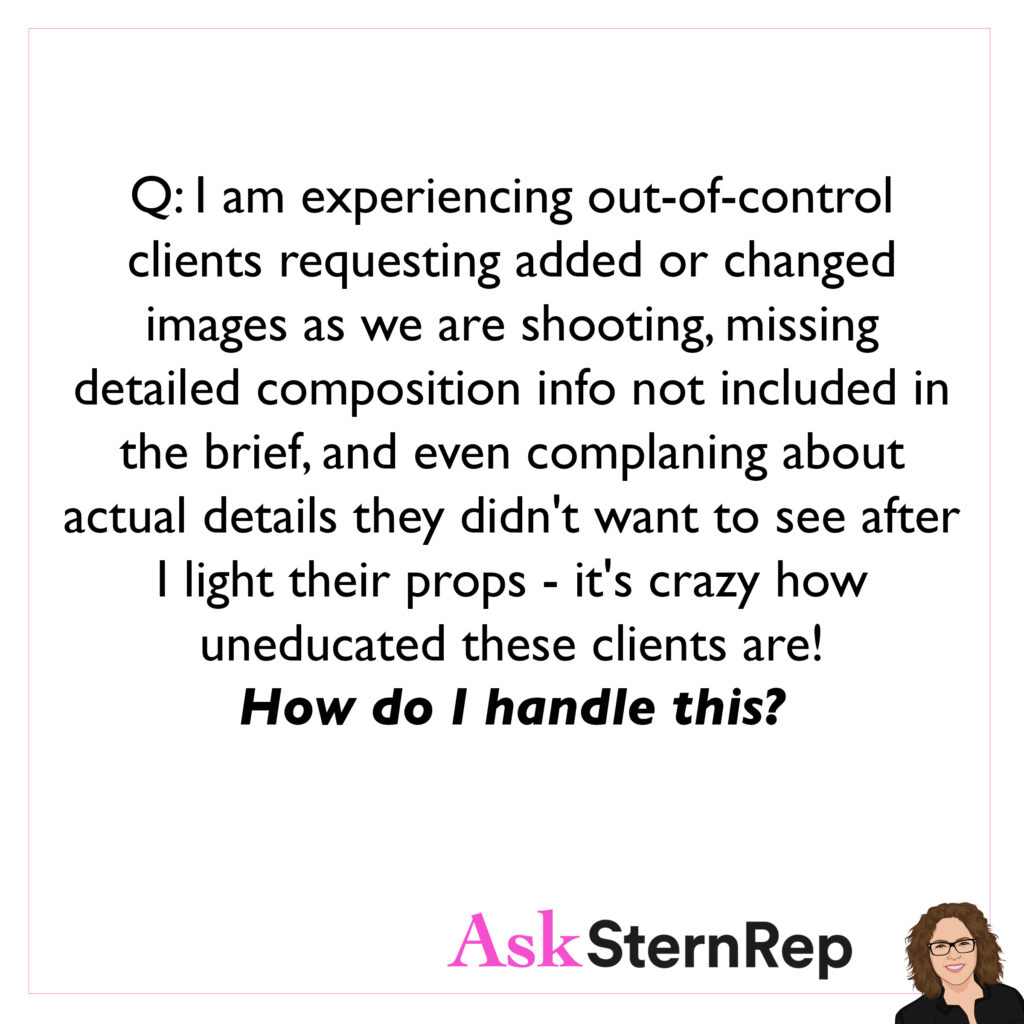
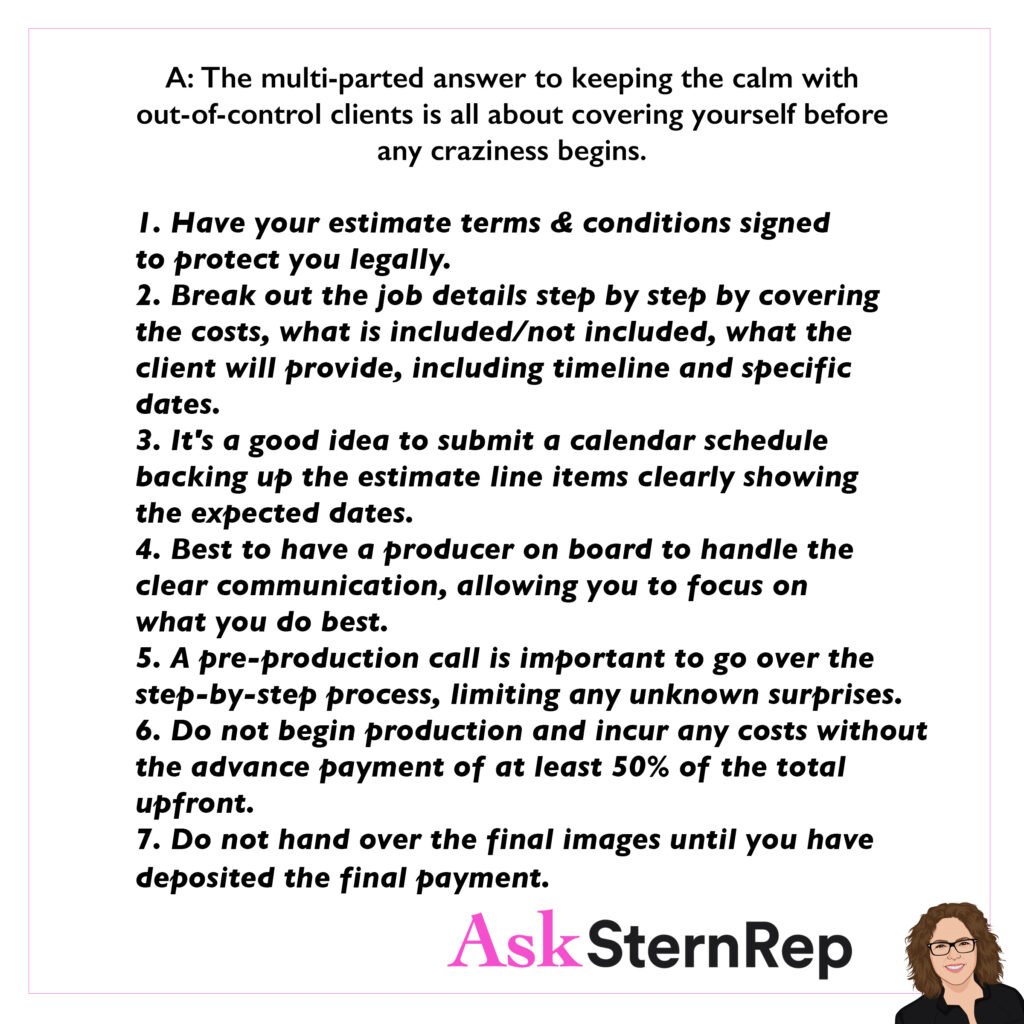
Q:
I am experiencing out-of-control clients requesting added or changed images as we are shooting, missing detailed composition into not included in the brief, and even complaining about actual details they didn’t want to see after I light their props – it’s crazy how uneducated these clients are! How do I handle this?
A:
The multi-parted answer to keeping the calm with out-of-control clients is all about covering yourself before any craziness begins.
- Have your estimate terms & conditions signed to protect you legally.
- Break out the job details step by step by covering the costs, what is included/not included, what the client will provide, including timeline and specific dates.
- It’s a good idea to submit a calendar schedule backing up the estimate line items clearly showing the expected dates.
- Best to have a producer on board to handle the clear communication, allowing you to focus on what you do best.
- A pre-production call is important to go over the step-by-step process, limiting any unknown surprises.
- Do not begin production and incur any costs without the advance payment of at least 50% of the total upfront.
- Do not hand over the final images until you have deposited the final payment.
Negotiation Can Be Tricky
Negotiation can be tricky, especially in unknown scenarios with no previous relationship with a client. My goal is to figure out what the client has for a budget, even though they usually won’t offer that info. I like to begin with a higher $ than I’m assuming the budget will be. That higher starting point approach depends on creating an honest two-way discussion from the start to achieve truthful negotiation.
Relocating to Los Angeles


Q:
Relocating to Los Angeles in 2 weeks from Baltimore. Any tips for hitting the ground running? I have an existing client there and some connections, but nervous about income and how long it might take to re-establish myself.
A:
Relocating locations from a smaller area to a larger city may require shifting your marketing strategy from being a solid all-around photographer to becoming the master of one strong style. The competition in the larger cities tends to focus on being the best of a definitive market. Be prepared to hit the ground running with an established look ready to compete within a more fine-tuned selection of clients.
A Big Red Flag
If you are saying, “I CAN DO THAT” when you see ads, that tells me you are on the side of being a “generalist,” which waters down the impact of your specific style. I call that my RED FLAG as those are the photographers who usually don’t receive the national attention for a specialized branded look.
Negotiating Licensing
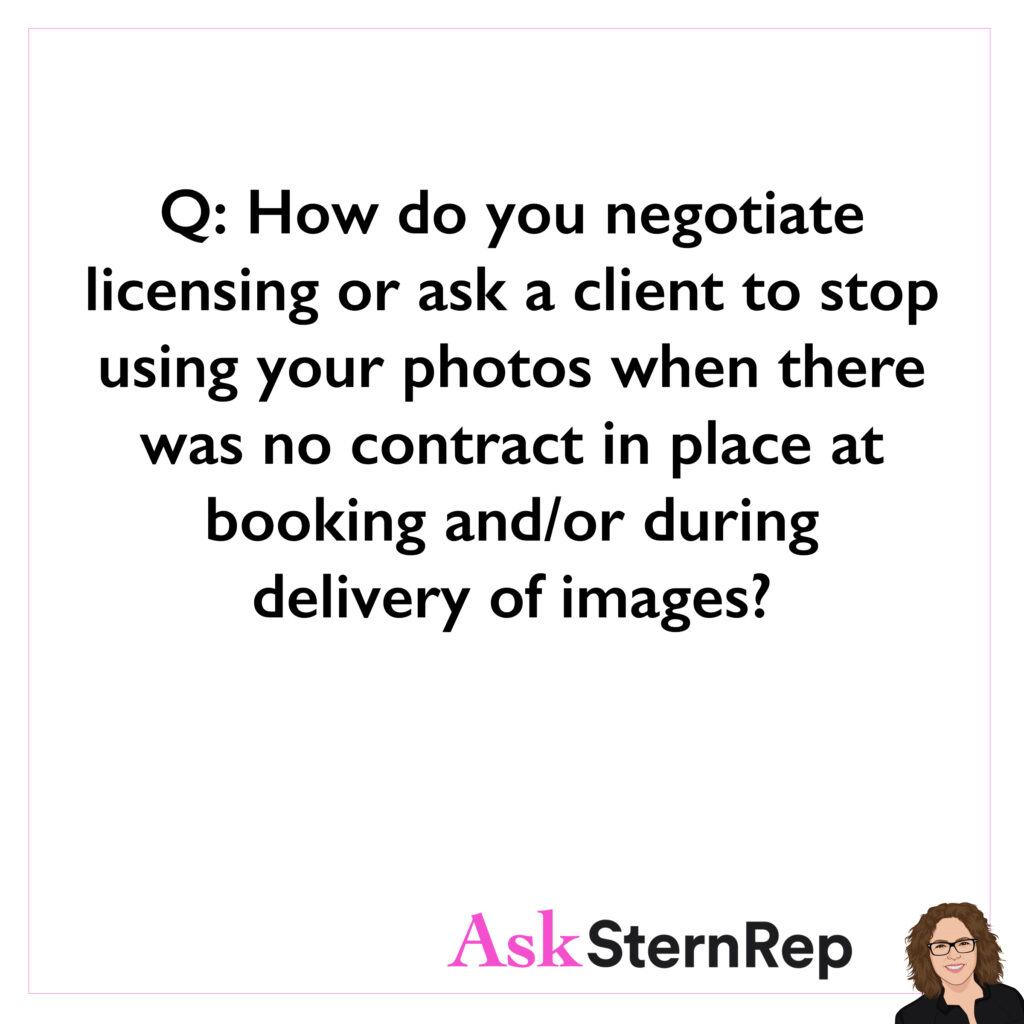
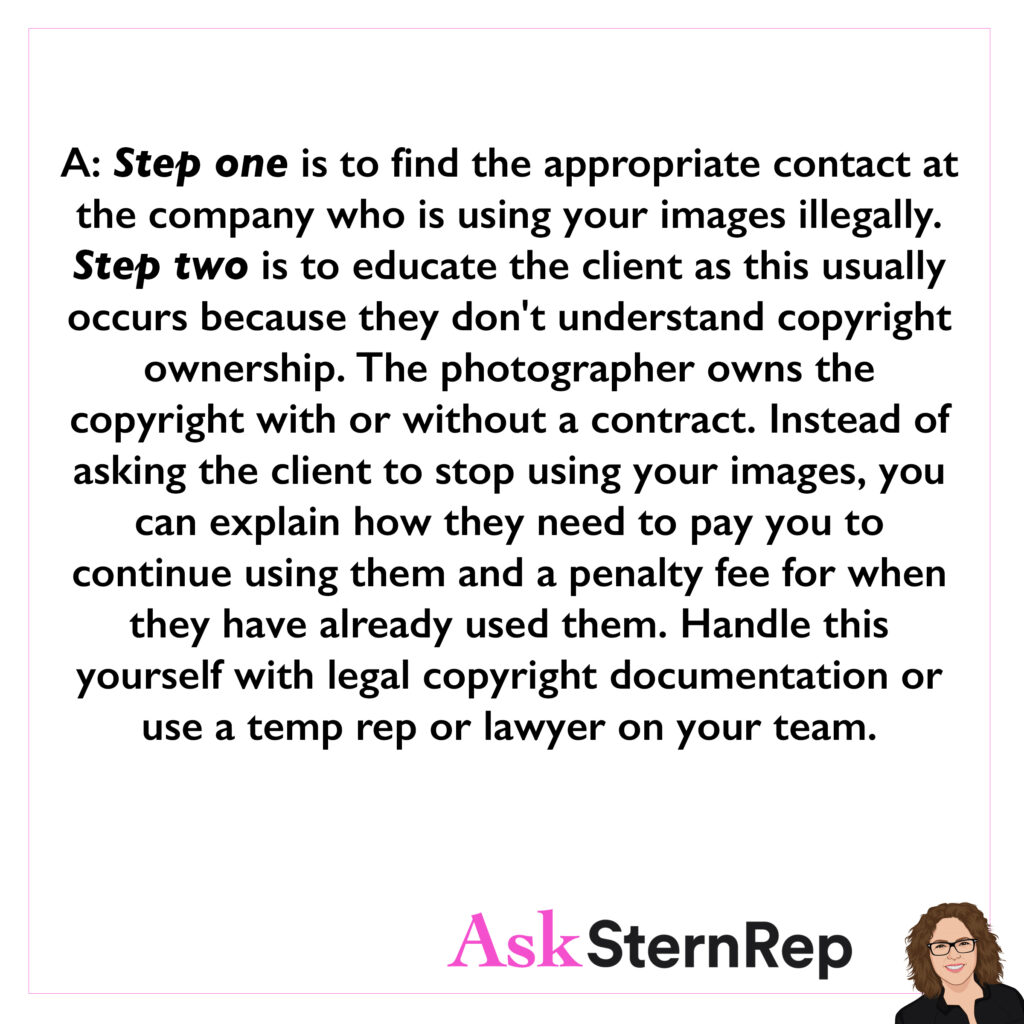
Q:
How do you negotiate licensing or ask a client to stop using your photos when there was no contract in place at booking and/or during delivery of images?
A:
Step one is to find the appropriate contact at the company who is using your images illegally. Step two is to educate the client as this usually occurs because they don’t understand copyright ownership. The photographer owns the copyright with or without a contract. Instead of asking the client to stop using your images, you can explain how they need to pay you to continue using them and a penalty fee for when they have already used them. Handle this yourself with legal copyright documentation or use a temp rep or lawyer on your team.
Happy Thanksgiving
What became clear to you as your reset from this unstable last year of our lives?
Happy Thanksgiving 2021!
Hit A Wall

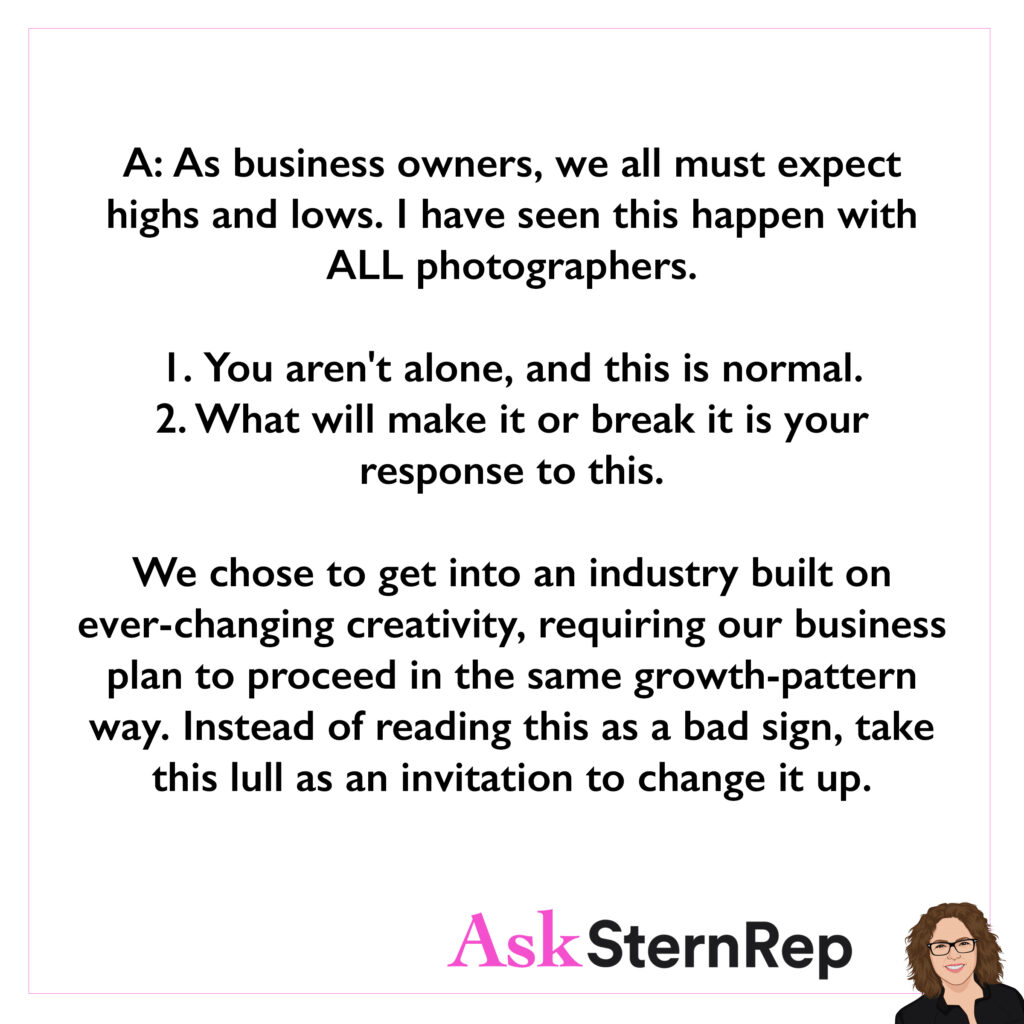
Q:
I feel like I’ve hit a wall with my business. I’m bidding on some jobs, but I’m not getting them. Clients want to get a crazy amount of images per day, and the budgets have shrunk. I’m struggling to stay on top of my game. Advice?
A:
As business owners, we all must expect highs and lows. I have seen this happen with ALL photographers.
- You aren’t alone, and this is normal.
- What will make it or break it is your response to this.
We chose to get into an industry built on ever-changing creativity, requiring our business plan to proceed in the same growth-pattern way. Instead of reading this as a bad sign, take this lull as an invitation to change it up.
The Creative Call Is Your Place To Shine!
The creative call is your place to shine! Be prepared, ready with all the resources you can gather to come across as clearly qualified to take on this project. Have a plan to share as you are actually the information provider vs. just gathering their information. Be the contributor of great insight as that is who they are looking to hire. Be ready!
On every creative call, you want to be extremely prepared. Do your research, check out their website, and have something to say during the call. This might lead to a question or a comment that relates back to the creative deck. Be thoroughly familiar with the creative deck and brief before the call—review it, have your ideas, questions, and thoughts ready. Relate your points to what they’re looking for, and mention anything you noticed about their website. Conduct thorough research, including a Google search, to find out where they’ve been and where they’re going. Gather as much information as possible before the call.
Bidding on a Project Without a Creative Call
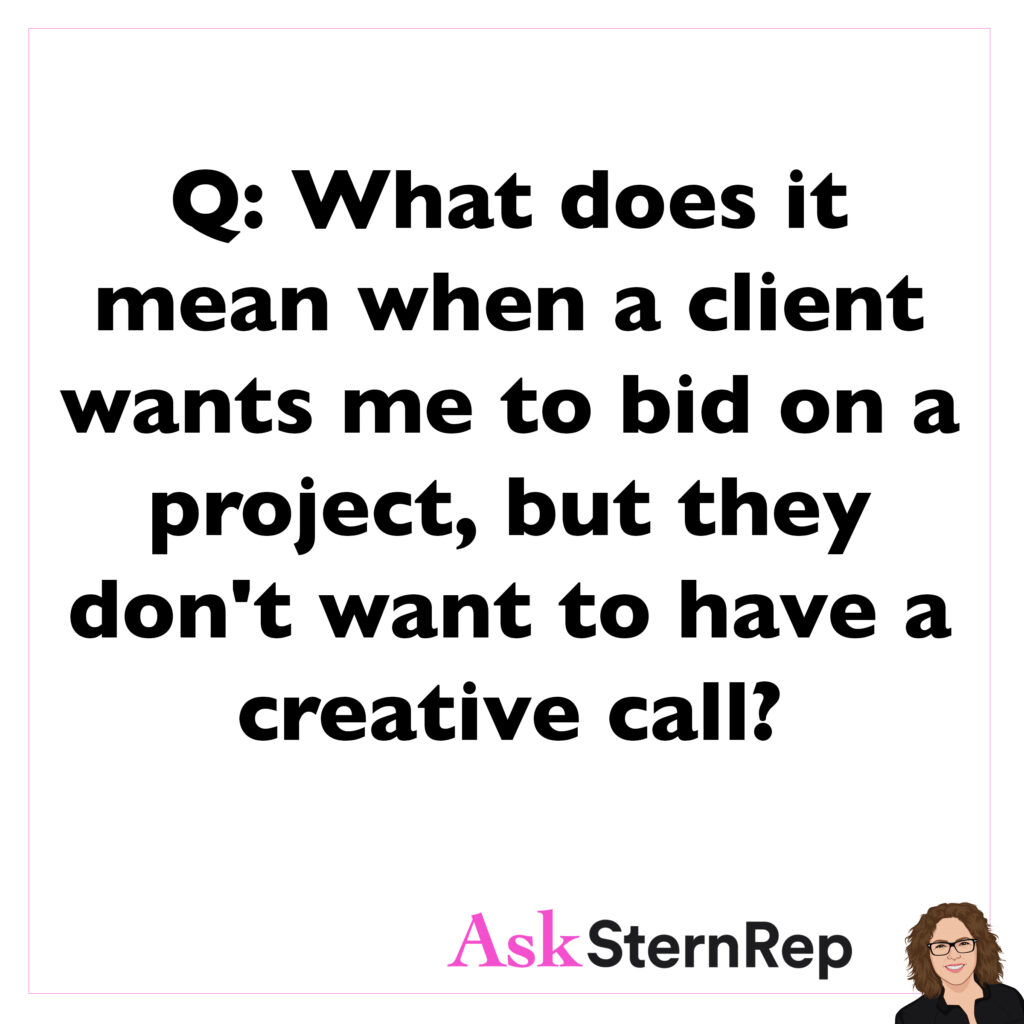

Q:
What does it mean when a client wants me to bid on a project, but they don’t want to have a creative call?
A:
If clients don’t want a creative call, that may be a sign for us to read into how they are not taking this as seriously as we’d like. It is time for the photographer to share their vision and approach, introducing the director who you will be on set. I read into them skipping this stage in a couple of ways: You may be the 3rd bidder and not be high on their list for this project so you should kick butt on your treatment as that can serve as your intro to the creatives and the client. Your estimate should be as ethically conservative as safely possible to entice the client to choose you but remember you could get locked into these prices in the future. This project may not be happening yet, and they needed your numbers to provide the client with a preliminary budget range.
The Final Stage of The Treatment
The final stage of the treatment is where I find it easy to add in spots, sneaking in and dropping descriptive adjectives to modify our point wherever we can use an adjective to ‘bring it home.’
Example to show AUTHENTICITY:
“We will be using natural light to bring about the real-life/pure/true/convincing feeling that these are actual people and not models.”
I want to share what I do when I receive a treatment from a photographer before we send it in. I review it carefully to find places where they describe the location, casting, and talent. I look for opportunities to enhance these descriptions by using specific adjectives and words that align with the client’s preferences. For example, if the client wants an authentic shoot with the talent in real moments, I consult a thesaurus for synonyms of “authentic,” such as “pure,” “reliable,” “true,” “trustworthy,” “credible,” and “convincing.” These words help describe how we will find the perfect location, even if it’s not perfect but rather credible or convincing. Pay attention to the words used on the call and in the creative deck. Use those terms specifically and reflect back what the client wants to hear.
Disparity Between Total Budget and Photography Fees
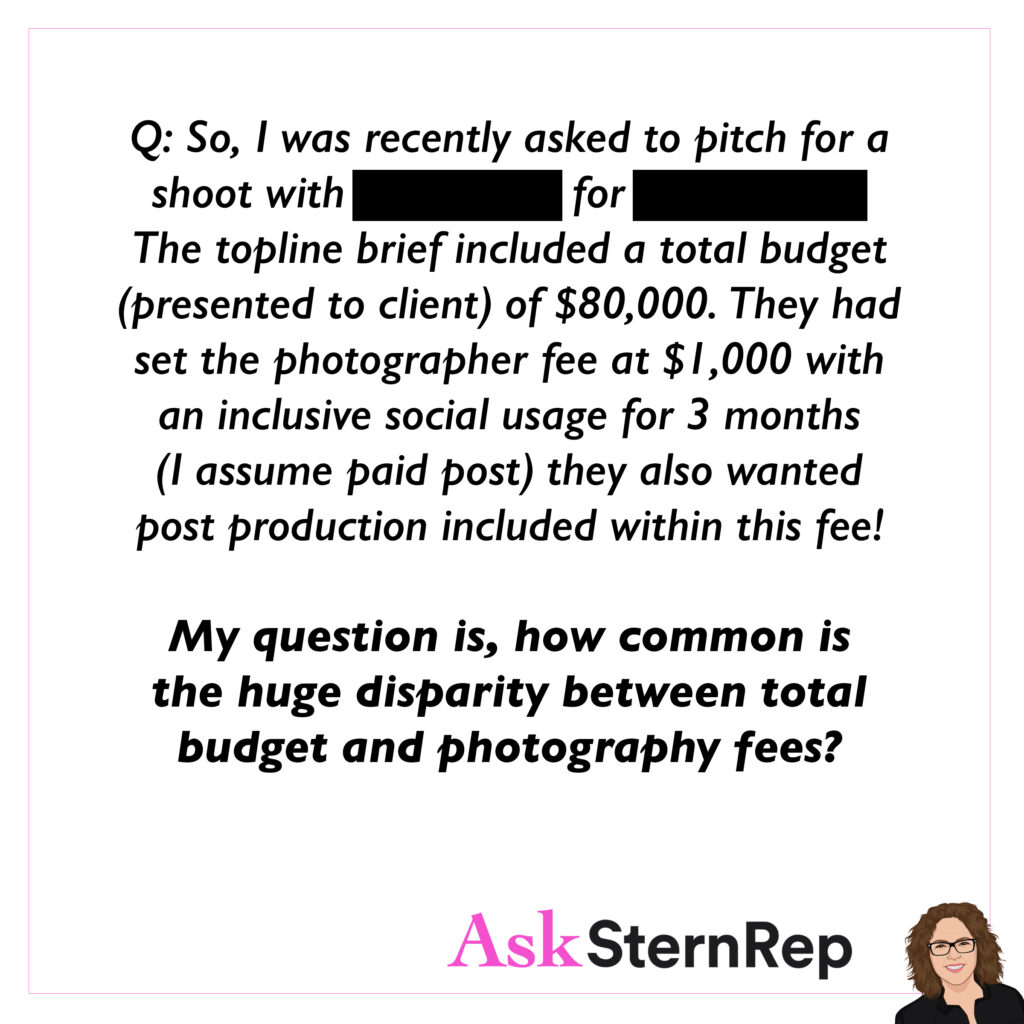

Q:
So, I was recently asked to pitch for a shoot with ***** for *****. The topline brief included a total budget (presented to client) of $80,000. They had set the photographer fee at $1,000 with an inclusive social usage for 3 months (I assume paid post) they also wanted post production included within this fee!
My question is, how common is the huge disparity between total budget and photography fees?
A:
This huge disparity between total budget and photography fees sounds fishy to me. These days, many projects come from smaller social media agencies or directly from production companies, who often have more control over the production budget. We need to keep a watchful eye over who is hiring the photographer and setting the fees. Companies that control your fees may also be the same companies that have you sign away your copyright ownership. Know who you are dealing with, what you agree to, and who you are trusting.
Every Bid
Every bid inquiry requires its own fine-tuned strategy + gameplan.
The question is, which response will align with the client’s goals to get us the job while clearing up any potential usage terms that don’t protect you. We usually have to think quickly and make fast decisions following our instincts. Sometimes it’s in our best interest to wait for the details to be ironed out after the creative call. Strengthening our position first can allow us to make the changes we ultimately need to make.
When we are asked to bid on a job, especially client-direct jobs, they often request usage terms that we may disagree with, such as copyright issues or work-for-hire clauses that restrict us from showing the images. These terms often need education because, unlike ad agencies, client-direct clients may not fully understand what they’re asking for.
What I like to do is take a strategic approach: I first suggest having a creative call where we sell them on our ideas using catchphrases that will make them think, “This is the person we must work with.” During this call, we showcase the images and have the producer on the call to really hook them. Only after this is it time to negotiate the usage terms.
Assess whether you need to address these terms upfront before you bid on the job or wait until after the creative call to use the opportunity to get them hooked.
License and Perpetuity Estimate
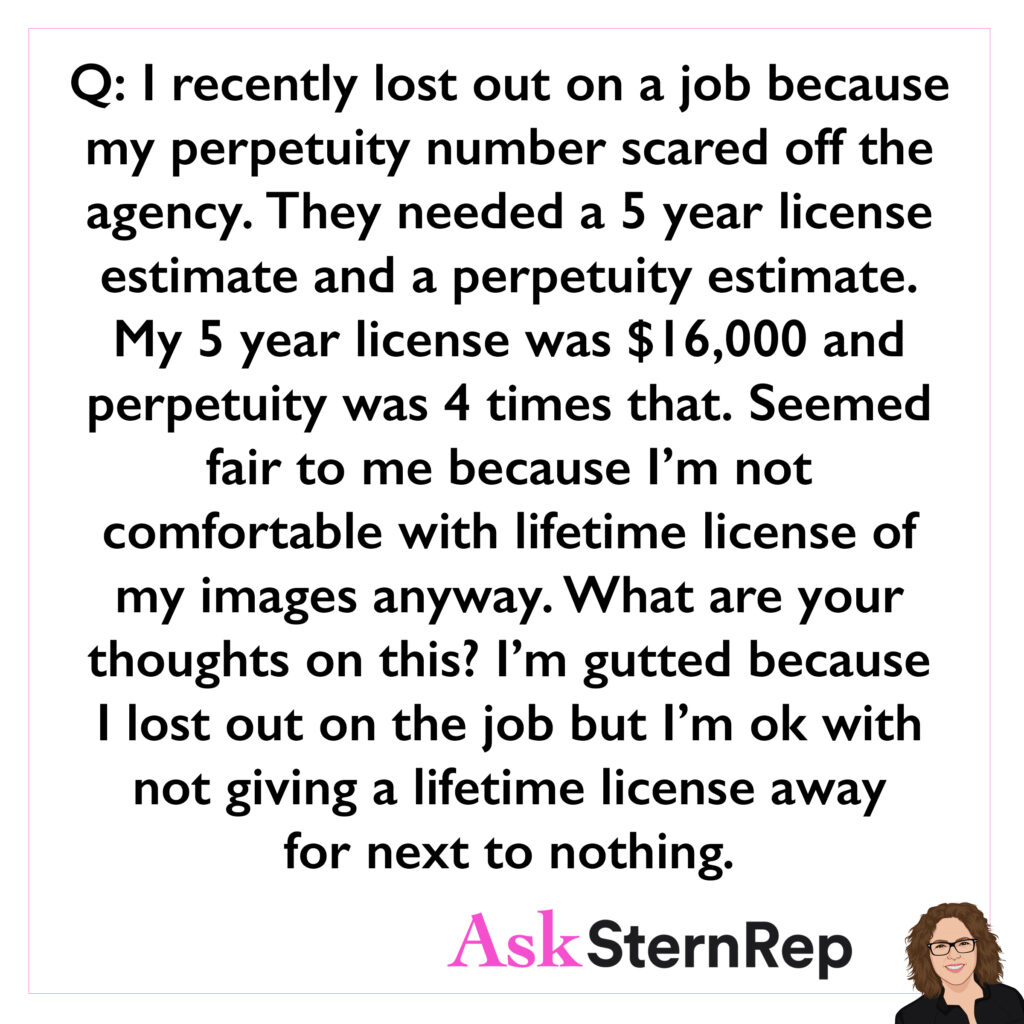

Q:
I recently lost out on a job because my perpetuity number scared off the agency. They needed a 5 year license estimate and a perpetuity estimate. My 5 year license was $16,000 and perpetuity was 4 times that. Seemed fair to me because I’m not comfortable with a lifetime license of my images anyway. What are your thoughts on this? I’m gutted because I lost out on the job but I’m ok with not giving a lifetime license away for next to nothing.
A:
When bidding on a job requesting usage duration fee options, those are often an excellent place to start high, expecting to negotiate and not risk losing the job.
The usual fundamental reasons you could lose a job you are bidding on:
-They have a #1 favorite choice in mind based on their style.
-Your overall estimate price is much higher than someone else, so high they don’t even want to try to negotiate,
-Your overall estimate price is very low, showing that you do not have the experience needed to fulfill the goals of this project.
-Another bidder impressed them more with their treatment or ideas on the creative call.
How Do You Stand Out From The Competition?
What is your sales tool component that stands out to separate you from your competition?
Is it your personality, a production capability, or your skillset?
What do you offer that helps your marketing/sales approach push you to be 1st choice for projects?
This specific something about you can shape your entire direction.
Follow it, know it, explore it and grow from this specialty to keep yourself on top of the pack.
Think about the sales of what you do. You need to be competitive with many others, so how do you make the numbers work in your favor? Rely on something very specific to you that limits your competition. Your approach can focus on this unique skill set, something you’ve done in the past, your reputation, your history, or your interests.
For example, I represent a duo with a very specific niche. They should leverage that uniqueness every time we bid on a job. They should highlight it in their treatment and discuss it during the call. It should be a major focus because it sets them apart.
Use what you have and rely on it. If you’re unsure what that unique aspect is, take the time to discover it. This can become your best marketing tool, sales approach, focus, and direction for your website, images, or testing. Think about it, use it, and remember it can evolve over time, but make sure to use it effectively.
Estimating a Job Without All the Information
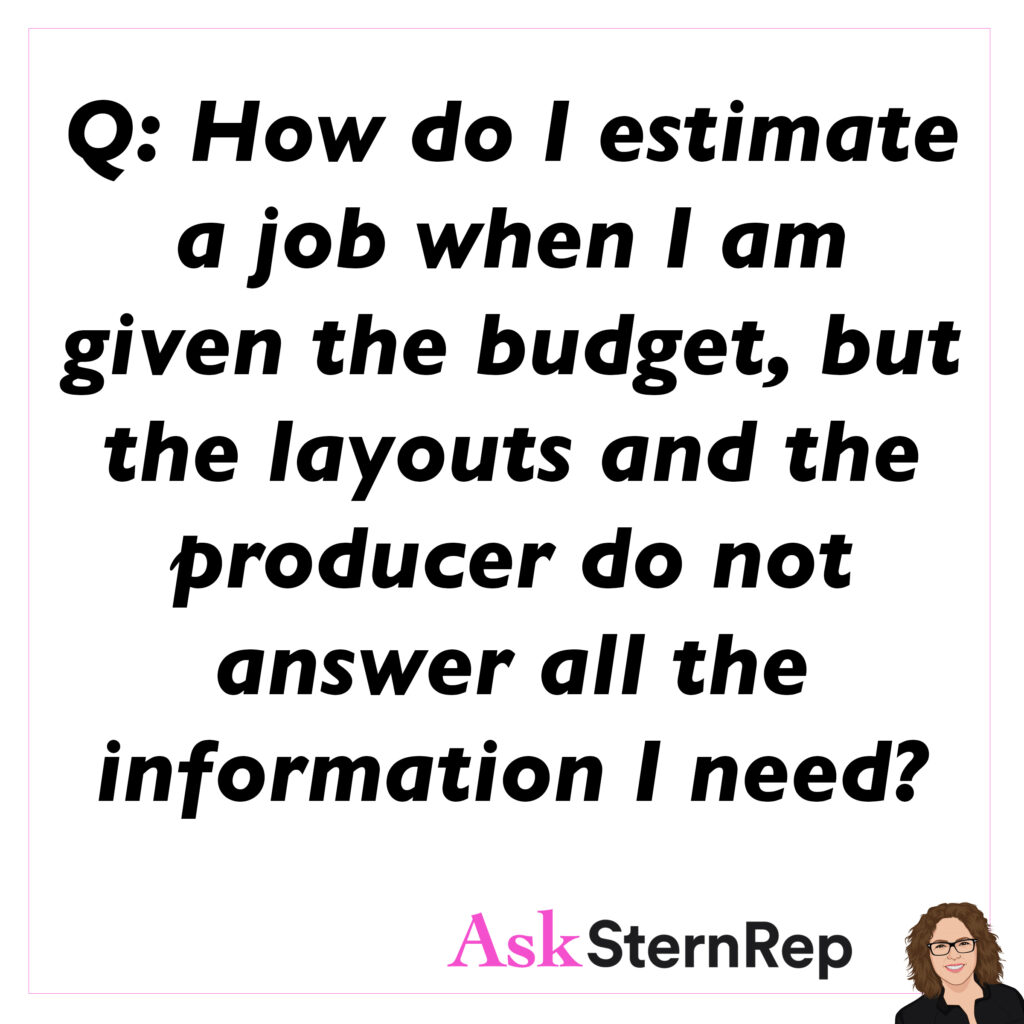

Q:
How do I estimate a job when I am given the budget, but the layouts and the producer do not answer all the information I need?
A:
Estimating a job is not an accurate term because we are liable for our “estimate” price. Since an estimate is a “bid” for a project, we have to protect ourselves as our reputation and the financial responsibility is on our shoulders.
How I read the situation:
– They may be expecting you to be the creative director creating their concepts which is an additional role to be added to your fees.
– Without all the details, you’ll need to expect fewer shots finished per day due to the exploration time required.
– Call it a rough ballpark estimate, making it clear you’ll need them to allow for revisions once you learn more information.
The Photographer’s Guide to Effective Marketing Part 2 // Navigating the Unknown Episode 19
Guests:
Amy V. Cooper – Photography Consultant https://www.amyvcooper.com
Julie Skarwecki – Photography Consultant https://www.julieskarwecki.com
Navigating the Unknown is a Q&A series in collaboration with APA-LA where we speak to different members of the photo community about all aspects of the commercial photography business. https://la.apanational.org
With Co-Host: Photographer – Hugh Kretschmer https://www.hughkretschmer.net
Follow us on Instagram for so much more: http://www.instagram.com/asksternrep
A Business Slump
A business “slump” happens when work is slow, but why is it slow? Of course, that can be for many reasons, but the one concrete response needs to understand WHY. The key to substantial business growth vs a temporary distraction is to take a straightforward look at the situation by analyzing the facts instead of reacting emotionally. What is working for you and what is not. Be the CEO you need to be.
Ageism in Commercial Advertising
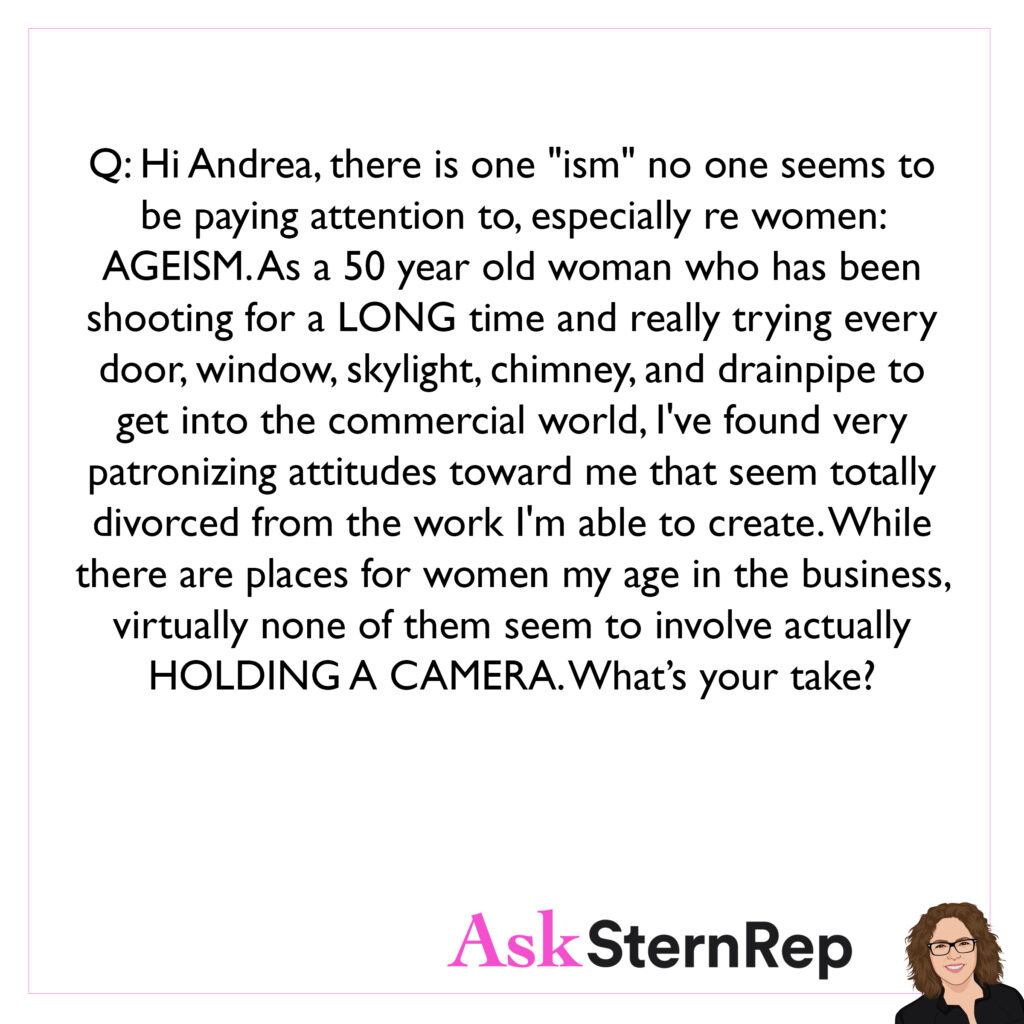
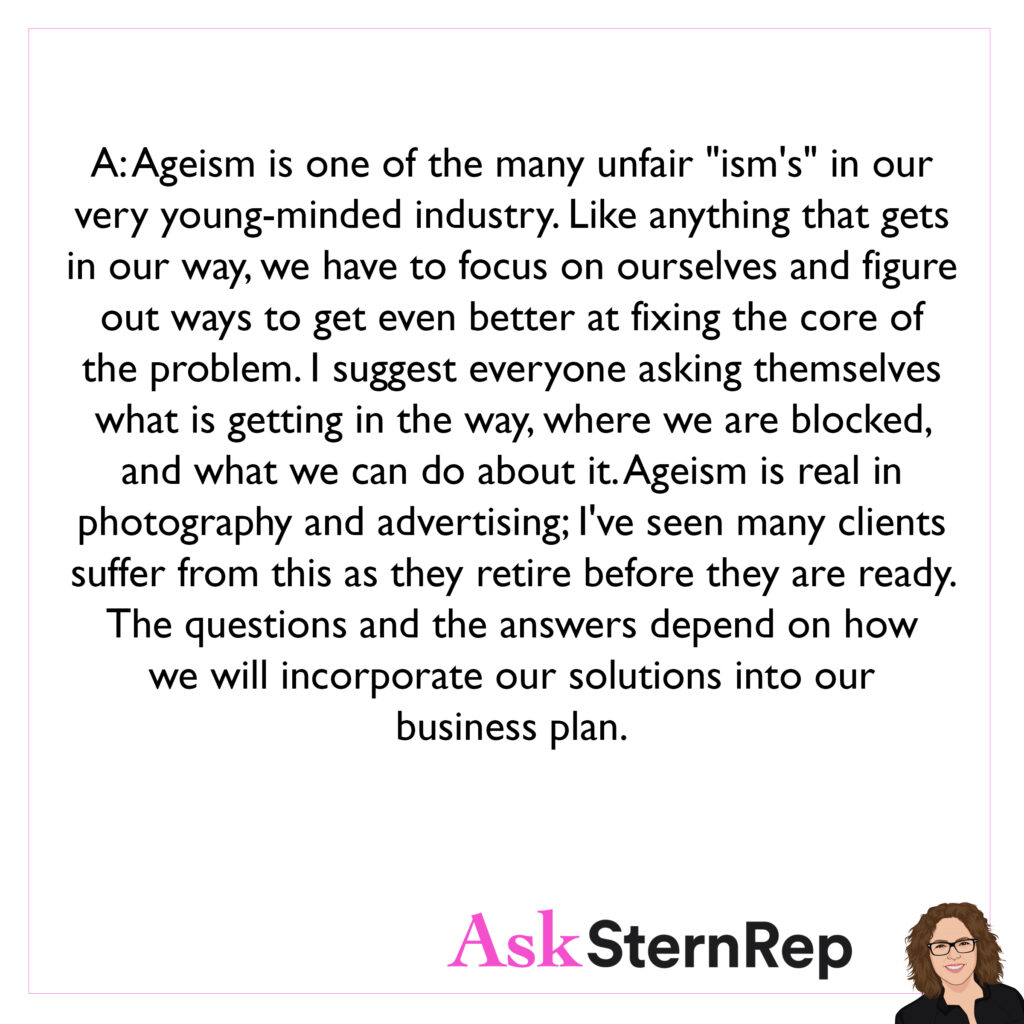
Q:
Hi Andrea, there is one ‘ism’ no one seems to be paying attention to, especially re women: AGEISM. As a 50 year old woman who has been shooting for a LONG time and really trying every door, window, skylight, chimney, and drainpipe to get into the commercial world, I’ve found very patronizing attitudes toward me that seem totally divorced from the work I’m able to create. While there are places for women my age in the business, virtually none of them seem to involve actually HOLDING A CAMERA. What’s your take?
A:
Ageism is one of the many unfair “ism’s” in our very young-minded industry. Like anything that gets in our way, we have to focus on ourselves and figure out ways to get even better at fixing the core of the problem. I suggest everyone ask themselves what is getting in the way, where we are blocked, and what we can do about it. Ageism is real in photography and advertising; I’ve seen many clients suffer from this as they retire before they are ready. The questions and the answers depend on how we will incorporate our solutions into our business plan.
Protect Yourself
Protect yourself on bids by preparing for the client to respond by handling some of the line items themselves.
For example, if they had contemplated supplying the props, expect your prop cost to eventually be removed from your total. If you know their budget or have one in mind, place those prop costs over the final amount you want to come in at. You cannot add to your bid once you submit it, so strategically place your numbers with this in mind.
There’s a way to protect yourself on bids that I keep learning about—I just experienced it yesterday. I think I’ve mentioned this before, but I want to emphasize it again.
There are line items on your bid, such as overtime, retouching, consulting on post-work, or food, that the client might later say they will cover. Be cautious with these items because once they are removed from your budget, you’re stuck with the remaining amount. Even if the client initially said they have a budget of $20,000, if your bid now comes in at $15,000 after these items are removed, they’ve already seen the original bid. You can’t change it at that point.
So, be careful with these items. It’s better to come in over budget and discuss potential removals with the client rather than adjusting your bid after submission.
Where Do Creative Directors Look for New Talent?


Q:
Where do creative directors, art buyers etc. look for new talent? I would appreciate any advice I can get.
A:
The business of photography depends on who sees our images; we have to find every potential method to put ourselves out there. Depending on the type of photographer you are, we have some really good options these days like Komyoon, Workbook, At-Edge, Blvd, Behance, PhotoPolitic, LeBook, Production Paradise, Found and Wonderful Machine. They all have a different vibe, go through them and see where you fit best. I suggest asking clients you want to work with where they look for new talent. After you give one of these a try, you can SEO your website and use Google Analytics to see where the traffic is coming in. It’s a timely process with no easy answer, but if you pay attention to your analytics, you can see what works for you.
Recognizable Art
Just like companies cannot make money off of photographer’s art without their permission, the same goes for any recognizable art that we may not even realize has copyright ownership. I was on a call discussing casting, and we were warned against using talent with tattoos because we would need permission from the artist. Recognizable public artwork on buildings or bodies without usage agreements has caused legal problems that we don’t want to get entangled with.
There’s something you need to be careful about that you might not know. I was on a call about a job, and they discussed an important issue to be extremely aware of: graffiti, tattoos, and wall art of any kind. As an artist, you have policies for your own images, and so do other artists. It’s not easy to find these artists to pay them or get an agreement from them, so be very cautious.
You might be able to alter these elements in your retouching and post-work to make them non-recognizable, but beware—there could be legal issues and potential costs if you don’t handle this correctly. It could become problematic, so stay aware of this.
Networking With Your Clients


Q:
Flying to NYC next week from LA for a job with a producer that has booked me on many well paying jobs this year. Have yet to have dinner or a drink with them, if we do get dinner, is that a time where I slap my credit card down and try to pay for the meal? Or they may just cover it and so it goes?
A:
Yes! When you get a job, it is your turn to spoil your clients. Hopefully, your budget is slightly padded to help you take them to a baseball game, buy them the special dinner, whip up some unexpected craft service during the shoot day and then splurge for a nice wrap party dinner for all the crew. It’s part of the job for you (and your rep) to say thank you in all the possible ways without it being too over the top.
Take Note
We are in business that requires a continuous flow of fresh vibes! Clients hire you for your IDEAS skillset; show them you are a non-stop source generating new ideas. Take note of how your ideas come alive, pinpoint what works, and schedule more of this into your routine.
The business we are in requires new ideas; we have to stay fresh. I keep emphasizing this, but how do we stay fresh and generate ideas? Everyone is different, so figure out what works best for you. For me, it’s in the morning when I have a lot of energy and when I talk on the phone with my support staff. We trigger each other’s ideas and flow of thoughts.
What works for you? Do you go mountain biking, rock climbing, or meditate? Do you use a sketchbook to jot down ideas or visit mood board websites? Consider how you can track and capture your ideas effectively. Even if you’ve just launched a new campaign or website, you need to continue generating fresh ideas. One successful project doesn’t sustain you indefinitely. Find out how you get your ideas and integrate that into your life and routine.
Bring the Client’s Branding Into the Treatment
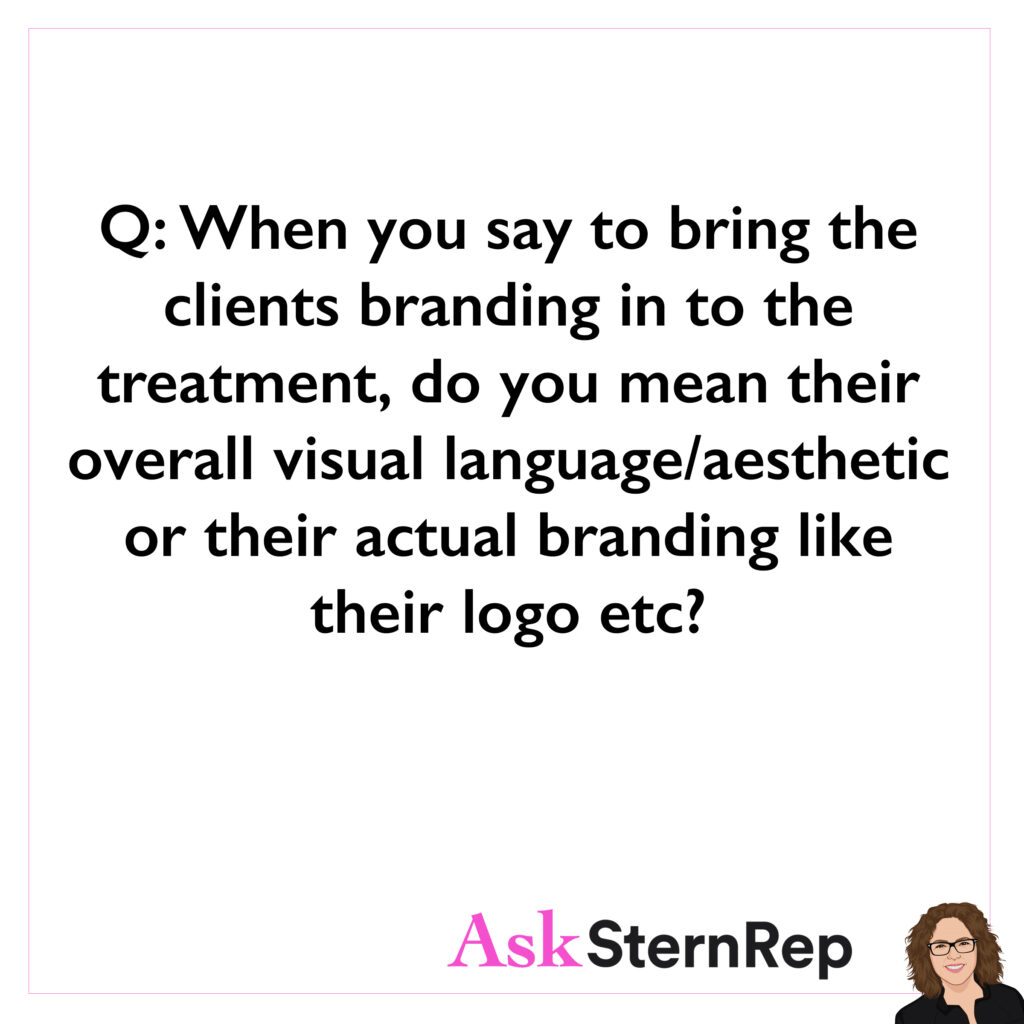

Q:
When you say to bring the client’s branding into the treatment, do you mean their overall visual language/aesthetic or their actual branding like their logo etc?
A:
Your treatment is all about having the client feel like you “get them.” You are what they’ve been looking for to bring their idea to life! Use every way you can to translate this; it is your opportunity to speak their language with their logo in the titles, and their colors styled aesthetically throughout.
The Photographer’s Guide to Effective Marketing // Navigating the Unknown Episode 18
Guests:
Amy V. Cooper – Photography Consultant https://www.amyvcooper.com
Julie Skarwecki – Photography Consultant https://www.julieskarwecki.com
Navigating the Unknown is a Q&A series in collaboration with APA-LA where we speak to different members of the photo community about all aspects of the commercial photography business. https://la.apanational.org
With Co-Host: Photographer – Hugh Kretschmer https://www.hughkretschmer.net
Follow us on Instagram for so much more: http://www.instagram.com/asksternrep
Social Media Usage
Be specific about which SOCIAL MEDIA USAGE you are licensing to the client.
- PAID is for their ads.
- OWNED is on their social media.
- You posting it on YOUR FEED (Influencer Posts) which is a separate fee.
Advice on Sending Unsolicited Emails to Clients


Q:
Any advice on sending an unsolicited email when reaching out to a client that I want to work with? I just finished a project that I would love to share with them, yet I don’t know what are the right steps to take. I would love any thoughts or suggestions on how to approach this. Thanks!
A:
The question is, how do we make our marketing less UnSolicited and more Solicited because an unfamiliar name has higher odds of being deleted.
Here is a list of the top 5 steps to having your work seen vs. deleted:
- Emails need to be short, quick and to the point. Having a referral or something personably relatable will always help. IF you want a response, ask a question giving them a purpose to keep the conversation going.
- Find the right person in the position who looks for photographers.
- Make sure you send your work to a client with relatable imagery versus sending food images to Nike.
- Invest in the consistent long-term process of marketing vs. a one-off promo now and then.
- Engagement is readily available these days and can happen in many ways, so try them all and see what works. Engage, engage, and keep engaging!
Cover Yourself
Make sure you are clear and cover yourself with all crew and talent on a photoshoot that you own the images, and no one is allowed to grant usage to anyone on Instagram without your permission.
Don’t assume they know the copyright laws; that is your job.
Bidding Anxiety


Q:
How do I get over bidding anxiety? I’ve passed up asks for bids because of fear.
A:
Bidding is an unknown fluctuating entity without an industry standard of set rates. Bidding a job is baffling; everyone will have their process. I use my direct human connecting skills backed by my knowledge of day rates, creative fees, usage rates, etc. You have a community of producers, consultants, reps who could be helpful resources for you. Learn to trust someone to help you bid. It’s worth the cost as it usually pays for itself just by getting the job with higher fees than you probably would have put in for yourself. Use a pro, allowing you to be the creative artist flourishing with the tasks that don’t give you anxiety.
Creative Concepting Fee
Bidding on a project without a shot list means you cannot know the exact costs for expenses, and you will be concepting the creative shot list. When you are wearing more hats, you need to charge for your time and call it a CREATIVE CONCEPTING FEE.
Giving Clients Unlimited Usage


Q:
Recently I’ve lost a few bids because I haven’t given the client an unlimited license. Is this an industry trend? Are clients not paying usage anymore and/or are photographers not charging usage? In my bid, I gave the client all the usage that they asked for, but lost the bid to another photographer who just gave them an unlimited license.
A:
Giving away image usage licensing rights for free gives up the critical framework that supports a career in photography. The only way to win this battle is to be the best photographer you can be. The better you become, the more clients will be forced to stick with photographers who charge for licensing rights. Those who give it away are on a lower playing field, mostly used when a client does not have a high-end specific style and can use a more general undefined look. The only way to not be undercut is to be the precise resource raising their business to that next level. Be the solution making them look even better for using you!
The Decision is Yours
When bidding on a job, you are in the position to make an educated decision to be the “bank” running all the costs through your own company vs having it go through the producer. Any markup or differences in actual prices will be a profit to whoever gets paid for the job. This can be you if you want to handle your billing. The decision is yours.
When you’re asked to bid on a job and choose a producer to work with, it’s important to make an educated decision about billing. Many producers handle all the costs and serve as the financial intermediary, and this is also common among reps. However, this isn’t how I operate, so I can’t speak from that perspective.
You need to decide whether you want the money to go through your name, directly through the producer, or through the rep. This decision should be made and clarified beforehand. If you choose to handle billing yourself, keep in mind that there could be a markup and leftover money from production expenses that could potentially benefit the producer.
Some photographers prefer to manage their own billing to avoid the markup and keep more of the budget, but this might limit your opportunities to work with certain producers. It’s worth considering how many producers would be willing to work under these terms. Ultimately, it’s your decision and you should carefully weigh your options.
Marketing Personality Strengths


Q:
How do we market to our personality strengths & EQ (emotional intelligence) vs. our actual craft? How to market the soft skills I have in conjunction with the artistry skills.
A:
Soft skills, as you call them, are how you build your marketing plan. These skills are what will get you in the door, invited back, and truthful feedback. How you shape selling your photography talents is by being yourself. Clients are humans who want to connect and know who you are. Clients may see the work of 50-100 photographers per day, so how do we stick in their minds? Show who you are in your marketing because that is half the story of what you are selling.
Growing with the Flow
Success as a photographer requires a long-term plan of constantly “growing with the flow”. The busy shoot days come and go and so do the trends of our market. Your business is not about this month; it’s about putting in the right attitude to stay fresh until you retire.
Don’t forget to invest in your career.
Newer Photographers on a Creative Call

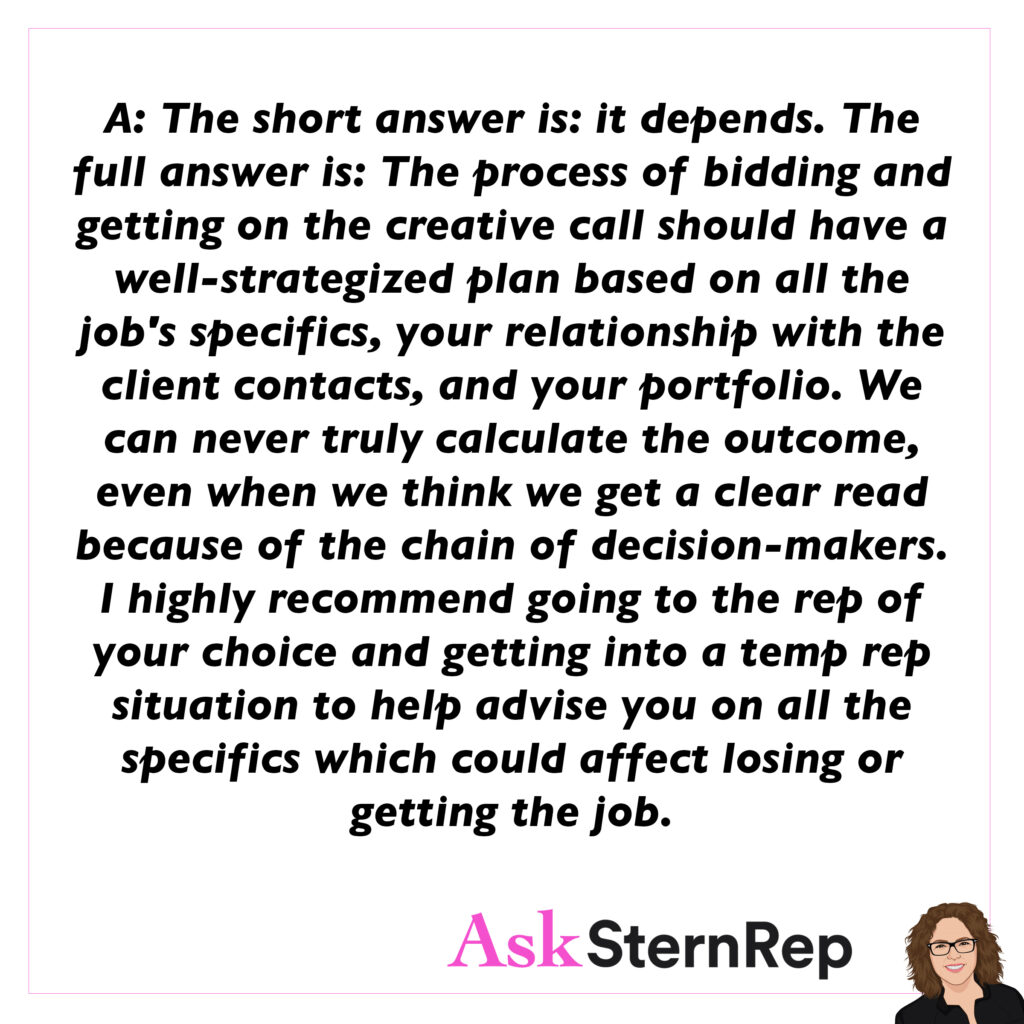
Q:
If a newer photographer makes it to the creative call stage, how honest should they be about what they do and don’t know?
A:
The short answer is: it depends. The full answer is: the process of bidding and getting on the creative call should have a well-strategized plan based on all the job’s specifics, your relationship with the client contacts, and your portfolio. We can never truly calculate the outcome, even when we think we get a clear read because of the chain of decision-makers. I highly recommend going to the rep of your choice and getting into a temp rep situation to help advise you on all the specifics which could affect losing or getting the job.
This is a Presentation
Make sure to use your words wisely and get into good routines to share your ideas on client calls. If you find yourself needing a traditional phrase to finish your zoned-in thoughts, get them ready and mix them up. Saying a phrase more than once will weaken your “director” presentation, and remember, this is a presentation.
Decision Making of Selecting a Photographer
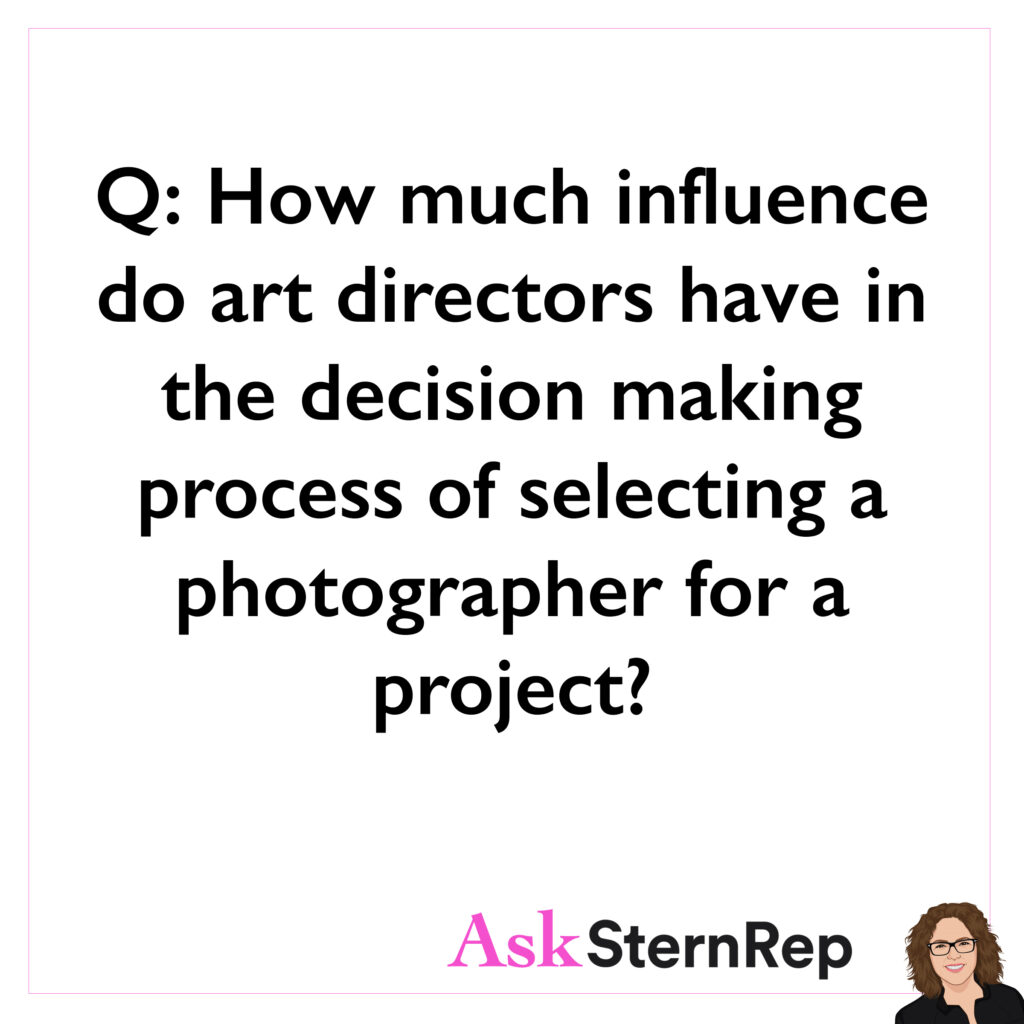
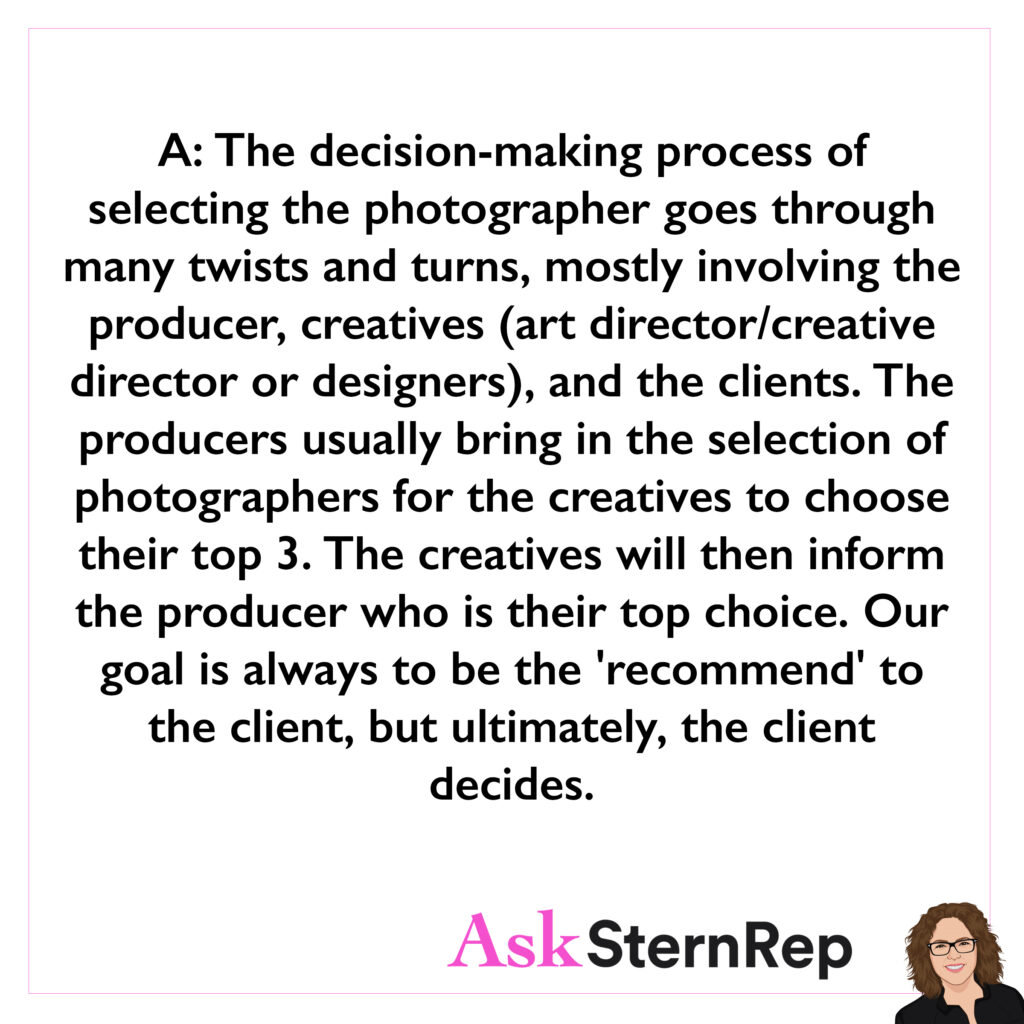
Q:
How much influence do art directors have in the decision making process of selecting a photographer for a project?
A:
The decision-making process of selecting the photographer goes through many twists and turns, mostly involving the producer, creatives (art director/creative directors or designers), and the clients. The producers usually bring in the selection of photographers for the creatives to choose their top 3. The creatives will then inform the producer who is their top choice. Our goal is always to be the ‘recommend’ to the client, but ultimately, the client decides.
Take the Pressure Off
What do you do if you are in a SLUMP? In a creative slump, take the pressure off by knowing it’s really normal. You can’t be your artistically motivated self every day. Learn or experience something new to get the inspiration back. Delegate something that you don’t want to do yourself. Ask yourself why you became a photographer and do what feeds that same interest you had back then.
I had a Clubhouse room discussing what to do if you feel like you’re in a slump. There are two types of slumps: when work is slow and when creativity feels blocked. Today, we’ll focus on creativity.
First, take off the pressure. It’s normal to not feel motivated every day; it’s part of the job. Reducing this pressure can really help. Next, try something new. Step out of your routine—go to a movie, book time at a café, or read a book at a theater. Doing something different might spark artistic inspiration.
If you have tasks hanging over you that you dislike, such as bookkeeping, organizing files, or managing hard drives, consider delegating them. Hire an assistant, enlist an intern, or ask for help. You don’t have to do everything yourself.
Remember why you became a photographer. Reflect on who you were back then and what fueled your passion. Find activities or experiences that remind you of that initial excitement and passion. Even if it’s hard to see right now, reconnecting with that true, passionate place can enrich your life. Go find it.
Social Media Analytics

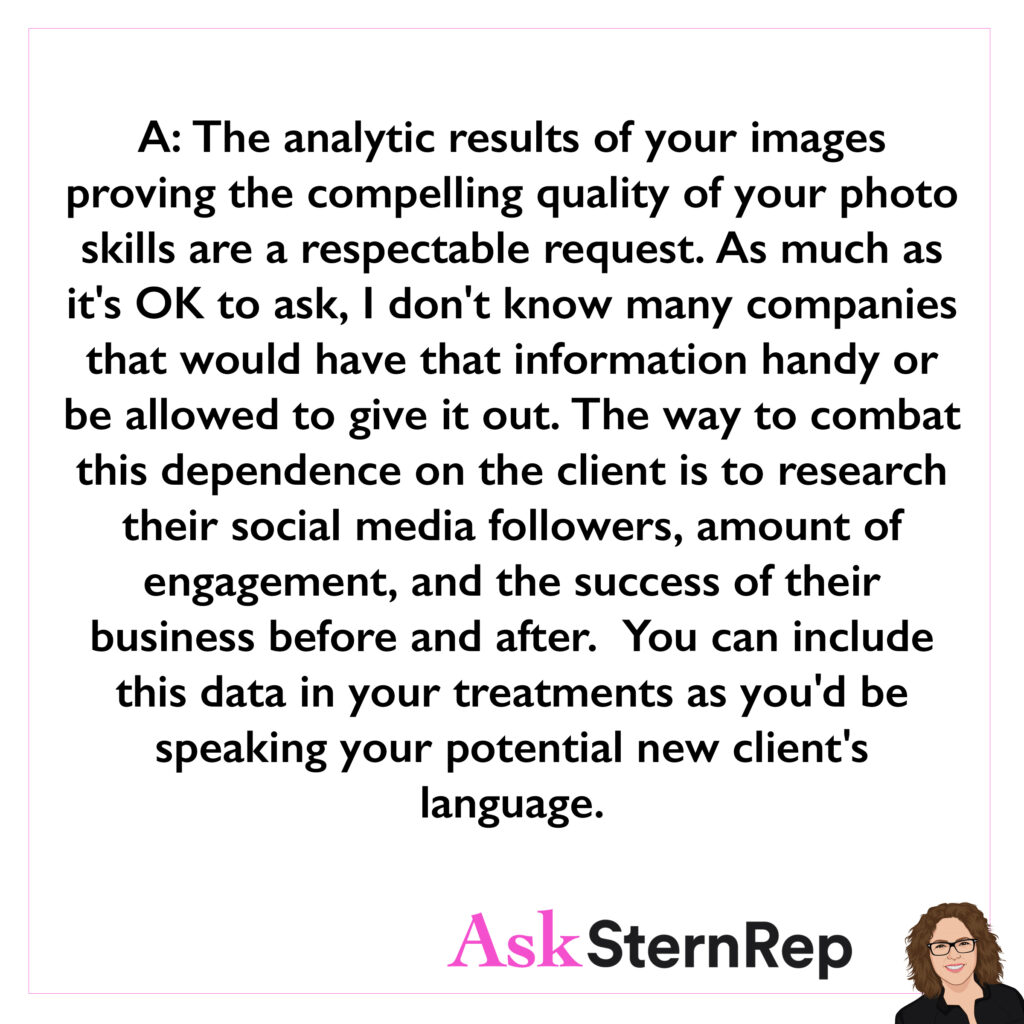
Q:
Background to my Question: I have a client, they just won best social media in their industry in Canada, and they recently started using my images across their social media platforms coming into this new year. I want to reach out to more clients in this industry and I’d like to use this client as a case study in my deck… specifically I want to strengthen the case with their social media analytics (assuming the analytics are favourable).
Question: Is it couth to ask a client for their social media analytics in relation to the posts using my imagery in order to beef up my marketing decks?
A:
The analytic results of your images proving the compelling quality of your photo skills are a respectable request. As much as it’s OK to ask, I don’t know many companies that would have that information handy or be allowed to give it out. The way to combat this dependence on the client is to research their social media followers, amount of engagement, and the success of their business before and after. You can include this data in your treatments as you’d be speaking your potential new client’s language.
Be the Director
Throughout the bidding process consistently put your ideas on the table and take the lead. Be the director the whole way through!
When you’re bidding on a job, it’s not just about figuring out what the client wants; it’s also about stepping up as the director and leading the project. You need to explain your solutions and ideas. Even after you’ve submitted your bid, continue to reinforce your value by coming back with more ideas. Show them that you’re the professional who can provide creative solutions and help them make informed decisions.
It reminds me of the Seinfeld episode where he’s getting his kitchen built, and the builder offers no opinions of his own. It’s frustrating because clients need to know that having more opinions and ideas demonstrates your capability as a director. That’s what they’re hiring you for.
Project Minimum


Q:
Hi Andrea! I have a question regarding one-sheets that maybe might be helpful for the community. Would you suggest including a project minimum? I’ve been getting a lot of requests for “rate cards” and I usually say it’s project dependent.
A:
Photographer’s rates depend on the type of work you do. If you can simplify this request with a rate card, it would save you time. My goal as the agent is to save time by quickly finding out if we should continue this conversation by quoting a price range. I’ll say, “Our day rate fee for this would usually be somewhere between 4,000 – 10,000, depending on many factors like shot count, shot list, day count, the creative component of the images, and what the licensed usage rights are. What is your budget?” I find a price range to be the fastest way to get to the next step.
Wait and Spread Out Your Commmunication
Quick sales tip that you may not have thought of is to wait and spread out your communication with a client. If it’s not a pressing production matter, use your response/question/personal note as a way of staying on their mind for a longer period of time.
Here’s a sales and marketing tip you might not have considered: I often don’t respond to clients immediately. While sometimes prompt responses are necessary, if it’s a personal matter or if you have a question for them and you’ve just been in touch, try to delay your response as long as possible. The goal is to stay on their mind and remain visible. Use your email communication strategically to keep yourself in their thoughts for a longer period.
Major Bid + Huge Production
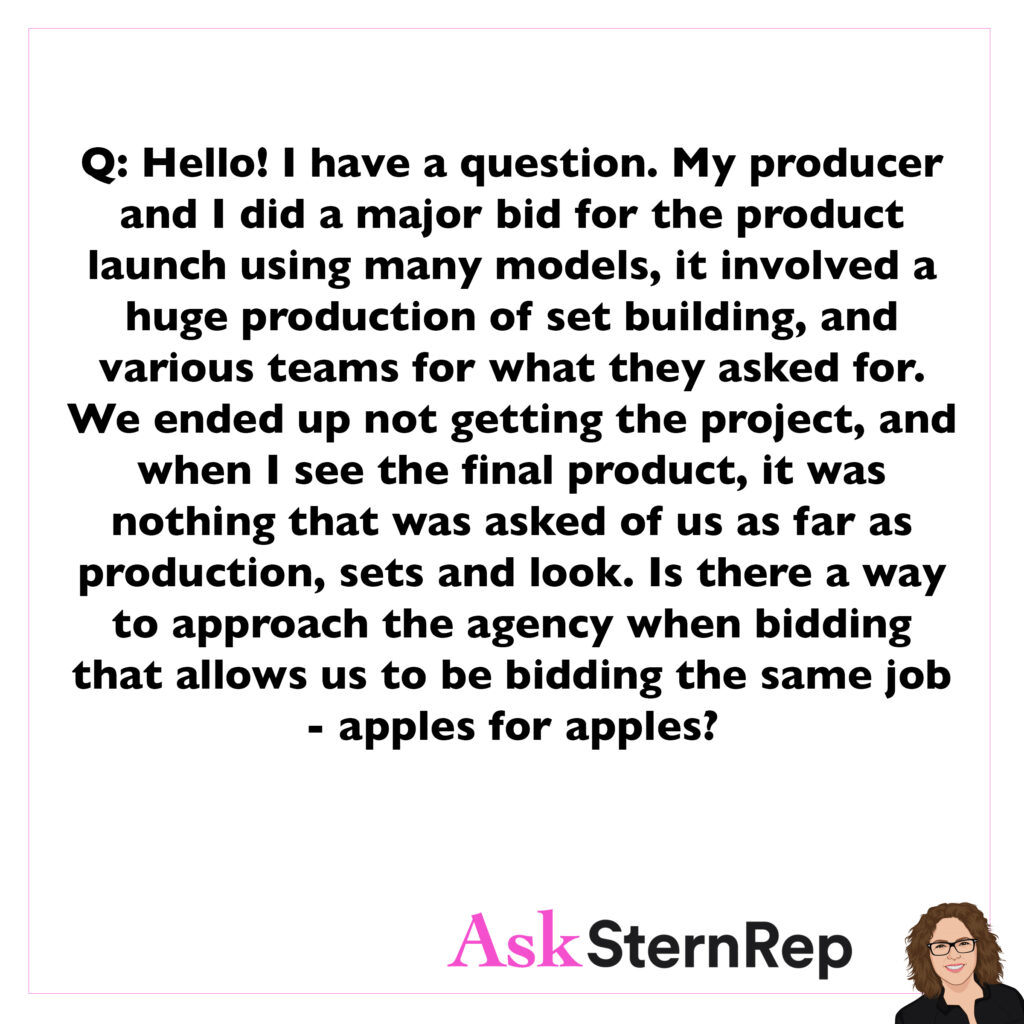

Q:
Hello! I have a question. My producer and I did a major bid for the product launch using many models, it involved a huge production of set building, and various teams for what they asked for. We ended up not getting the project, it was nothing that was asked of us as far as production, sets and look. Is there a way to approach the agency when bidding that allows us to be bidding the same job – apples for apples?
A:
While we can’t predict or control the bidding process, we can ask every question to help us understand the production details. The key is to have an A+ producer and make sure you get on a creative call, as that is where we get our answers. The purpose of three-way bidding is to protect clients in a fair apple to apple comparison, so they are not overpaying. Our goal is to protect ourselves by understanding all the information, even when we may have to dig around to get that info.
Don’t Hold Back in Stating Your Case
Clients don’t always have all the facts when we are bidding a job, leading us to under-bid certain areas. If more responsibility falls into your lap than expected, don’t hold back in stating your case to request more $. Clients know that some gray areas may result in an overage, but they need us to be the ones to ask for it.
Sometimes we bid on projects where we don’t have all the information yet, and the client may not have all the details either, leading to many assumptions. We should include “TBD” (to be determined) on those line items in our bid to protect ourselves. Even if we don’t include them, once the job is awarded and more responsibilities shift to us that were initially thought to be handled by the client, don’t hesitate to ask for additional funds. Address any new needs or changes directly with the client—don’t get frustrated. Often, they will understand because the situation was unknown at the time. Request more prep days, additional tech scout days if needed, extra post time, or anything else necessary. Remember, just because the bid is awarded doesn’t mean you have to absorb these changes without discussing them.
Testing Rate
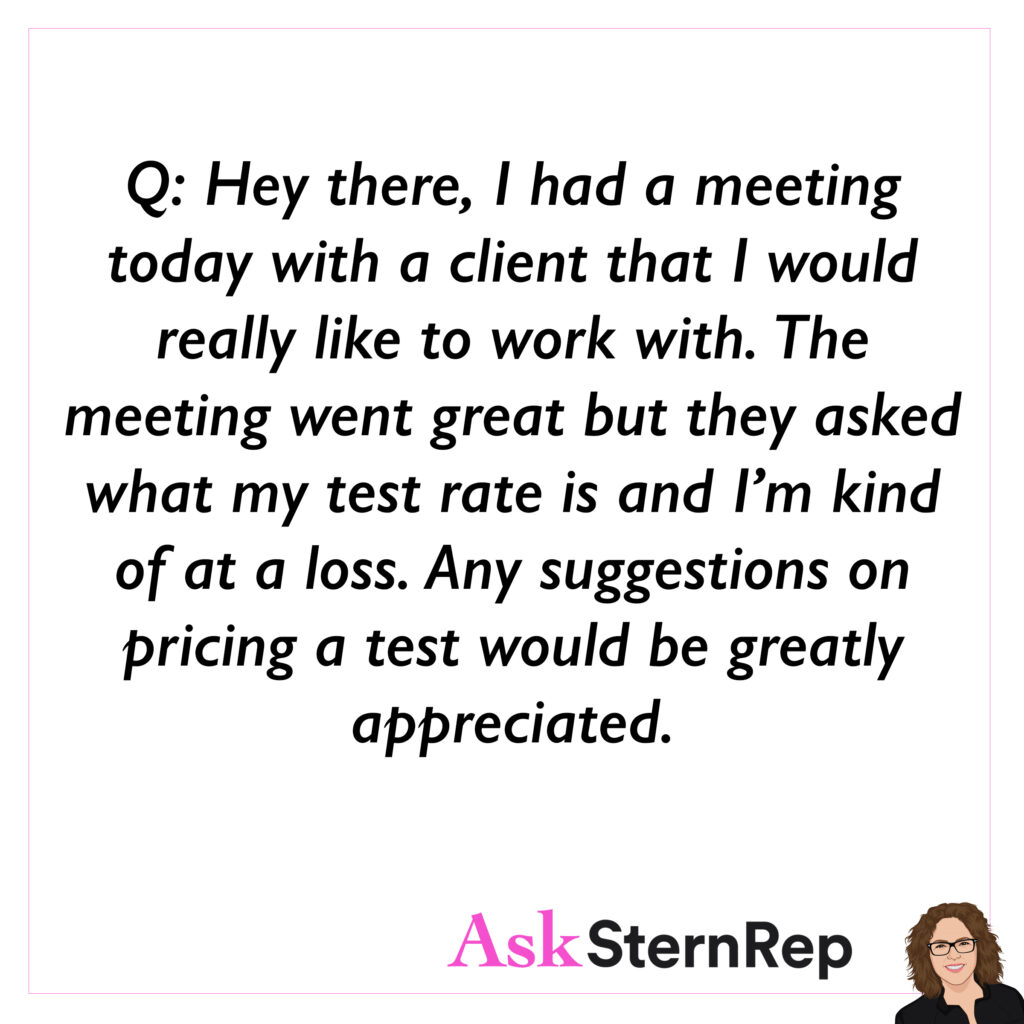

Q:
Hey there, I had a meeting today with a client that I would really like to work with. The meeting went great but they asked what my test rate is and I’m kind of at a loss. Any suggestions on pricing a test would be greatly appreciated.
A:
A test rate usually falls within half of what the regular day rate can be for a client. The logic behind the test rate is how it does not include usage licensing fees. This principle is the same premise for how I price a pre-light day; always have the estimate read, “no usage included” next to this fee.
Choose Your Words Wisely
Admit it; you are SELLING a product. Approach the conversations with a potential client as a LISTENER, ready to open the pathway to let your true purpose be heard. Choose your words wisely instead of filling any space. Trust me; there won’t be much empty space.
Spec Work
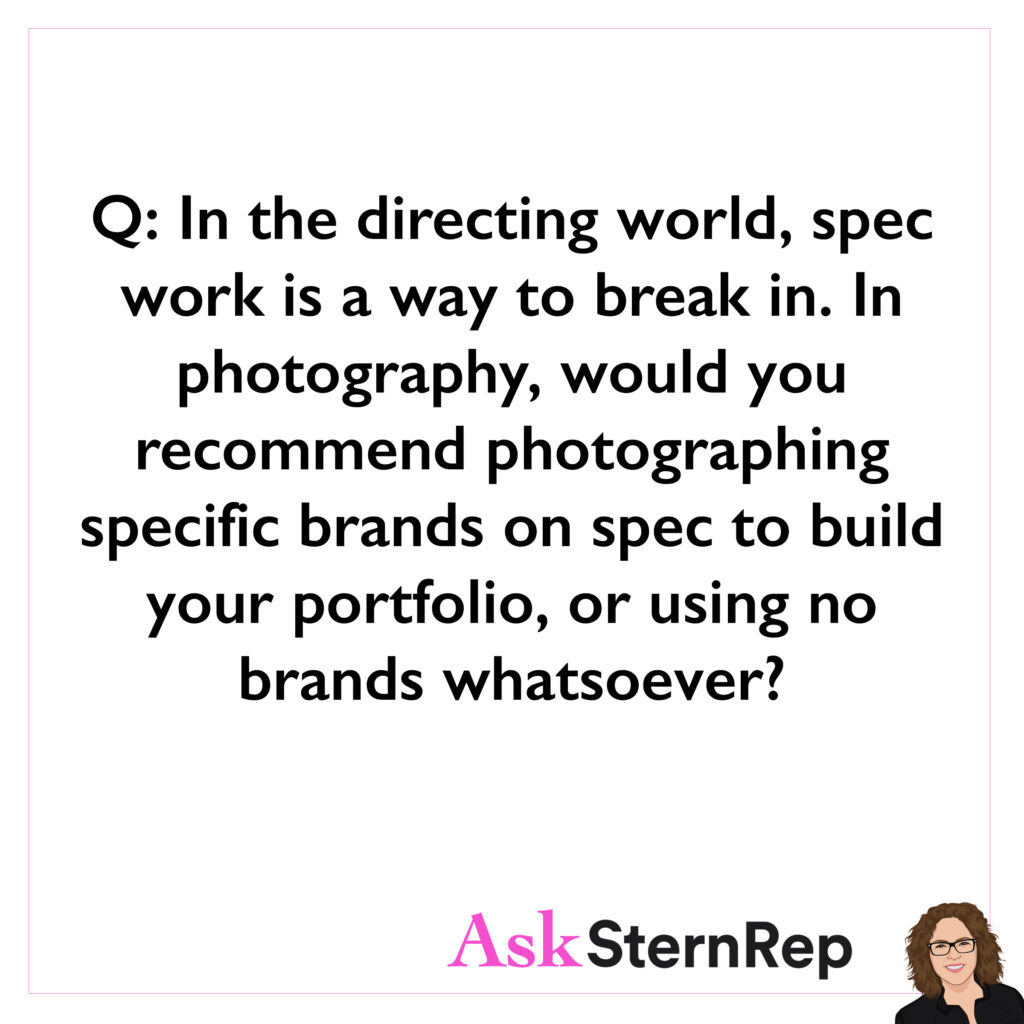

Q:
In the directing world, spec work is a way to break in. In photography, would you recommend photographing specific brands on spec to build your portfolio, or using no brands whatsoever?
A:
In the photo world, clients want to see your overall style match their brand. Build your portfolio to show the look and feel your favorite clients cater to, and use this “spec” concept to incorporate the products your ideal clients will need to see. If you want to get beer campaigns, put in some cans or bottles and show off how your shiny condensation skills fit your cohesive vibe. Displaying the type of product is more important than the specific brand of the product.
When Choosing a Producer
Make an educated choice when choosing a producer to help you bid a job. Be aware that some charge a 10% production fee on the expenses and some don’t. Some do waive that fee if you ask, so know that you do have options.
When you are bidding for a job you have to ask yourself if you need a producer and if so, which producer do you need? There’s a new element to our decision, it’s called a production fee. It used to be called a markup fee and then ad agencies did not want to pay that fee. Now it’s called a production fee. What we’re paying for is 10% of the production expenses that gets paid to the producer. They want to be covered for giving their employees health insurance and other expenses to keep their business going. It’s a new concept and some producers don’t charge it, but some do. Think about that and ask that question when you are choosing your producer.
Shared Usage Rights


Q:
Hey Andrea! I had a client come back after reading my contract that states “shared usage rights” so that I can use the photos and they can as well. But he came back saying they want to “all rights” but says he is okay if I use them for personal marketing/website. This company is small and I am not quite sure he knows what he is talking about. What should I do here/what is the correct way “rights” are normally discussed and used in a contract?
A:
The client’s response sounds like they are assuming ownership of the copyright since they’d grant you usage of the images. First of all, always make sure to be clear that you own the copyright. That is the #1 rule for your contractual terms. If you agree to “work for hire” that means you would not own the copyright. One term I include on every estimate is, “Artist owns the copyright and retains self-promotion rights for all images and tearsheets of ads.”
Creative Calls: What You Need to Deliver
What you need to deliver in the creative video call to get the job:
- Enthusiasm
- Unexpected Bonus Ideas
- Throw in a relevant comment or two to reinforce your specialty, which has you on their shortlist for this project
When asked to bid on a job you’ll probably have a creative call. This is more important than ever because it’s video. It used to be a phone call and it wasn’t as personable. They didn’t really get a sense of you as much. Now it really weighs in on their decision who they are going to choose for the job. You have to have your enthusiasm to show your excitement for this job because they’re handing it over to you. They want to know who you are going to be on their set. Once you get the creative deck which is the mood board and the shot list, think about technical ideas because that’s your place in this. What are you going to bring to the job? They want to hear from you. Why exactly did they choose you for this bid? Think about that one thing that separates you and is unique to you for this job. Fit it into the conversation and have a question in mind or a thought, something you’re going to say about a shot that you can relate to and you know that is why they brought you in on this.
Insurance


Q:
You know what would be a good topic to discuss with your audience? Insurance. As photographers we’re so focused on our craft and drumming up business that we forget how important insurance is until we need it and realize how paramount it really is. Hope you consider exploring that topic. I would love to hear what I should have and case studies.
A:
I asked my food photographer Vinnie Finn to answer this as photographers purchase their own insurance. This would be a good question to ask your community of photographers. Here is Vinnie’s take on this ‘ “Most commercial shooters use Tom C Pickard for insurance. I use State Farm and haven’t had any issues but I also haven’t had to file any claims. The reason I haven’t moved over to Tom Pickard is the price, it’s significantly more expensive and I’m mainly shooting in my personal studio on my own gear. If I was shooting on location regularly with rental gear and the likelihood of gear being damaged or a car accident was higher I would definitely move over. TCP has a really good reputation in the industry and they are super fast with COI and handle claims (so I’ve heard). I feel covered in terms of theft or damage at the studio and that is my primary concern.”
Bring the Client’s Branding into Your Bidding
Bring the client’s BRANDING into your bidding approach as much as possible. Do your research, ask the questions, as the ultimate purpose of receiving the job is to achieve your client’s branding goals.
When we’re in the process of getting a job, there’s a lot of times where we can focus on the branding for the client. We need to make sure a lot of what we are working around is their branding because that is what’s most important to them. Do your research to find out what their brand is. Check out their website. If they don’t make it clear what the feeling/color/ tone is then ask about it and make sure you mention it in your treatment. Because that’s what they want to hear. They want to know that you’re a part of it. You’re not just a part of this one shoot, you’re part of their long term vision.
Who Should You Be Reaching Out To?
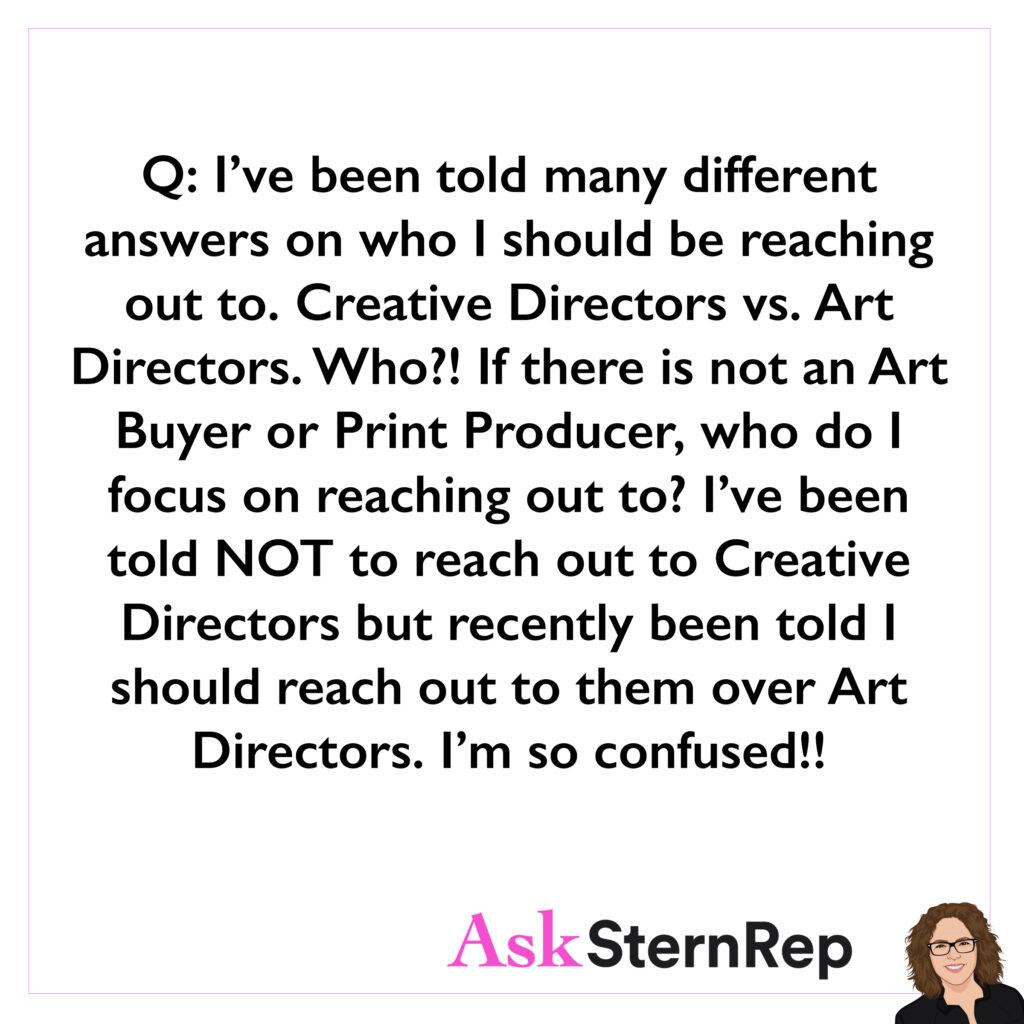

Q:
I’ve been told many different answers on who I should be reaching out to. Creative Directors vs Art Directors. Who!? If there is not an Art Buyer or Print Producer, who do I focus on reaching out to? I’ve been told NOT to reach out to Creative Directors but recently been told I should reach out to them over Art Directors. I’m so confused!!
A:
Your confusion about who to contact is natural since there is no absolute rule book. Client-direct business has a whole different setup vs. ad agencies and is even more ambiguous as they often hire a producer or production company to handle their photography. My secret sleuth style is to see which of the titles (art director/creative director/producer) have many photographer connections on LinkedIn. Then you know they are working with us!
Where are we right now and what do we need to do? // Navigating the Unknown Episode 17
Navigating the Unknown Episode 17 – Where are we right now and what do we need to do? Is now live on YouTube! This week we speak to Producer Joy Asbury and Producer Michael Horta about where our industry is headed now.
Guests:
Joy Asbury – Producer, joy Asbury Production https://joyasbury.com/
Michael Horta – Producer, MJ68 Productions http://www.mj68.com/
Navigating the Unknown is a Q&A series in collaboration with APA-LA where we speak to different members of the photo community about all aspects of the commercial photography business. https://la.apanational.org/
With Co-Host: Photographer Hugh Kretschmer https://www.hughkretschmer.net/
Time to Talk
The creative call is the time to give your technical examples of how you will be bringing this project to life. It may seem like the time to listen, but it’s really the time to talk.
The creative call feels like you’re just getting their information so you can do the bid. That’s really not what’s happening. They want to hear from you. Make sure you give examples of what you’re going to do so they can achieve that look they’re going for. Be really specific. Give examples. It’s your time to step forward. That’s really what these calls are about. Be the one on the call giving the information vs just receiving.
Approaching New Clients
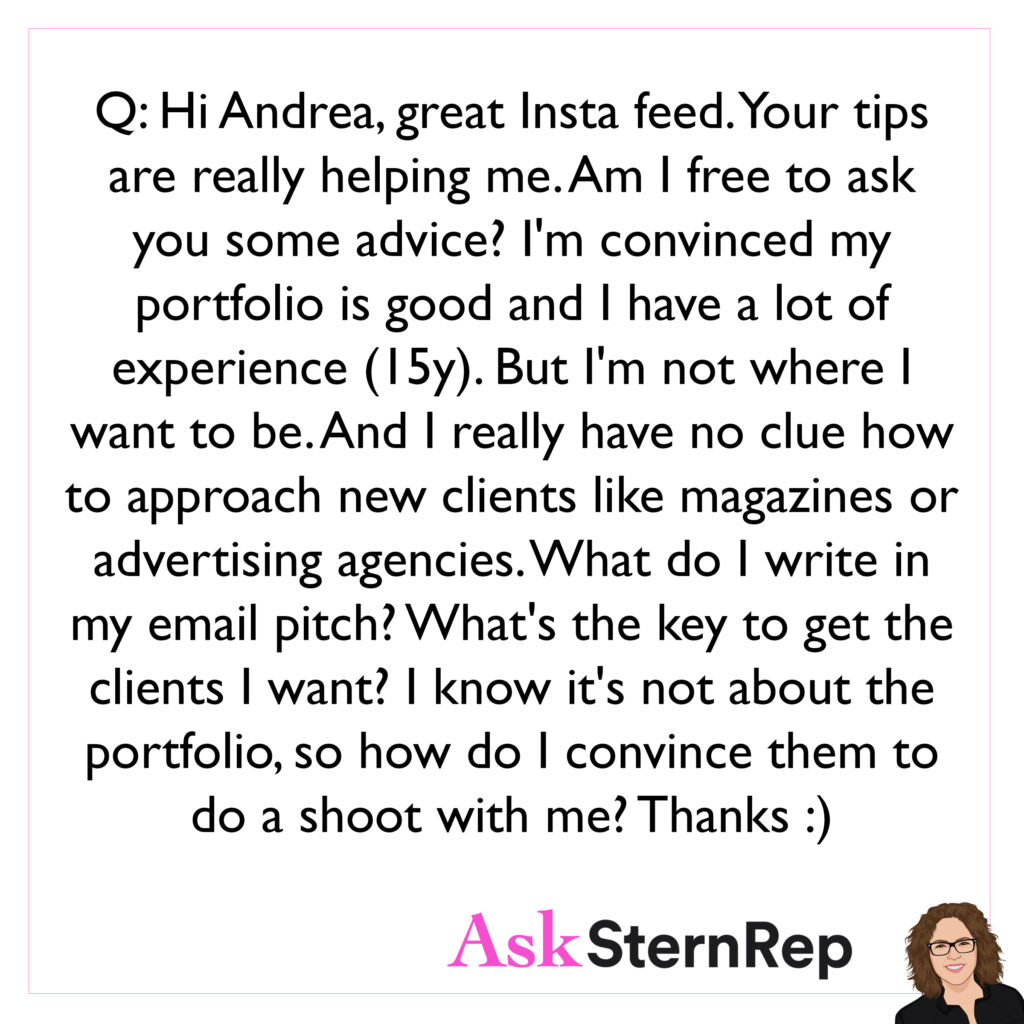
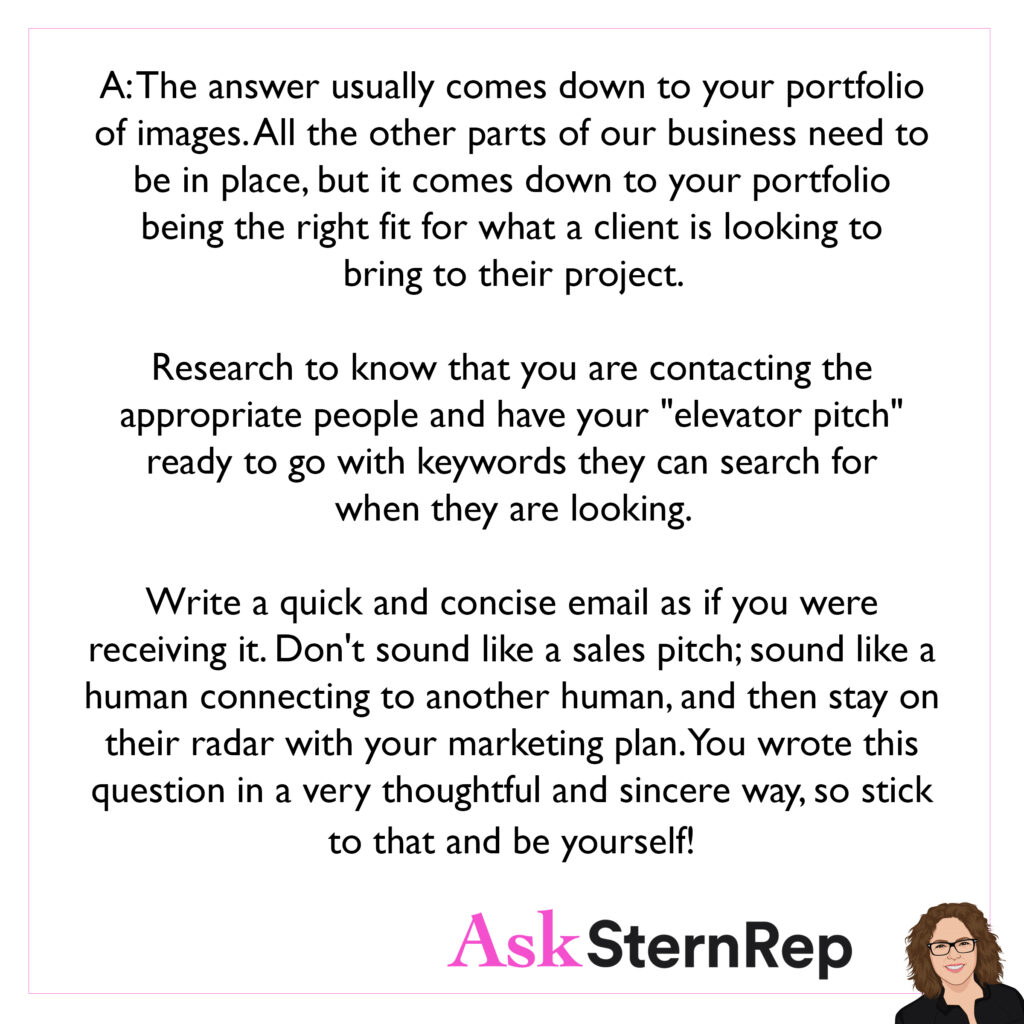
Q:
Hi Andrea, great Insta feed. Your tips are really helping me. Am I free to ask you for some advice? I’m convinced my portfolio is good and I have a lot of experience (15y). But I’m not where I want to be. And I really have no clue how to approach new clients like magazines or advertising agencies. What do I write in my email pitch? What’s the key to get the clients I want? I know it’s not about the portfolio, so how do I convince them to do a shoot with me? Thanks 🙂
A:
The answer usually comes down to your portfolio of images. All the other parts of our business need to be in place, but it comes down to your portfolio being the right fit for what a client is looking to bring to their project.
Research to know that you are contacting the appropriate people and have your “elevator pitch” ready to go with keywords they can search for when they are looking.
Write a quick and concise email as if you were receiving it. Don’t sound like a sales pitch; sound like a human connecting to another human, and then stay on their radar with your marketing plan. You wrote this question in a very thoughtful and sincere way, so stick to that and be yourself!
Break the Mold
Let’s break the mold of what we call “traditional marketing” to put ourselves out there in a way that is our own individual style of genuinely being ourselves. Put it out there and call it MARKETING.
I have a marketing homework assignment for you. I want you to find the thing that just feels right to you. You enjoy it and you put yourself out there in a way that is very unique to you and doesn’t even sound like marketing. It’s not directly correlated to bringing in money or new clients but you’re putting yourself out there just the way I’m doing with AskSternRep. It feels right. You need to find your way, maybe it’s joining a club, kind of like the apa thing. I want you to find the things that are really unique to you. Find new ways to put yourself out there and call it marketing.
Where We Stand Now
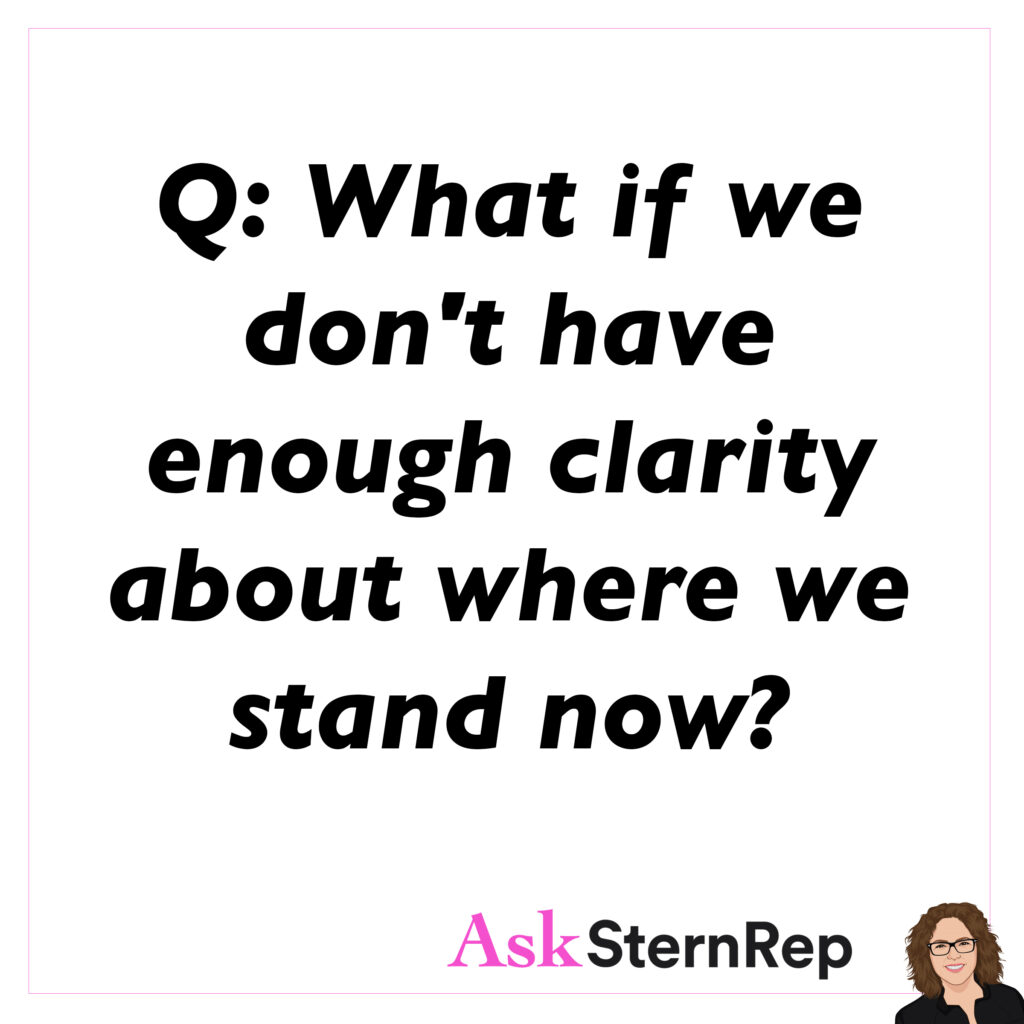
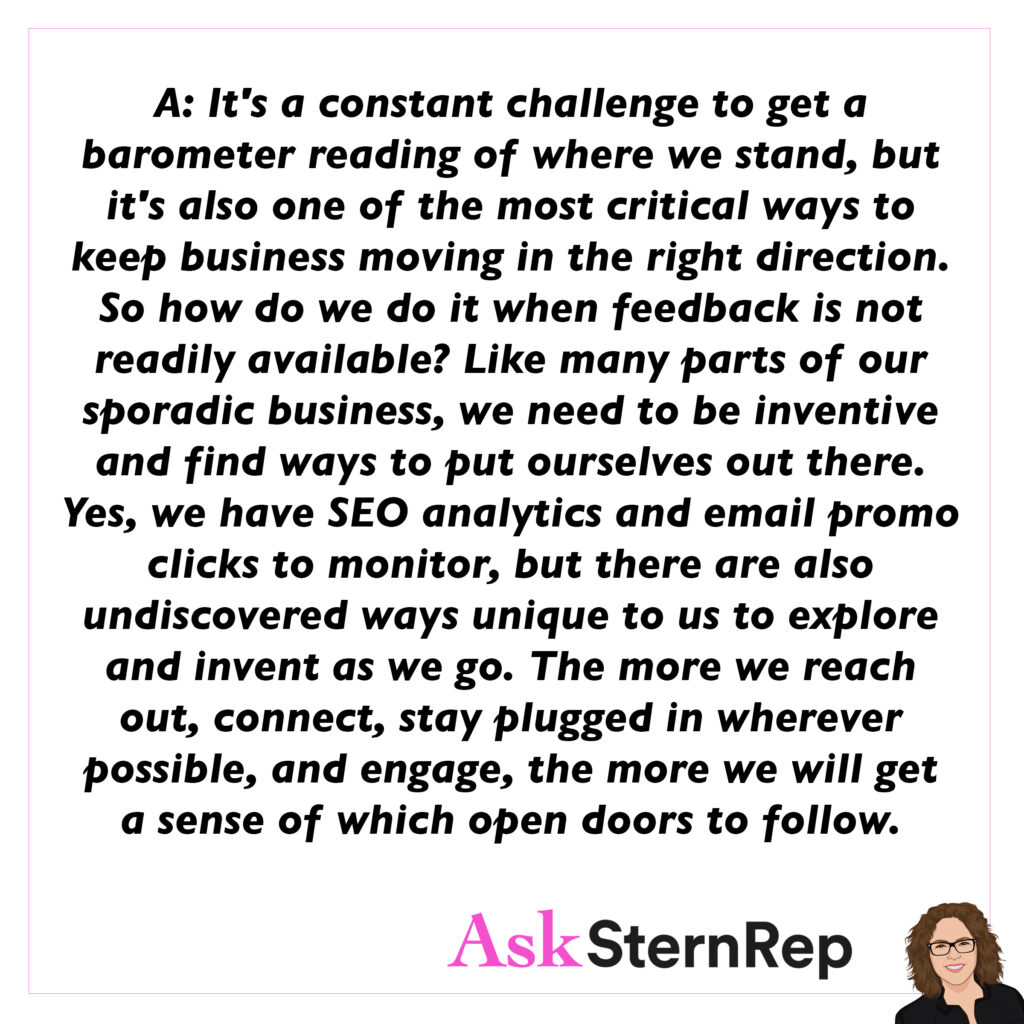
Q:
What if we don’t have enough clarity about where we stand now?
A:
It’s a constant challenge to get a barometer reading of where we stand, but it’s also one of the most critical ways to keep business moving in the right direction. So how do we do it when feedback is not readily available? Like many parts of our sporadic business, we need to be inventive and find ways to put ourselves out there. Yes, we have SEO analytics and email promo clicks to monitor, but there are also undiscovered ways unique to us to explore and invent as we go. The more we reach out, connect, stay plugged in wherever possible, and engage, the more we will get a sense of which open doors to follow.
Coming Back Now to “Normal”
How do we come back now to “normal” life after this wild lockdown experience even BETTER than before?
If anything, this paused time gives us the wake-up call of what needs a revamp, a boost, an upgrade. What can we do differently now?
I’m noticing what is working well for me, where I thrive; the other stuff is no longer adequate. Use your natural momentum and run with what DOES work for you!
I have a question for you: How can we come back stronger as everything gets started again and things are moving forward? How can we come back better and higher than before? What are some strategies we can use?
One thing I’m doing is staying active and visible. I’m putting myself out there through various channels—whether it’s Clubhouse, Instagram Live, Instagram Stories, Facebook groups, or webinars. Engaging in these activities gives me an energetic, positive feeling, and doing this video feels right and energizing. Find what makes you feel energetic and incorporate that into your routine.
Another strategy is talking to people. I find that checking in with others and brainstorming about the business can generate new ideas for both parties. This exchange of ideas can be really beneficial.
Additionally, put yourself in a position to objectively evaluate how others are performing. Compare your work to that of others who are active in the industry. You can ask producers or potential clients who they are working with, or consult reps. Look at Instagram Stories and see who’s working and why. Assess why others are succeeding and how they reach the level you aspire to.
Do your research and education to understand your industry better. Look at your work from a business perspective rather than a personal one.
So, what’s your answer? How will you come back stronger, higher, and better? Share your thoughts!
Creative Ways to Engage Your Audience
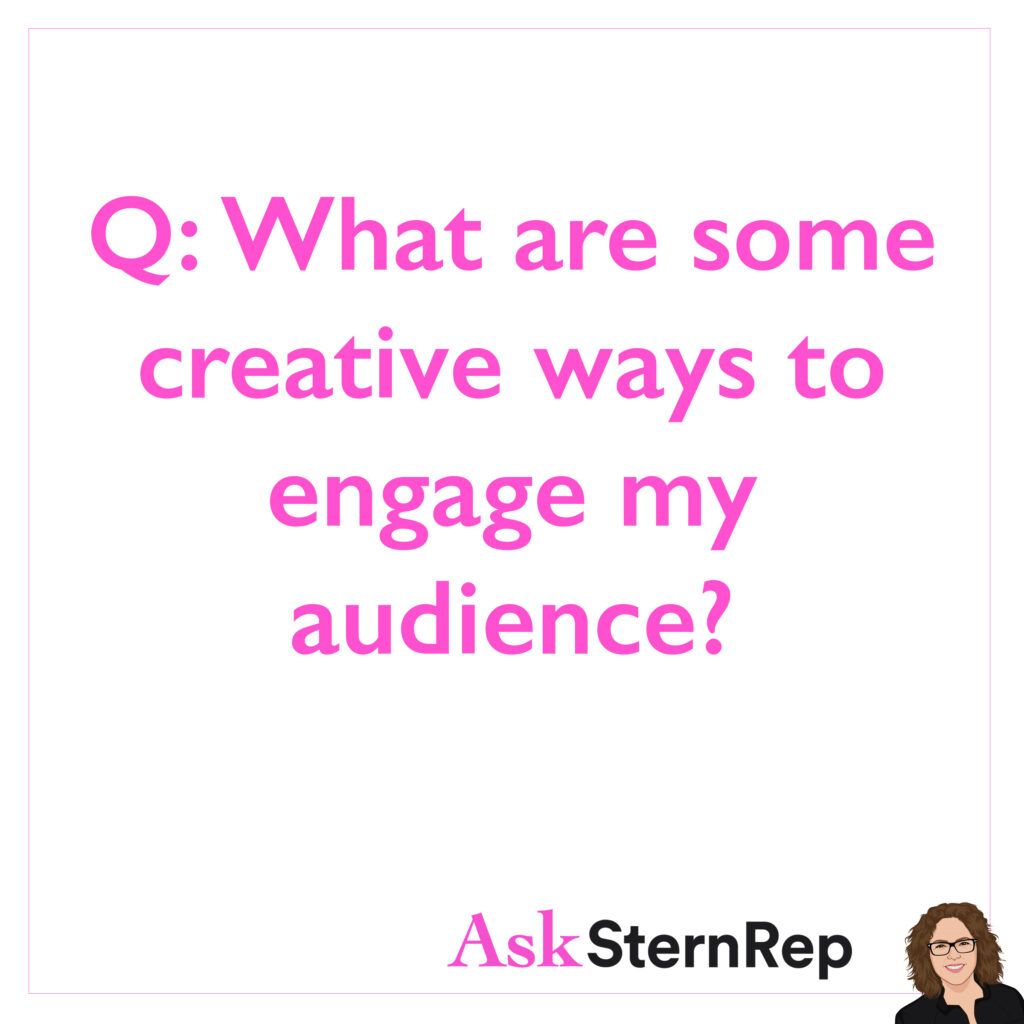
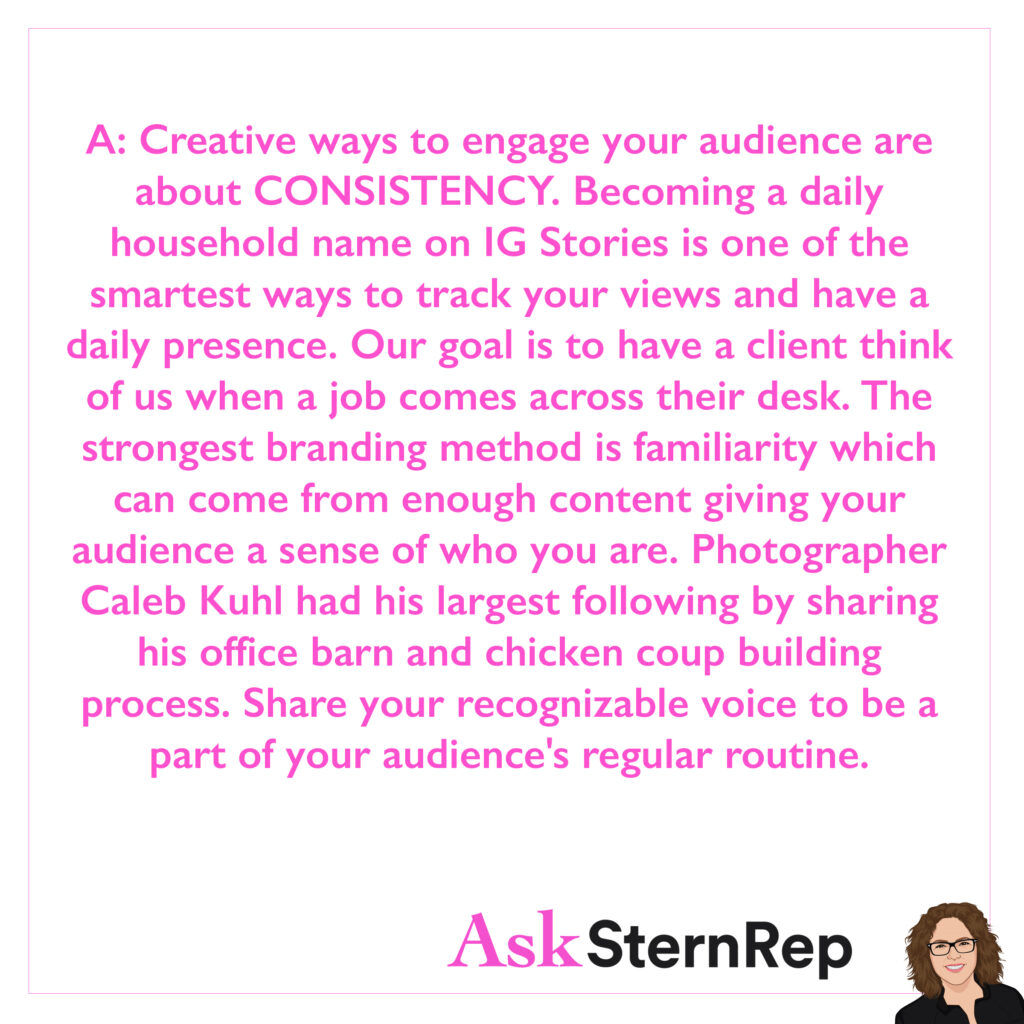
Q:
What are some creative ways to engage my audience?
A:
Creative ways to engage your audience are about CONSISTENCY. Becoming a daily household name on IG Stories is one of the smartest ways to track your views and have a daily presence. Our goal is to have a client think of us when a job comes across their desk. The strongest branding method is familiarity which can come from enough content giving your audience a sense of who you are. Photographer Caleb Kuhl had his largest following by sharing his office barn and chicken coup building process. Share your recognizable voice to be a part of your audience’s regular routine.
Are You In A Slump?
Are you in a slump?
Your definition of “work” may be what is actually in a slump.
Restricting ourselves to actions only associated with direct financial compensation will deplete the exact goal we are seeking and thus, make you feel you are in a slump.
Listen to what you are experiencing, open the studio doors; work requires allowing the many parts of us to flourish and feed what makes us good at what we do.
Slumps. Are you in a slump? We have this thought about work, that we have to make money and that is the purpose of it. This work energy that we can keep ourselves in and keep fulfilling and flourishing like supporting it. So we can then become better and successful in the financial way but we don’t always have to feed ourselves just by doing what we think is work. That’s why I do AskSternRep. Caleb Kuhl built a chicken coop, and an office and he has a youtube channel discussing technical aspects of photography. That kind of stuff feeds you and it is actually creating more of that work that you want. We just don’t always see it as working. Take time for yourself when you need it instead of thinking you’re in a slump and focusing on the negative part of all this.
New Photographers
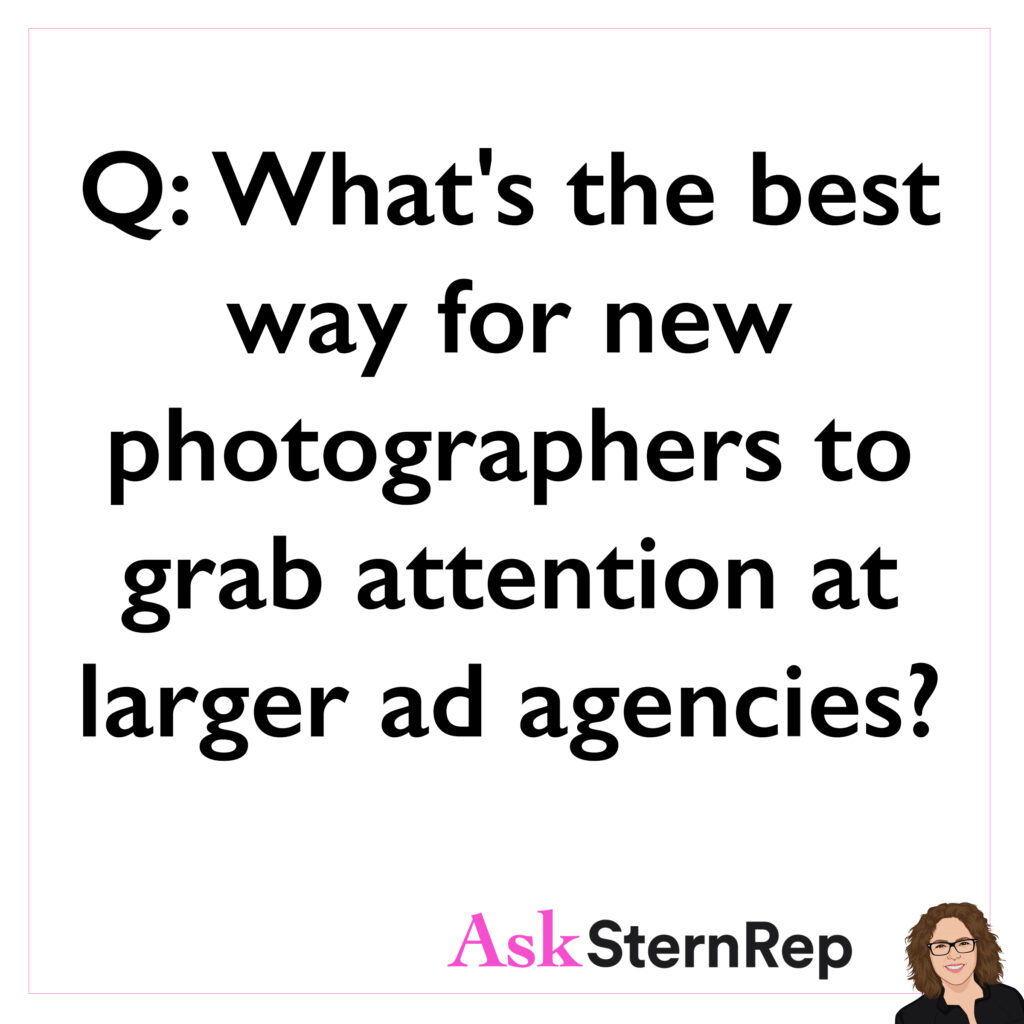
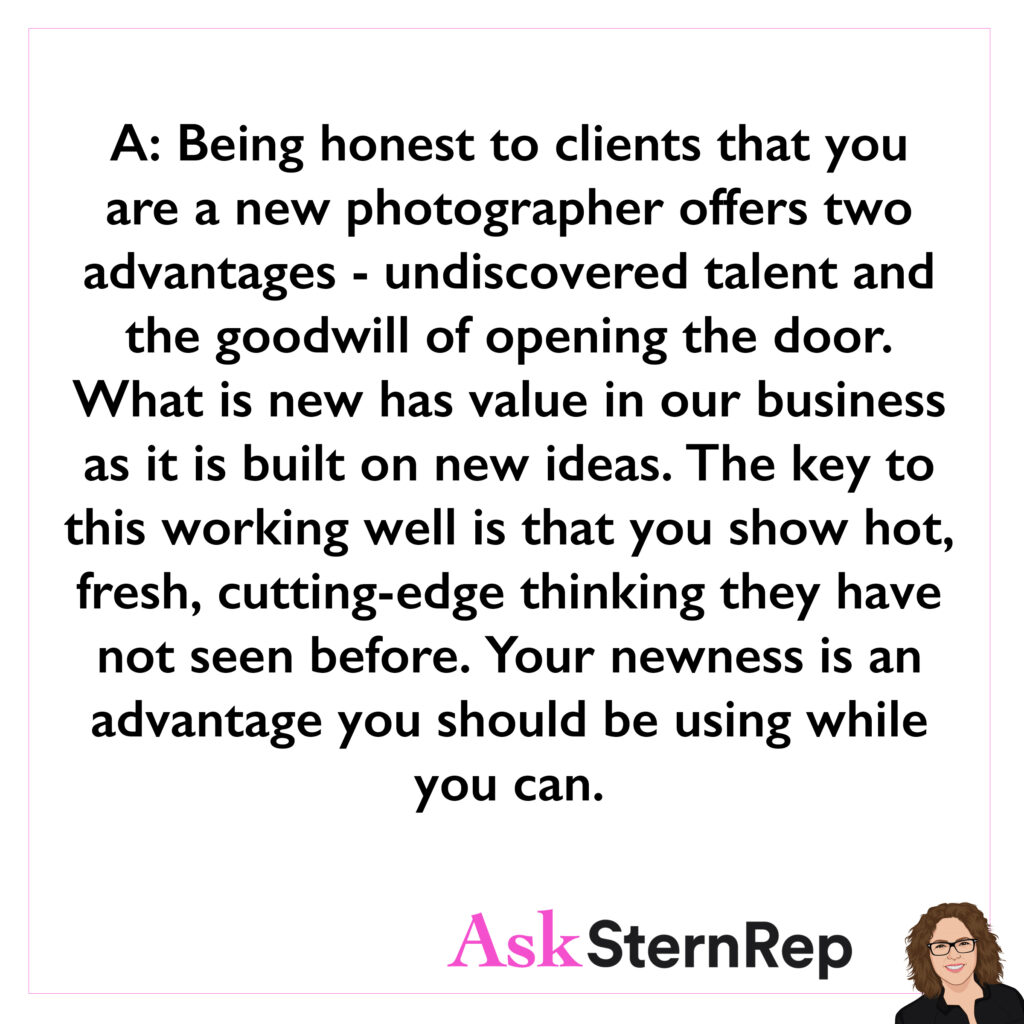
Q:
What’s the best way for new photographers to grab attention at larger ad agencies?
A:
Being honest to clients that you are a new photographer offers two advantages – undiscovered talent and the goodwill of opening the door. What is new has value in our business as it is built on new ideas. The key to this working well is that you show hot, fresh, cutting-edge thinking they have not seen before. Your newness is an advantage you should be using while you can.
Highlights on IG
Highlights on IG are that fast direct route for clients to know what they can hire you for. Make this easy for them to know what you do!
To make the most out of your instagram you must use highlights. You knew I was going to say that. These are your categories or your projects like on your website, because instagram is like your second website. You must use highlights. Make it quick and fast for clients who have 2 seconds to figure out who you are and what you do and to make you find-able if they’re looking for sports or like athleisure or still life for beverages, something like that. Make it really fast because you don’t want them to have to scroll down your whole feed. They could do that if they have time but if they don’t, highlights make it very quick for them to find you.
DMing a Company on IG

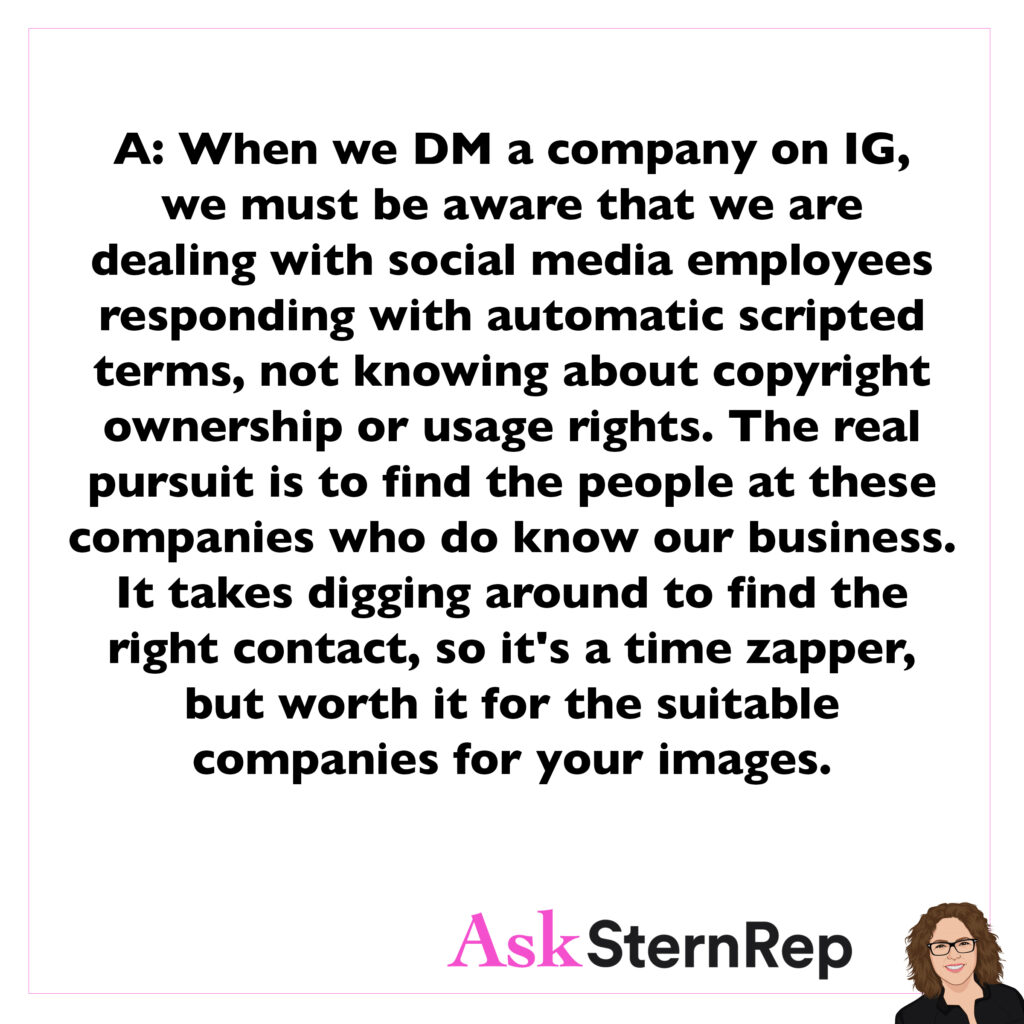
Q:
I did some spec work, shared it on Instagram, and tagged the company. They then messaged me and said that they loved the work and then sent me a link with their TOC, asking for full usage in perpetuity. This has happened 3x already. I don’t seem to be getting anywhere by saying, “I would love to chat about licensing and future work.” Any advice?
A:
When we DM a company on IG, we must be aware that we are dealing with social media employees responding with automatic scripted terms, not knowing about copyright ownership or usage rights. The real pursuit is to find the people at these companies who do know our business. It takes digging around to find the right contact, so it’s a time zapper, but worth it for the suitable companies for your images.
Don’t let the term – “SALES” Get In Your Way
Don’t let the term – “SALES” stop you or get in your way.
It’s actually a simple process of sharing our well-researched knowledge through these 3 steps:
- Honesty – believe in what you put out there.
- Empathy – anticipate and address the challenges your clients are up against.
- Listen – use your time wisely by asking the right questions and allowing space for the answers.
To make the most out of your instagram you must use highlights. You knew I was going to say that. These are your categories or your projects like on your website, because instagram is like your second website. You must use highlights. Make it quick and fast for clients who have 2 seconds to figure out who you are and what you do and to make you find-able if they’re looking for sports or like athleisure or still life for beverages, something like that. Make it really fast because you don’t want them to have to scroll down your whole feed. They could do that if they have time but if they don’t, highlights make it very quick for them to find you.
Networking Options
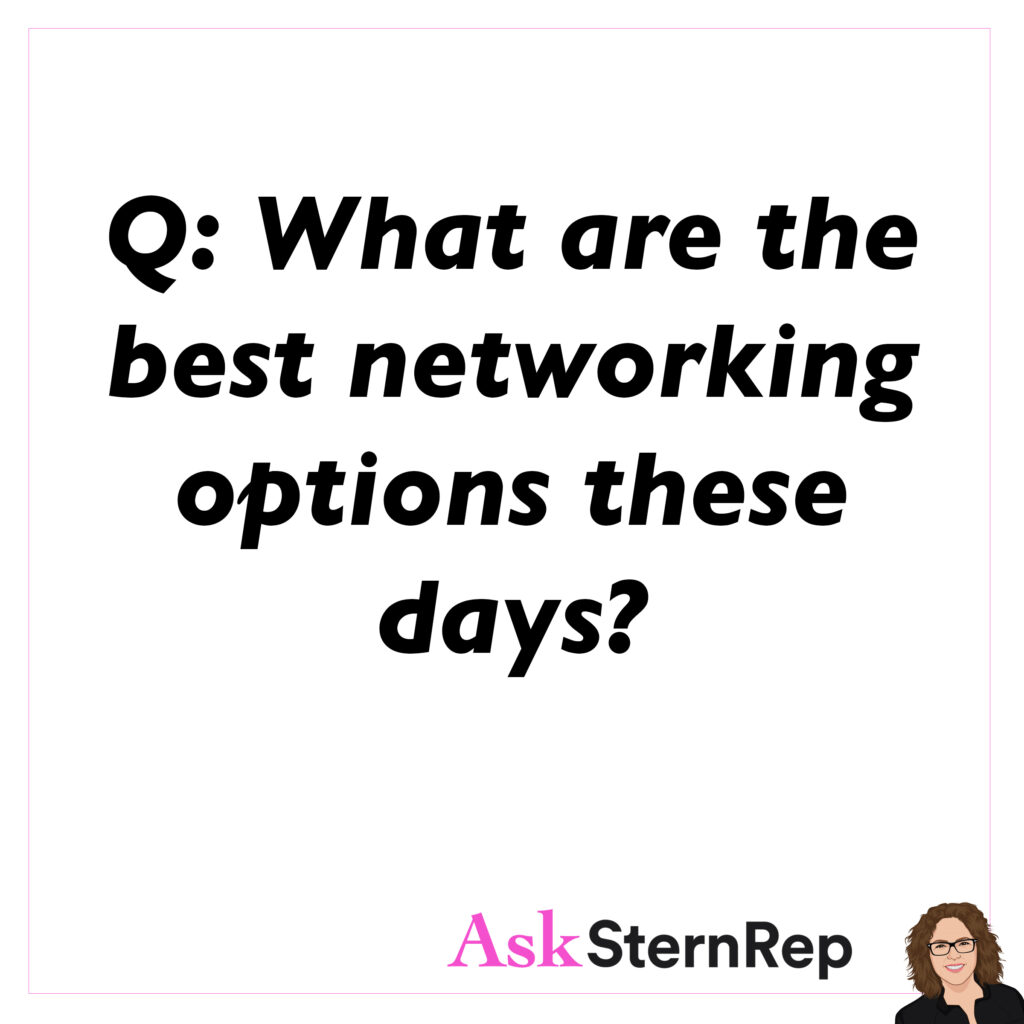

Q:
What are the best networking options these days?
A:
Photographers have to create their own networking as it’s on a more individual basis instead of group events. Directly contacting clients is much more acceptable than it used to be; it’s even more expected these days. Get yourself out there with all the social media platforms and zoom portfolio reviews. See what interests people, notice what they said on a webinar or their LinkedIn post, use all of this as a more human approach to doing one-on-one connective networking.
Stay Plugged In
As a freelancer, how do we go to work each day when we aren’t “going” to work?
Truth is, we have to stay plugged in to stay on track.
Use our industry resources to keep as actively involved as if you were punching the time card.
Making the Most of an Agency Access Subscription


Q:
Any tips or tricks on making the most of an Agency Access subscription?
A:
I would not rely on a single source for your contact list management. Agency Access can help and be a good resource if you also collect names of prime contacts in other ways like social media, LinkedIn, and jury/portfolio review event lists. Today’s marketing is multi-dimensional, with all of our combined resources working together. I use Agency Access as a research tool offering info on the masses with valuable insights like client email formats and the brands they cover.
Don’t Settle With Your Treatments
The TREATMENT webinar gives us the story behind the words and visuals needed to get us the job and why we need to take this seriously. Templates need a slice of who we are in them, personalized to stand out, illuminating you are the right choice for the project. Don’t settle with your treatments; take them further; use what is revealed in this webinar to make your template YOURS!
Last week, my webinar was on treatments—the one unspoken big mystery of how to create a treatment, why to do it, and what’s needed to get the job. We covered a lot, but there were several key points that stood out to me that I want to highlight.
We had two guests: Scott Rickels, a treatment writer, and Mary Dail, a good friend of mine and rep at Big Leo Productions. Mary created a fictitious layout for us as an example of a treatment. Her design included the scope of the job, which I’d never thought to include in a treatment before—it was very smart. She also added a small copyright notice in the bottom left corner, not too large but useful for protecting against unauthorized use for comps. Her design effectively replicated the feel of the fictitious client we were targeting, making it a perfect example of a treatment.
Scott Rickles addressed a common concern: What if they don’t read the treatment? He pointed out that the words have to be engaging and not just a page after page of text, which can be intimidating. He emphasized that the real goal of the treatment is to add personality and flavor to what you bring to the job technically.
There were so many nuggets of wisdom shared. To fully understand the purpose of a treatment and how to use it to get the job, I recommend checking out the webinar.
Printed Promos vs Online Sources


Q:
So…printed promos being kinda a guessing game these days as most are working from home, are you finding LinkedIn being the go-to source to keep up with folks to market to? The list services have always been so hit/miss for emails and so many people have transitioned to new gigs. Just curious where and how folks are staying on top of their lists.
A:
Divide your list into two parts – the mass list like on Agency Access (feels like a fishing net) and then the HOT clients you want to work with or who already know your name. The HOT list will need you to get a bit more creative in building relationships to stay in touch. This relationship-building marketing can be through interests you share, IG dm’s, commenting, and relating to people in ways that take your marketing to that next “human” level.
What Goes into an Impactful TREATMENT that Gets the Job? // Navigating the Unknown Episode 16
Navigating the Unknown Episode 16 – What Goes into an Impactful TREATMENT that Gets the Job? is now live on YouTube! This week we speak to Treatment Writer Scott Rickels and Artist Rep Mary Dail from Big Leo Productions about how to create a cogent treatment.
Guests:
Scott Rickels – Treatment Writer
Mary Dail – Artis Rep, Big Leo Productions https://bigleo.com
Navigating the Unknown is a Q&A series in collaboration with APA-LA where we speak to different members of the photo community about all aspects of the commercial photography business. https://la.apanational.org/
With Co-Host: Photographer Hugh Kretschmer https://www.hughkretschmer.net/
The Photographers That Get Rehired Again and Again
“I noticed that the photographers we work with that we see getting rehired again and again are great problem solvers. They find creative solutions and freely offer their perspective and opinion in a way that instills confidence in the client. We often see when a big project of importance comes around, the agency art directors will want to speak with us from the very beginning, and it becomes clear that their level of comfort and confidence is with a trusted creative partner.”
Guest Post: Executive Producer, Michael Horta
Some photographers get the job over and over. The client keeps going back to them. Why is that? How do we do that? They want a problem solver, they want a partnership. If someone can bring up issues that the client might not even know of yet and become a resource to them to make their job even better to make them look better than they even are, they will hire you. Learn how to be their partner in this, not just for that one job, but the long term.
Getting into Commercial Photography

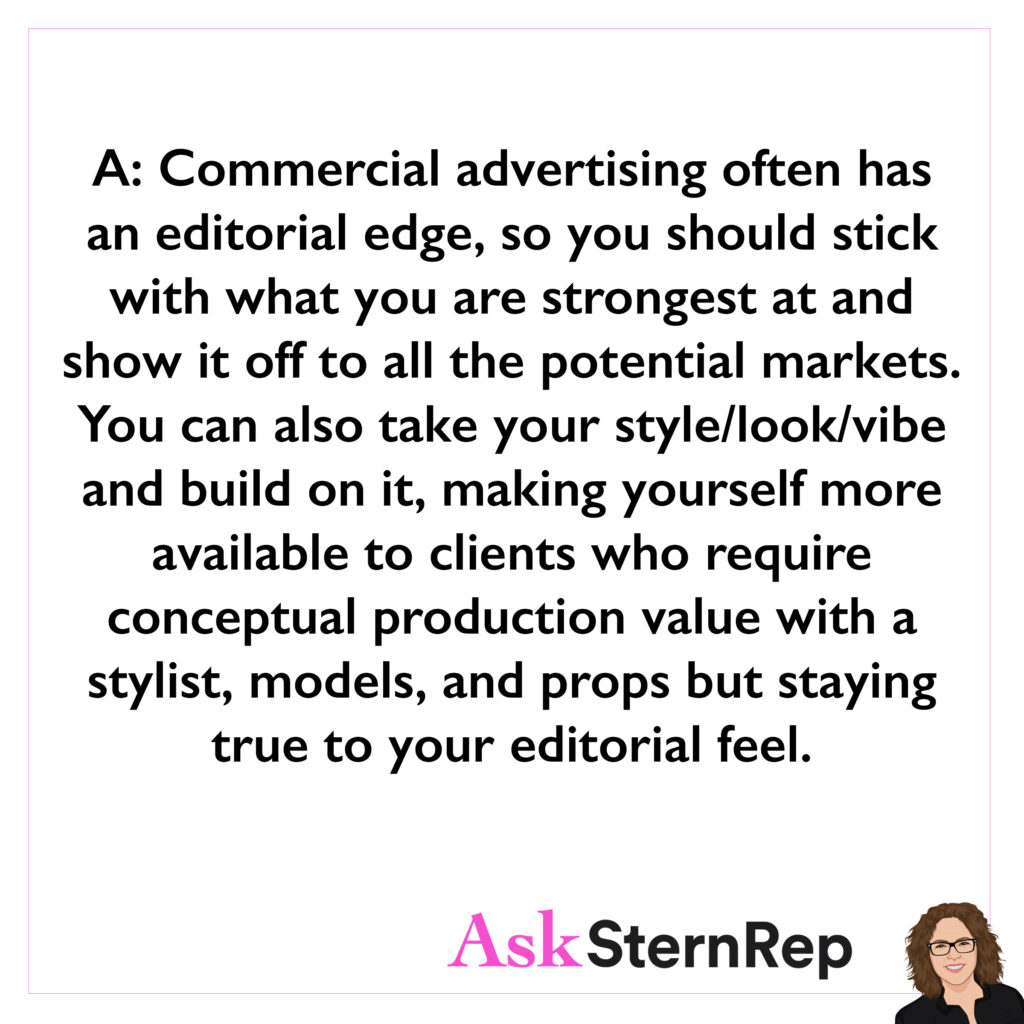
Q:
My question is as a portrait photographer working heavily in editorial, how would I go about getting into commercial photography? Meaning that portrait work is my specialty, specifically environment portraiture shooting “real people.” Leaving me wondering about shooting a commercial portfolio since most of my work is editorial.
A:
Commercial advertising often has an editorial edge, so you should stick with what you are strongest at and show it off to all the potential markets. You can also take your style/look/vibe and build on it, making yourself more available to clients who require conceptual production value with a stylist, models, and props but staying true to your editorial feel.
Treatment Final Edit Checklist
Treatment Final Edit Checklist:
- SPELLING and GRAMMAR mistakes are more damaging than you may think.
- Use every opportunity to use SPECIFIC words/concepts relating to this client and project in particular.
- Consistency of the organized structure through similar placement, layouts, titles, fonts, etc., to make it easy for them to follow.
Treatments are so important. When you are bidding for a job, you should always do one. Even if you think it’s too small of a job or the client doesn’t need it. Always do a treatment. There are three things to watch out for. The first is spelling and grammar. We know it seems little, but it really stands out if you have mistakes on your treatment. You’re a director, your attention to detail is important. The second is to be specific. You’re probably working off of a template. Make sure that the general lines that describe who you are and how you shoot always include the specifics on that job. That client is wanting to hear how you will shoot their job and not just how you shoot in general. The last one is consistency. Your style and how you set up the content in your treatment should always be consistent. Don’t jump around, make sure the treatment reads smoothly. You’re giving them something that can help you get the job. Remember that. Put time into this.
Promos + Reps


Q:
Is it appropriate to send email (and print) promos to reps, as I would to prospective clients?
A:
Yes, it is wise to treat reps as you do with any other clients you want to be working with. The goal is to always stay in front of prospective clients in a way that works for them. Mail printed promos to people’s office addresses and email promos are always good, but don’t limit yourself to just those two methods. Be open to discovering new ways to keep yourself out there as our world is constantly changing.
The One Job Requirement
The one job requirement for our creative careers is that we continuously stay inspired.
To be a creative means you have to be creative. Mix it up, try new things, and even when they fail, who cares; you are following the buzz that will take you places.
How do we stay inspired? The main part of our business is as creatives we have to keep the creative juices flowing. We can’t just get stuck in the ways that we already know. This is a constant throughout your career. Try something new, shake it up, even schedule yourself for it. Try something new on this date, every month. It doesn’t have to be a success, but think about things you haven’t tried before. You don’t have to know how it’s going to end up, to begin.
Following Up on “Clicks”


Q:
What’s the best follow-up with opened/clicks after sending email promos?
A:
A clicked on email promo gives us a goldmine of valuable information. The gift is that now you know who is interested in your work. Take this knowledge further by adding anyone at their company who is not already on your list and research other companies with similar vibes to get them on your promo list. Follow up with your newly “warm” names who know you in IG with Feeds/DM’s/Stories comments. Finding their IG handles is not always easy; LinkedIn and their personal websites can help. Now it’s time to engage!
Be Fully Present on Video Creative Calls
Give everything you’ve got on these video ‘Creative Calls’ by being fully present.
Let the client feel like they know who you are with a bit of warmth in your facial reactions.
Be prepared with ideas or comments, mentioning their website to show you are their ultimate team player whom they can count on to understand their branding goals.
Have questions ready to go that will suggest your production strategies and game-plan, all to help them get a sense of what you offer.
I was just on a video creative call and came up with some tips to help you secure the job from these calls. Video calls can often feel stiff and awkward, so it’s important to create a sense of warmth and presence. Make sure to maintain direct eye contact and avoid positioning your camera off to the side, as this can make it harder to connect.
Do your homework by researching their website and mentioning specific details on the call. This shows how serious you are and demonstrates that you understand their brand. Reference something from their website or the call—such as the shot list or details about the talent—to show your comprehension of their needs.
Prepare some questions in advance, whether they relate to talent, color retouching, the shot list, or lighting. These questions don’t necessarily have to be literal questions but can serve as opportunities to showcase your strategy and production ideas. Be yourself and give them a sense of how you’ll solve their problems effectively when they hire you.
Titles at an Agency
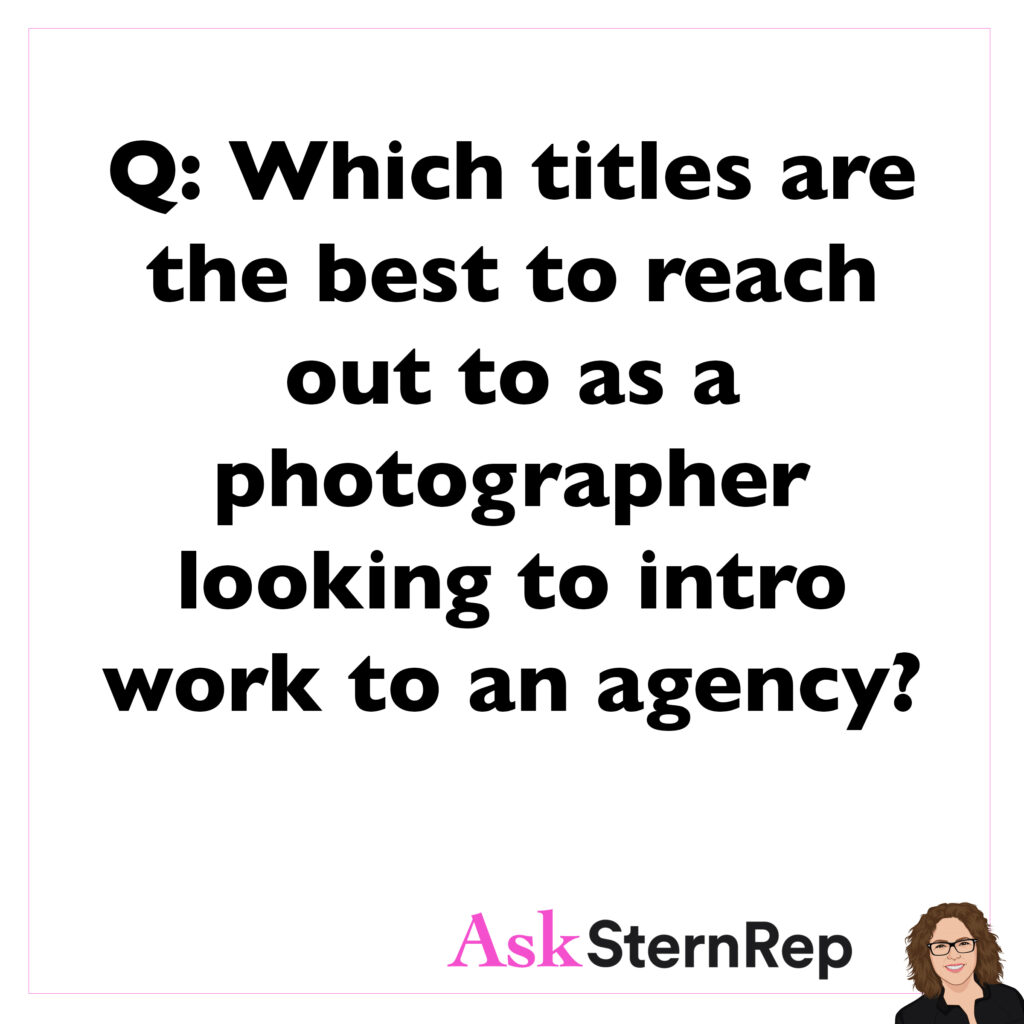
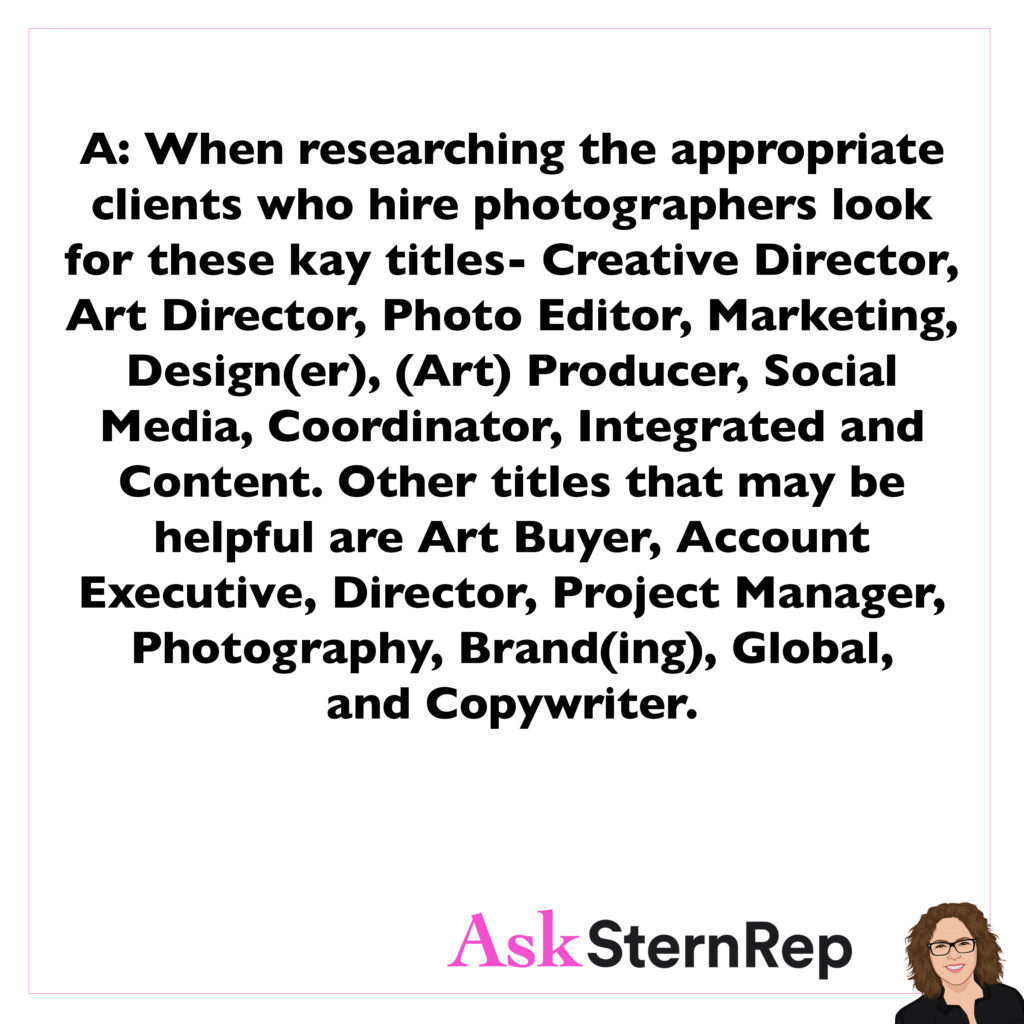
Q:
Which titles are the best to reach out to as a photographer looking to intro work to an agency?
A:
When researching the appropriate clients who hire photographers look for these key titles- Creative Director, Art Director, Photo Editor, Marketing, Design(er), (Art) Producer, Social Media, Coordinator, Integrated and Content. Other titles that may be helpful are Art Buyer, Account Executive, Director, Project Manager, Photography, Brand(ing), Global, and Copywriter.
What Goes into the Decision of Hiring Photographers at Ad Agencies? // Navigating the Unknown Episode 15
Navigating the Unknown Episode 15 – What Goes into the Decision of Hiring Photographers at Ad Agencies is now live on YouTube! This week we speak to Senior Art Producer Andrea Rosenfeld and Design Director Norman Brown about how and why they select photographers for a campaign.
Guests:
Andrea Rosenfeld – Senior Art Producer, David&Goliath
Norman Brown – Design Director, Zambezi Agency
Navigating the Unknown is a Q&A series in collaboration with APA-LA where we speak to different members of the photo community about all aspects of the commercial photography business. https://la.apanational.org/
With Co-Host: Photographer Hugh Kretschmer https://www.hughkretschmer.net/
Know Where We Stand Now
The best way to do better at our jobs is to know where we stand now. Look at what isn’t going your way and own it, use that info to get better instead of wasting your time blaming anyone/anything else.
The best way to grow and stay successful is to know where we are right now. It’s a little hard in our bubbles to know where we are when others don’t really tell us. It’s a bit awkward to get that information from people in the industry. We have to look at the things that happen that might make us angry. Like blaming the trends of the day, or clients, or budgets. The more we blame the less we’re looking at what we need to be looking at in order to grow. When we’re competing against someone for a job, can we find out who gets the job if we lost? Can we look at their work and see they got it because they’re better at that. Do I want to get better at that thing? Do I need to work on that?
Established Photographer


Q:
How established does a photographer need to be to put their work in front of art and creative directors? Do art and creative directors want to know that my shoots are pretty “scrappy” on the backend or should I try to appear larger than I actually am?
A:
Being pretty scrappy on the backend can actually work well for you when they need stills on a broadcast shoot or a small crew or low-budget project. The other part of that is an editorial style is often precisely what clients are looking for. Today’s photo industry is always on the search for a wide variety of styles and a multitude of skill sets. Use this to let them know all the benefits about your speed, how many images per day, any other crafts you offer like motion/GIFS, and how nimble crew members cover more than one role. Sell your scrappy approach!
How Do You Not Waste Any Precious Time With Your Portfolio Reviews?
How do you not waste any precious time with your portfolio reviews?
- Tell the reviewer your review purpose.
- Prep your questions and topics.
- Be open to hearing, listen instead of talking.
- Review your website + IG instead of prepared PDF.
- Move through your site swiftly because we don’t have that much bandwidth review after review.
I just did a portfolio review with ASMP on the East Coast, and it was really interesting to find some ways to get the most value out of these reviews. Time goes quickly, so it’s important to have a clear introduction and purpose. Let the reviewer know your intent, why you are there, and what you hope to get from the review.
Have your questions and topics prepared in advance. Know what you want to discuss, and if there’s time, decide which questions to ask and which parts of your website or business marketing you want to focus on. Be open to feedback; I found that I sometimes dominated the conversation and didn’t get as much out of it because the other person wasn’t talking as much. Listen carefully and be receptive to their contributions.
When it comes to presenting your work, consider using a website over a PDF. A website provides a comprehensive view of who you are and what you do, which is important for marketing and ensuring that reviewers remember you. A PDF might be useful if you are showing a specific portfolio or book to a particular client.
Finally, if you are sharing your screen, move through your website quickly to keep the review engaging. Reviewers may be tired, having seen many portfolios, whether in person or on Zoom. If you can find a way to engage the reviewer, help them relax, take a breath, and rejuvenate, it will make the experience better for everyone. I highly recommend it.
Designing a Website
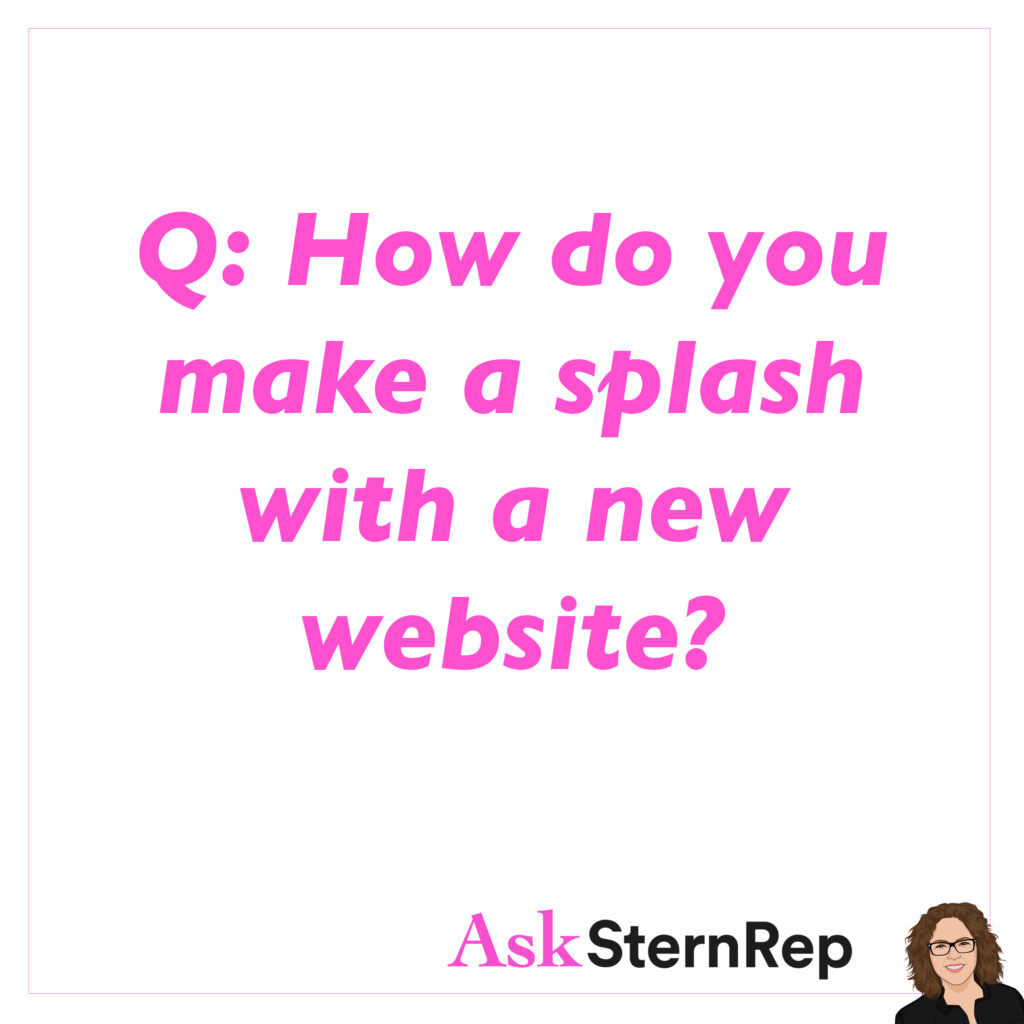

Q:
How do you make a splash with a new website?
A:
The two-pronged answer to this is to hire a rock solid design team who understands our well-categorized fast paced industry and then knowing how to show it off in all of our potential platforms with a dynamic in their face publicity. Remember, your website must comply with our industry norm of giving a 2-second quick read along with options for those who will have time to dig deeper and see more of what they are on the hunt for.
Wanna Break the Ice Fast?
So simple sometimes. Wanna break the ice fast? Be really kind and nice and complimentary but mean it.
One thing I learned when I started being a rep, back in Seattle with thanks to Doug Landreth, is the importance of scheduling. Doug introduced me to Maria Piscopo, a consultant who focuses on scheduling. Her approach hit me hard, emphasizing the need to have a structured schedule to keep track of tasks. When I didn’t have a proper system, I struggled significantly. Time management became crucial for me, and it’s something I learned to value deeply. Consultants can be incredibly helpful, and there are many out there. If you ever need advice or recommendations, feel free to ask me, and I’ll point you in the right direction.
Lower Budgets
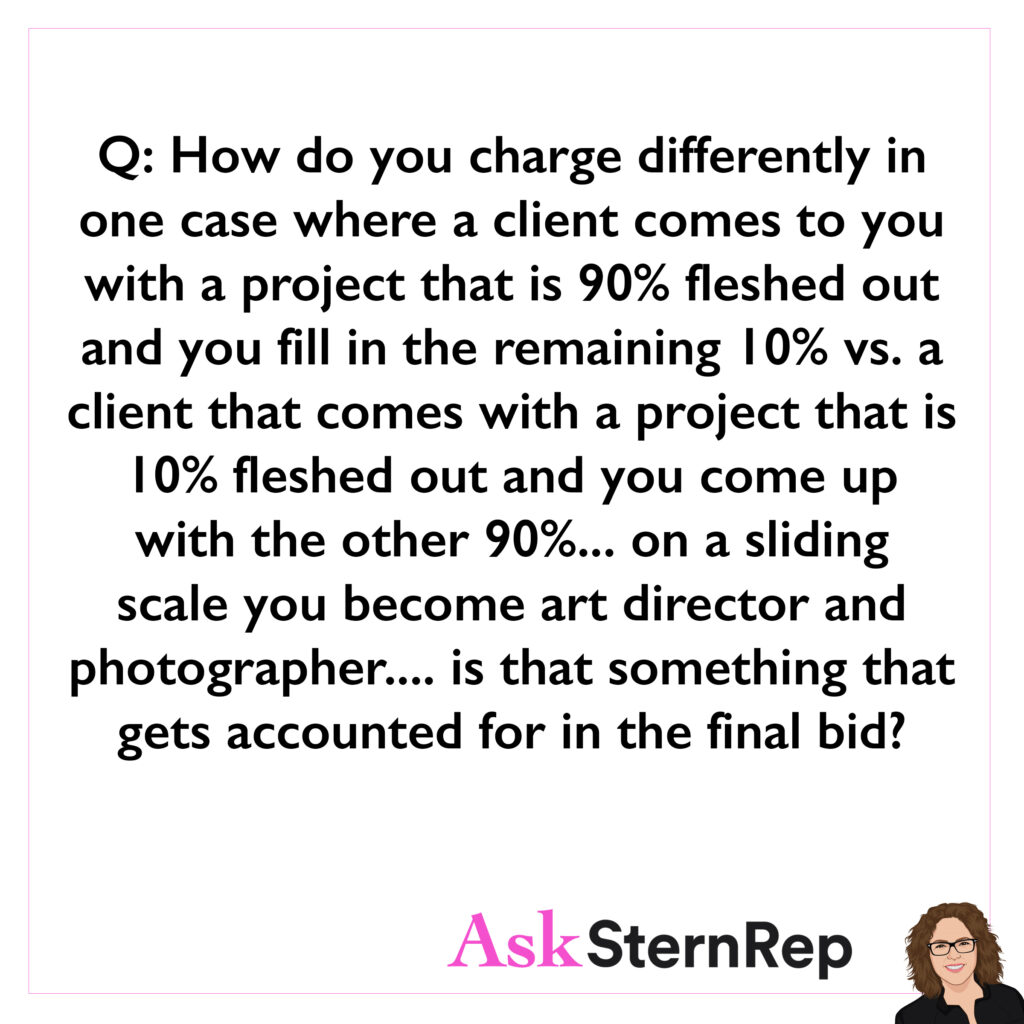

Q:
How do you charge differently in one case where a client comes to your with a project that is 90% fleshed out and you fill in the remaining 10% vs. a client that comes with a project that is 10% fleshed out and you come up with the other 90%… on a sliding scale you become art director and photographer… is that something that gets accounted for in the final bid?
A:
In my experience, the clients who don’t hire an art director or designer are trying to save money. They have lower budgets, so they want the photographer to come up with the branded shot list. I suggest staying clear of these situations because you are doing someone else’s job without getting paid for it. I’ve never seen these types of clients agree to pay more for art directing, but they really should. The first question I always ask is, “what is your shot list?”
Library vs. Campaign


Q:
I’ve heard the term “library” used a lot the last couple of years. Can you shed some light on the terminology of “library” vs “campaign”? To me, when I hear “campaign,” I think of a small-ish amount of focused images to sell something specific like a product or lifestyle. When I hear “library” I think of a larger amount of more generic images able to be multipurpose for various uses.
A:
Library means the client will buy the “package deal” not to be limited on an image count. A library shoot is a much larger usage, so your fee should reflect that increase. As a rep, I prefer a specific image amount for the licensing rights to be more controlled and get the photographer paid for each image. Usually, the price per image is lower when they buy an entire “library.” Our strategy is to structure usage fees based on the concept that the client will purchase more images in the future and continually need to renew the duration.
Elevator Pitches
Have a genuine self sales chat (elevator pitch) ready to go for an awkward portfolio showing or a zoom meeting when you need something to share about yourself.
Be prepared with a few tidbits that won’t sound like “sales,” but more like you sharing a story of an experience you had that shows how you like to work.
We know that you probably aren’t a salesperson if you’re listening to this and you’re more of a creative person, but you are a creative business. You need to have a sales pitch, or an elevator pitch. It needs to express who you are or how you dealt with something on a shoot that makes you more valuable to them. You need to know your client and who they work with and what kind of scenarios might come up for them. Have a few stories or scenarios to discuss because it shows that if something happens during a shoot, you would be able to handle it because of a past experience. Have these talking points ready to go so that when you’re in the moment you just have these keywords to remember if there’s an awkward moment of silence or you only have one minute to make an impression. How are you going to say what you need to say? What would you say to this person? What do you want from this person? Do you want to take them to lunch? Do you want to have a meeting? Do you want to talk to them about an idea you have? Have it ready to go.
The Treatment is the Second Date
Guest Post: Executive Producer, Robin Daily
“When we reach out to an artist to bid on a project, it’s the start of a relationship of sorts. We’ve been admiring their work and would like to initiate a conversation.
The Creative Call is the “first date”.
The Treatment is the second one.
The treatment tells us whether the artist heard us, but equally as important, how it resonates with them, now that they’ve heard our thoughts and vision for the project. It’s feedback to that “first date”. It should never be just a regurgitation of what we said. It should be how they would take our starting point and build on it.”
Treatments are important. It can get you the job. We just lost a job because we didn’t do a treatment. I asked the client why? The winning photographer was chosen because their treatment was so fabulous and it reconfirmed what they heard on the creative call. They need to know you’re as professional as you sound. Because you might sound professional on the phone but they need to know you are the person they heard on that call.
Elevator Pitch
Have a genuine work-related story (elevator pitch) ready to go for an awkward portfolio showing or a zoom meeting when you need something to share about yourself.
Be prepared with a few tidbits that won’t sound like “sales.” but more like you share a story of an experience you had that shows how you like to work.
I know you might not consider yourself a salesperson if you’re listening to this and you’re more of a creative person, but in the business of creativity, having sales pitches or elevator pitches is essential. You need to have a few ready that can clearly express who you are and how your experiences on a shoot make you valuable. Know your client—who they work with and what scenarios might come up for them. For example, if you recently traveled somewhere and it’s relevant to their needs, mention it. Have a few examples ready to show how you’ve handled situations during shoots based on past experiences. These small, personable details can be very impactful.
Be prepared with key points for any situation, especially if there’s an awkward silence or limited time. Think about what you would say to this person and what you want from them. Whether it’s arranging a lunch, scheduling a meeting, or discussing an idea you have, have your approach ready to go.
Marketing Kits + Making the Most Out of Social Media (Marketing Part 2) // Navigating the Unknown Episode 14
Navigating the Unknown Episode 14 – Marketing Part 2 is now live on YouTube! This week we speak to photography consultants Amy V. Cooper and Julie Skarwecki about all the steps in a comprehensive marketing plan. How do we make the most out of SOCIAL MEDIA, our contacts DATABASE, and our NETWORKING options?
Guests:
Amy V Cooper – Photography Consultant https://www.amyvcooper.com/
Julie Skarwecki – Photography Consultant https://www.julieskarwecki.com/
Navigating the Unknown is a Q&A series in collaboration with APA-LA where we speak to different members of the photo community about all aspects of the commercial photography business. https://la.apanational.org/
With Co-Host: Photographer Hugh Kretschmer https://www.hughkretschmer.net/
Emailing Clients
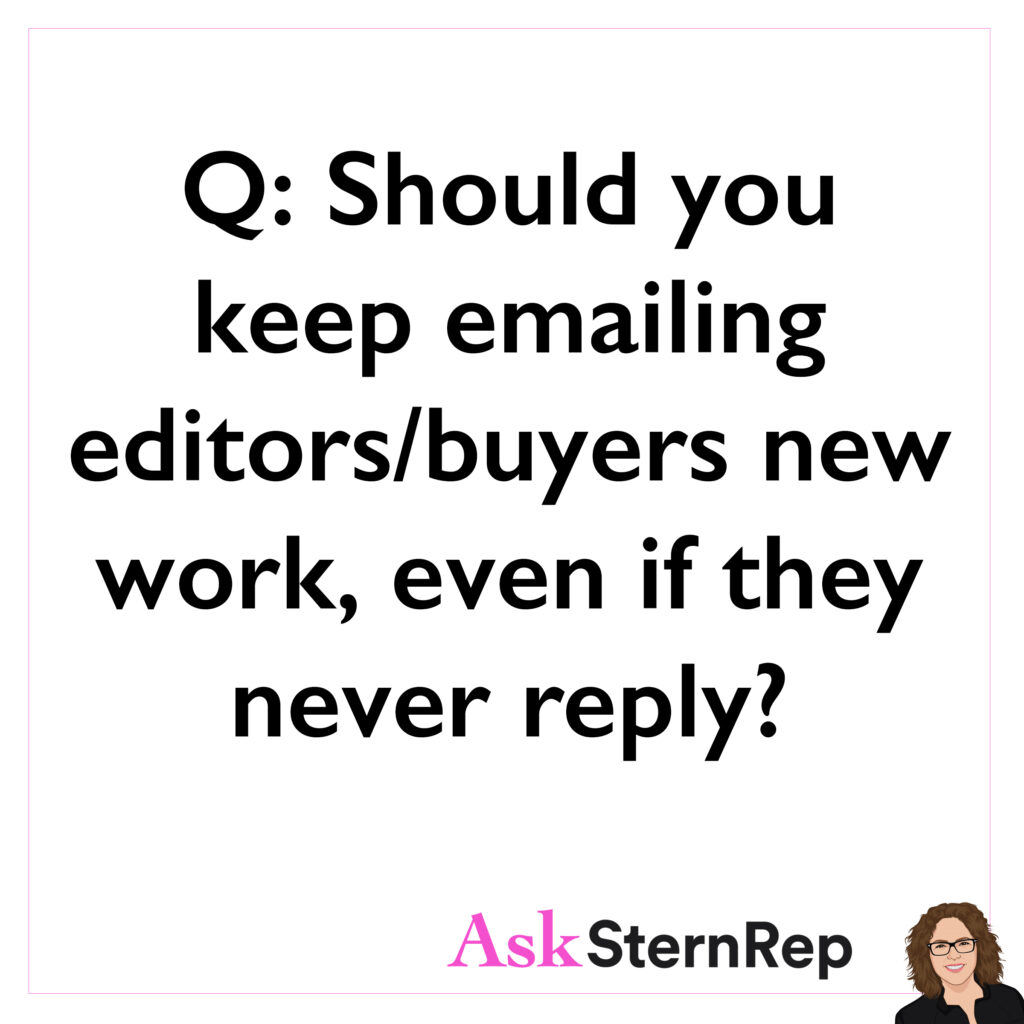
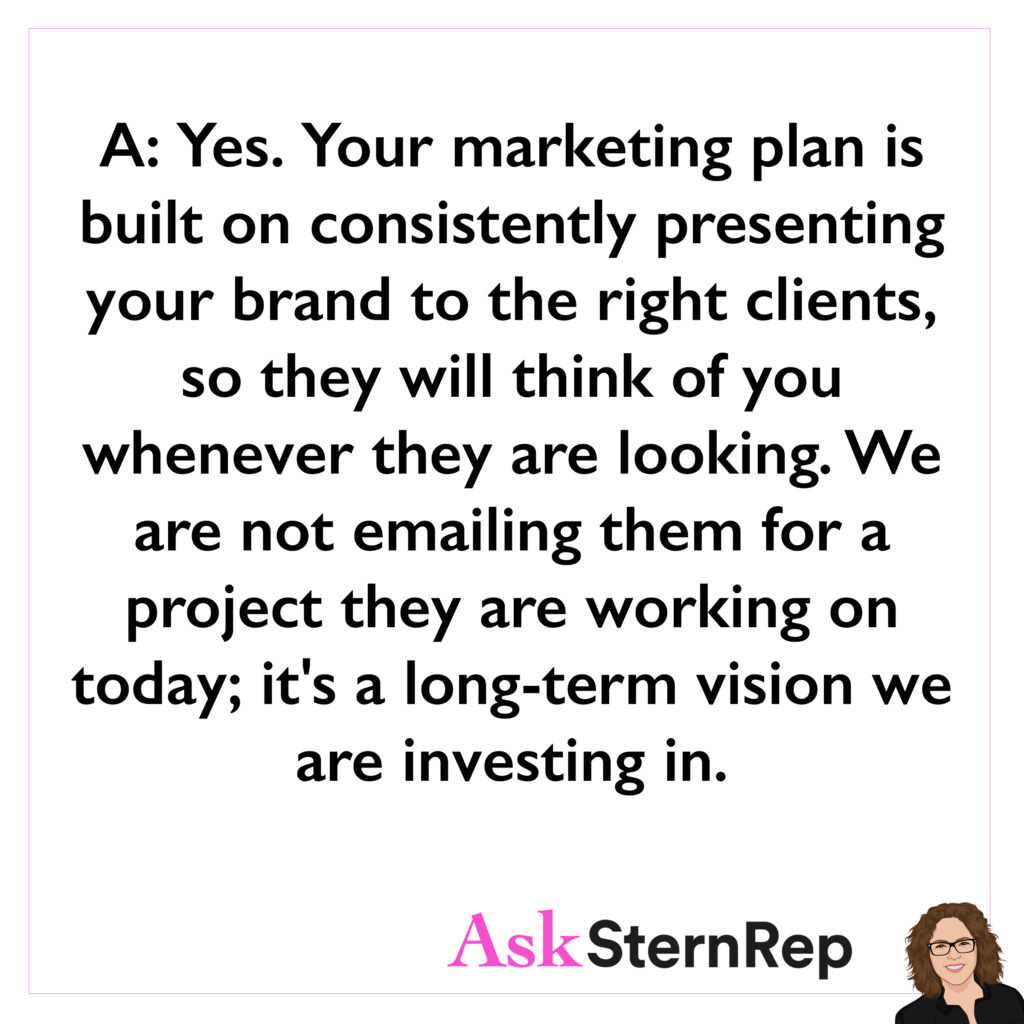
Q:
Should you keep emailing editors/buyers new work, even if they never reply?
A:
Yes. Your marketing plan is built on consistently presenting your brand to the right clients, so they will think of you whenever they are looking. We are not emailing them for a project they are working on today; it’s a long-term vision we are investing in.
The Best Type of Marketing
The best type of marketing is “Word of Mouth.”
We want clients to refer us, but this isn’t easy to control.
What we can control is giving them something to say.
Put forward the ‘searched for’ specifics about yourself clearly and concisely.
Your particular skill set matched with what your clients are looking for is the golden ticket of marketing!
My webinar next week will focus on marketing. One of the most powerful marketing tools is word of mouth. How do we create word of mouth? It’s one type of marketing that we don’t directly control, but it can be the most impactful.
Clients talk to each other to find out who’s the best because they want to be associated with the best. They’re interested in your location, skill set, and any unique aspects of your work. These are the buzzwords you need to get out there. Find ways to get in front of them, whether through networking events, portfolio reviews, or showcasing your unique equipment and skills.
Think about the questions clients might ask each other, such as, “Does anyone know a photographer in this area?” or “Who can shoot with this specific piece of equipment?” Get yourself out there in ways that highlight your unique attributes and skills.
Clubhouse

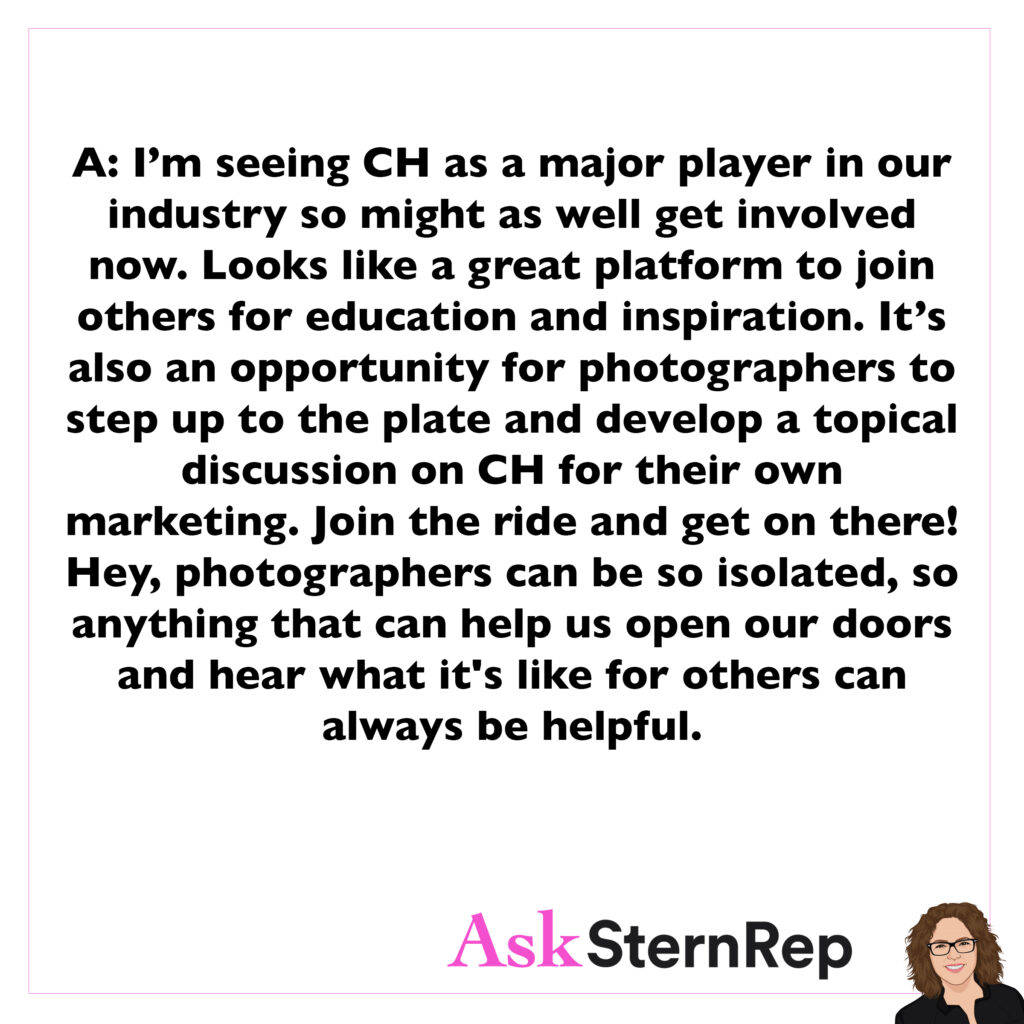
Q:
Do you think that Clubhouse has value? I’ve just recently joined and it seems to.
A:
I’m seeing CH as a major player in our industry so might as well get involved now. Looks like a great platform to join others for education and inspiration. It’s also an opportunity for photographers to step up to the plate and develop a topical discussion on CH for their own marketing. Join the ride and get on there! Hey, photographers can be so isolated, so anything that can help us open our doors and hear what it’s like for others can always be helpful.
Don’t Hold Back
My sixth-grade art teacher Ms Johnson said, “if someone copies your idea, that means you had a really good idea.”
The same goes for treatments.
Don’t hold back because the only way your idea won’t be used by others is if you never get the job.
There is a lot of apprehension from putting your secret ideas into your treatments because you may think the client may steal it and use it with someone else. That’s really not how it works. A client is going to hire a photographer based on their treatment and of other things. You might inspire them. But even if you share your idea and then they use that idea on another shoot with another photographer, what are we going to do? We can’t stop them. You have to give all of yourself to the treatment: every idea you have, the locations, the whole production, the schedule, and how you would make it all happen. If you don’t share all of your ideas you’re not really showing who you are and you probably won’t get the job.
One-Sheet

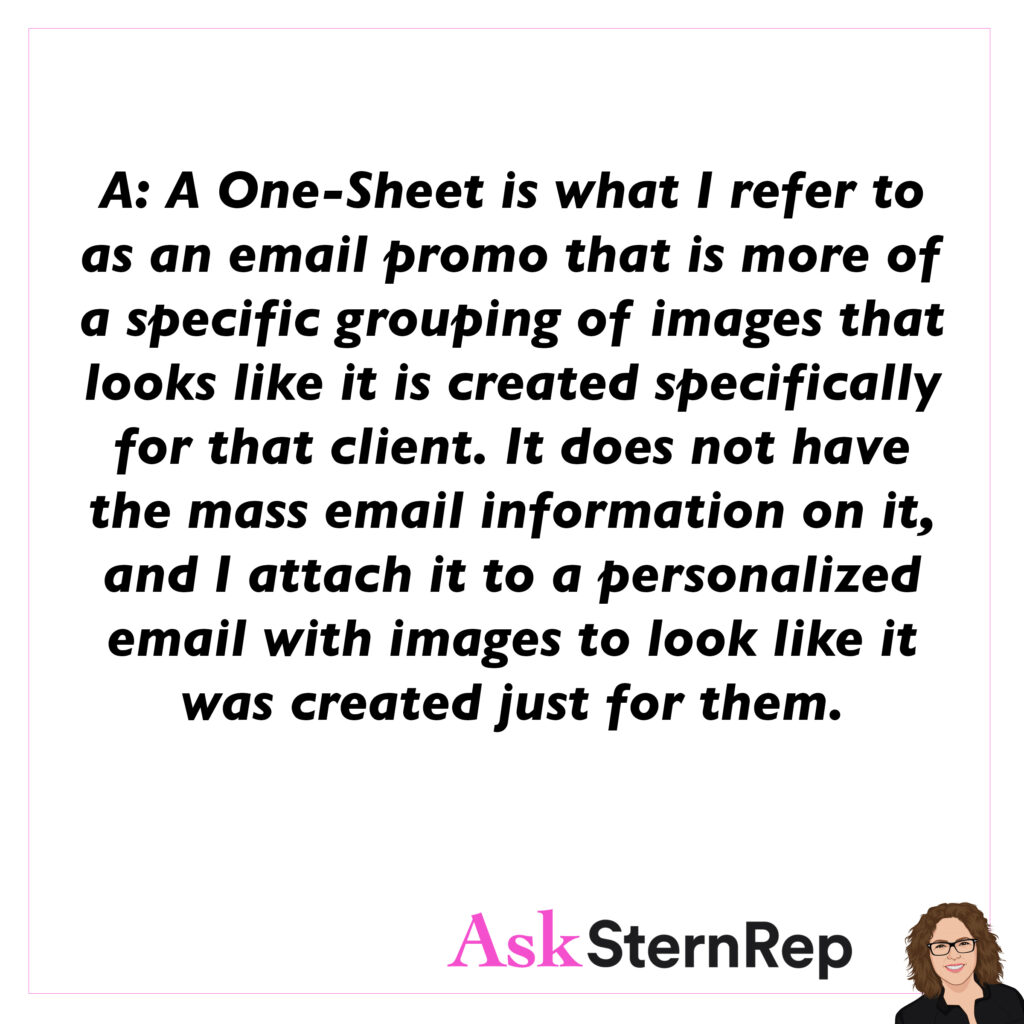
Q:
What is a One-Sheet attached to an email?
A:
A One-Sheet is what I refer to as an email promo that is more of a specific grouping of images that looks like it is created specifically for that client. It does not have the mass email information on it, and I attach it to a personalized email with images to look like it was created just for them.
Be Careful
When a client handles production expenses and asks for your day-rate estimate, be careful as they often assume that will include other costs such as your crew, camera gear, and retouching. Spelling that out on your estimate is not enough. Before the job happens, ask how they are handling the specific production costs that pertain to you.
Something often happens with estimates, especially when it’s from client direct. They are handling the production expenses. They ask us for a bid or an estimate just for our fees but it’s often not just our fees. They think other things are inclusive with fees. When fees are really your usage and your time, your creative fee, your day rate. Even after you think they understand because you’ve made it very clear, do it again. Make sure before the job happens that they are crystal clear if more retouching is needed or if overtime happens it’s going to be this much. Ask them how they are handling the crew, how they want to handle your equipment. Stuff like that. Assume they don’t know because you have to protect yourself even if you think you already did in the estimate.
Website + About Section
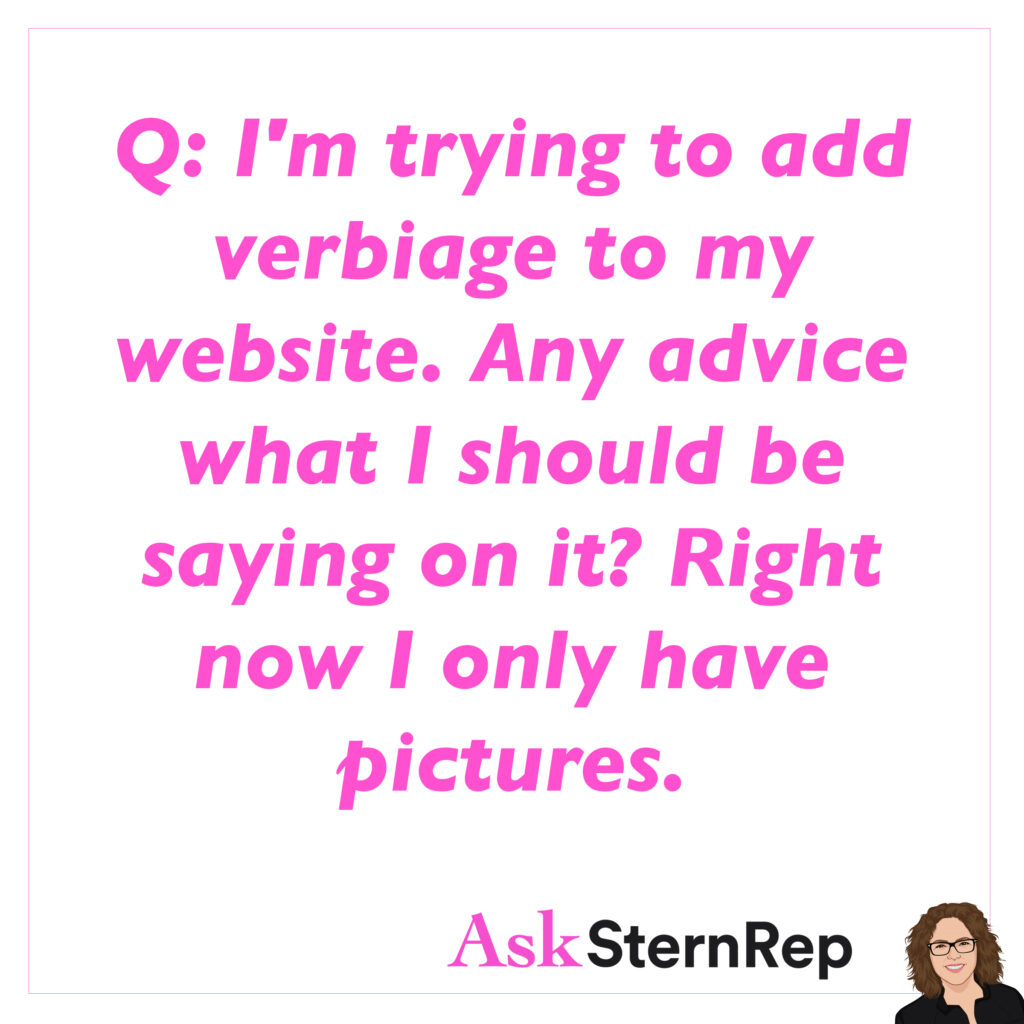

Q:
I’m trying to add verbiage to my website. Any advice on what I should be saying on it? Right now I only have pictures.
A:
The “About” section on your site is vital as clients want to know who they’d be hiring. Have an informative balance of personal and professional to give them a sense of what you bring to a photo shoot. They don’t really care what you like to eat, drink or what your favorite movies are. They want to know the facts that make you relevant to them. Sound as if you are talking in quick snippets to keep it short and fast. Express your passion for what you shoot, like how you are a foodie if you shoot food. Have a professional writer put it together and provide your client list.
Key Points for Marketing Materials
What are clients looking for to include us on their LIST? Our marketing materials are our golden 2-second opportunity to make that happen. They KEY POINTS to make this easy for them are:
- Design
- Your name
- Category
- Keywords
- Location
- Unique specialized skill set
Marketing. It’s that huge topic. How do we get on our clients list when they’re looking for a potential photographer? We want to get on there. We have to incorporate what they are going to be searching for.
The first one is design. Your design has to be really well put together. Use the design across the board; on your website, your instagram, your highlights, everything should have your look to it. That shows dependability and professionalism.
Your logo has to be your name, we don’t have time anymore for you to have two separate things for people to remember. Have your logo be your name.
The category you shoot, whether it’s portrait, automotive or lifestyle. Make sure that you write it in your email promo so when they do that search for that category, you’re a part of the list.
Then there are the keywords to specifically describe you in your categories, whether it’s an editorial feel or color pop or warm family, genuine, authentic, anything that really describes you and your work, make sure you try to write it in there.
Location, that is a really important one, especially right now. People are going to want to hire locals.
Then your extras, things you could remember to share, your drone work, or your motion work, or the equipment you use. How many shots you can get per day. All the specific things that are unique to you. And yes it’s always about your style, but this checklist is how the clients can find and remember you.
Overages + Estimates

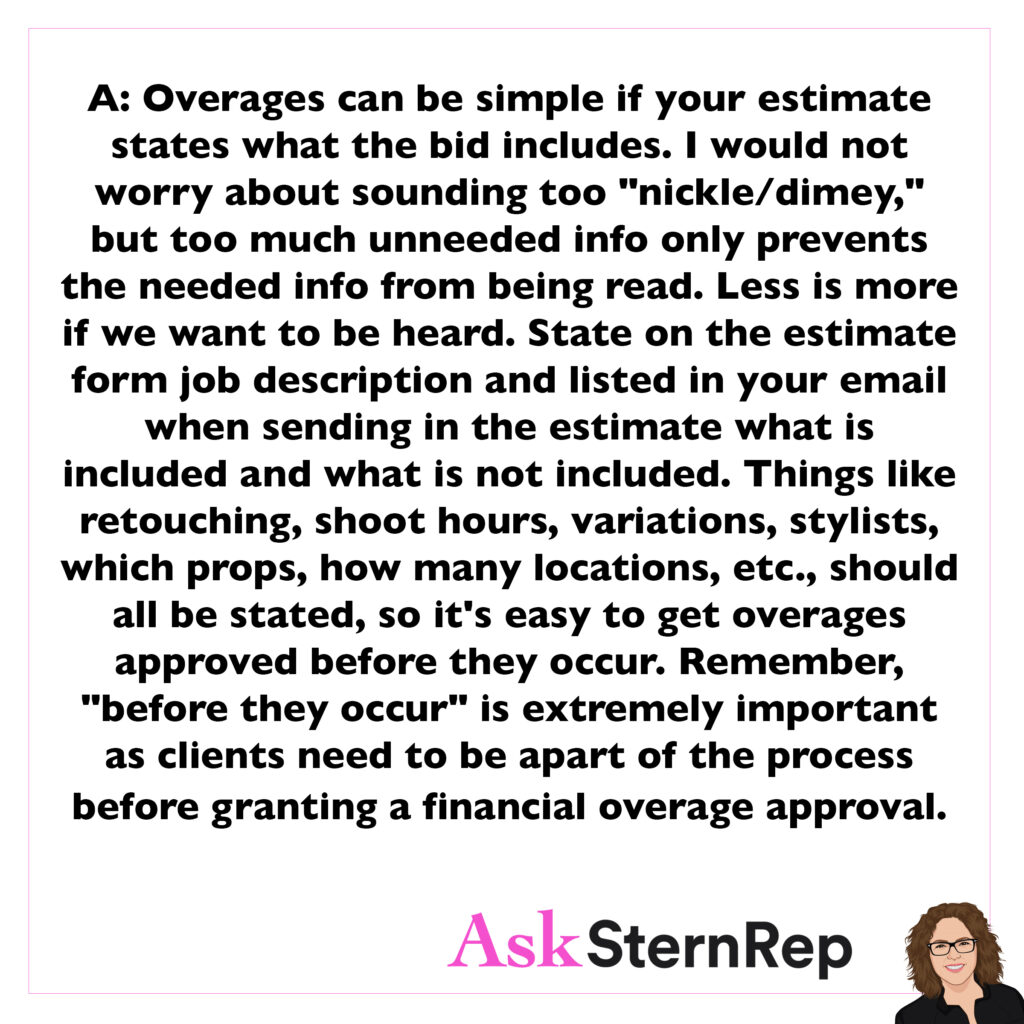
Q:
I’d love to know your good ideas on how overages are handled and if and when they occur? Layout in bid ahead of time so everyone is clear? How spelled out should/can this be without seeming too nickel/dimey?
A:
Overages can be simple if your estimate states what the bid includes. I would not worry about sounding too “nickel/dimey,” but too much unneeded info only prevents the needed info from being read. Less is more if we want to be heard. State on the estimate form job description and listed in your email when sending in the estimate what is included and what is not included. Things like retouching, shoot hours, variations, stylists, which props, how many locations, etc., should all be stated, so it’s easy to get overages approved before they occur. Remember, “before they occur” is extremely important as clients need to be a part of the process before granting a financial overage approval.
Shaping Your Future
Doing the RESEARCH on potential clients is the difference between allowing your career to be guided by the calls you receive vs. shaping your future by going out there to get the clients you want.
We are moving on with the new year and one of the biggest, most important things to do is research. It is difficult. It’s a way to educate ourselves on the clients we want to get to bring our careers to the next level. We must keep a good database and keep researching on LinkedIn. We have to know who to contact, who to engage with and who to stay in front of. It’s really simple, but difficult. Research and contact people on LinkedIn. It can’t be like a mass email kind of feeling from you. You have to use their name and add a note. It takes time, but it’s probably the most important thing to do if you want to advance your career.
Breaking Out The Steps of Marketing // Navigating the Unknown Episode 13
Navigating the Unknown Episode 13 is now live on YouTube! This week we speak to photography consultants Amy V. Cooper and Julie Skarwecki about all the steps in a comprehensive marketing plan.
Guests:
Amy V Cooper – Photography Consultant https://www.amyvcooper.com/
Julie Skarwecki – Photography Consultant https://www.julieskarwecki.com/
Navigating the Unknown is a Q&A series in collaboration with APA-LA where we speak to different members of the photo community about all aspects of the commercial photography business. https://la.apanational.org/
With Co-Host: Photographer Hugh Kretschmer https://www.hughkretschmer.net/
Marketing Tips You May Not Be Doing
MARKETING TIPS YOU MAY NOT BE DOING yet…
- DM on IG Stories is the best way to start a true 2-way conversation.
- Quick and easy ONE-SHEETS are like having a Leave Behind email promo for each client.
- PROJECTS PAGE reassuring clients showing a series of images with the same look + feel.
- Maintain your DATABASE with your dream list and those who already know our name. Cheers!
- CLICKED LIST of your promos is that valuable feedback that is so hard to get.
Social Media + Production
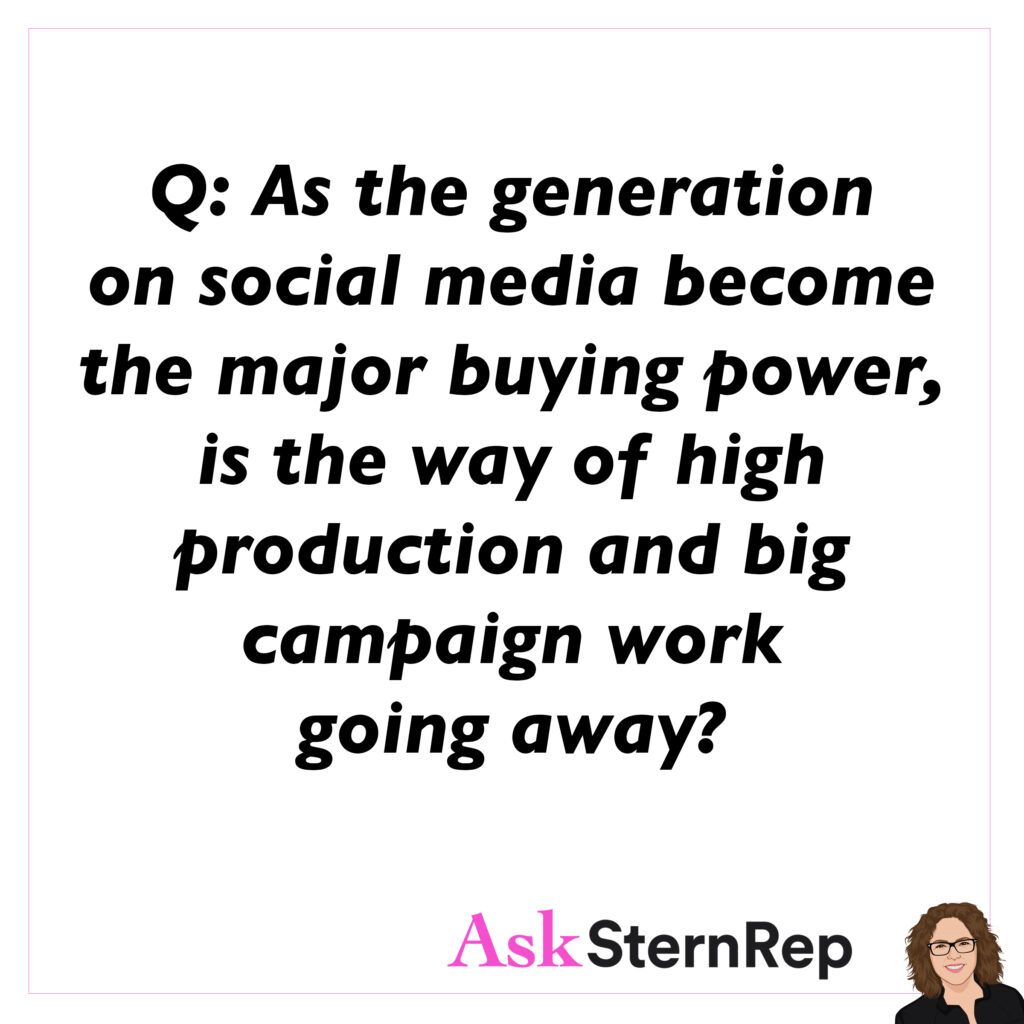

Q:
As the generation on social media becomes the major buying power, is the way of high production and big campaign work going away?
A:
High production and big campaign work have gone down, but mostly it’s changed into more content per photoshoot. High-quality production still happens, but the number of shots has increased because they need more social media assets. The more assets you can deliver through production ideas, equipment versatility, and motion, the better. They need more content, so find ways that you will be the one to give them even more than they are asking for.
Copyright Q&A
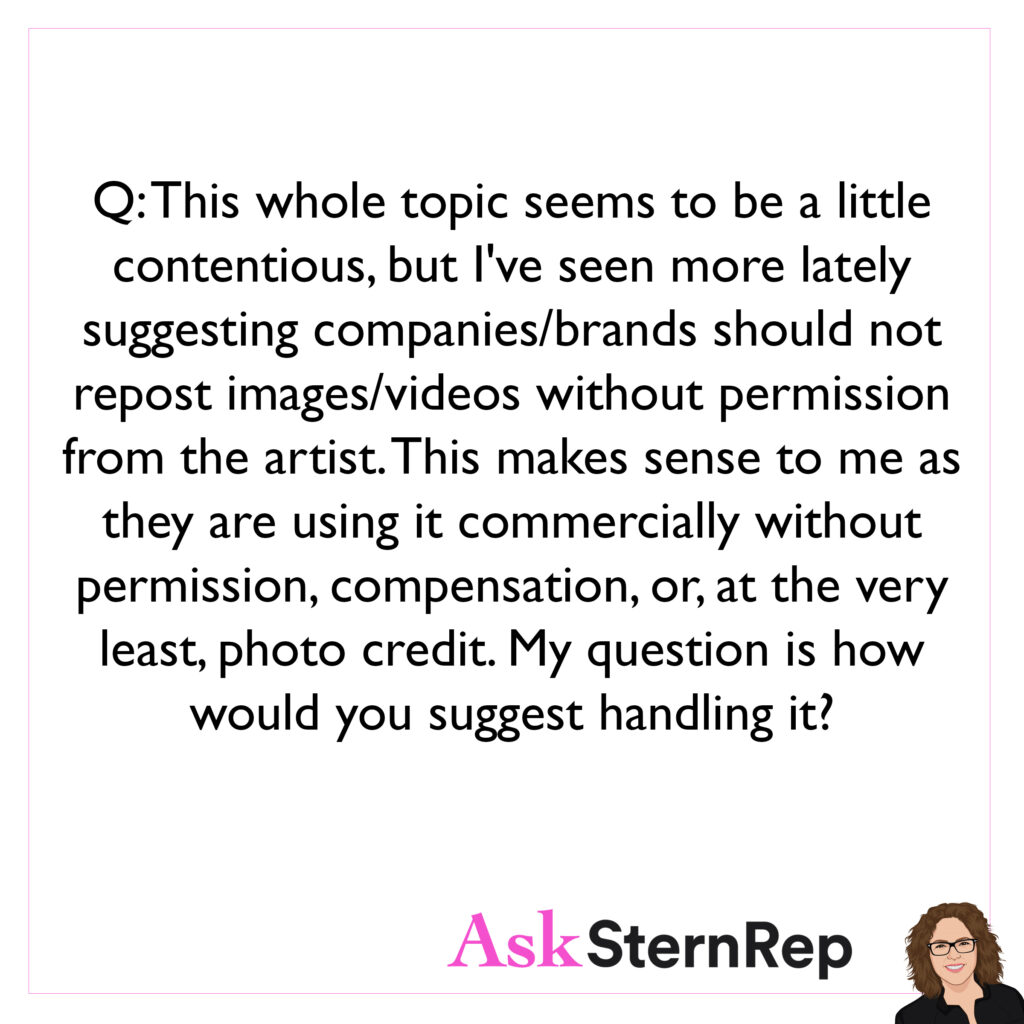

Q:
This whole topic seems to be a little contentious, but I’ve seen more lately suggesting companies/brands should not repost images/videos without permission from the artist. This makes sense to me as they are using it commercially without permission, compensation, or, at the very least, photo credit. My question is how would you suggest handling it?
A:
You are the photographer, so you own the copyright. This is your responsibility to contact whoever used your image without your permission to request to be paid. Unfortunately, IG’s terms don’t support photographers, so I believe if this went to court, you’d lose. It’s important to contact them, let them know you are the photographer and find out where they are using your image. At the very least, you should have your name be tagged to get some PR out of it. I find that clients often don’t know any better and don’t realize they need your permission, so they are open to negotiation.
Inside View: LA Art Director on What They Look For in Photographers + How They Find Them
ASR: What is something that will make you choose one photographer over another?
AD: There’s a lot of different factors that go into selecting photographers. For me one main one is the client and the project itself. Are they safe, more adventurous, reserved, edgy? Once I figure that out, I determine the vibe of the project. For me mood is a key factor to selecting a photographer. Without knowing the photographer at a personal level, if I can sense the mood I’m going for within their portfolio I feel more confident working with them. There’s a sense of trust without really having to communicate. More and more, I feel that when a photographer is doing something different from the norm. I’m more than likely to push for them. If I get inspired by a photo that pushes my own conventional thinking, they’ve won me over. And that’s the thing with photographers, right? It’s that trust in giving them freedom without really micromanaging them to get the shot you’ve envisioned. I’ve been fortunate enough to have gotten to work with so many talented photographers.
ASR: How do you find photographers?
AD: Rosters, Instagram, friends in the industry, I keep leave behinds when a photographer visits the agency. Instagram presence really helps too.
ASR: Why does an Instagram presence really help?
AD: Instagram presence is important to me cause it gives me a sense of their personality. A portfolio is curated but an active photographer on Instagram draws me in on a personal level. Especially when I see work I might have not seen. When I see a photographer’s Instagram that’s not mimicking their portfolio it’s the truest form of connecting with them. Seeing the way they see the world.
Bring It 2021!
Let’s get started here.
BRING IT 2021!
What is your top list of clients you’d love to work with?
And we’re back! Sounds like a sporting event, but we’re getting our heads back in the game. Here we go—it’s a new year, and we’re shaking off the cobwebs from last year. This might not be very rational, but let’s make a list of clients we want to work with. Let your ideas flow without editing them as you go. This exercise is about imagining and seeing what comes out. You might learn something about yourself and the direction you want to take.
Give yourself time to identify these clients. Browse through websites of other photographers, explore, and use pen and paper—go old-fashioned. Really take the time to do this. The first step is to get clear and set our sights. New year, bring it on!
Get Personal

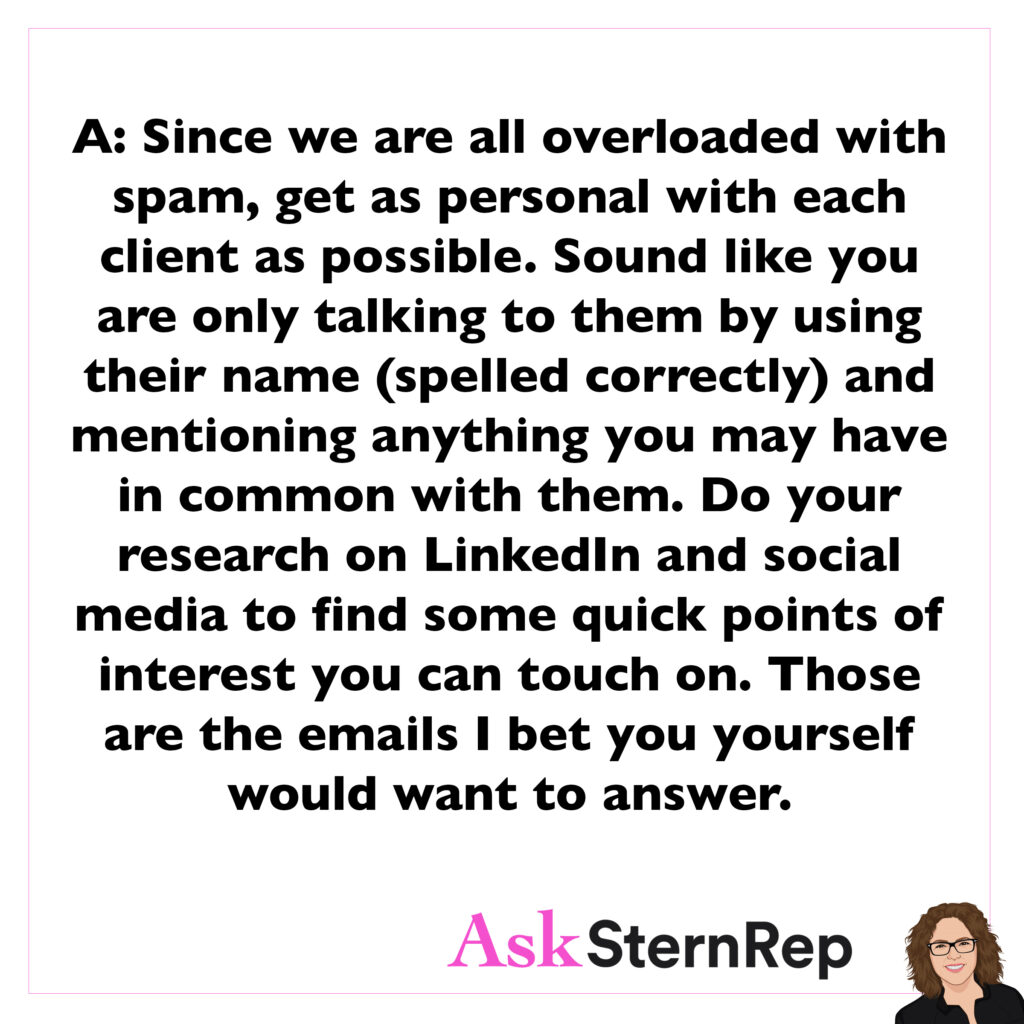
Q:
When approaching a potential client directly for the first time, do you find it’s best to send one email to multiple contacts you may have there or send individual emails separately to each person?
A:
Since we are all overloaded with spam, get as personal with each client as possible. Sounds like you are only talking to them by using their name (spelled correctly) and mentioning anything you may have in common with them. Do your research on LinkedIn and social media to find some quick points of interest you can touch on. Those are the emails I bet you yourself would want to answer.
Getting Back on Our Own Track
If this new year can be anything, it can be our way of getting back on our own track.
Before we get started back up again in our busy lives, we have to reset our direction in the way that we want it to go. We often get so caught up in the search and the hunt for jobs and we get busier and busier and we’re not thinking where we want to take this. It becomes where are the jobs taking us. We can’t let that business take our focus away.
Website + Branding
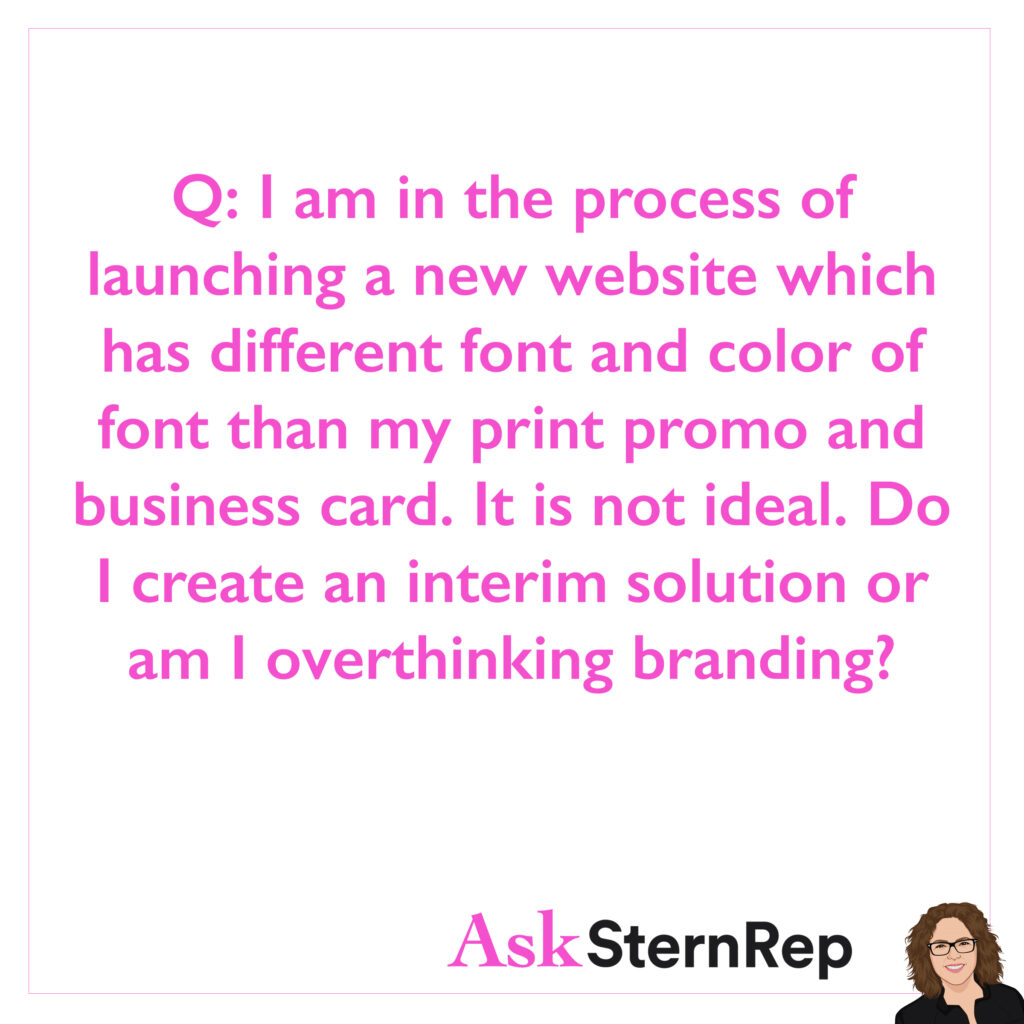

Q:
I am in the process of launching a new website which has a different front and color of font than my print promo and business card. It is not ideal. Do I create an interim solution or am I overthinking branding?
A:
You are not overthinking branding because your look and vibe should remain consistent. Then again, if you are the start of your career and have not cemented your look + feel then you are more free to explore. We all have to keep revising our look but hopefully there is a consistency to it that continues to grow. The worst part is that your printed promos and business cards should not be used anymore and right now, during this Covid time, that is just fine.
Be Open to Growth
Successful businesses are open to growth. So much of our business doesn’t change when we can’t see outside of our own routine.
Happy holidays!
Happy holidays! In this really strange time, we don’t know what to expect or where we’ve been. It’s something we can’t control, so the best we can do is enjoy the holiday. Take a step back, break out of our usual patterns, and use this time to see things from a new perspective. Since so much of our business remains routine, a break from it can lead to new insights. Here’s to fresh thoughts and new possibilities. Happy holidays!
Clients + Social Media


Q:
I am always a bit unsure about protocol when it comes to following clients on social media. A client I worked for just posts personal images but his profile is public. Is it invading his privacy to engage or would it be a good move to drop my name by liking pictures?
A:
In today’s world I think clients expect us to follow their IG. It actually amazes me how easy it is to communicate with clients who were hard to reach before. I see FB as the more personal one. Follow them on IG and engage, engage, engage!
Make the Treatment Yours
Treatments are the opportunity to share a sampling of the Director you will be set in a very well designed, well written PDF.
Reiterate what you heard on the Creative Call through a mood board of images and topics explaining your lighting, color and tone, location samples, talent, wardrobe styles, post work, etc.
Make it yours, who you are as a director and how you envision this project with all the specific areas that create the look + feel you will be creating.
Treatments are such a big topic. They are what will help you get the job or lose the job. The client wants to know that you understand from the mood board and their creative call what is their concern. What are some potential problems that you can solve. Listen to what the potential issues are on their side and what the challenges are and what you can bring to the table. Let them know you’re going to deliver a smooth shoot and get them what they need.
Treatments + Bids
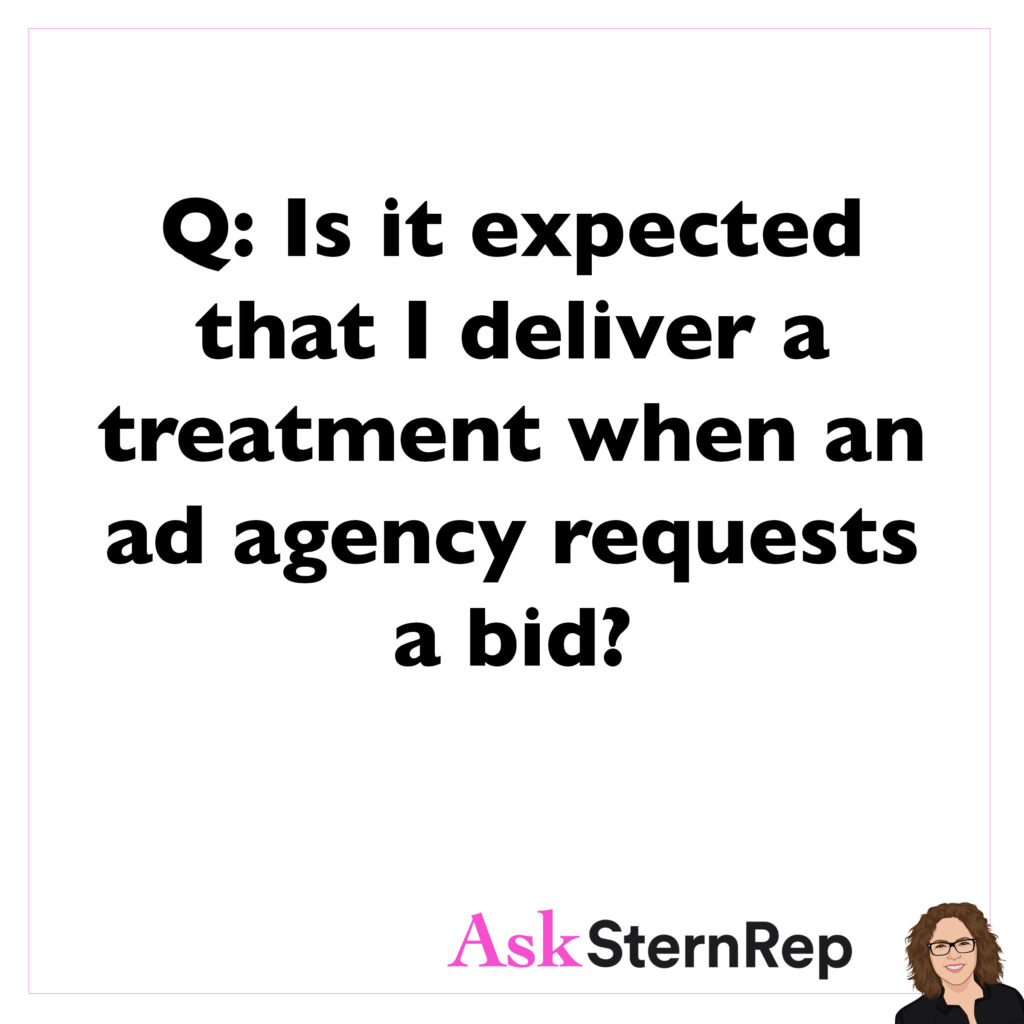

Q:
Is it expected that I deliver a treatment when an ad agency requests a bid?
A:
Yes, treatments are the norm now and I definitely recommend sending them in on every bid. Why not? Other than them taking a lot of time, they really sell the photographer and can help you get that job or future jobs with that client. Take it as one opportunity you should not pass up even when they don’t ask for a treatment.
One tip: Work with a designer to get your treatment template looking like your A+ style!
Website & Marketing Strategies for Success // Navigating the Unknown Episode 12
Navigating the Unknown Episode 12 is now live on YouTube! This week we speak to photography consultants Amy V. Cooper and Julie Skarwecki about designing a website and discussing marketing strategies for your brand.
Guests:
Amy V. Cooper – Photography Consultant https://www.amyvcooper.com/
Julie Skarwecki – Photography Consultant https://www.julieskarwecki.com/
Navigating the Unknown is a Q&A series in collaboration with APA-LA where we speak to different members of the photo community about all aspects of the commercial photography business. https://la.apanational.org/
With Co-Host: Photographer Hugh Kretschmer https://www.hughkretschmer.net/
Website Top Tips
Website Top Tips
- Have an “Overview” to create a quick and concise view of your style.
- Use a “Project” section on top to show the images collectively in the campaign.
- No sound. Please.
- Images should be draggable to help the creative show you off (easily) to their clients.
- A natural/real image of you in the “About” section to help warm up your intro.
- Your email should be clickable as a one-stop-shop without extra work for the sender.
Usage + Pricing
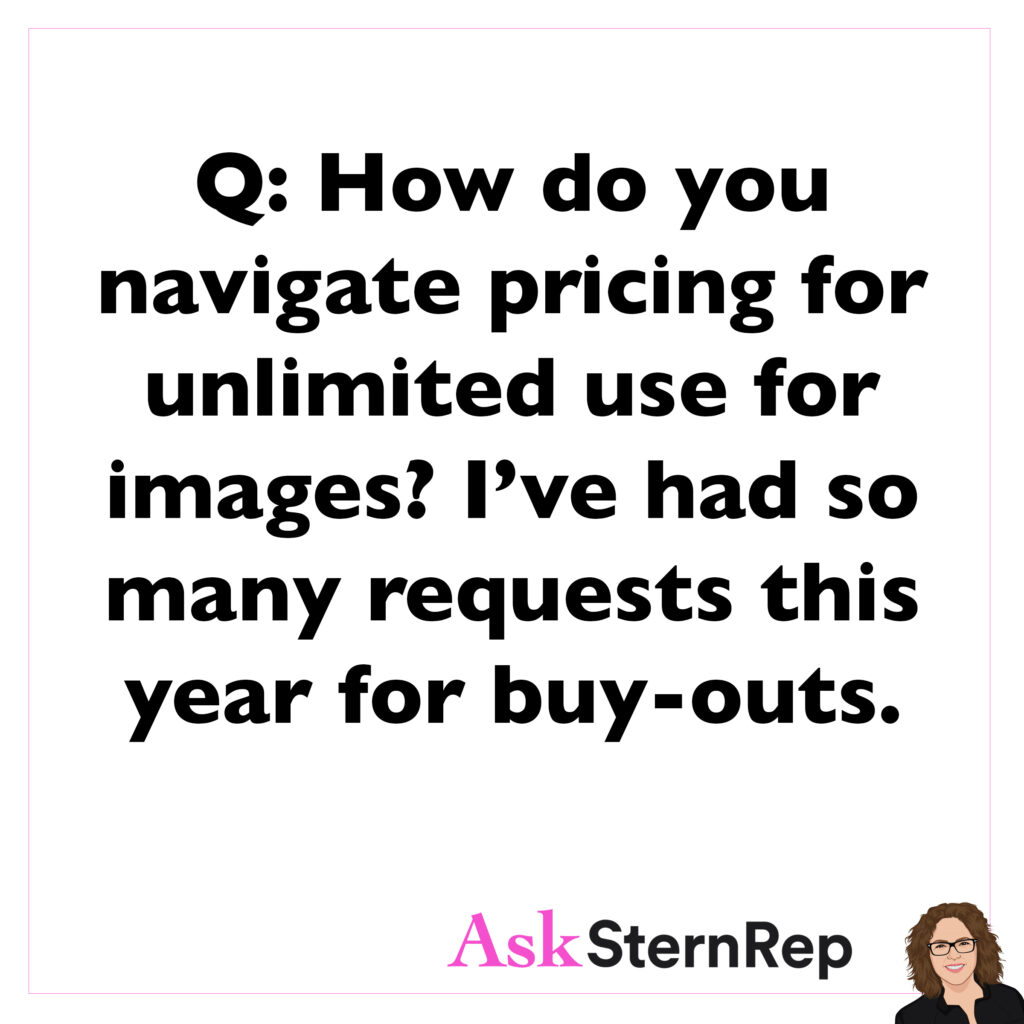

Q:
How do you navigate pricing for unlimited use for images? I’ve had so many requests this year for buy-outs.
A:
Unlimited is the popular usage term similar to clients requesting to own the image’s copyright. They often don’t really need unlimited freedom such as broadcast, OOH billboards, etc. First, find out what they really need it for. You can show them two options – exactly what they need it for and what unlimited would cost. I like how on the Estimates episode of Navigating the Unknown we learned that the standard range for unlimited use is normally between $8k – $15k per day. That gives a sense of where you can begin.
Overtime is Tricky
Overtime is tricky because even if you think the client will be expecting it, don’t take any chances. They hired you as the director, controlling the day, offering strategic steps to look out for their best interest. Bring it up before it’s too late.
We have to talk about overtime. If you’re on a job and you see yourself heading towards overtime, talk with the client. Check in with yourself at lunch time, or early in the day. Ask yourself, “Where are we?” Are you falling beyond or you’re not getting all the shots done in the 10 hours. Overtime was probably already discussed with the client in an email and it’s on your contract or even talked about on the phone, but don’t count on that. Talk to them or have your producer talk for you or your rep. The client has to know in advance because they might not have the budget and it’s your responsibility. Even if they’re trying to add shots and you’ve said ok. Also, the amount of overtime has to be approved, such as how many hours of overtime and for how many people. You don’t want any surprises and you never want to hand it to your client and say, “Surprise!” You have to protect yourself.
Shot List On-Set


Q:
So often art directors push for more images on the shoot day even after the final number of shots has been agreed upon and approved. It’s tough to navigate on set. They usually say something like, “we’d love to get a few options on this shot,” or “what if we do this?” How do we be stern (no pun intended) with these on-set requests with discussing money during the middle of a shoot?
A:
I tell every photographer I rep or temp rep to blame me. For example- “I’d love to do this for you, but Andrea had me agree that you’ll have to talk to her first.” If you aren’t working with a rep then you can say, “As much as I’d love to, it’s my self-producing policy to not surprise you or me later with costs and timing issues so I’ll get back to you in a few minutes with any cost or scheduling changes to make those happen.”
Collaboration


Q:
I wonder if you have any insight on “collaboration.” I reach out to brands to collaborate and they perceive that I want to create content with them for free. Maybe my approach needs to be retooled or the word “collaboration” means “free.” Any help would be appreciated.
A:
“Collaboration” has become synonymous with “free” in the Instagram age, so utilizing an alternative to that word will probably be a good start. If you do reach out to agencies and clients, know that they are not used to having ideas given to them, so your collaboration could come more in a discussion. I’d suggest DM’ing the creative director or art director or designer to start sharing your passion for your idea. If you have good ideas, I’m sure they want to hear them. Make it a discussion vs a collaboration. Request a Zoom chat once you have a conversation on DM started.
Keep Your Company Fresh
You are in the business of keeping it fresh for your clients, so keep your own company fresh.
People are keeping it fresh, and what I mean is that they’re trying new things. Producers, consultants, reps, and photographers. All of us are doing something new and trying to market ourselves in a new way. We have people we want to hire us to keep them fresh, why wouldn’t we keep it fresh? Brainstorm with people you work with, even if you say no to their ideas, it gets your brain working on new ideas. Try new things, new equipment or a new posting on Instagram. Try something new that you don’t know. Try the unknown and make it something you work on. We talk about testing all the time. Test, test, test. Push yourself to keep yourself fresh. Put it out there, whether it’s something you’re interested in, or sharing who you are, or something you’d be bringing to a job or shooting more motion. There’s so many things you can do to show that you’re a fresh thinker.
Inside View: Technical Tip to Leveling Up Your Zoom Call Appearance from Photographer Vinnie Finn
ASR: Vinnie, I was enjoying your crystal clear quality of your camera on our Zoom creative call. You really were clearer than I have seen before. What equipment do you use to get this so sharp?
VF: I use Canon EOS R that is connected to my computer through a capture card, the capture card is an Elgato Cam Link. For audio I use a Zoom H% recorder that is also connected directly to my computer.
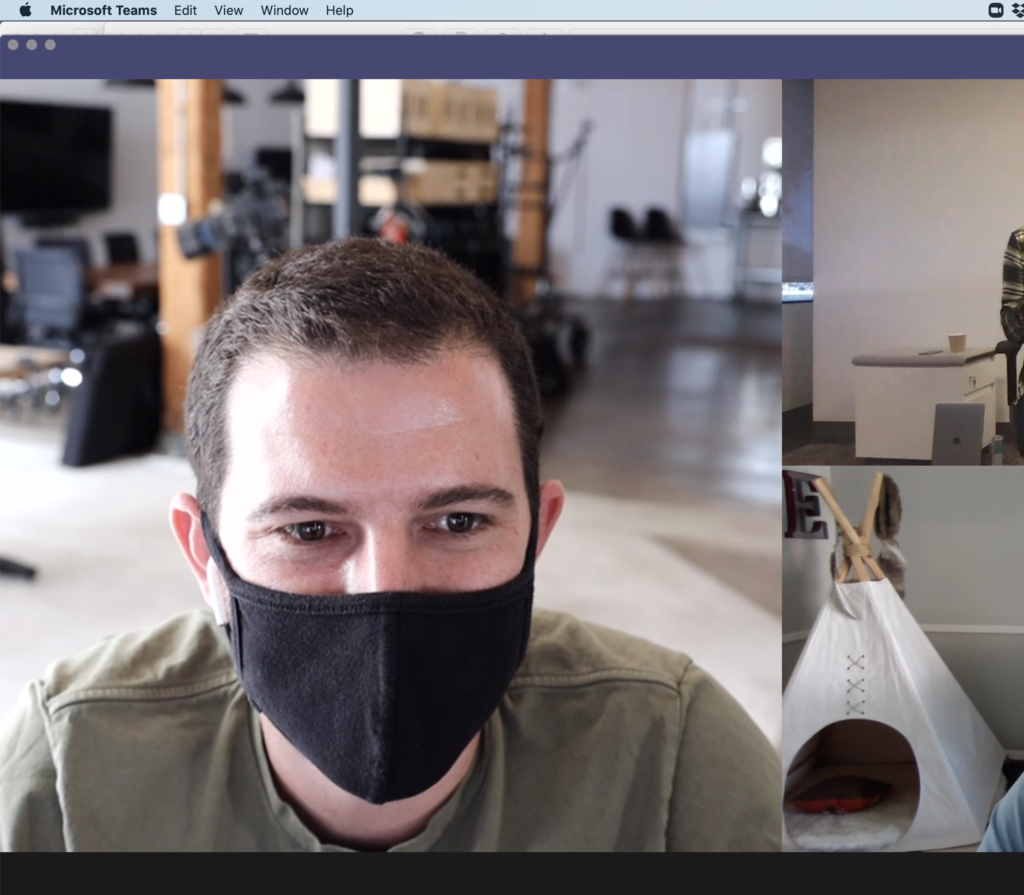
Estimating a Job

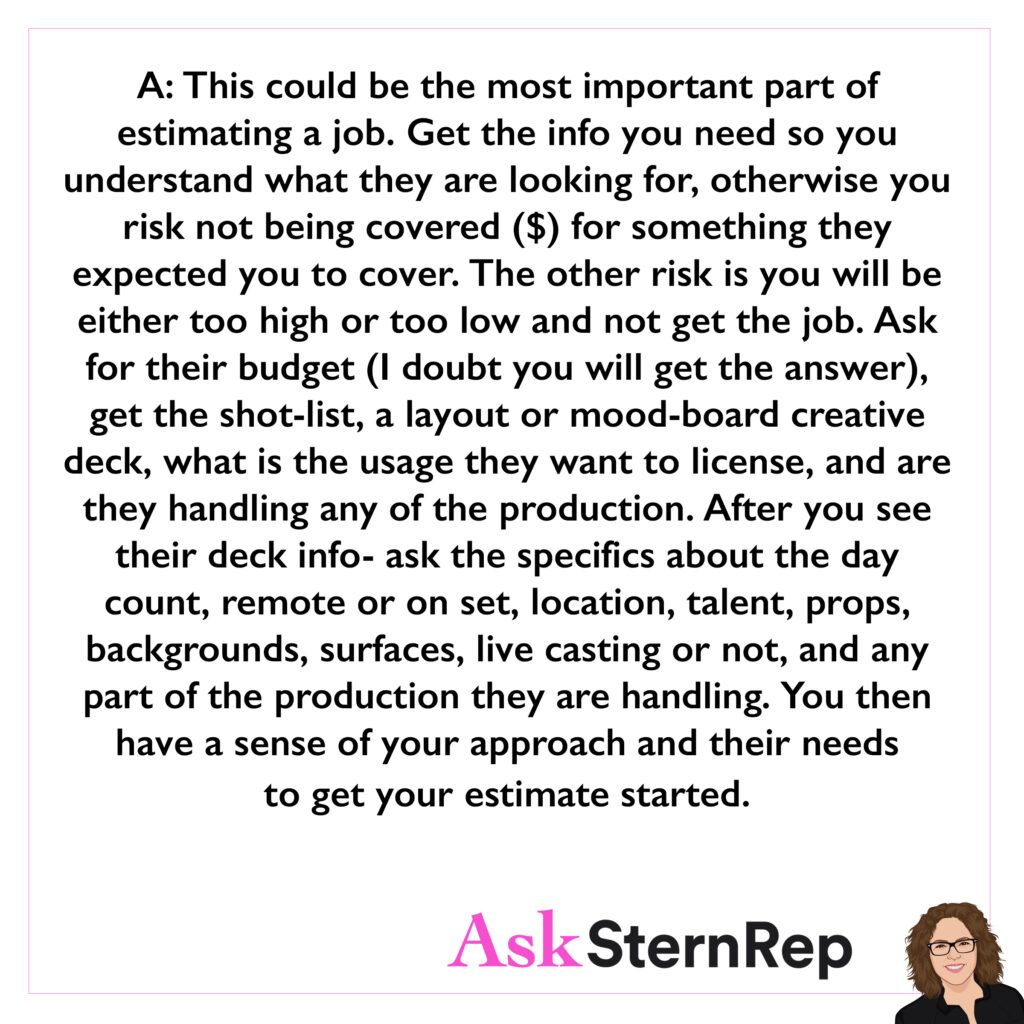
Q:
What questions should be asked when figuring out costs for projects?
A:
This could be the most important part of estimating a job. Get the info you need so you understand what they are looking for, otherwise you risk not being covered ($) for something they expected you to cover. The other risk is you will be either too high or too low and not get the job. Ask for their budget (I doubt you will get the answer), get the shot-list, a layout or mood-board creative deck, what is the usage they want to license, and are they handling any of the production. After you see their deck info- ask the specifics about the day count, remote or on set, location, talent, props, backgrounds, surfaces, live casting or not, and any part of the production they are handling. You then have a sense of your approach and their needs to get your estimate started.
Estimates – How to Bid For Today // Navigating the Unknown Episode 11
Navigating the Unknown Episode 11 is now live on YouTube! This week we speak to Art/Content Producer Kay Gautraud, and Producer Michael Klein about how to navigate estimates for a project in today’s climate.
Guests:
Kay Gautraud – Art/Content Producer https://www.kaygautraud.com/#/
Michael Klein – Producer, Circadian Pictures https://circadianpictures.com/
Navigating the Unknown is a Q&A series in collaboration with APA-LA where we speak to different members of the photo community about all aspects of the commercial photography business. https://la.apanational.org/
With Co-Host: Photographer Hugh Kretschmer https://www.hughkretschmer.net/
Eye Contact in Zoom Calls
Zoom calls are our way to connect with clients through our visual presence by direct and confident eye contact.
We’re noticing how important it is to really give eye contact as if you’re in person, because you are, in a sense. You’re as in person as we’re going to be right now. Make sure you have good eye contact and sit up straight. It shows how you are as a person, how you feel about this job and your excitement level as well as your presence if they choose to work with you. Showing good eye contact and sitting up straight shows you’re able to connect with the person you’re having a meeting with. Showing emotion on your face, being a warm person and reiterating what they have said to you, but in your own words will help you connect to whomever you are having a Zoom meeting with. No matter what the point is on the Zoom calls. It’s important to connect with the person you’re meeting with.
IG Stories
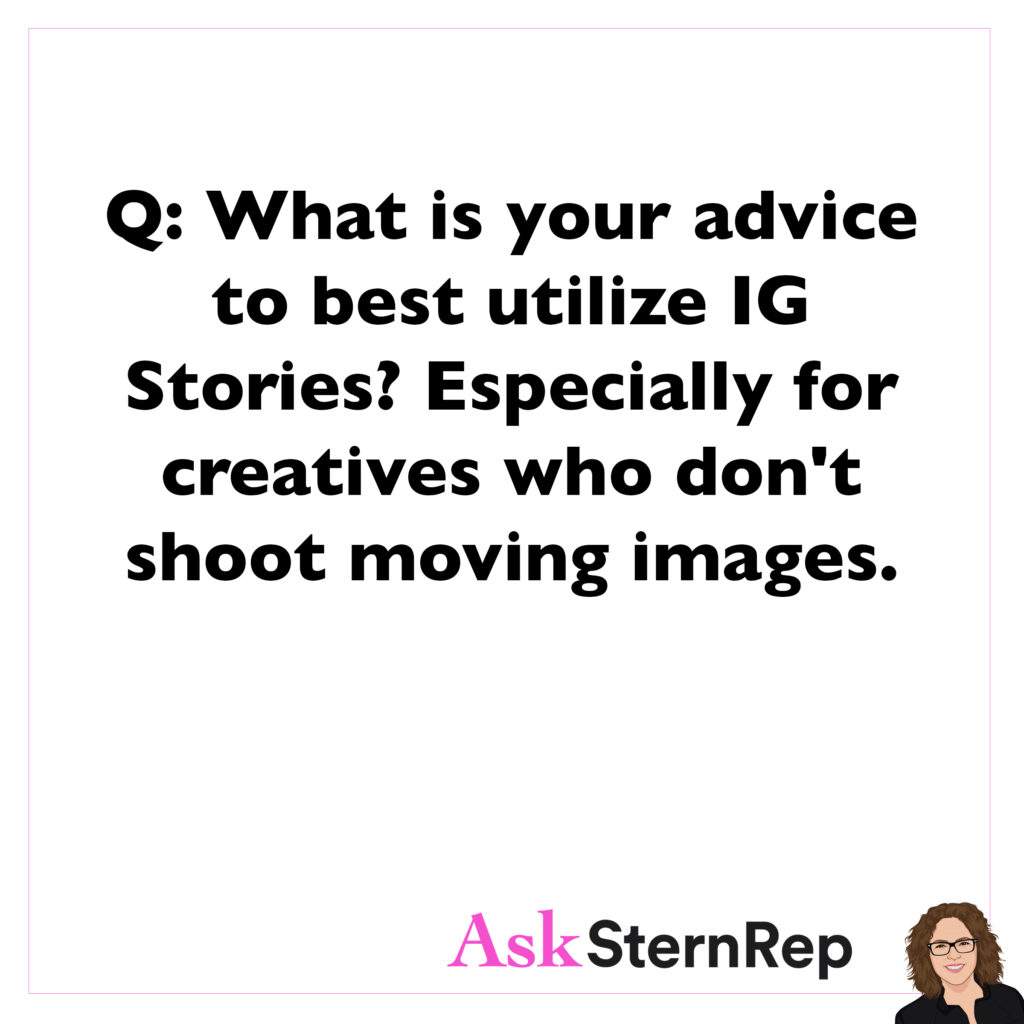

Q:
What is your advice to best utilize IG Stories? Especially for creatives who don’t shoot moving images.
A:
IG Stories are the way to go! They are what people are watching now. The feed posts are important, but those are more of a backup portfolio that gets checked out when you are up for a job. Stories are how you stay in front of people and start engaging with those you want to be working with by showing who you are and what makes you tick. People want to get a sense of you, where you live, what you do, what you are up to, behind the scenes on a shoot, where you are going and what kind of life you have. I know you can’t show it all, but branding your IG Stories is just as important as the branding on your website.
Top 5 Tips for Estimates
We are all curious about ESTIMATES.
My top 5 tips for every estimate:
- Start it off with the amount of final images you have agreed on.
- No variations included.
- This bid is based on information provided, any changes may incur overages.
- 10-hour shoot day.
- No overtime is included.
What do we need to include to help a photographer secure a job based on the estimate? Today, I’m going to share my top five points for creating an effective estimate:
- Job Description: Always include the number of shots at the top of the estimate. This is important because clients might want to add shots later, so clearly state how many shots are included and emphasize that there are no variations.
- Information and Overages: Add a line stating, “This bid is based on information provided; any changes may incur overages.” This protects you if changes are made to the scope of work.
- Hours: Specify the number of hours the shoot is based on. This helps set clear expectations.
- Overtime: Indicate if there is no overtime included in your estimate. Mention this in the email as well so clients know up front if additional hours will incur extra charges. Typically, estimates are based on 10 hours.
- Usage Rights: Note that usage rights are granted with full payment. Usage becomes legally theirs only once payment is received, so make this clear.
These are my top five points, plus one extra on usage rights. See you next week for the “Navigating the Unknown” webinar, where we’ll discuss this further.
Feedback from the Client
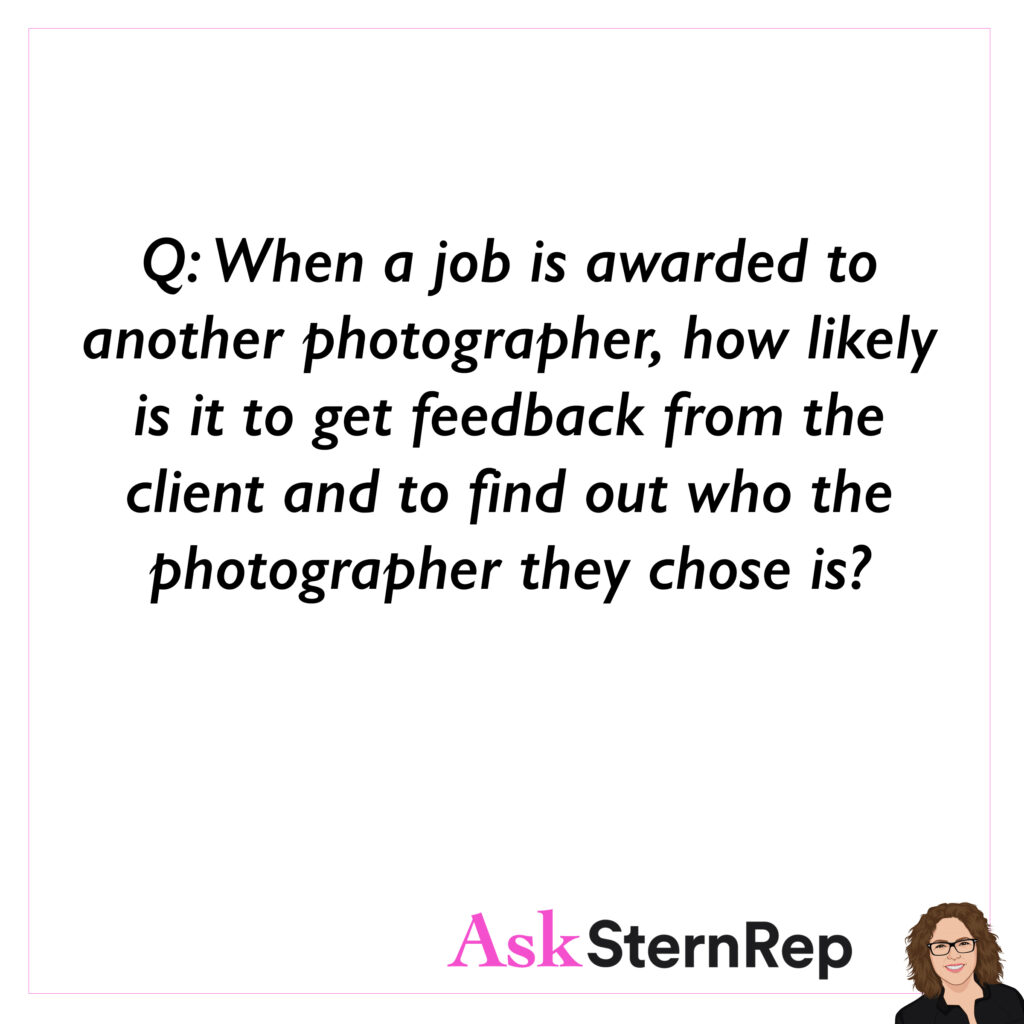

Q:
When a job is awarded to another photographer, how likely is it to get feedback from the client and to find out who the photographer they chose is?
A:
When another photographer gets the job, it’s really difficult to get the info of who they are or who else bid on the job. I am not sure why it’s such a big secret. I do my damndest to always find out who got it to help educate us, but it is a challenge that is hard to make happen. We get one opportunity to ask for this info so I wait a week or so when the information is not so top secret.
Warning on Making Changes to a Bid
*WARNING*
When you are asked to revise a specific cost on your submitted estimate, you can only change that cost. Do not be tempted to change other costs and assume they will read through it all again. You can get your client in trouble and it’s a sneaky move.
There’s one part of bidding we’ve noticed that you should be very careful about. When we’re asked to revise a bid, we need to only revise that specific line item that they’ve requested to change. It’s very tempting to change other line items because we might hear from their tone that our budget could have been higher or perhaps we’re a little low on craft services and should have put in more for meals. We cannot make those changes, because once we submit the bid, we have to assume when we give it back, they’re not going to read over the whole bid again. It can be really sneaky, even if we didn’t mean it in that way and we can get someone in trouble. Only change the revision that they asked for.
Covid + Testing


Q:
If a client asks you to be tested on your own before a shoot, can you charge a fee for the time? Not everyone lives in cities where testing is really easy to come by, and lines can be long. (Example: I am in Vermont right now for a month and have to drive an hour to get a test for a shoot in NY Tuesday), I know we are all just excited to get jobs at the moment, and I don’t want to rub anyone the wrong way. Of course if there is a fee they should pay, but what about for time? Like a mini travel day and mileage? I’m not stressing this type of fee, but just figured it might be something a lot of us hopefully start dealing with when going back to work so could be good to see how people respond.
A:
Right now getting tested before a job is a standard requirement. If you charge extra for it because of your location, this may turn into a detail about you that can hurt you in the future. If you are getting jobs out of NY I would not suggest making this more of an “issue” that the client has to pay for. You can always add a little more to your shoot or prep fees if you think there is room to do so, without calling it out as a Covid test fee. A side not to this is that I am noticing photographers paying their crew to get tested. Sounds like a fair idea to me.
Inside View: Photographer Dana Goldstein’s Top 7 Tips to Prepare for Online Portfolio Reviews
- Have copies of your presentation in two locations! I used Canva’s pro app to make two shorter ports of recent work, and it worked great – I used the app in presentation mode when I shared my screen EXCEPT during 1 of my 12 reviews, the app was having issues connecting. NO PROBLEM – I had already downloaded the PDFs of the final apps so I switched over to the PDFs without missing a beat. So I would say have two locations open just in case one has a glitch.
- If possible, use images that aren’t already on your website. I am fortunate to have had recent shoots and images for a new project, so I was able to avoid the chance of it just being a repeat of things they could have seen just by checking out the website.
- Have your website open and waiting ANYWAY. In one review, the reviewer asked if I had additional images from specific shoots, besides the portraits. I quickly logged into a specific gallery on my website and began sharing that screen. For all reviews going forward, I also had that page up and ready to go if I needed it.
- LinkedIn is always your friend. In my last review, I got the reviewer on the schedule, but she was also joined by an associate as she had been having childcare issues and couldn’t be sure she could stay on. I had five minutes to look him up and found that he’s a skateboarder, like my daughter, so I was able to open the conversation with that connection, and I mentioned it again in my thank you email. He shared a link to a friend’s project with a young girl skateboarder in response, and it helped solidify a new connection (who is now a LinkedIn contact himself).
- I thanked each reviewer for participating in this new type format, and asked how it was going from their side, since it’s all a work in progress. They all said they were so excited to be able to meet photographers from all over the world. One said, “I just met a photographer in Africa!” So if you’re outside the main cities, emphasize how meaningful it is for you as a creative to be able to participate from where you are. Gratitude is important and memorable.
- I had a digital promo card ready to go in the chat as soon as the review started. (Also created on Canva) Don’t wait till the end to give this, as you might get cut off rather abruptly in a group review format, and not have a chance to exchange information. I also mentioned that I was dropping it in, since not everyone keeps their chat tab open in Zoom.
- Do a run-thru with someone who’s not on your WiFi. Some formats do these lovely dissolves between images or virtual “page turning” but depending on the other person’s connection, it may look choppy. I wanted to do the dissolve, but my daughter told me from school (she was on Zoom on her phone) that it looked halting and choppy and was distracting, so I did clean image breaks instead.
Do Something
“You’ll learn more in one hour of doing something than in a lifetime of thinking about it.”
-Marc Randolph, Netflix founder
Educating Clients on Usage

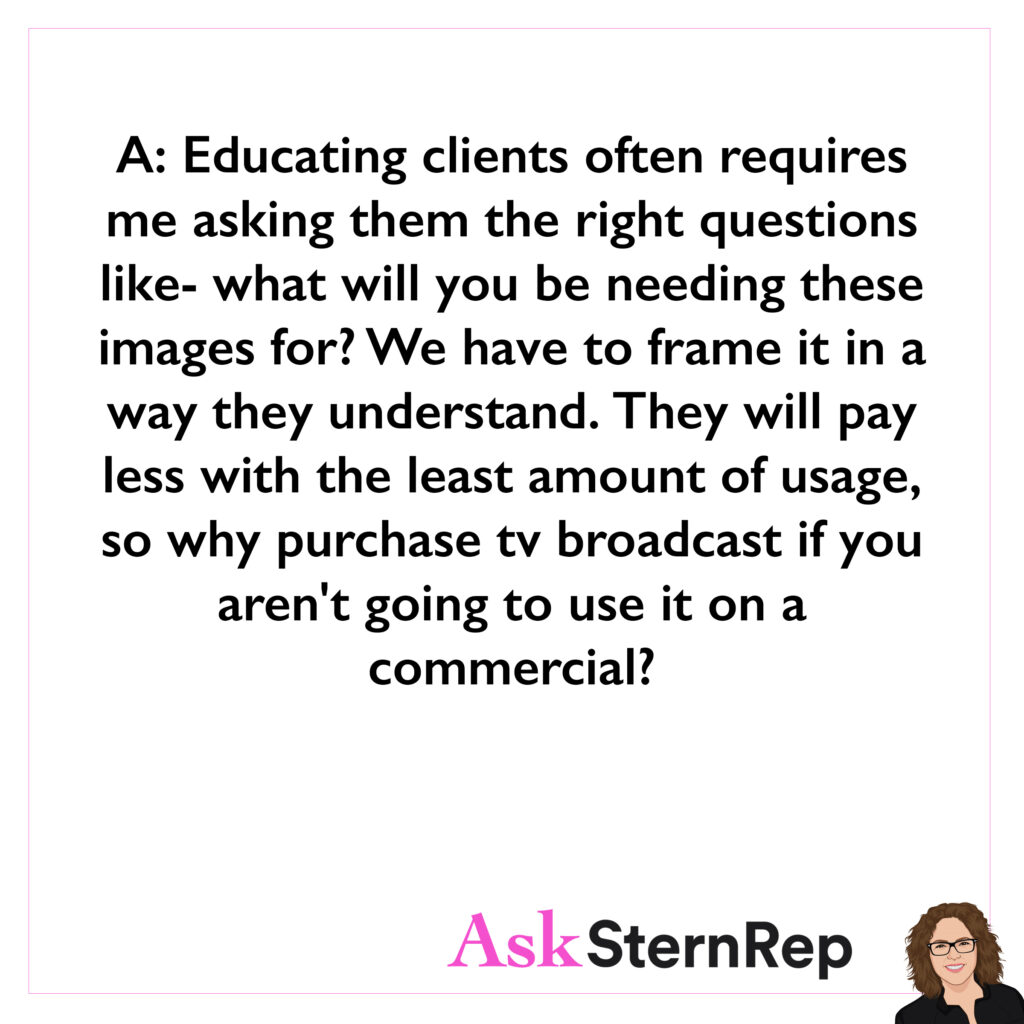
Q:
What is the most effective way to successfully educate clients of content rights and usage?
A:
Educating clients often requires me asking them the right questions like- what will you be needing these images for? We have to frame it in a way they understand. They will pay less with the least amount of usage, so why purchase a TV broadcast if you aren’t going to use it on a commercial?
The Best Business Owners Hire the Best Support
You are the CEO of your company. The best business owners hire the best support. If you think you can do it all, think about the time you are wasting and everything you are not getting done.
As you know the purpose of all of this and all that we’re doing is to achieve success. The things that get in our way are people who don’t delegate to other people. We can’t be the best at everything. We have to hire the best. A lot of things don’t get done, maybe because we don’t know how or maybe we want control over it or we think we’re great at it. Like social media. I could not do this on my own, I need help. I see photographers who need help. We have to stretch it out and get the help we need and delegate and stop thinking we can do everything.
Ghosted


Q:
I find that when working as a freelancer I often get ghosted by clients. We will have approved rates and discussed dates and then they go cold. It seems so unprofessional and I’m surprised by how often it happens. What is the best way to deal with this?
A:
Ya I hear you. This procedure is they reach out to about 10 photographers and then their creative choose 3 of them to bid the job. It can be misleading as it isn’t presented as an initial round up of available photographers. I email them back after not hearing anything for a few days, asking if we should keep the hold. That is when I get a response because they don’t really want us losing other jobs and holding the dates.
Let’s Talk About Shooting Today // Navigating the Unknown Episode 10
Navigating the Unknown Episode 10 is now live on YouTube! This week we talk about what it’s like to shoot now with Photographer Caleb Kuhl + Producer Luigi F Rossi, who have both worked on large commercial productions in the midst of COVID-19.
Guests:
Caleb Kuhl – Photographer https://www.calebkuhl.com/
Luigi F Rossi – NYC Producer https://www.luigirossi.tv/
Navigating the Unknown is a Q&A series in collaboration with APA-LA where we speak to different members of the photo community about all aspects of the commercial photography business. https://la.apanational.org/
With Co-Host: Photographer Hugh Kretschmer https://www.hughkretschmer.net/
Licensing Terms
When we hear licensing terms like “copyright” and buyout,” they don’t always know what they are saying. I usually assume they don’t mean it unless they are large companies who are known to require ownership of a usage.
Recently we were emailed by someone who said they wanted to buy the copyright. We knew this was client direct because ad agencies know usage terms. Nowadays we’re getting requests from clients directly and production companies don’t really know what usage is. We spoke on the phone and after some explanation about usage we discovered what they needed it for. It turned out they needed it for social media, which is way different. It takes asking people directly on the phone, what they really need it for, so you don’t have to charge that much or get so intimidated by it to find out what they want to use it for.
Marketing + LinkedIn
How do we reach clients?
LinkedIn is my #1 answer.
The only way I tend to get the answers like email address + IG handle is to ask in several personalized follow-up notes instead of asking all in one message. It takes patience and follow through but hey, that’s called “marketing.”
One of our biggest challenges is figuring out who our clients are and how to reach them. The best way we have found is LinkedIn. Never ask for contact information without a note. Make it a quick note, introduce your name and who you are in two quick sentences. Ask for their email by asking if you can send your promo along with a link to your website. From there you can create a list of emails. We will also add these emails to our Agency Access list. It takes a lot of time and patience to create these lists. It’s very repetitive and it takes a lot of work.
Lifestyle + Portrait Photography
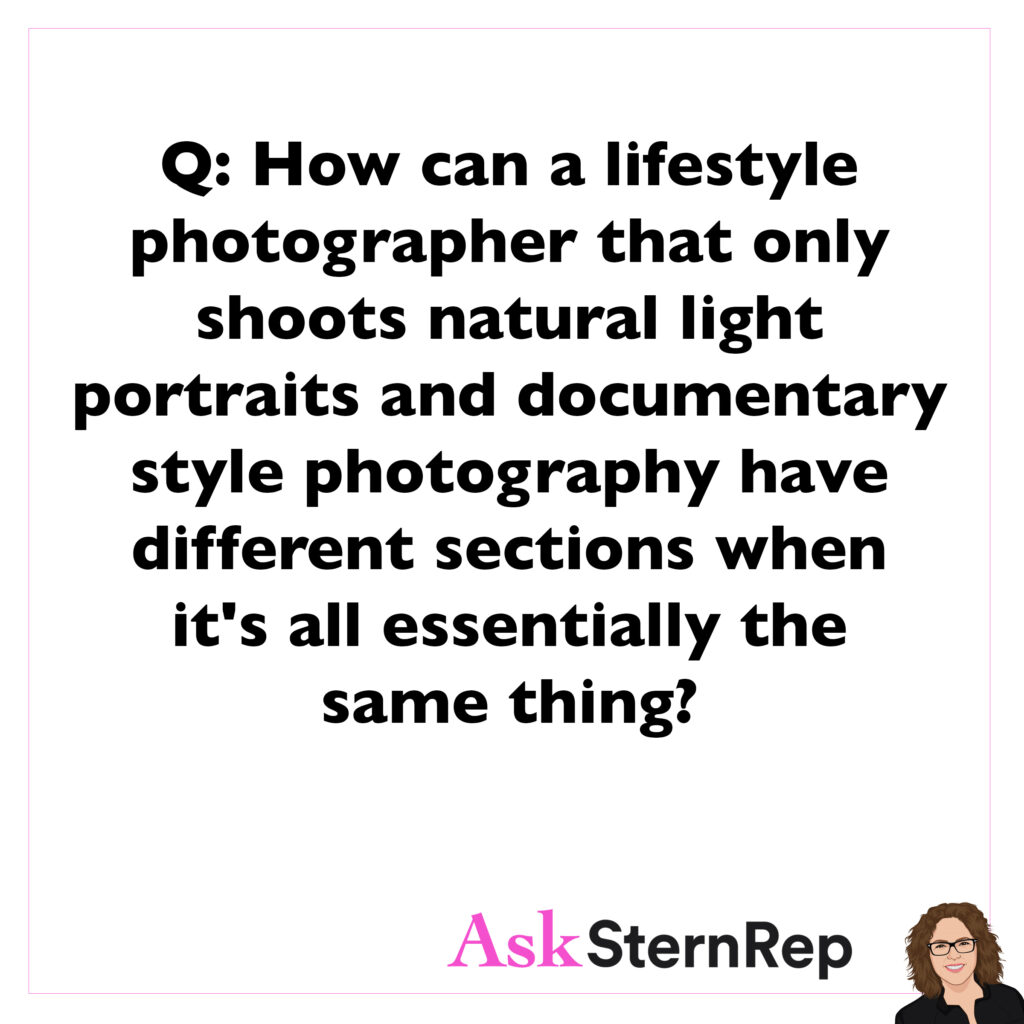

Q:
How can a lifestyle photographer that only shoots natural light portraits and documentary style photography have different sections when it’s all essentially the same things?
A:
If you shoot one type of photography with similar situations, you don’t necessarily need different categories but it could be a way to show more and give you more credit. When you are up for a job, it gives the client some satisfaction to dig in deeper, explore, and research you. Projects that show off other clients/past jobs is a definite boost to give them reassurance that you are trustworthy. Give the viewer the option to see it all on one overview or keep them longer, by offering sections which suggest you have a lot more to show!
Mastering Your Brand
Once you master your branding style, grow from within that special sauce to give clients what they will not get with others.
Hone In + Grow Out
Two things we’ve noticed:
- Photographers are not getting jobs if they’re too general or not specific enough in their brand. Right now there are more photographers available and less jobs. You have to master something. Think about your competition, someone has really dedicated their portfolio to whatever this job is about. Your brand has to be very strong, you have to know it. It may not be something you can describe, maybe it’s more something you can feel. That’s your look.
- Photographers need to expand and grow and move forward. They have to have things like gifs, stop motions and cinemagraphs. We have to be upping the game right now. If you’re too general or if you’re not expanding enough. If you need to expand more you take that look that you know if your style and from there you cohesively expand it.
Bidding + Temp Rep


Q:
How do I transfer the bidding process to a temp rep when I’m used to receiving requests and managing client relationships myself? Would a temp rep be beneficial? Could this damage my relationships?
A:
A temp rep situation is just that, temporary and flexible. I would jump in and help with negotiation or overseeing your estimate to make sure you are protected on your terms, upon your unique circumstances. Maybe you just need a negotiator or back-end support to oversee your estimate or a communicator to help protect you by setting up the job terms clearly. Our goal is always the same- let’s get you the job and the highest budget!
Invest Back Into Yourself
It’s a heavy time right now, so keeping our own focus where we invest back into ourselves may be the way to keep that glass half full.
Online Portfolio Q&A

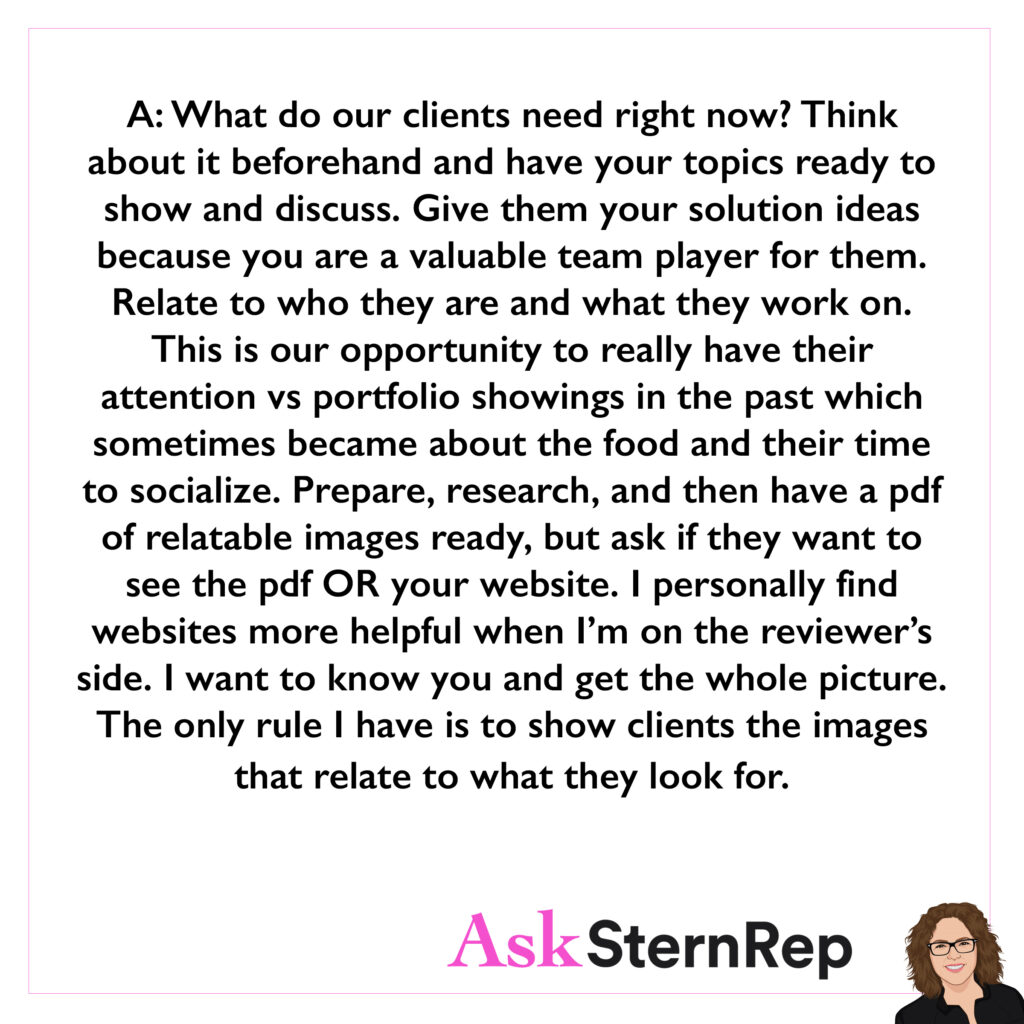
Q:
As portfolio reviews shift online rather than in person, do you have any guidelines as to how best show our work? Is it a curated website gallery? A shared PDF? How best to display our work over Zoom etc?
A:
What do our clients need right now? Think about it beforehand and have your topics ready to show and discuss. Give them your solution ideas because you are a valuable team player for them. Relate to who they are and what they work on. This is our opportunity to really have their attention vs. portfolio showings in the past which sometimes became about the food and their time to socialize. Prepare, research, and then have a pdf of relatable images ready, but ask if they want to see the pdf of relatable images ready, but ask if they want to see the pdf OR your website. I personally find websites more helpful when I’m on the reviewer’s side. I want to know you and get the whole picture. The only rule I have is to show clients the images that relate to what they look for.
Labor Day Reset 2020
On Monday’s Q&A I asked you to share your “career reset” for Labor Day 2020, so here is mine.
SternRep has been doing well and I enjoy the crap out of it, but maybe there is more? Asking myself the questions that my pre-Covid routines didn’t leave much time to ask:
- What did I think was impossible to reach out for before (support with other reps)?
- What will challenge me a bit more and even make me nervous out of my comfort zone (hosting a webinar)?
- What have I forgotten about that makes me tick (time for myself at the ocean)?
COVID + Labor Day

In appreciation of your labor, I’m going to do something different for this Monday Q&A. Today I ask YOU the question. Be vulnerable on this.
178 days into quarantine, have you felt a reset in your career? In what ways?
Please share your answers in the comments.
New Normal
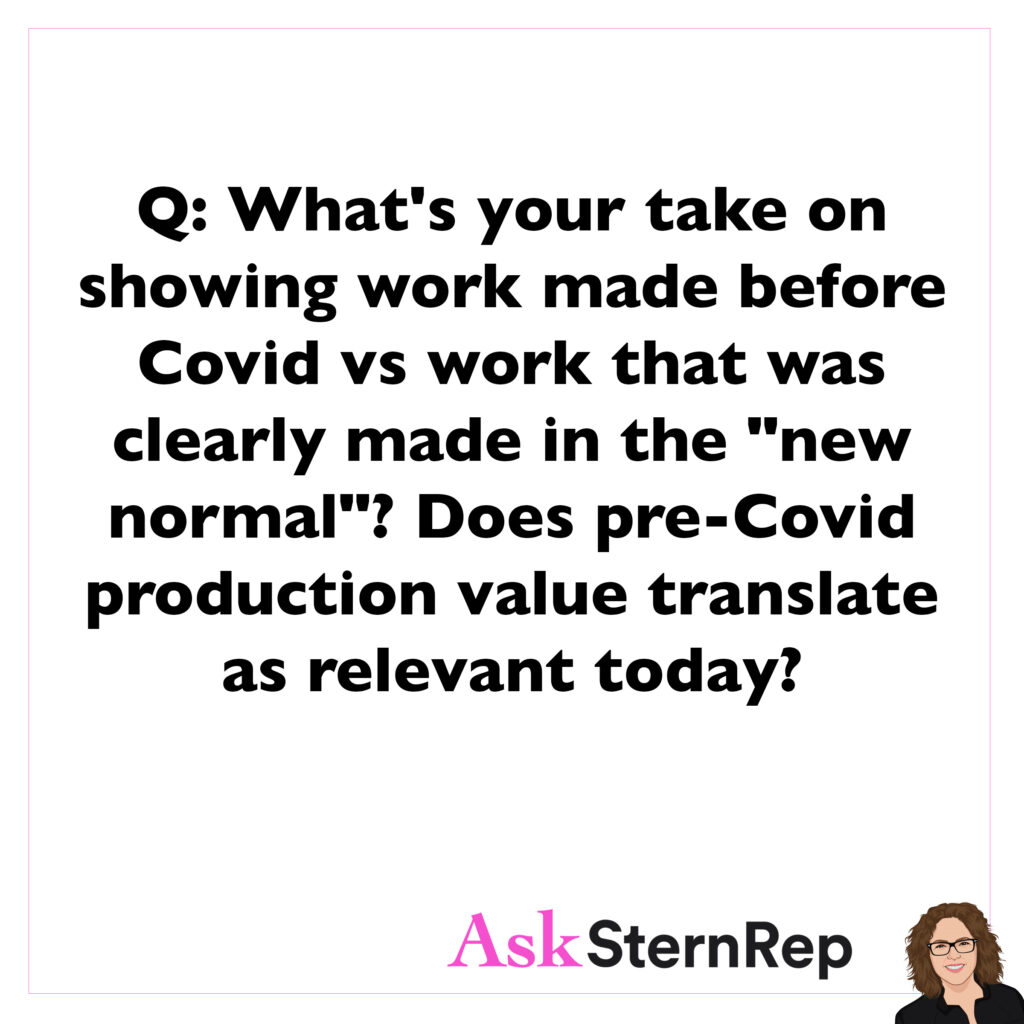
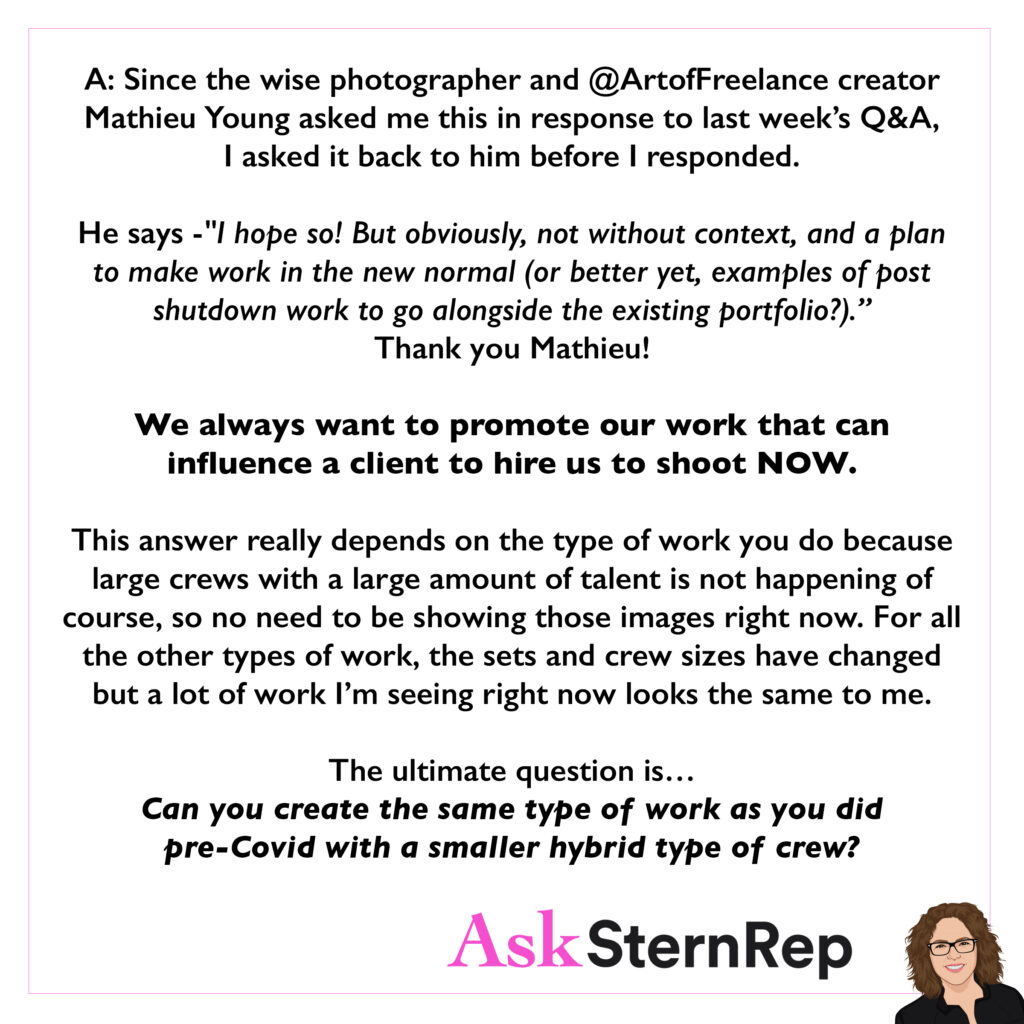
Q:
What’s your take on showing work made before Covid vs. work that was clearly made in the “new normal?” Does pre-Covid production value translate as relevant today?
A:
Since the wise photographer and @ArtofFreelance creator Mathieu Young asked me this in response to last week’s Q&A, I asked it back to him before I responded.
He says – “I hope so! But obviously, not without context, and a plan to make work in the new normal (or better yet, examples of post shutdown work to go alongside the existing portfolio?).”
Thank you Mathieu!
We always want to promote our work that can influence a client to hire us to shoot NOW.
This answer really depends on the type of work you do because large crews with a large amount of talent is not happening of course, so no need to be showing those images right now. For all the other types of work, the sets and crew sizes have changed but a lot of work I’m seeing right now looks the same to me.
The ultimate question is…
Can you create the same type of work as you did pre-Covid with a smaller hybrid type of crew?
MindMapping
Keep your business moving forward as clients are looking at us to set the trends. Stay hot, fresh, and relevant – here is a helpful tool to get your ideas out of your mind to make sense of the plan you need to put into action ASAP.
Your topic can be “GROWING FORWARD,” write it on a piece of paper, circle it in the middle of a page, and set it free!
We are trying to adjust to a time we don’t yet know how to handle, which means we have to make decisions and plans. Yet, we are probably all dealing with many thoughts in our heads without much clarity, making it hard to decipher which ones to follow and how to proceed. One useful method is mind mapping. It’s how I became a rep. I started with a central circle labeled “ideal job” and branched out into various aspects of what that job would entail—what it looks like, what I’m wearing, where I am, whether I’m at home or in an office, the time of day I’m working, how much I’m making, and the skills I’m using, which in my case are sales.
Mind mapping helped me clarify my path. I even brought my mind map to a photographer, and he identified me as a rep, a term I wasn’t familiar with at the time. Recently, I did another mind map titled “What I Want from Photographers.” It’s a way to get all your thoughts out by starting with a central question and creating a plan by stepping back and analyzing what you want and how to achieve it. It’s like a vision board for your mind, helping you figure out your direction and strategy.
Reps + Portfolios

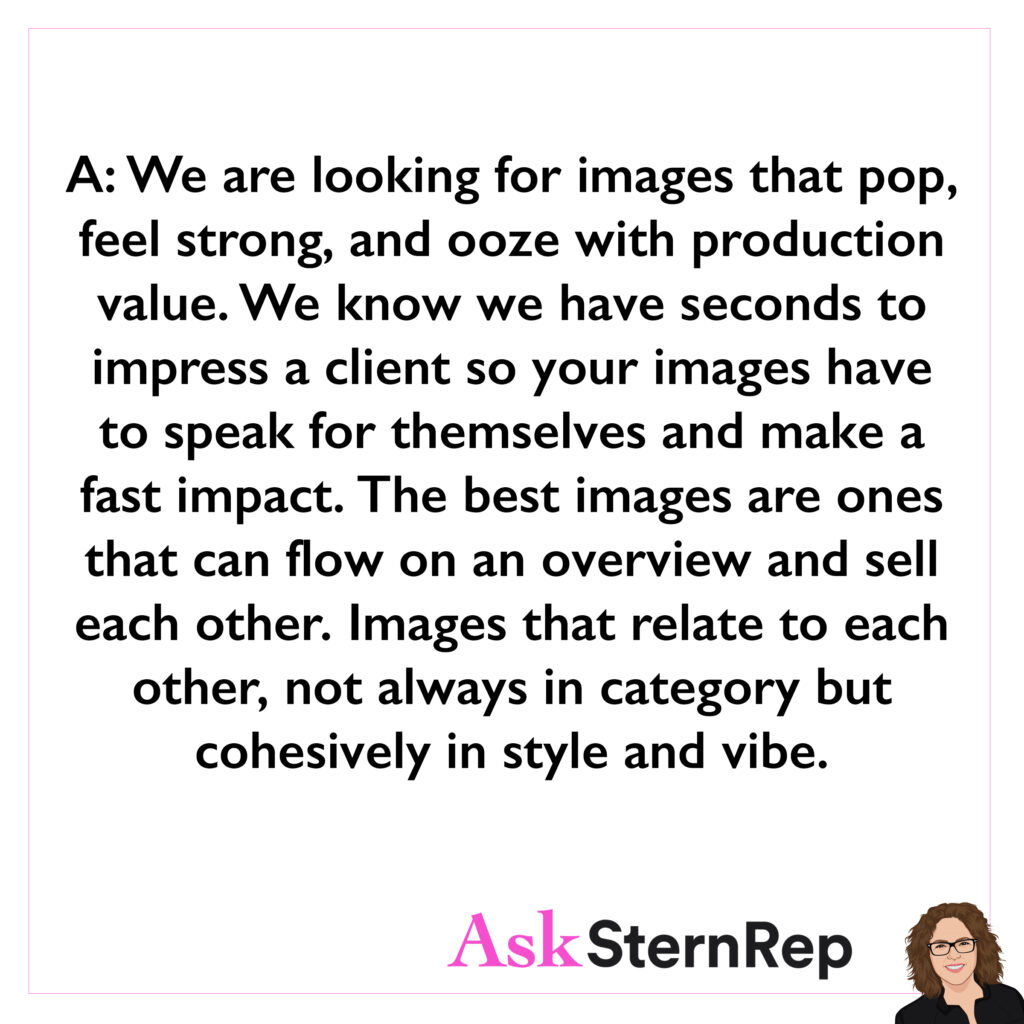
Q:
What in particular from a photographer’s portfolios are key? What are reps looking for specifically in the work or how it’s presented?
A:
We are looking for images that pop, feel strong, and ooze with production value. We know we have seconds to impress a client so your images have to speak for themselves and make a fast impact. The best images are ones that can flow on an overview and sell each other. Images that relate to each other, not always in category but cohesively in style and vibe.
Be Ready With Your Purpose
To get the most out of your online/zoom portfolio reviews, be ready with your purpose. What do you want to get out of it? Have your points of interest and questions ready to keep the topic flowing in the direction that fulfills your goal.
Consultants for Portfolio Review


Q:
Who are consultants you recommend for portfolio/website review?
A:
Consultants can be a game changer because they know the business and they know how to shape your website/portfolio to fit the current market. When you aren’t hearing back often from clients, give a consultant a try and see what they have to say. I believe in them so much that I just created a section on my website for them. https://www.sternrep.com/consultants
Motivation from Marc Randolph
“You fly to Blockbuster, try and sell the business, and they laugh at you.”
-Marc Randolph, Netflix founder
This quote really speaks to me about the transition from what the world was to what it has become. Netflix represents the content of today, and our entire industry is shifting towards content creation. To keep up, we can’t be stuck in our old ways of thinking. We need to move forward and not just rely on logical predictions of what will happen. Decisions should be based on our intuition about where the world is headed. We must stay one step ahead of change to ensure the success of our careers.
Marketing Yourself

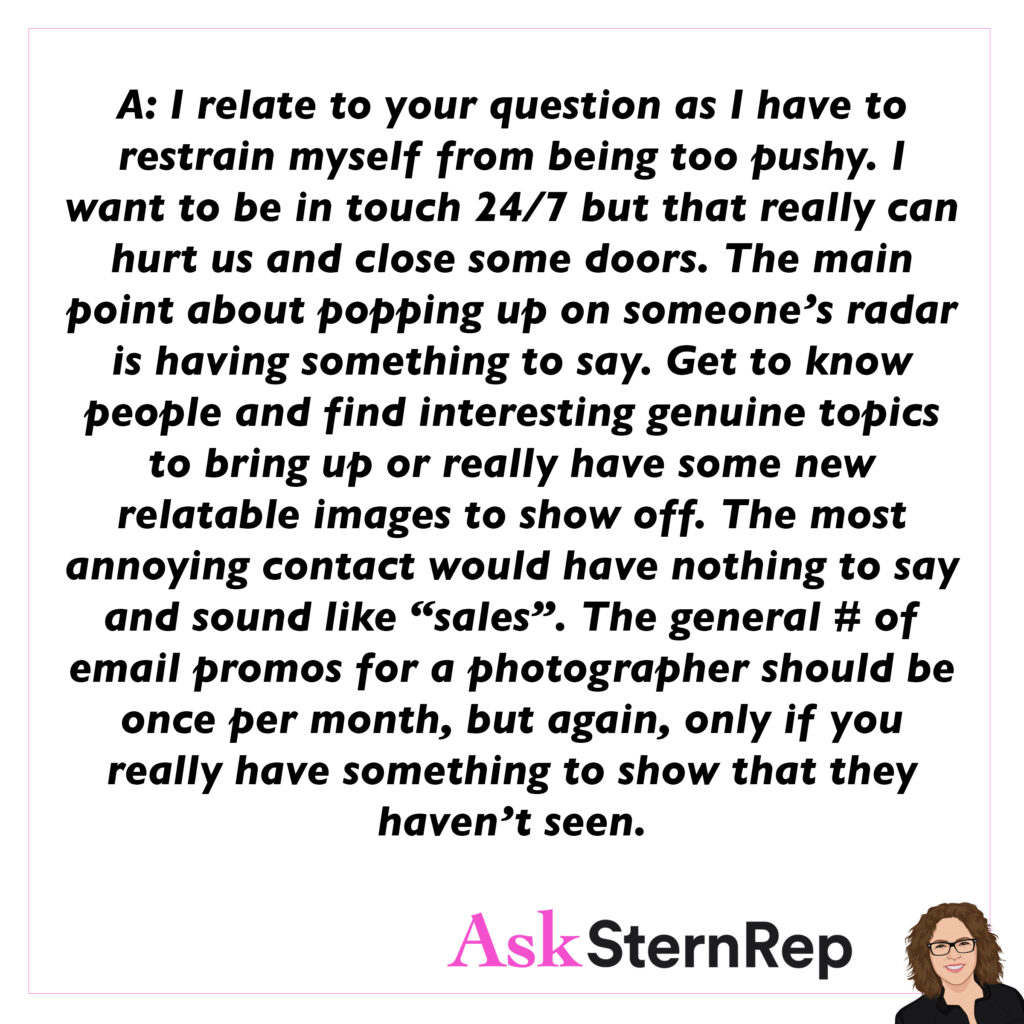
Q:
I see marketing myself as a finesse trait. Being aggressive doesn’t work 24/7. How do you find the balance? What’s a good rate of popping up on somebody’s radar?
A:
I relate to your question as I have to restrain myself from being too pushy. I want to be in touch 24/7 but that really can hurt us and close some doors. The main point about popping up on someone’s radar is having something to say. Get to know people and find interesting genuine topics to bring up or really have some new relatable images to show off. The most annoying contact would have nothing to say and sound like “sales”. The general # of email promos for a photographer should be once per month, but again, only if you really have something to show that they haven’t seen.
Photographer Chris Burkard on Portfolio, Marketing and Success // Navigating the Unknown Episode 9
Navigating the Unknown Episode 9 is now live on YouTube! This week we speak to photographer Chris Burkard about his success as a photographer and influencer.
Guests: Photographer – Chris Burkard https://www.chrisburkard.com/
Navigating the Unknown is a Q&A series in collaboration with APA-LA where we speak to different members of the photo community about all aspects of the commercial photography business. https://la.apanational.org/
With Co-Host: Photographer Hugh Kretschmer https://www.hughkretschmer.net/
Poetry to My Rep Ears
It was poetry to my rep ears when I heard the words this client responded with on my photographer’s creative call –
“I hear the emotion you want to bring to this, and I hear your energy for this concept.”
Finally, the words that embody exactly what we need to achieve on these calls.
Creative calls have been a hot topic for everyone wanting to know what makes a good creative call. I’ve never been able to nail down the words as well as I did the other day on a call when I heard a creative discuss the energy and emotion they bring. In our business, as photographers, you need to bring the same passion that got you into this career to these calls. Be yourself, and convey the energy you will bring. Show them the concept and make it come to life. As Neff said, “That baby will be brought to life by you because you get it.” There’s only one way to demonstrate that understanding: through how you present yourself on the call. Words alone won’t do it—it’s about how you sound and how you convey your vision. Prepare for the call by finding the right words and expressing your understanding clearly. Show them what it will look like and how you will bring it to life.
Virtual Meetings
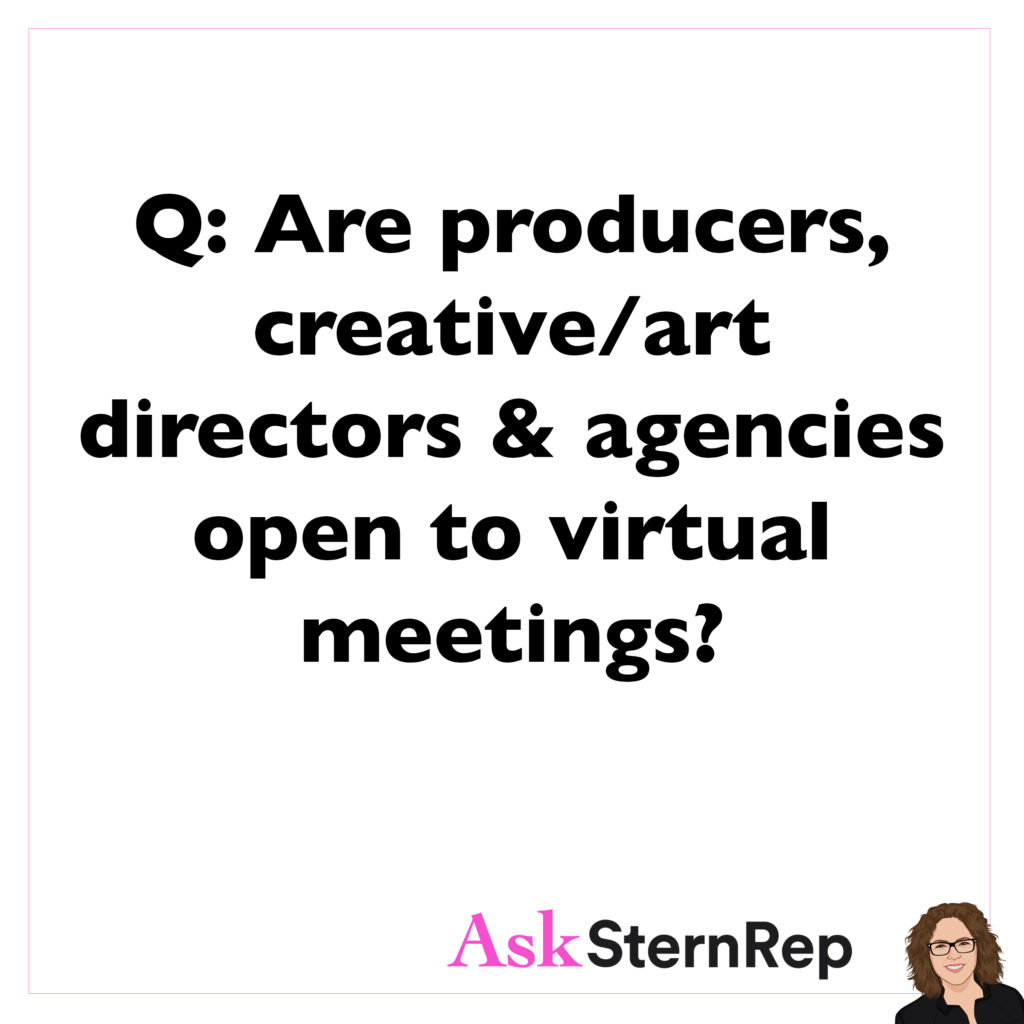

Q:
Are producers, creative/art directors & agencies open to virtual meetings?
A:
Yes, virtual meetings are happening although keep in mind we have busier clients than usual because a lot of layoffs have happened and they are doing the work for 2 or 3 people themselves. We can’t expect many clients to show up right now. The other part of this is I’d suggest you only do this if you have something to say and show. Make sure you really have a “pitch” to share and new images so that it is meaningful for them or else it could backfire and work against you.
Have a Picture of Yourself on Your Website
I heard this years ago and it is more true than ever – have a picture of yourself on your website!
Marketing + Representation


Q:
I’ve reached a point in my photography where I don’t know how to price and market myself, also I don’t know how to find the right representation. I was wondering how that process works?
A:
These areas are what all photographers are dealing with, even those who have been working for a while because times change. In general though, we do have some solid support in our industry like all the great webinars happening, Wonderful Machine, Amy V Cooper Consulting (www.amyvcooper.com) and my temp rep services to name a few. The most important part to this answer is to build your system and keep growing.
ALL ABOUT REPS Part 2 // Navigating the Unknown Episode 8
Navigating the Unknown Episode 8 is now live on YouTube! This week we speak to artist reps Mary Dail and Traci Terrick again to answer all your questions about reps.
Guests:
Mary Dail – Artist Rep, Big Leo Productions https://bigleo.com/
Traci Terrick – Artist Rep, Poppy Creative https://www.poppycreativeagency.com/
Navigating the Unknown is a Q&A series in collaboration with APA-LA where we speak to different members of the photo community about all aspects of the commercial photography business. https://la.apanational.org/
With Co-Host: Photographer Hugh Kretschmer https://www.hughkretschmer.net/
Failure is the Impetus for Success
“I liked this story because we placed an emphasis on failure. I find failure to be the very thing, the impetus for the next success.”
-Brad Pitt on Moneyball
This quote really grabbed me because it aligns with how I like to live my life and run my business. When something doesn’t go as planned or I don’t get what I want, I see it as an opportunity. I want the same mindset for my photographers. If we don’t land a job, it’s a chance to motivate ourselves and reflect: Why didn’t we get it? Who did? Check them out and learn from them. If agencies aren’t responding to us, ask why. What can we improve? Is there something new we need to learn or a different approach we should try? Use business setbacks as a way to advance and grow. As in baseball, you’re not going to hit a home run every time—you might hit .200, .300, or even .400, but that’s still a good average. If you find yourself taking things personally, consider reading “The Four Agreements.” Otherwise, view every setback as a chance to succeed and turn what might feel like a failure into an opportunity for growth.
Fees During Covid
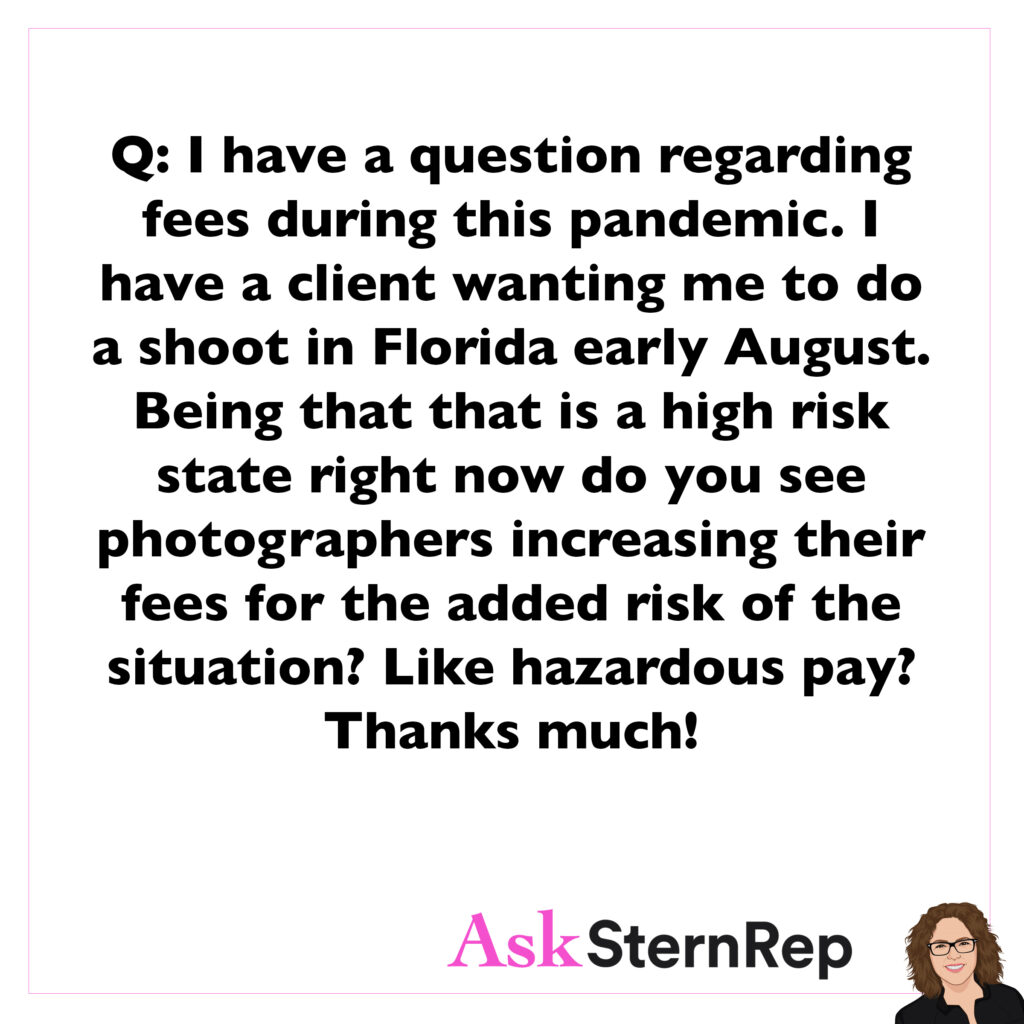

Q:
I have a question regarding fees during this pandemic. I have a client wanting me to do a shoot in Florida early August. Being that that is a high risk state right now do you see photographers increasing their feeds for the added risk of the situation? Like hazardous pay? Thanks much!
A:
This is a new situation for all of us, so there is no absolute answer to this. Since your question makes rational sense, it’s worth bringing up with a client you have food communication with. As you know, less jobs are happening so budgets are going down and photographers are extra eager to get work now. This high level of competition could prevent any extra financial coverage. Play it safe though and don’t cut corners on the precautions which affect the expenses and shot count. I’d suggest bringing up the expenses instead of trying to raise your fee, where clients can rationally see and understand what they’d be paying more for.
What is “Marketing” These Days?
What is “Marketing” these days? One way it is different is that we are all feeling more human right now. I’m having an easier time reaching clients and building my email promo lists. People are responding, so say hello.
This is a time when I’m noticing some photographers being very proactive in reaching out and communicating, which is essentially what marketing is. It can look quite different from how it used to, and we’re currently creating new ways to engage. Whether it’s on Instagram, LinkedIn, or any other platform, it’s important to keep yourself visible and active.
Right now, amidst this calm in the storm, take the opportunity to put yourself out there. Get creative, rediscover, reform, and reinvent your own marketing plan. Whether you have a rep or not, seize this moment of openness in the industry. Jump in, find your way, and let your voice be heard. It can be as simple as a friendly hello—just get yourself out there.
Recognizing a Good Rep
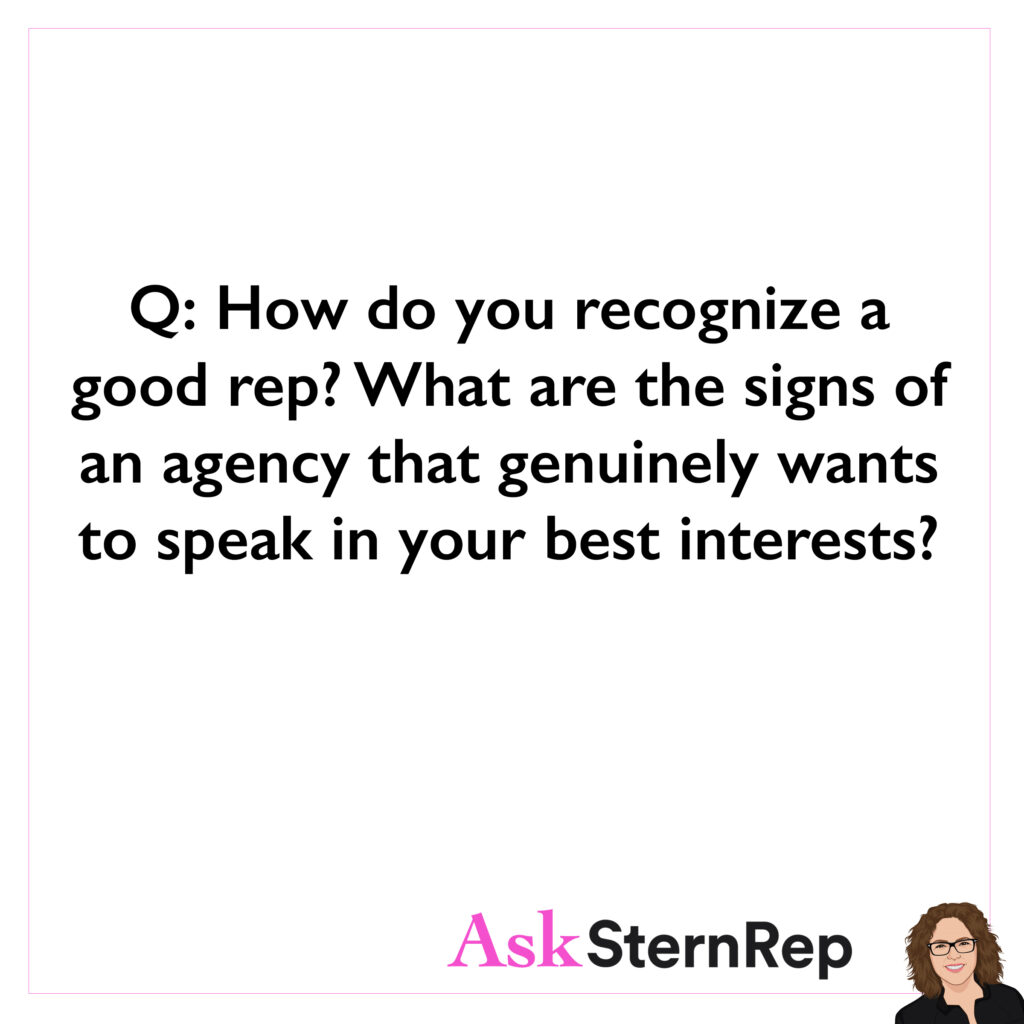

Q:
How do you recognize a good rep? What are the signs of an agency that genuinely wants to speak in your best interests?
A:
I’m going to answer this question in a big way since it’s such a significant decision. A “good rep” for you may not be the right rep for another photographer. You have some work to do before you jump into anything.
What support qualities would help you grow and shine? What type of people resonate with you, what size rep agency feels really right for you?
After checking out rep’s sites + social media, which have the look/feel/brand that your work fits with? Do you prefer a small or larger rep agency and is their location significant to your type of clients? Does the rep you are interested in charge a fee? Some reps do your production and billing which may or may not work for you. What are the terms of the rep’s contract? Do you already have house accounts that could benefit from a reps support or do you need a rep to agree with not taking a commission (or a lower commission) on those for a certain amount of time? Know your terms and requirements which can help you choose a rep.
The most important factor in your search is to know your own questions to ask reps and then truly listen to their responses.
And most of all, do you like who they are? Do they have a good reputation with clients and other photographers?
In literal terms, you want someone who will REPRESENT who you are. If all of this feels right, then I’d think they genuinely will be speaking in your best interests.
ALL ABOUT REPS // Navigating the Unknown Episode 7
Navigating the Unknown Episode 7 is now live on YouTube! This week we speak to artist reps Mary Dail and Traci Terrick to answer all your questions about reps. How to find a rep, when to get a rep, what reps do and be biggest myths about reps.
Guests:
Mary Dail – Artist Rep, Big Leo Productions https://bigleo.com/
Traci Terrick – Artist Rep, Poppy Creative https://www.poppycreativeagency.com/
Navigating the Unknown is a Q&A series in collaboration with APA-LA where we speak to different members of the photo community about all aspects of the commercial photography business. https://la.apanational.org/
With Co-Host: Photographer Hugh Kretschmer https://www.hughkretschmer.net/
What Does a Rep Look for in a Photographer?
So many factors that lead to a rep signing a photographer. Portfolio of course, are you marketable to my client base, communication style–ultimately for me it comes down to my guy. For example, Jeff Stockwell had an Instagram spread that really grabbed my attention and if you look, I think you’ll understand what I mean. That spoke to me!
Finding a Rep
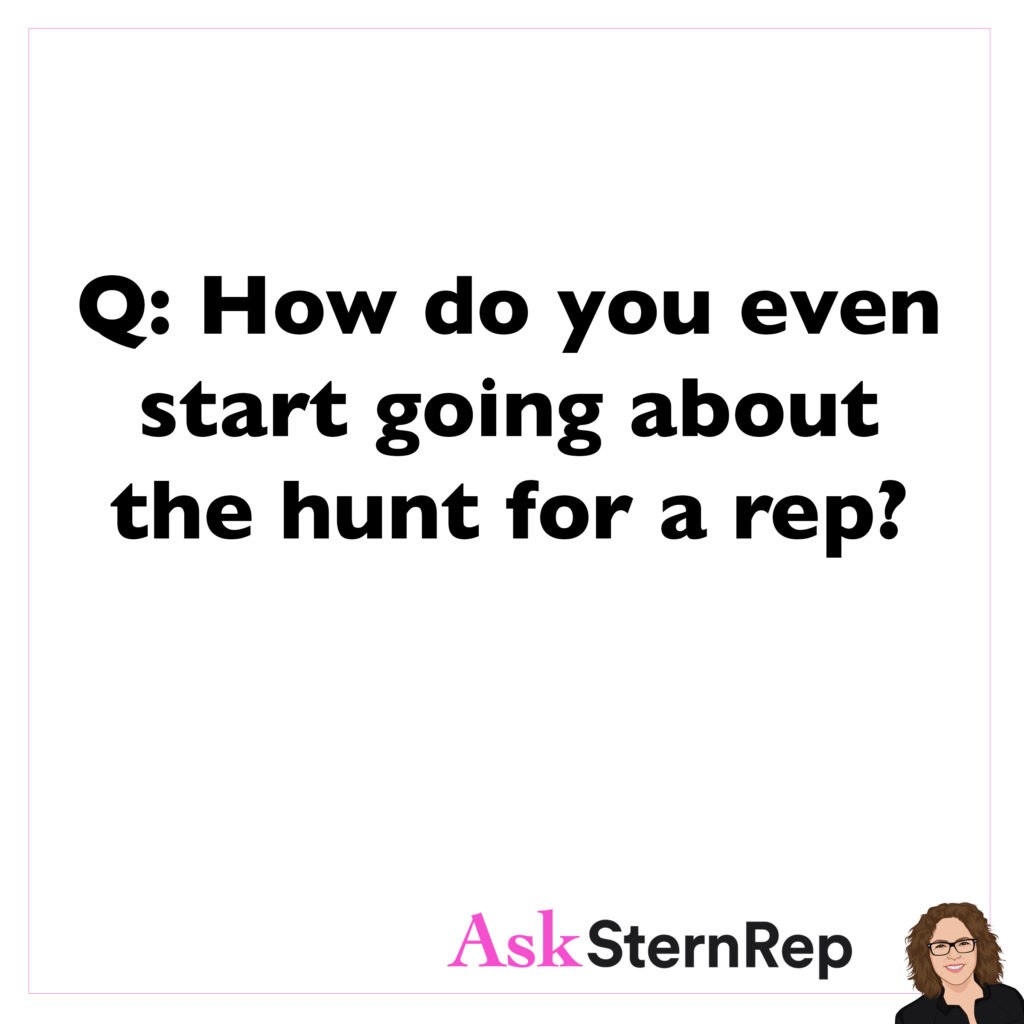
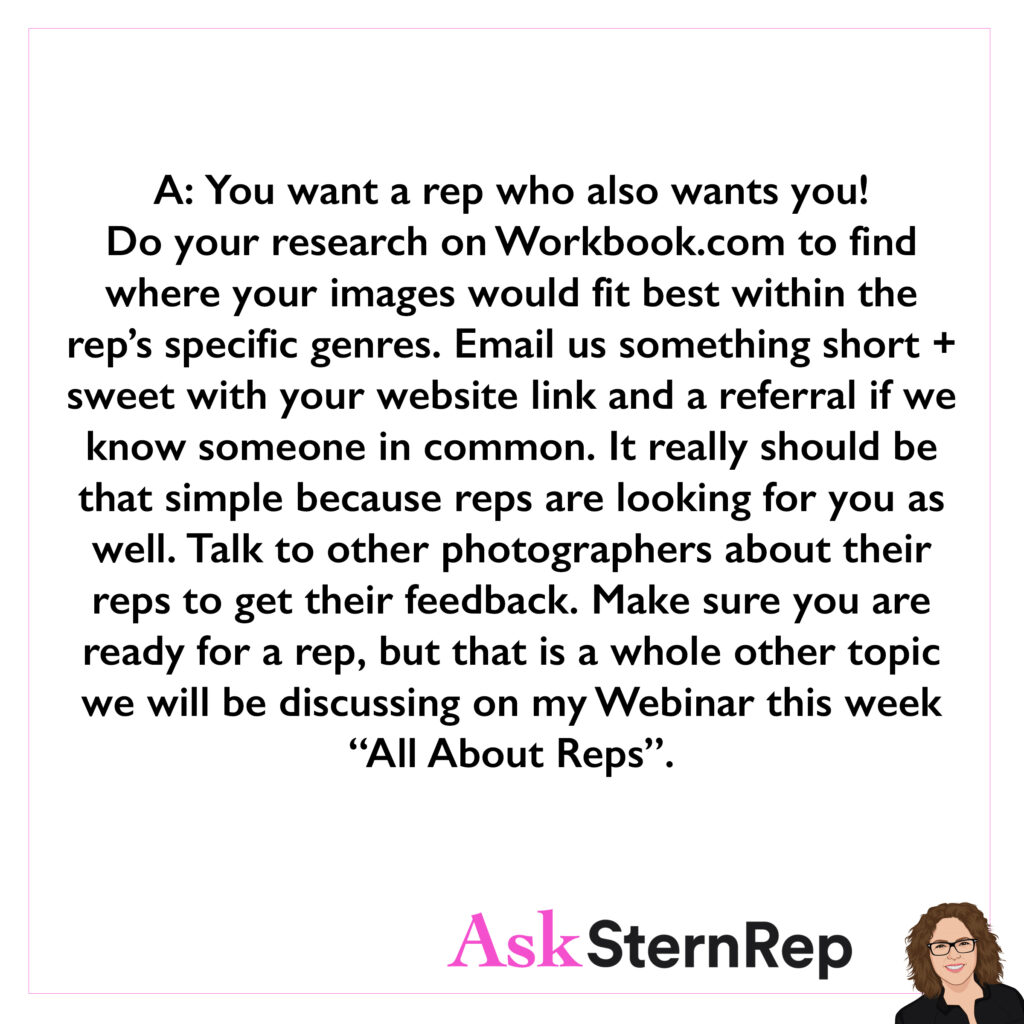
Q:
How do you even start going about the hunt for a rep?
A:
You want a rep who also wants you! Do your research on Workbook.com to find where your images would fit best within the rep’s specific genres. Email us something short + sweet with your website link and a referral if we know someone in common. It really should be that simple because reps are looking for you as well. Talk to other photographers about their reps to get their feedback. Make sure you are ready for a rep, but that is a whole other topic we will be discussing on my Webinar this week, “All About Reps.”
Is Now the Time to Look for a Rep?
Is now the time to look for a rep?
Yes!
Reps are looking for what clients are looking for. Bring your solutions to today’s issues and you will find more open rep doors than before.
We are all dealing with current issues like diversity, social distancing, and maintaining safety. Addressing these issues can be crucial, and right now is a good time to do so because the opportunities might be more open. However, it’s important to research the right reps for you. Look for reps who have clients and a style that aligns with your work and branding. Not every rep will be a good fit. I recommend reaching out via email or Instagram rather than making phone calls. Find a rep who is genuinely interested in representing you, as their response will indicate if it’s the right time to move forward.
Representation + Marketing

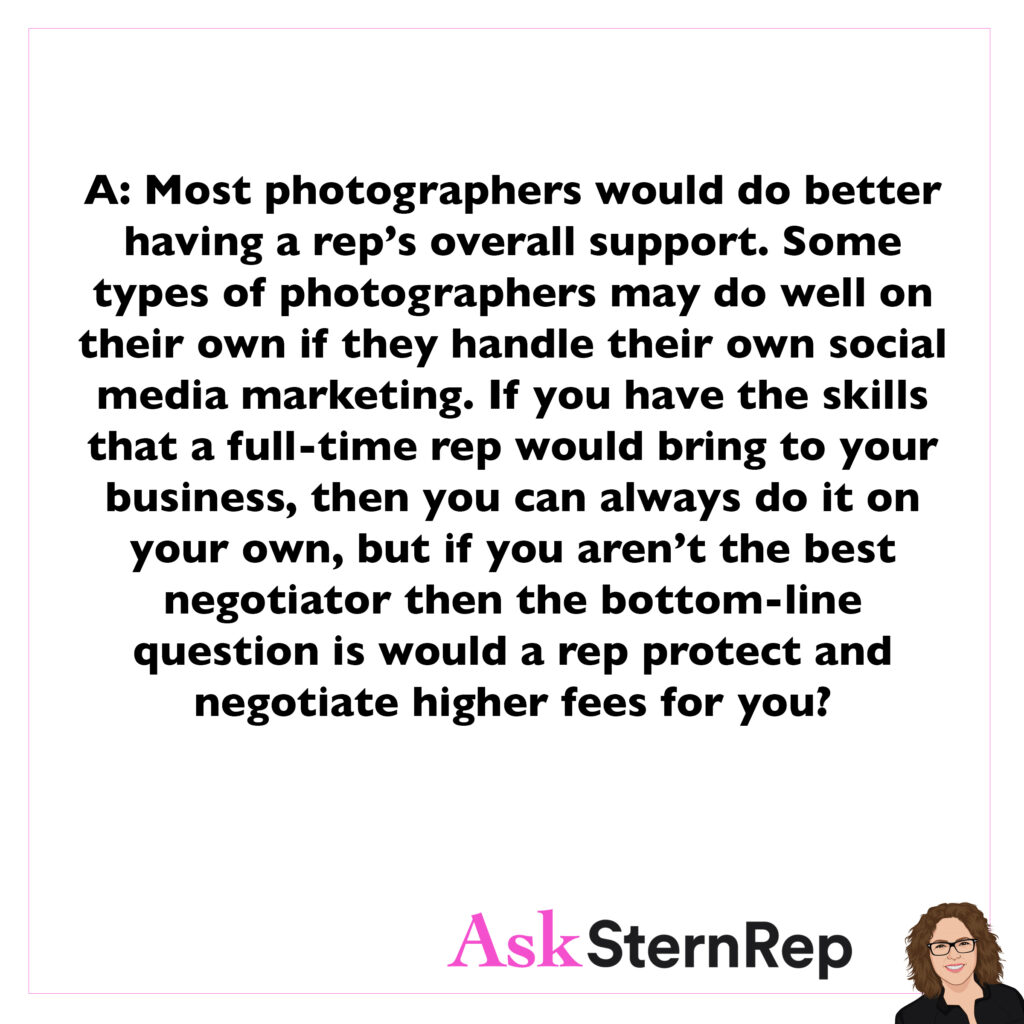
Q:
I’ve heard from several people in the business that you don’t need representation unless you are too busy to book and manage the business yourself. How true is this?
A:
Most photographers would do better having a rep’s overall support. Some types of photographers may do well on their own if they handle their own social media marketing. If you have the skills that a full-time rep would bring to your business, then you can always do it on your own, but if you aren’t the best negotiator then the bottom-line question is, would a rep protect and negotiate higher fees for you?
Being Nimble in Production // Navigating the Unknown Episode 6
Navigating the Unknown Episode 6 is now live on YouTube! This week we speak to Senior Art Producer Emily Hoskins and Creative Director Jason Pierce about staying relevant and adapting to new scenarios regarding production.
Guests:
Emily Hoskins – Senior Art Producer, Designory
Jason Pierce – Creative Director, Crispin Porter Bogusky
Navigating the Unknown is a Q&A series in collaboration with APA-LA where we speak to different members of the photo community about all aspects of the commercial photography business. https://la.apanational.org/
With Co-Host: Photographer Hugh Kretschmer https://www.hughkretschmer.net/
Clients Want to Know Your “Eye”
I’m noticing a trend how people want to stay in touch and see what you are up to. We are in this human business of photography because it’s your “eye” we are selling. Clients want to know your “eye”.
Clients are going through a lot right now, just like the rest of us. As photographers, we need to let them know who we are because they want to trust the people they’re allocating their budget to and who will be shooting for them remotely. They need to get a sense of who you are, and social media is perfect for that. Be proactive and use any extra time you have to showcase yourself and let clients feel like they know you.
Printed Promos During Covid
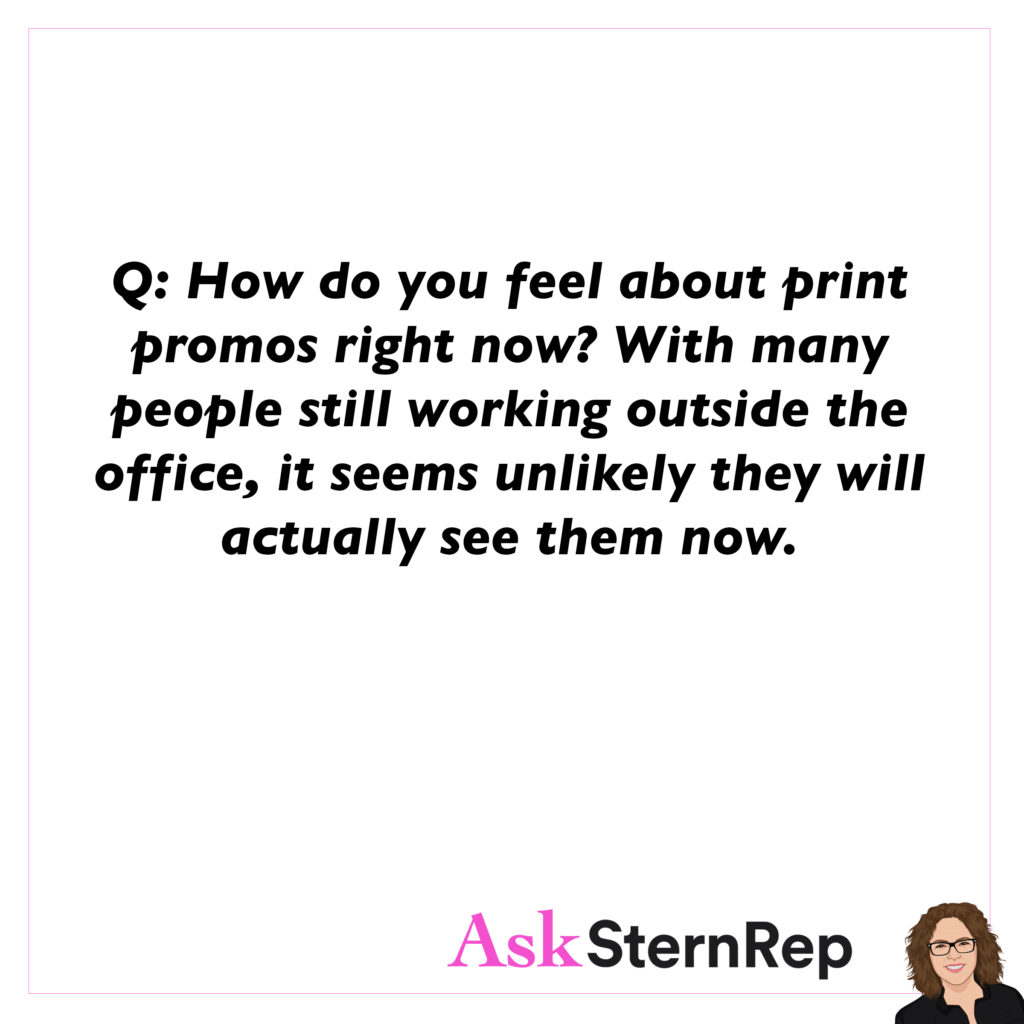
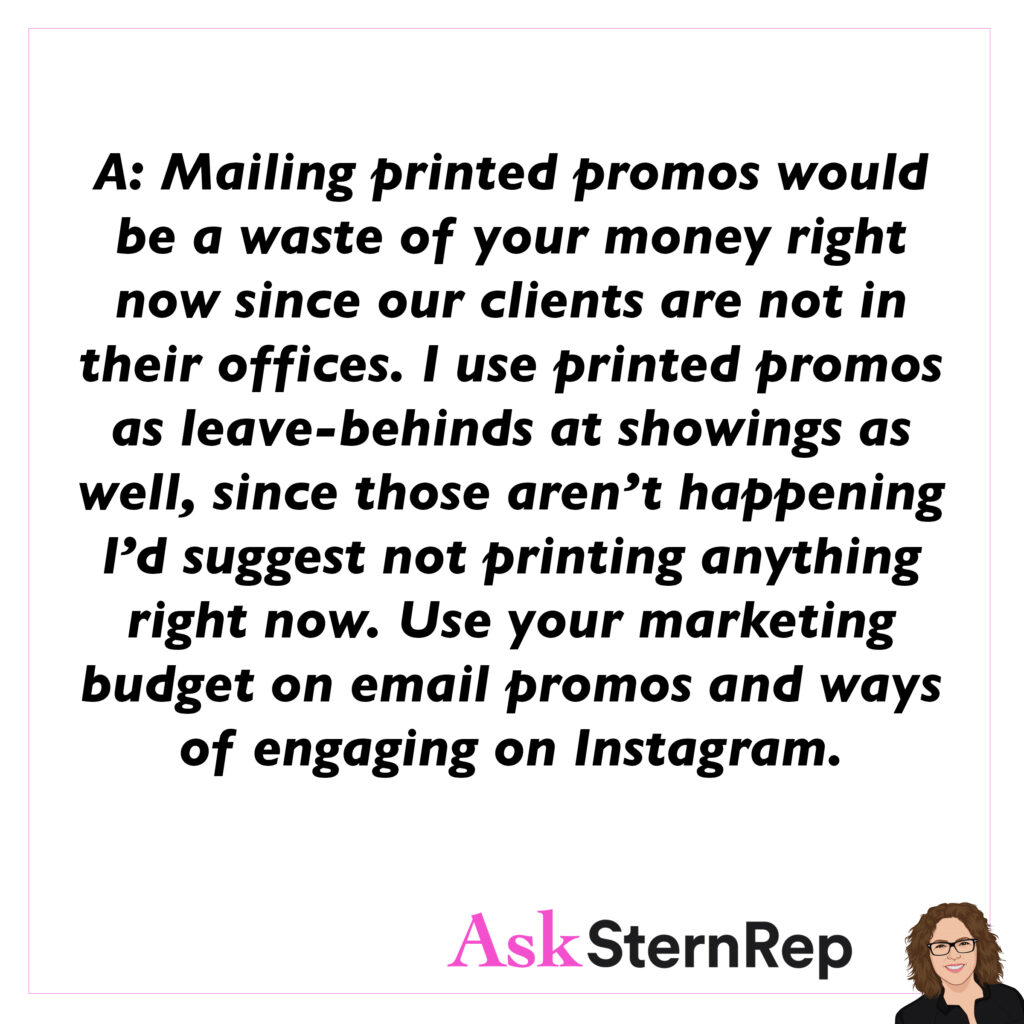
Q:
How do you feel about print promos right now? With many people working outside the office, it seems unlikely they will actually see them now.
A:
Mailing printed promos would be a waste of your money right now since our clients are not in their offices. I use printed promos as leave-behinds at showings as well, since those aren’t happening I’d suggest not printing anything right now. Use your marketing budget on email promos and ways of engaging on Instagram.
Reposting Images to Social Media
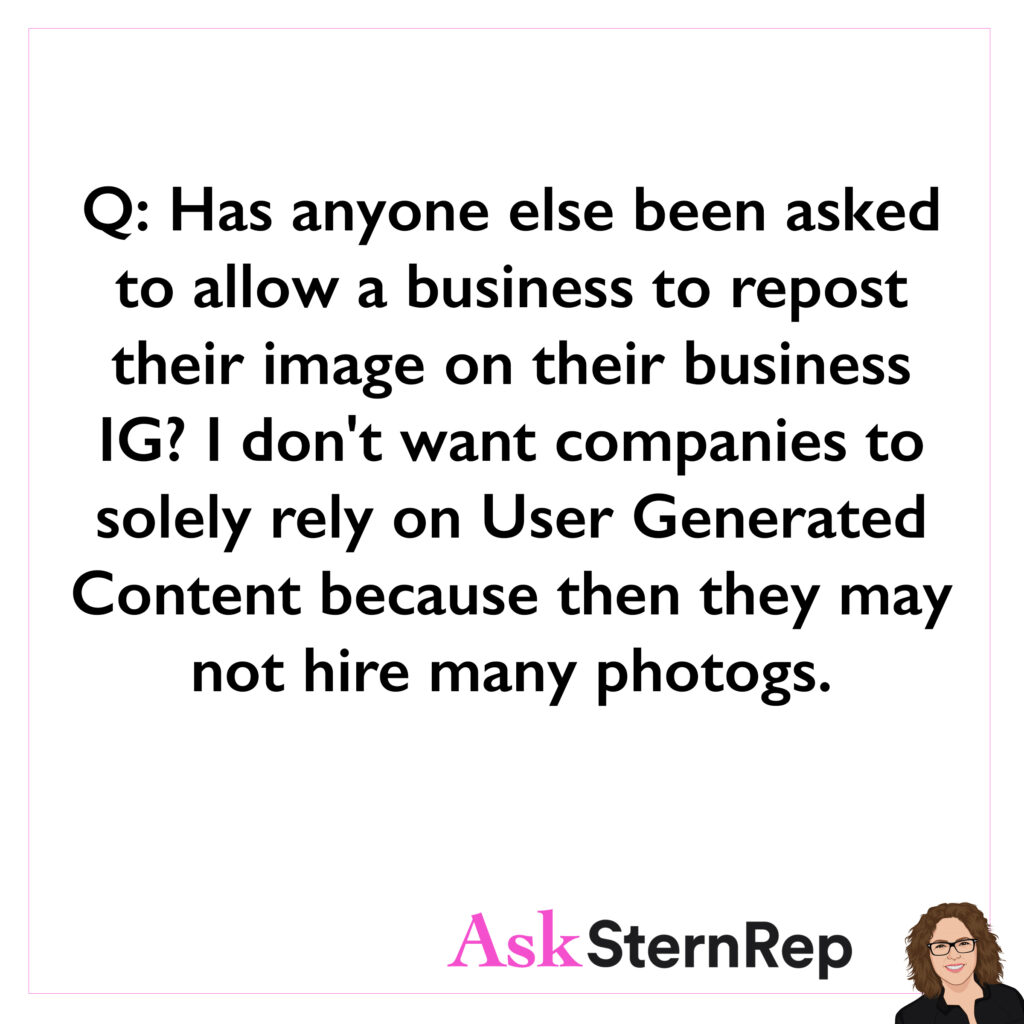
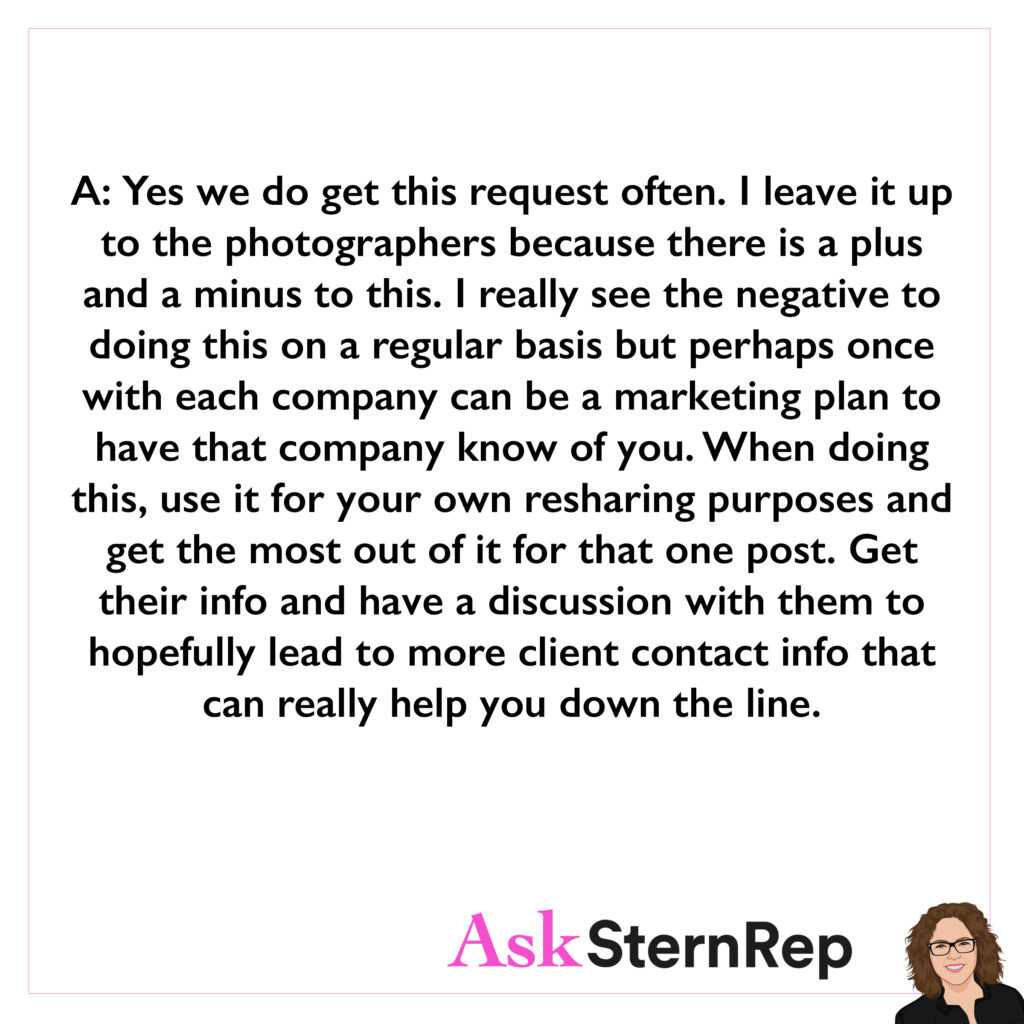
Q:
Has anyone else been asked to allow a business to repost their image on their business IG? I don’t want companies to solely rely on User Generated Content because then they may not hire many photogs.
A:
Yes, we do get this request often. I leave it up to the photographers because there is a plus and a minus to this. I really see the negative to doing this on a regular basis but perhaps once with each company can be a marketing plan to have that company know of you. When doing this, use it for your own resharing purposes and get the most out of it for that one post. Get their info and have a discussion with them to hopefully lead to more client contact info that can really help you down the line.
Marketing + Production in the Time of COVID // Navigating the Unknown Episode 5
Navigating the Unknown Episode 5 is now live on YouTube! This week we speak to Senior Art Producer Clarissa Garrett and Senior Producer Sandra Sanchez about deciphering and designing marketing and production in the time of COVID.
Guests:
Clarissa Garrett – Senior Art Producer, 72andSunny
Sandra Sanchez – Senior Producer, FCB Chicago
Navigating the Unknown is a Q&A series in collaboration with APA-LA where we speak to different members of the photo community about all aspects of the commercial photography business. https://la.apanational.org/
With Co-Host: Photographer Hugh Kretschmer https://www.hughkretschmer.net/
Covid Cancellations


Q:
Is anyone talking about Covid cancellation language yet? I need help.
A:
At this point, the client cannot be held responsible for normal cancellation fees if it is COVID related. Protect yourself by adding this line in the Job Description on the top of your estimate, “Due to any cancellations for Covid-19, all previously incurred expenses and fees will be covered once this estimate has been officially approved.” Having this sentence on your signed estimate, your purchase order, or even in your email agreement with your client can help protect you.
What Are Clients Interested In?
During these times, clients are even more interested in where you are, who you are, and what you are creating, even if it doesn’t become a new category on your website.
Clients right now want to see where we are and what photographers are doing. They’re interested in what we want to shoot and what we’re experiencing because they’re curious about how we’re all navigating this together. They identify with us and want to know how we’re seeing things. Just like some photographers use a personal section on their website or share personal content on Instagram Stories, being more personal and showing who you are can resonate more with clients. My wish for all photographers is to explore, play, and embrace your artistic side. The more you get to know yourself, the better artist you will become.
Local Photographers


Q:
I was living in Brooklyn when all of this hit. Now I’m considering leaving the city and going upstate or to the suburbs. Do you feel that would hurt my work opportunities? I’ve heard a few talks saying that life and business will slow. Would you find living in NYC proper to still be as important as it was before?
A:
It’s hard to know this answer for sure, but I am hearing the word “local” come up often nowadays. More local photographers will be used because of travel restrictions. A suburb of NYC is not far, and even if you go upstate, the main goal is for you to stay actively present with fresh work alongside a regular marketing presence.
Photographer Jeremy Cowart on How He Stays Inspired // Navigating the Unknown Episode 4
Navigating the Unknown Episode 4 is now live on YouTube! This week we speak to photographer Jeremy Cowart about how to stay on top of your business and stay inspired.
Guest: Photographer Jeremy Cowart https://www.jeremycowart.com/
Navigating the Unknown is a Q&A series in collaboration with APA-LA where we speak to different members of the photo community about all aspects of the commercial photography business. https://la.apanational.org/
With Co-Host: Photographer Hugh Kretschmer https://www.hughkretschmer.net/
Evolve
You don’t pitch 16 major league seasons if you don’t know how to evolve.
-MLB Playoffs Announcer Joe Buck
Joe Buck, who we should all listen to, was the announcer for the MLB playoff game and talked about Zach Greinke. Although Greinke is now an older pitcher, he had to completely change his strategy. As a younger pitcher, he relied on his fast velocity right in the strike zone, but over time, he adapted to become more of a command and control pitcher, focusing on getting strikes on the edges of the strike zone.
What does this have to do with photography? We all need to evolve. We can’t just be a flash-in-the-pan, trendy photographer and then not move forward. Our business, like baseball, is constantly evolving. It’s important to maintain a progressive attitude to ensure a long-lasting career. We should aim for longevity rather than just short-term success. So, be like Zach Greinke—adapt and evolve to stay relevant in the long run.
Contacting New Clients

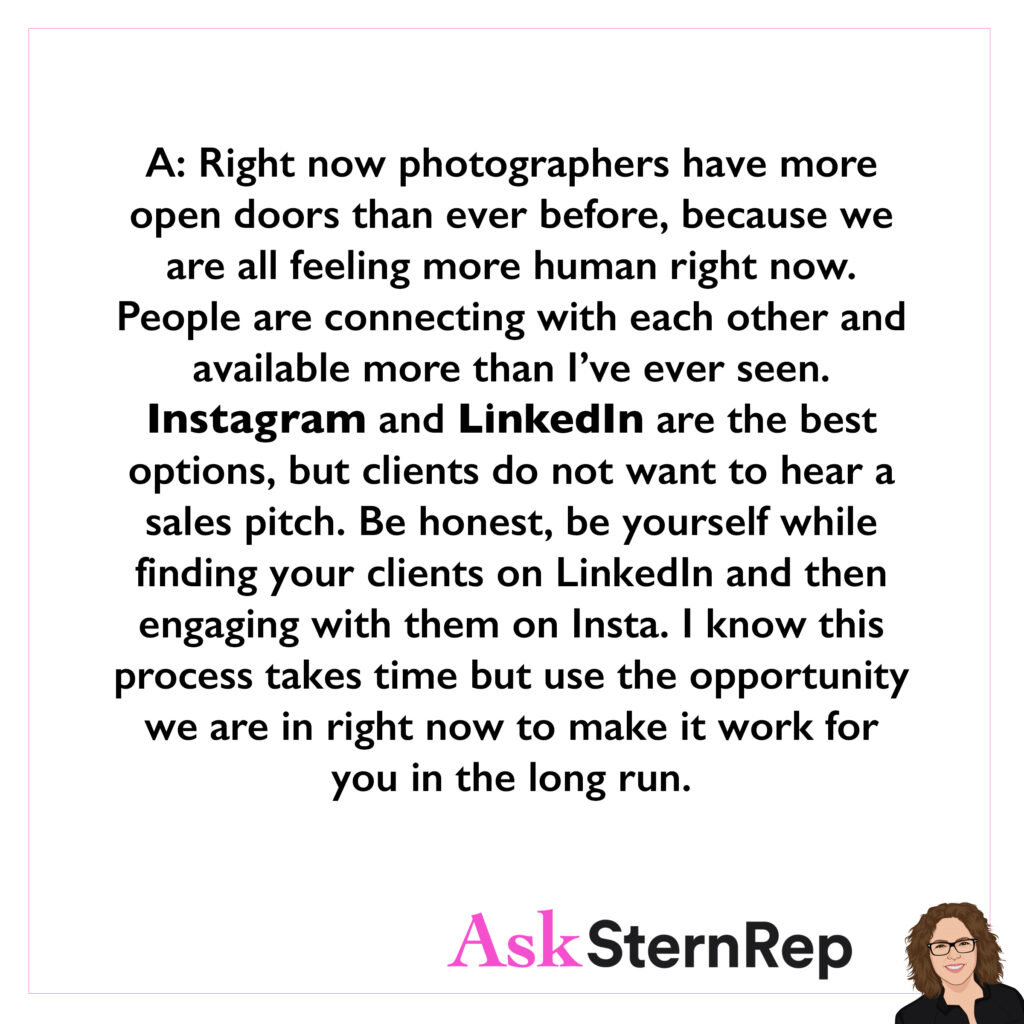
Q:
Is there a good way to contact new clients? I have a home studio.
A:
Right now photographers have more open doors than ever before, because we are all feeling more human right now. People are connected with each other and available more than I’ve ever seen. Instagram and LinkedIn are the best options, but clients do not want to hear a sales pitch. Be honest, be yourself while finding your clients on LinkedIn and then engaging with them on Insta. I know this process takes time but use the opportunity we are in right now to make it work for you in the long run.
Find Inspiration in the Stillness
Normally I have this fire under me to get work. I’m SO happy gardening and with the dogs and how peaceful it is that I’m not trying. It’s so easy to get burnt out. So if I can get work, that’s amazing, but my plan is kind of to find inspiration in the stillness. Then marketing budgets come back and let’s goooooo.
Guest Post: Photographer Jenavieve Belair
I shared a personal response I received today from Jenavieve, whom I represent. I was discussing the importance of doing everything we need to right now and brainstorming ideas. Jenavieve responded honestly about how her stillness is feeding her inspiration. I was so taken aback, not only because she was honest with me but also because she was honest with herself. To me, that’s the whole point: finding ways to inspire your work. If we can all figure out and embrace what truly feeds us, then we’re on the right track. Go, Jenavieve!
Quarantine Safe Workflows


Q:
I’ve thought of three quarantine safe workflows:
- Product delivered, sanitized, and shot at home studio space, natural (limited makeup and wardrobe)
- Editorial at a distance (telephoto heavy)
- Webcam Fashion
Who is looking for these workarounds right now?
A:
Hey any ideas like this can work in today’s situation so I’d say all clients are looking for these types of options. It’s the time to step up and help our clients figure out how to create content. Today = creative problem solving. Right now the only wrong answer I can think of is being too close in proximity, other than that everyone is open to new ideas.
The Next Step in Advertising Production During COVID-19 // Navigating the Unknown Episode 3
Navigating the Unknown Episode 3 is now live on YouTube! This week we speak to Creative Director Nathan Monteith and Director of Production Michael Kaminski about adapting to a new approach in Advertising Production during COVID-19,
Guests:
Nathan Monteith – Creative Director, DDB Chicago
Michael Kaminski – Director of Production, JUICE Pharma
Navigating the Unknown is a Q&A series in collaboration with APA-LA where we speak to different members of the photo community about all aspects of the commercial photography business. https://la.apanational.org/
With Co-Host: Photographer Hugh Kretschmer https://www.hughkretschmer.net/
Website and Portfolio

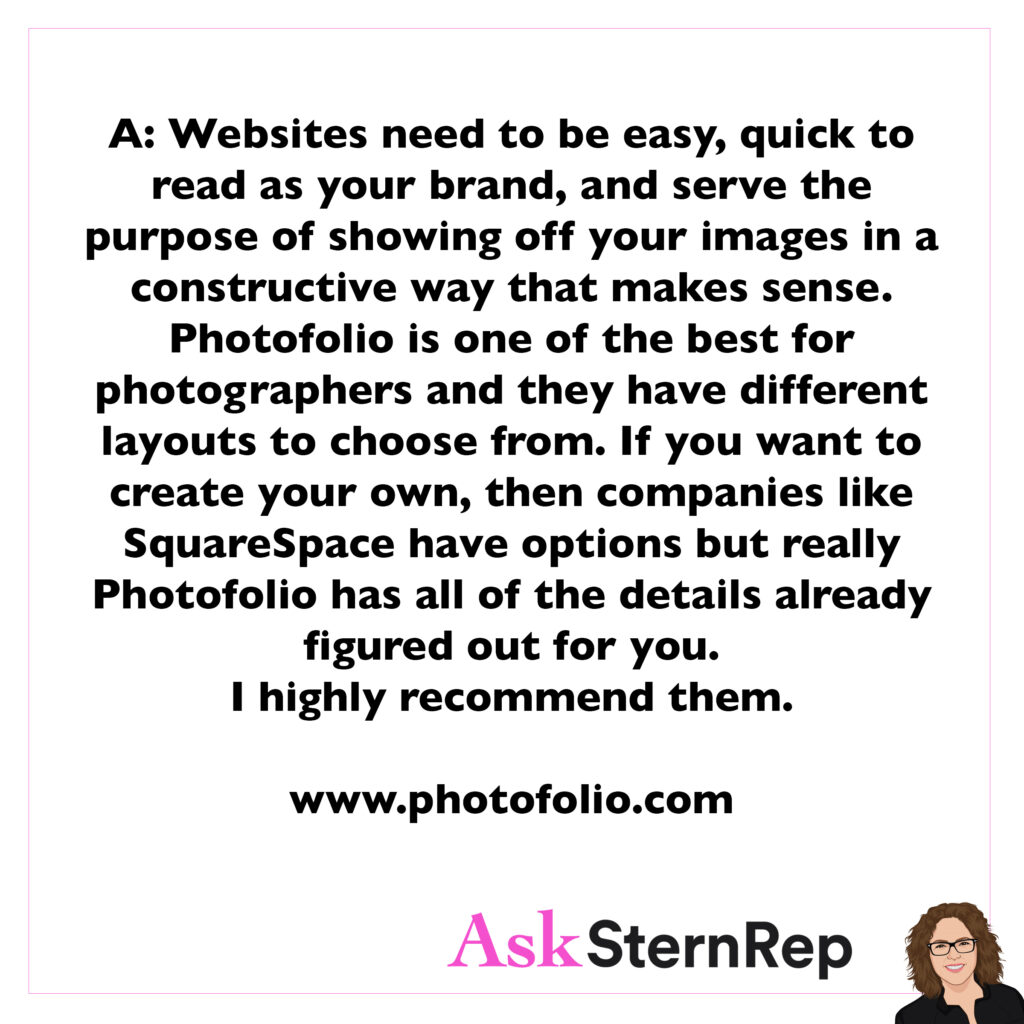
Q:
Like a lot of photographers right now I am in the middle of completely revamping my current website. When it comes to portfolio sites is there a particular format, layout, or design style that I need to gravitate towards to grab the attention of potential clients or on the flip side is there one that I absolutely need to avoid?
A:
Websites need to be easy, quick to read as your brand, and serve the purpose of showing off your images in a constructive way that makes sense. Photofolio is one of the best for photographers and they have different layouts to choose from. If you want to create your own, then companies like SquareSpace have options but really Photofolio has all of the details already figured out for you. I highly recommend them.
Getting Back to Production in COVID-19 // Navigating the Unknown Episode 2
Navigating the Unknown Episode 2 is now live on YouTube! This week we speak to Producer Michael Horta about how to get back into production in COVID-19.
Guest: Producer – Michael Horta of MJ68 Productions http://www.mj68.com/
Navigating the Unknown is a Q&A series in collaboration with APA-LA where we speak to different members of the photo community about all aspects of the commercial photography business. https://la.apanational.org/
What’s your plan right now?
What’s your plan right now?
How are you dealing with this?
Alleviate some of the constant stress we are all feeling right now by having a plan in mind.
Set your intention.
No matter how many zigs and zags it takes to get you where you want to go, you may discover a few things you needed along the way.
I mentioned the importance of having a plan during this significant time in our lives. I discussed this in the webinar series I recently started on Thursdays with APA LA. This time can be incredibly valuable, but it’s also very stressful. Finding ways to incorporate something into our lives that can help shape it and manage stress is crucial.
We’re all listening to these webinars and doing as much as we can, but we also need strategies for self-care and stress management. I plan to balance the personal and professional aspects of my life better. I love working and don’t often stop, so I need to learn to balance it out.
I do this by going camping and reading The Untethered Soul each morning. While camping, I read this book and observe the birds, wondering if they are communicating or singing. It’s these moments that give me the kind of life I want.
So, my question for you is: How are you taking care of yourself right now, and what kind of plan can you put in place to manage the stress of the current situation?
Unrepresented Photographers
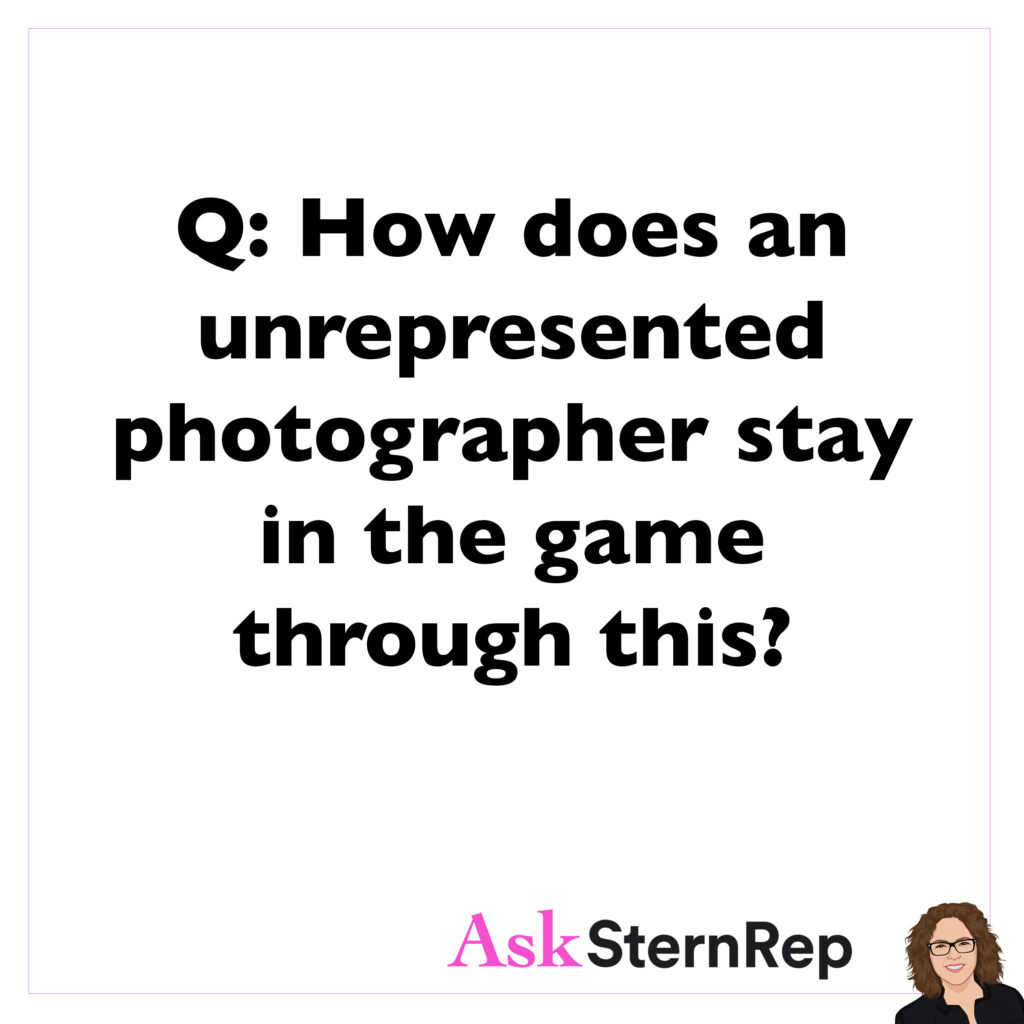
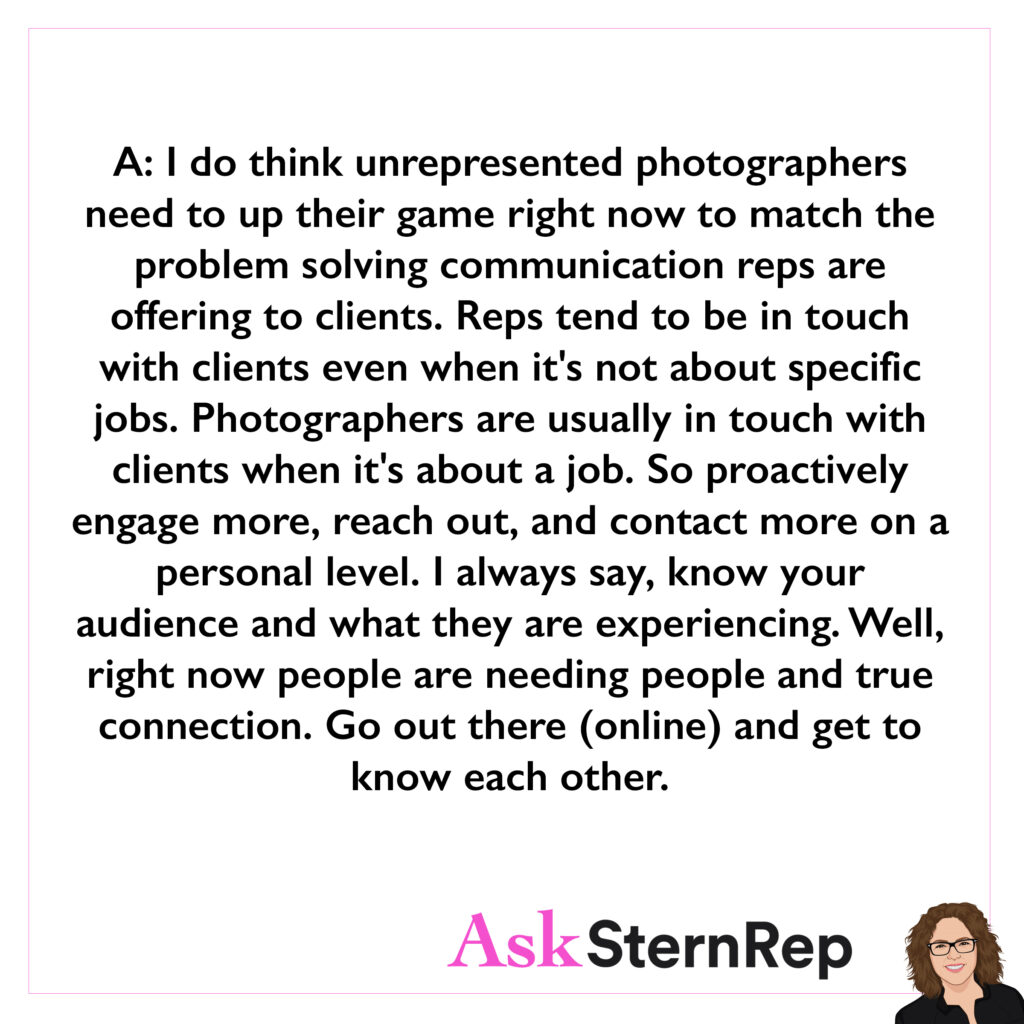
Q:
How does an unrepresented photographer stay in the game through this?
A:
I do think unrepresented photographers need to up their game right now to match the problem solving communication reps are offering to clients. Reps tend to be in touch with clients even when it’s not about specific jobs. Photographers are usually in touch with clients when it’s about a job. So proactively engage more, reach out, and contact more on a personal level. I always say, know your audience and what they are experiencing. Well, right now people are needing people and true connection. Go out there (online) and get to know each other.
Navigating the Unknown Episode 1
Navigating the Unknown Episode 1 is now live on YouTube! This is the first episode in the series and we speak to photographer and APA-LA Board Member Jim Purdum about how the industry is changing during the pandemic.
Guest: Photographer and APA-LA Board Member – Jim Purdum https://www.jimpurdum.com/
Navigating the Unknown is a Q&A series in collaboration with APA-LA where we speak to different members of the photo community about all aspects of the commercial photography business. https://la.apanational.org/
Listen to What You Need
Listen to what you need right now without pressure. That is where your true success will come from.
Another week of this craziness, and here we are—taking it all in and figuring out where we’re going with it. Last week, I posted about the importance of not letting personal issues overwhelm the business. My coping mechanism involves acknowledging when I feel down, taking time to be with those feelings, and then harnessing the motivation when I feel uplifted. This balance helps me manage both my personal and business sides.
Tomorrow, I’ll be doing a webinar with APA LA. Please tune in if you can; it’s a way I’m propelling my business in an organic way.
In my post last week, Maura Sir Dans, a fantastic consultant, made a great point about not feeling pressured to do more right now. Instead, focus on reflection and pausing. If you feel pressured to become more or do more than you’re currently capable of, that pressure might stem from personal issues rather than the needs of your business. Pay attention to what might be uncomfortable but could truly help you move forward.
Standing out in Zoom Meetings
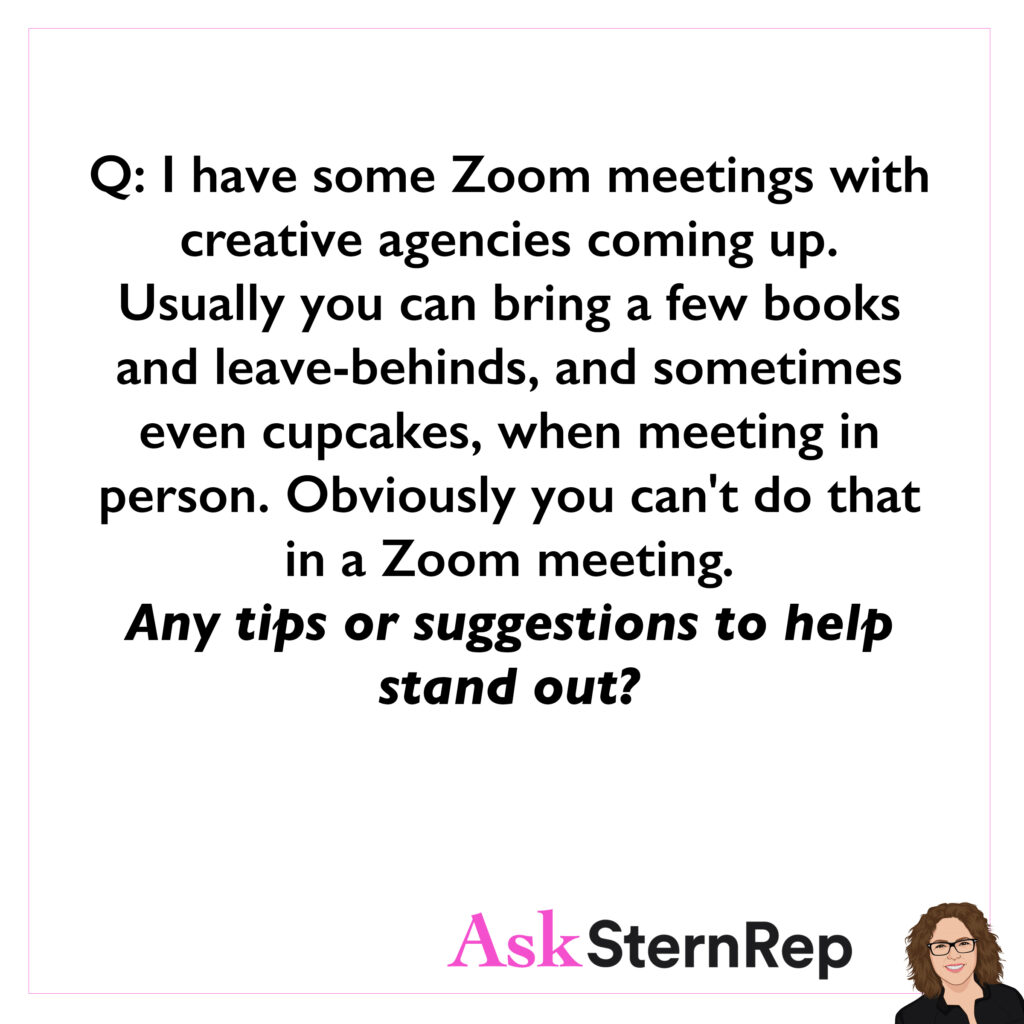
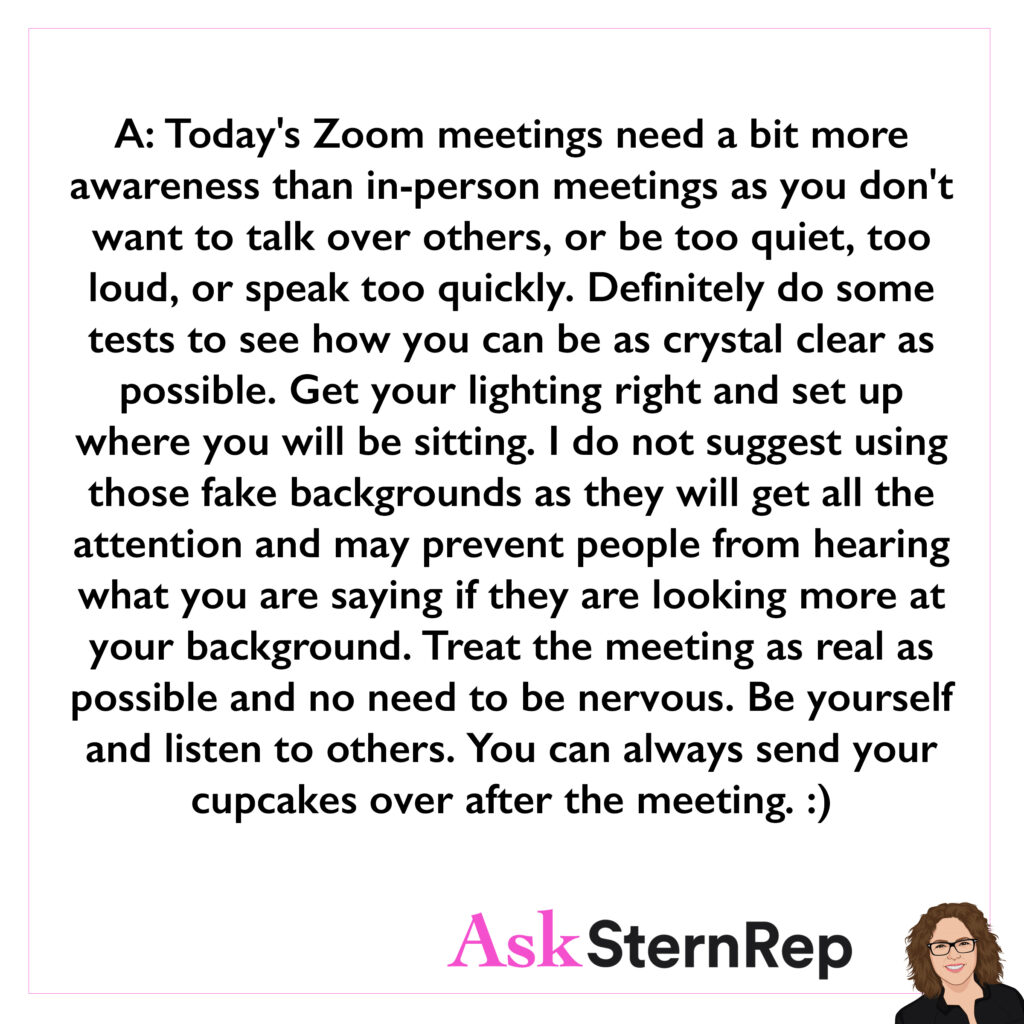
Q:
I have some Zoom meetings with creative agencies coming up. Usually you can bring a few books and leave-behinds, and sometimes even cupcakes, when meeting in person. Obviously you can’t do that in a Zoom meeting.
Any tips or suggestions to help stand out?
A:
Today’s Zoom meetings need a bit more awareness than in-person meetings as you don’t want to talk over others, or be too quiet, too loud, or speak too quickly. Definitely do some tests to see how you can be as crystal clear as possible. Get your lighting right and set up where you will be sitting. I do not suggest using those fake backgrounds as they will get all the attention and may prevent people from hearing what you are saying if they are looking more at your background. Treat the meeting as real as possible and no need to be nervous. Be yourself and listen to others. You can always send your cupcakes over after the meeting, 🙂
More Content for Less

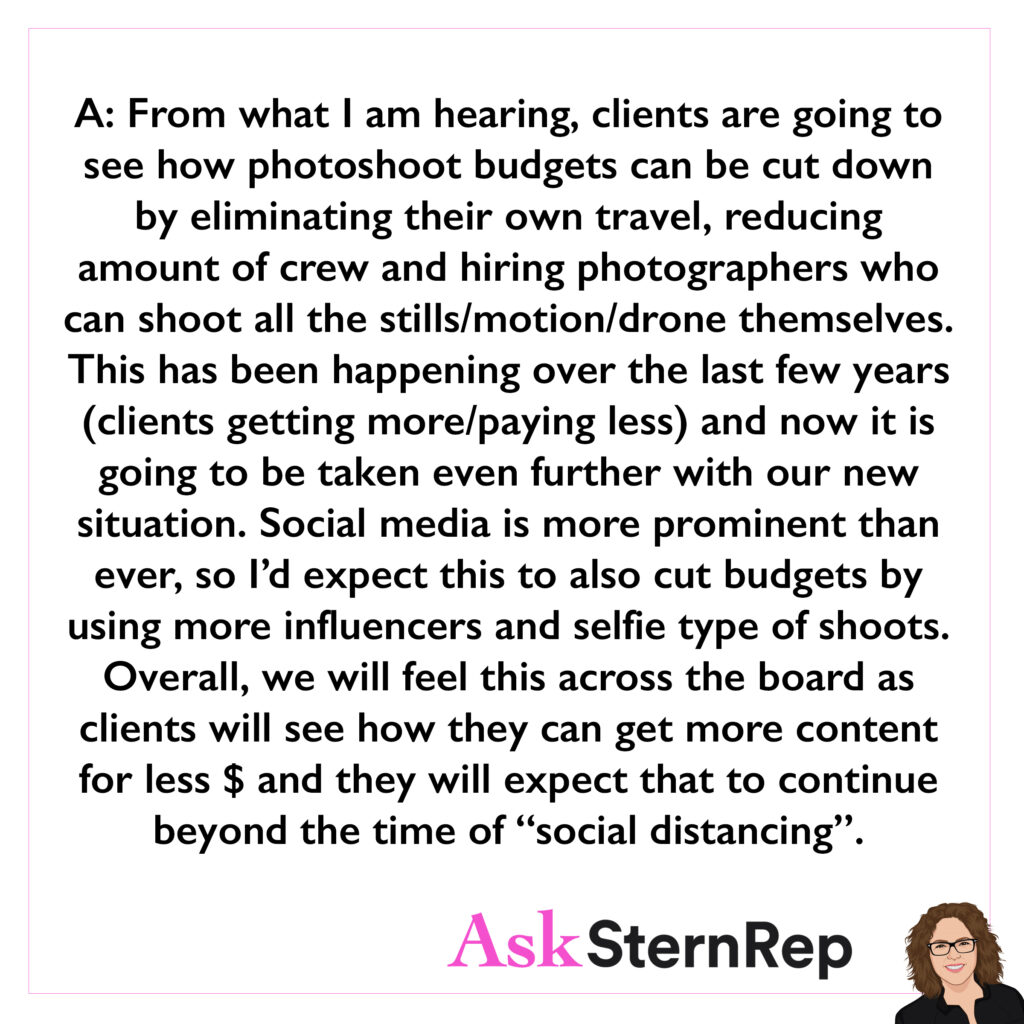
Q:
As there is an expected decrease in volume for corporations, companies are looking to cut the equivalent across the board. I have a feeling they’re going to ask everybody to make this sacrifice, including us photographers. What’s your take on this? If everyone is taking a pay cut, are we expected to as well?
A:
From what I am hearing, clients are going to see how photoshoot budgets can be cut down by eliminating their own travel, reducing the amount of crew and hiring photographers who can shoot all the stills/motion/drone themselves. This has been happening over the last few years (clients getting more/paying less) and now it is going to be taken even further with our new situation. Social media is more prominent than ever, so I’d expect this to also cut budgets by using more influencers and selfie type of shoots. Overall, we will feel this across the board as clients will see how they can get more content for less $ and they will expect that to continue beyond the time of “social distancing.”
Notice the Difference Between the Personal and the Business
As understandable as it is that we are all seriously freaked out right now, we must keep our business hats on and rise to the occasion.
Don’t forget to notice the difference between the personal and the business.
The time is now to distinguish what parts of us are running the show.
There’s a lot of change going on, and it affects our business. We have to be careful not to let personal reactions or stress take over our business mindset. Our business needs to remain separate and focused, without being derailed by personal issues.
We have an opportunity right now to understand and adapt to what clients need because they’re also experiencing changes. For instance, I spoke with a client this morning who noted that their meetings are now virtual via Zoom, which means they need more visual images to showcase their products. Previously, they used to bring their products to meetings. This shift might be something smaller clients need to address depending on the type of work we do.
On the other hand, I talked to a larger client yesterday who is still bidding for jobs as if they will happen in June and July. Each client has a different approach, so we need to stay attuned to what they’re going through. This requires clarity and motivation, and we can’t let current stress diminish our focus.
Remember, our business is always about change—whether we’re freelancers, photographers, or creatives of any kind. It’s about adapting and moving forward. Keep your head in the game, remember your purpose, and continue to do what you do best.
After Covid


Q:
If there is a pent up demand at the end of this, how can we be ready for what comes next?
A:
This one is easy and has been true for the 24 years I’ve been repping photographers – it’s all about your portfolio. Get your branding and portfolio vision clear and on it’s path. Do your research and educate yourself by looking at photographers who you respect. Use this time with the main purpose of finessing where your portfolio needs nips and tucks. Storyboard your upcoming tests now, be ready for when you can get back out there, and know the exact direction in which you will be headed.
Agent/Photographer Relation


Q:
How do you feel the agent/photographer relationship will change?
A:
I felt the agent/photographer relationship shifting a bit in the last couple years where more photographers weren’t requiring representation the way they used to because of all the open public channels of social media. Although right now that seems to be swaying back as I’m hearing from clients who are searching for options from larger groups (reps) to figure out who can even shoot right now. This seems like a real person-to-person time right now, under these conditions the old school relationships are what people are leaning on. It’s hard for me to say how this will affect the future but it’s what I’m noticing right now.
Global Recession
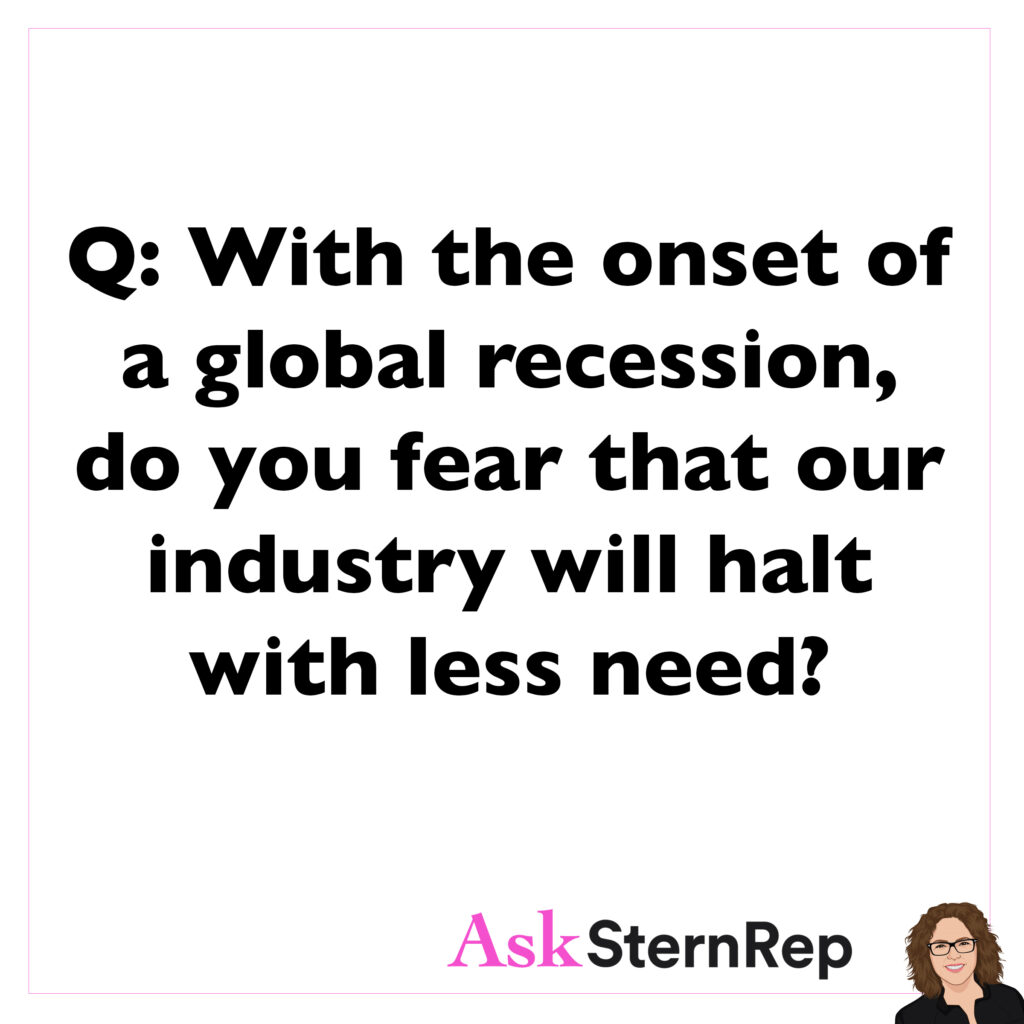
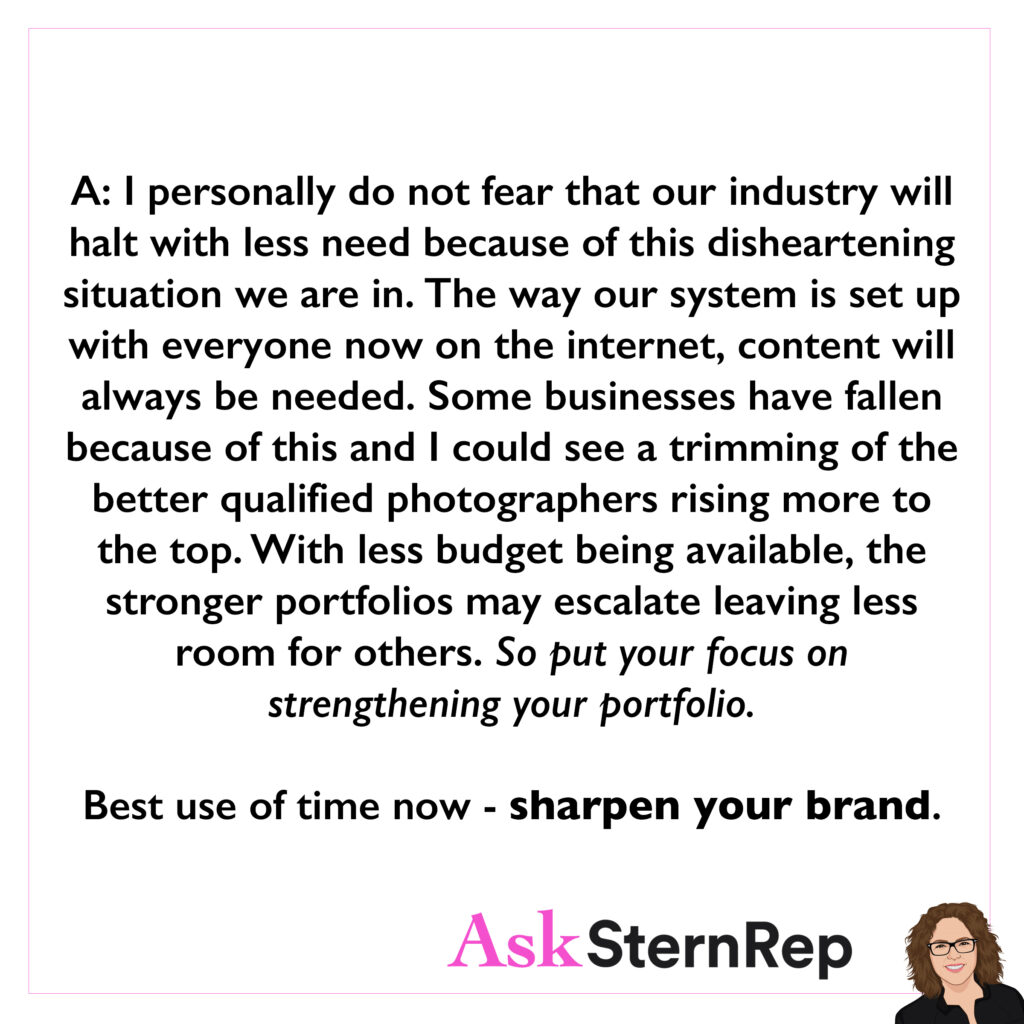
Q:
With the onset of a global recession, do you fear that our industry will halt with less need?
A:
I personally do not fear that our industry will halt with less need because of this disheartening situation we are in. The way our system is set up with everyone now on the internet, content will always be needed. Some businesses have fallen because of this and I could see a trimming of the better qualified photographers rising more to the top. With less budget being available, the stronger portfolios may escalate leaving less room for others. So put your focus on strengthening your portfolio.
Best use of time now – sharpen your brand.
COVID-19
This is a time in our life and careers we will never forget.
If you want to know what to do right now, it is all about you.
This is your time to check-in, to sort through what changes need to happen to become your best. Look at the ideas and interests you did not have the time for. Go with it and take inventory.
Be the creative artist that you are, and plug into your work zone no matter what the condition of our industry is right now.
Ask yourself the questions that will help guide you to whatever ideas or decisions need your attention. Create the head space to listen to your answers.
The time to enhance and propel your business is right now as clients are open to your ideas.
Dive in to your overall plan and Busta Move*.
*implementation of unexpected strategy (80’s slang)
I’m noticing that this period of quietness or downtime is actually a pause in our lives and businesses. However, it’s not a complete standstill. There’s a buzz among photographers who are forward thinkers and are coming to life during this time. This is something I’ve always encouraged as a rep: to bring out the best in my photographers and help them be the biggest they can be.
It makes me happy to see people using this time to discover what they might be missing, what they need more of, and what wasn’t okay in their lives but went unnoticed because of their routines. Everyone is unique, and finding your own way to bring to life what you need for long-term success is crucial. This is the time to do that.
Shooting During Quarantine
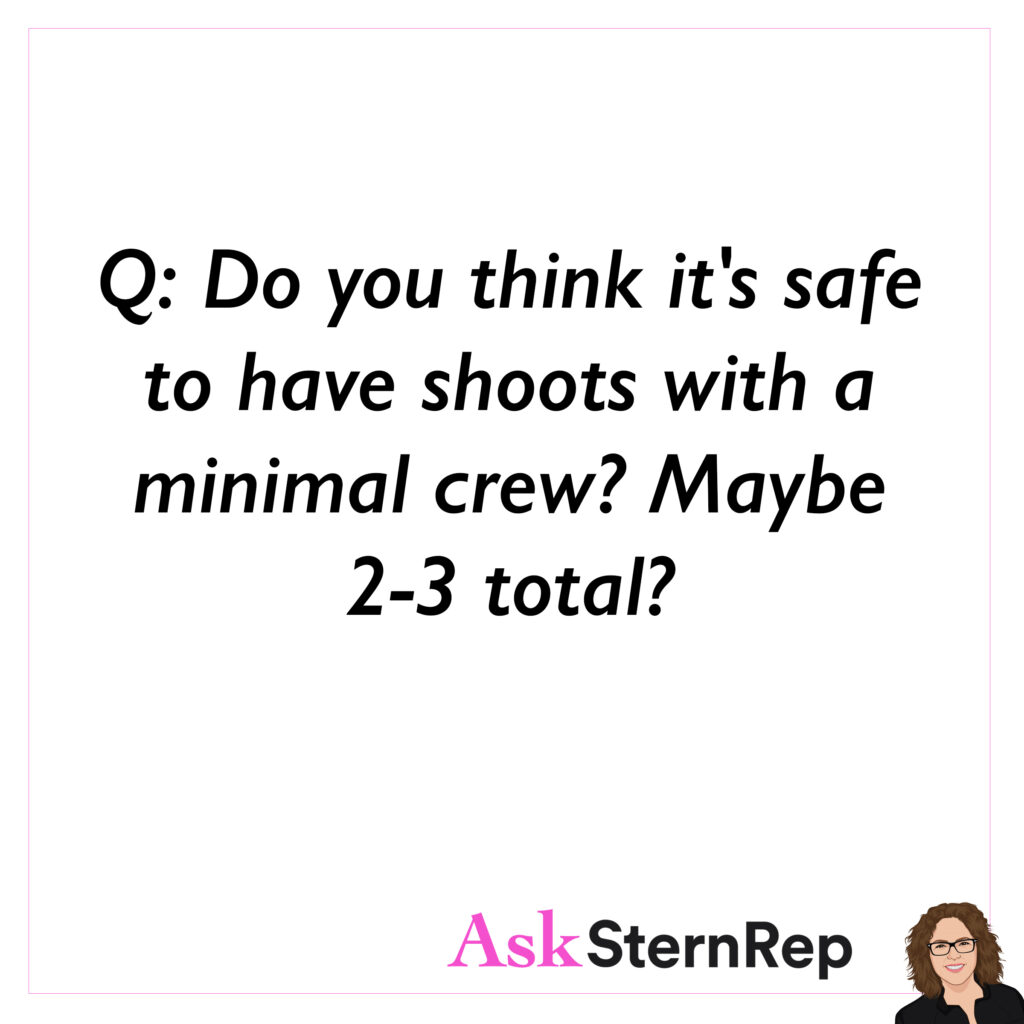

Q:
Do you think it’s safe to have shoots with a minimal crew? Maybe 2-3 total?
A:
I do not think it’s safe to have shoots with anyone outside of your quarantine. I’ll go further with this, and say it risks lives to work closely with anyone you are not quarantined with. I bet clients would be afraid of legal issues if they hired a small crew. I would not touch this with a 10 foot pole right now.
Creating Opportunities

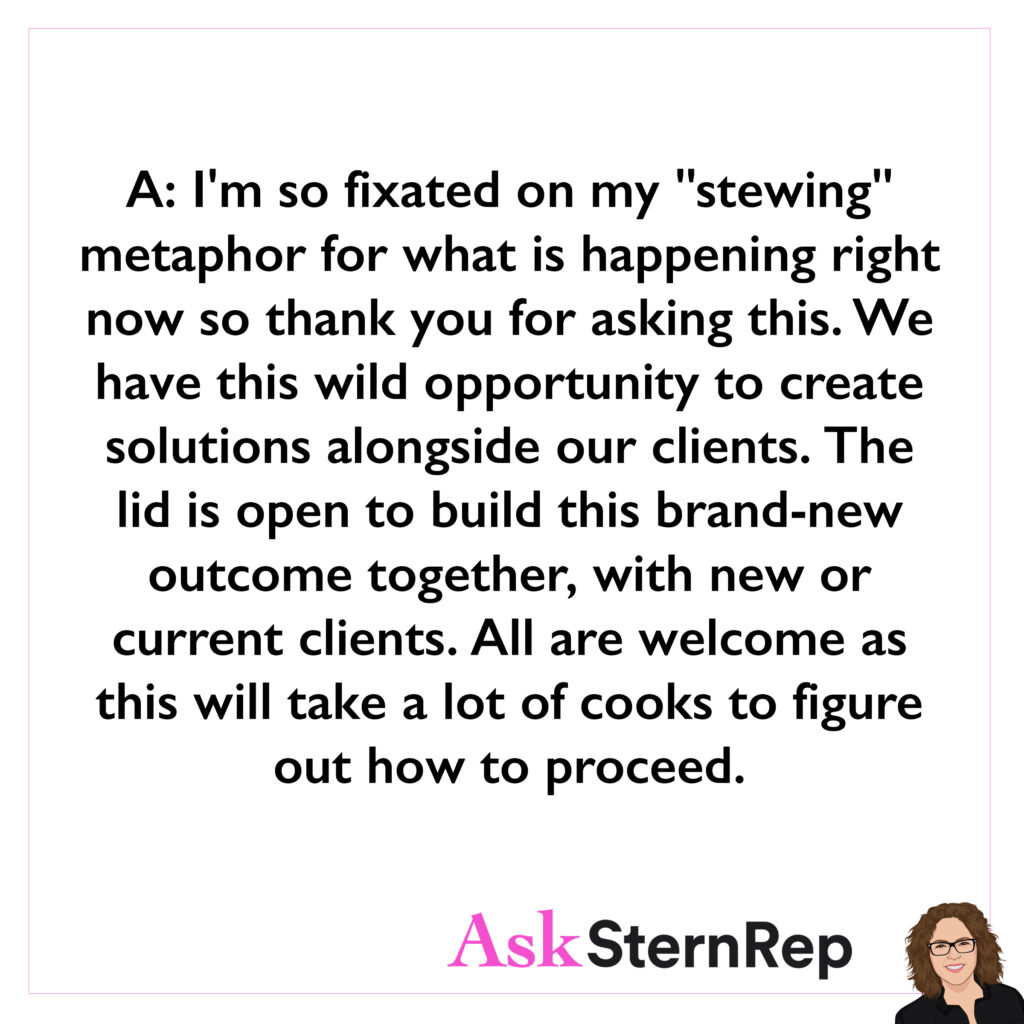
Q:
That “stewing” you’re talking about, is that only with current clients or is there room for new?
A:
I’m so fixated on my “stewing” metaphor for what is happening right now so thank you for asking this. We have this wild opportunity to create solutions alongside our clients. The lid is open to build this brand-new outcome together, with new or current clients. All are welcome as this will take a lot of cooks to figure out how to proceed.
Email Promos


Q:
Are email promos welcome? Must they mention the pandemic or be relevant to it?
A:
Email promos are welcome right now, maybe even more than ever because people are home at their computers. The images don’t have to be relevant but you may waste the release of an image now since it won’t be used soon. Show an image with the goal to draw clients to your website. To not mention the pandemic now would be insensitive and could even be hurtful. The definition of “too salesy” would be to ignore what your audience is experiencing. Good sale is to know your audience and see it through their eyes.
Do Reps Recommend Photographers to Other Reps?
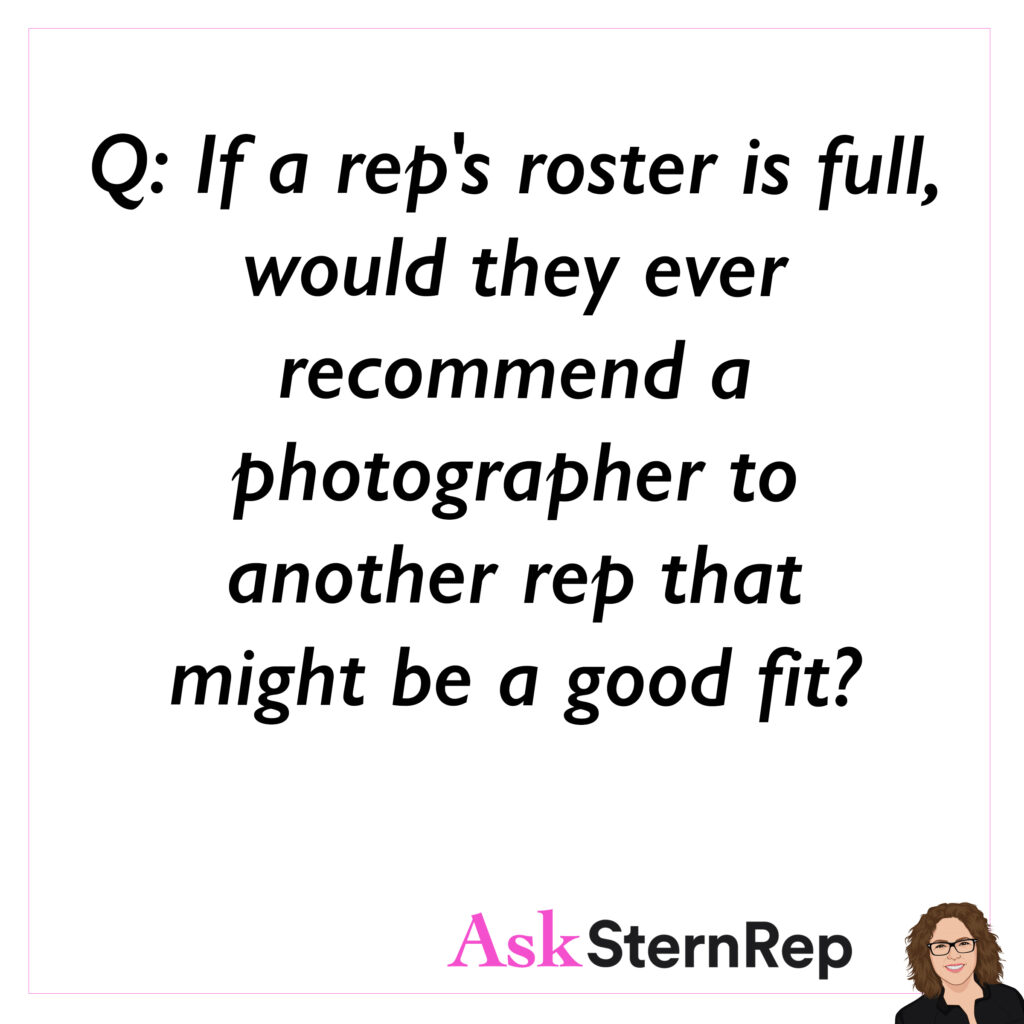
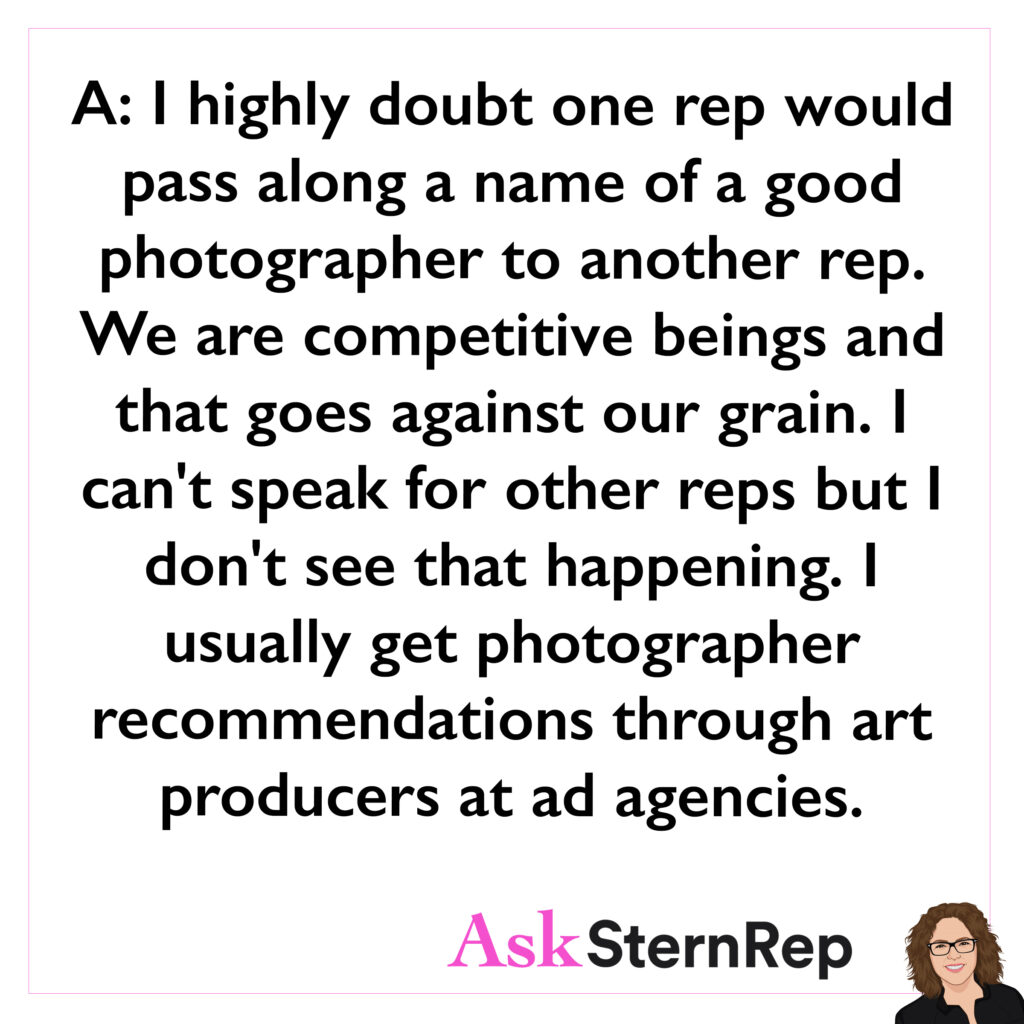
Q:
If a rep’s roster is full, would they ever recommend a photographer to another rep that might be a good fit?
A:
I highly doubt one rep would pass along the name of a good photographer to another rep. We are competitive beings and that goes against our grain. I can’t speak for other reps but I don’t see that happening. I usually get photographer recommendations through art producers at ad agencies.
Don’t Speak
We have better odds that clients will remember our work if we don’t speak as they flip through your portfolio pages.
I noticed early on in my career that when clients are looking at portfolios, it’s important for me not to speak too much. I found that talking while they were viewing the work could be distracting. The whole point of showing portfolios is to let the images speak for themselves, allowing clients to absorb and focus on them. It’s much harder to remember an image visually when you’re being spoken to and have to respond—it’s a lot of multitasking. So, be conscious of this when showing your portfolio: stay quiet and let the images do the work.
Finding Photographers on Instagram
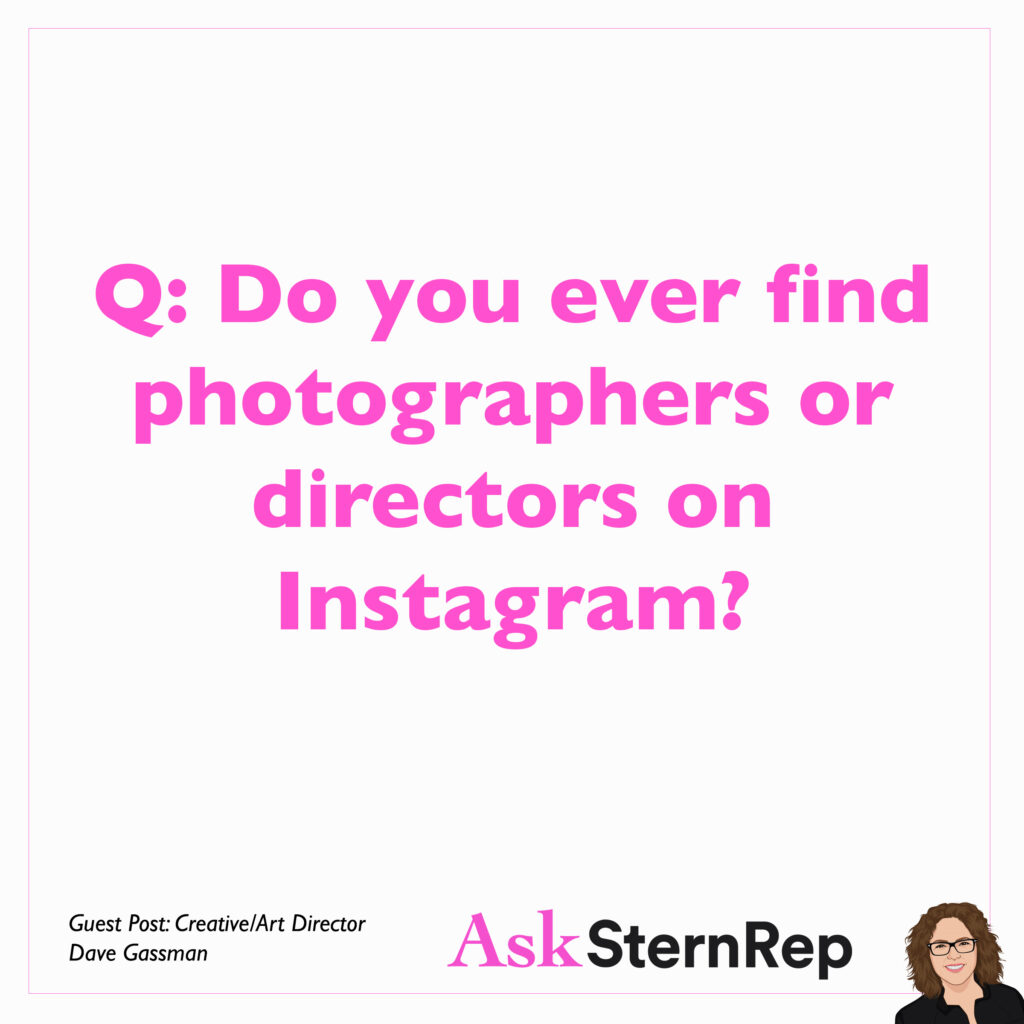

Q:
Do you ever find photographers or directors on Instagram?
A:
Word of mouth tends to be the way I find people. It’s still pretty hard to find a photographer through random searching although there are always exceptions, of course. My advice is to try to get clients’ attention in every way possible, including targeted ads on social media, snail mail and email promos, setting up meetings, etc.
Guest Post: Creative/Art Director
Dave Gassman
The Personal Touch
The Personal Touch by Terrie Williams is one of the books that helped me find my way of connecting to people in a genuine way when I started SternRep.
There are many teachers, books, and methods I’ve used to improve at what I do. As a rep, manager, agent, sometimes bookkeeper, and definitely someone involved in public relations, I’ve learned a lot. That’s why I recommend this book, but the truth is, there’s so much to our jobs—it’s overwhelming. This is especially true for photographers. You need to stay sharp and be knowledgeable about the best quality, software, hardware, and equipment. Keep up with your learning sources and stay on top of new developments in your field.
How to Use an Advance

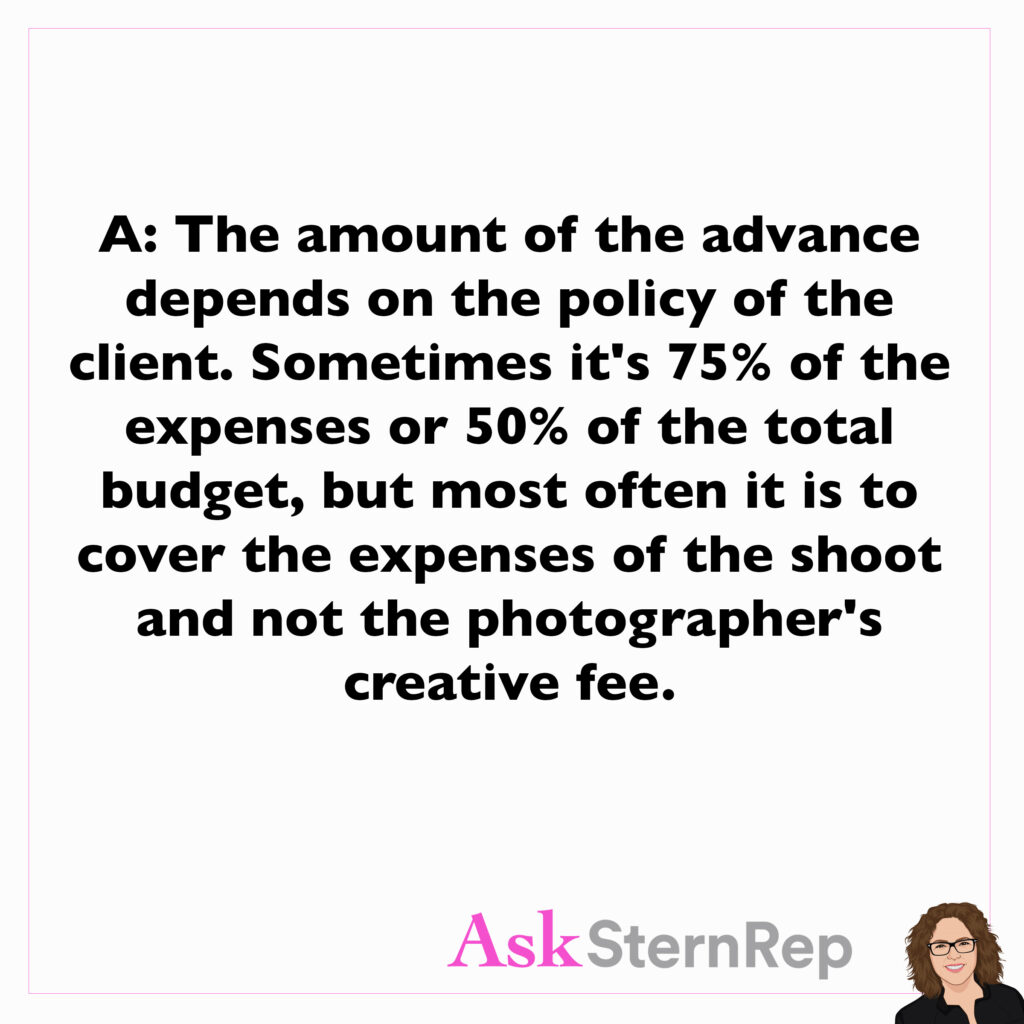
Q:
Is an advance to cover hard costs for production or do you pay the photographer 50% of the fee in advance of the shoot?
A:
The amount of the advance depends on the policy of the client. Sometimes it’s 75% of the expenses or 50% of the total budget, but most often it is to cover the expenses of the shoot and not the photographer’s creative fee.
Optional Usage Prices
When you begin pricing out the requested optional usage prices on your estimate, pad them with the expectation that the client will respond by minimizing with less usage options and you will have to present cheaper rates.
Often on jobs, estimates, or bids, we’re asked about renewal or reuse terms. They might inquire about rates for one year, two years, or additional uses like print advertising. They may also ask about extending usage beyond the initial period—such as for an extra year or five years.
You should be prepared to include some flexibility in your pricing. Quote a bit higher than what you expect they’ll accept, knowing they might come back and request adjustments, such as a shorter term or reduced scope. This way, you’ll have room to negotiate and adjust the prices as needed.
Does that make sense? The idea is to leave some room in your bid so you can accommodate their requests for reductions and still meet their needs.
Request an Advance
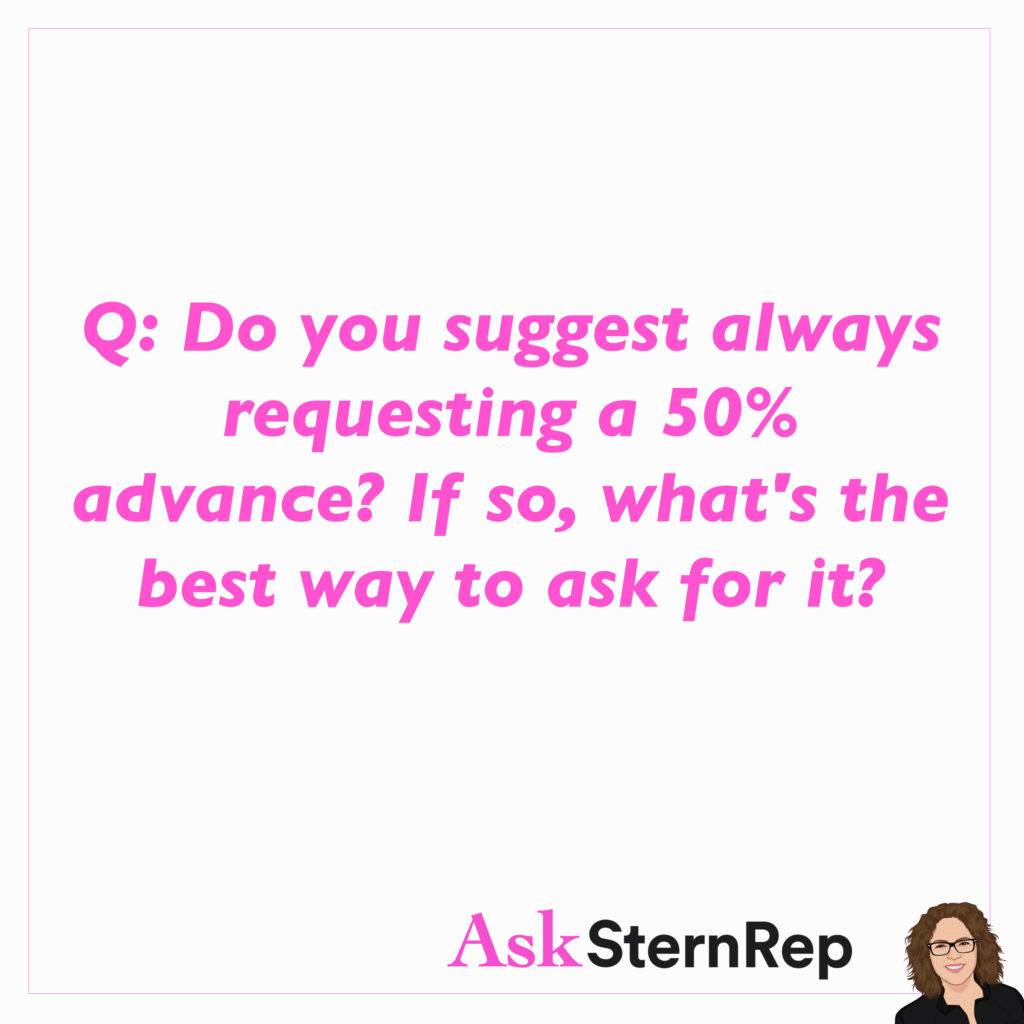

Q:
Do you suggest always requesting a 50% advance? If so, what’s the best way to ask for it?
A:
Yes. Always put a request for the advance on your estimate, so you have it in writing that they’ve agreed to those terms once the estimate is approved. I use simple language such as “50% of total due prior to beginning of shoot.” If they ask for a different amount that is fine with me. I just need to be legally guaranteed my photographers will be paid. I’d be scared to work without that reassurance.
Email Tip
You look like an amateur if you don’t have an official website email + a signature at the bottom with your website link on it.
Look, there are many photographers out there, and we’re competing with a large number of people contacting our clients. We need to reassure them that we are an established business. In the past, we used to rely on stationery with our business address and information. Now, photographers primarily use Instagram and their website. Therefore, your email signature should convey that you are real, professional, and reliable. It should demonstrate that you know what you’re doing and that clients will be in good hands with you.
Bidding for a Job When Your Portfolio Doesn’t Reflect the Same Category of Work
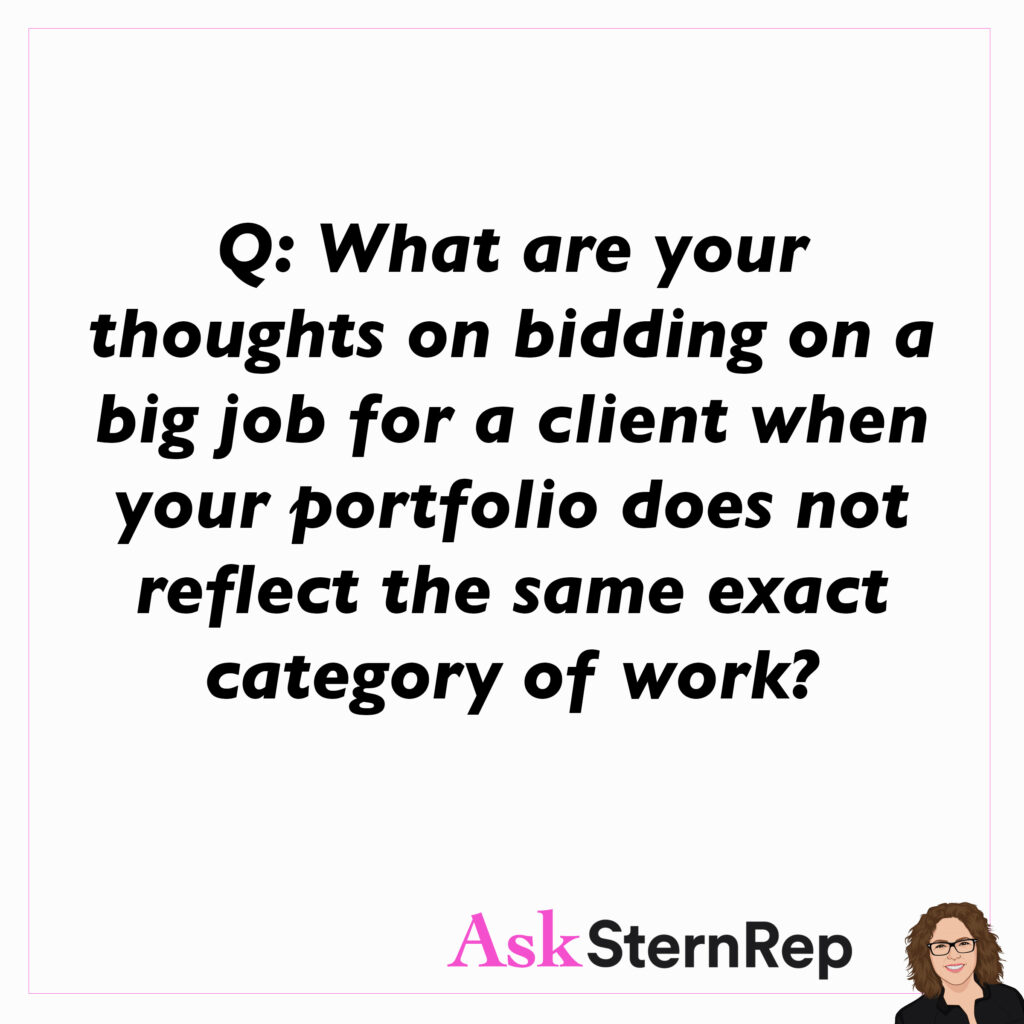
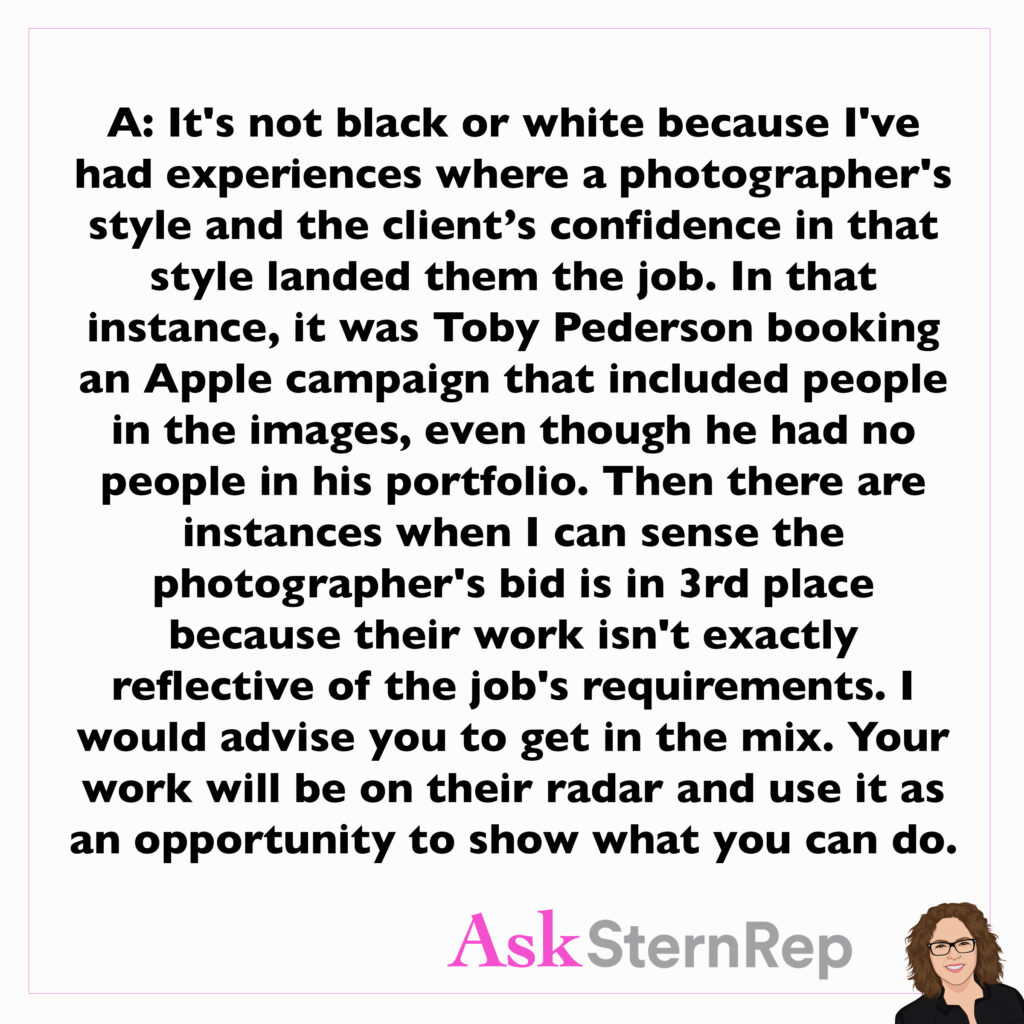
Q:
What are your thoughts on bidding on a big job for a client when your portfolio does not reflect the same exact category of work?
A:
It’s not black or white because I’ve had experiences where a photographer’s style and the client’s confidence in that style landed them the job. In that instance, it was Toby Pederson booking an Apple campaign that included people in the images, even though he had no people in his portfolio. Then there are instances when I can sense the photographer’s bid is in 3rd place because their work isn’t exactly reflective of the job’s requirements. I would advise you to get in the mix. Your work will be on their radar and use it as an opportunity to show what you can do.
It Is Our Responsibility to Set the Boundaries
Make sure everything about your estimate and your production considers what you are covering and what you are not covering. It is our responsibility to set these boundaries, not the client’s.
When you’re on set and they want more content, how do you handle that?
The best way to handle it is to prepare for it on your estimate. You should have a blanket statement in your emails and your estimate that says, “ This bid is based on the information we have so far and any changes may incur new costs or overages.” Make sure every topic that is even generally touched on is included in the bid.
Let’s say you didn’t have it in your bid, you would talk to your rep. But if you don’t have a rep, you explain the situation to them. “You didn’t mention that, so I didn’t include that in the bid. Did you want a price for that?” I like to turn things into questions so if they request something that you don’t have you would ask them if they would like that included and, “I can get you a price for that.”
Getting the Attention of Potential Reps
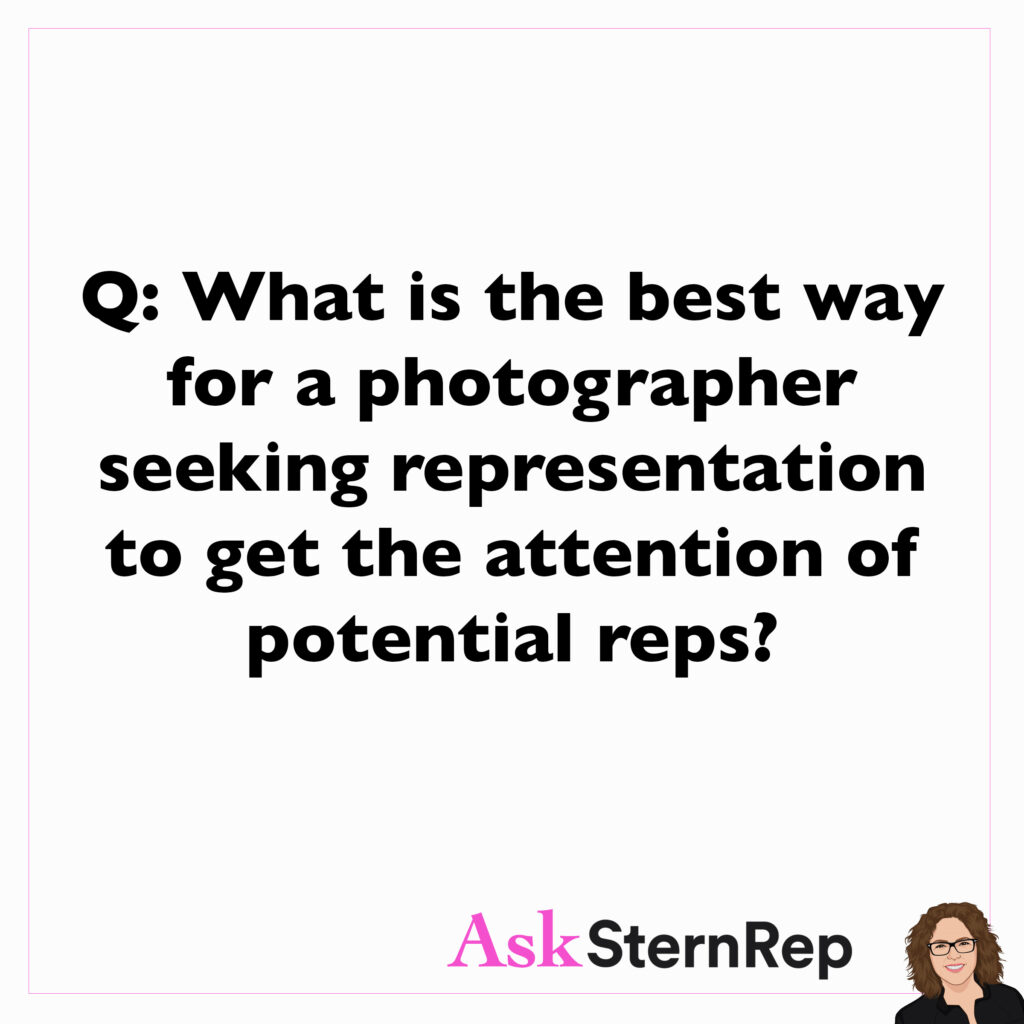
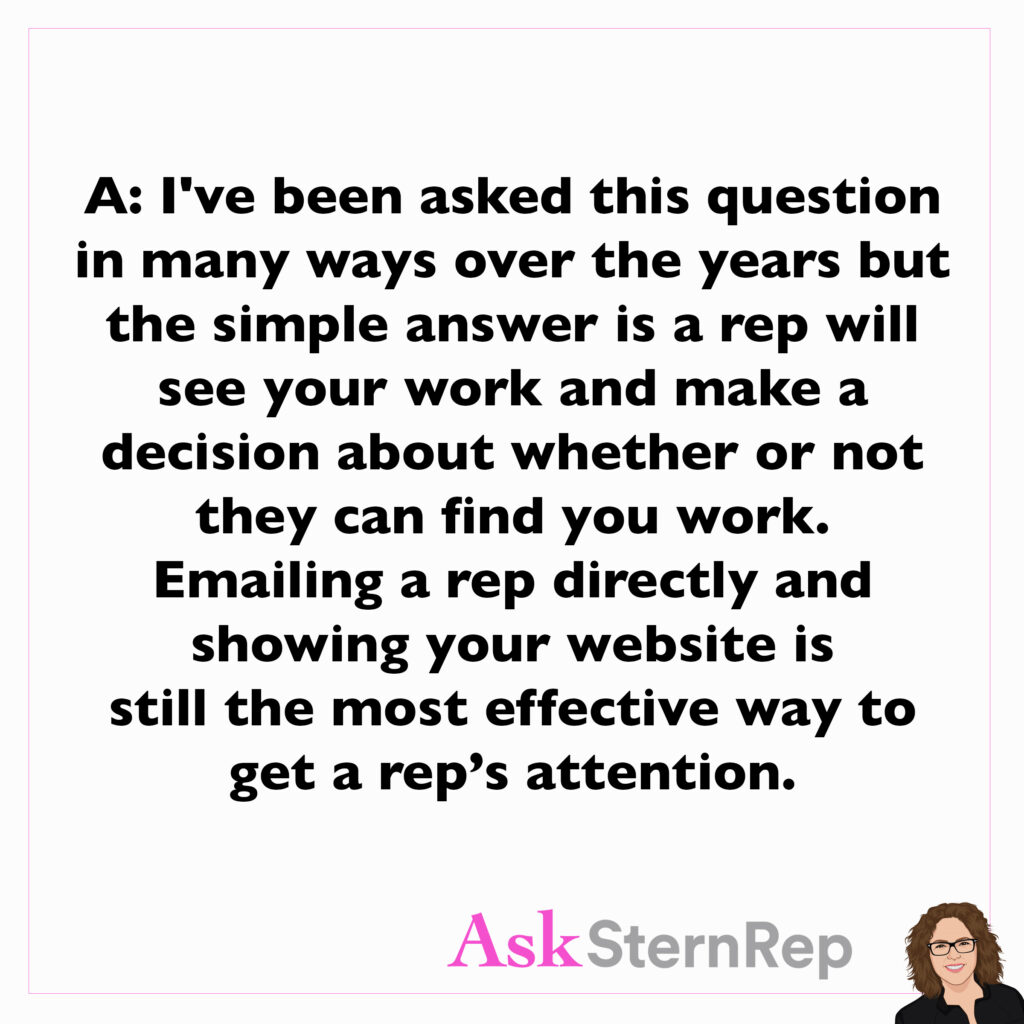
Q:
What is the best way for a photographer seeking representation to get the attention of potential reps?
A:
I’ve been asked this question in many ways over the years but the simple answer is a rep will see your work and make a decision about whether or not they can find you work. Emailing a rep directly and showing your website is still the most effective way to get a rep’s attention.
Mural Walls Are Our Responsibility
Recognizable mural walls are our responsibility to be legally released + paid for before handing over the images to the client. If not, we are putting our clients in danger of significant legal issues.
Before the job begins there’s so many production details that must be your responsibility to get cleared. The location permits, the location fee, and talent releases. Just like your usage is an artist being paid for what you do, the same goes for mural artistry. If we hand over images to our clients and they use it and we did not get that covered, signed off, paid for by the mural artist, we put them at risk of having to deal with a lot of legal problems, and it won’t look good on you. Find out who the mural artists are. I guess a good question is how do we find out who the mural artist is. Usually it will have their name and maybe instagram. It’s our responsibility to find it.
Getting More Work


Q:
How would you advise a photographer about how to get more work?
A:
Focus specifically on the client/industry with which you most want to be working and shape your portfolio around that market. Start with one area and master it. Then you can expand and grow…
Inside View: Where is the Industry Headed?
ASR: How do you see the business changing right now and where do you see it going?
Anonymous NY Art Producer: Budgets are getting smaller, and clients are becoming more savvy with building campaign landscapes. They don’t want just stills, they want content. In addition to static assets that will live in print and OOH, they’re also interested in GIFs and short form content. It’s truly the middle ground between static and broadcast production, everyone across disciplines needs to consider shooting for vertical. Clients are no longer wanting traditional assets like a commercial spot and campaign stills – they want everything.
ASR: How are photographers handling this differently now to make this happen successfully?
Anonymous NY Art Producer: Good question! I would say this is where a photographer has the leg up edge-wise. Tackling this successfully requires a smaller footprint than what’s been done before to solve creative ask. Since photographers have normally worked with a fraction of a traditional broadcast budget, they’re already accustomed to creating with smaller crews and resources. Don’t think shooting motion equates to taking on the same resources as a broadcast production; be tactical, nimble, and resourceful. There are young emerging artists who have proven to achieve more with less, that’s the way of modern production now, and that’s what’s driving client expectations.
One Question Mark Per Email
Only have one question mark in your email if you need it to be answered quickly.
I’ve found that if I ask two questions in an email, typically only one will get answered. However, if I list out multiple questions, then each one tends to get answered. It seems to be a pattern, though it might be worth studying scientifically. For now, this is what I’ve observed: using bullet points or dashes to list out questions works better. Otherwise, if you include questions in a paragraph format, the second question often gets overlooked.
Portfolio Design

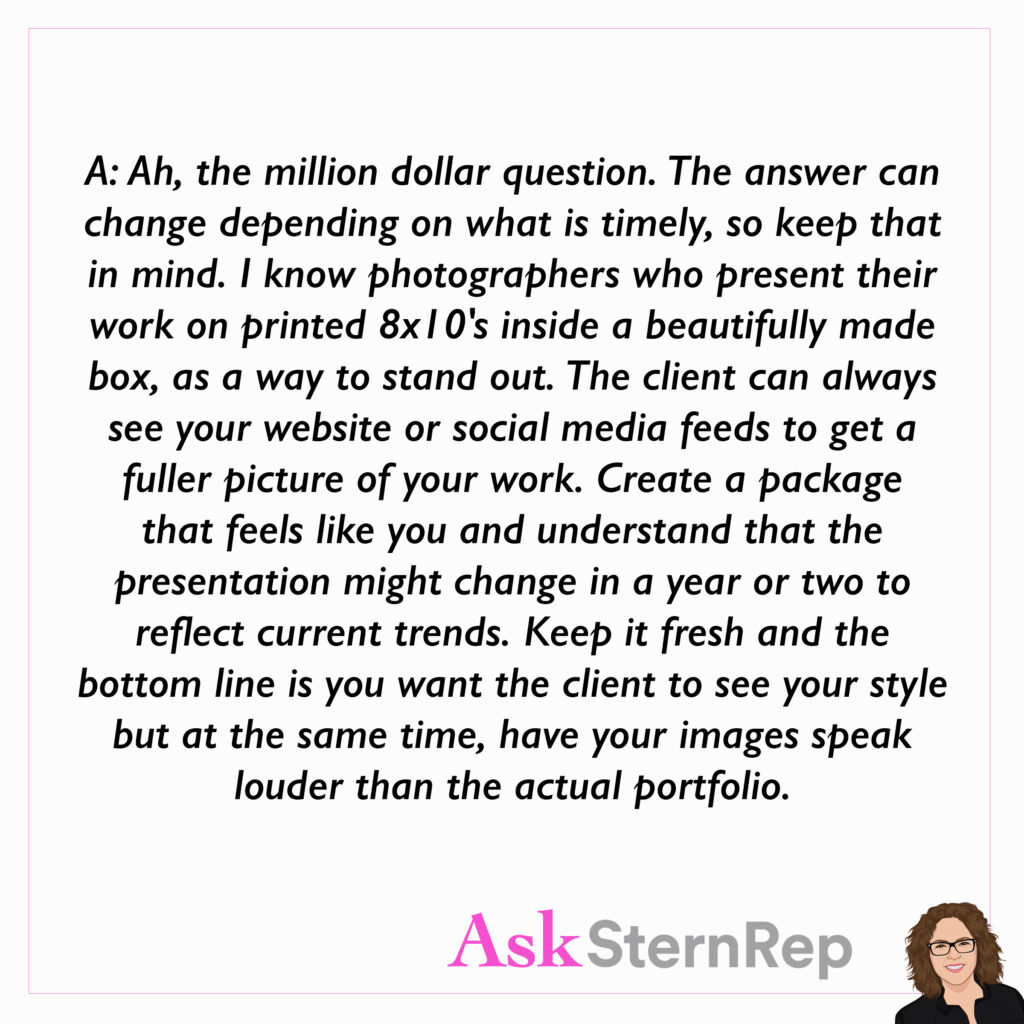
Q:
I’m finalizing my portfolio and wondering if I should have separate books for different categories, or one larger book with more variety? I mainly shoot portraits and fitness. There are many through lines to my work but also some vast differences.
A:
Ah, the million dollar question. The answer can change depending on what is timely, so keep that in mind. I know photographers who present their work on printed 8x10s inside a beautifully made box, as a way to stand out. The client can always see your website or social media feeds to get a fuller picture of your work. Create a package that feels like you and understand that the presentation might change in a year or two to reflect current trends. Keep it fresh and the bottom line is you want the client to see your style but at the same time, have your images speak louder than the actual portfolio.
Definition of “Photographer”
DEFINITION of
“pho-tog-ra-pher”
/fəˈtɒɡrəfə/
ACCORDING TO ASKSTERNREP:
An artist who is bravely inspired to experiment imagery by virtue of what he/she/they do not yet know.
There’s some confusion about our jobs as creatives. I’m representing creatives and you are creatives. It’s a business but you are also an artist. What does that mean, other than trying new things that you don’t already know? There is this balance of business and artistry that you have to incorporate more into your business if you want to keep going. You are the ones being hired to be an artist on the set. That’s why they’re hiring you. They want to know you’re going to bring new ideas to the shoot. Are there ideas and ways that you aren’t yet getting the artist out of yourself into your career? How can you be more of an artist?
Instagram as a Marketing Tool
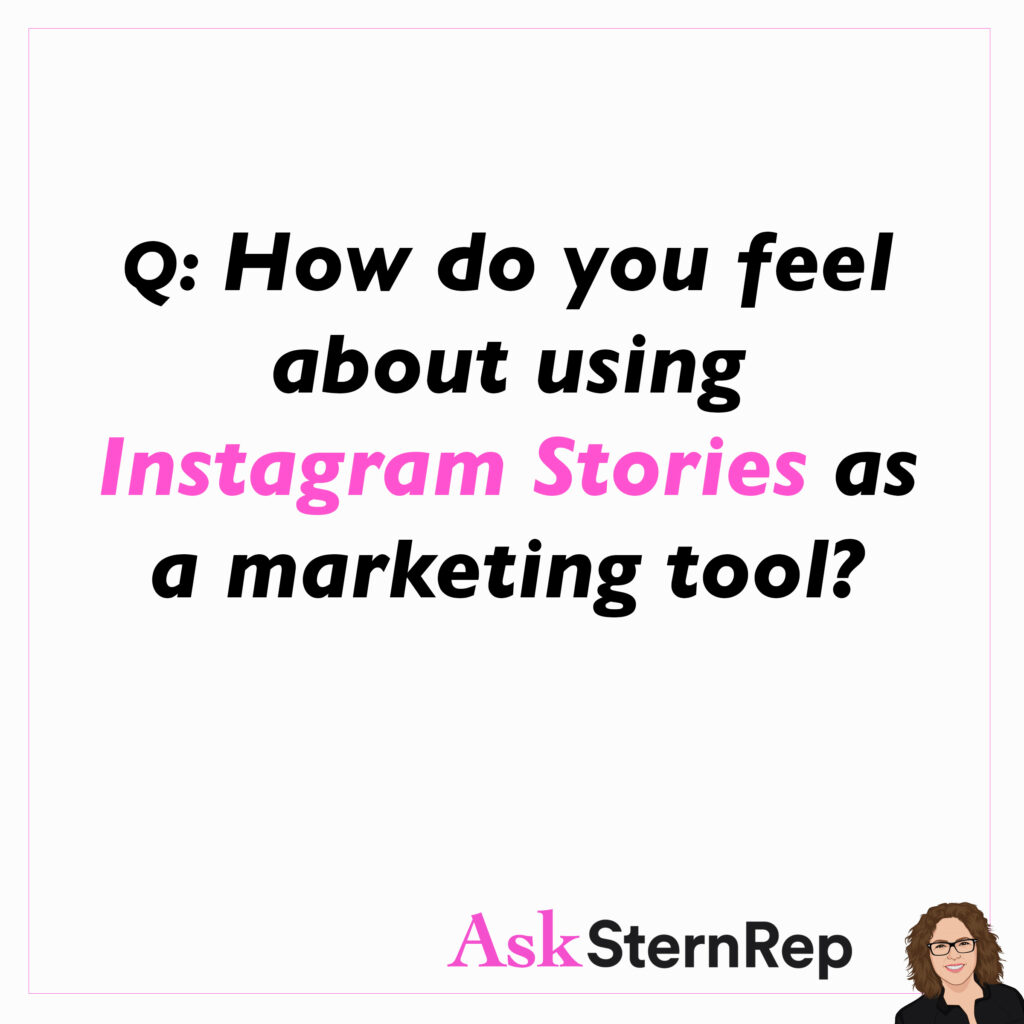
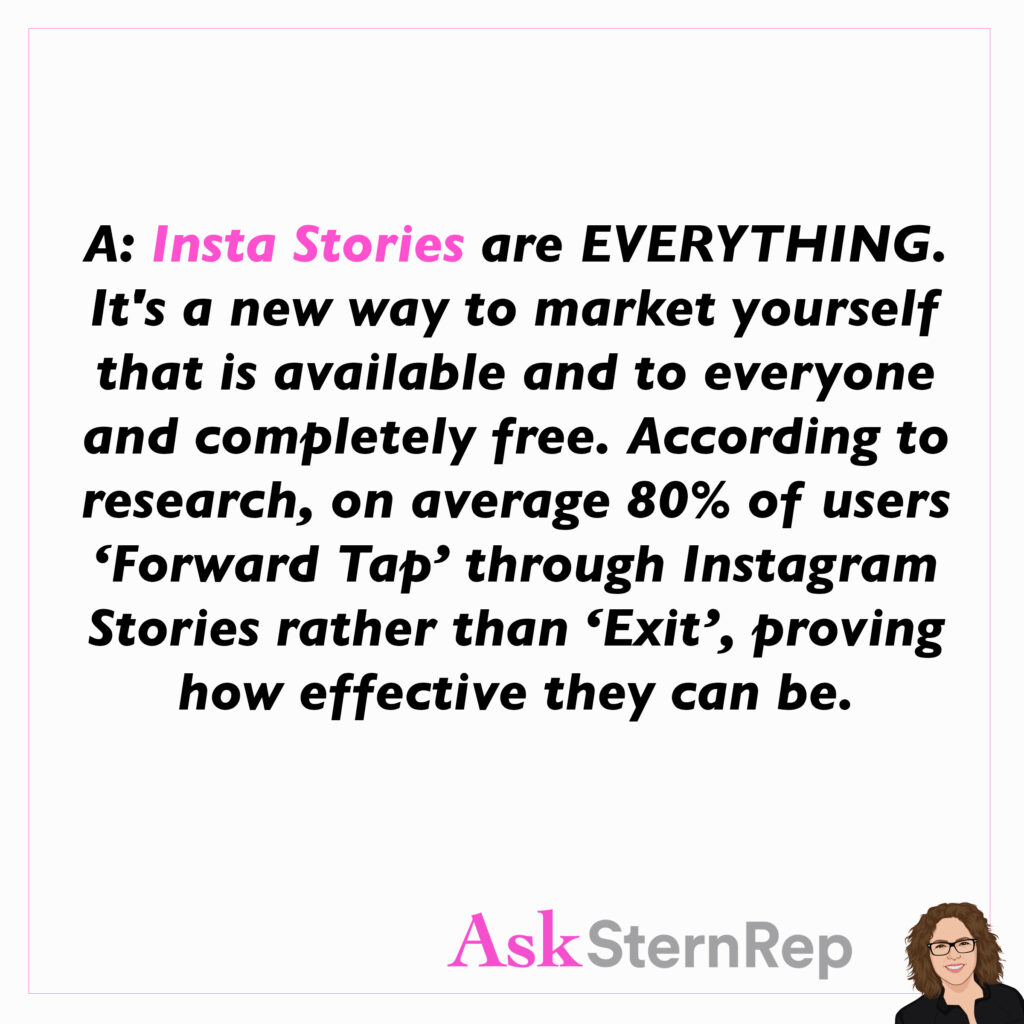
Q:
How do you feel about using Instagram Stories as a marketing tool?
A:
Insta Stores are EVERYTHING. It’s a new way to market yourself that is available to everyone and completely free. According to research, on average 80% of users ‘Forward Tap’ through Instagram Stories rather than ‘Exit,’ proving how effective they can be.
Cultivate, Develop, Flourish.
Cultivate, develop, flourish.
Show clients how your maturity will work for them, and not against them. Keep up with the times.
Established photographers have that challenge because a lot of their work might look like yesterday. We have to keep it fresh and innovative. Photographers are hired by clients to be the innovative thinkers that you are, that inspired you to get into this business. The look of yesterday is not what they want. They want tomorrow’s look. I’d love to know how photographers out there, after you’ve been doing this awhile, keep going beyond the trend of today, and inspire yourself to try new things and show clients that’s who you’re going to be. How do you do that? I’d love to hear.
Naming Your Business

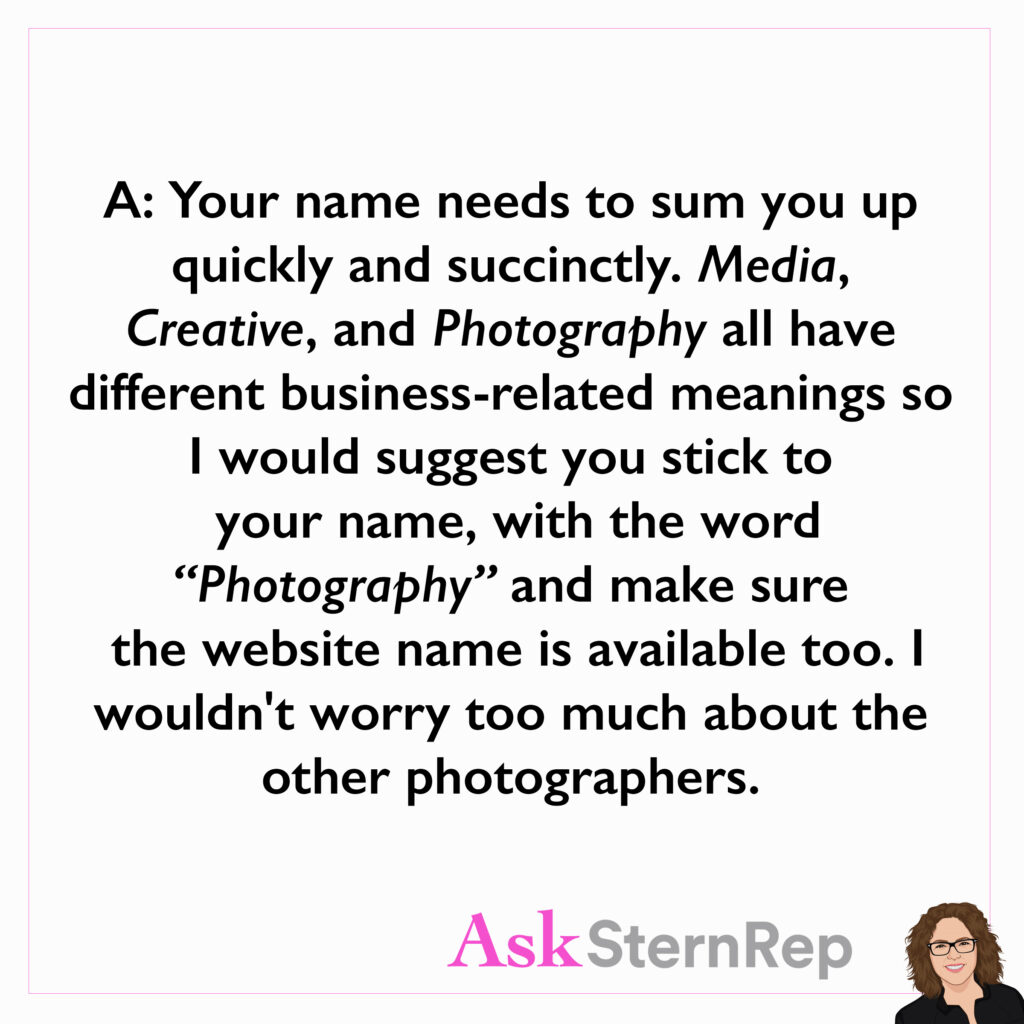
Q:
I need advice on naming my business. Is it an important part of marketing? I’d prefer to use my one name and add the word Media, Photography, or Creative after it, but my name is common and there are some sub-par photographers with my name out there right now. Thoughts?
A:
Your name needs to sum you up quickly and succinctly. Media, Creative and Photography all have different business-related meanings so I would suggest you stick to your name, with the word “Photography” and make sure the website name is available too. I wouldn’t worry too much about the other photographers.
$25k a Day
I had a client who wanted to be on the pulse of someone new. We paid that someone–who had never shot an ad campaign–$25K a day.
-Guest Post: Anonymous Art Producer
There are definitely many changes in our industry. One significant change is that someone who isn’t yet well-known now has the opportunity to get their images seen, thanks to social media—something we didn’t have before. Another change is that budgets are generally decreasing, but that’s not always the case. You can still get paid well, so sometimes it’s important to be a bit more creative and make the most of the opportunities available. That’s what we need to focus on.
Instagram Profiles


Q:
Should you create two instagram profiles? One for portraits and the other for products? Or combine both into one profile?
A:
If you have two separate businesses and websites this would make sense. But assuming you don’t, the best way to sell yourself is to have one strong cohesive style that is evident in everything you shoot. Two separate profiles will lower the quality of your work and create the appearance of two separate brands.
Repeat After Me…

Repeat after me…
For 2020 I own all the bells + whistles that I can bring to my career as a creative person. I will explore beyond what I already know, learn new things, and be open to a new level of greatness.
Best Sourcebooks and Websites to Spend Marketing Money


Q:
What are the best sourcebooks and websites for a photographer to spend their marketing dollars?
A:
Shooting tests is where you should spend your marketing budget, as that is the most direct path to getting jobs. Once your portfolio is where you want it to be, I would suggest the following US options in the commercial advertising world:
At-Edge, Found, Blvd, Wonderful Machine, Production Paradise, Workbook, Drip, LeBook, (new) Komyoon, Altpick, Lurzer Archive, PhotoServe, and Creative Hotlist.
Adding People to Your Mailing List


Q:
I love how you’re providing answers and guidance to photographers like myself! Is it ok to add people to your mailing list without asking or should you only contact people who have given you their email address directly?
A:
People can always unsubscribe to your mailing list, so make sure there’s an option to do that. Just make sure the work is applicable to the people you’re including. I find Agency Access and Yodelist to be very helpful in matching your area of specialty with the right clients.
Sometimes It’s Best Not to Show Your New Work
Sometimes it’s best not to show your new work. I know we always want to show new new new work these days of heavy flowing content, but be careful as some work is not consistent, or not appropriate.
Our instinct is always to show new work and stay updated with fresh content. However, sometimes it’s best not to show certain work, whether it’s because it differs from your portfolio or it touches on sensitive topics like current news or political issues. Be cautious about what you publicly post or display on your website—avoid sharing anything that might be inappropriate given current events.
When I say ‘don’t show it,’ I specifically mean avoiding public posts or website updates. However, if you’re applying for a specific job and have written a treatment or need to send additional images, you can include those in a PDF tailored for that particular person or project, especially if the lighting, style, or technique matches their needs. In such cases, they might be more forgiving.
Bigger Jobs and Reps

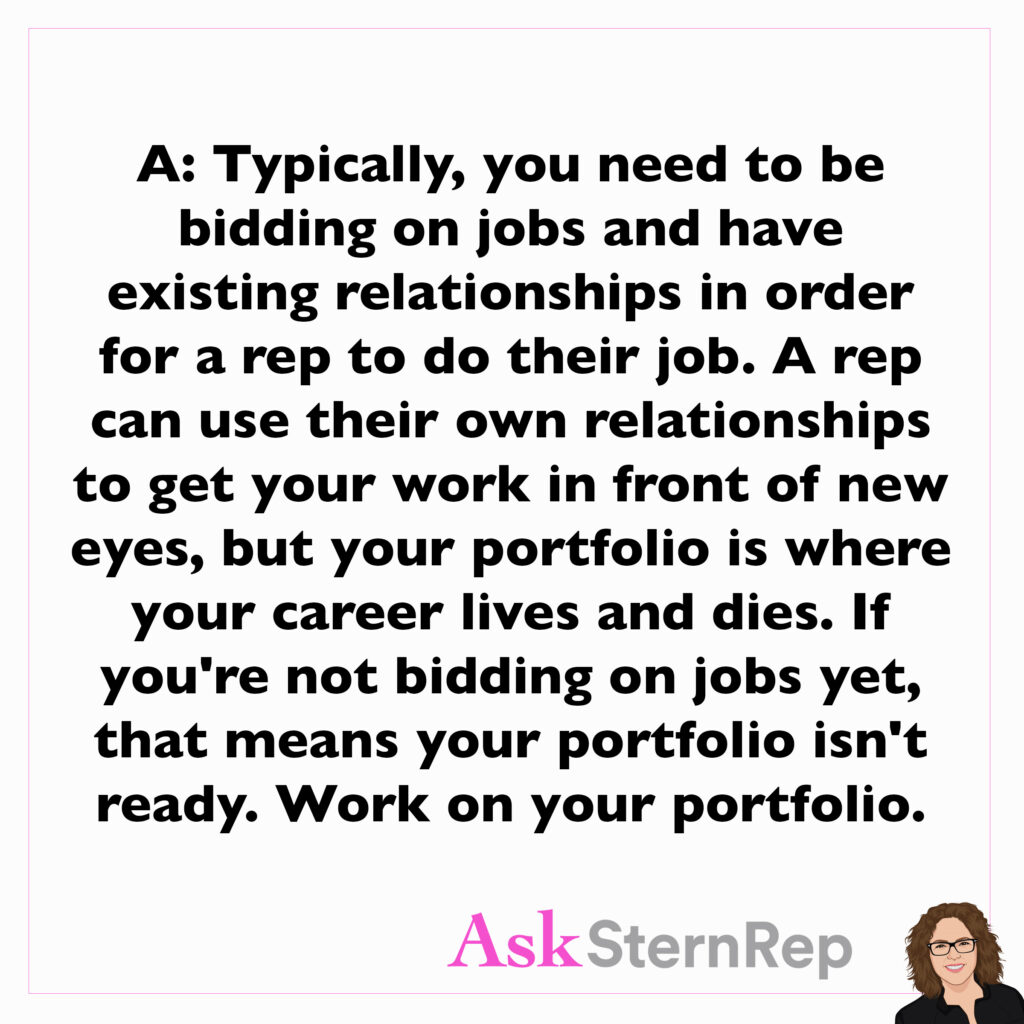
Q:
Should I try to get a rep so I can start bidding on bigger jobs, or do I need the bigger jobs before I find a rep?
A:
Typically, you need to be bidding on jobs and have existing relationships in order for a rep to do their job. A rep can use their own relationships to get your work in front of new eyes, but your portfolio is where your career lives and dies. If you’re not bidding on jobs yet, that means your portfolio isn’t ready. Work on your portfolio.
Be Professional
On a job, when stuff goes down, stay steady + handle it like a pro. Being professional means not personally defensively reacting, but listening instead, as you are objectively gathering information.
Most likely it will blow over even though in the moment it feels alarming. Be objective.
Jobs will always come with some drama. You need to handle it like a pro; it’s your test to see if they’ll hire you again. I understand that it’s easy to take things personally sometimes, but don’t let that show. Be a constant professional and a source of calm. Listen to people, check on them if something seems off, and ask questions to understand what’s going on. Be the person who holds the shoot together instead of becoming part of the drama.
If Someone Wants to Showcase Your Work


Q:
If someone is claiming to want to showcase you as an artist & you feel you are not ready, what is the best professional response to decline without ruining your chances for a future showcase?
A:
If someone wants to showcase your work, go for it! You would not usually be asked if you’re not ready. Worse case scenario: It will be a learning opportunity. You will discover what works and what doesn’t, and can make adjustments in the future.
It’s Not a Show, It’s a Conversation
On a creative call make sure to wait after you speak, hearing the creatives’ response.
The purpose is not only to get your questions answered or get your message across, but also to connect. It’s not a show, it’s a conversation.
You speak and then they may have a response, so allow for that as the connection may be more important than what you are saying.
On these creative calls, as I listen to all the photographers, I always think about what I can learn and what they can learn from the discussion. I actually wrote some notes on this and want to read them because I don’t want to forget anything. Don’t rush and talk so much that they can’t respond to each point. Every point you make is important, and it’s equally important to hear how they respond.
Who knows what they might say? Hopefully, they like what you’re saying, but their responses can help you understand more and guide your perspective on the project. Hearing their responses is exactly what you need, so make sure to slow down and not rush as you talk. Allow space for them to answer.
Not Getting Responses from Emails or Phone Calls
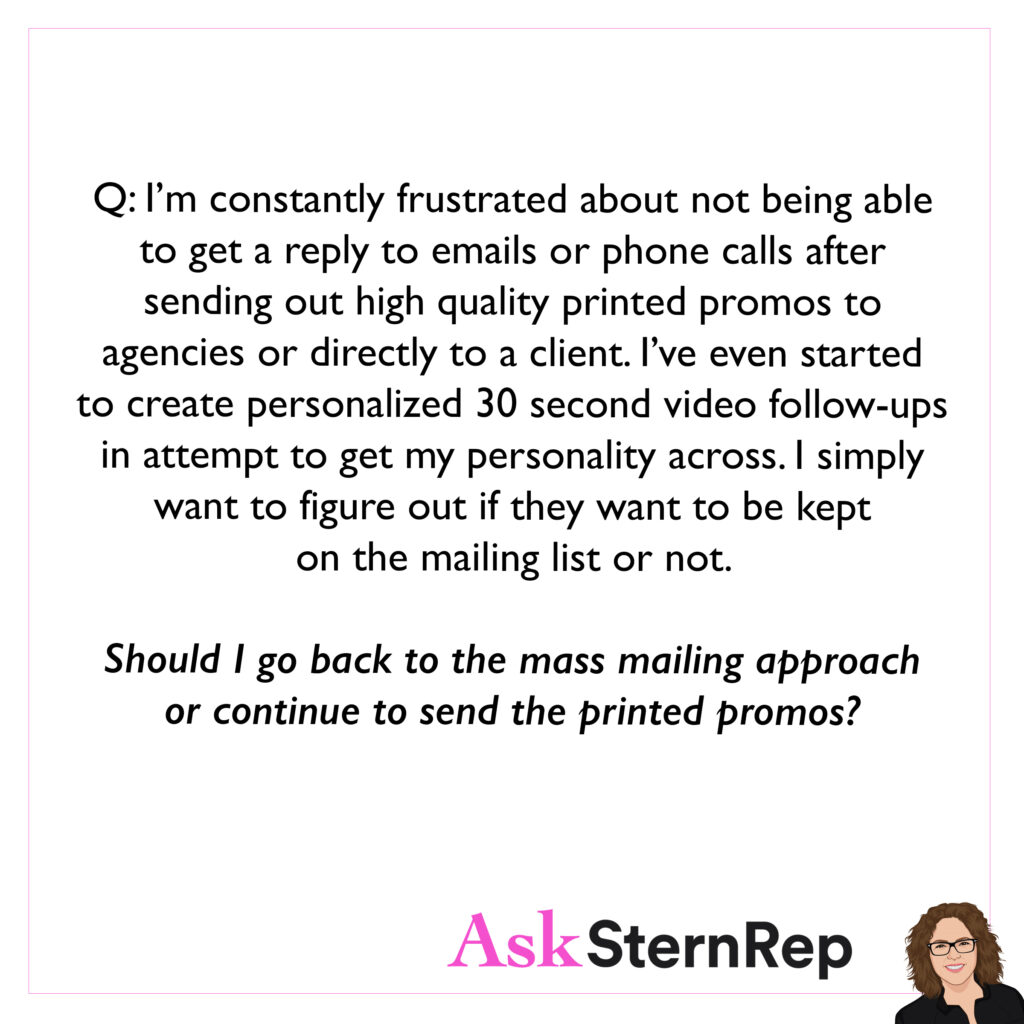
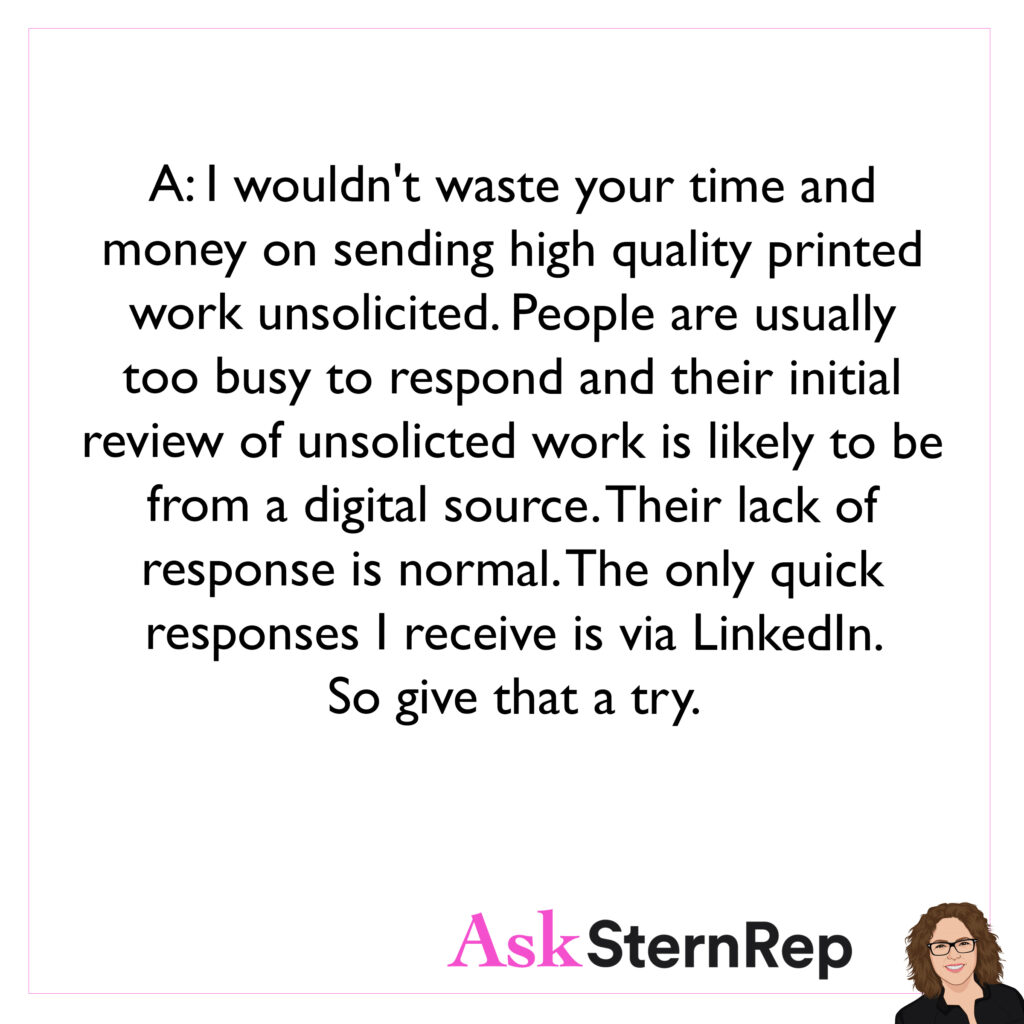
Q:
I’m constantly frustrated about not being able to get a reply to emails or phone calls after sending out high quality printed promos to agencies or directly to a client. I’ve even started to create personalized 30 second video follow-ups in an attempt to get my personality across. I simply want to figure out if they want to be kept on the mailing list or not.
Should I go back to the mass mailing approach or continue to send the printed promos?
A:
I wouldn’t waste your time and money on sending high quality printed work unsolicited. People are usually too busy to respond and their initial review of unsolicited work is likely to be from a digital source. Their lack of response is normal. The only quick responses I receive are via LinkedIn. So give that a try.
Be Thankful

Be thankful for what you do for a living. Your job is to stay in your creative zone. How lucky are we?
Photopholio App
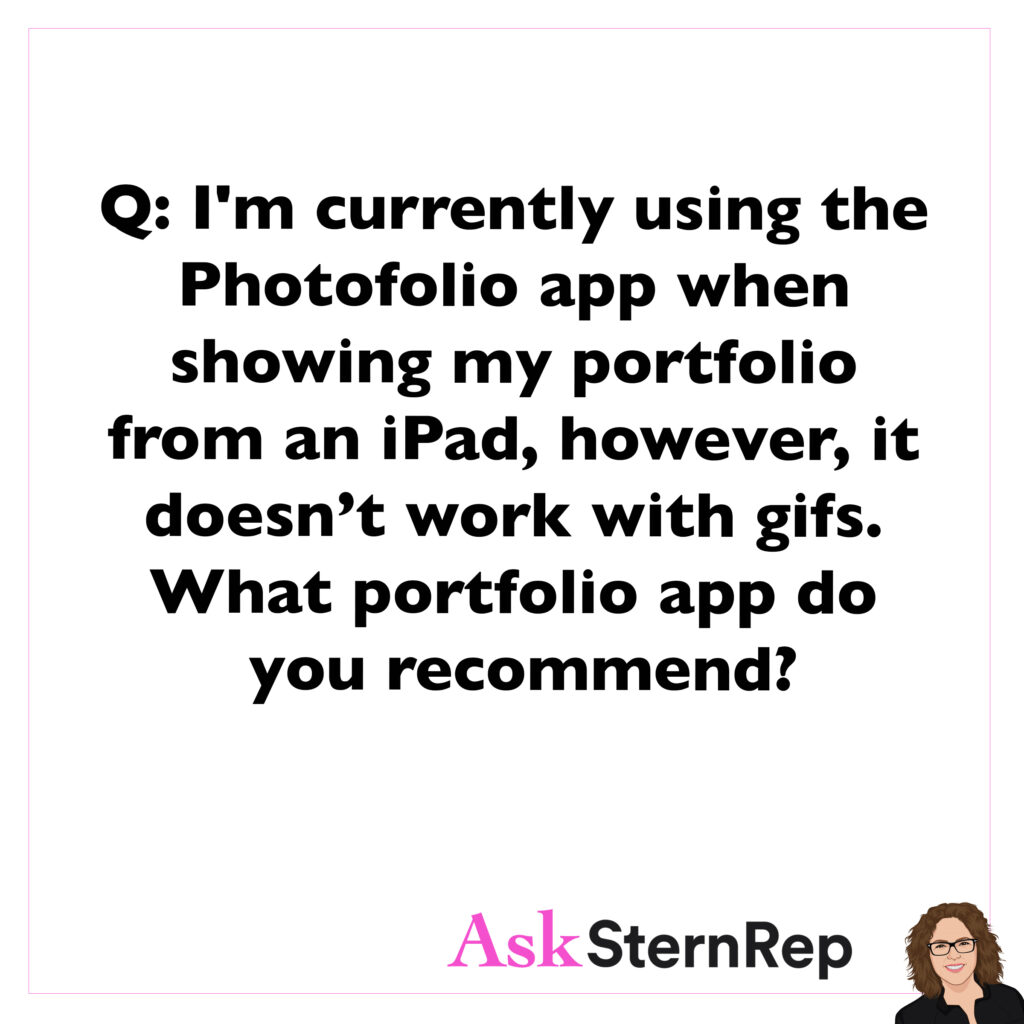
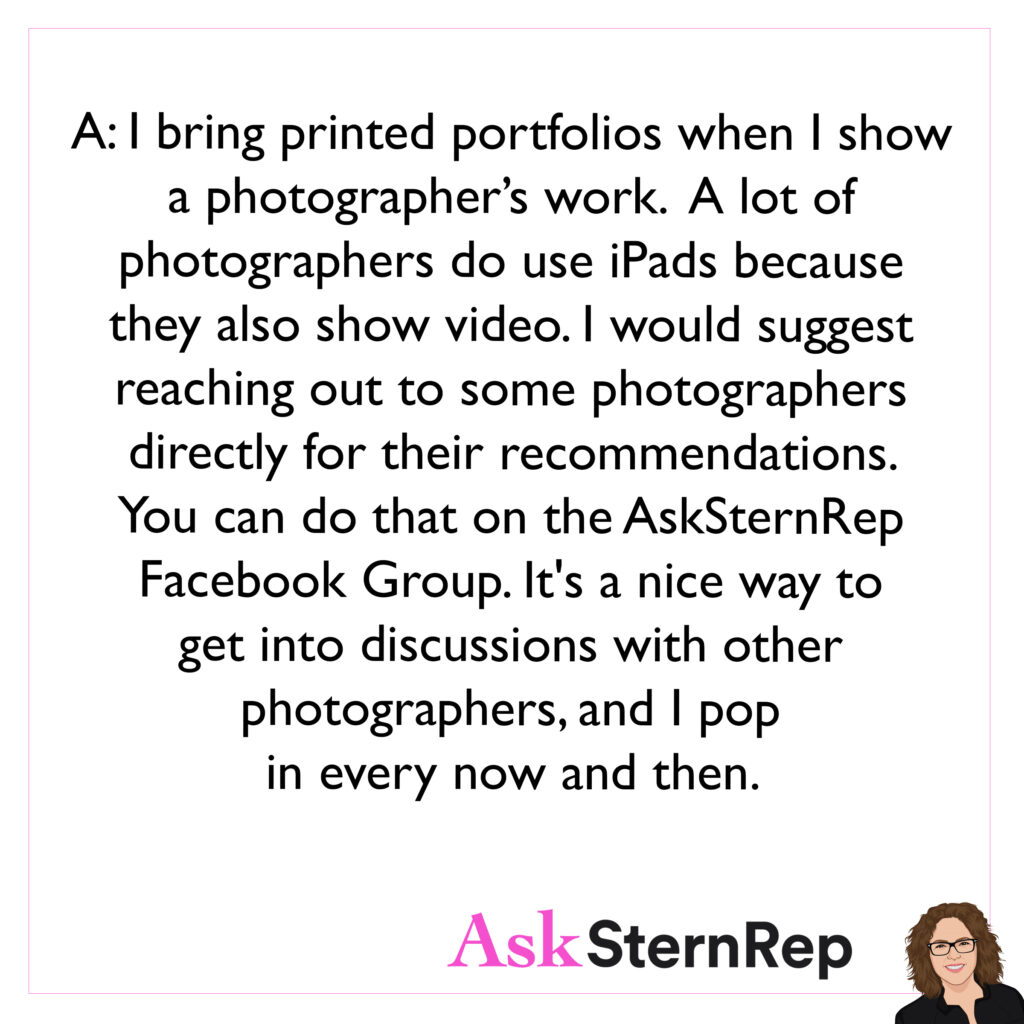
Q:
I’m currently using the Photofolio app when showing my portfolio from an iPad, however, it doesn’t work with gifs. What portfolio app do you recommend?
A:
I bring printed portfolios when I show a photographer’s work. A lot of photographers do use iPads because they also show video. I would suggest reaching out to some photographers directly for their recommendations. You can do that on the AskSternRep Facebook Group. It’s a nice way to get into discussions with other photographers, and I pop in every now and then.
What Are Your Inspirational Idiosyncrasies?
What are your inspirational idiosyncrasies?
I mean when/how does your best work happen?
You are an artist and to succeed you must incorporate what makes you tick and call that your “business.”
I’ve been thinking a lot about this because I notice it in photographers, though it’s probably true for everyone. My focus is on photographers, and while everyone has their own style of making things happen, there are sometimes challenges that get in the way.
I want to tell everyone to listen to what’s blocking you and figure out what will help you thrive. What will make you flow and accomplish what you need to in your business? Do you need to delegate tasks, play music loudly, open the door and go outside, or meditate? Identify what you need and respect that you need it to feel more alive, stand out, and achieve your goals. Do the things that will help you succeed in your business.
Testing for a Client


Q:
What are your thoughts on testing for a client, at the client’s request. Should you ask for your costs to be covered?
A:
Testing for a client is not an industry standard request. I’m reluctant to encourage you to test for a client because it will most likely mean you won’t have the proper budget to do it right, and the image quality might suffer. If the quality of your work is at risk then I would say it’s not worth it.
Join the Instagram Party
The change in our marketing these days is massive. In the past we had a clear route with less options.
The #1 mandatory way in now is to stay fresh and join the Instagram party.
This is no longer an option.
I’ve noticed lately that Instagram feed posts aren’t getting as many likes or views as they used to. We know it’s because of Instagram Stories, which have become more prominent. However, as a rep, if I’m researching a client, photographer, or anyone, and I see that they haven’t posted on their feed in a few weeks, I lose a bit of respect and don’t take them as seriously. It gives the impression that they’re not as engaged or haven’t made time for it. So, I still think it’s really important to post regularly on your feed.
Follow Up Immediately
In any business interaction, remember to follow up immediately so you are believed and taken seriously.
When I meet someone for the first time on the phone or in any other setting, I want to know that they will follow up quickly and express that the meeting was important to them and that it went well. Everything they said should be followed up on promptly—ideally, right away. This quick follow-up makes the interaction feel real. Even if we have a great meeting, we might wonder if it was as good as it seemed or if we should hire this person. How they follow up acts like a test. So, do it as soon as you can.
Use of Images for Self Promotion
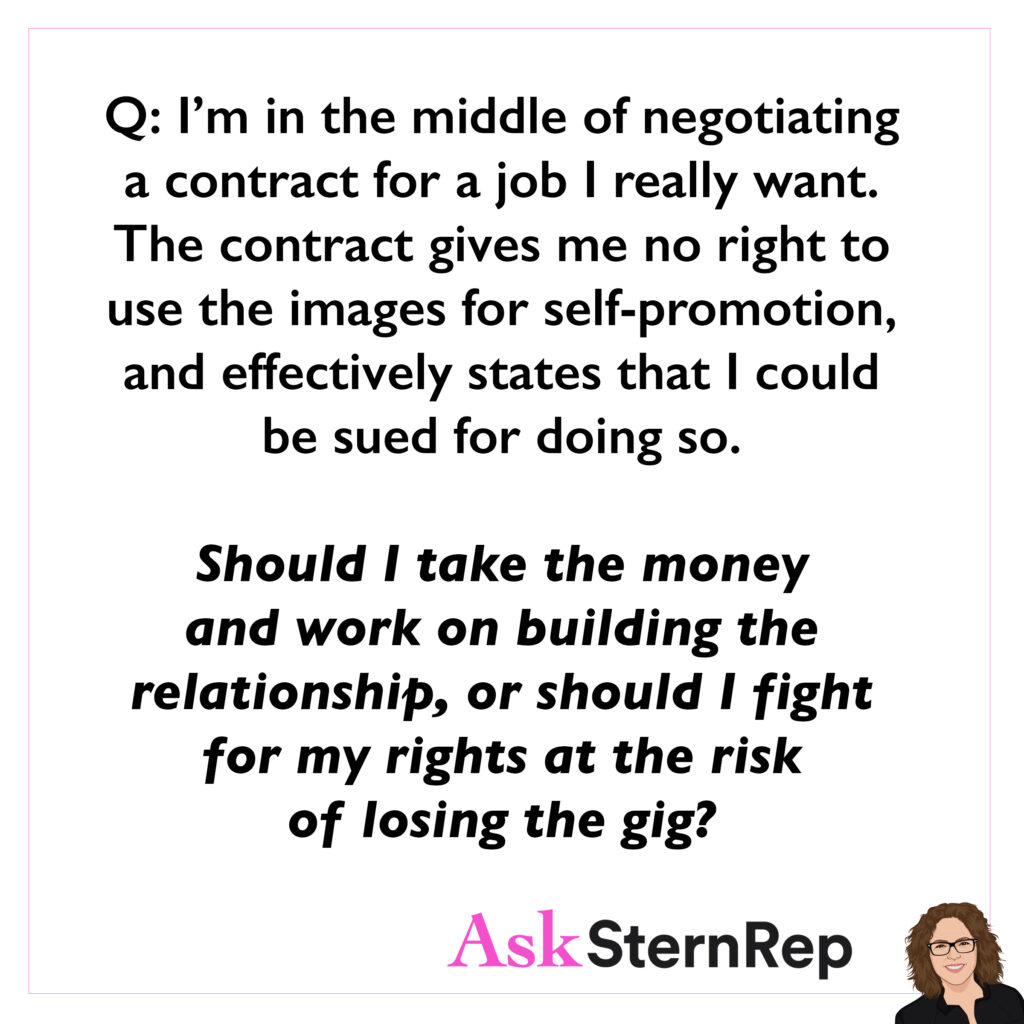

Q:
I’m in the middle of negotiating a contract for a job I really want. The contract gives me no right to use the images for self-promotion, and effectively states that I could be sued for doing so.
Should I take the money and work on building the relationship, or should I fight for my rights at the risk of losing the gig?
A:
I would talk to your contact at the company, and gauge their flexibility. Explain why you would need to show this work in order to get more work.
Hopefully they’ll be receptive to your concerns + work with you on tners that are fair to all parties. At least try your best to get what is fair.
Our industry also benefits when we stand together on issues like this. I understand why you wouldn’t want to walk away from the job because of this, but asking for what you want, in a respectful way, shouldn’t lose you the job.
Curate Your Relationships
Curate your relationships.
Of course this is true for our personal lives, but also for our careers.
Know where people are from and what they enjoy.
Relate to people as our connections are the best public relations.
Even if you have a rep, do this for yourself as your relationships are a part of your brand.
Right now, marketing is incredibly important to our business. It involves putting ourselves out there, bonding with others, and taking note of what’s important to them—their backgrounds and relatable topics. This approach helps us connect quickly and meaningfully. I’ve seen that today’s marketing is increasingly about personal connections, even including things like taking people to lunch. Then, when we bid on a job and start working with them, it feels more human. Marketing today is more about human connection than ever before.
Watermarking Images


Q:
Should I watermark my images to prevent people from sharing my work on social media without giving proper credit?
A:
In the commercial advertising business, watermarking your images makes you look like an amateur. Never do this. If you discover your images are being shared without credit or permission you should contact the individual or company directly.
Build Your Brand on a T-Shape
I once heard the very wise rep Rhoni Epstein of Photo Therapists say, “Build your brand on a T shape. Build a strong style and then expand once it is sturdy.”
Follow her advice.
www.phototherapists.com
I hear a lot about expansion from photographers who want to explore new areas. It’s natural to want variety and not do the same thing over and over. However, it’s important to stay strong with your core style—what you’re known for. I remember the concept of the ‘T-shape’: build a strong foundation with your primary style first, then you can expand. You need to have that core style balanced and structured before branching out. So, focus on solidifying your main style and then consider expanding from there.
Finding a Good Fit With a Rep
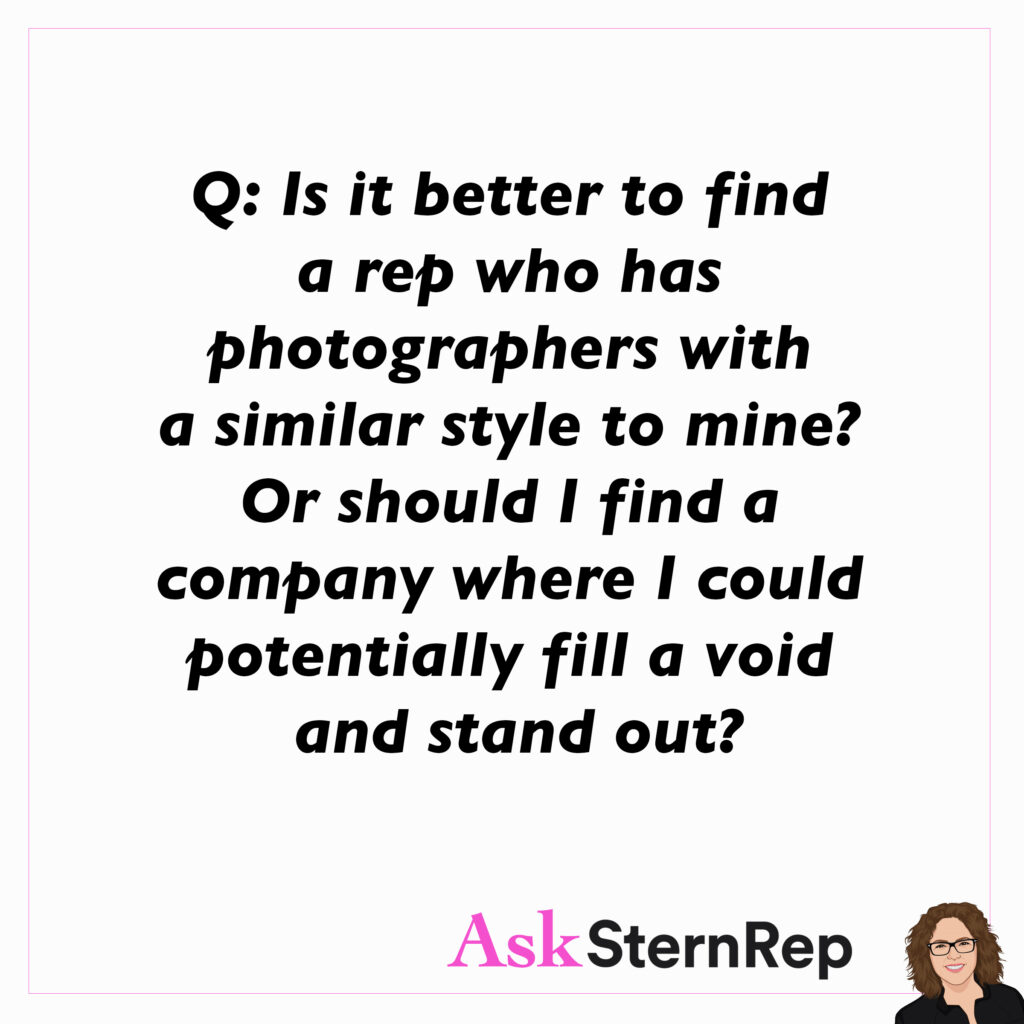

Q:
Is it better to find a rep who has photographers with a similar style to mine? Or should I find a company where I could potentially fill a void and stand out?
A:
Don’t focus only on their roster of photographers. You should primarily be looking to find a rep who works with your dream client base. You also need to factor in if your work is of a similar standard to their photographers. If it isn’t up to that standard yet, focus on bringing up the quality of your work first so you’re better positioned to find a top tier rep.
Creative Call Tip
The Creative Call is one of those rare ‘make or break’ moments that will help you get or lose the job. When you hear a pause after the creative explains what they are looking for, jump in with a response of a visual description of how you will get what they are looking for.
I have a specific piece of advice for you, based on what I’ve noticed on creative calls. There’s often a pause when the art director is explaining the shot list and the concept. It’s crucial to wait for that pause and use it as your opportunity to reiterate your visual plan. Instead of just saying ‘That’s great’ or ‘Yeah, sure,’ use that pause to restate what they’ve outlined and explain how you will technically execute it. This helps clarify how you’re going to bring their vision to life.
Portfolio Layout
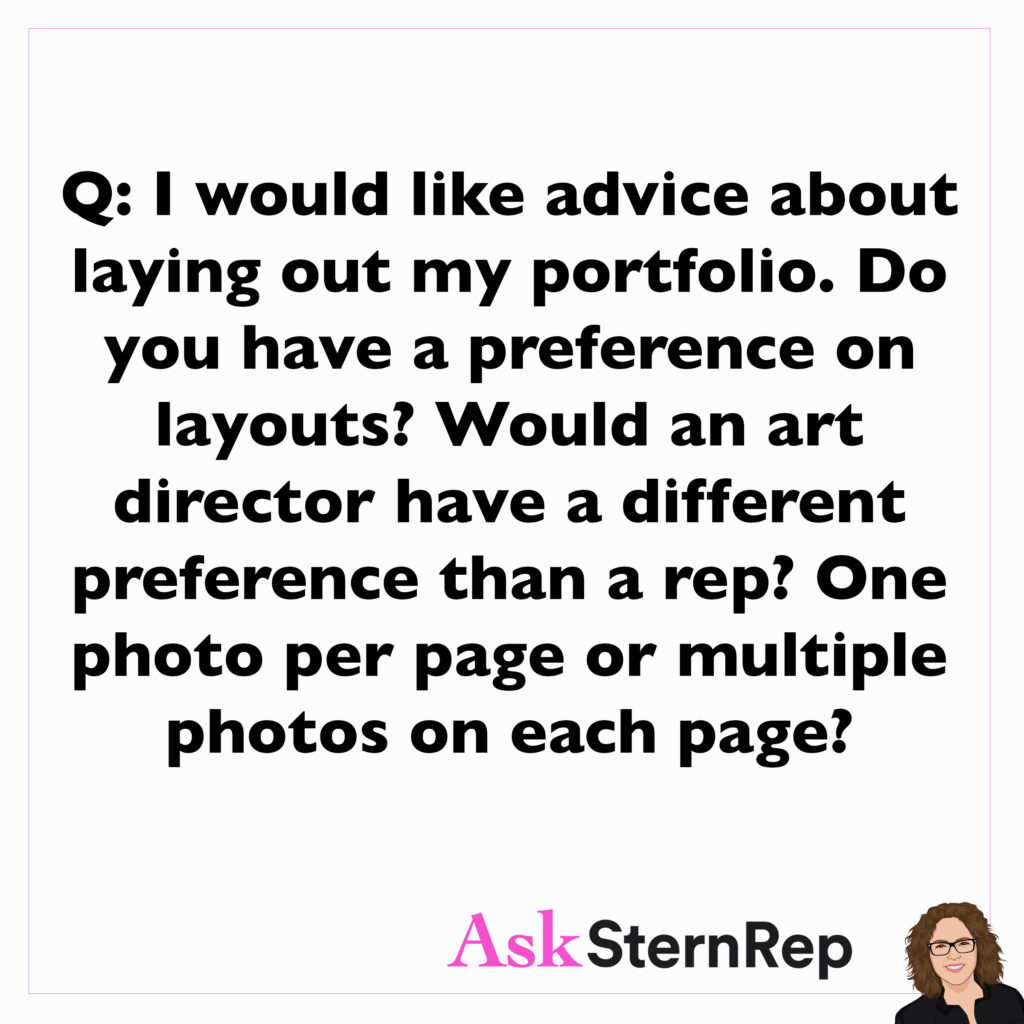

Q:
I would like advice about laying out my portfolio. Do you have a preference on layouts? Would an art director have a different preference than a rep? One photo per page or multiple photos on each page?
A:
Printed portfolios can allow the viewer a much needed break from screens. I prefer one image per page, as it allows the image to sink in without distraction and also projects confidence. Exceptions to this could be if you’re using a designer and they are creating a specific look with multiple images per page. But I usually lean towards less is more.
Use a Schedule
Use a schedule to get it done.
Book yourself for the day and time to check it off your list.
If you don’t get it done, reassign it until you finish the task.
One thing I learned when I started as a rep—it was in Seattle, thanks to Doug Landreth—was the importance of scheduling. I was an in-house rep, and Doug introduced me to Maria Piscopo, a consultant whose expertise is in scheduling. That really hit me hard; I realized that I needed a solid schedule to manage my tasks. Without one, I struggled to get things done. Time management became crucial for me, and it’s something I still rely on heavily.
Speaking of consultants, they can be incredibly helpful. There are a lot of them out there, and if you ever need advice or recommendations, feel free to ask—I’ll point you in the right direction.
Brand/Agency Location


Q:
Do I need to consider where a brand/agency is located before pitching them? If they’re in another state I might not be able to meet in person and I’m concerned I could lose a job over it.
A:
Communication tends to be done electronically, via online portfolio review, conference calls, video chats, etc, rarely in person. If you think the budget won’t allow for travel, you can always offer to work as a “local” once you get to the budgeting stage. Focus on the jobs you really want… that your body of work supports.
Follow Your Mood
On a workday with time to do what you want, go with the tasks that you are in the mood for.
I write in the mornings because that is when words flow for me.
Follow your mood and go with it to get the best results.
Just because you’re not on a shoot today—or any other day—doesn’t mean you’re not working. It’s still a workday, so make the most of it. I remember when I started repping in 1800—just kidding, of course! David Zeitz, a photographer who became a rep and then returned to photography (check him out at davidsites.com), taught me so much. I’d go over to his place, and he’d show me what being a rep was all about. I learned from his routine, and we discussed how even on a non-shoot day, there’s plenty to do.
He advised me to clean my desk, build my contact list—basically, to utilize all the time I have. He was so right. He also told me to pay attention to how I was feeling; if I was a bit cranky and didn’t feel like being social or making calls, I should do something else that day. So, remember, you’re still working—use your time wisely.
Figuring Out Your Style


Q:
How do you figure out your style? I am working towards making my work cohesive and really struggling with this…
A:
The answer to this question can make or break your career. Familiarize yourself with photographers doing the kind of work you want to be doing, and doing it on a high level. Study them. Understand the difference between a cohesive portfolio, with a clear through line and those who have many different styles. Identify your own visual instincts and apply them every time you shoot. Learn to become objective so you can be the best judge of your own work.
Inside View: Bidding Tips
Bidding a project correctly is one of the most crucial parts of getting awarded a job. The way you bid CAN ultimately get you in or lose the job. As much as every bid depends on the situation, there are also some standards and rules that you can educate yourself about and utilize to your benefit.
Here are 5 tips to help you become an even more successful bidder!
Tip #1: Creative Fees + Usage
Always have a signed estimate that clearly describes what the bid is based on and what the licensed usage is. Be sure all costs are agreed on before beginning the job.
It is our responsibility to clearly spell out what our numbers cover and don’t cover. I used the top of the estimate for this, and call it “description.”
Always define the amount of shots and what they are. Remember to specify that the bid does not include variations, added shots, or different angles. Mostly, this section is how you protect yourself.
A great line I like to use after the usage is, “image rights granted with full payment.”
Make sure overtime is clear on your estimate – that the shoot day is based on the standard 10 hour day, anything over that will incur an overtime rate of time-and-a-half for crew.
If you feel like you would do better if you had help with your bid, then hire the right person – like a rep, producer, or consultant. It could be well worth that commission fee if getting help will in the end leave you with a much larger rate than you would have gotten on your own.
Tip #2: Negotiating
Clients can’t give you numbers, you have to throw numbers out there for them to bring you up or down.
Always start with a higher amount and hope they say you are too high. You don’t want to be too low.
Use questions about the details of the job to get a sense of each client. REALLY LISTEN. I have found that people want to tell us a lot more inside information than we give them the time or opportunity to reveal.
Tip #3: Advances + Expenses
ALWAYS GET A 50% ADVANCE FOR A PHOTOSHOOT.
To get this invoice in, you need to have their purchase order (PO) # on your invoice or at least a signed estimate. As soon as that happens, you can officially begin to start spending money.
BE CAREFUL THOUGH, there are a lot of scams out there. If this is not for a major advertising agency or client you know, wait until you have been wired the advance invoice and it CLEARS at the bank before you spend ANY money for a job.
If any changes occur before or during the shoot, you need to request an “overage” (send in an overage estimate) and when that is approved you can spend more $.
Do not go over this total which you’ve been approved for, or you will not be able to charge for it.
Tip #4: Payment
Invoicing for an advertising job after it is completed will often require backup of all receipts.
This should be done correctly and I’d recommend getting a producer’s help and/or a bookkeeper who knows the business.
Expect to be paid 30-60 days after the client receives your final invoice.
Tip #5: CREATIVITY
(in all ways + places even *bidding*)
Think outside the box.
Just like a good producer responds with options in a tough scenario, be your own innovative producer.
Getting creative seems to be my response to all that is happening in our business right now. The entire industry is changing, so go with the flow of it and find your way.
Use your experience wisely, but don’t let what you’ve done in the past limit or define you. Step outside your own thinking sometimes. Think young.
Instagram!
Instagram! Get your work out there in the world. More and more often producers are being tasked with finding undiscovered talent. You’ll see that some of the biggest brands are shooting campaigns with photographers that were discovered via Instagram, many of whom have never shot an ad campaign.
Guest Post: Executive Producer, Rebecca O’Neill
This tells me so much about our market right now. It’s fresh and raw. We have to stay young thinking. Don’t think like an experienced photographer, think young, new thoughts and new ways. That’s what clients want right now. They want what’s hot, what’s new, what’s next. You don’t have to have a big client list to get jobs. That’s a great opportunity. Once again it’s Instagram.
Printed Portfolios

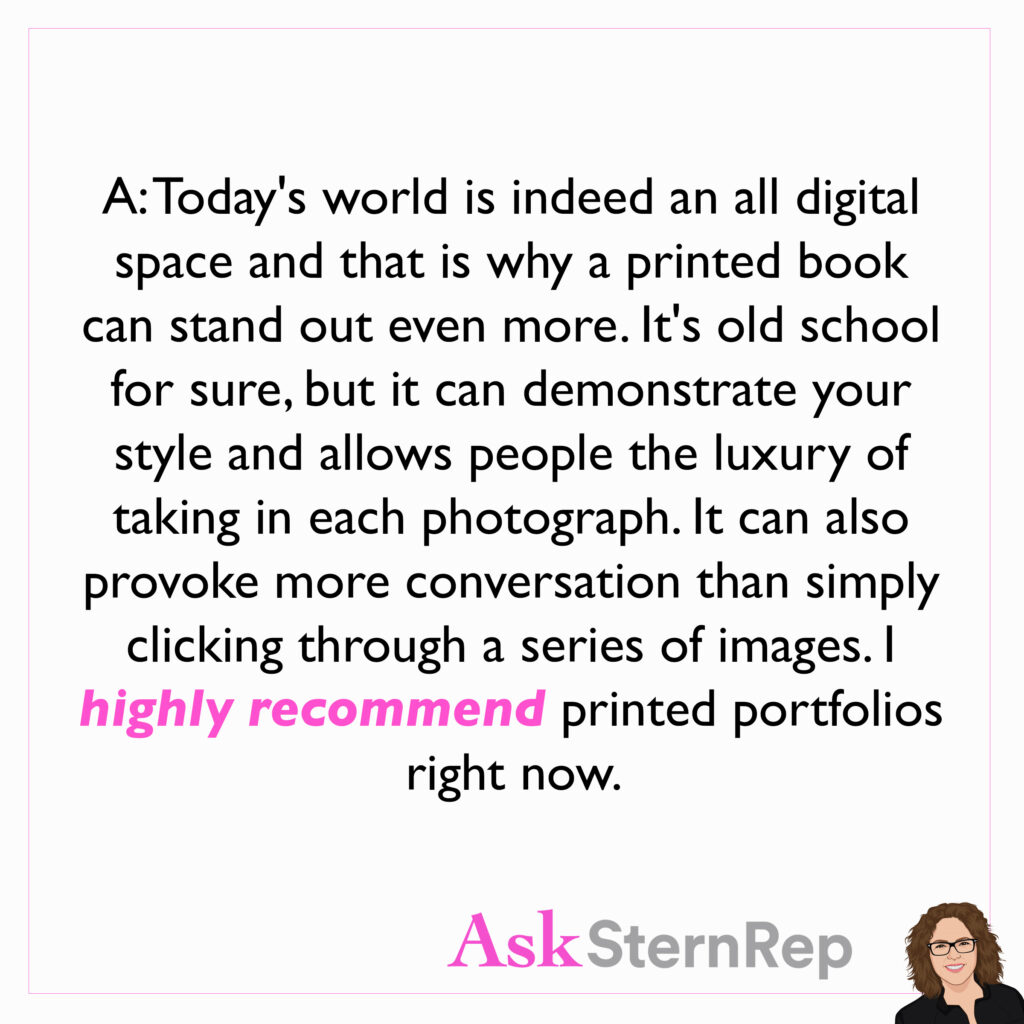
Q:
Do clients want to see printed portfolios when you meet in person? Most of the work we do now is used in the digital space, so would an iPad presentation be more effective?
A:
Today’s world is indeed an all digital space and that is why a printed book can stand out even more. It’s old school for sure, but it can demonstrate your style and allows people the luxury of taking in each photograph. It can also provoke more conversation than simply clicking through a series of images. I highly recommend printed portfolios right now.
Insta Stories
Insta Stories: Marketing with a twist of becoming human.
For the first time we have an opportunity for what I call wall-less and door-less marketing where we get seen.
This is business, right? So, I had to deal with it. I didn’t want to do any public speaking—I was asked to come into classes, be on panels, and even moderate a ‘Why We Hire You’ event years ago for the APA. I was scared. At first, I thought, ‘No, I can’t do public speaking. I get too nervous.’ But then I just started doing it. I told myself, ‘This is my business; I’m going to do it.’ I was scared to death and would have preferred not to, but certain things came naturally to me that I didn’t know I had the ability to do.
Like right now, the camera’s on, and I’m talking, and somehow the words are just coming out—hopefully in a way that’s helpful. I took the leap, and sometimes I think there’s something within you, as an artist, that you can tap into without even realizing it until you start. You push yourself, and you find that stuff that just needs to happen.
Inside View: On Treatments
In an effort to demystify this topic, I asked a variety of Art Producers to get the inside scoop on treatments.
Question: What do you believe is the purpose of a treatment?
FCB Chicago Art Buyer: The purpose of a treatment from our perspective is to confirm the photographer has taken, digested, and totally understood the brief and creative call. It’s an opportunity to make the creatives feel totally comfortable and at ease with the photographer’s expertise.
The photographer should also always feel empowered to bring their own flavor to the concept, too; we seek photographers out to be creative collaborators, so if a treatment is just going to directly mirror our concept/references and not add anything new then it’s not as strong as it could be if the photographer included some of his or her own ideas, as long as they’re in line with the concept and goal of the shoot/campaign.
Art Producer Cameron Barnum: Treatments are a critical tool in today’s bidding process. That might sound hyperbolic but I’m finding that Art Directors & Clients are coming to expect a treatment for any sizable project. Directors have long provided as much. Photographers would be well advised to join ranks.
Anonymous Art Producer: The treatment shows us how the photographer envisions the shoot happening, from style to locations to actual camera lensing. It gives us a look into what our project will become with that specific photographer.
Art Production + Creative Consulting Mara Serdans: The purpose of a treatment is to give the creatives and client an idea of how the photographer plans to execute the concepts through his/her lens. I think the photographer should use this as an opportunity to share any solutions to challenges/questions that were posed on the creative call as well. The photographer should also do more than just regurgitate what was discussed on the creative call but show the team his/her unique perspective. www.maraserdans.com
Question: What are some key components in putting together a successful treatment?
Art Producer Cameron Barnum: Photographers should embrace the treatment as an opportunity to show their craft & design sensibilities in the document itself. They should use it to further develop the ideas started by the initial creative briefing conversation. A treatment is also a great place to express their enthusiasm for taking on the job.
Anonymous Art Producer: I think attention to detail and thoughtfulness of the project as a whole is essential. I’ve gotten treatments where a photographer just threw some photos together and sent them over. I can find those on their website myself! Some of the best treatments I’ve gotten have broken things down so beautifully with an intro to them as a person, look and feel (and they explained why their look and feel would translate well to out project), location inspiration, wardrobe and talent styling, technical info, and just an overall breakdown of how they work. Those types of treatments literally lay the shoot out for us with such a clear picture.
Anonymous Art Producer: The PDF is well designed and showcases your ideas. Something that would stick out negatively is when it’s clear you didn’t understand the brief or have an idea that is totally off brand/message.
Question: What percentage of the treatment should be words, and what percentage images?
Anonymous Art Producer: I think about 60-70% images and 30-40% words. It’s nice to get a good overview of how you work and how you’d approach the job, particularly if we haven’t worked together and we only got to know you on a creative call.
Art Production + Creative Consulting Mara Serdans: I don’t think I can quantify a specific ratio of images to words but it should clearly and concisely communicate the concepts. And the photographer should inject a bit of his/her personality into the treatment. Also, don’t forget to spell-check and make sure everything sounds grammatically correct.
Art Producer Cameron Barnum: The content needs to match the scope of the project. A more complex project deserves a commensurate treatment. It’s hard to attach a ratio of words to pictures but given the visual art form, more of the latter would be expected. Components ought to touch upon the critical creative decisions. E.g location, casting, on-set workflow. Also, don’t be afraid to make it personal.
Drafting a Contract for a Client

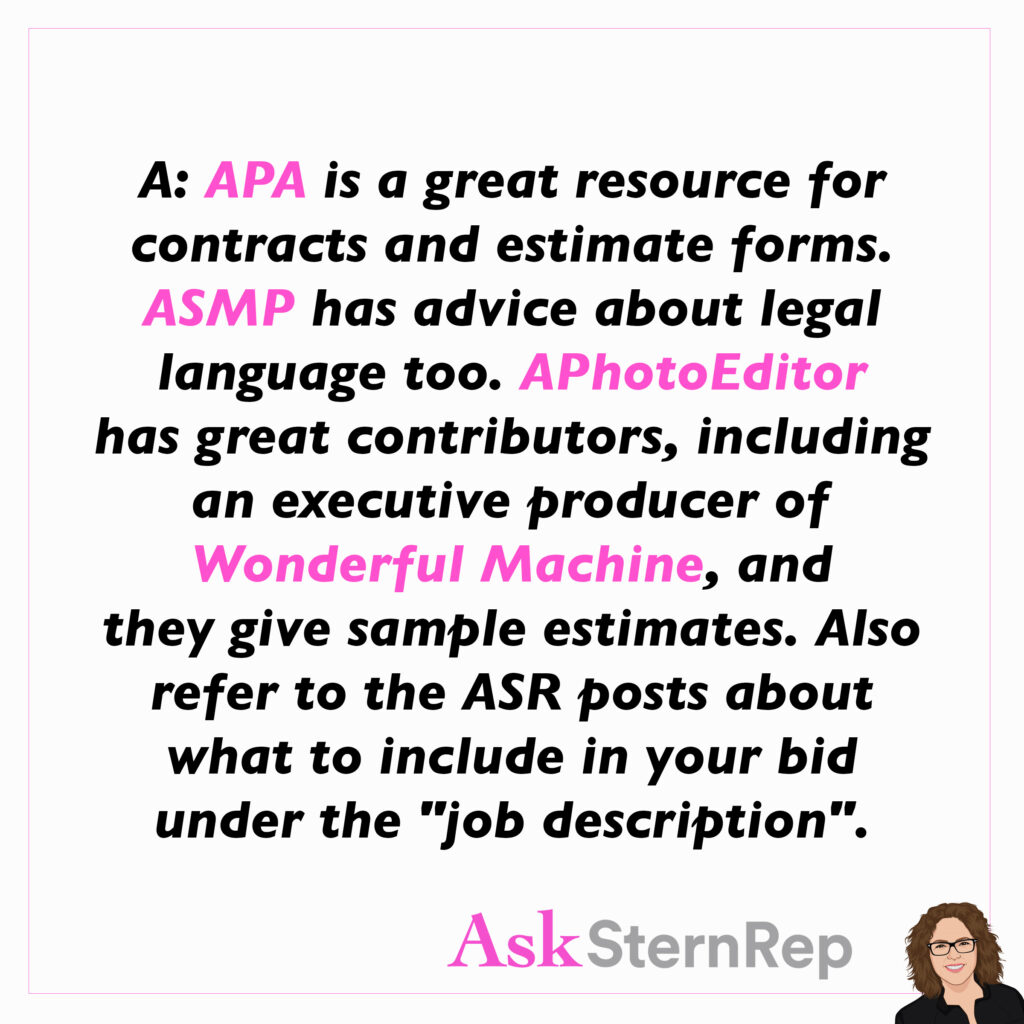
Q:
I need to draft a contract for a client. Do you have any recommendations about making sure I’m using the correct language so it doesn’t bite me in the end?
A:
APA is a great resource for contracts and estimate forms. ASMP has advice about legal language too. APhotoEditor has great contributors, including an executive producer of Wonderful Machine, and they give sample estimates. Also refer to the ASR posts about what to include in your bid under the “job description.”
If You Want a “Cold” Email Opened
If you want a “cold” email opened and read, don’t attach an image.
The more we can look like humans instead of spam, the better. In my own marketing, I draw from my personal experience as a recipient of emails. If an email doesn’t address me by name, I delete it. If it includes images, it often feels like spam, so I delete it again—honestly, that brings me a bit of joy. It’s easy to go off on tangents with this, but what’s most important right now is that I’m finding a link works best instead of images in the email. Include a link—it makes it quick and easy, and people are more likely to click on it.
New to the World of Commercial Photographers

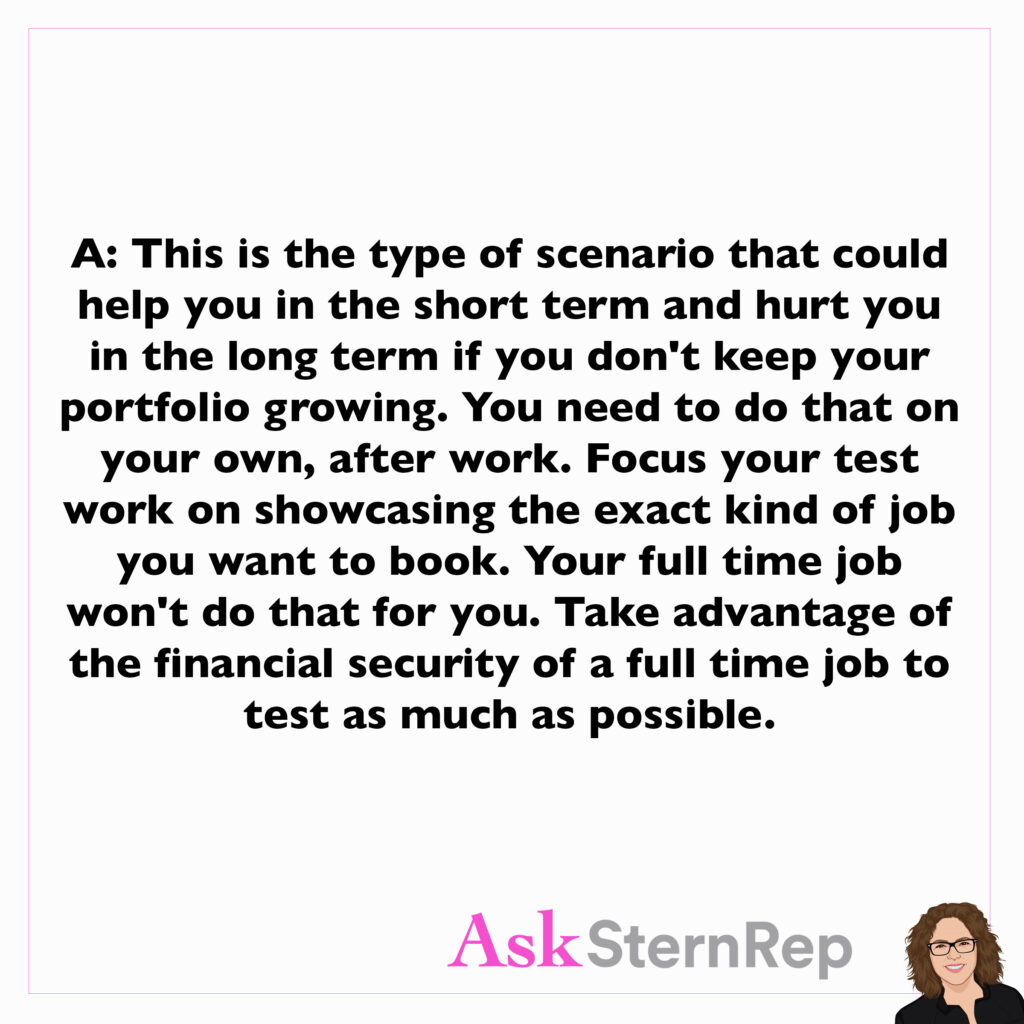
Q:
I am relatively new to the world of commercial photography. I am currently employed by a marketing agency as an in-house photographer to work on clients like Dickies. I am able to execute the multi-tasking nature that is required in this job serving in the roles of producer/photographer/creative director, etc. I am basically a freelancer on a full-time payroll. I recognize that my growth potential here is limited, and ultimately I want to be pursuing commercial photography full-time. However, I’m having a hard time reaching the right clients outside of work. What would you advise?
A:
This is the type of scenario that could help you in the short term and hurt you in the long term if you don’t keep your portfolio growing. You need to do that on your own, after work. Focus your test work on showcasing the exact kind of job you want to book. Your full-time job won’t do that for you. Take advantage of the financial security of a full-time job to test as much as possible.
What Would it Take?

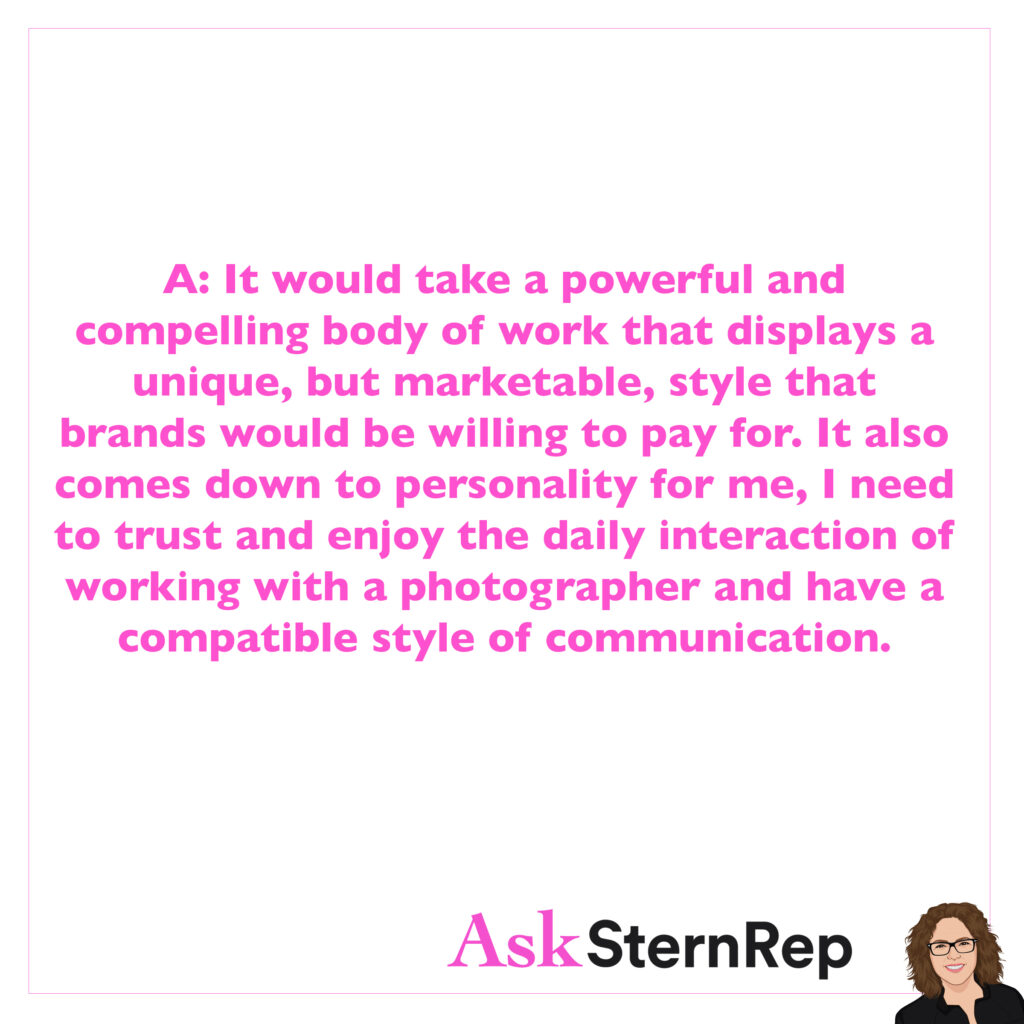
Q:
What would it take to get you to rep me?
A:
It would take a powerful and compelling body of work that displays a unique, but marketable, style that brands would be willing to pay for. It also comes down to personality for me, I need to trust and enjoy the daily interactions of working with a photographer and have a compatible style of communication.
Portfolio, Portfolio, Portfolio
As important as marketing is for all of us, it does not come close to the importance of having a superb portfolio.
Portfolio,
Portfolio,
Portfolio…
Marketing has many components, but the most important one is your portfolio. It can make or break whether you get the job. While treatments, creative calls, and everything else we do are important, they are supplemental to your portfolio. As I’ve said before, your portfolio is crucial.
I used to represent, and still handle, one of the most famous pet photographers in the world—Sharon Montrose. She hasn’t marketed herself in at least five years, yet I still receive calls for her. This demonstrates that while marketing is important, it’s your portfolio that truly makes a difference.
Photographers for Social Media Content
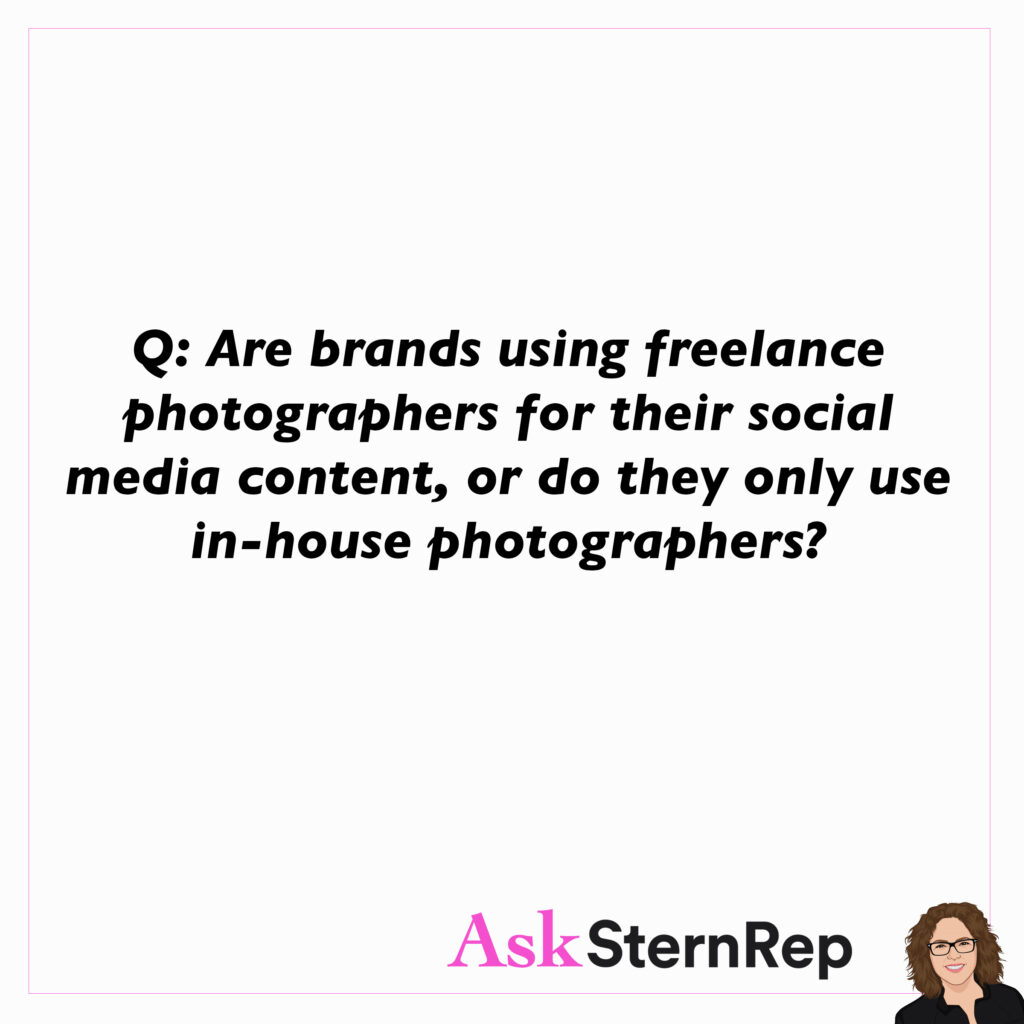

Q:
Are brands using freelance photographers for their social media content, or do they only use in-house photographers?
A:
Depends on the client. Some need freelancers or influencers on a constant basis and others do it themselves.
Additionally, when a photographer is hired to shoot a campaign for a company, it will usually include social media usage. There are instances when a company might shoot additional content themselves or feature influencer generated content and use it for social media.
Find Your Own Definition of “Marketing”
The biggest misconception about “Marketing,” is that other people’s marketing needs to be your marketing.
You will do even better if you find your own definition of “Marketing.”
I get asked a lot about marketing—what’s the right approach, whether I’m using the right marketing plan. My answer is that there’s no one-size-fits-all marketing plan. What works for others doesn’t have to work for you. I’ve worked with many photographers, and each one is unique with their own personality, which is what they should showcase. Don’t mimic others unless it truly feels right for you.
In my own marketing, I remember once going to an agency with a blended mocha from Coffee Bean. It was interesting how something so simple made a huge impact and opened doors for me. I’ve known that person since then, and that experience stood out to me because connecting in that way worked. I’m a connector by nature, and I’ve used that approach successfully for years. So, find your own style of marketing and figure out what works best for you.
Emailing a Portfolio
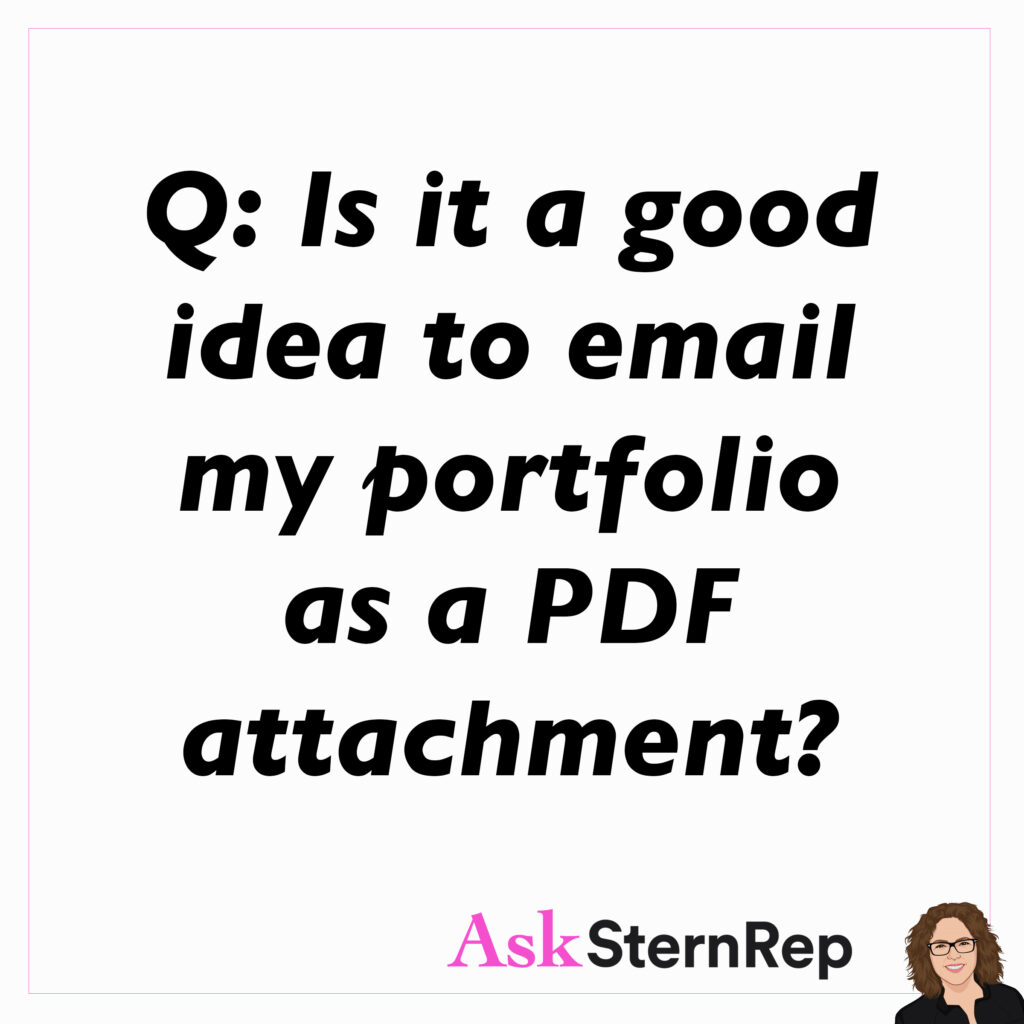

Q:
Is it a good idea to email my portfolio as a PDF attachment?
A:
Would YOU open a PDF from a stranger? Hopefully not.
Essential Advice for Every Photographer
Kerry Washington was recently interviewed on the Alec Baldwin Show and made a statement that resonated profoundly with me. In reference to learning how best to market herself she said, “I wanted to make sure that my own fears about being seen weren’t getting in the way of my opportunities as an artist.” Essential advice for every photographer, or entrepreneur in general.
I’ve repped a lot of people in the past, and I’ve seen what can get in their way, whether it’s perfectionism or an inability to delegate. A lot of this is personal and something to work through with your therapist or friends. It’s important to be conscious of these issues so they don’t hinder your progress.
If you’re not comfortable with personal showings of your portfolio, don’t do it. Instead, focus on areas where you can confidently demonstrate professionalism that will get you hired. Understand your fears and don’t let them block your path. This requires a lot of self-awareness, which is a whole other topic. I’ve seen photographers not advance as far in their careers as they could have because they were unaware of what was holding them back.
Finding a Rep is Like Dating

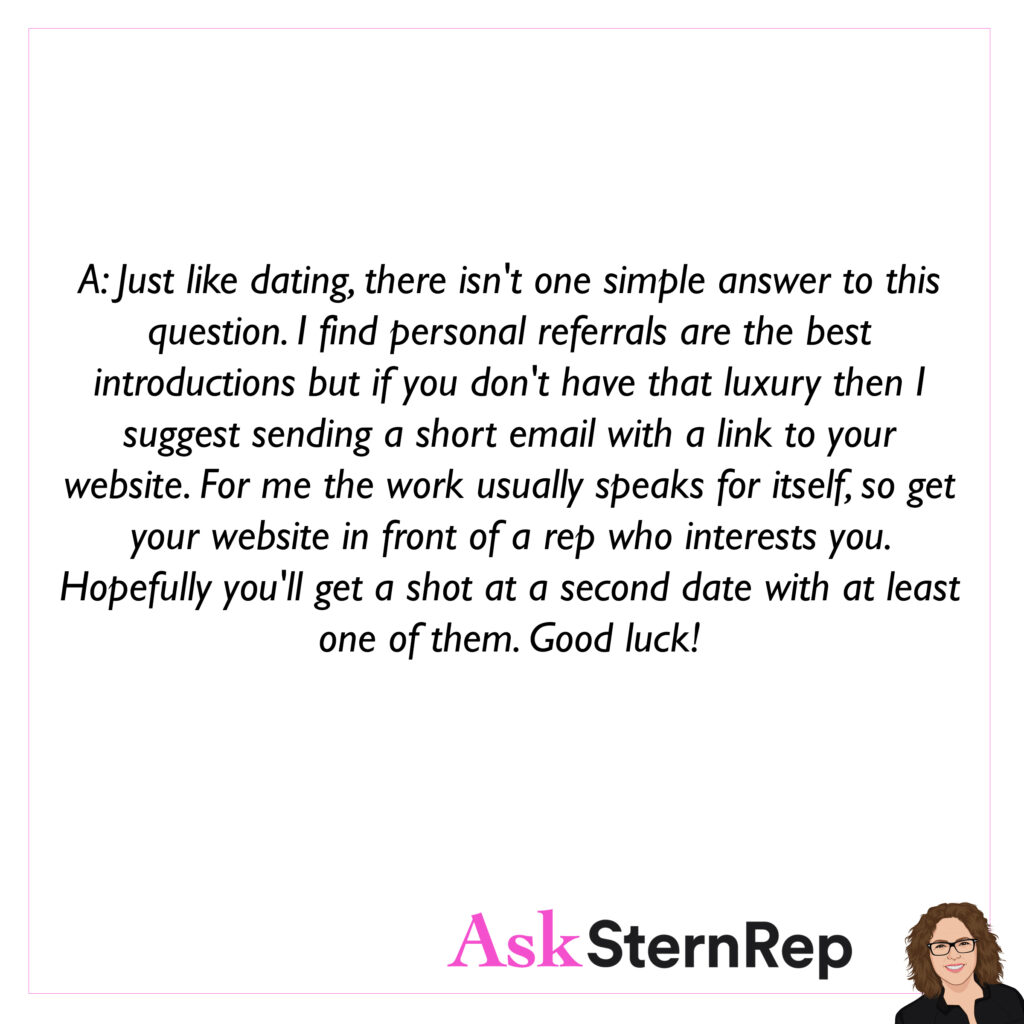
Q:
I’m looking for a rep and I’ve received so many different opinions about how to go about this. Finding the right rep seems like a similar dynamic to dating. You have to put yourself out there and be mindful of not attracting the wrong type. Do I call? Do I text? Do I wait for them to call me? I thought I’d left this all behind in my 20’s! Help!
A:
Just like dating, there isn’t one simple answer to this question. I find personal referrals are the best introductions but if you don’t have that luxury then I suggest sending a short email with a link to your website. For me the work usually speaks for itself, so get your website in front of a rep who interests you. Hopefully you’ll get a shot at a second date with at least one of them. Good luck!
Do Not Send Promos to a Client’s Personal Email
DO NOT send any promos to a client’s personal email, unless they have given you permission. Doing this crosses a professional boundary and could affect potential future work.
If you’re emailing a client and they have a professional, official work email, do not use their personal email if you have access to that. Don’t do it. It’s rude and you could really piss someone off. Use the work email if you have one. It draws a line that we shouldn’t assume we can cross. Some people might not get angry about it, but a lot will, so be really careful about the personal and professional email. Keep it as professional as you can if that’s your purpose and relationship with them.
Permission Before Sending Out Promos

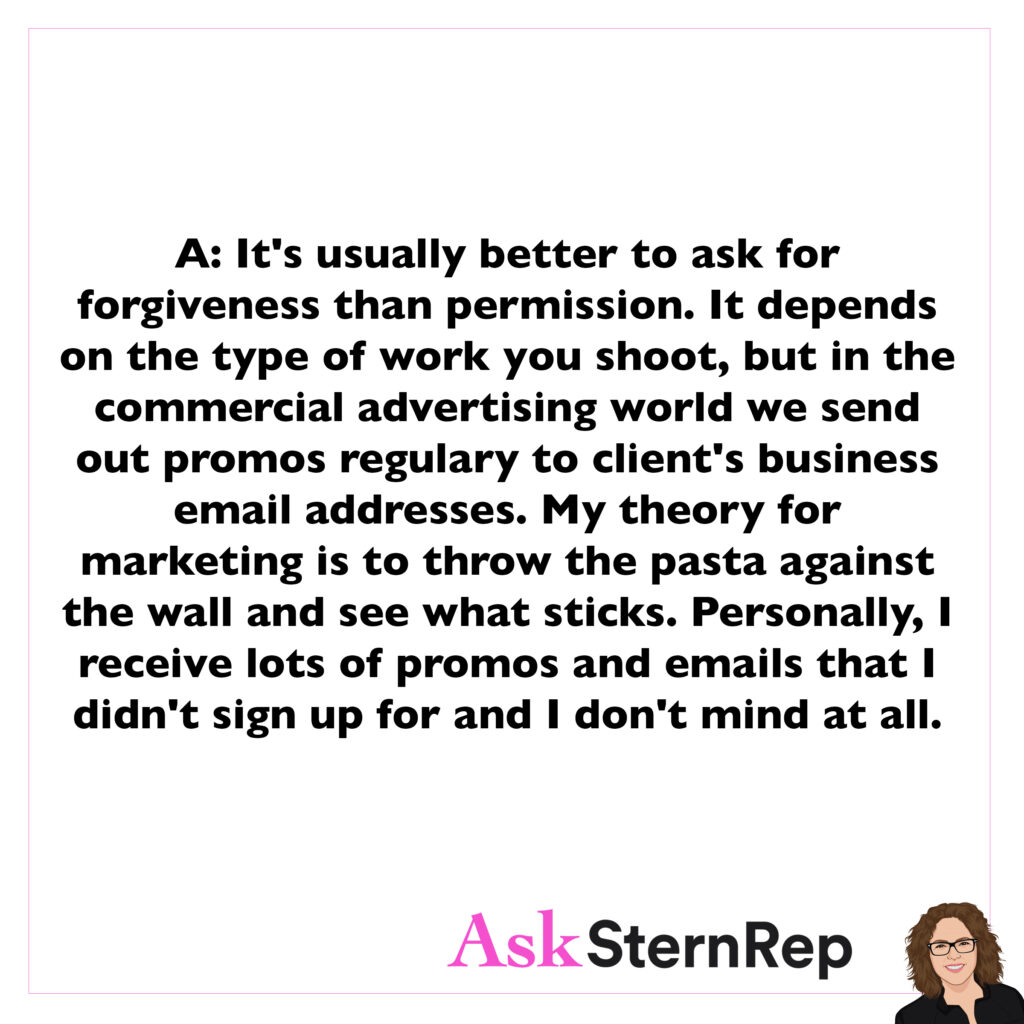
Q:
Can you include buyers and reps in your email list or do you have to ask for their permission before sending out promos?
A:
It’s usually better to ask for forgiveness than permission. It depends on the type of work you shoot, but in the commercial advertising world we send out promos regularly to client’s business email addresses. My theory for marketing is to throw the pasta against the wall and see what sticks. Personally, I receive lots of promos and emails that I didn’t sign up for and I don’t mind at all.
Keep Your Online Presence Updated
If you have started a blog or are posting work somewhere just don’t let too much time go by without updating it. That doesn’t look professional.
Another important aspect of our business that I’ve mentioned often is the need to keep up with the times. Don’t let too much time pass without updating your work—it should always look fresh. When you’re considered for a job, clients want to know that they’re bringing someone who is current, motivated, and involved, and who will do a good job.
If your blog is outdated and not regularly updated, it reflects poorly on you. Similarly, if your Instagram hasn’t been updated in a while, it might signal that you’re not actively engaged, which could make clients hesitant to hire you. Be mindful of how you present yourself. The goal of starting a blog or using social media is to market yourself effectively, so use these tools to showcase the kind of photographer and professional you are.
New Budgets, More Content

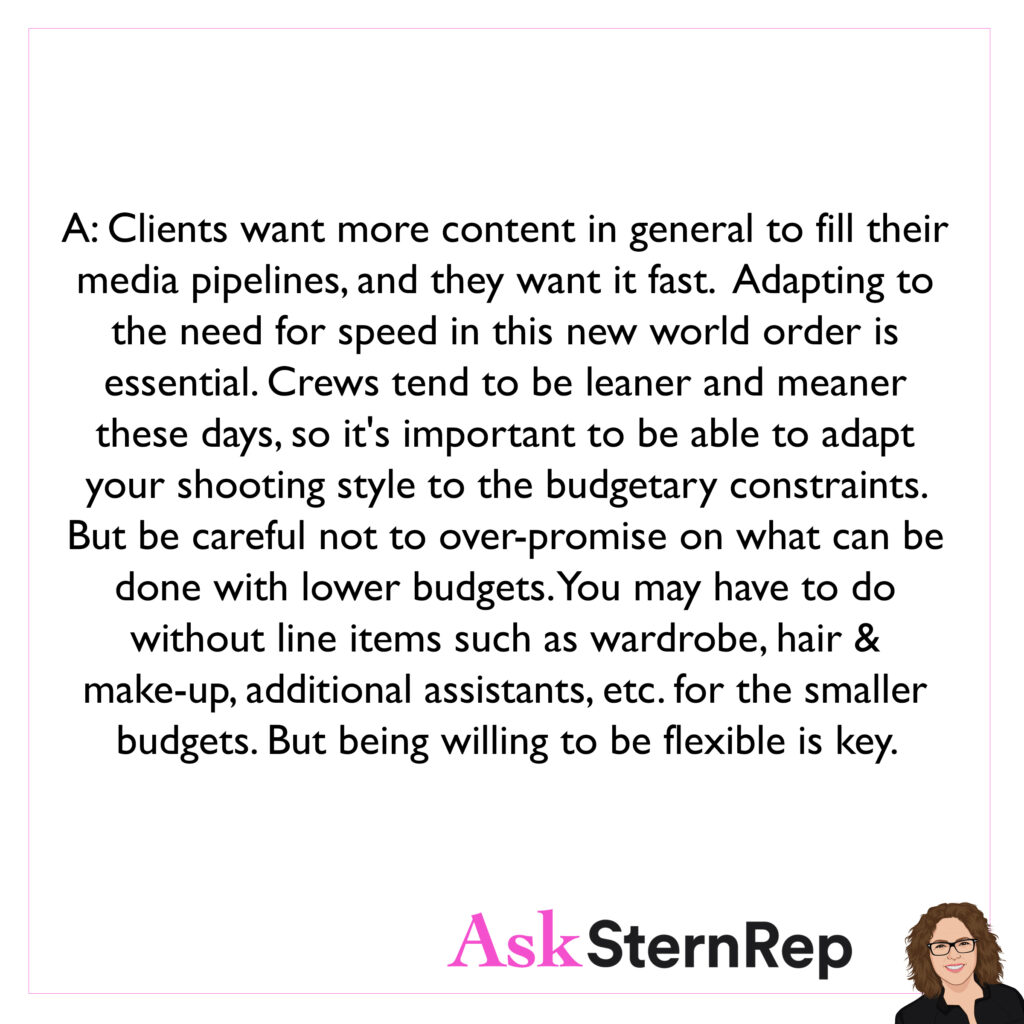
Q:
With social media on the rise and people wanting more content for a lower price, are the new budgets unrealistic?
A:
Clients want more content in general to fill their media pipelines, and they want it fast. Adapting to the need for speed in this new world order is essential. Crews tend to be leaner and meaner these days, so it’s important to be able to adapt your shooting style to the budgetary constraints. But be careful not to over-promise on what can be done with lower budgets. You may have to do without line items such as wardrobe, hair & make-up, additional assistants, etc. for the smaller budgets. But being willing to be flexible is key.
Ask One Question First
If you want an answer to several questions I usually ask just one first, and then wait for an answer before asking the next one.
This is a sales tool that I use every single day. If I give too much information to anyone, they won’t even hear me. Even asking two questions in an email shouldn’t be done—be quick, ask one question, and move on. Trust me, it works.
Usage and Small Businesses

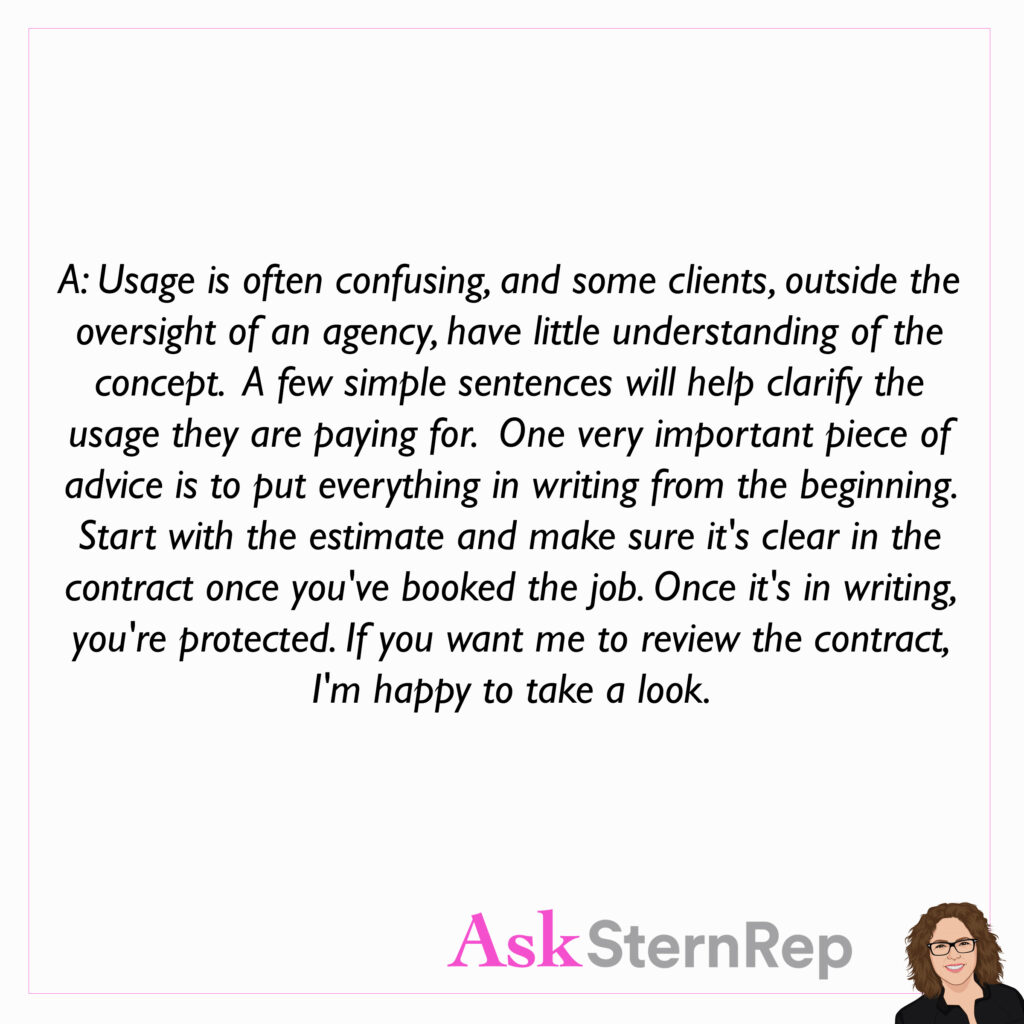
Q:
Do you have some techniques for broaching the topic of usage when working with small businesses? I want to make sure they understand that they are purchasing limited rights, and that as they grow they will incur additional usage rights.
A:
Usage is often confusing, and some clients, outside the oversight of an agency, have little understanding of the concept. A few simple sentences will help clarify the usage they are paying for. One very important piece of advice is to put everything in writing from the beginning. Start with the estimate and make sure it’s clear in the contract once you’ve booked the job. Once it’s in writing, you’re protected. If you want me to review the contract, I’m happy to take a look.
You Can’t Win If You Don’t Play
Our business can sometimes feel like a game of chess. And as they say, you can’t win if you don’t play. So be in it to win it!
This came from something I’ve been noticing lately. When people, especially clients, ask for something—things we didn’t have to do in the past—it now seems like there’s a trend where we need to give more than what’s asked of us. Whether it’s in the bid, the treatment, or even on a creative call, we go beyond. We even pay people to get the resources we need, as if we’ve already got the job. Go beyond what’s required; it’s a game, and you’ve got to be in it to win it. I mean it. Find the resources you need, and give them not just what they want, but more than they even think they want. Show up with more than they could ever imagine.
Respectful to Client Budget

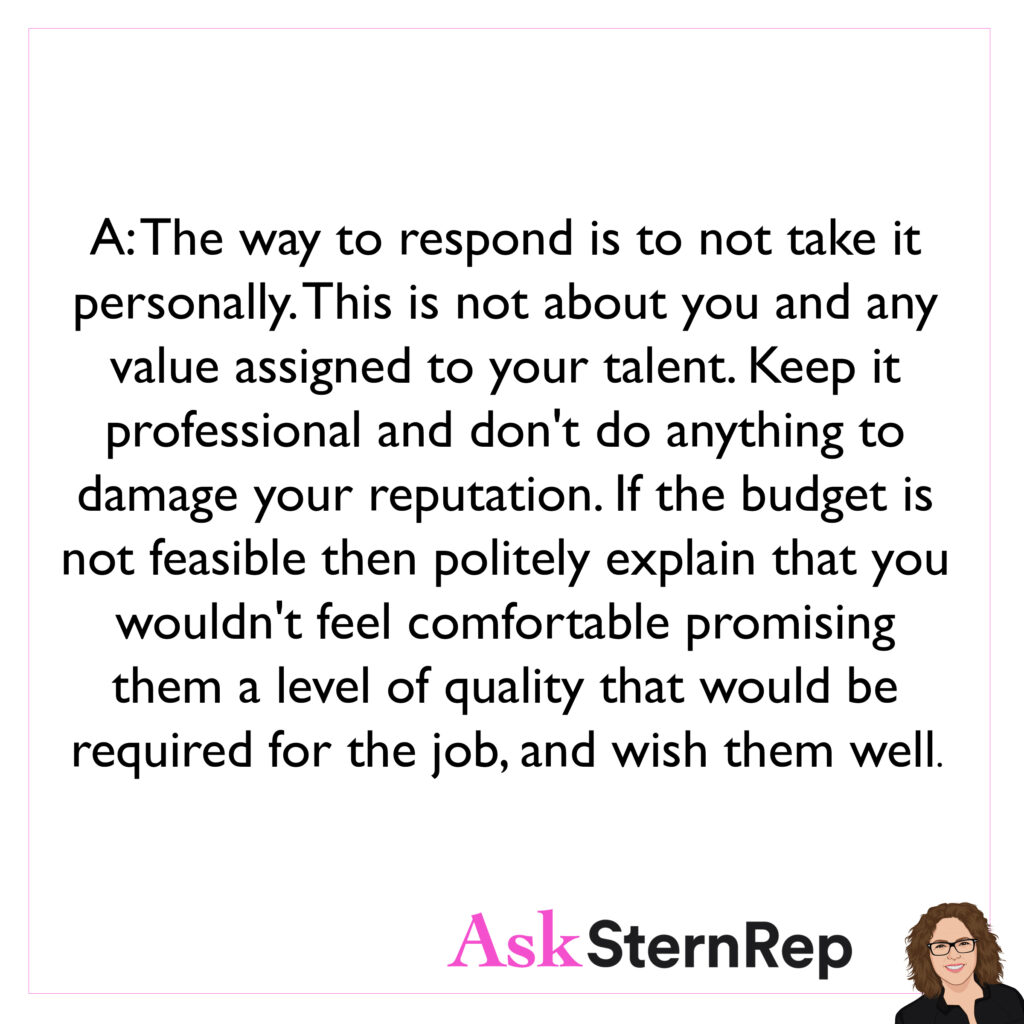
Q:
After putting together a realistic budget, how do you respond respectfully to a client who tells you that your budget is 10 times what they have to spend?
A:
The way to respond is to not take it personally. This is not about you and any value assigned to your talent. Keep it professional and don’t do anything to damage your reputation. If the budget is not feasible then politely explain that you wouldn’t feel comfortable promising them a level of quality that would be required for the job, and wish them well.
Instagram Post Ratios
*Instagram*
Post primarily professional content: Finished work, behind the scenes, videos of you at work, etc. Images should be… 70% professional at least – 30% personal. But instagram for photographers, really needs to be PRIMARILY professional content. It is a living, breathing portfolio and should be aligned with all of your other branding.
It’s funny—I wrote this about six months ago, and it already feels a bit outdated. Our business changes so fast. Right now, Instagram should be your portfolio, plain and simple. It should look like your portfolio. Any personal stuff, behind-the-scenes content, and things like that should be in Instagram Stories. That’s what Stories are for, and that’s where that content belongs. Your Instagram posts need to be your portfolio.
I once heard a story—I mentioned this on The Futur podcast; you should check it out—where an art producer was in a meeting with her agency. While they were discussing which photographers to use or bid on, she discreetly checked Instagram under the table to look through portfolios and suggest photographers. Instagram is so convenient, and it has truly become the new portfolio. So, treat it that way.
Quality vs Quantity
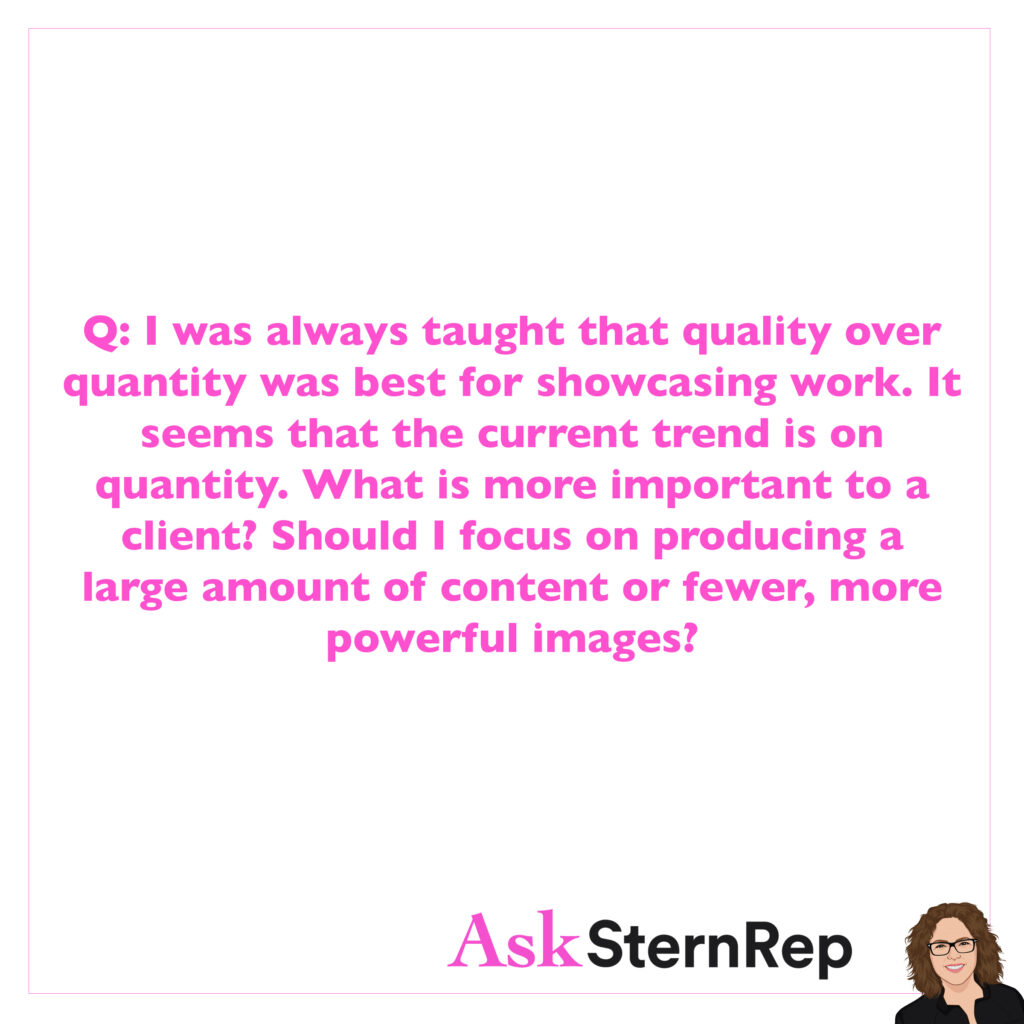
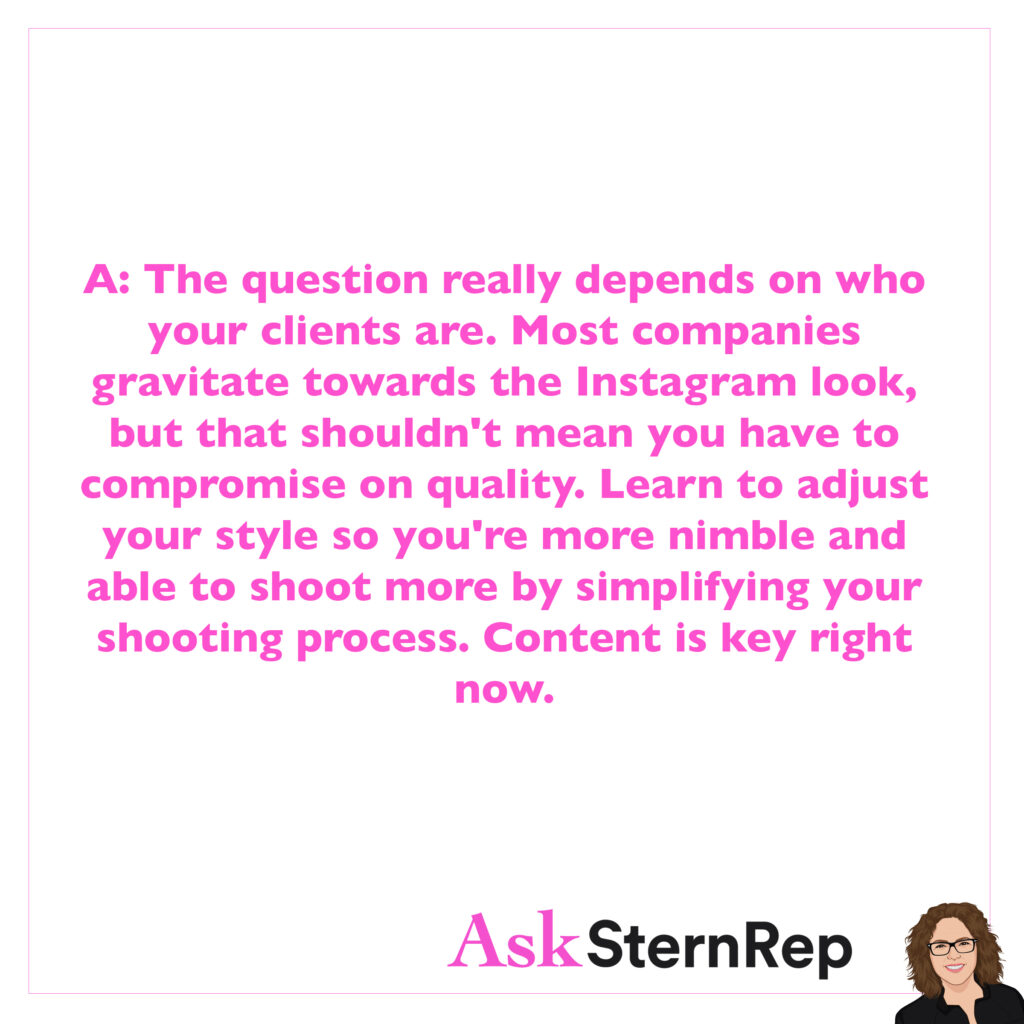
Q:
I was always taught that quality over quantity was best for showcasing work. It seems that the current trend is on quantity. What is more important to a client? Should I focus on producing a large amount of content or fewer, more powerful images?
A:
The question really depends on who your clients are. Most companies gravitate towards the Instagram look, but that shouldn’t mean you have to compromise on quality. Learn to adjust your style so you’re more nimble and able to shoot more by simplifying your shooting process. Content is key right now.
A Handy Rule For Promos And Portfolios
A handy rule for promos and portfolios is to never put the date on them. It makes them unusable pretty quickly.
I like how I mentioned a ‘handy rule’ because so much of what we do needs to be utilized for a while, and you don’t always know the time limit. When it comes to your branding and marketing materials, it’s better not to include a date. In fact, avoid including any unnecessary information. If it’s optional, leave it out—don’t limit yourself.
Showcasing Work on Your Website

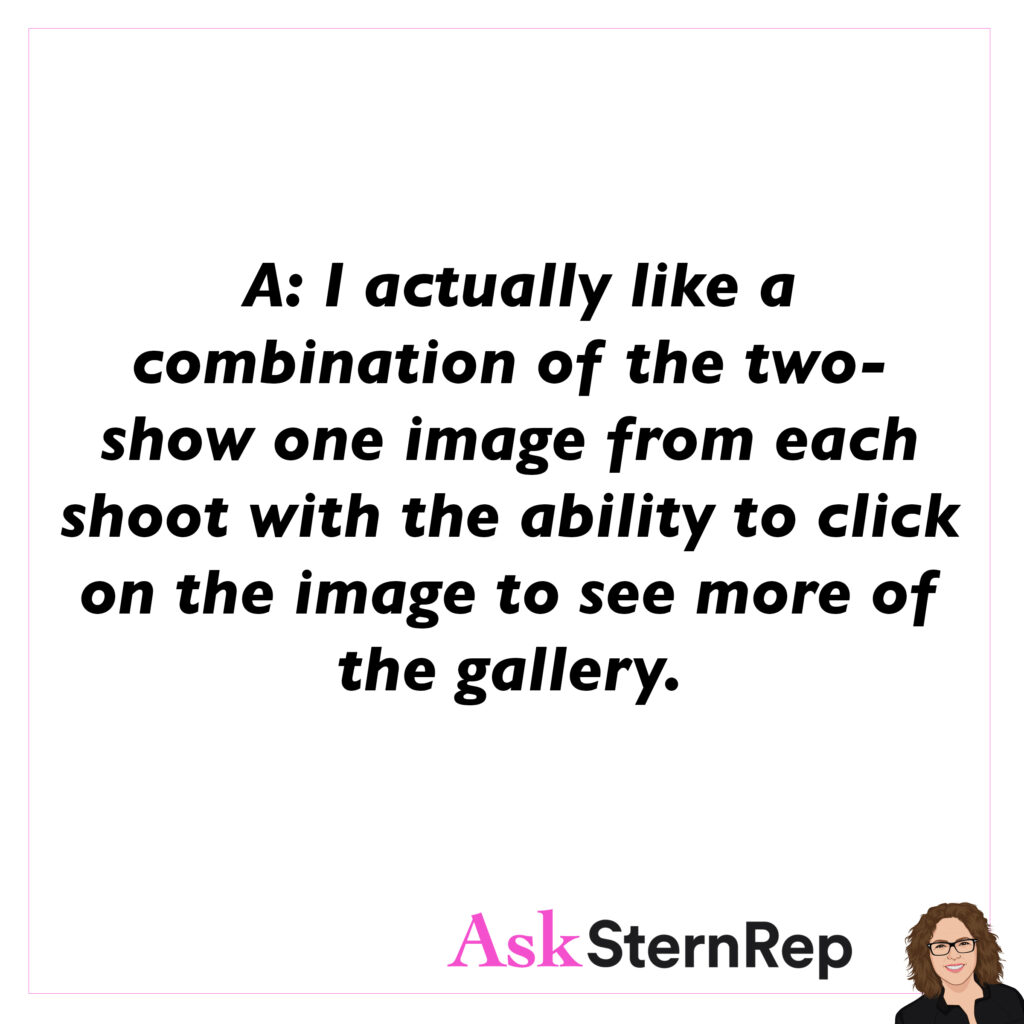
Q:
What is the best way to showcase work on your website – showing all images from individual shoots in separate galleries, or just showing one of the best images from each shoot?
A:
I actually like a combination of the two – show one image from each shoot with the ability to clock on the image to see more of the gallery.
Don’t Take It Personal
One of the most consistent traits I see in successful business people is that they are committed to not taking other people’s opinions personally.
This one’s a bit more personal because, while it applies to life in general, I try to stay focused on business rather than becoming a psychological or spiritual teacher. But it’s fitting because rejection is something we face all the time in this business. We send emails that don’t get responses, we bid on jobs and don’t get them, we try for portfolio shows and don’t make it in.
This isn’t something to take personally—it’s information to help guide us to do better. If you didn’t get the job, ask yourself why. Do you need to bid differently? Does your portfolio need to shift and change? Do you need to test more and bring in new images that will get you the job? That’s what I mean.
Where Do Buyers Go to Find Photographers?


Q:
Where do buyers go to find photographers? Google? Online directories? If so, other than social media, where do you suggest photographers advertise?
A:
This may be the hardest question to answer in our industry right now. I’d say all of the above. Try everything and see what works. My most sincere answer is that buyers often look at reps’ websites…so get a rep if you can. I also have heard feedback that art producers like Wonderful Machine, but then again, shop around, and also ask those who are already using those sites if they have been getting more work from them.
Protect Yourself On Every Bid
I may have already told you this, but…
Part of the purpose of an estimate is to protect yourself. On EVERY bid description be sure to include:
“Bid based on information provided, any changes may incur overages”
AND
End the usage terms with,
“Granted with full payment”
Your estimate is so important. It’s your terms and conditions, it’s what’s going to protect you. You must put in all the details, such as how many shots, how many days, how many hours, is there overtime? Will there be retouching? Always use that line, “Bid is based on…” Make it all clear in that top job description paragraph. Make sure they read it. You also would have it in the terms and conditions below, but we don’t think anyone is really reading those. They will protect you in court, but hopefully we will never get to that point. Make sure you put in all your details.
Agency Purchase Orders With Rights


Q:
How do you handle agency purchase orders with rights grab language?
A:
Purchase orders are our protection to get paid so make sure the usage rights match exactly what you have negotiated.
Best Sales Method Is To Compliment People
Best sales method is to compliment people
(and mean it).
This post is not just about compliments, but using the same method, the best sales method, to work through your conflicts in business. Be a really nice, kind person, talk it though and be honest. If you have a conflict with a client talk it over with them. Tell them your situation and how you landed there and what do they think. Bring them in on it. They’re not your adversary, you work with them and you’re a team player.
Organizing Your Client List


Q:
How do you organize your list of clients/contacts? Do you have a CRM or spreadsheet or use one of the list services? The lists get so big, I am wondering how you structure it to stay on top of who is who and what your history with them is?
A:
Organizing our lists is a time consuming, yet mega important part of our marketing business. I pay for Agency Access and Yodelist and then I keep my own list on Direct Mail.
If Your Creative Goal Is To Be Comfortable…
If your creative goal is to be comfortable, don’t become a photographer.
The photography business is not one to get into if you need to be comfortable. We don’t know where our next money is and it’s a lot of freelance work, but also we have to stay ahead of the times. We are the people that are leading the trends. We in the photography business have to keep it fresh because even the creatives at ad agencies who are creating these ads need to know that we can do better for them. A photographer is going to shoot more than they ever thought of or could dream of when they came up with their concept. Photographers, you can’t be comfortable. You have got to keep pushing it and stay fresh and think young at all times.
Negotiating a Fee

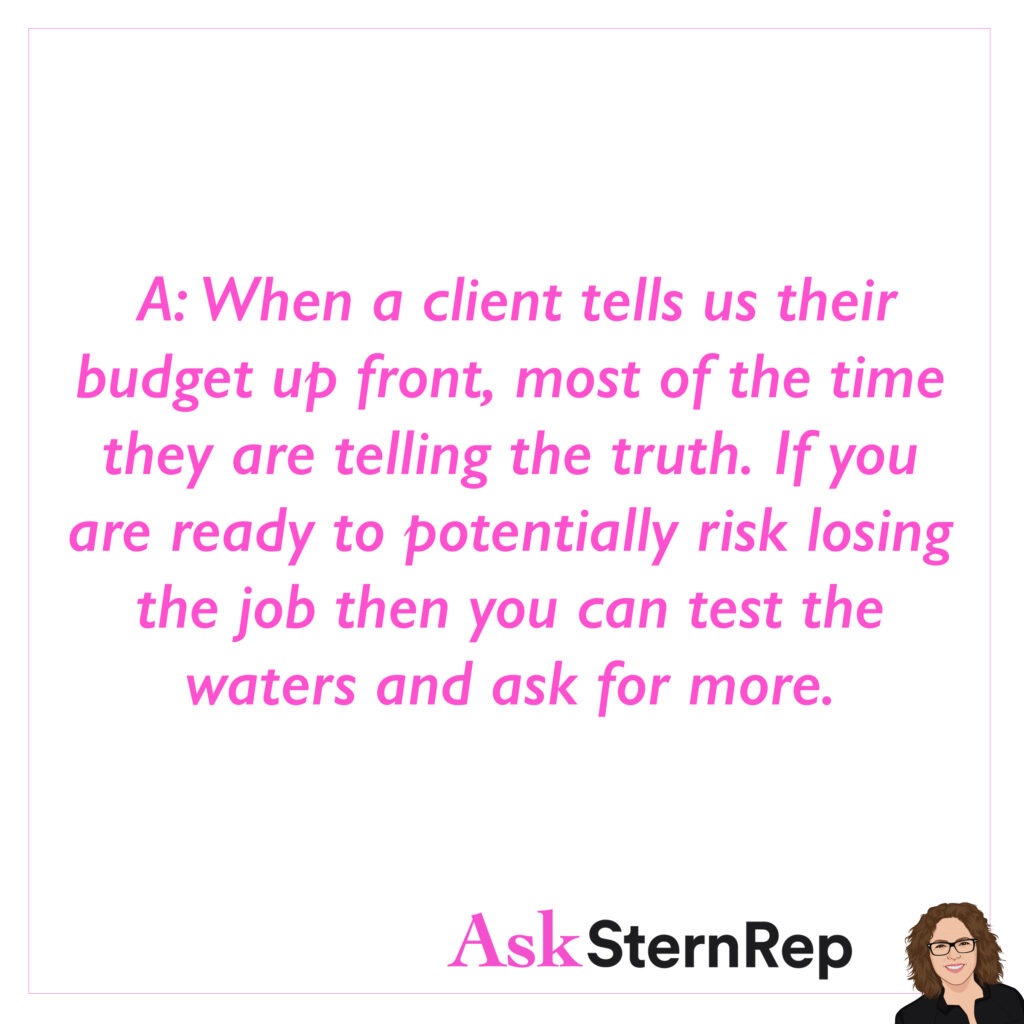
Q:
When a client emails and gives you a fee straight away (without asking for your rate), how much room do you think there actually is for negotiating?
A:
When a client tells us their budget up front, most of the time they are telling the truth. If you are ready to potentially risk losing the job then you can test the waters and ask for more.
The Overall Purpose of the Creative Call
The overall purpose of the creative phone call is to give the client a sense of what it’s like to work with you.
Creative calls are crucial to conveying to art directors and art producers that you understand their concept. We’ve heard from art producers that you could be third in the bidding but you can become first if the creative call goes really well. That’s how important it is. Not to get you nervous, but they want to hear that it’s their baby and you understand it. You’re going to bring it to life as they see it.
Photography Business Websites
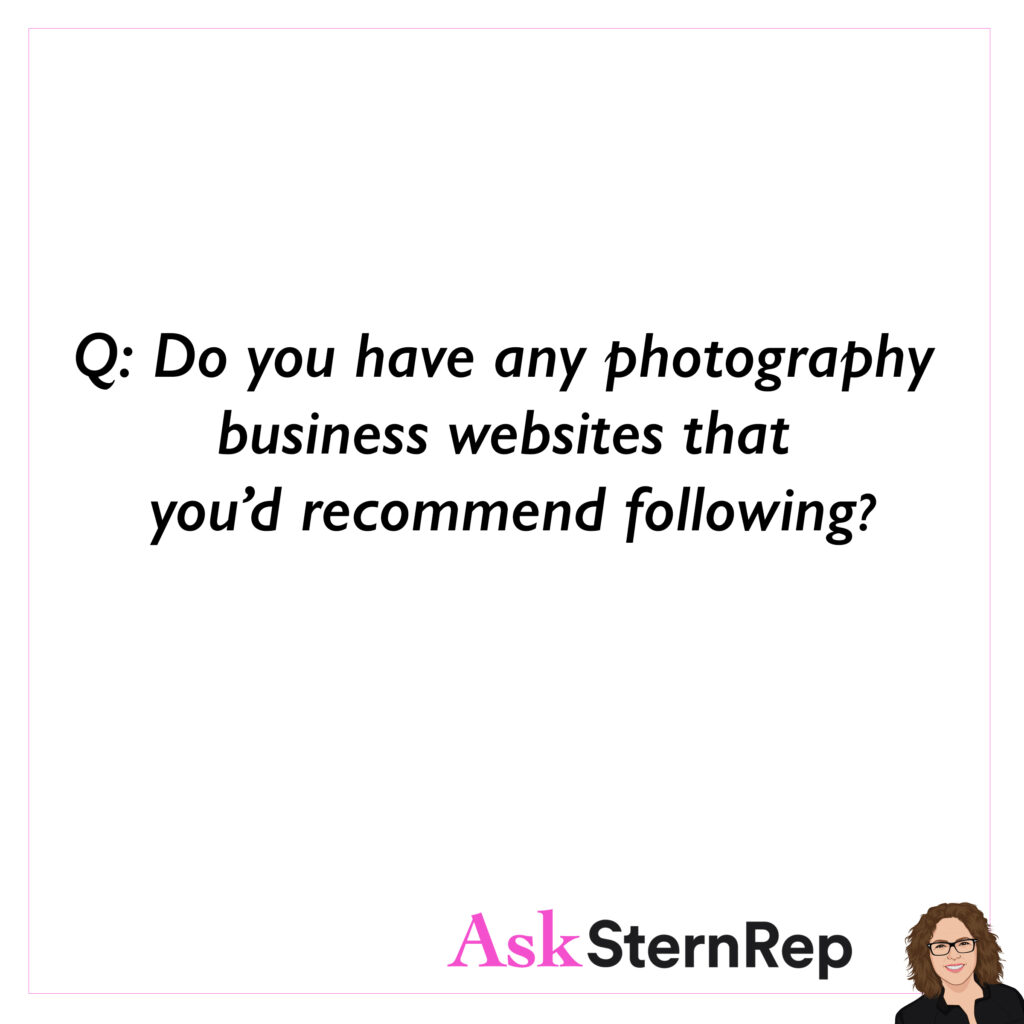
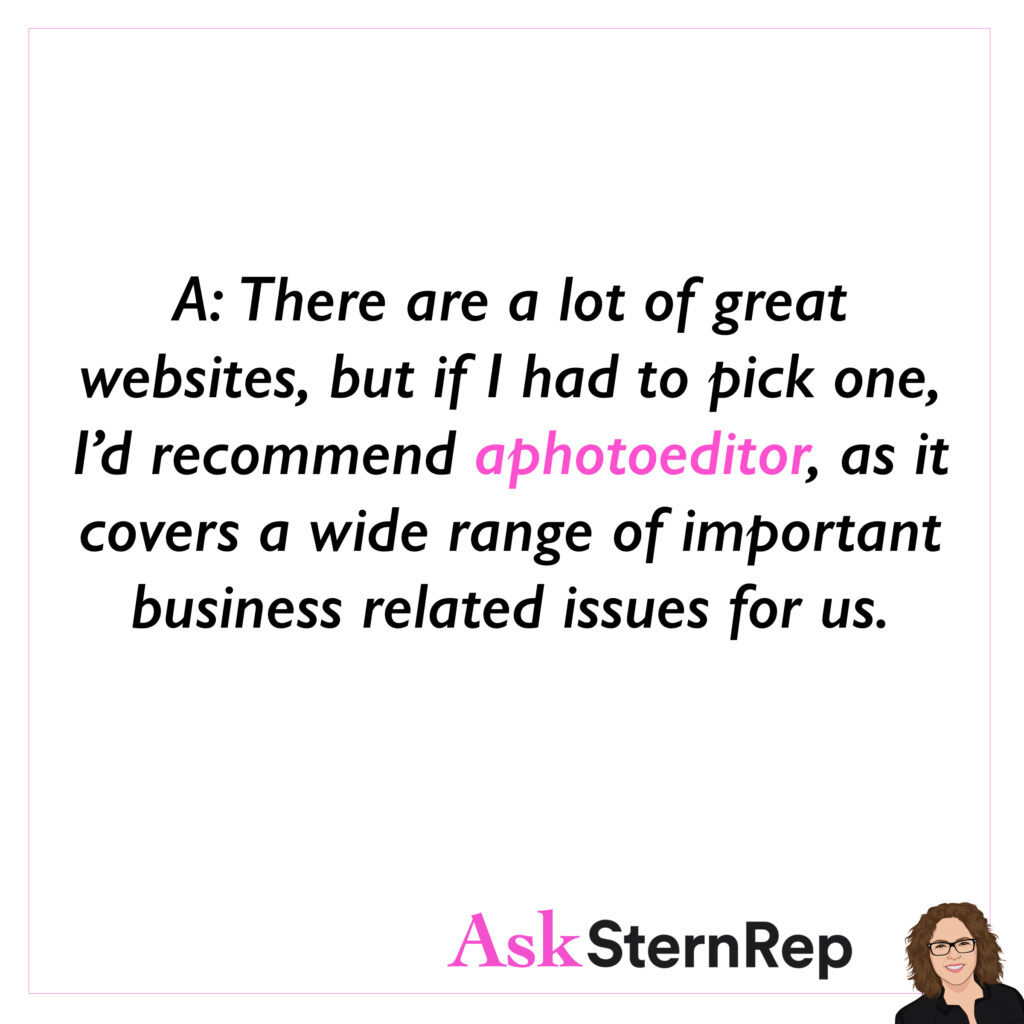
Q:
Do you have any photography business websites that you’d recommend following?
A:
There are a lot of great websites, but if I had to pick one, I’d recommend aphotoeditor, as it covers a wide range of important business related issues for us.
Quickest Way to Get Your Email Deleted
The quickest way to get your marketing email deleted is to show all the other cc’d names in your mass email.
Emails are our basic way of communicating nowadays but mass email or any kind of spam will be deleted by the recipient. If you make it sound like your email was sent to a bunch of people and not to that person, we would bet 99% of people are going to delete it. Write to specific people. If you do have to do a mass email, make sure you blind copy them. Try to use their name and personalize as much as possible.
Standard Usage Fee


Q:
What kind of usage are you including as part of the creative fee? Is there any kind of standard usage fee?
A:
I don’t know of a standard usage as it always depends on the duration, the location, and the type of usage. The only standard would be “Unlimited usage for an Unlimited duration,” which is more common these days. The one thing I can say as a rep is our favorite work is “reuse” so avoid that “Unlimited” as much as possible.
Overview on Your Website
Always have an overview with a grid of your smaller images on your website. Always. No one has time to click on every section to see your online portfolio.
There’s so many things that are right and wrong about websites and one thing we know for sure, they have to be fast. That overview must be there because people don’t have time to click on all the different topics. They just want to quickly see who you are and if you’re right for the job. The overview also makes you look more professional. If someone has to click, and click and click on your website, they’re not going to do it. People will want to scroll the overview
Getting an Advance

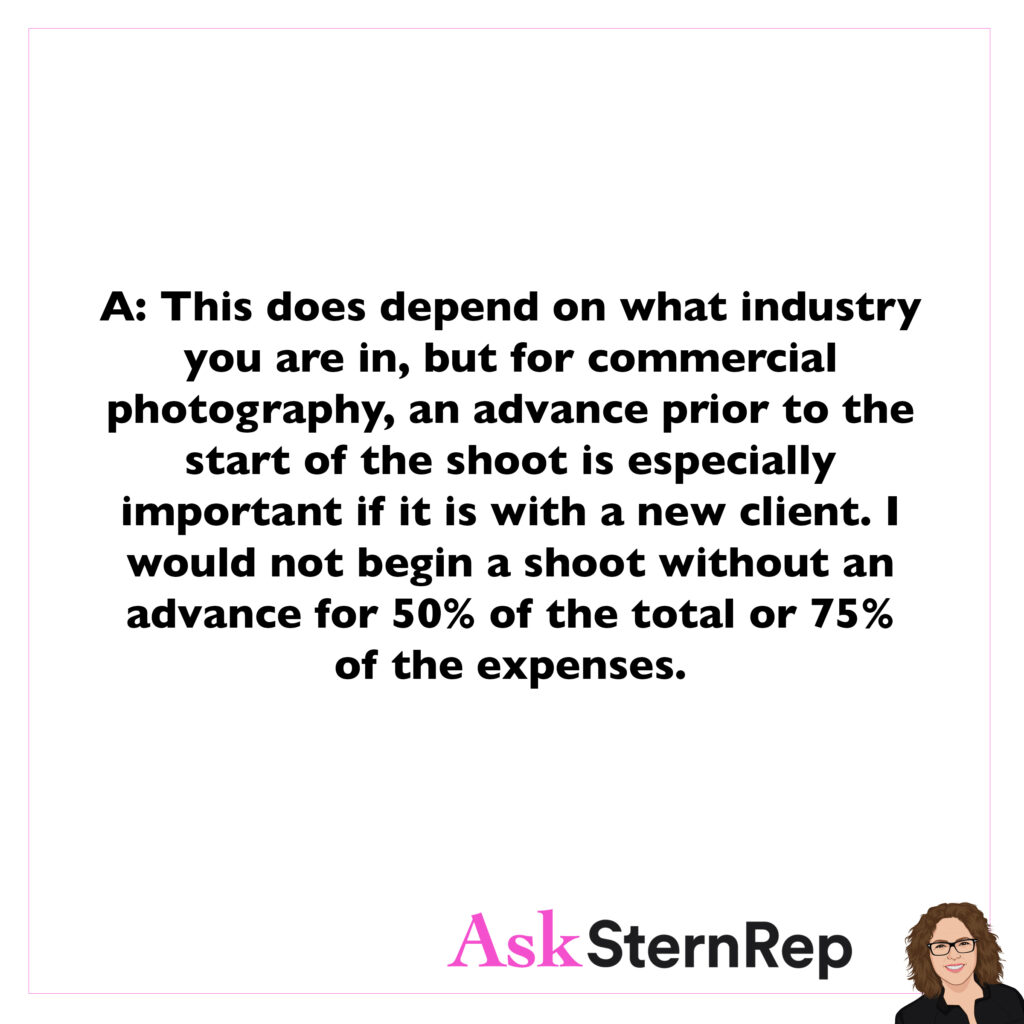
Q:
How often do you get an advance? All I hear, over and over again is, “it takes 30 days to get in the system and process payment,” etc, etc.
A:
This does depend on what industry you are in, but for commercial photography, an advance prior to the start of the shoot is especially important if it is with a new client. I would not begin a shoot without an advance for 50% of the total or 75% of the expenses.
Be Proactive On Instagram
Be proactive on instagram: follow clients + potential clients. Like their posts. Write comments. Be aggressively friendly + keep in touch w/ people. Got a new art producer contact? Follow the company…and then follow the individual. Build personal relationships. Instagram is an amazing + free way to stay in front of your clients + show them what’s happening in your world.
When I started repping there was no Instagram, obviously. Now you’re all on it, so you know what it’s all about. This is such an opportunity today and it’s so much easier to connect with people than it used to me. We find clients that are correct for our photographers and connect with them on Instagram and it really works! We end up bidding with them. These people can be almost impossible to reach by normal means. We probably couldn’t call them or email them. This is how you can reach clients.
A Cohesive Look

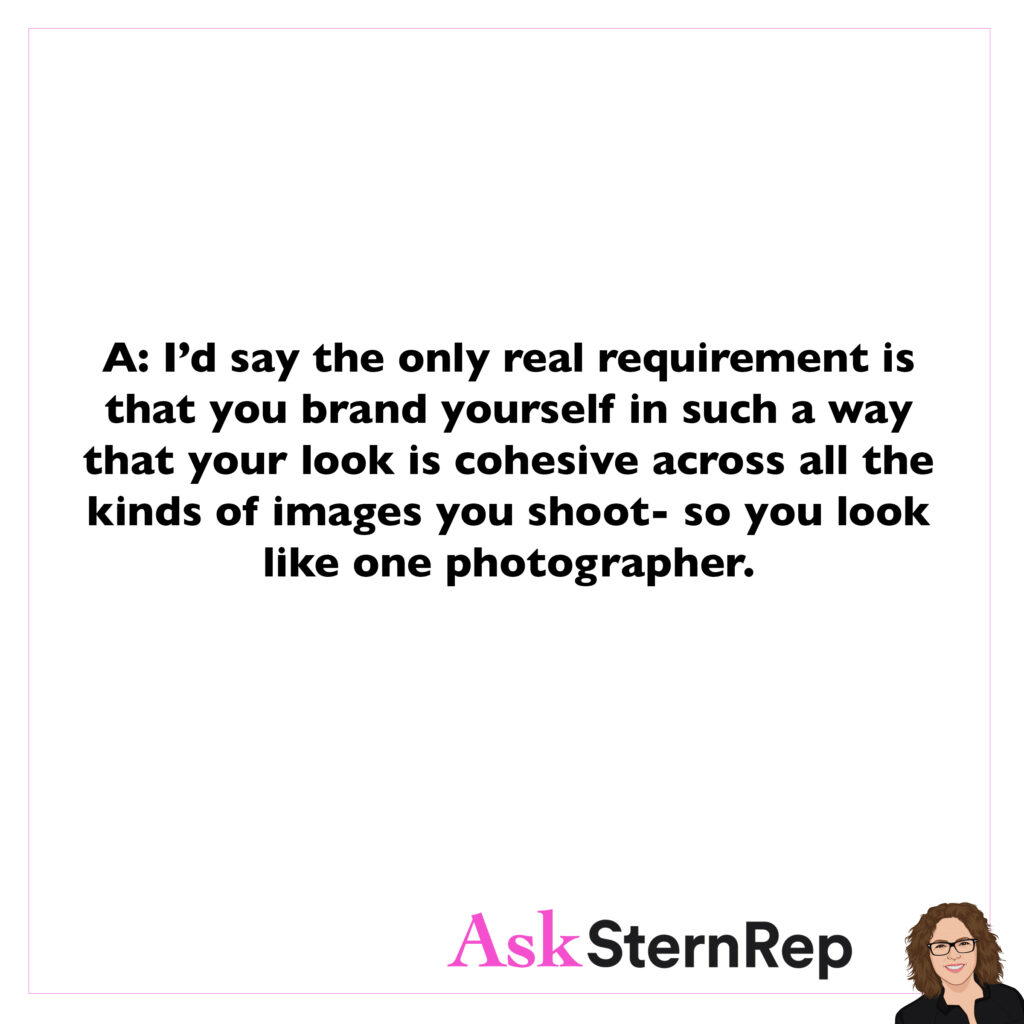
Q:
I love photographing kids, architecture, urban environments, and candid images… Is it a requirement to focus on a specific niche as a photographer?
A:
This does depend on what industry you are in, but for commercial photography, an advance prior to the start of the shoot is especially important if it is with a new client. I would not begin a shoot without an advance for 50% of the total or 75% of the expenses.
Tip on Calling a Client
When calling a client, only call from the phone you want them to call you back on. We always want the easiest/fastest route.
(leaving a message with a different phone number is way too cumbersome)
I’ve gotten called and people leave a message, “but call me on this other number.” Well I’m driving or I have to find a pen or type in this new number. How are we supposed to do that these days. It takes too much work and we can’t do that. Quick, quick, quick.
Cold Emailing Clients


Q:
When cold emailing clients you’d like to work with, is it a good or bad idea to include an image or attachment of your work in the email? What are some things to avoid when cold emailing?
A:
Good or bad is not totally relevant in our world of marketing because to market your branding may be very different from what other photographers do. Try everything and see what sticks. Some companies block emails with images, most people do not open attachments for their safety, and others prefer just a link to click it. Try it all!
Top 10 Secrets to Success
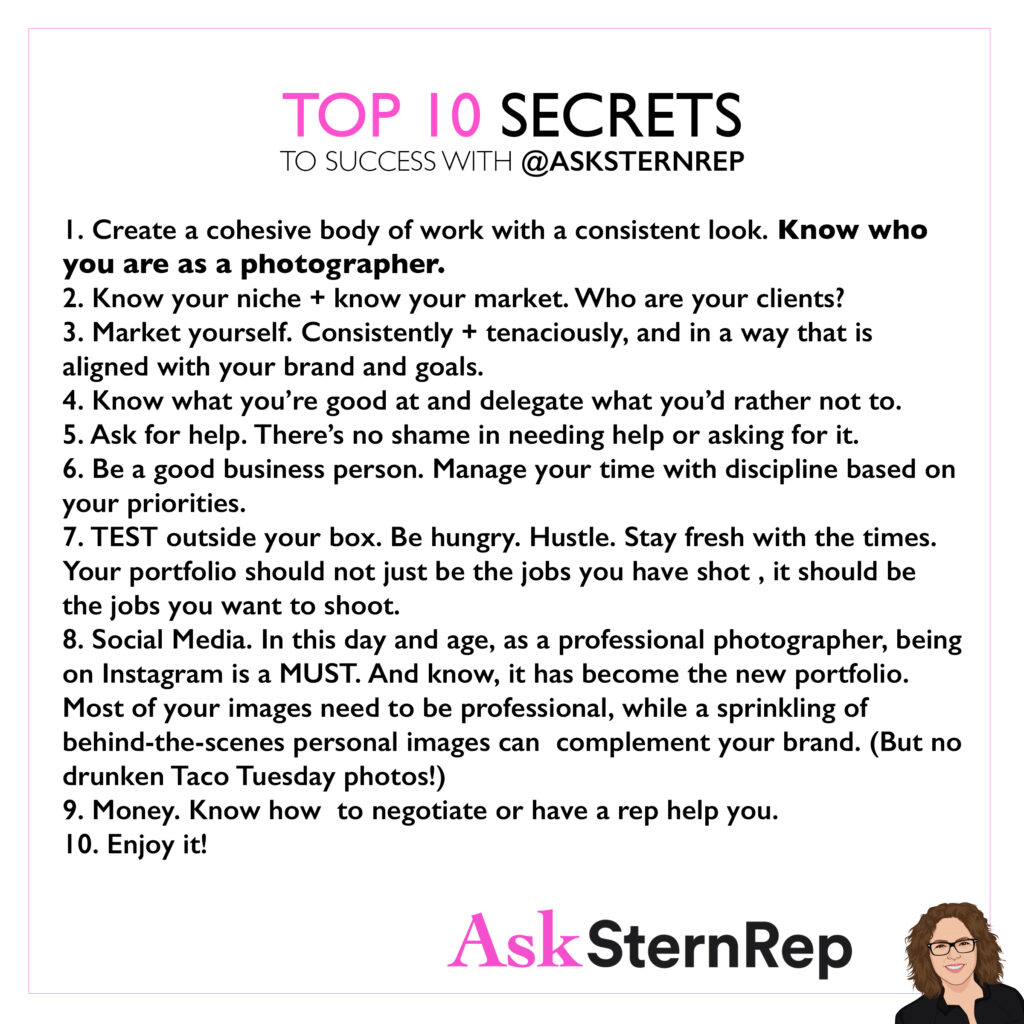
TOP 10 SECRETS
TO SUCCESS WITH @ASKSTERNREP
-
Create a cohesive body of work with a consistent look. Know who you are as a photographer.
-
Know your niche + know your market. Who are your clients?
-
Market yourself. Consistently + tenaciously, and in a way that is aligned with your brand and goals.
-
Know what you’re good at and delegate what you’d rather not to.
-
Ask for help. There’s no shame in needing help or asking for it.
-
Be a good business person. Manage your time with discipline based on your priorities.
-
TEST outside your box. Be hungry. Hustle. Stay fresh with the times. Your portfolio should not just be the jobs you have shot , it should be the jobs you want to shoot.
-
Social Media. In this day and age, as a professional photographer, being on Instagram is a MUST. And know, it has become the new portfolio. Most of your images need to be professional, while a sprinkling of behind-the-scenes personal images can complement your brand. (But no drunken Taco Tuesday photos!)
-
Money. Know how to negotiate or have a rep help you.
-
Enjoy it!
POST CONSISTENTLY

*Instagram*
POST CONSISTENTLY. Post consistently. Post consistently. Did I say post consistently yet?
Post consistently.
Staying Firm on Pricing


Q:
What is your suggestion for how to navigate this world where every client seems to want more and more deliverables? Trying to stand firm on pricing feels hard when many are charging less.
A:
The best way to stand firm on pricing is to become more valuable with a strong style. If your style is unique to you, then they will need to find the budget to hire you.
Freshness in Your Approach
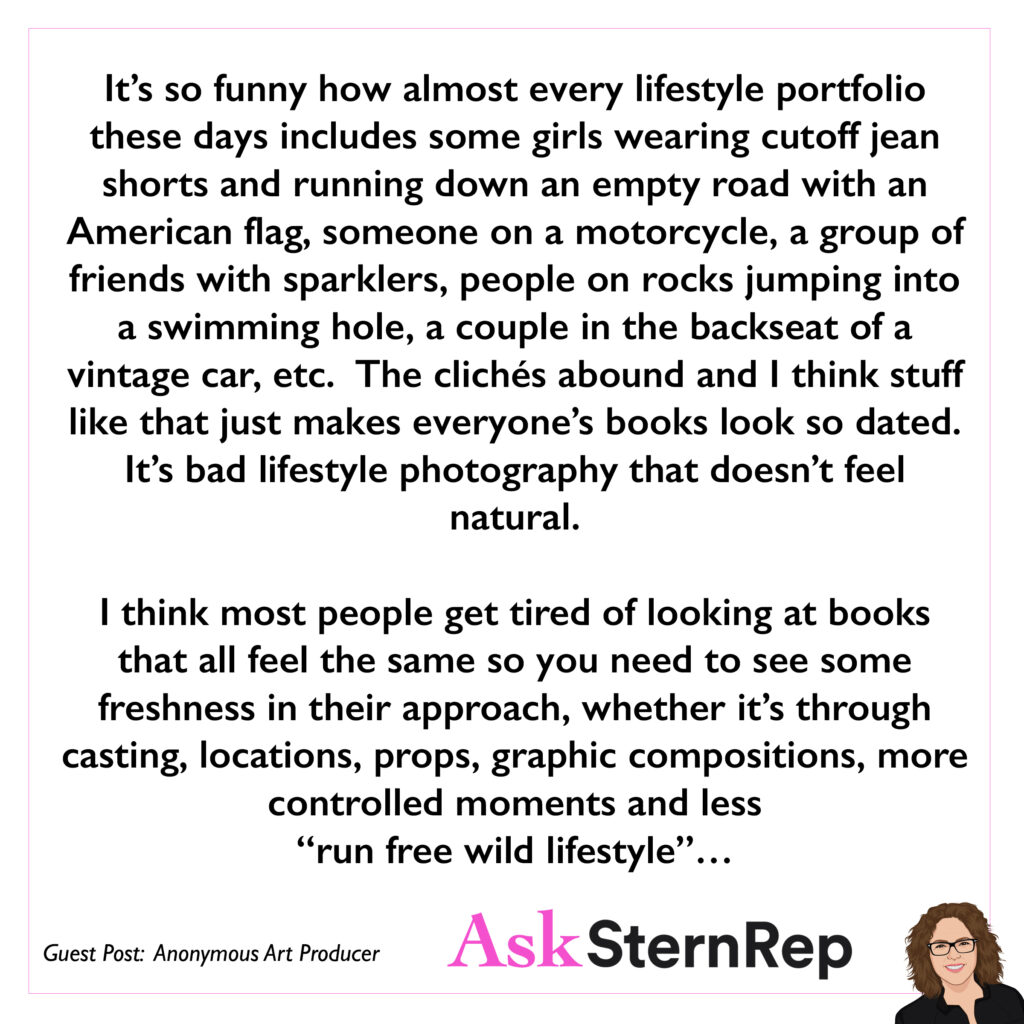
“It’s so funny how almost every lifestyle portfolio these days includes some girls wearing cutoff jean shorts and running down an empty road with an American flag, someone on a motorcycle, a group of friends with sparklers, people on rocks jumping into a swimming hole, a couple in the backseat of a vintage car, etc. The cliches abound and I think stuff like that just makes everyone’s books look so dated. It’s bad lifestyle photography that doesn’t feel natural.
I think most people get tired of looking at books that all feel the same so you need to see some freshness in their approach, whether it’s through casting, locations, props, graphic compositions, more controlled moments and less ‘run free wild lifestyle’…”
Guest Post: Anonymous Art Producer
Focus on One Genre
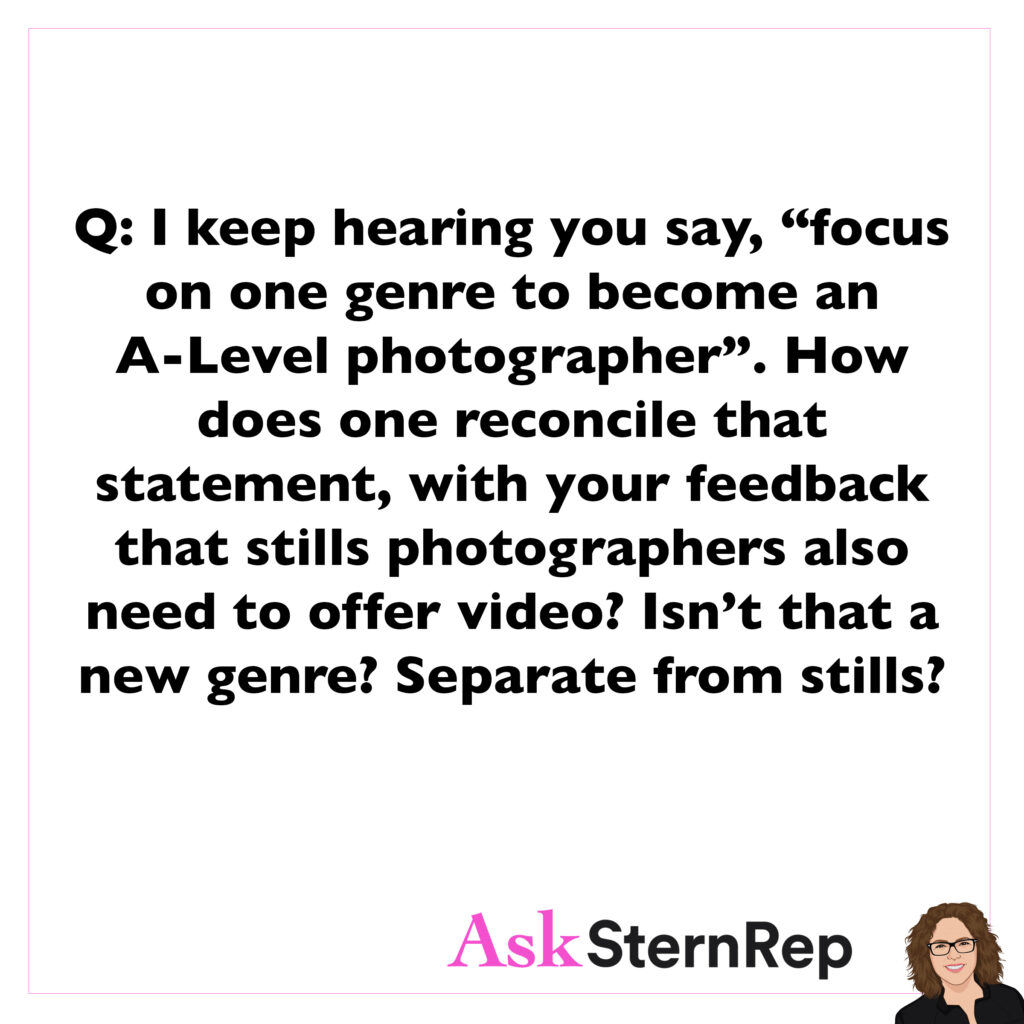

Q:
I keep hearing you say, “focus on one genre to become an A-Level Photographer.” How does one reconcile that statement, with your feedback that stills photographers also need to offer video? Isn’t that a new genre? Separate from stills?
A:
Today’s photographer is also shooting video. We can’t fight this need for more and more content. It’s the way of the world. When asked if you do motion, your A-level photographer response should be: “Yes, I do motion in the same style in which I shoot my stills.” Use motion to confirm the style you have built with stills.
50% Advance

ALWAYS GET A 50% ADVANCE FOR A PHOTOSHOOT.
Following Agencies


Q:
If agencies are “following” you, what, if anything, would you recommend doing?
A:
If agencies are following you on Instagram – be proactive and engage them. Follow that hot lead and make the most of it by engaging them on social media, contact them on LinkedIn, and get them on your promo list. Use them ‘following’ you as a way to get your foot in the door!!
Make Links Clickable
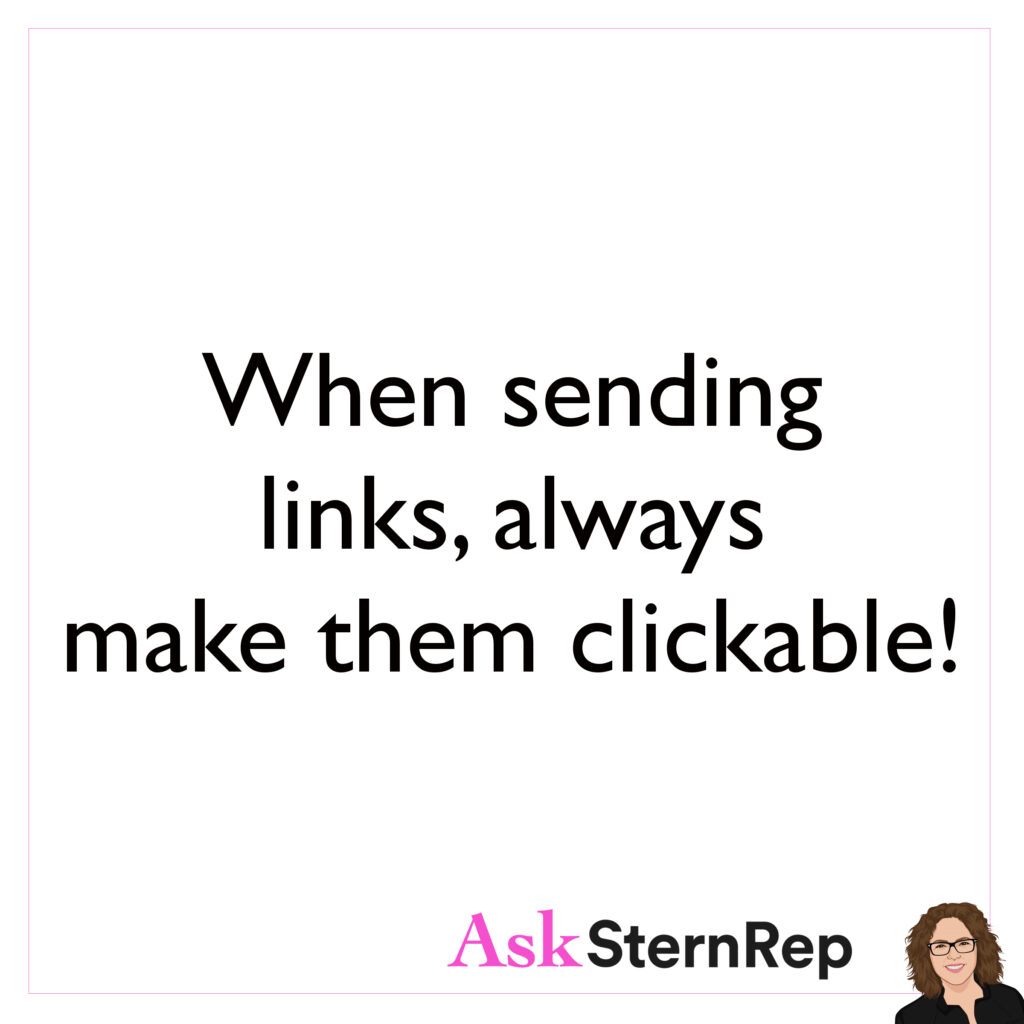
When sending links, always make them clickable!
Too Low on a Bid


Q:
How do I know if I am too low on a bid?
A:
If the client responds to your bid by asking if you have enough for certain line items like “location scout” etc, then you can assume you are too low. At that point I’d be direct and explain how you were assuming the budget was low, but you may have been mistaken. This can be turned into a positive to show your excitement for the project. Has anyone had an experience like this you’d like to share?
Using Instagram as a Portfolio


Q:
Should a photographer edit and cull their Instagram page to make it look like a professional portfolio? If my Insta has some commercial work, behind-the-scenes shots, but also smartphone shots of my puppy, is that a huge turn-off?
A:
Instagram needs to be your 2nd portfolio. Just as your website has your ABOUT section, which brings a bit of personal info to it – same goes for Instagram. I’d suggest for instagram; 80% portfolio and 20% personal.
ALTHOUGH, the personal should really still be images that are interesting to your clients. THey love seeing locations you are working in and learning/knowing any interesting info about you. They want to know who you are and what your hobbies are. They don’t really need to know what your pets look like.
One Way to Impress a Client

One important way to impress the client on the creative call is to research them before the call. Bring your knowledge of their company into the call.
Advice on Cold Emailing
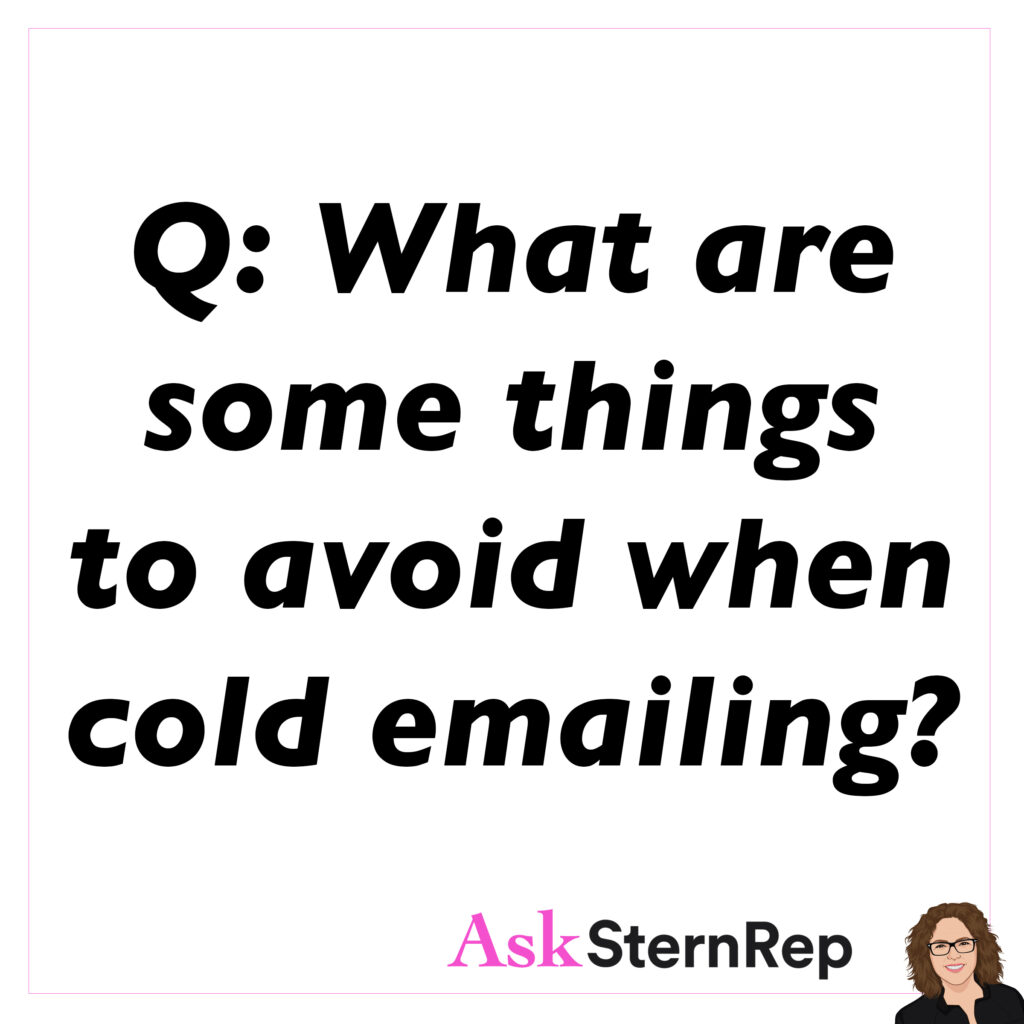
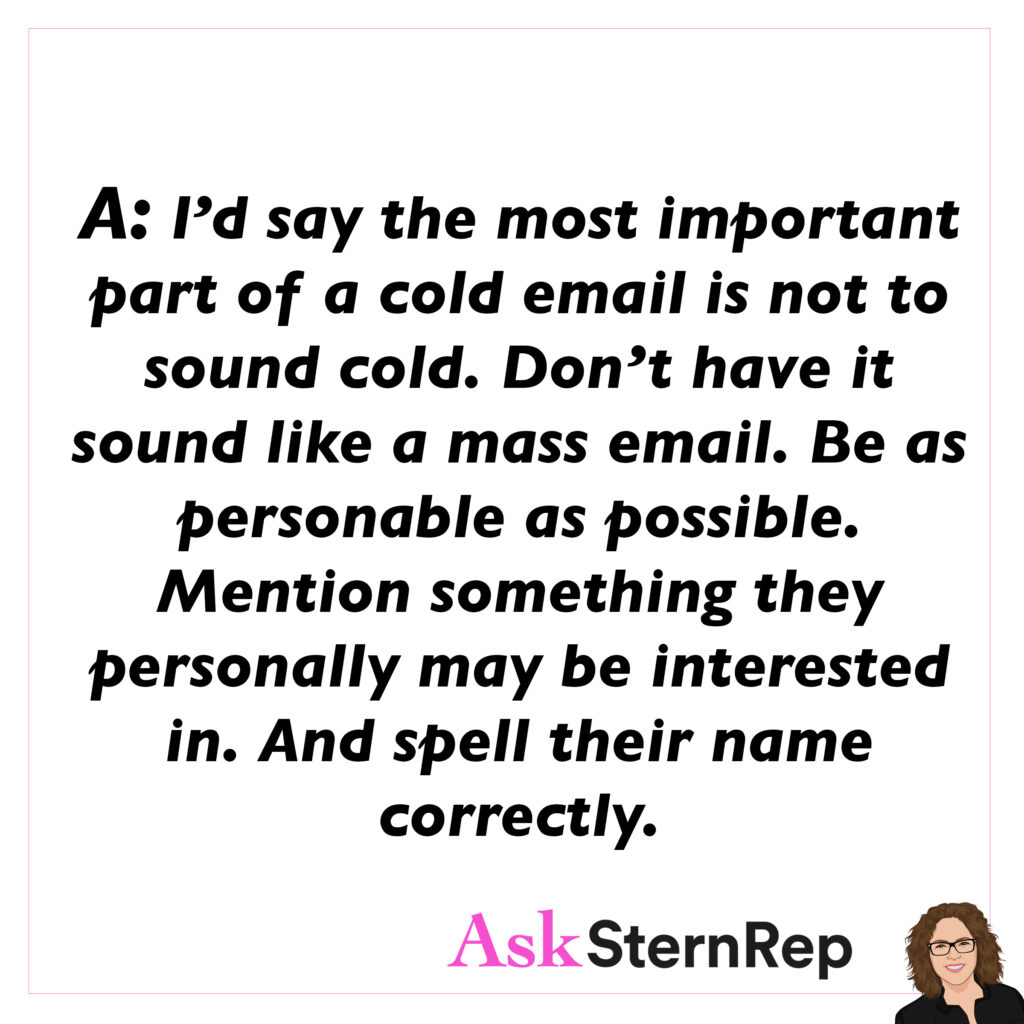
Q:
What are some things to avoid when cold emailing?
A:
I’d say the most important part of a cold email is not to sound cold. Don’t have it sound like a mass email. Be as personable as possible. Mention something they personally may be interested in. And spell their name correctly.
Email Blasts


Q:
How often do art buyers respond to email blasts? How enthusiastic should a photographer actually be about positive feedback from an email blast?
A:
Never. When sending out emails, don’t expect to get any responses. The point of an email blast is not to get responses, and they know that. The point of an email blast is to send out as many emails as possible to the correct clients to show them your work.
Introduce Yourself

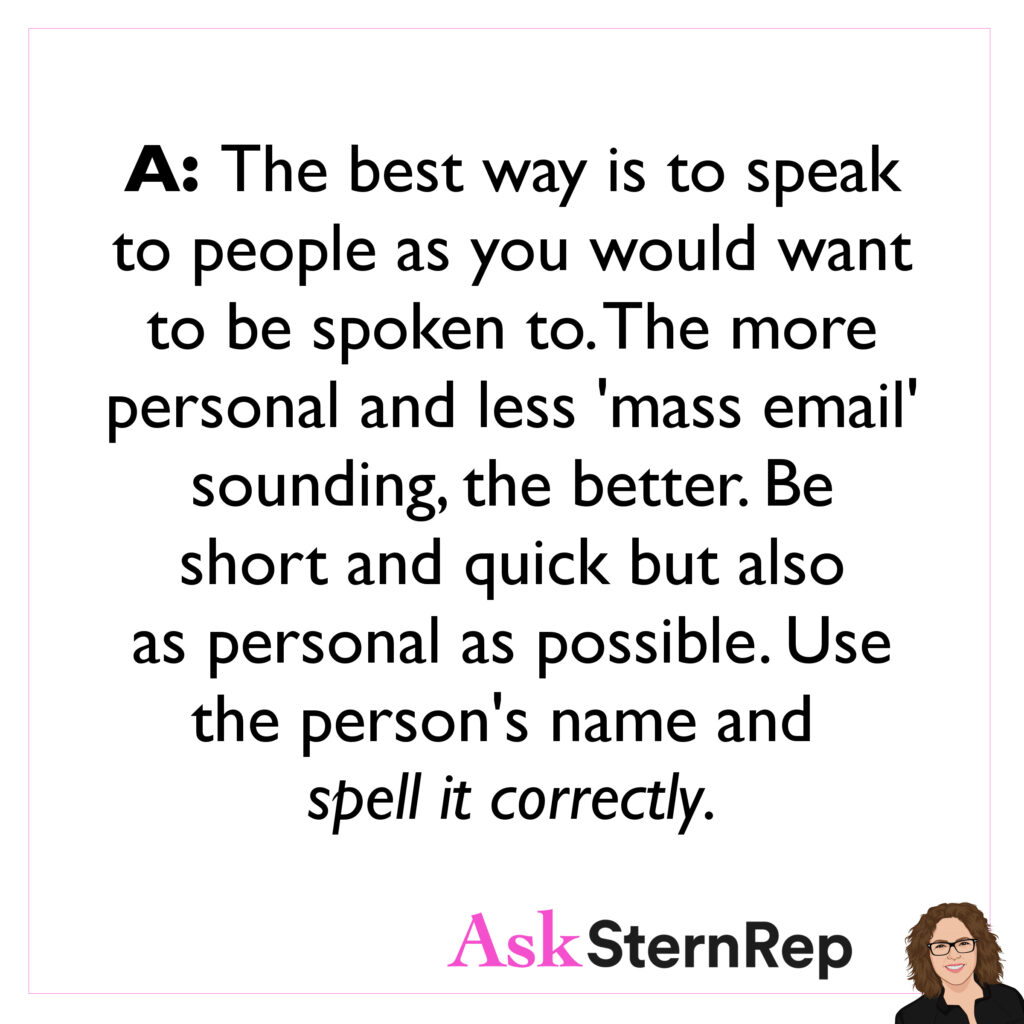
Q:
When sending newsletters/promos to new clients or agents, is there a polite way to introduce yourself other than the generic, “Hey, I’m a new photographer in the area, etc.?” In essence, when photographers reach out to you, how do you like to be “asked?”
A:
The best way is to speak to people as you would want to be spoken to. The more personal and less ‘mass email’ sounding, the better. Be short and quick but also as personal as possible. Use the person’s name and spell it correctly.
Diluting Your Brand


Q:
Having a hard time with a long term direction! If I feel I am effective in multiple areas, is it worth promoting myself in those multiple areas, or should I just pick ONE?
A:
In my opinion, being an A-level photographer is based on your style, your look, your vibe. This solid branded look can work across different industries and clients. Even if you are getting work across a variety of fields, the key is to make sure your style is consistent throughout. When your portfolio looks like you could be different photographers, this dilutes your branding and may only work if you want to get jobs in a smaller city.
Client Budget
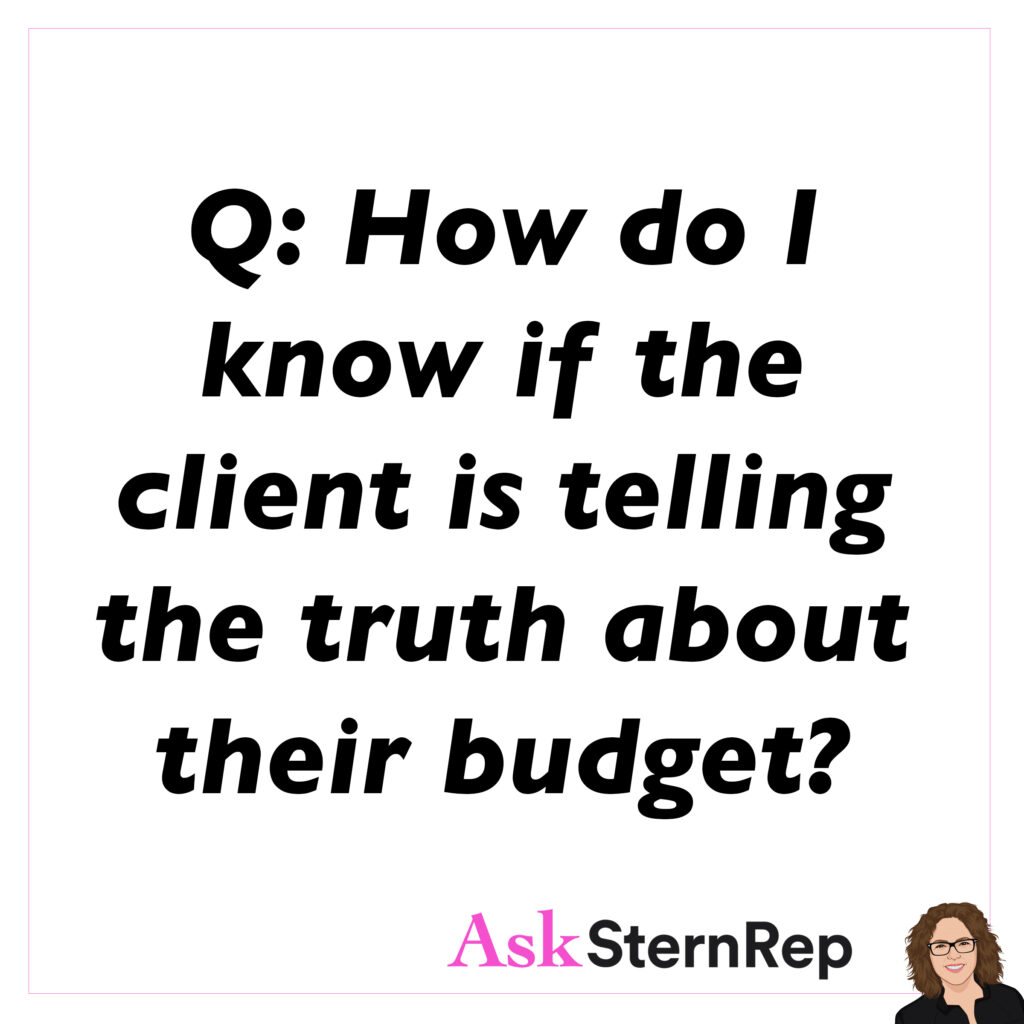
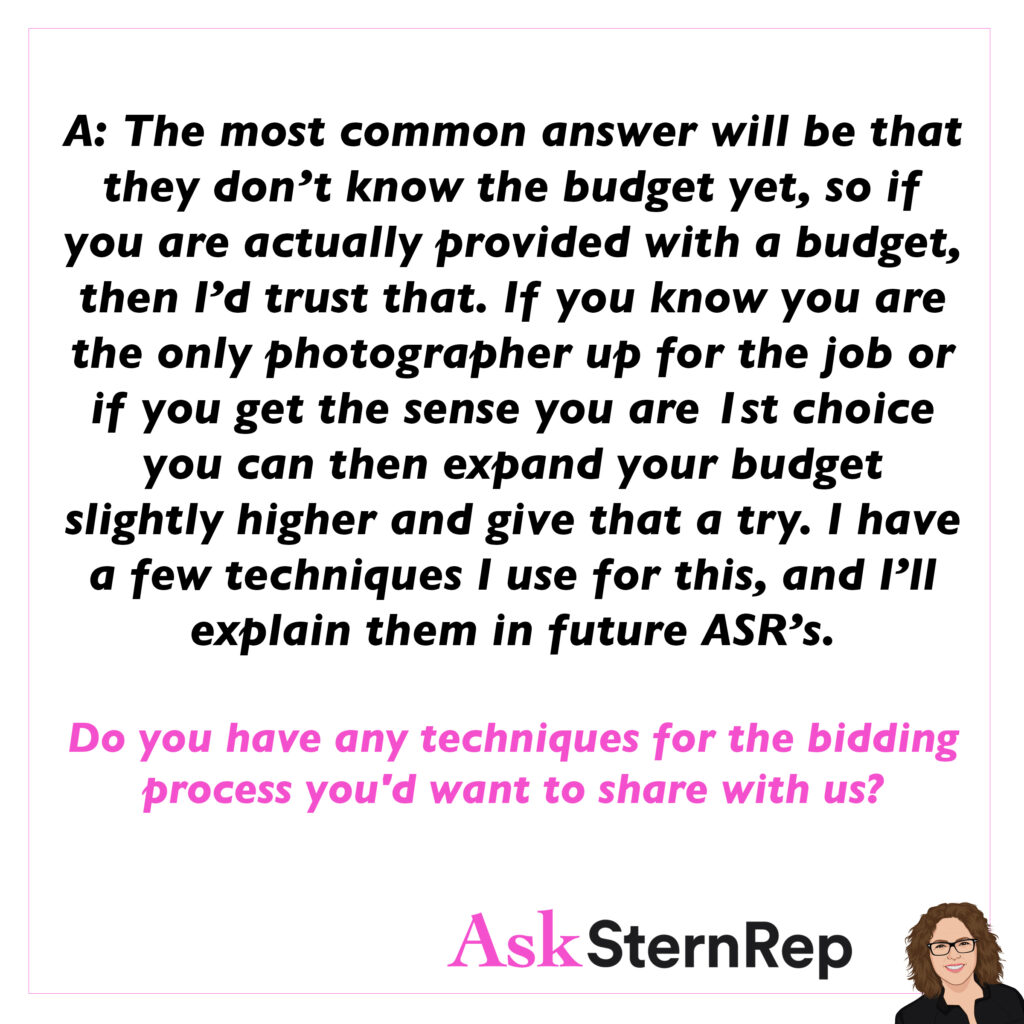
Q:
How do I know if the client is telling the truth about their budget?
A:
The most common answer will be that they don’t know the budget yet, so if you are actually provided with a budget, then I’d trust that. If you know you are the only photographer up for the job or if you get the sense you are 1st choice you can then expand your budget slightly higher and give that a try. I have a few techniques I use for this, and I’ll explain them in future ASR’s.
Do you have any techniques for the bidding process you’d want to share with us?
Do You Need a Producer?

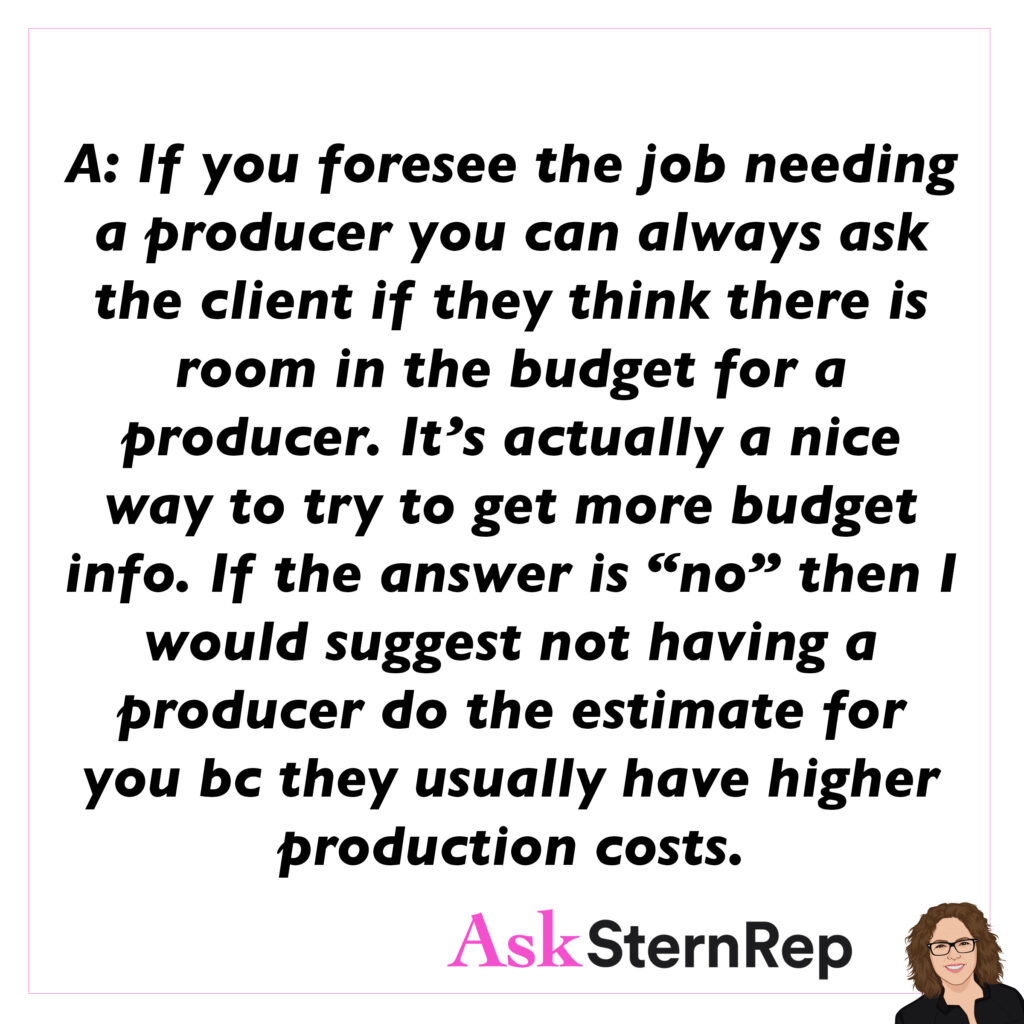
Q:
How do you know if you need a producer or not on your job?
A:
If you foresee the job needing a producer you can always ask the client if they think there is room in the budget for a producer. It’s actually a nice way to try to get more budget info. If the answer is “no” then I would suggest not having a producer do the estimate for you because they usually have higher production costs.
Asking What You’re Worth
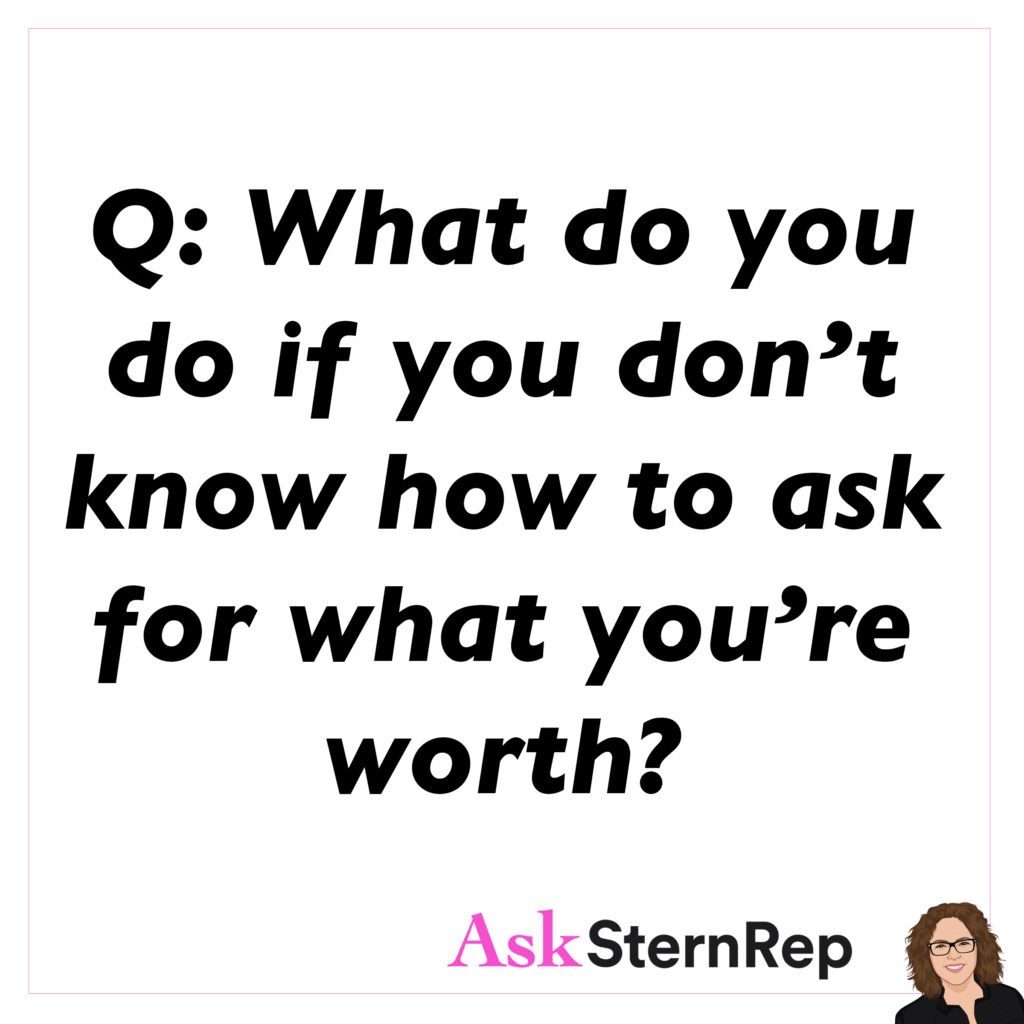

Q:
What do you do if you don’t know how to ask for what you’re worth?
A:
This is common and most freelancers don’t know how to rate themselves fairly while balancing out competition, usage or market prices. My approach is to connect with the client on the phone and listen to what they often want to tell me. My favorite sales approach is honesty. It works wonders.
What is your favorite sales approach?
If You Want Better Odds of Getting Your Question Answered…

If you want better odds of getting your question answered, ask only one.
Less Is More

Less is more. The clients’ imagination is our strongest selling point
Always Address A Person With Their Name In An Email
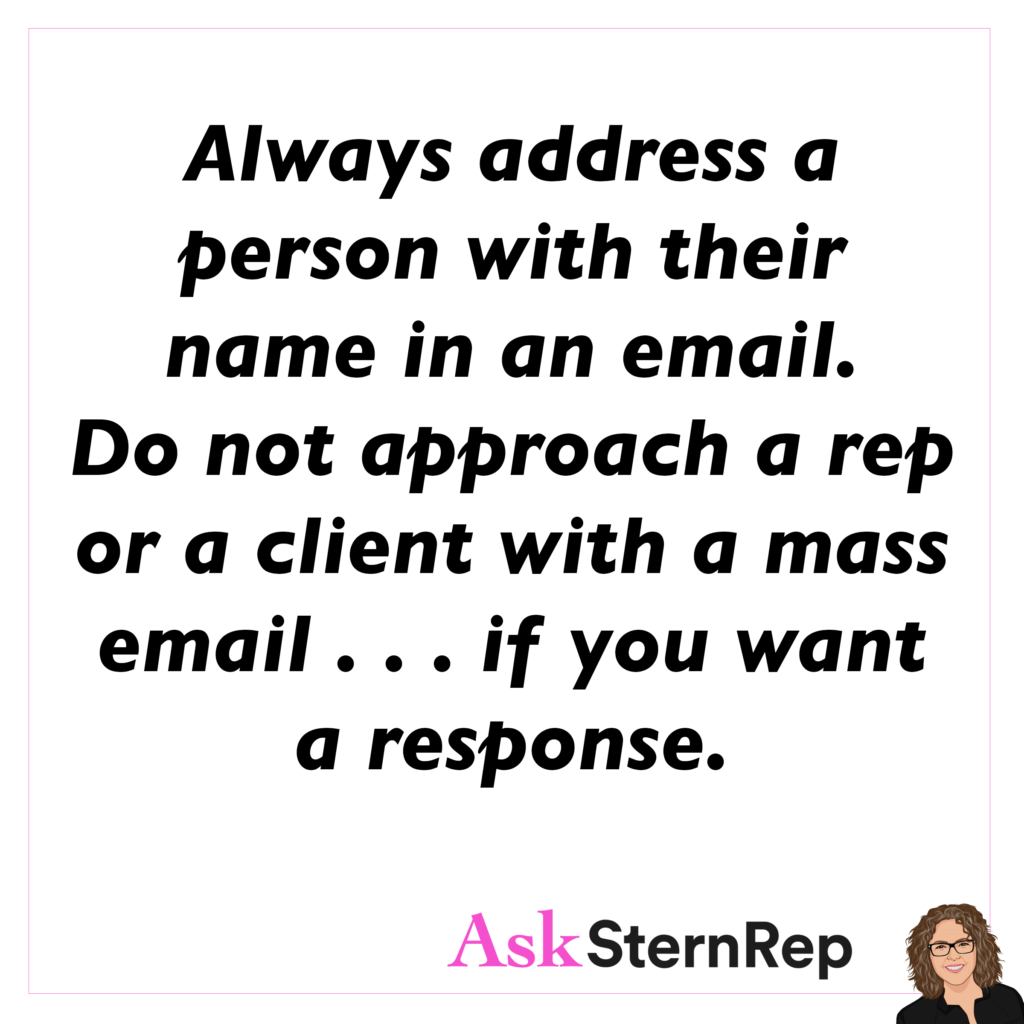
Always address a person with their name in an email. Do not approach a rep or a client with a mass email…if you want a response.
Focus On Something

The difference between an A-level & a B-level photographer is focusing on something & getting really, really good at it.
How to Become Represented


Q:
How can I become represented? It’s always been a dream to stand out and have reps on my side.
A:
Get your book as strong as you can, find your specialty and build a cohesive portfolio. Find the reps that work in your industry and approach them with a personal and quick email. The quality of your work will speak for itself and doors will open. Just get your work out there once it’s ready!
Proofread Your Emails

Proofread your emails. Spell-check. Double check that you addressed your email to the right person. Professionalism takes you to the next level.
Hard to Navigate Website
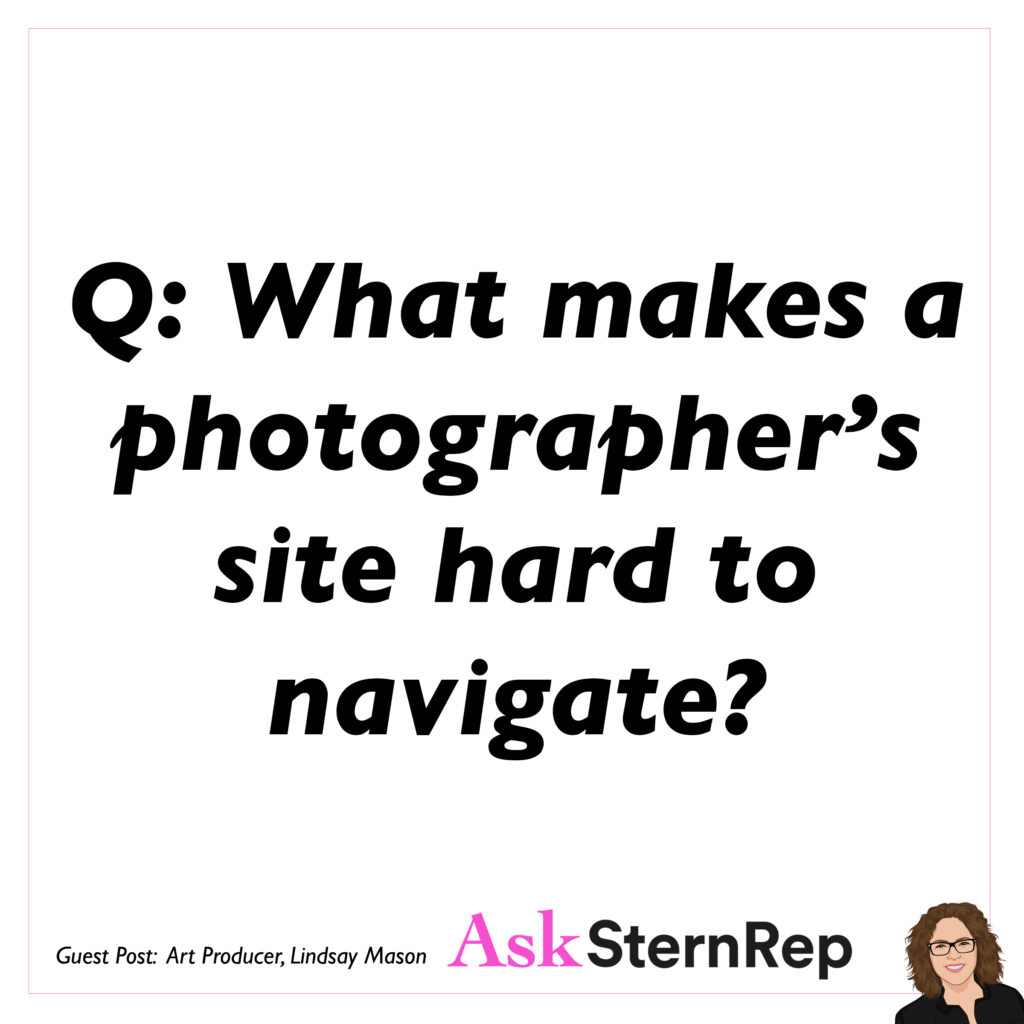

Q:
What makes a photographer’s site hard to navigate?
A:
Sites can be hard to navigate for a few reasons. Sometimes the actual menu options are hard to find because the sit template tries to get too artsy. Or sometimes you can only view images one at a time (no thumbnail view option).
We’re often trying to image search or curate a page of the photographer’s imagery, so being able to move through the site quickly is important.
I do appreciate seeing their creative touch beyond just their imagery – so a cool landing page, or some nice touch to the formatting is good. But generally, it should still be easy to navigate.
Guest Post: Art Producer, Lindsay Mason
Evaluate Your Portfolio Constantly
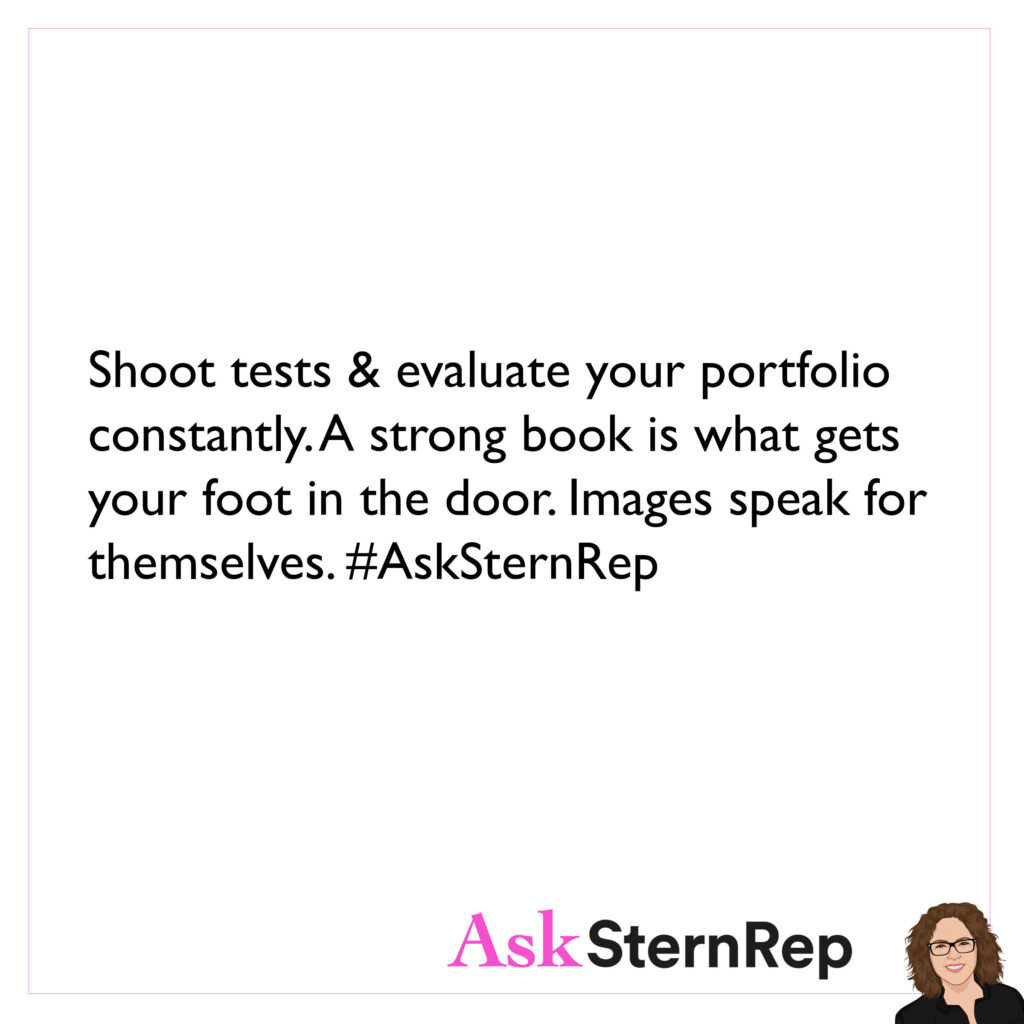
Shoot tests & evaluate your portfolio constantly. A strong book is what gets your foot in the door. Images speak for themselves.
Clients Can’t Usually Give You Numbers

Clients can’t usually give you numbers, you have to throw numbers out there for them to bring you up or down.
Working with Bigger Clients

Q:
How does a photographer transition from working with small, often-client direct companies to working with bigger clients and ad agencies?
A:
The biggest difference between getting Client Direct and Ad Agency work is a photographer’s portfolio. Client direct companies will be more understanding of a wide variety of images. Ad agencies have so many photographers to choose from that they will choose the one who specializes in that one specific topic that they are looking for. The smaller, in-house companies will often use one photographer for all of their photo needs. If Ad Agencies are your goal, identify your specialty and commit to excellence in that category.
Choose Your Top Question
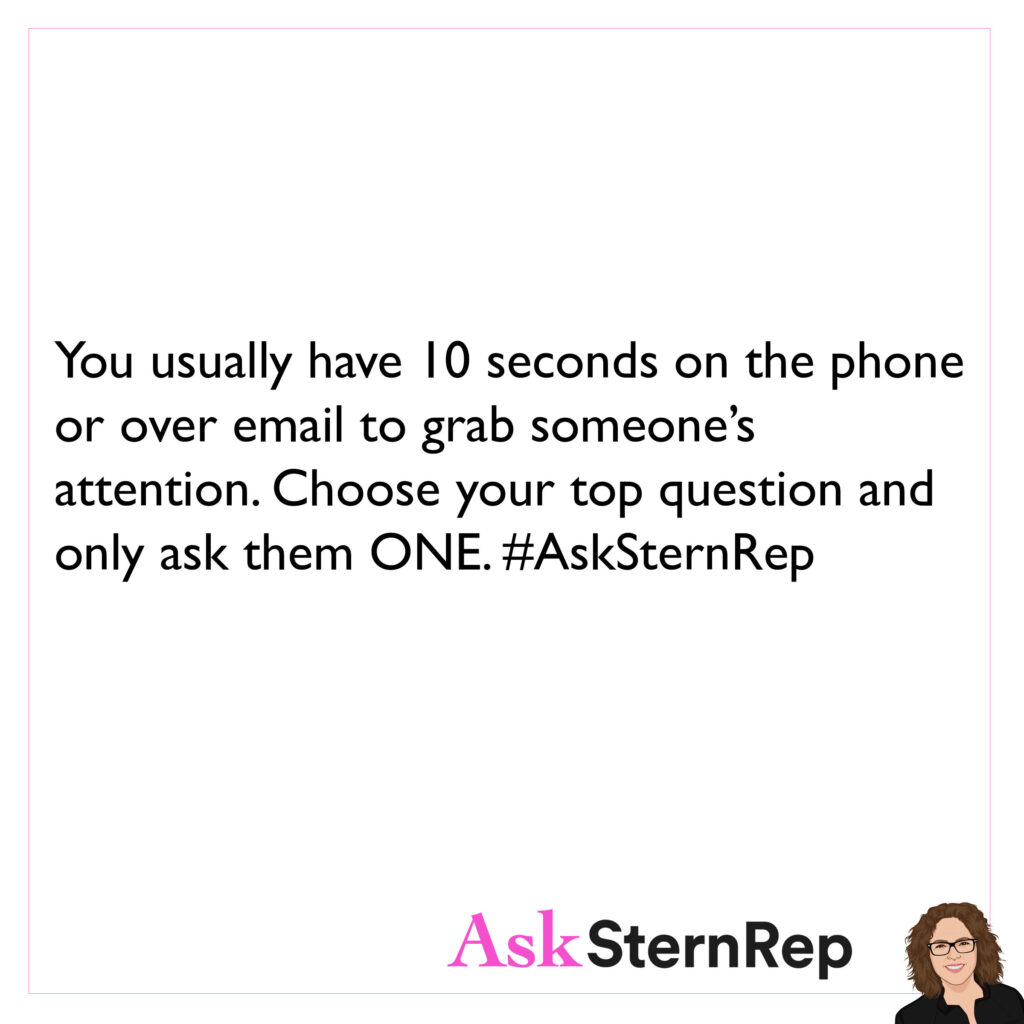
You usually have 10 seconds on the phone or over email to grab someone’s attention. Choose your top question and only ask them ONE.
Small Budgets
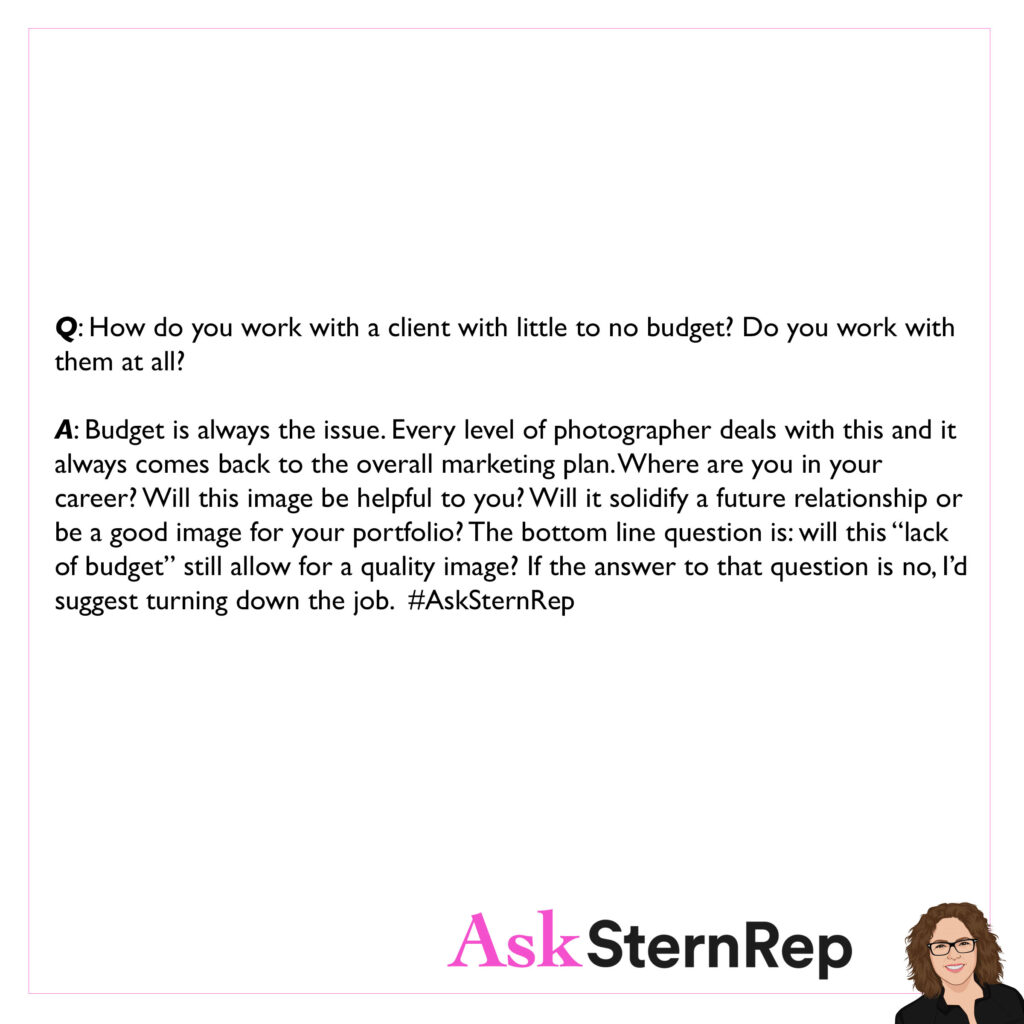
Q:
How do you work with a client with little to no budget? Do you work with them at all?
A:
Budget is always the issue. Every level of photographer deals with this and it always comes back to the overall marketing plan. Where are you in your career? Will this image be helpful to you? Will it solidify a future relationship or be a good image for your portfolio? The bottom line question is: will this “lack of budget” still allow for a quality image? If the answer to that question is no, I’d suggest turning down the job.
If You Say Too Much…

If you say too much, no one will hear you.
WARNING
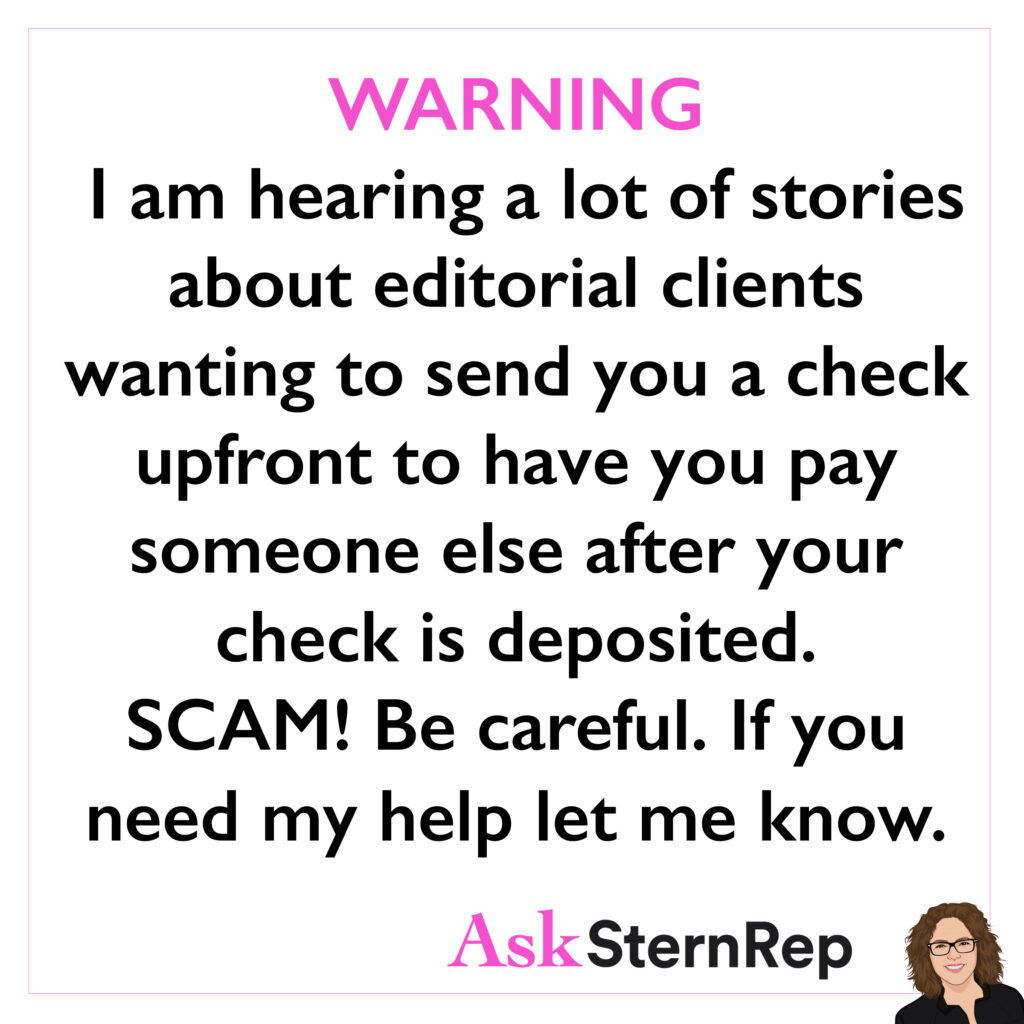
WARNING
I am hearing a lot of stories about editorial clients wanting to send you a check upfront to have you pay someone else after your check is deposited. SCAM! Be careful. If you need my help let me know.
Never Share Your Stress with a Client
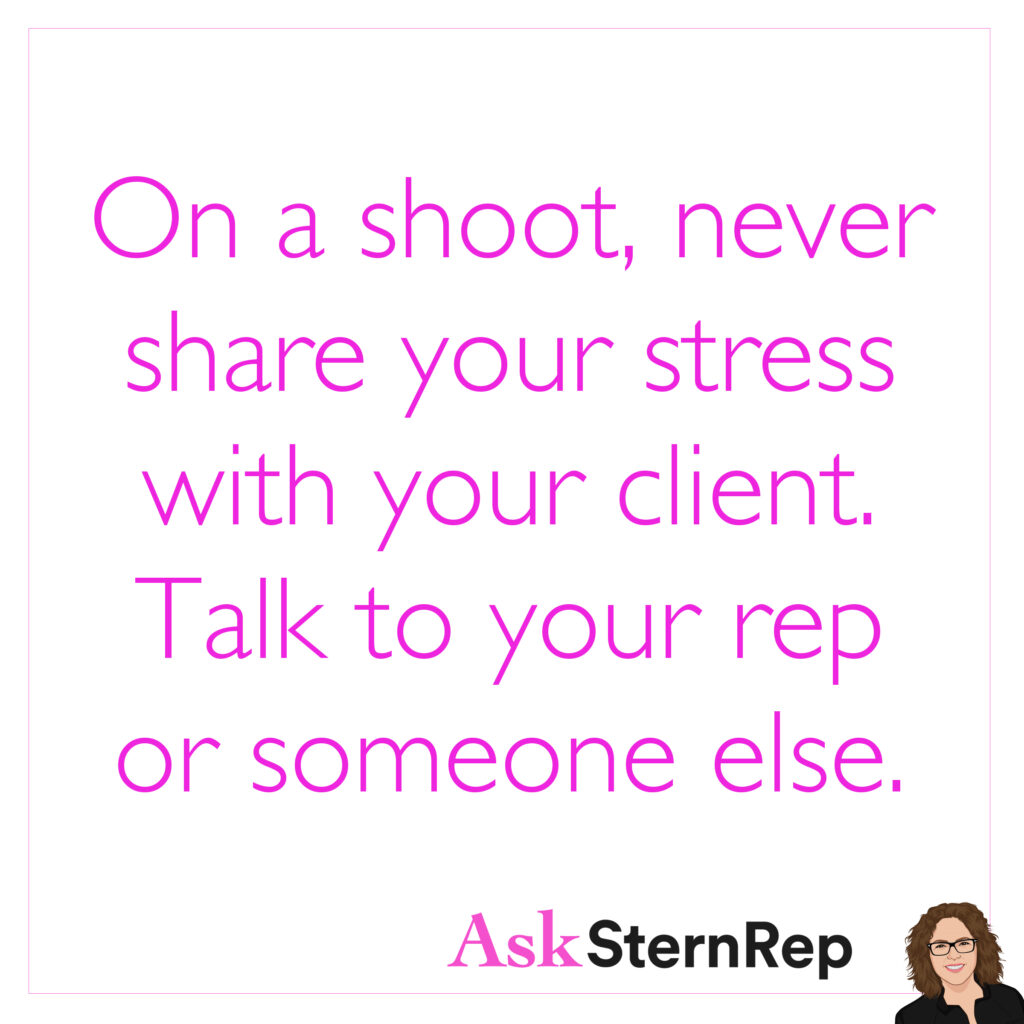
On a shoot, never share your stress with your client. Talk to your rep or someone else.
Getting Bigger Jobs


Q:
My client list isn’t huge and consists of mostly small startup companies. I’ve been on the shortlist for bigger jobs lately, but haven’t been getting awarded. The response I’ve been getting a lot is, “you have great work and we would love to work with you, but we’re going with someone who has more experience.” How do I get more experience and reputable clients under my belt when no one will give me a chance?
A:
This type of response is most often what every bidder gets that isn’t getting the job. It could mean they liked someone else’s work more, or the other photographer had the specific look they were going for. It could be that the other photographer had the specific look they were going for, was better on the creative call, or had a better treatment. It could also be their past experience with the winner, or that the winner has a rep. Mostly, I’d recommend working harder and get your book even better with more stylists involved.
On Business Calls

When you’re on a business phone call, be aware of speaking clearer and slower than you’re used to. On work calls we are less inclined to ask someone to repeat themselves. Slow it down, enunciate, and listen.
Promo Mailers


Q:
Do people still send postcards out? Are they a good way of marketing?
A:
Yes, we still send out promo mailers, as it’s important to use every possible opportunity you can think of to stay in front of clients. Not every type of marketing will work for everyone, so I like to try every method that is within our budget.
Social Media vs Blogs
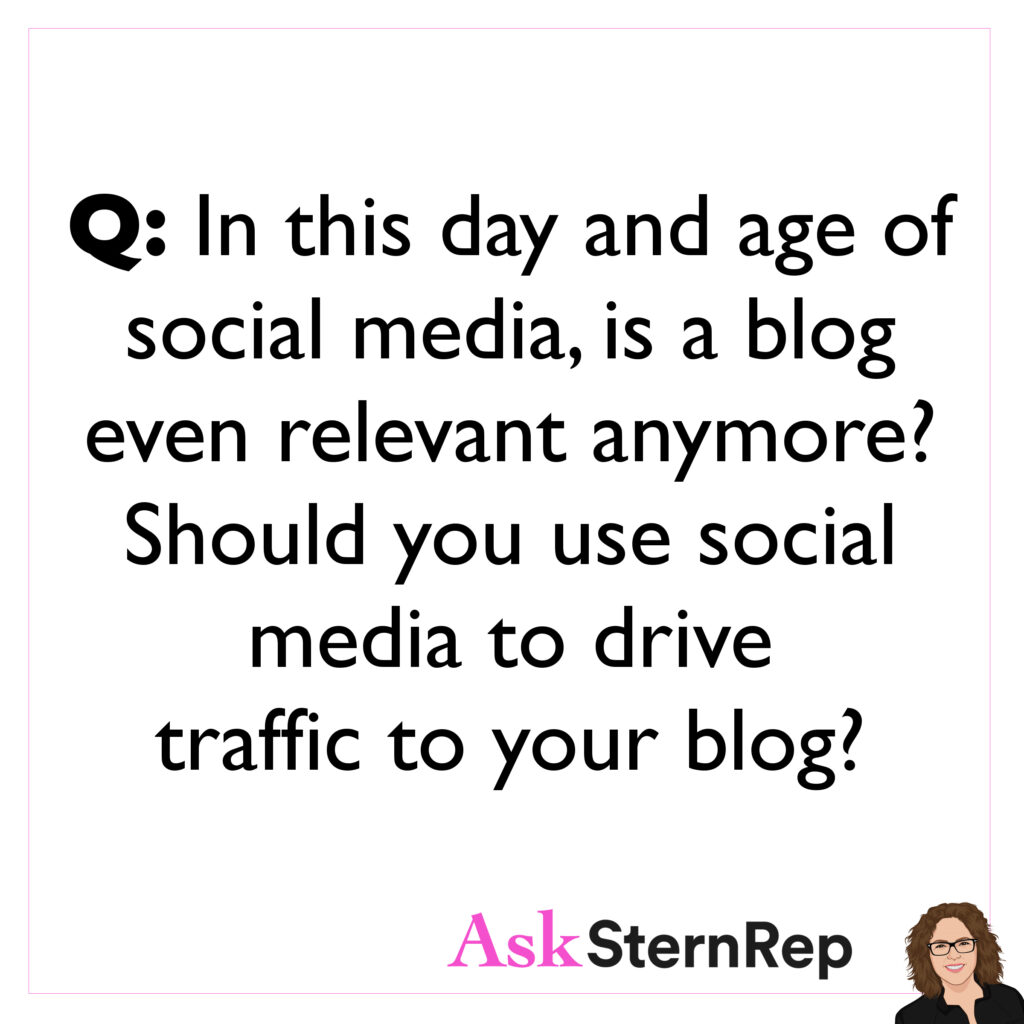
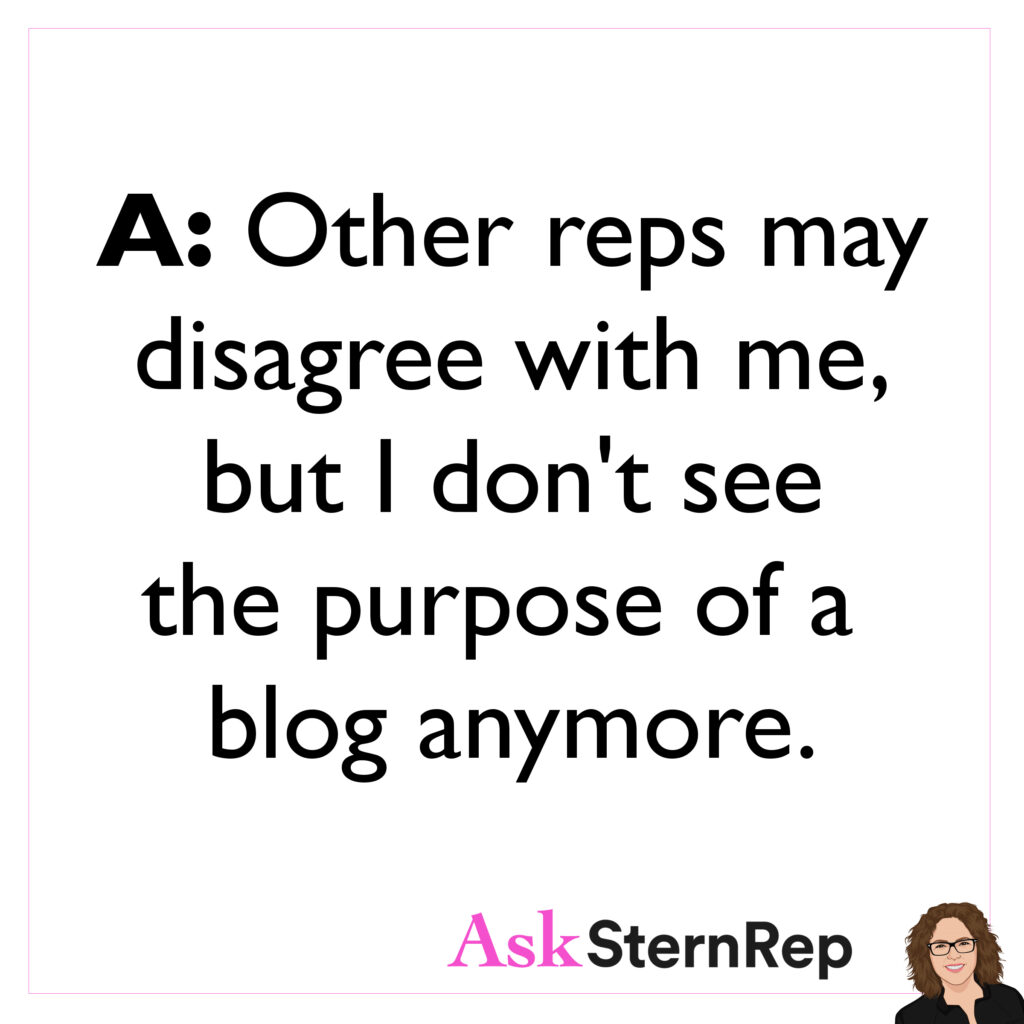
Q:
In this day and age of social media, is a blog even relevant anymore? Should you use social media to drive traffic to your blog?
A:
Other reps may disagree with me, but I don’t see the purpose of a blog anymore.
Make the Subject of Your Email Interesting
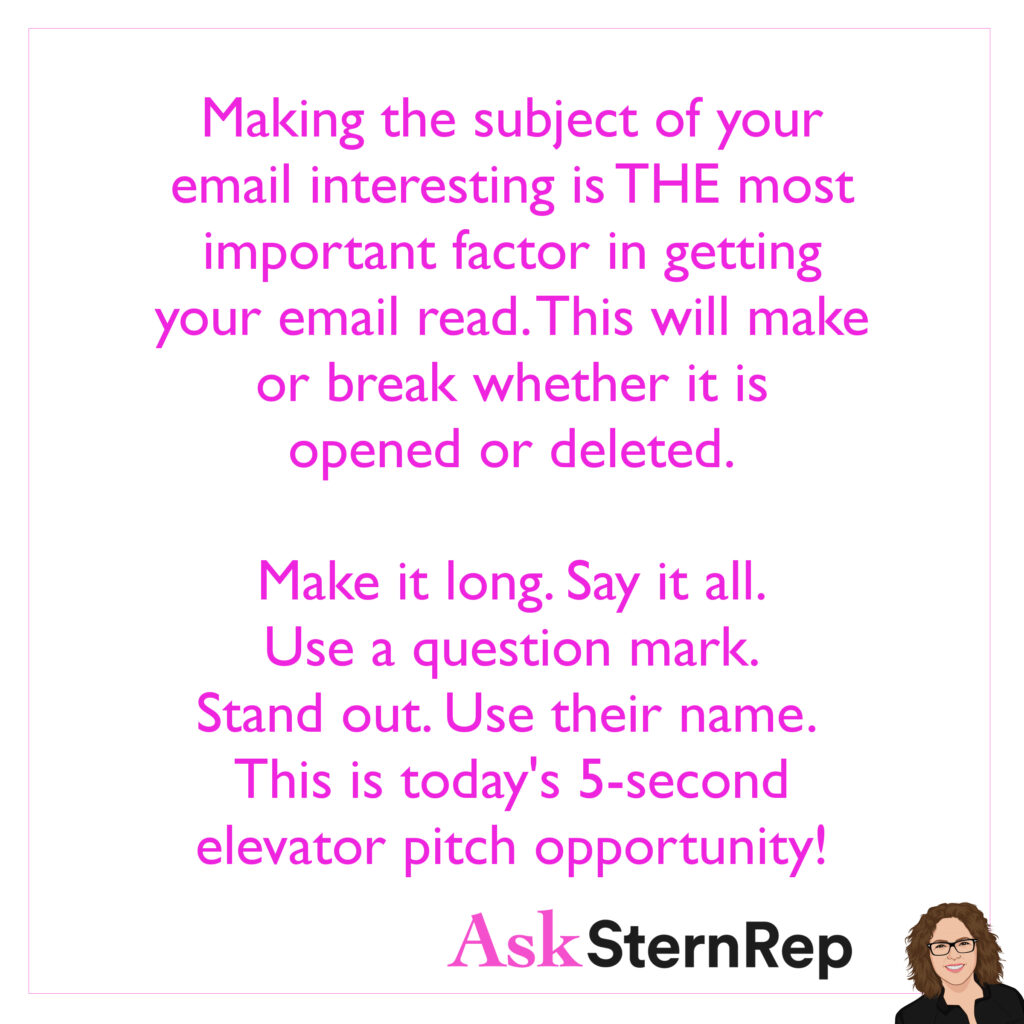
Making the subject of your email interesting is THE most important factor in getting your email read. This will make or break whether it is opened or deleted.
Make it long, Say it all. Use a question mark. Stand out. Use their name. This is today’s 5-second elevator pitch opportunity!
Changing Budgets


Q:
With the current shifts and changes in the photography industry, are you also seeing a change in the budgets? Are they staying the same, increasing, or decreasing?
A:
People want more for their money these days. They expect more content for the same price. So, when it comes down to it, the budgets are smaller.
One Line I Add to All Our Bids

One line I add to all our bids:
“Bid based on info provided any changes may incur overages.”
Another good item to put on a bid is 50% advance payment of total due before shoot begins.
The Importance of Content


Q:
When you talk about the rising importance of “content,” are you referring to the necessity of photographers to post more and better content, the necessity of clients to produce more content and hence hire photographers more often, or both?
A:
When I refer to the importance of content, I am talking about both: photographers need to create more content, as do clients. And hey, reps too. We all need to constantly be creating and posting content in today’s business world.
Instagram: IS IMPORTANT.
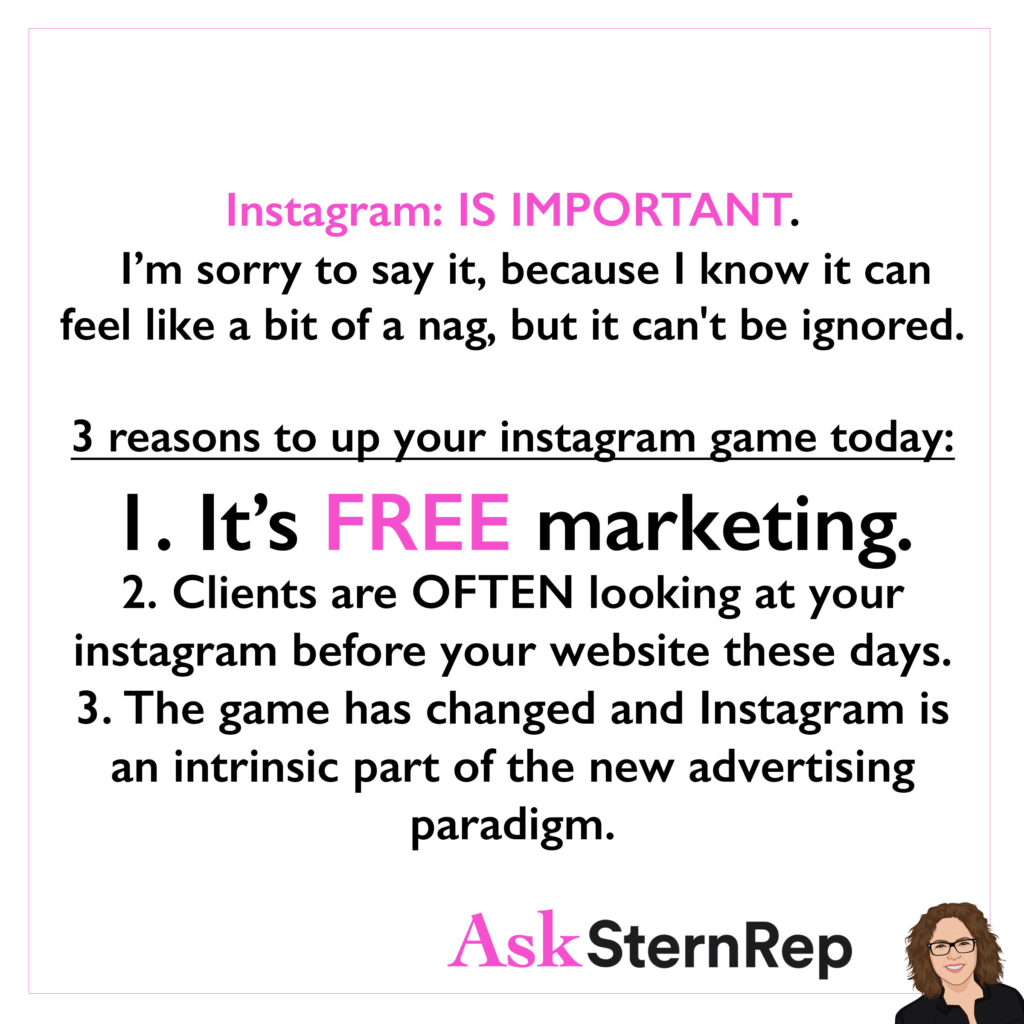
Instagram: IS IMPORTANT.
I’m sorry to say it, because I know it can feel like a bit of a nag, but it can’t be ignored.
3 reasons to up your instagram game today:
1. It’s FREE marketing.
2. Clients are OFTEN looking at your Instagram before your website these days.
3. The game has changed and Instagram is an intrinsic part of the new advertising paradigm.
Portfolio Viewings
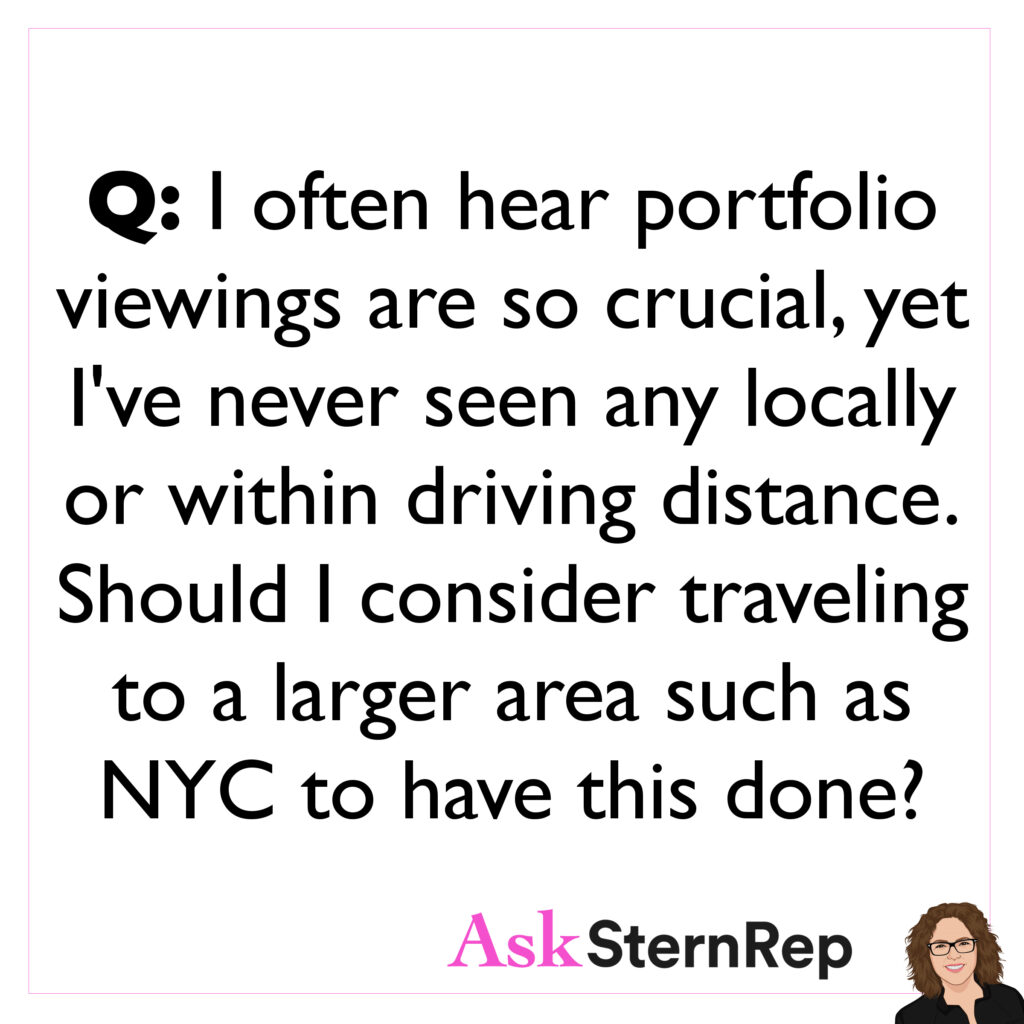

Q:
I often hear portfolio viewings are so crucial, yet I’ve never seen any locally or within driving distance. Should I consider traveling to a larger area such as NYC to have this done?
A:
Yes, a one on one or group showing with your portfolio is extremely valuable. I’d highly recommend these for a photographer at any level of their career. Bring them some chocolate!
Drive

That dissatisfaction you feel, is what an artist calls drive.
Keep It Professional

No matter how you feel, keep it professional.
Treatments That Get the Job
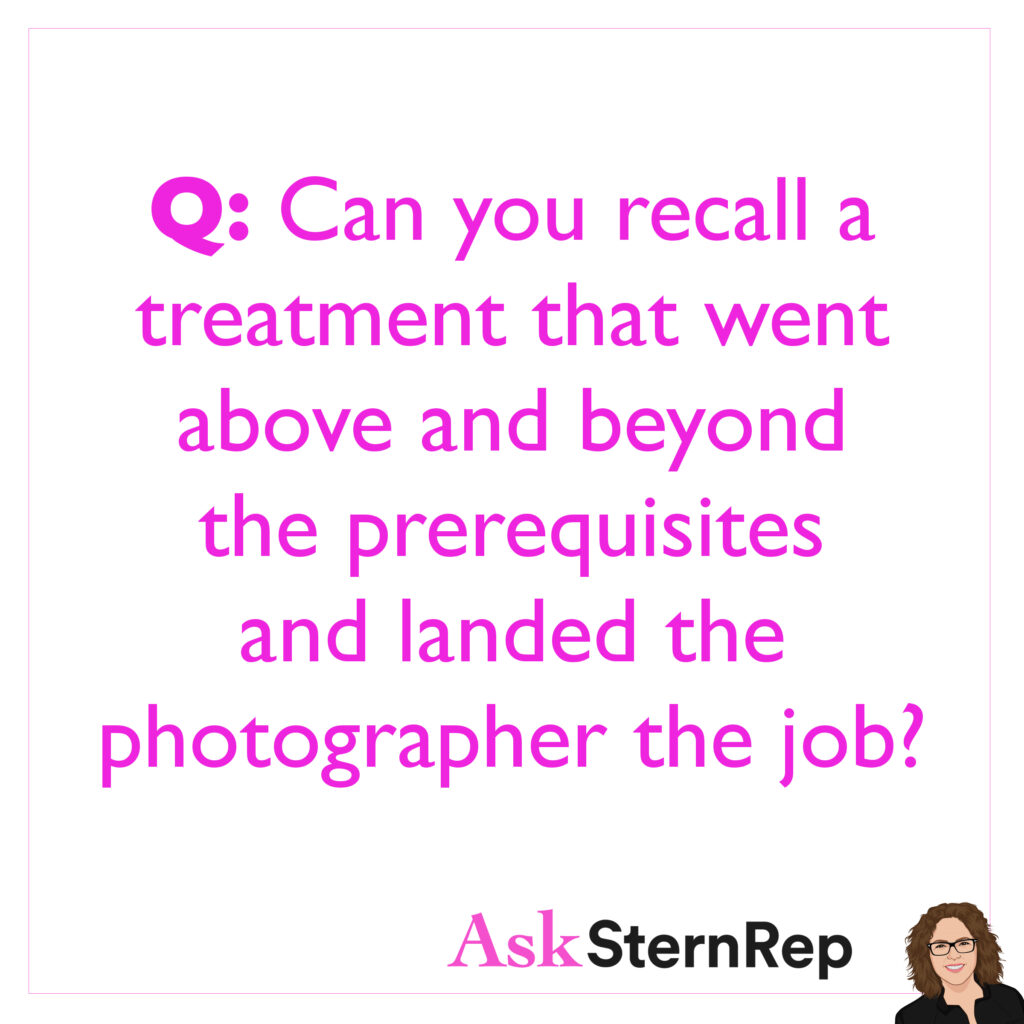
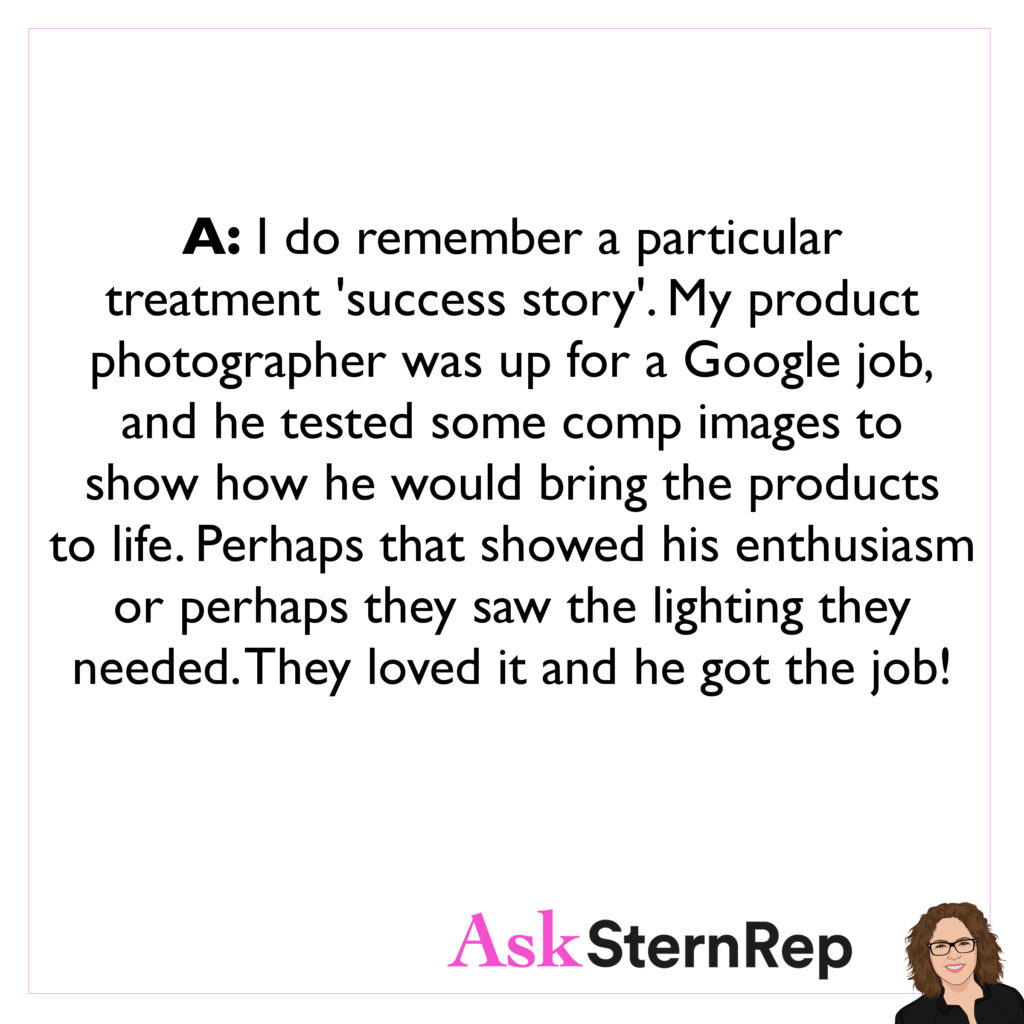
Q:
Can you recall a treatment that went above and beyond the prerequisites and landed the photographer the job?
A:
I do remember a particular treatment ‘success story.’ My product photographer was up for a Google job, and he tested some comp images to show how he would bring the products to life. Perhaps that showed his enthusiasm or perhaps they saw the lighting they needed. They loved it and he got the job!
Instagram as a Portfolio


Q:
Do you think Instagram promotion is a good way to reach ad agencies and Art Directors? Do you or your photographers use it for promotion? The world is changing, so we have to change with it!
A:
Yes, definitely use Instagram as it is the new portfolio. Hashtags get photographers seen and can lead to bidding on a job. We definitely use it and you’re right – the world is changing in a big way and we need to flow with it.
When Negotiating…

When negotiating, always wait for your clients to respond before offering more.
How and When Do You Get a Rep?

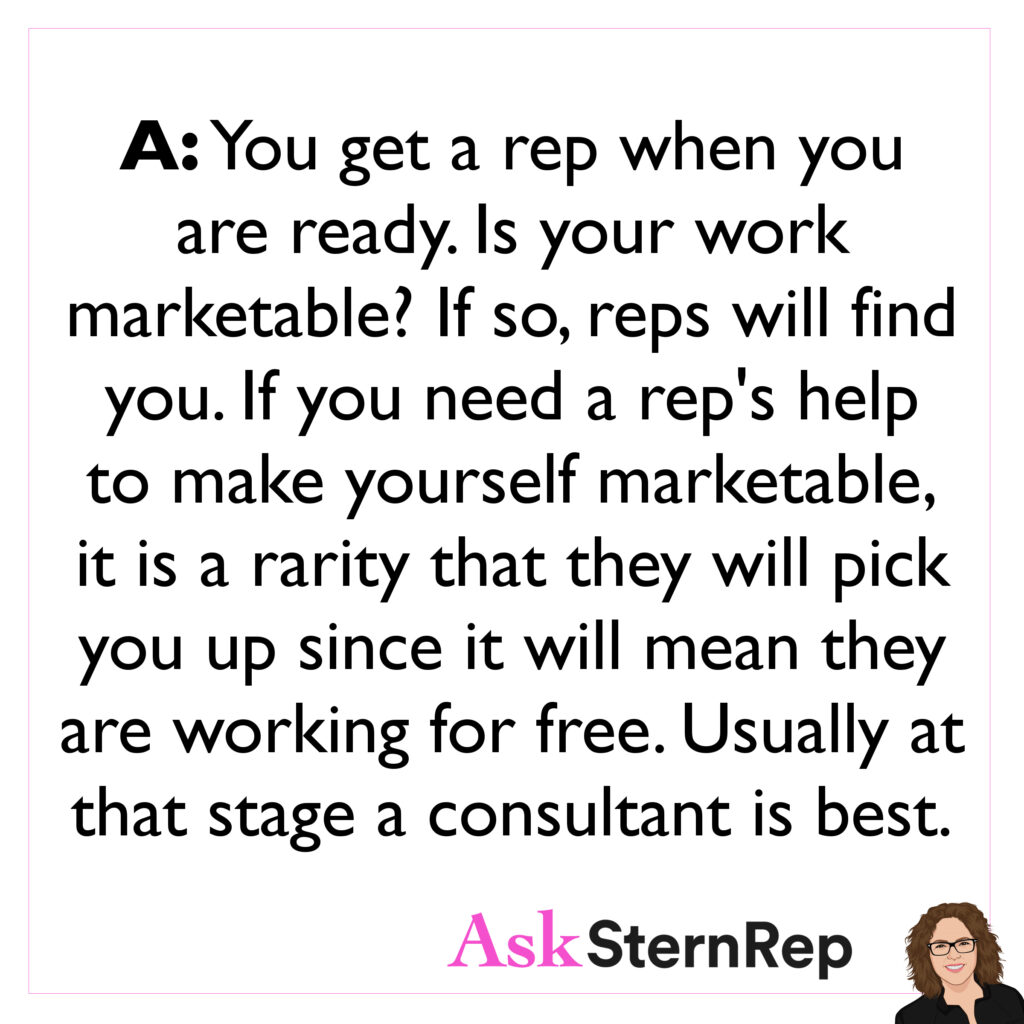
Q:
How and when do you get a rep? I’ve heard it’s when you have enough clients, but I think I mostly want one to help me get more clients and the type I want.
A:
You get a rep when you are ready. Is your work marketable? If so, reps will find you. If you need a rep’s help to make yourself marketable, it is a rarity that they will pick you up since it will mean they are working for free. Usually at that stage a consultant is best.
Set Aside a Few Unplugged Minutes

Set aside a few unplugged minutes today to contemplate.
Contacting Clients


Q:
Aside from paying lots of money for companies like Agency Access, which often don’t include smaller up and coming brands, how do you get contact info and addresses of smaller/local companies?
A:
If you can’t find them on Agency Access or Yodelist I would then most likely use LinkedIn, Agency Spy, or Adweek to see what kind of contact info I can find.
Don’t Call People

Don’t call people if you’re not good on the phone.
Seeking Representation

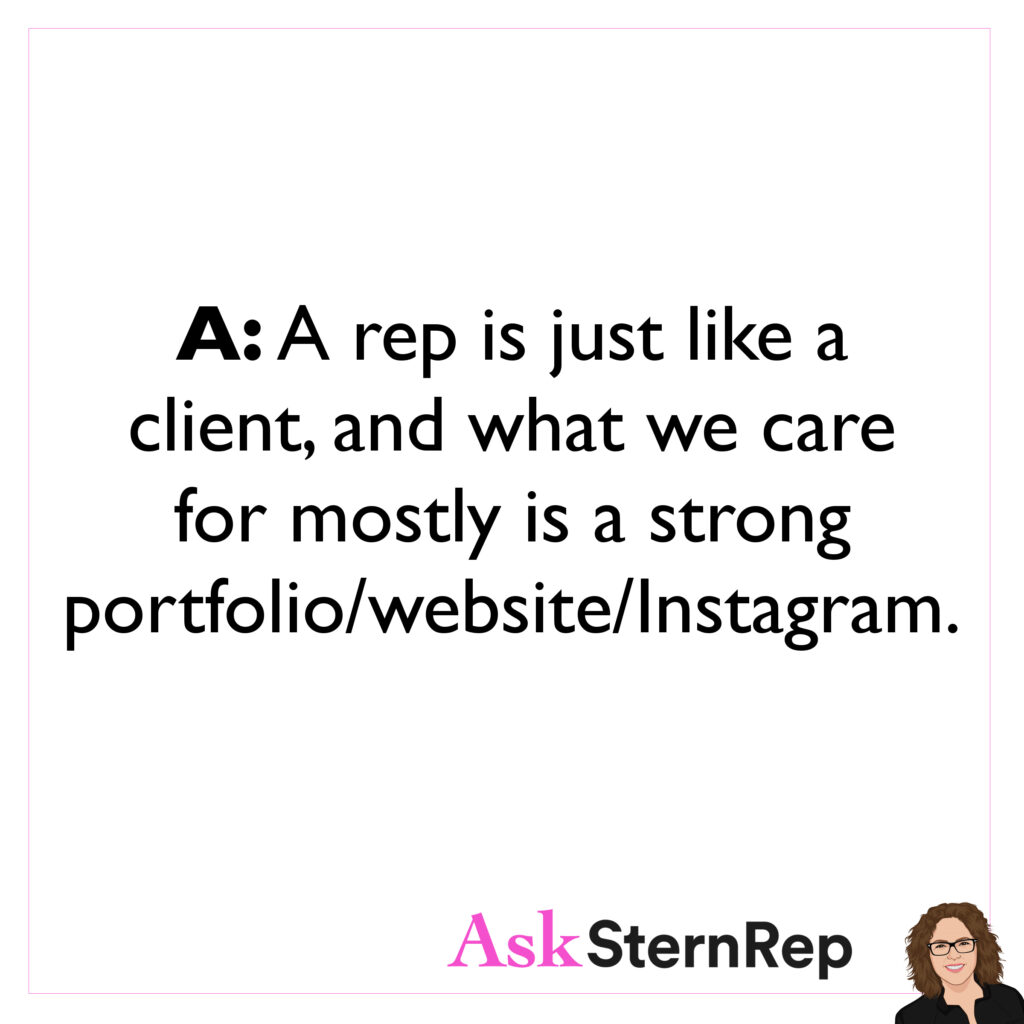
Q:
What if a photographer seeking a representative isn’t an American citizen? Could it be a problem if you are not a native English speaker?
A:
A rep is just like a client, and what we care for mostly is a strong portfolio/website/Instagram.
Celebrity Portraits


Q:
When sending out promos consisting of documentary or environmental portraiture, how important is it to have subjects in the photos that are well-known celebrities or artists? Or does that even matter at all?
A:
Send out promos where your work matches the type of imagery your clients are looking for. That’s what will help you get noticed.
You only need to show famous folks if you are going for the celebrity or entertainment industry. Stay true to your look/style and make that powerful theme which will stand out.
Create a Template For Your Treatments

TREATMENTS:
Create a template for your treatments to help make it easier each time you are asked to create one. Your template would have sections like location, lighting, casting/talent, wardrobe, etc. I also suggest hiring a writer for each one and hiring a designer to create the template.
The treatment can make or break it for you when bidding on a job.
I personally think your portfolio should be enough to get you the job, but nowadays why not do everything you can to make that happen? Use this as a way to demonstrate your approach to this project and the type of professionalism, creativity, and enthusiasm you’ll be bringing to the job.
Commercial Advertising Budgets
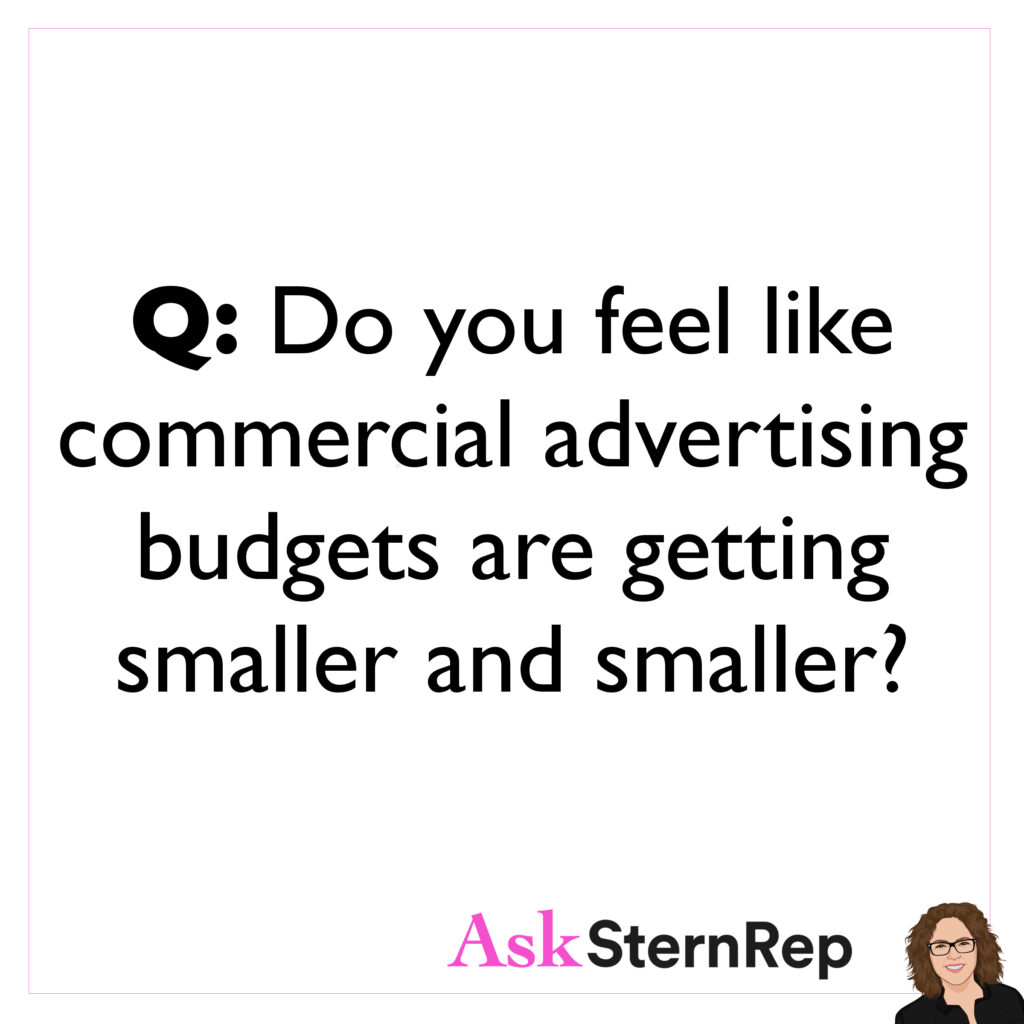
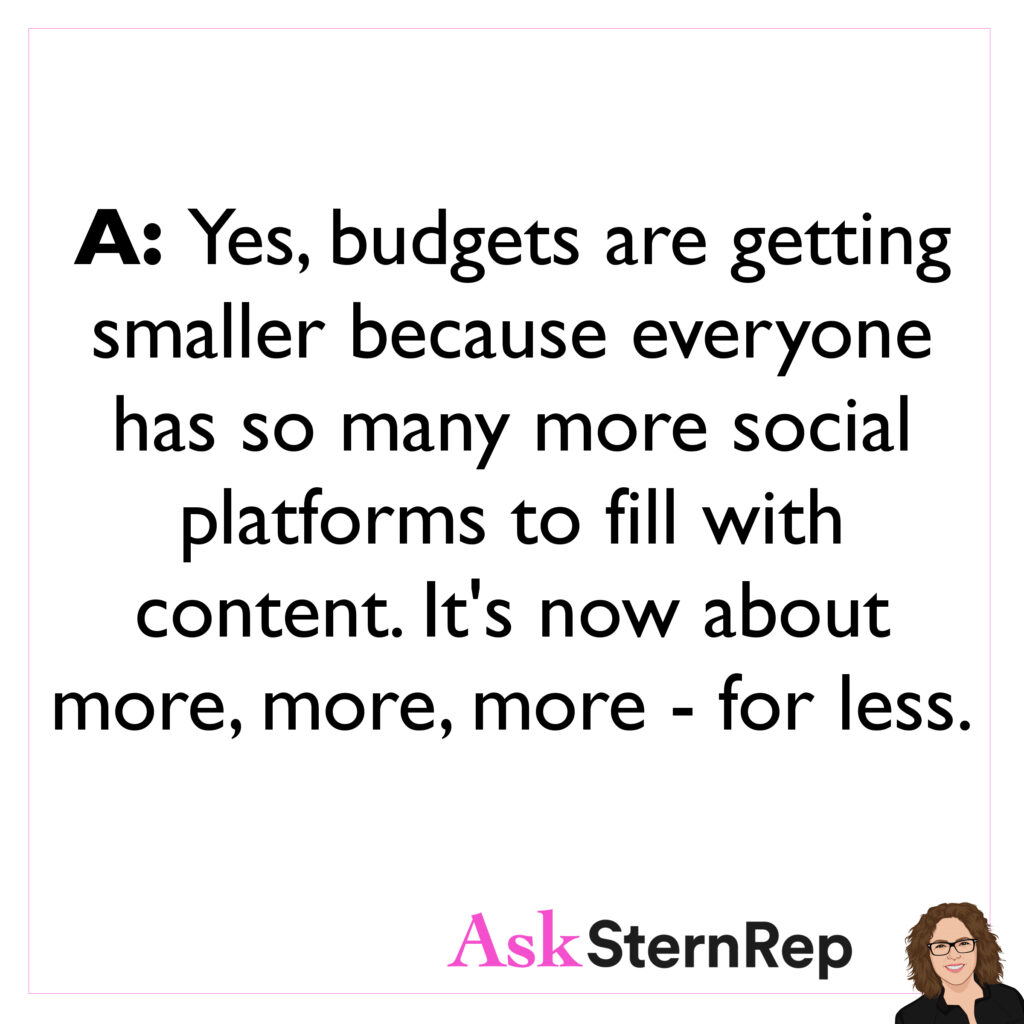
Q:
Do you feel like commercial advertising budgets are getting smaller and smaller?
A:
Yes, budgets are getting smaller because everyone has so many more social platforms to fill with content. It’s now about more, more, more – for less.
Keep Yourself Open to the Unexpected
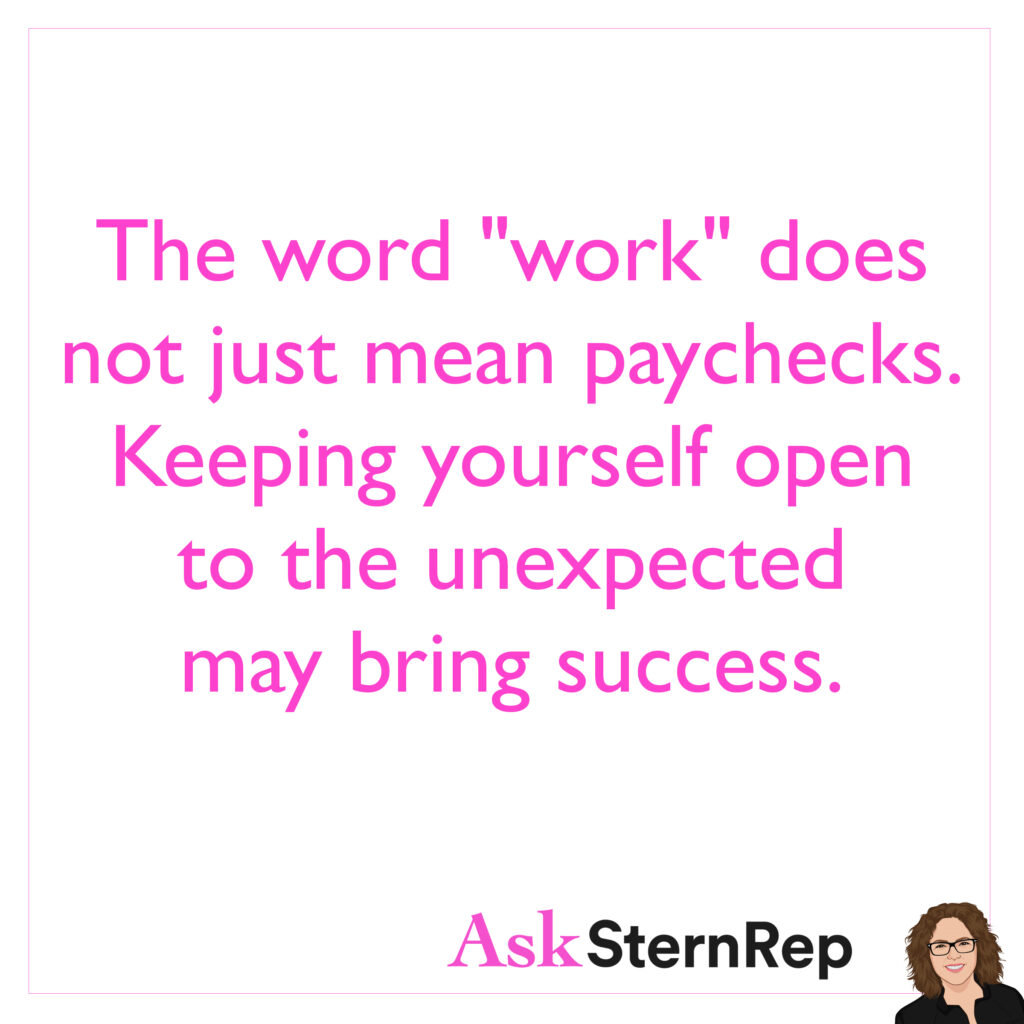
The word “work” does not just mean paychecks.
Keeping yourself open to the unexpected may bring success.
Test Shoots for New Photographers

Q:
For photographers “just starting out,” what are some test shoots every photographer should have in their portfolio? Liquid? Automotive? Lifestyle?
A:
Photographers starting out should choose the area that really interests them. Do the tests that really intrigue you when you see others. One way to do that is to go through other photographer’s websites to check out all the different industry options.
Feed Your Ideas
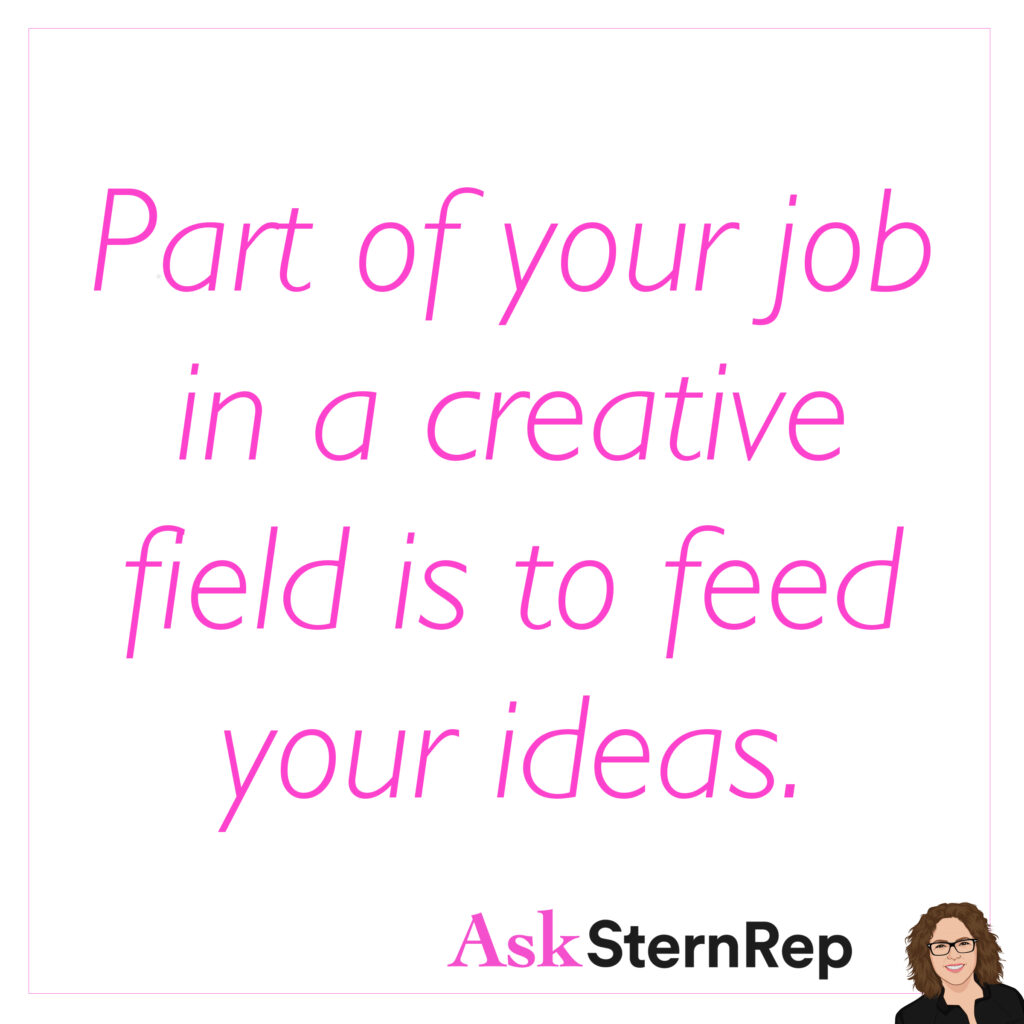
Part of your job in a creative field is to feed your ideas.
Find Your Spark

As Director of Operations at SternRep, I spend a lot of my time looking through photographers’ images.
Sometimes as I am examining someone’s body of work I find a magic spark somewhere in their portfolio. Something pops out at me. An image or series that is set apart from the rest.
Something highly marketable, different, bold, unique, and really well done. But mixed in with lots of other stuff in their portfolio.
Sometimes it’s actually about cleaning out your portfolio, of anything that does not have this magic spark. It’s about finding your spark and then expanding your portfolio based on what makes your work strong and different. It’s kind of like your own magical thread that you need to follow to be successful in the commercial market, explore more, grow, and expand.
But if the photographer can’t see or feel or want to follow it, there’s no forcing it…
Guest Post: Olivia Katz
Director of Operations, SternRep
Never Take It Personally
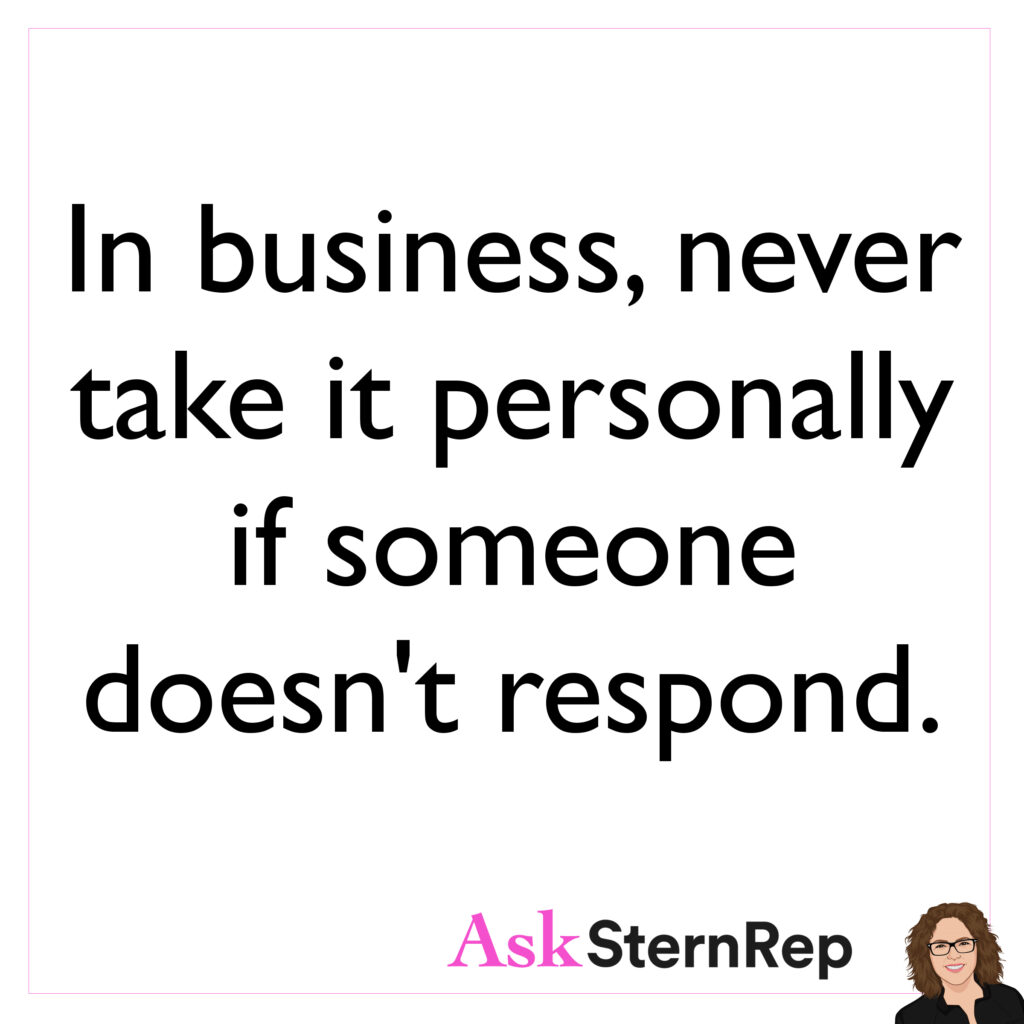
In business, never take it personally if someone doesn’t respond.
Advice for Aspiring Photographers


Q:
What advice can you give to aspiring photographers?
A:
Explore. I don’t even call it testing anymore. Explore and expand your look without losing all that specific edge to your style. As I said before, all photographers need to rediscover themselves on a regular basis. Educate themselves, look at others, assist and learn as much as possible.
We’ve talked a lot about the importance of social media but I think new photographers could really benefit from thinking beyond social media for their marketing as well. Send emails. Write people on LinkedIn. Go to lunch. Meet people in person. Aspiring photographers may need to get creative by finding ways to connect.
Guest Post: Interview w/ Mara Serdans
www.MarasMix.com
“Just”
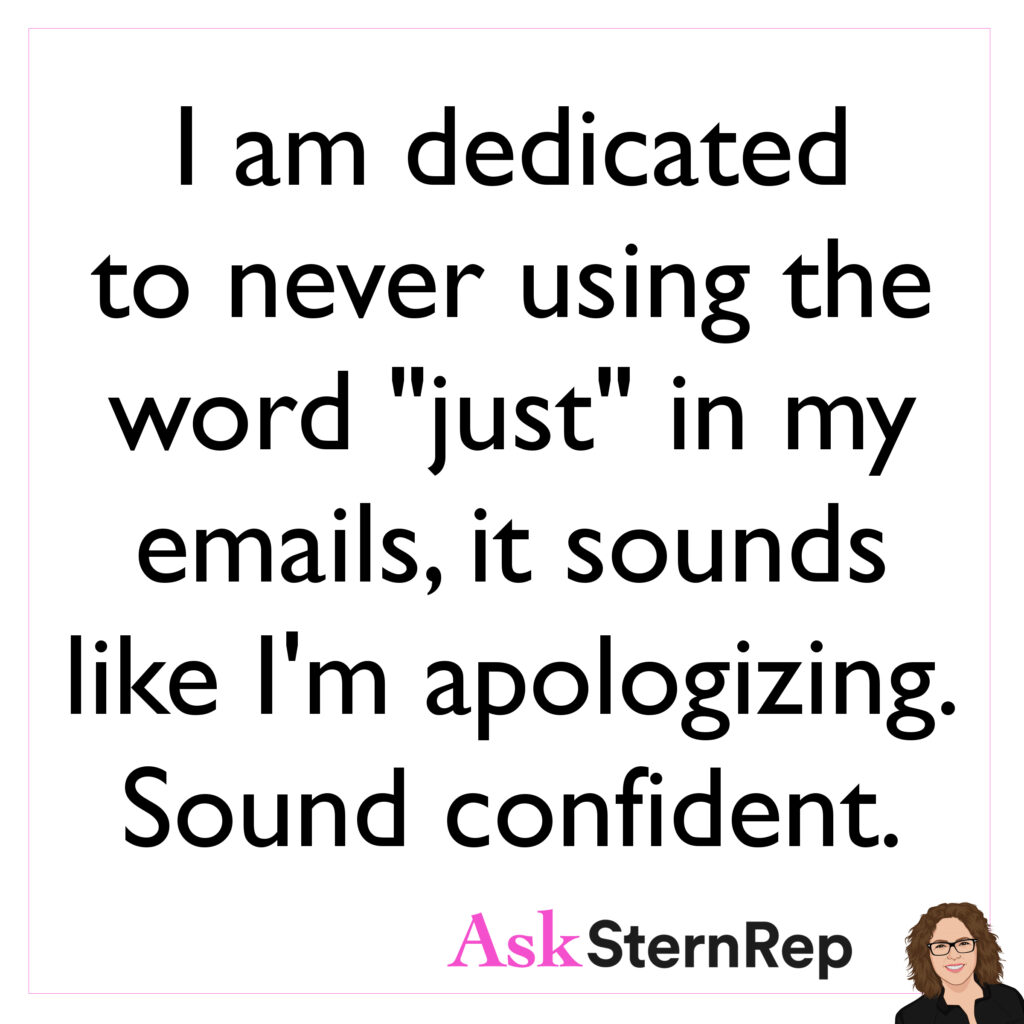
I am dedicated to never using the word “just” in my emails, it sounds like I’m apologizing.
Sound confident.
Don’t Apologize For Taking Time Off
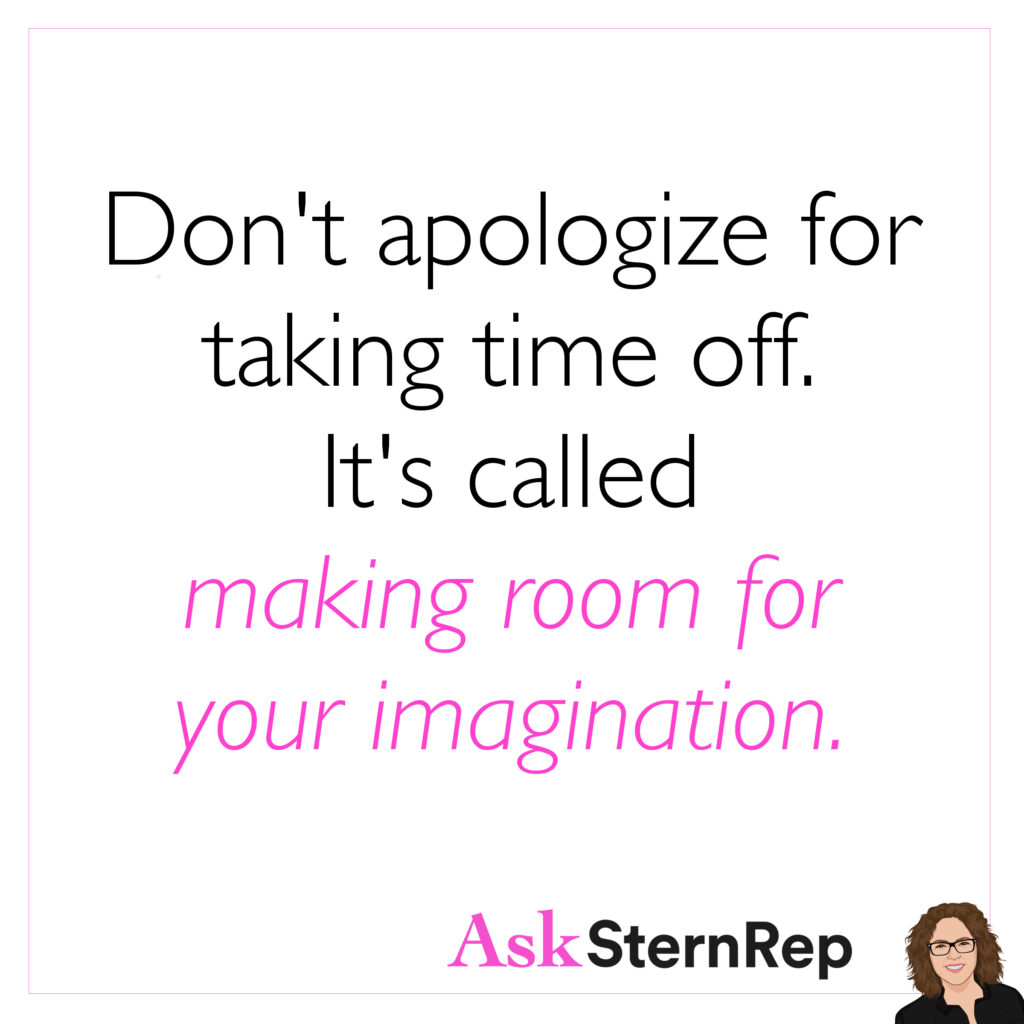
Don’t apologize for taking time off.
It’s called making room for your imagination.
Shooting What You Love
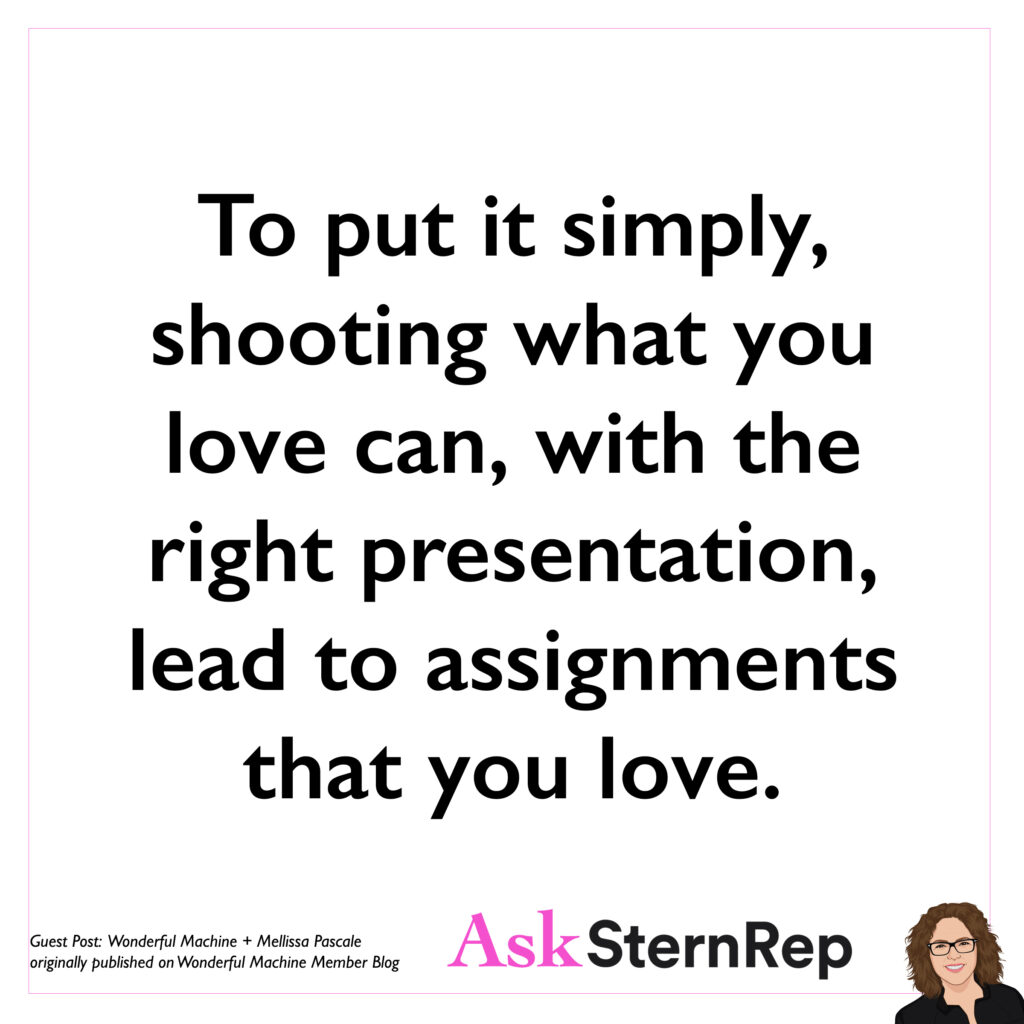
To put it simply, shooting what you love can, with the right presentation, lead to assignments that you love.
Guest Post: Wonderful Machine + Mellissa Pascale
Originally published on Wonderful Machine Member Blog
KNOCK ON ALL THE DOORS.

KNOCK ON ALL THE DOORS.
Digital Rights Only

Q:
What is the difference between “digital rights only” and web or social media usage?
A:
“Digital rights” covers all digital usage. “Website and social media” only covers usage for social media or on their website. Digital rights covers ads on any digital platform. One important point to remember is when they ask for “website usage,” write that company’s website in your terms. There is a big difference if you don’t put it in as their website.
Never Underestimate the Power of Self-Assigned Projects
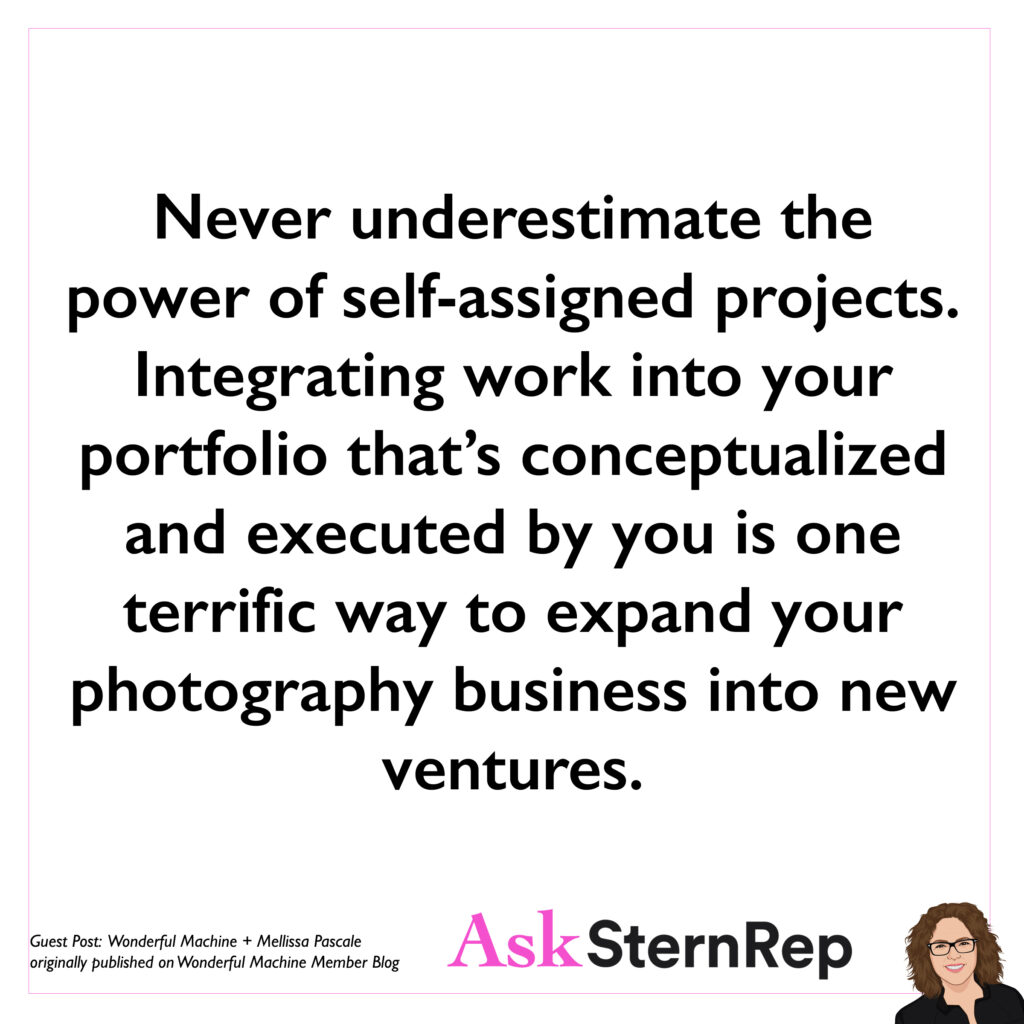
Never underestimate the power of self-assigned projects. Integrating work into your portfolio that’s conceptualized and executed by you is one terrific way to expand your photography business into new ventures.
Guest Post: Wonderful Machine + Mellissa Pascale
Originally published on Wonderful Machine Member Blog
How a Rep Guides a Photographers Career

Q:
What is your process after you’ve on-boarded a new photographer? After discussing where the photographer wants to go and where their work would be a great fit, what is your strategy in regards to marketing? What is a rep’s game-plan?
A:
This is a big question and I could probably write pages! The overall marketing strategy for a photographer really depends on what stage they are at in their career. Some need to revise their website while others need to print a mailer promo. The game plan often begins by figuring out who their potential clients would be (based on the categories in their portfolio) and then emailing all potential clients a “hello” + a link to their work. We create specialized client lists based on what category we are targeting, and I also like to give the photographer a list of 10 “hot” clients to email directly every month. We structure their entire marketing plan which includes social media, portfolio meetings with clients, and upcoming tests.
Sound Like Your Own Voice

In marketing, the more your written communication can sound like your own voice, the better.
A Wide Variety of Work

Q:
I am always hearing you should only show the same style of work and focus on that. The thing is, I love shooting many different ways and with different moods. Is that a bad thing to showcase a wide variety of work?
A:
This depends mostly on whether you live in a small or large city. The larger the city you are in, the more you will really need to hone in on your look + specialty. You are more likely to be able to get away with shooting a lot of things in a smaller city where there are fewer photographers and there may be a need for someone who is more of a generalist. Overall, something cohesive should be in all of your images, as your portfolio is the core of your branding.
Don’t Take It Personally

Don’t take it personally means treating your business like a business. You are a corporate business owner and rather than taking it personally, take it all like a CEO would and ask yourself how you could’ve done it better. See where you can take responsibility and make improvements.
How Do You Know When Your Book is Strong Enough?

Q:
How do you know when your book is strong enough to start marketing to potential clients? I’ve heard you only get one shot and only one first impression.
A:
You get more than one shot because clients in larger cities changeover often. When a client sees potential in your book they will often want to witness where you take it and be the one to help launch your career. Your book is strong enough when you start bidding on jobs.
When You Don’t Get a Job…

When you don’t get a job, use that to get better.
Usage on Estimates

Q:
Do you separate usage on estimates or do you combine it with the creative fee into one large number? If you are just using one number, are you breaking out additional image licensing costs if a client wants more than the initial ask?
A:
Some people break out and separate from the creative fee, but I have found this can get lowered too easily through shot count changes during bidding. I find it easier to include usage in one creative fee amount for that reason. I am breaking out optional additional usage if they ask for it.
Take Action To Move Forward

When things are difficult, find a way through. Throwing your hands in the air, collapsing in frustration, these things do not move you forward. Pause, collect yourself, and then take action to move forward.
ON “THE CREATIVE CALL”

ON “THE CREATIVE CALL”
Guest Post | Wonderful Machine & Craig Oppenheimer
It’s important to understand a few things about these phone calls. First, you should always assume that the agency/client is considering other photographers, and when they finish a conversation with you, they are likely jumping on a call to talk through the same details with another photographer…or maybe two or three more photographers. For that reason, it’s important to express enthusiasm for a project, be energetic, have questions prepared and generally put your best foot forward. I’ve been on many creative calls where photographers have responded to questions in one-word answers, or don’t have any questions about the project, and this is a sure-fire way for the agency/client to lose interest in you. Clients don’t just want a great photographer; they want a great collaborator as well. During the call, it’s therefore important for a photographer to prove that they have fully internalized the project, and explain how they can add value to the production and therefore the entire campaign. First impressions are crucial, and when you are meeting over the phone, it’s your voice and energy that matter, so make it count.
Guest Post: Wonderful Machine + Craig Oppenheimer/
originally published on Wonderful Machine Member Blog
Space Out Your Emails

Space out your reply emails to use it as more marketing PR time.
Watermarking Images on a Website
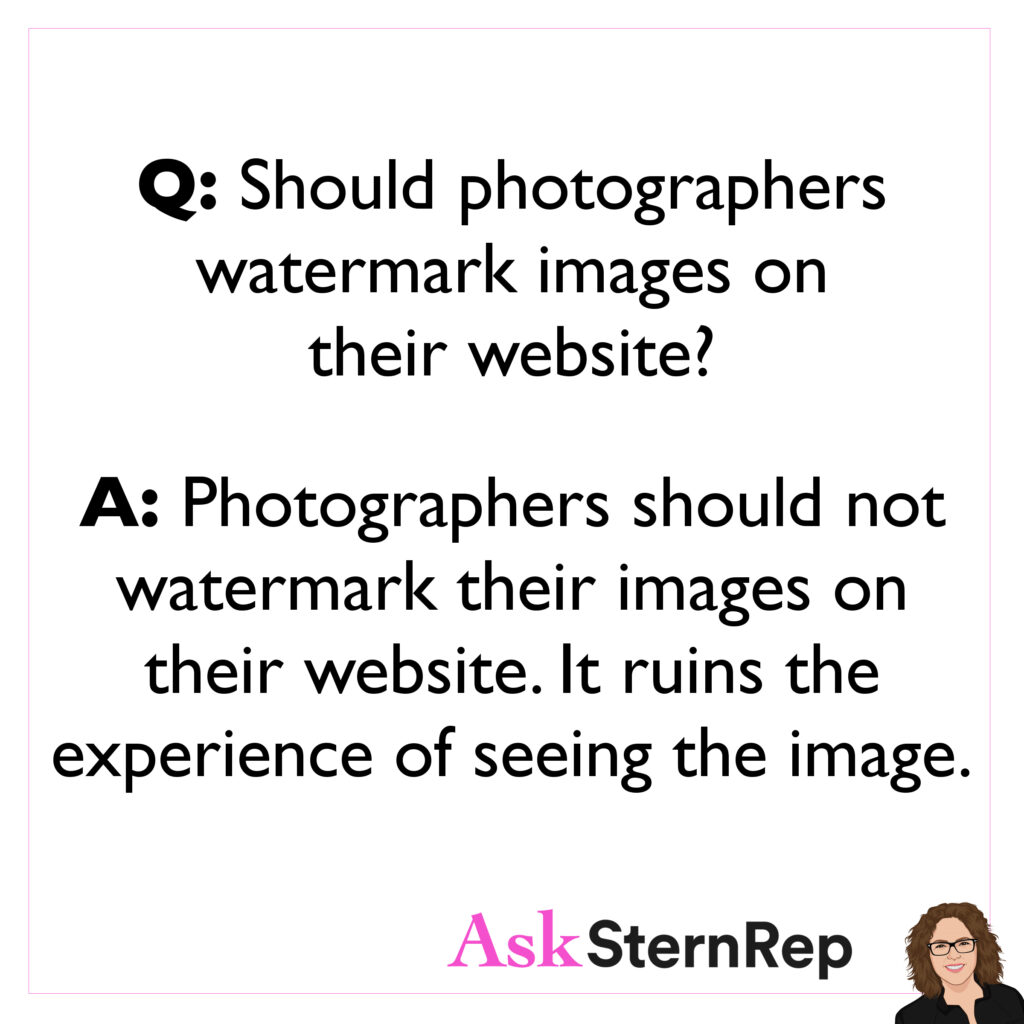
Q:
Should photographers watermark images on their website?
A:
Photographers should not watermark their images on their website. It ruins the experience of seeing the image.
Quickest Way to Lose a Potential Client
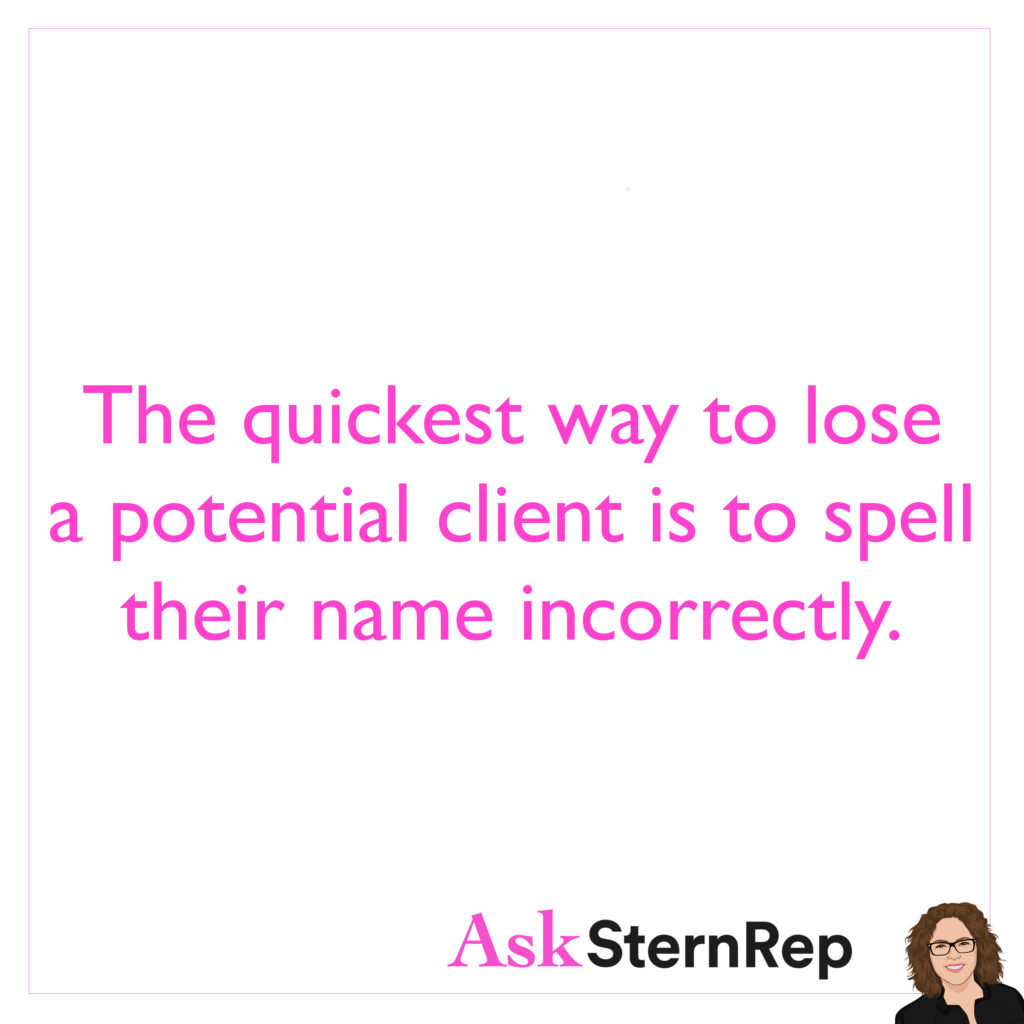
The quickest way to lose a potential client is to spell their name incorrectly.
Advice for a Photographer Seeking Representation

Q:
What’s the best advice you can give a photographer who is seeking representation?
A:
Best advice to find a rep is to email the reps that interest you. All we want to do is check out your website. If you know people in the business you can ask around and get the word out there that you are looking.
Developing as a Photographer
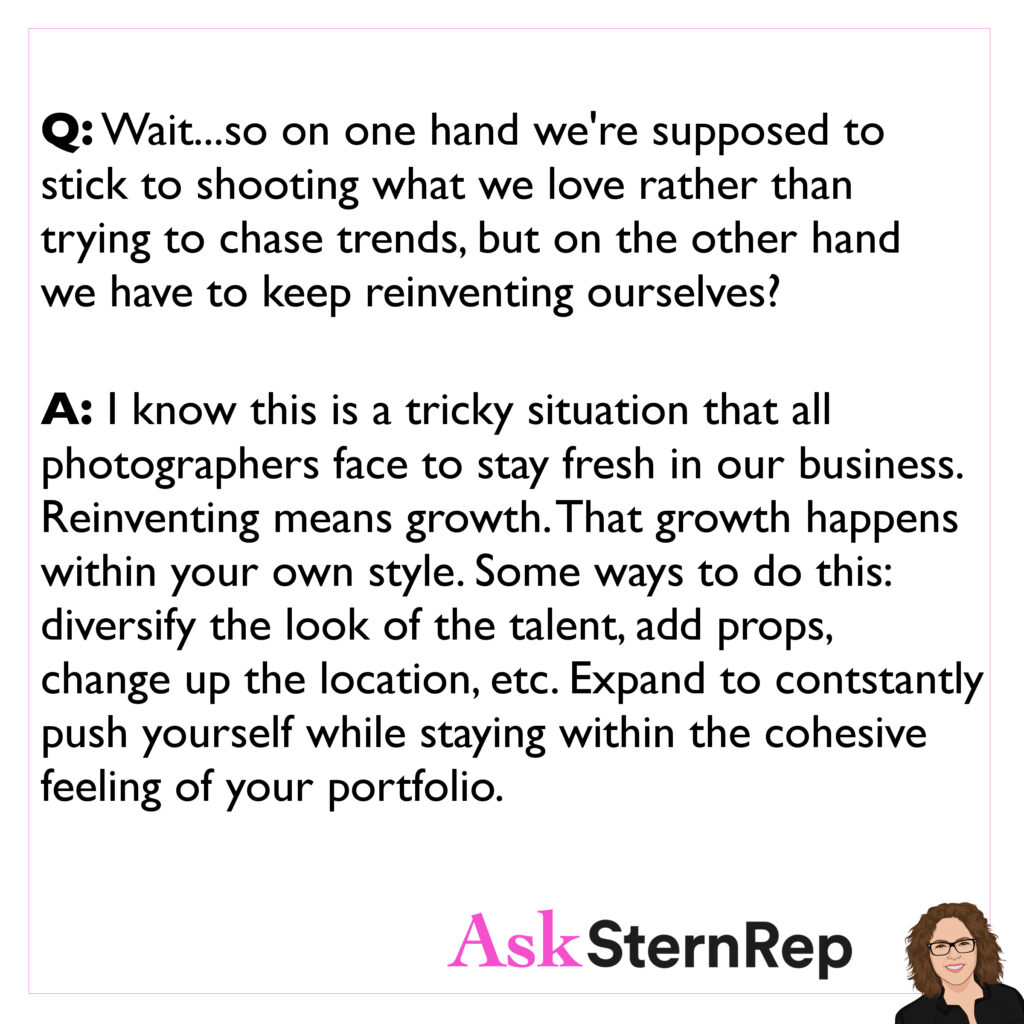
Q:
Wait…so on one hand we’re supposed to stick to shooting what we love rather than trying to chase trends, but on the other hand we have to keep reinventing ourselves?
A:
I know this is a tricky situation that all photographers face to stay fresh in our business. Reinventing means growth. That growth happens within your own style. Some ways to do this: diversify the look of the talent, add props, change up the location, etc. Expand to constantly push yourself while staying within the cohesive feeling of your portfolio.
You can’t afford to NOT test.

You can’t afford to NOT test.
Never Bring Emotions to Work

Best advice I ever received was from photographer Neil Jacobson, who told me to never bring my emotions to my job.
Marketing Yourself as a Generalist

Q:
Is it pointless to market yourself as a generalist? I shoot a lot of architecture, but also people and some products.
A:
Being a generalist and shooting a bit of everything is definitely a more difficult marketing path for any photographer. I find this can work in smaller locations or if the photographer has a lot of personal friendships with their clients.
Continue To Reinvent Yourself
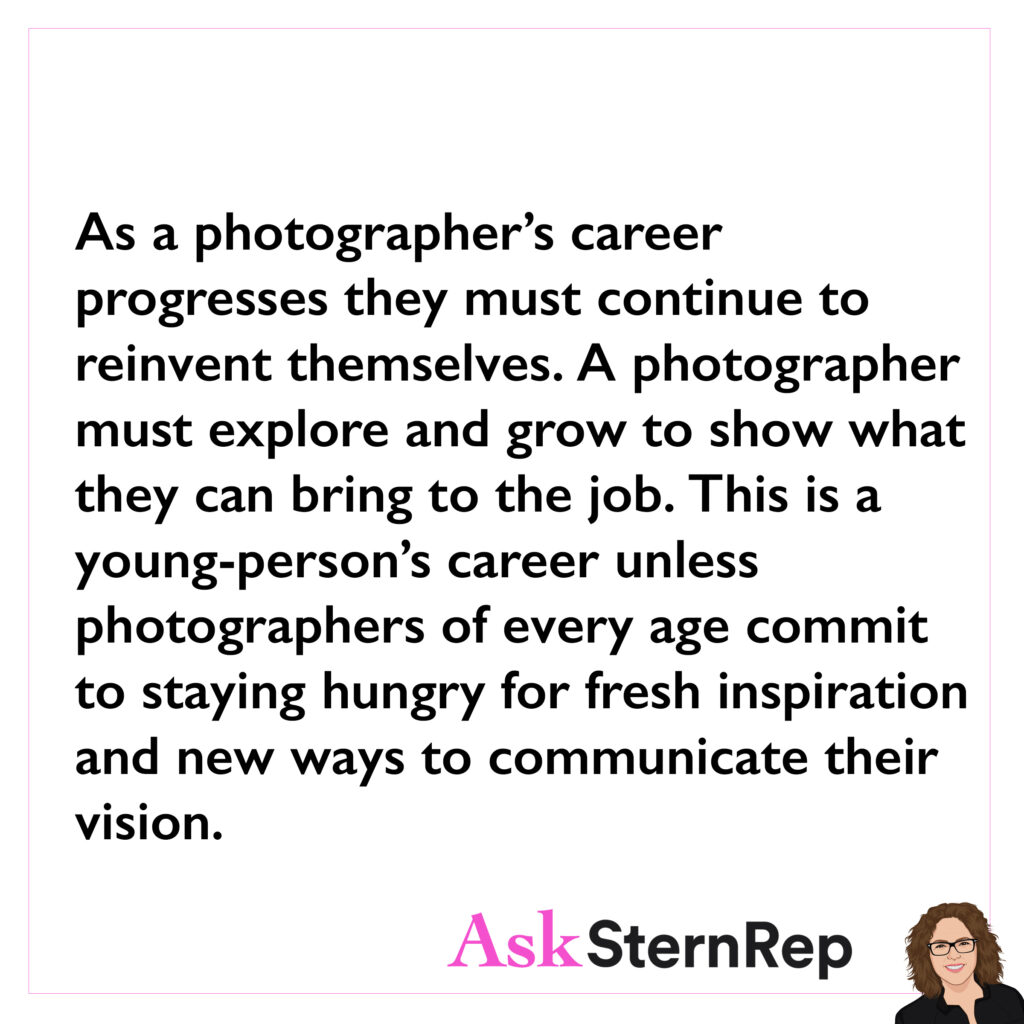
As a photographer’s career progresses they must continue to reinvent themselves. A photographer must explore and grow to show what they can bring to the job. This is a young-person’s career unless photographers of every age commit to staying hungry for fresh inspiration and new ways to communicate their vision.
Art Producer vs Print Producer
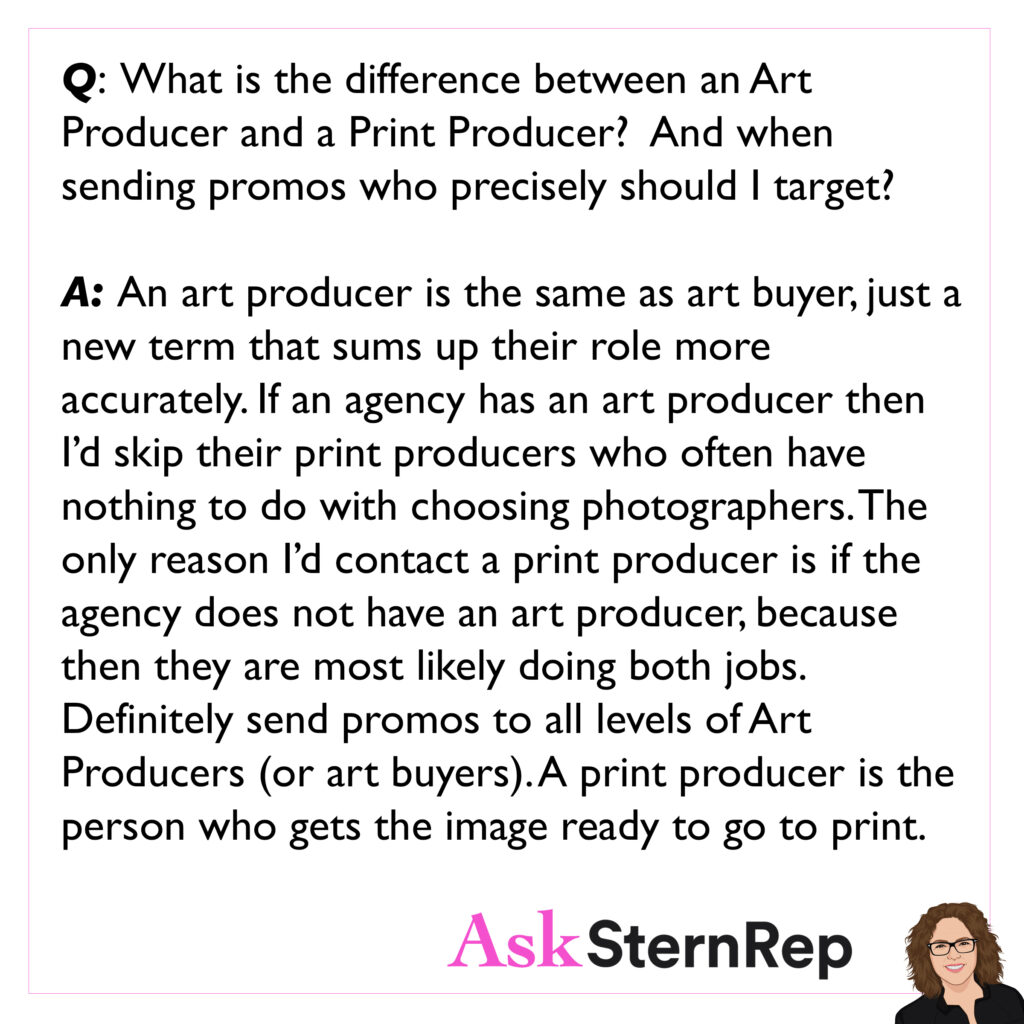
Q:
What is the difference between an Art Producer and a Print Producer? And when sending promos who precisely should I target?
A:
An art producer is the same as an art buyer, just a new term that sums up their role more accurately. If an agency has an art producer then I’d skip their print producers who often have nothing to do with choosing photographers. The only reason I’d contact a print producer is if the agency does not have an art producer, because then they are most likely doing both jobs. Definitely send promos to all levels of Art Producers (or art buyers). A print producer is the person who gets the image ready to go to print.
Speaking of Trends
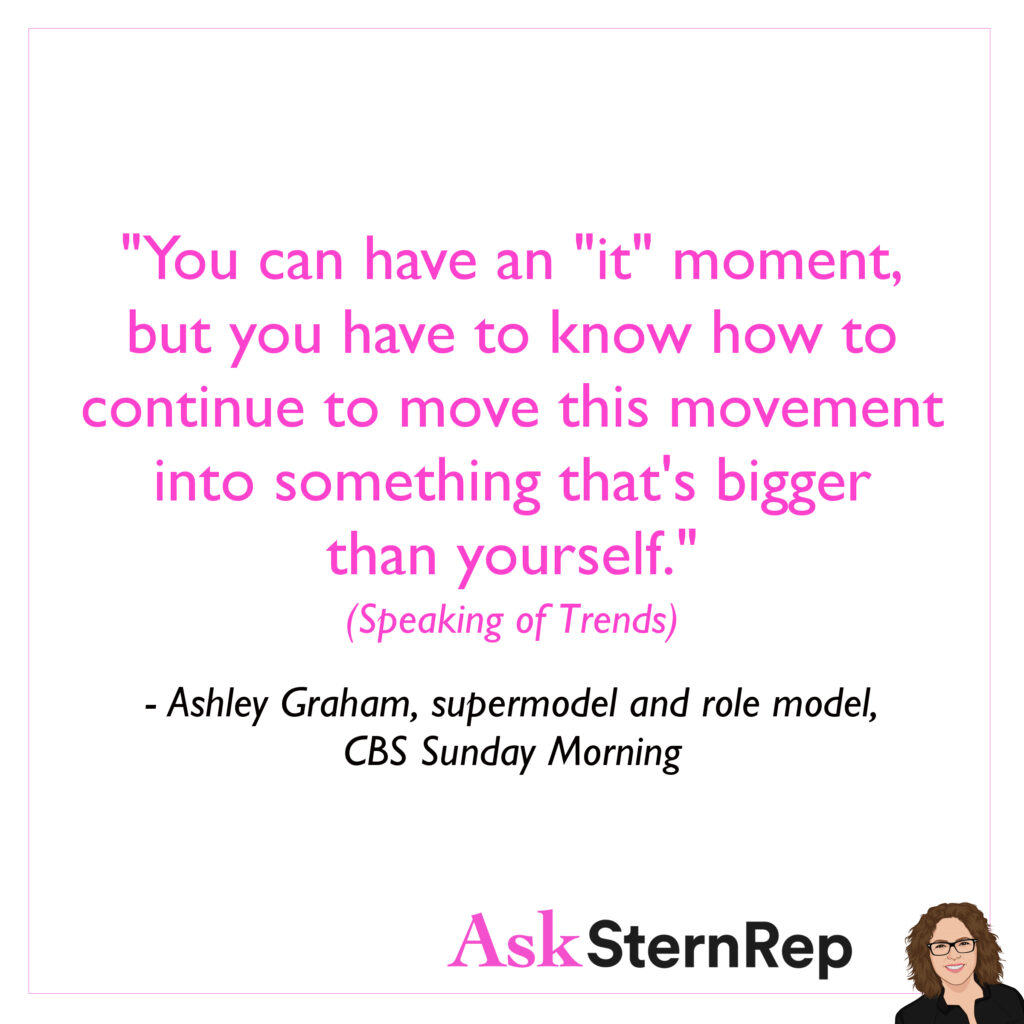
“You can have an ‘it’ moment, but you have to know how to continue to move this movement into something that’s bigger than yourself.”
(Speaking of Trends)
– Ashley Graham, supermodel and role model, CBS Sunday Morning
Standard Day Rate for a Photographer
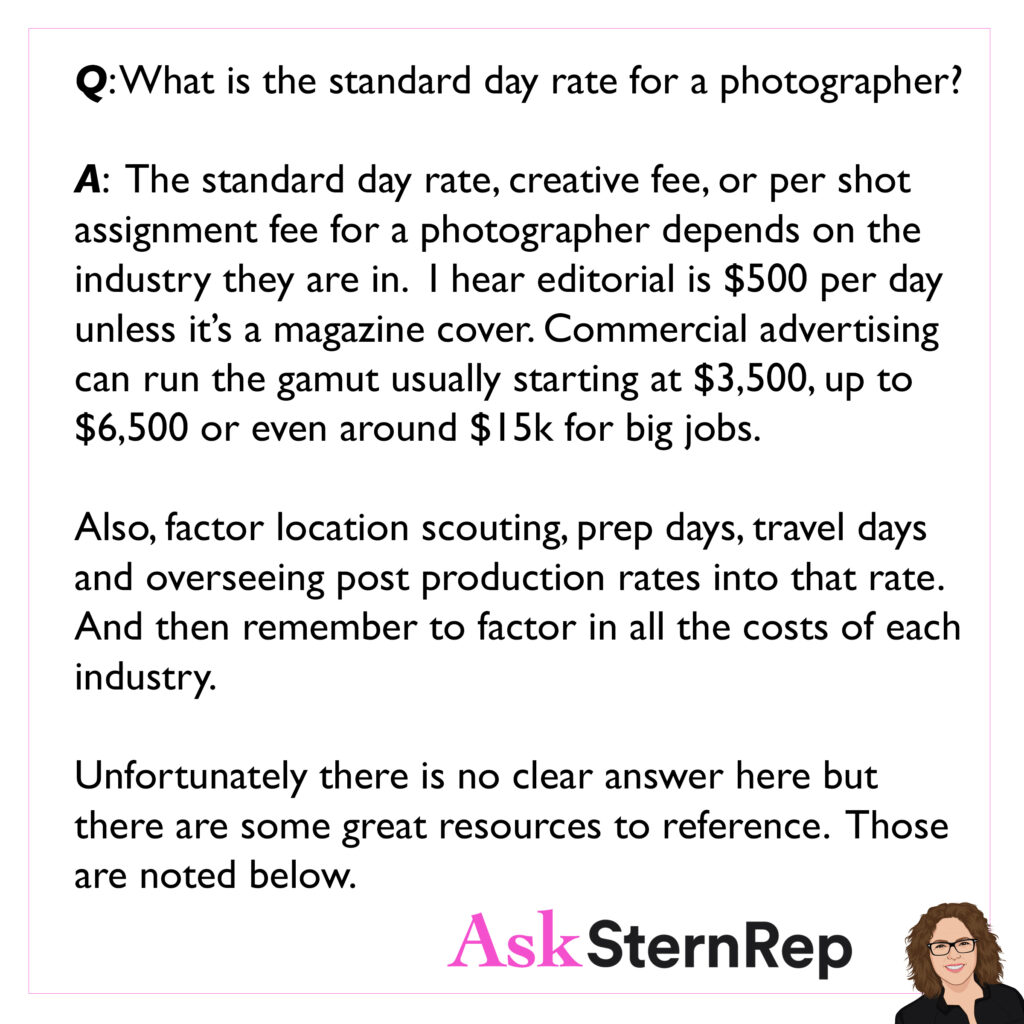
Q:
What is the standard day rate for a photographer?
A:
The standard day rate, creative fee, or per shot assignment fee for a photographer depends on the industry they are in. I hear editorial is $500 per day unless it’s a magazine cover. Commercial advertising can run the gamut usually starting at $3,500, up to $6,500 or even around $15k for big jobs.
Also, factor location scouting, prep days, travel days and overseeing post production rates into that rate. And then remember to factor in all the costs of each industry.
Unfortunately there is no clear answer here but there are some great resources to reference. Those are noted below.
Resources available for pricing help: visit @aphotoeditor online for pricing and bidding help, they feature sample estimates
@wonderfulmachine is also great and can step in and help with estimates.
You can also always reach out to a photo agent with questions and we are often happy to hop on a job with you and negotiate your rates. Send industry related questions to ask@Sternrep.com.
Sales Tip
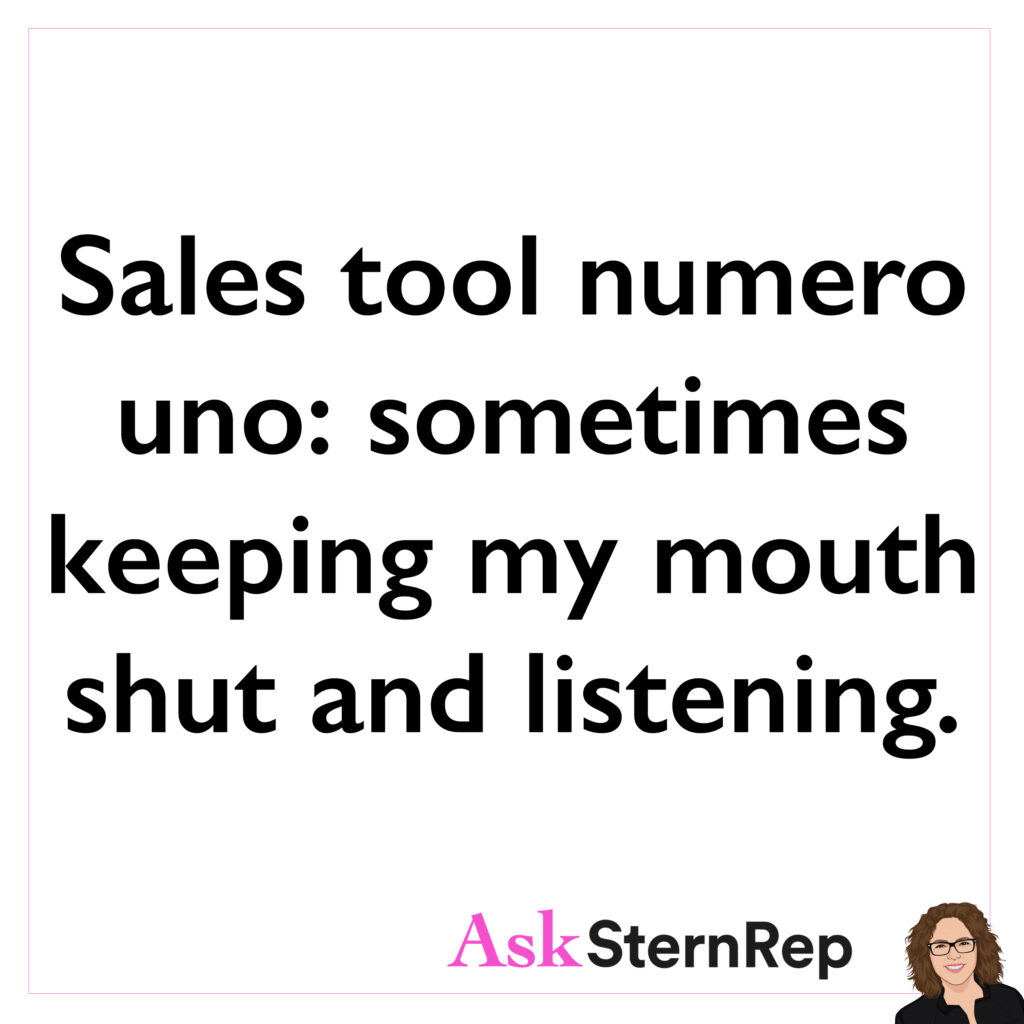
Sales tool number uno: sometimes keeping my mouth shut and listening
A Bad Estimate

Q:
Did a bad estimate ever lose a photographer the job?
A:
Guest Post, Mara Serdans: Yes, absolutely, If I feel like a photographer did not understand the scope or properly estimate the job, I let my team know that it could be a risk. I also let the photographer and/or agent know so they can learn from the experience.
Guest Post: Creative Consultant, Mara Serdans
You Want to be in a Place of Uncertainty

“Whenever you’re a creative person, you always have a certain amount of insecurity and uncertainty,” she said. “You want to be in a place of uncertainty, a place where something surprising can happen. That’s where the gold is.”
– Actress Annette Bening via LA Times
Print Mailers

Q:
Right now we send print mailers to approx 500 people 3-4 times per year. At what point should we remove someone from the print mailing list if we haven’t received a response after maining, emailing and calling on multiple occasions?
A:
Continuously fine tune your list to match the images you are sending, and update it as people move around. Not getting a response is not the problem. In our business we have no idea when our promos are working because the norm is not to get a response. So update constantly but not for that reason.
Speak In Each Email As If It’s The First One

Always assume your client has less than one second for your email. Include any links they may already know. Write in full sentences that retrace the emails so they don’t need to scroll down and read old ones to understand. Speak in each email as if it’s the first one, gathering all the info. Unless of course, you are responding immediately, then it can be quick “yes” or “no”, etc.
The Right Photographer for the Job

Q:
Are there any specific stories around why you didn’t put a specific photographer up for a job?
A:
Guest Post, Mara Serdans: More often than not, I won’t put a specific photographer up for a job because he/she is not an appropriate fit for the project. It may also come down to budget – if I know a photographer is not within the ballpark, it’s a waste of everyone’s time to put him/her in the mix. Lastly, it might come down to having a bad experience from a previous job or a difficult agent who makes things harder than they should be for myself, the internal team and the client. No one wants to work with someone who is “difficult.”
Guest Post: Creative Consultant, Mara Serdans
5 REASONS WHY I’M NOT REPPING YOU
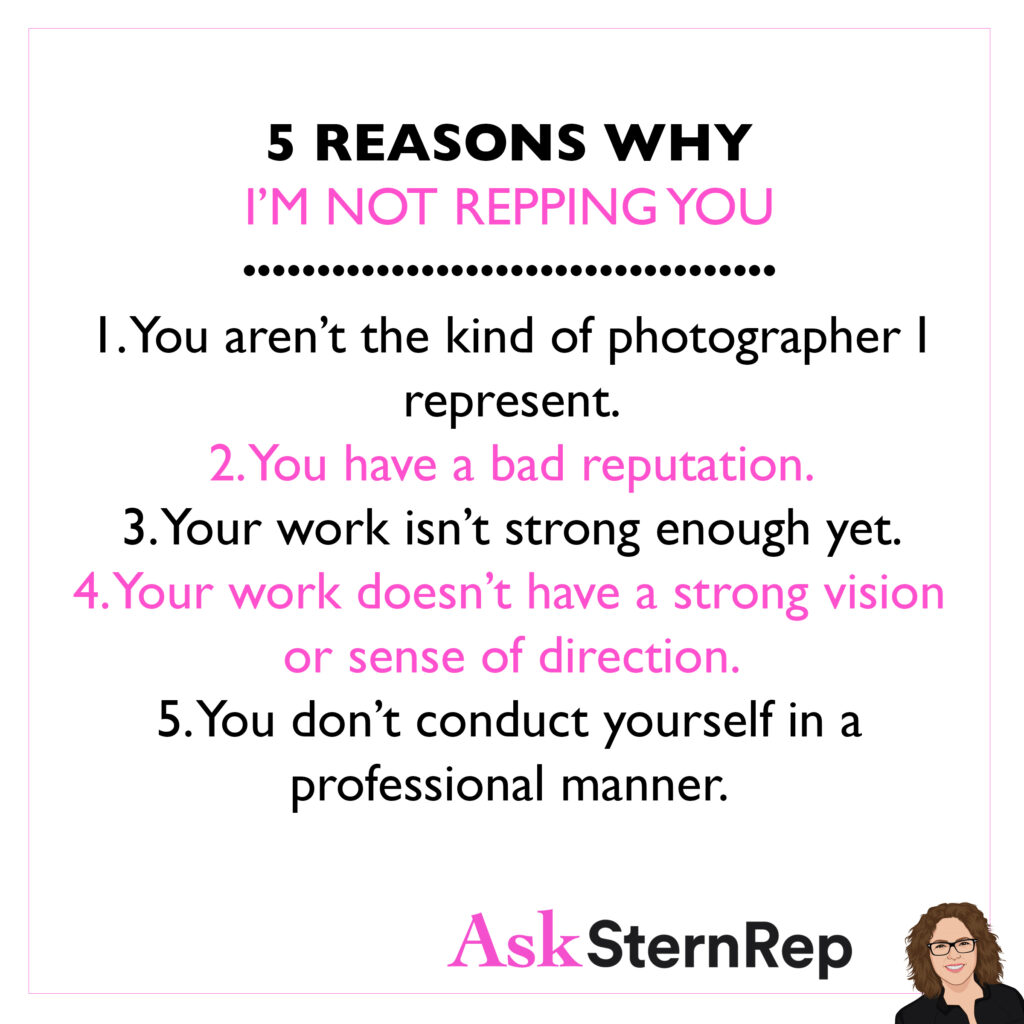
5 REASONS WHY
I’M NOT REPPING YOU
1. You aren’t the kind of photographer I represent.
2. You have a bad reputation.
3. Your work isn’t strong enough yet.
4. Your work doesn’t have a strong vision or sense of direction.
5. You don’t conduct yourself in a professional manner.
Smaller Budgets
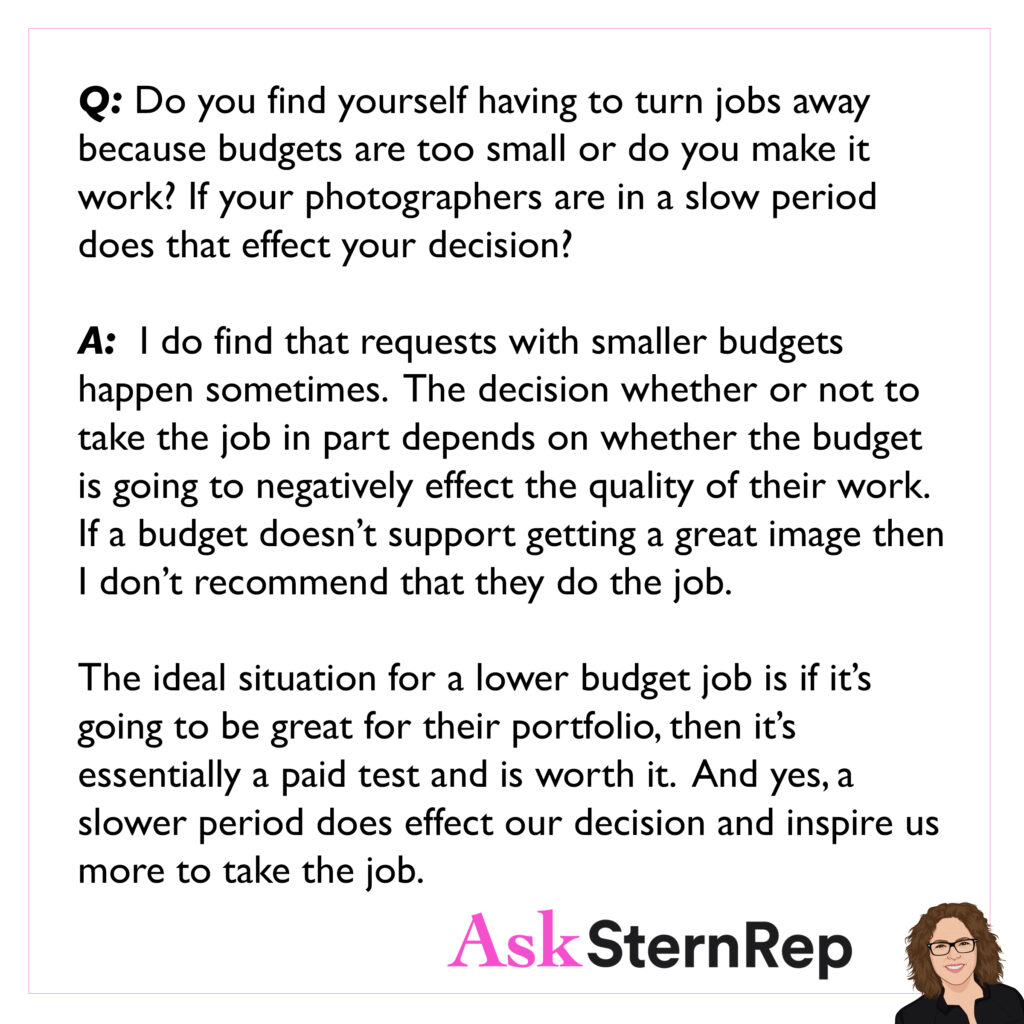
Q:
Do you find yourself having to turn jobs away because budgets are too small or do you make it work? If your photographers are in a slow period does that affect your decision?
A:
I do find that requests with smaller budgets happen sometimes. The decision whether or not to take the job in part depends on whether the budget is going to negatively affect the quality of their work. If a budget doesn’t support getting a great image then I don’t recommend that they do the job.
The ideal situation for a lower budget job is if it’s going to be great for their portfolio, then it’s essentially a paid test and is worth it. And yes, a slower period does affect our decision and inspires us more to take the job.
Build A Business

Whether your medium is photography, illustration or video… if you want to be successful in today’s marketplace, you need to build a business. Today’s challenges have never been greater. Nor only do you need to win the account from your neighboring photographer, but you’re also competing with stock collections, free content, in-house production departments, pro-consumer digital cameras giving clients the opportunity to take their own images… and an authentic trend of embracing “real photography” taken from smartphones. Ah, but there is a silver lining to our future, our industry has never needed visual content more than they do today… Though you might feel weighed down by the realities of this industry, if you can rise above the clutter and visual noise out there, you can have a very successful career.
Guest Post: Agency Access
The Photographer’s Survival Guide to Marketing
Following up After Promos
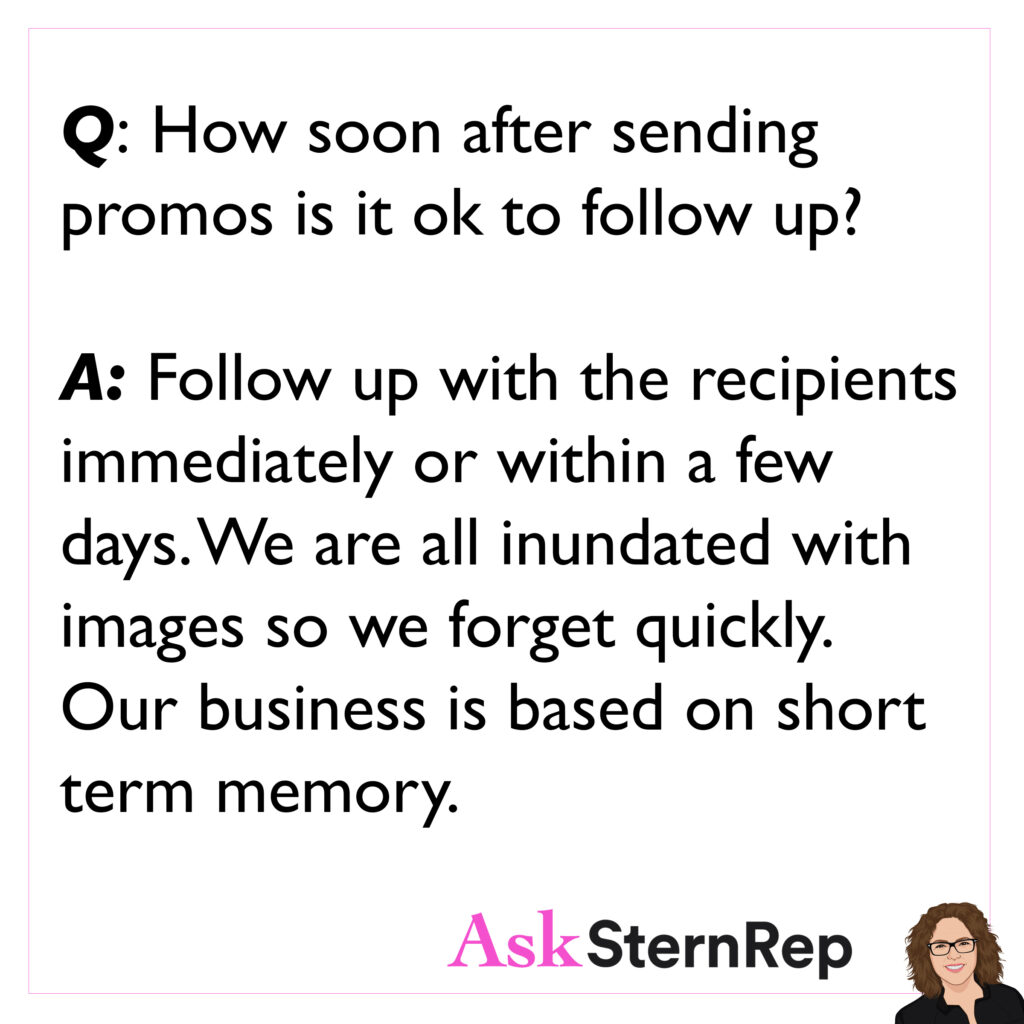
Q:
How soon after sending promos is it ok to follow up?
A:
Follow up with the recipients immediately or within a few days. We are all inundated with images so we forget quickly. Our business is based on short term memory.
Show a Commercial Advertising Portfolio

If you want to be getting commercial advertising jobs show a commercial advertising portfolio.
Finding New Photographers

Q:
How do you find new photographers? Specific websites?
A:
Guest Post, Mara Serdans: I get lots of emails and promos from photographers. Otherwise, I find new photographers on Instagram, at portfolio reviews, blogs, magazines and at gallery shows. I peruse directories like At-Edge, Workbook, and Found Folios. I love checking out PDN’s Annual listing of New and Emerging Photographers. I’ll even go back to the previous years’ listings to remind myself of the talent.
Guest Post: Creative Consultant, Mara Serdans
YOU CANNOT BE AFRAID TO FAIL.
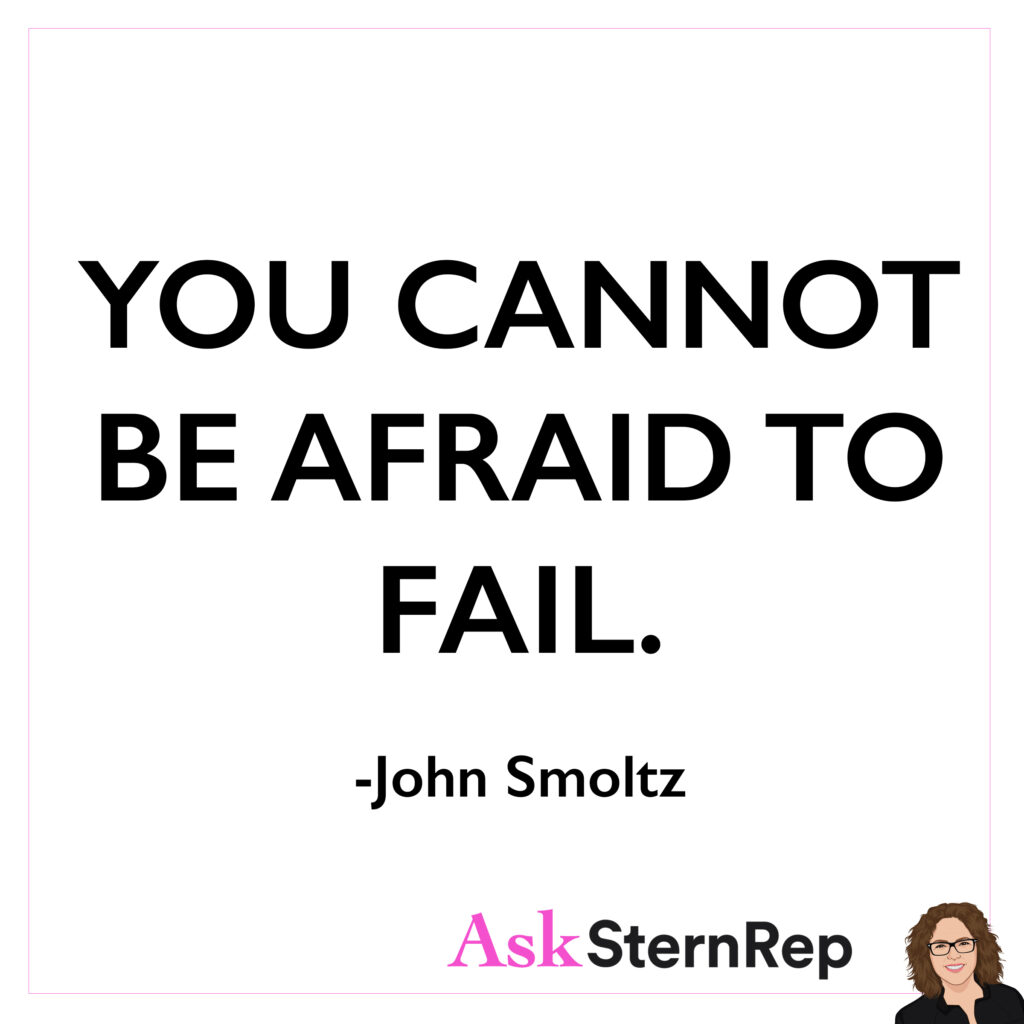
YOU CANNOT BE AFRAID TO FAIL.
– John Smoltz
Be Upfront and Honest

Be up front and honest with people you work with. Even when it may be an uncomfortable conversation.
If you can offer feedback or broach challenging topics in a clear, simple, and non-aggressive way, people will often be far more receptive.
Not taking things personally and not fretting about being honest with people. Asking for what you need in a very clean way. That’s one of the keys I have been learning from Andrea!
Guest Post: Olivia Katz, SternRep Director of Operations
What Andrea Looks for in a Photographer

Q:
Andrea, what do you look for in a photographer?
A:
I look for a talented photographer and one that I feel I can help to bring out their very best. 20 years in this business has shown me that it is this dynamic that leads to jobs. This is what it means for me to represent a photographer. I represent them. They come up with who they are and I manage and shape the marketing strategy.
I’m their voice to the larger world, so they have to be someone I feel proud to speak for. They must have solid talent or we won’t get very far. They also have to confidently know their creative talents because I will take that and run with it. Who they are and the quality of their portfolio shapes the direction and I just take that further.
Face It

Face it, you are a creative so sometimes, no plan, is the best plan of all
Most Important Part of an Email

Most important part of an email is to spell their name correctly. Read it out loud. Twice.
Your Voice
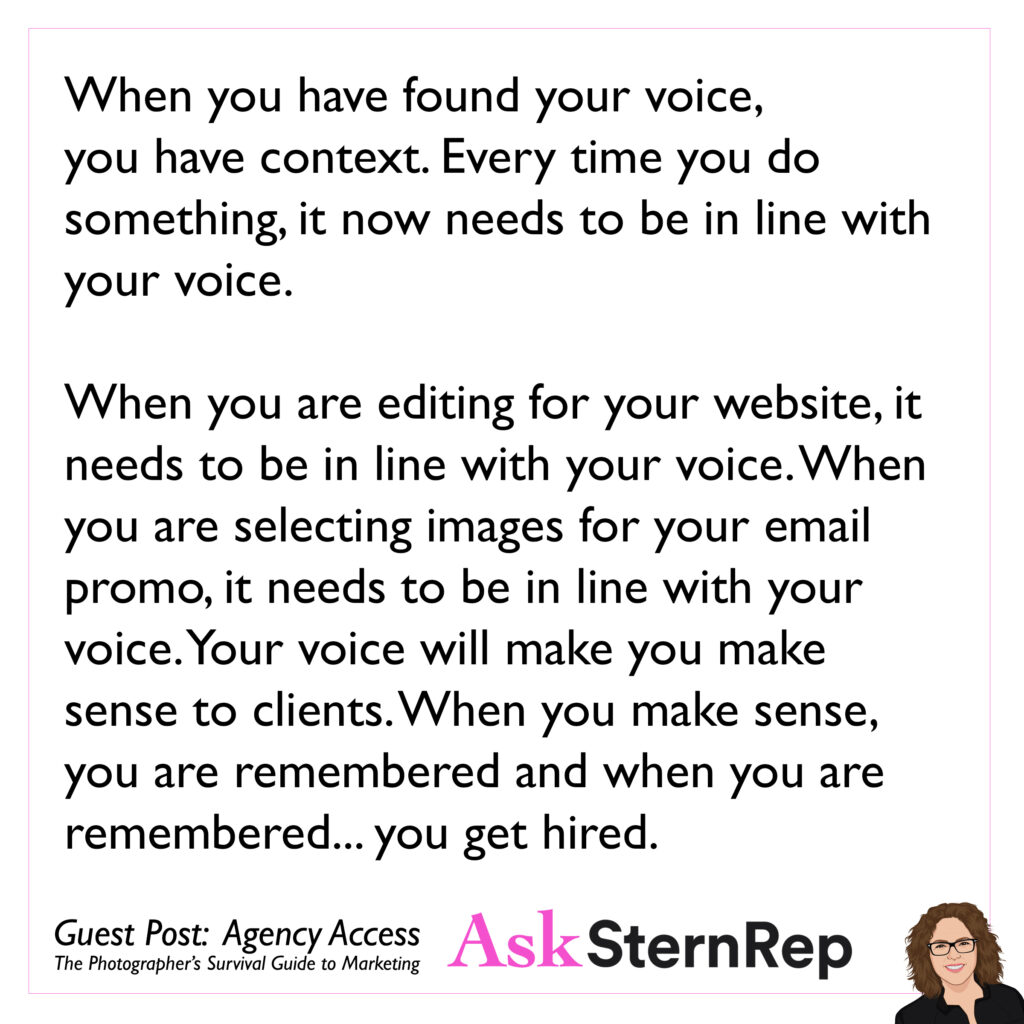
When you have found your voice, you have context. Every time you do something, it now needs to be in line with your voice.
When you are editing for your website, it needs to be in line with your voice. When you are selecting images for your email promo, it needs to be in line with your voice. Your voice will make you make sense to clients. When you make sense, you are remembered and when you are remembered… you get hired.
Guest Post: Agency Access
The Photographer’s Survival Guide to Marketing
Work Harder
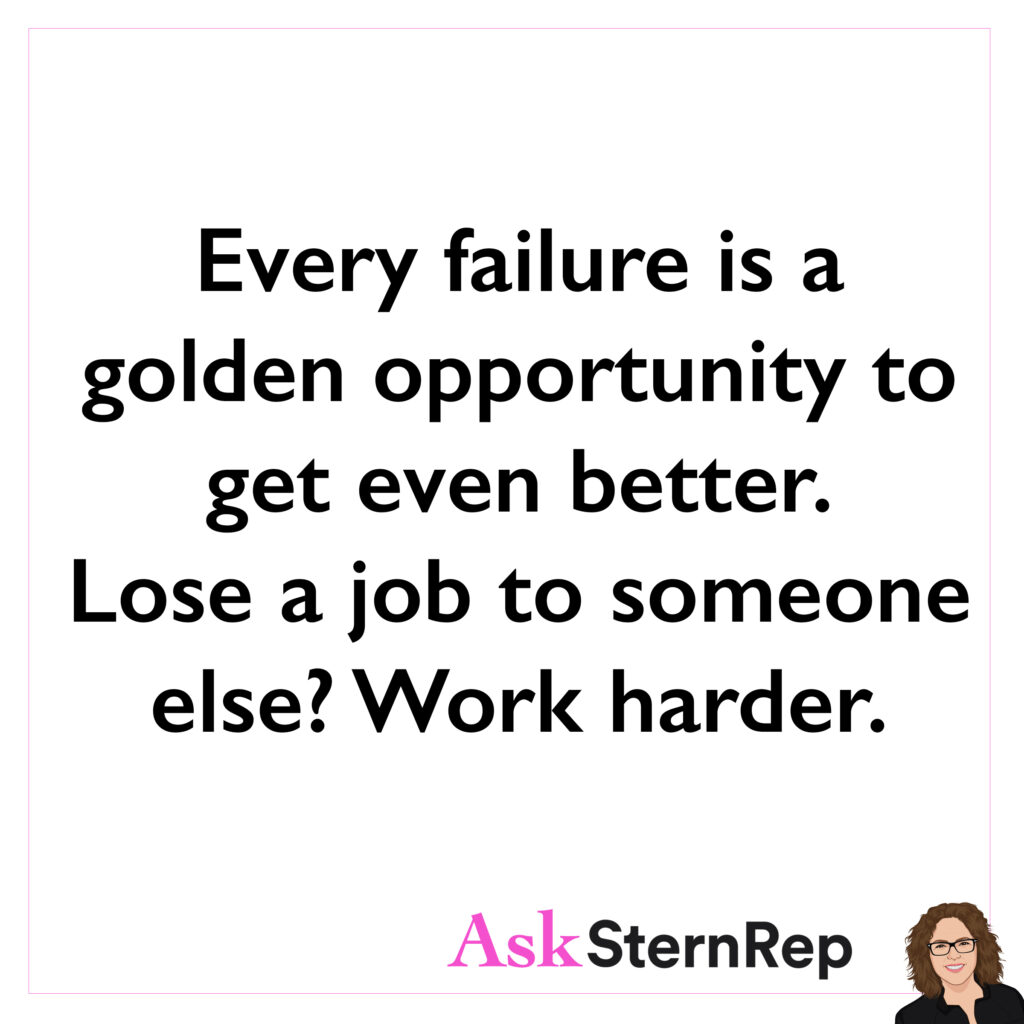
Every failure is a golden opportunity to get even better. Lose a job to someone else? Work harder.
If the Phone Is Not Ringing…

If the phone is not ringing, stretch yourself.
Staying Hot in a Changing Industry

Q:
What does it take to stay hot as a photographer in this constantly changing industry?
A:
As a photographer, you have to constantly evolve, push yourself, and take chances if you want to succeed. It really is true that you have to be willing to leave your comfort zone if you want to get anywhere. Media and technology change so quickly that it can be tough to keep up. But when you learn to embrace changes and become adaptable, a lot of things start to happen.
Guest Post: John Duarte, Photographer
The Process of Hiring a Photographer
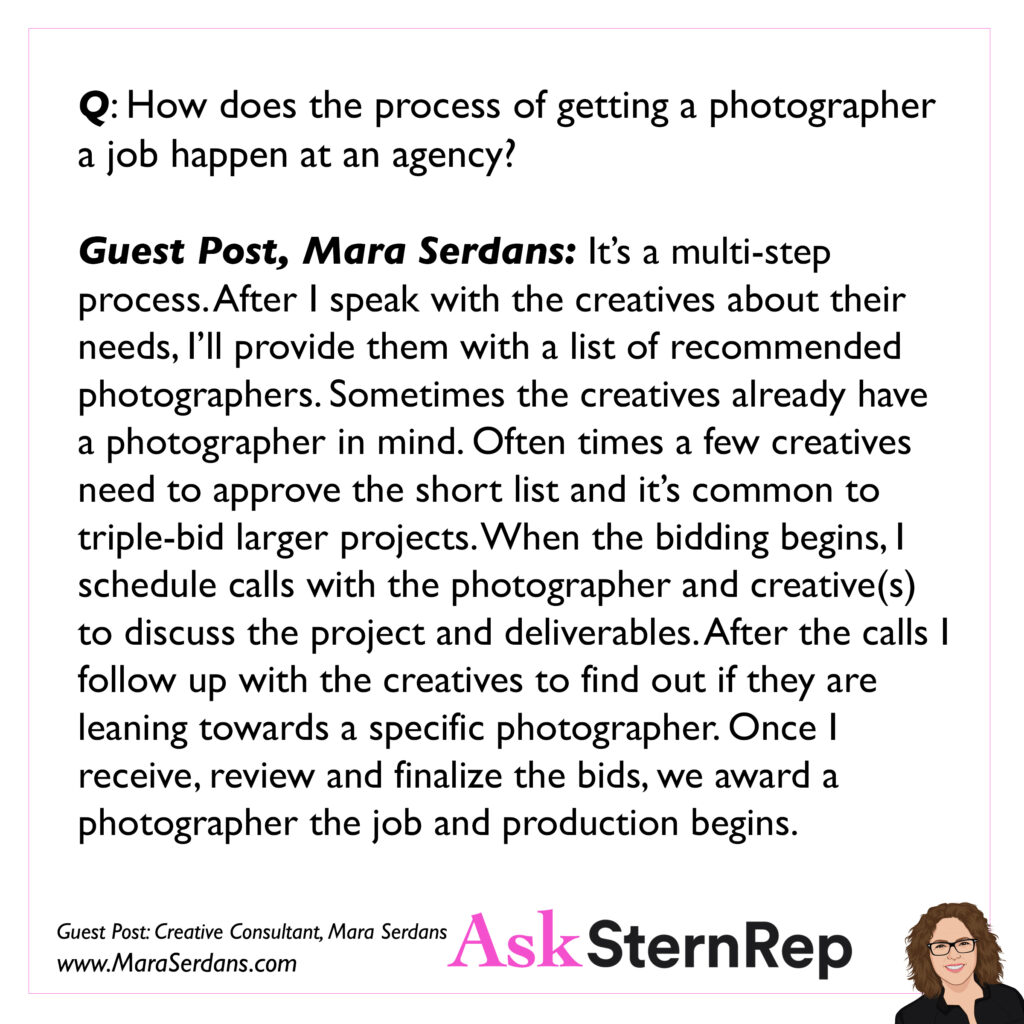
Q:
How does the process of getting a photographer a job happen at an agency?
A:
Guest Post, Mara Serdans: It’s a multi-step process. After I speak with the creatives about their needs, I’ll provide them with a list of recommended photographers. Sometimes the creatives already have a photographer in mind. Oftentimes a few creatives need to approve the short list and it’s common to triple-bid larger projects. When the bidding begins, I schedule calls with the photographer and creative(s) to discuss the project and deliverables. After the calls I follow up with the creatives to find out if they are leaning towards a specific photographer. Once I receive, review and finalize the bids, we award a photographer the job and production begins.
Guest Post: Creative Consultant, Mara Serdans
Your Voice Is About Consistency
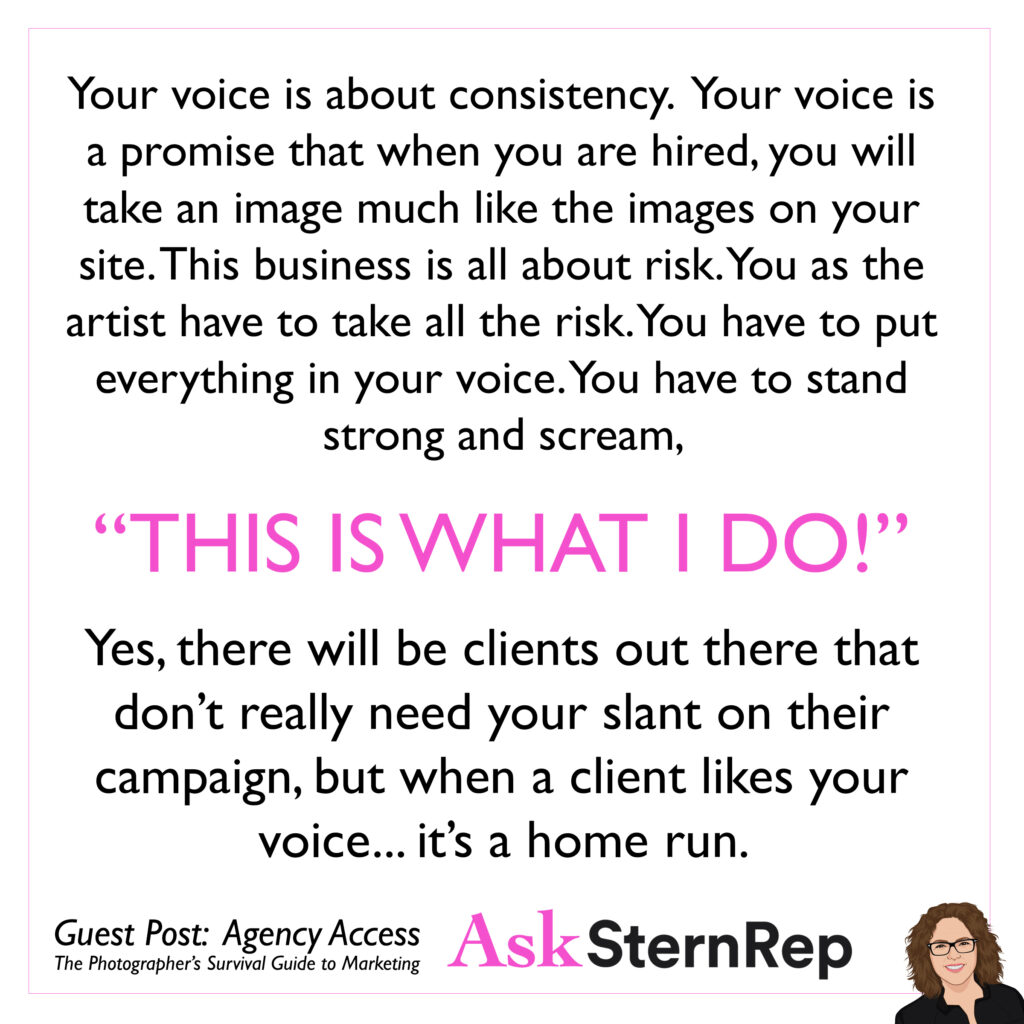
Your voice is about consistency. Your voice is a promise that when you are hired, you will take an image much like the images on your site. This business is all about risk. You as the artist have to take all the risk. You have to put everything in your voice. You have to stand strong and scream,
“THIS IS WHAT I DO!”
Yes, there will be clients out there that don’t really need your slant on their campaign, but when a client likes your voice… it’s a home run.
Guest Post: Agency Access
The Photographer’s Survival Guide to Marketing
Buy-Out/Unlimited Usage

Q:
Are you finding that clients have begun requesting “buy out/unlimited usage,” for photos but they have a set budget that may not be realistic for unlimited rights?
A:
In general, my answer is absolutely yes, all the time.
And when I hear this, it sounds to me like they are trying to get extra usage for free.
The answer is to charge more.
I have learned not to parse out usage but to definitely factor it into the day rate. I’d let them know that for that usage the day rate is going to go up…potentially double.
AND- I’d use this in your negotiations, and if they say “this is too high,” you can say, “we can discuss the usage.”
The Purpose of a Test
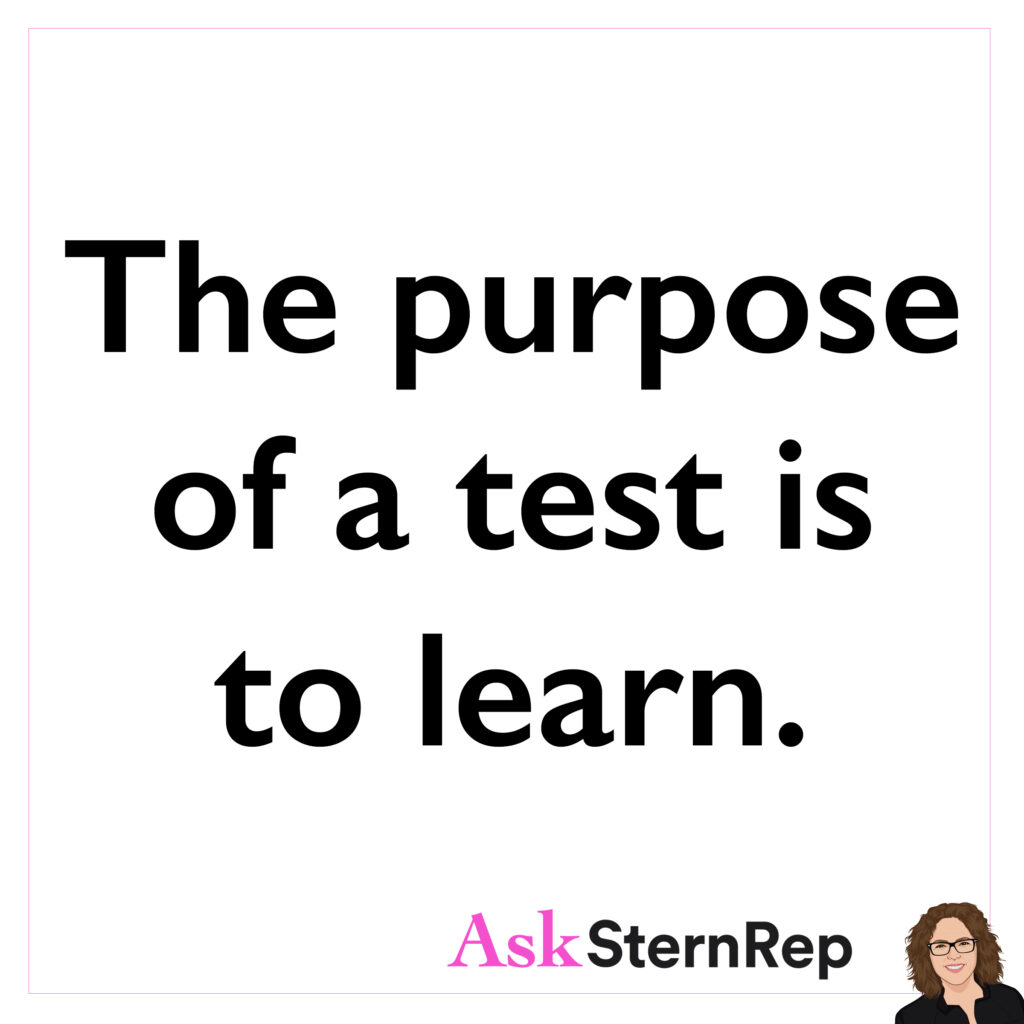
The purpose of a test is to learn.
Do You Still Need a Printed Book?

Q:
(Agency Access): Do you still need a print book?
A:
(Agency Access): The answer is YES,
When a client is seriously considering you for a job, they want to see your book. When your rep goes to visit a client, they need a book. When you go to portfolio reviews, you need a book. Some folks have moved on to iPads which is a good move if you do video. Clients still love to see your images in print and there are never technical difficulties with a print book. Make at least one big, beautiful, no plastic sleeve, full bleed, to die for book. It won’t disappoint.
Guest Post: Agency Access
The Photographer’s Survival Guide to Marketing
NO DRAMA

The secret to success for photographers is not to show their “cards” under pressure. Relax and always tell yourself it all gets done in the end with a great supportive team. Diva photographers are a thing of the past and no one wants to work with those guys anymore, high profile and talented or not. People want a light-hearted fun running set, NO DRAMA.
Guest Post: Anonymous
Pitfalls in Marketing

Q:
What would you say is the biggest pitfall you see photographers making in terms of marketing?
A:
Guest Post, Josh Rossi: One of the biggest pitfalls photographers make is not treating photography as a product that solves problems. A lot of photographers think companies hire them just to take pretty pictures. In reality the company is hiring them to solve a problem. If you can figure out what problems companies have and figure out a way to solve them then you can create a more compelling pitch, and that is what will get you hired.
Guest Post: Josh Rossi
It’s A New World

It’s a new world where a photographer has to actively out themselves out there.
Portfolio Recommendations

Q:
What type of books do you recommend to photographers coming up in their careers that are both presentable and feasible?
A:
This is a very relevant question for this time in our business because websites and social media are the new portfolios.
Currently, it is very rare that someone would ask you to come in and show your book, unless you go out of your way and make that happen. It’s something extra you can do. If you are going to show a “book” a printed book is the best way to go.
No Need To Over-Share

Encourage those around you. Don’t tell your clients or models everything you are thinking or working out in your mind. You are the host of the party. Everyone will follow your lead. If something happens that throws you off, quietly figure it out with your team. No need to over-share. Be a professional.
Guest Post: Anonymous
Listen
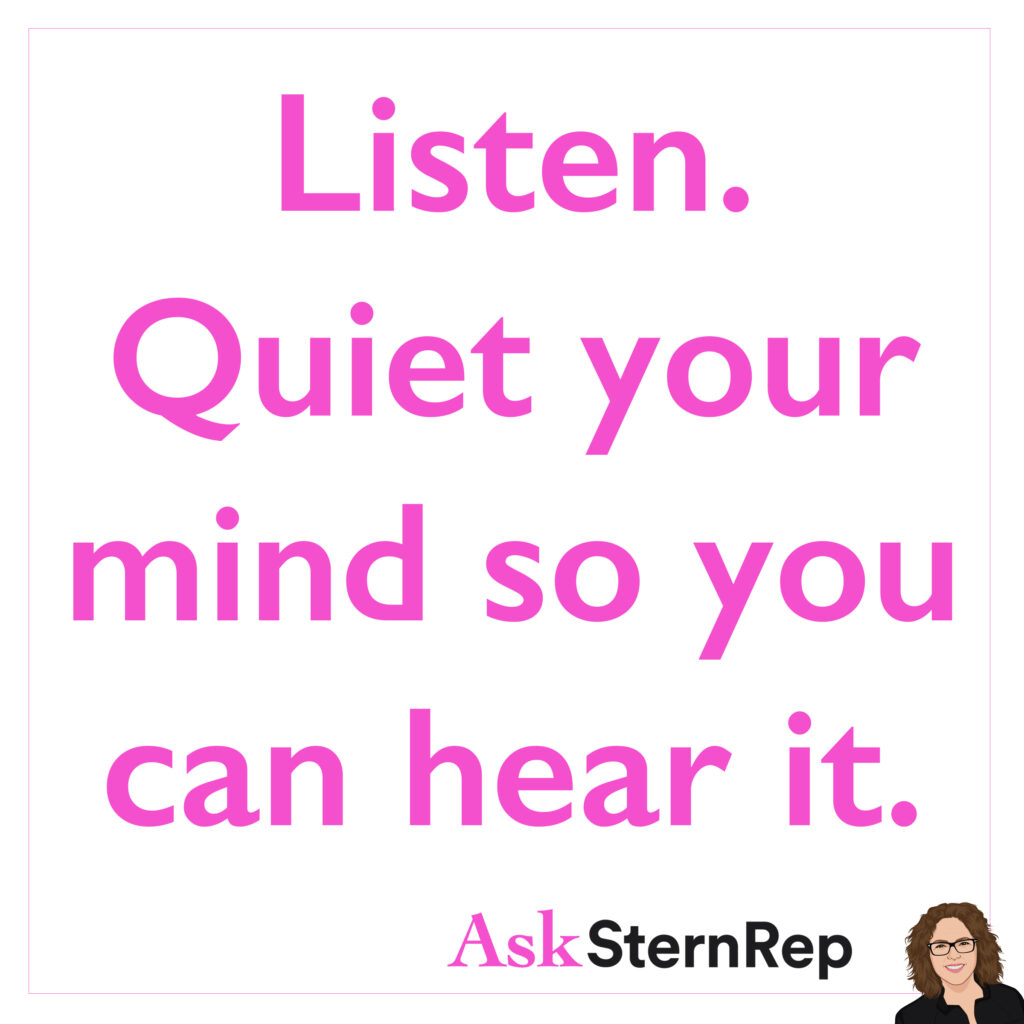
Listen.
Quiet your mind so you can hear it.
Pros and Cons of Being Represented

Q:
What would you say are the pros and cons of being represented?
A:
The pros and cons of being represented are really just about having the right rep for you. Say you are repped by someone your clients don’t know or respect and you also stop doing your own marketing, those would be cons.
One pro of having the right rep is that they can get your work seen by the right clients. They also help you shape your marketing/direction/style and negotiate your bids. All of this really depends on what your market is. I have found that it is harder to rep a photographer who shoots just about everything vs a photographer who is known for one look.
What A Rep Needs From You
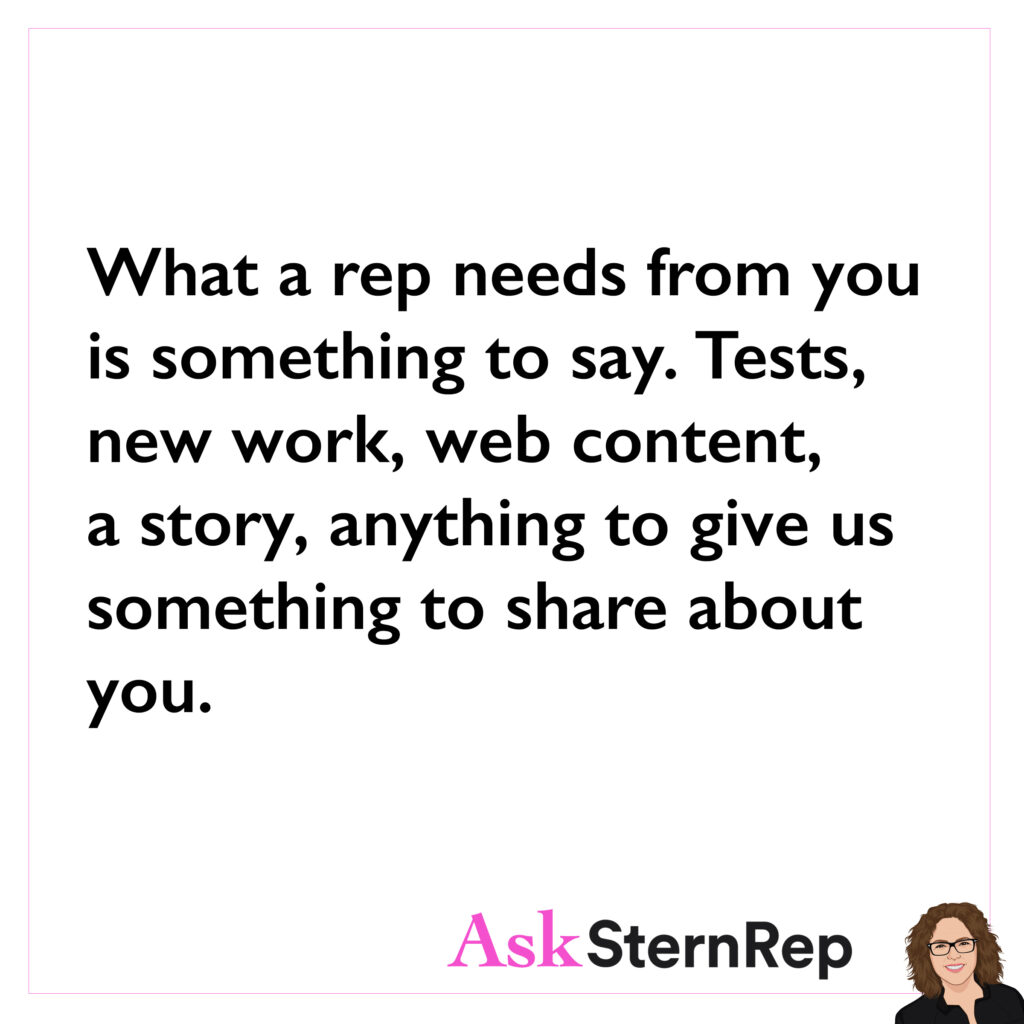
What a rep needs from you is something to say. Tests, new work, web content, a story, anything to give us something to share about you.
A Good Portfolio
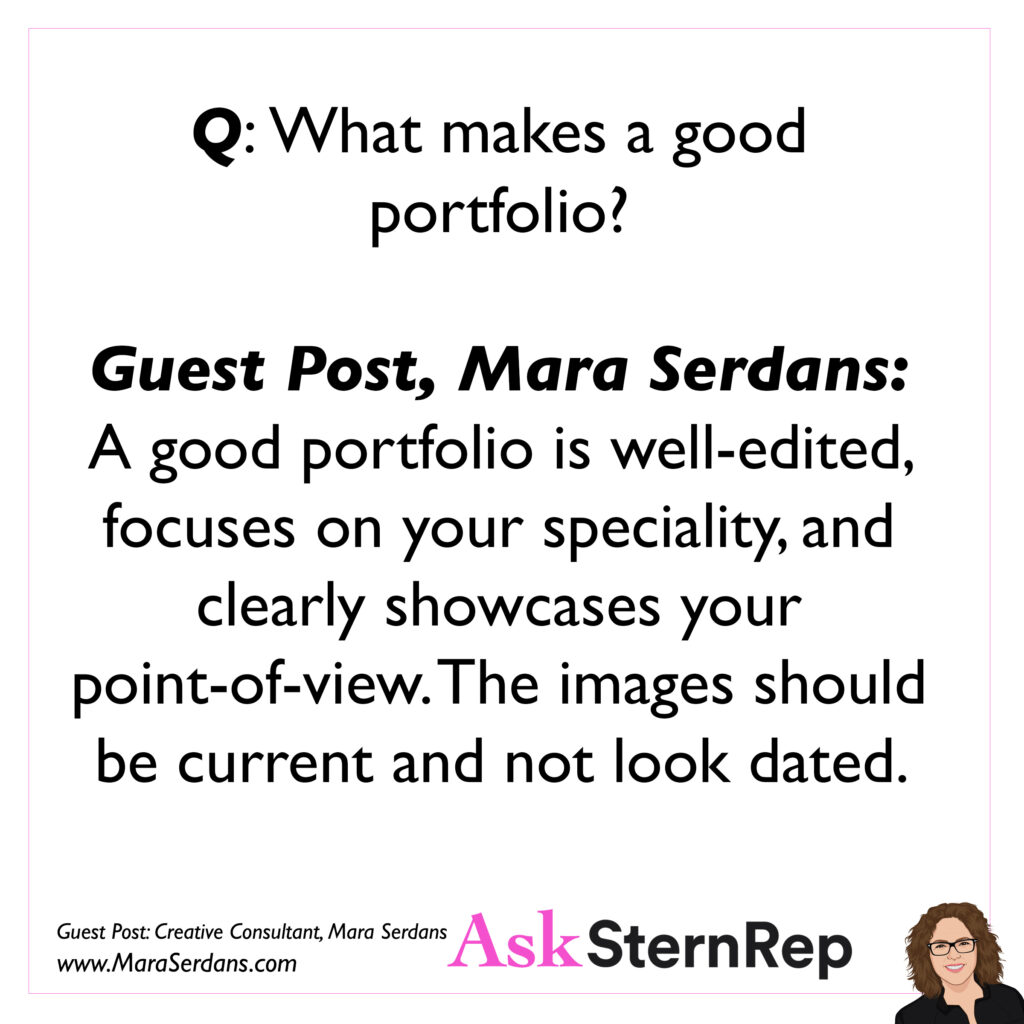
Q:
What makes a good portfolio?
A:
Guest Post, Mara Serdans: A good portfolio is well-edited, focuses on your specialty, and clearly showcases your point-of-view. The images should be current and not look dated.
Guest Post: Creative Consultant, Mara Serdans
THINK OUTSIDE THE BOX
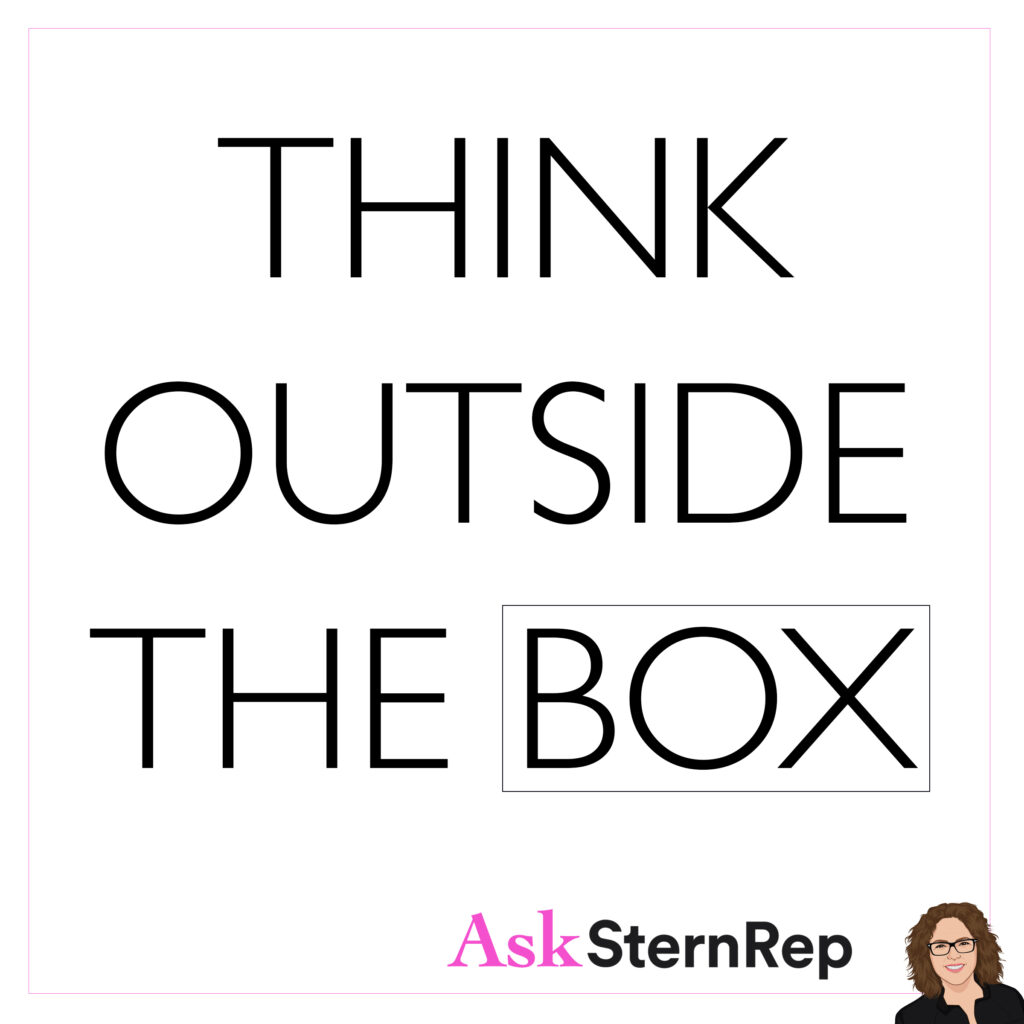
THINK OUTSIDE THE BOX
Reaching Out to Clients
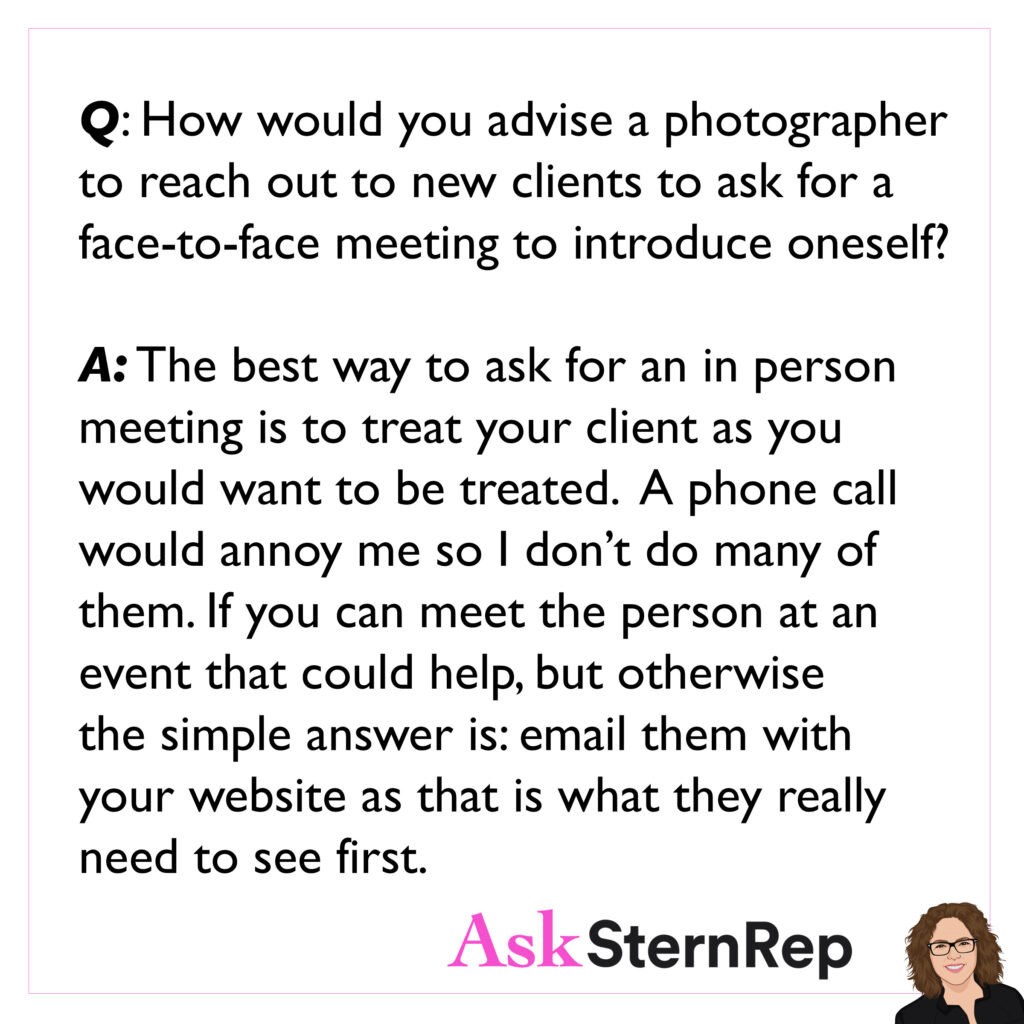
Q:
How would you advise a photographer to reach out to new clients to ask for a face-to-face meeting to introduce oneself?
A:
The best way to ask for an in person meeting is to treat your client as you would want to be treated. A phone call would annoy me so I don’t do many of them. If you can meet the person at an event that could help, but otherwise the simple answer is: email them with your website as that is what they really need to see first.
Don’t Put Your Copyright On Your Images
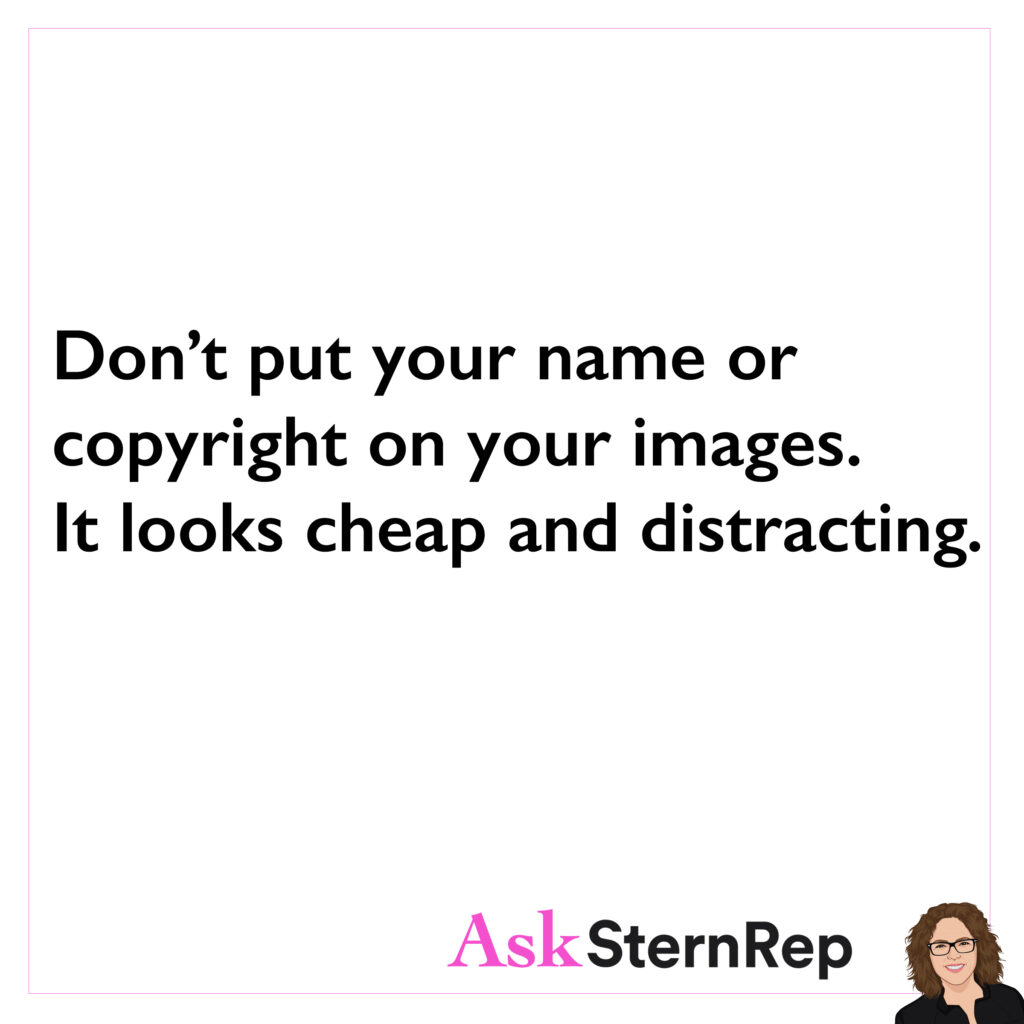
Don’t put your name or copyright on your images. It looks cheap and distracting.
Examples of a Bad Estimate
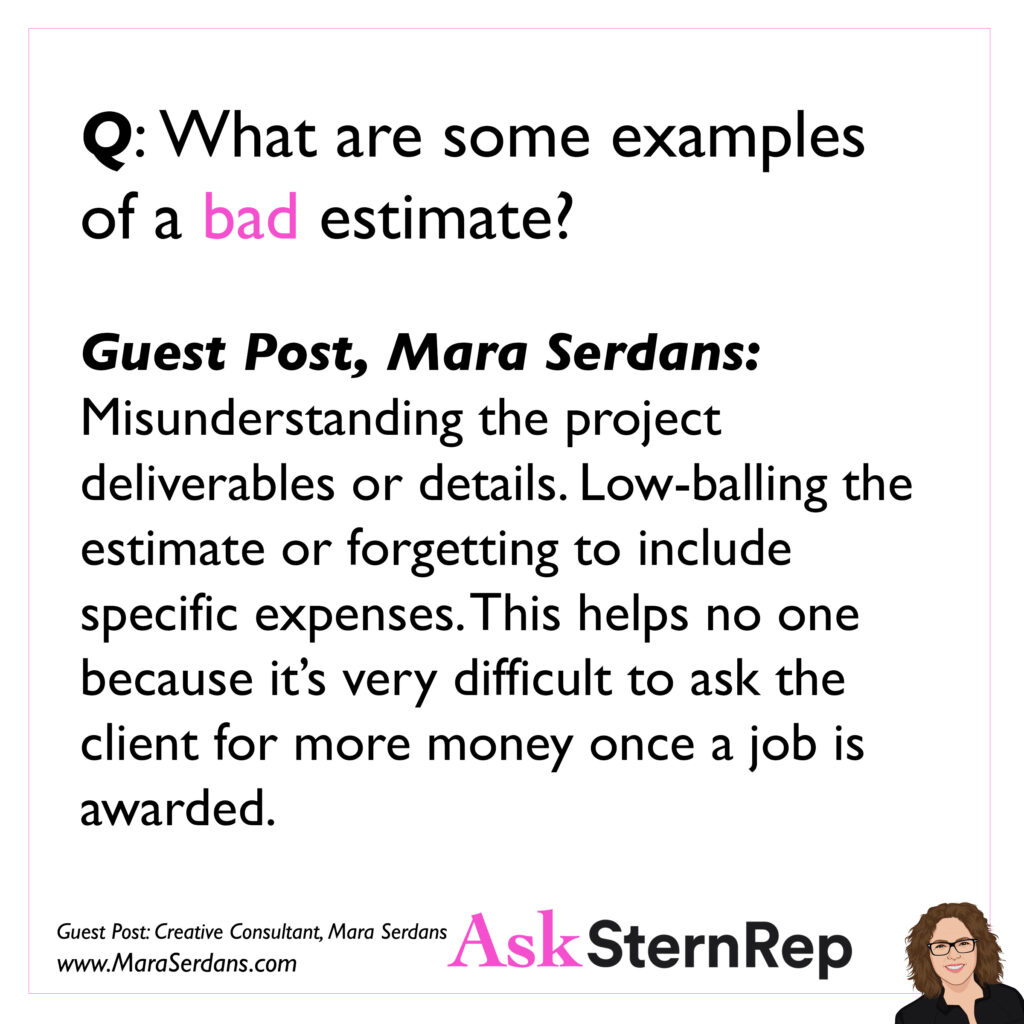
Q:
What are some examples of a bad estimate?
A:
Guest Post, Mara Serdans: Misunderstanding the project deliverables or details. Low-balling the estimate or forgetting to include specific expenses. This helps no one because it’s very difficult to ask the client for more money once a job is awarded.
Guest Post: Creative Consultant, Mara Serdans
Stay Strong In Your Style

Stay strong in your style.
Don’t compromise your voice to be everything to everyone or you will get lost in the mix. It is your unique vision and execution which will set you apart from the pack and get you the job!
How to Start in Advertising
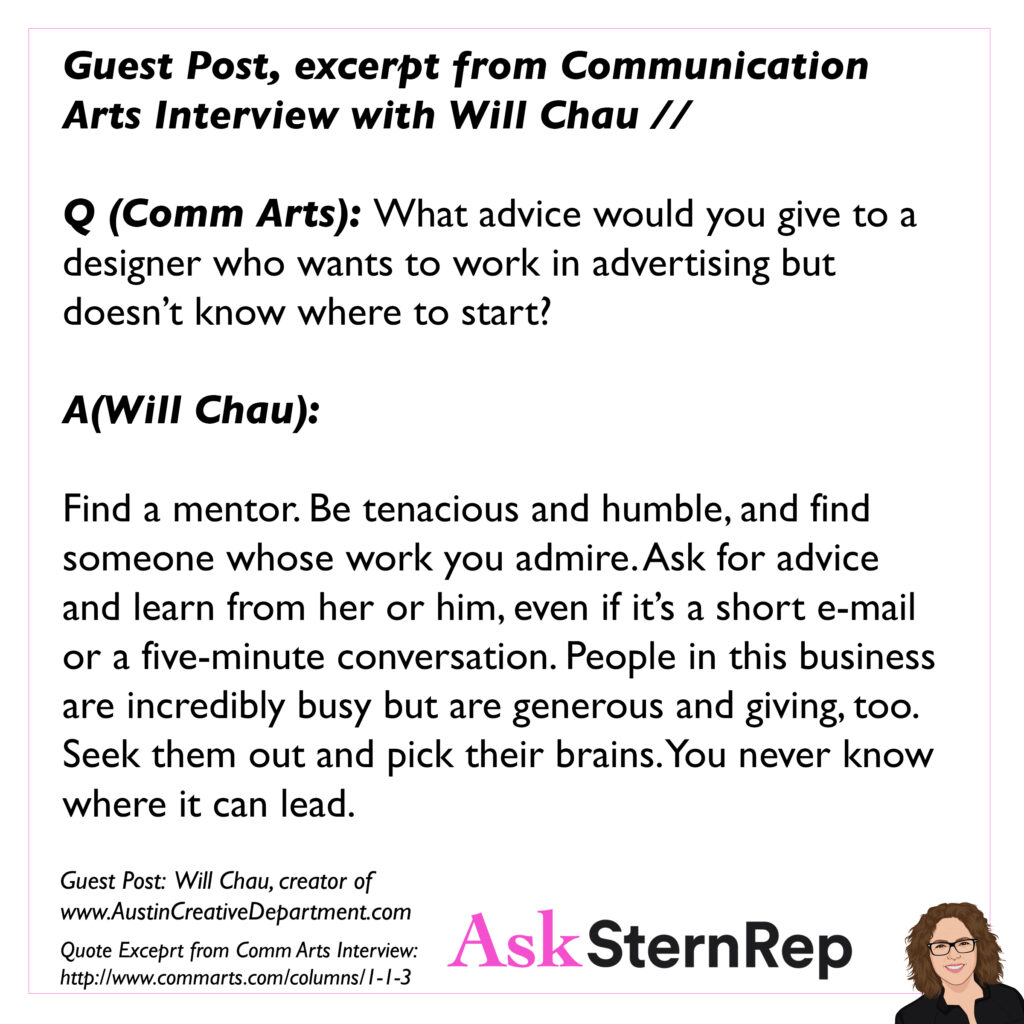
Q:
(Comm Arts): What advice would you give to a designer who wants to work in advertising but doesn’t know where to start?
A:
(Will Chau): Find a mentor. Be tenacious and humble, and find someone whose work you admire. Ask for advice and learn from her or him, even if it’s a short e-mail or a five-minute conversation. People in this business are incredibly busy but are generous and giving, too. Seek them out and pick their brains. You never know where it can lead.
Guest Post: Will Chau, creator of http://www.AustinCreativeDepartment.com
Quote Excerpt from Comm Arts Interview: http://www.commarts.com/columns/1-1-3
Approaching Potential Clients
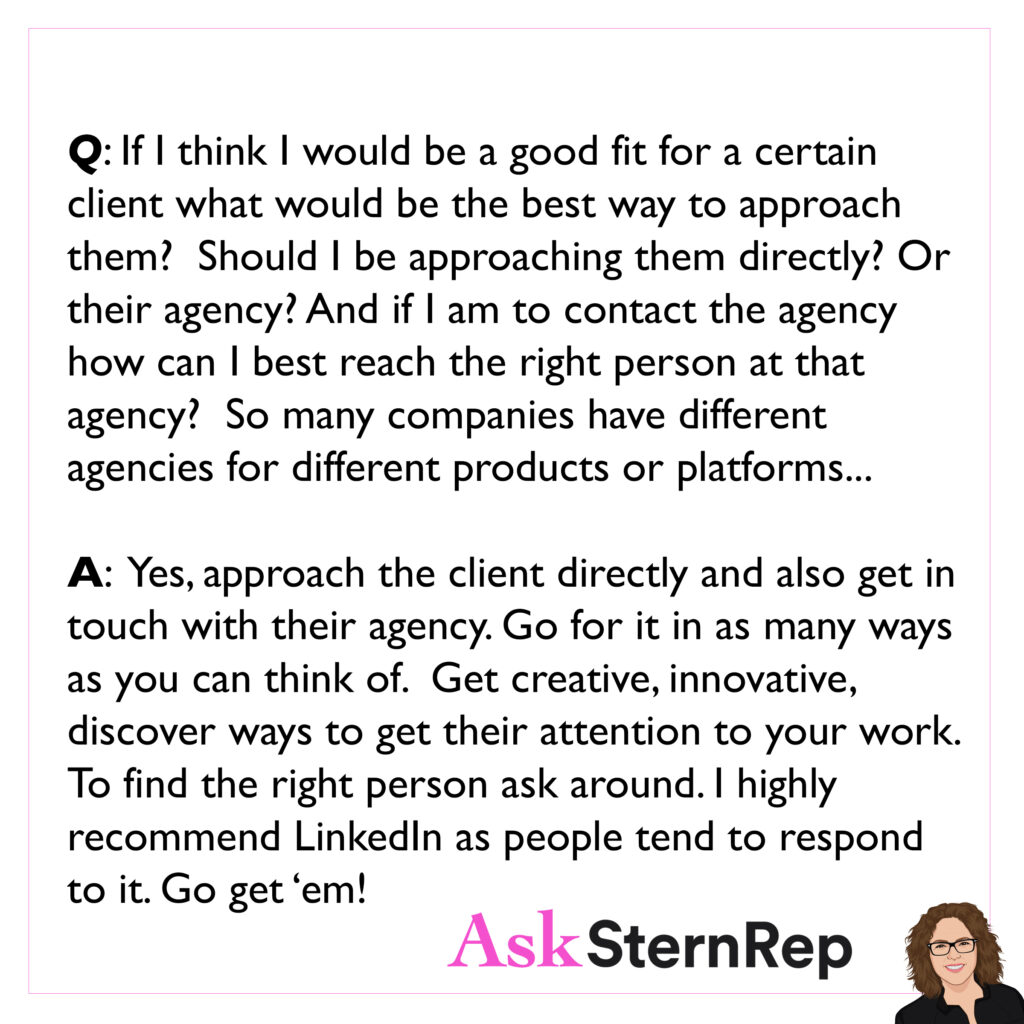
Q:
If I think I would be a good fit for a certain client what would be the best way to approach them? Should I be approaching them directly? Or their agency? And if I am to contact the agency how can I best reach the right person at that agency? So many companies have different agencies for different products or platforms…
A:
Yes, approach the client directly and also get in touch with their agency. Go for it in as many ways as you can think of. Get creative, innovative, discover ways to get their attention to your work. To find the right person, ask around. I highly recommend LinkedIn as people tend to respond to it. Go get ‘em!
Rejection?
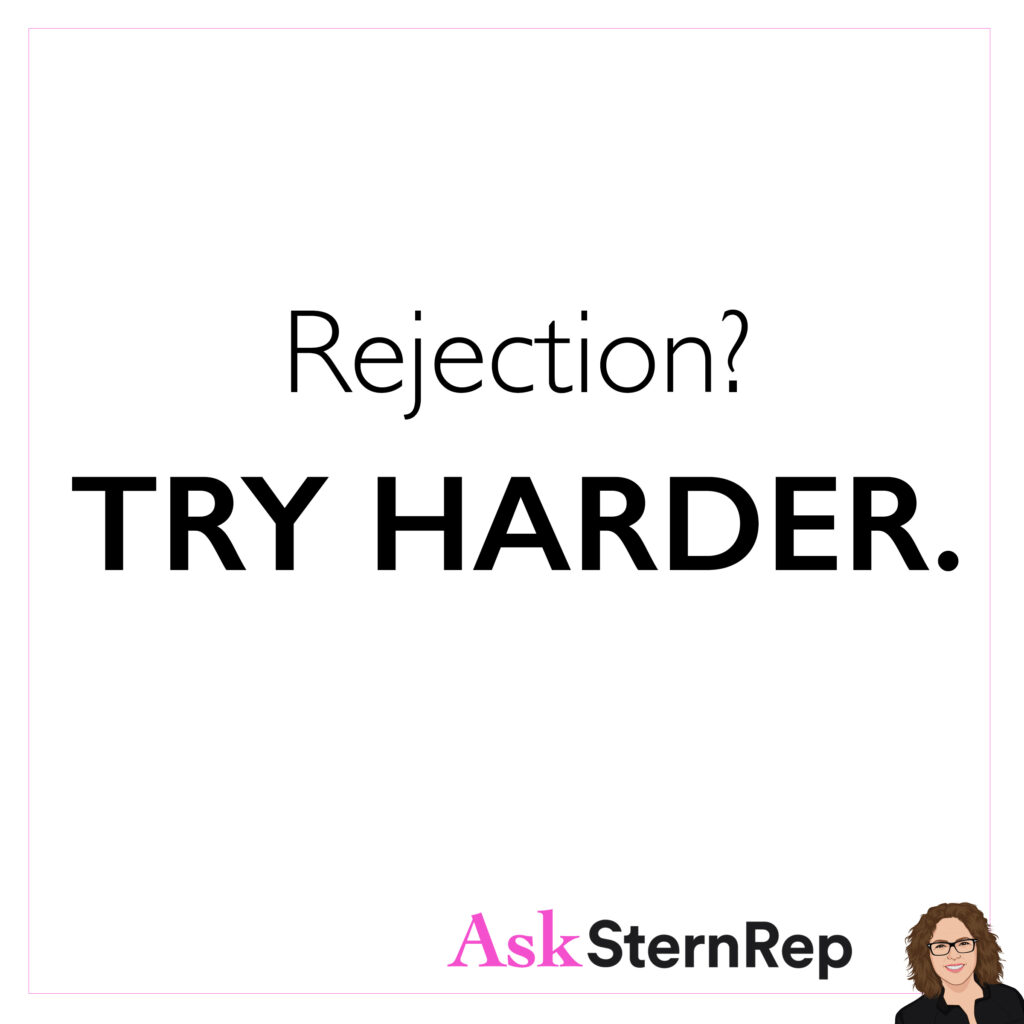
Rejection?
TRY HARDER.
Multiple Reps
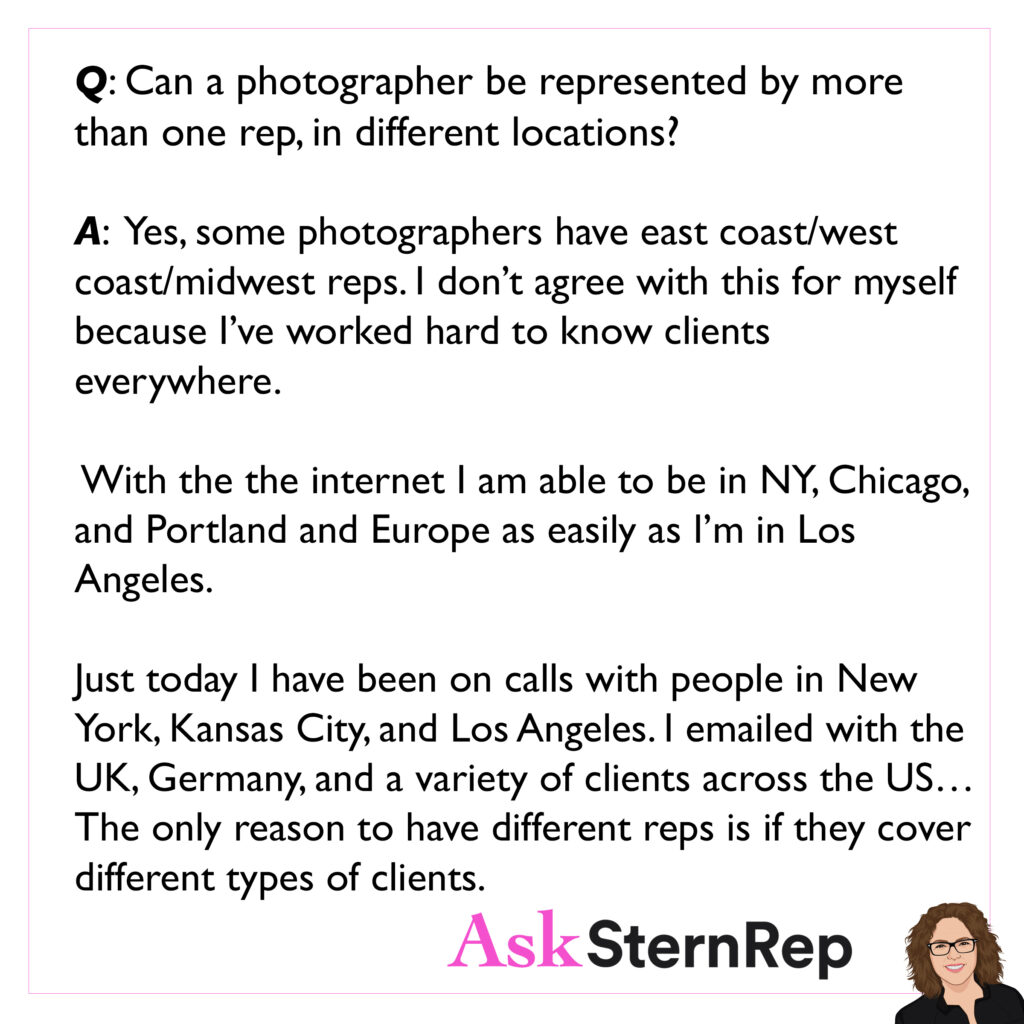
Q:
Can a photographer be represented by more than one rep, in different locations?
A:
Yes, some photographers have east coast/west coast/midwest reps. I don’t agree with this for myself because I’ve worked hard to get to know clients everywhere.
With the internet I am able to be in NY, Chicago, Portland and Europe as easily as I’m in Los Angeles.
Just today I have been on calls with people in New York, Kansas City and Los Angeles. I emailed with the UK, Germany and a variety of clients across the US… The only reason to have different reps is if they cover different types of clients.
2 Seconds
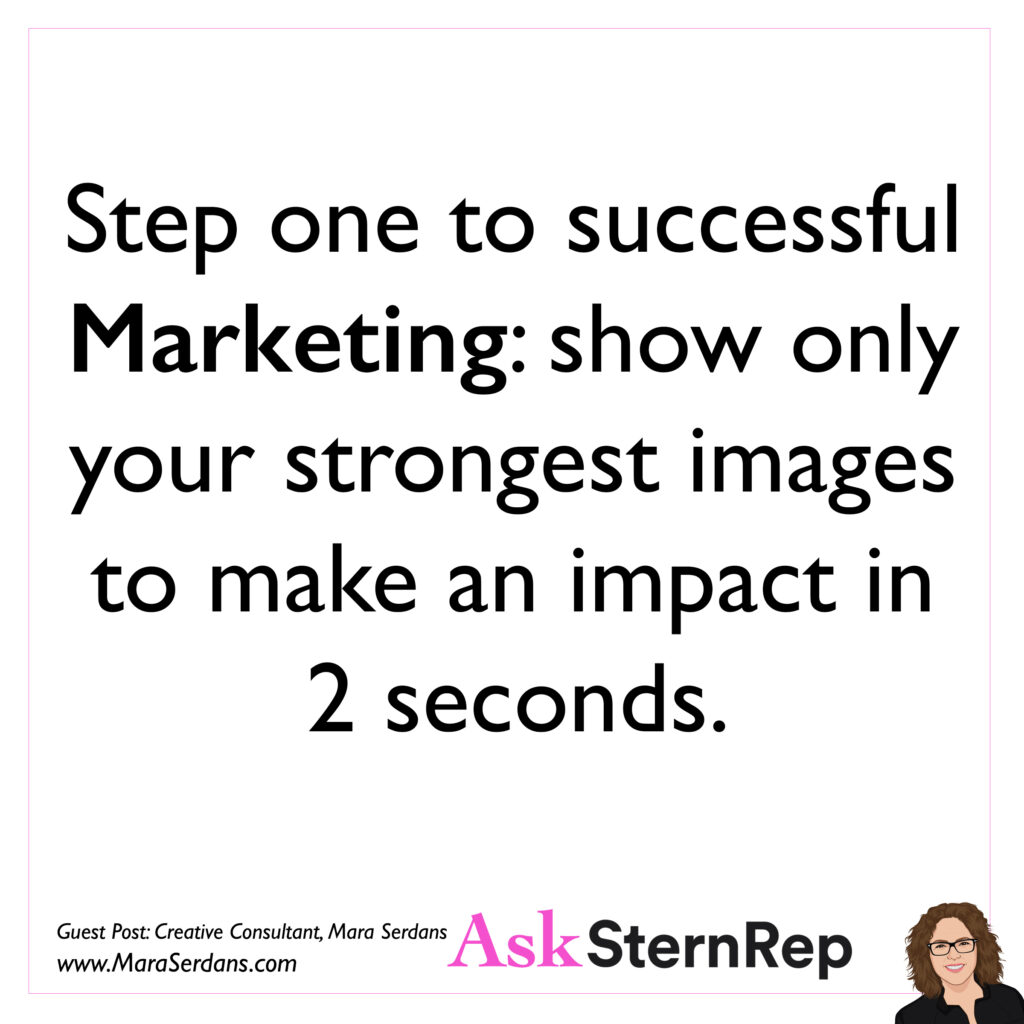
Step one to successful Marketing: show only your strongest images to make an impact in 2 seconds.
Guest Post: Creative Consultant, Mara Serdans
Looking for a New Photographer

Q:
What are you looking for in a new photographer?
A:
Guest Post, Jorge Perez: I want a photographer who has a business sense. There are a lot of artists out there who create beautiful art, but if they do not have a mind for business they will not make it.
I am looking for a partner in crime when it comes to their business.
You have to be your own agent first, get yourself work. It’s a red flag to me if someone has been shooting for 25 years and has never had a rep.
Guest Post: Jorge Perez, JP Reps
Know When To Be Patient

Sometimes, the best sales tool is to know when to be patient.
Seeking Representation
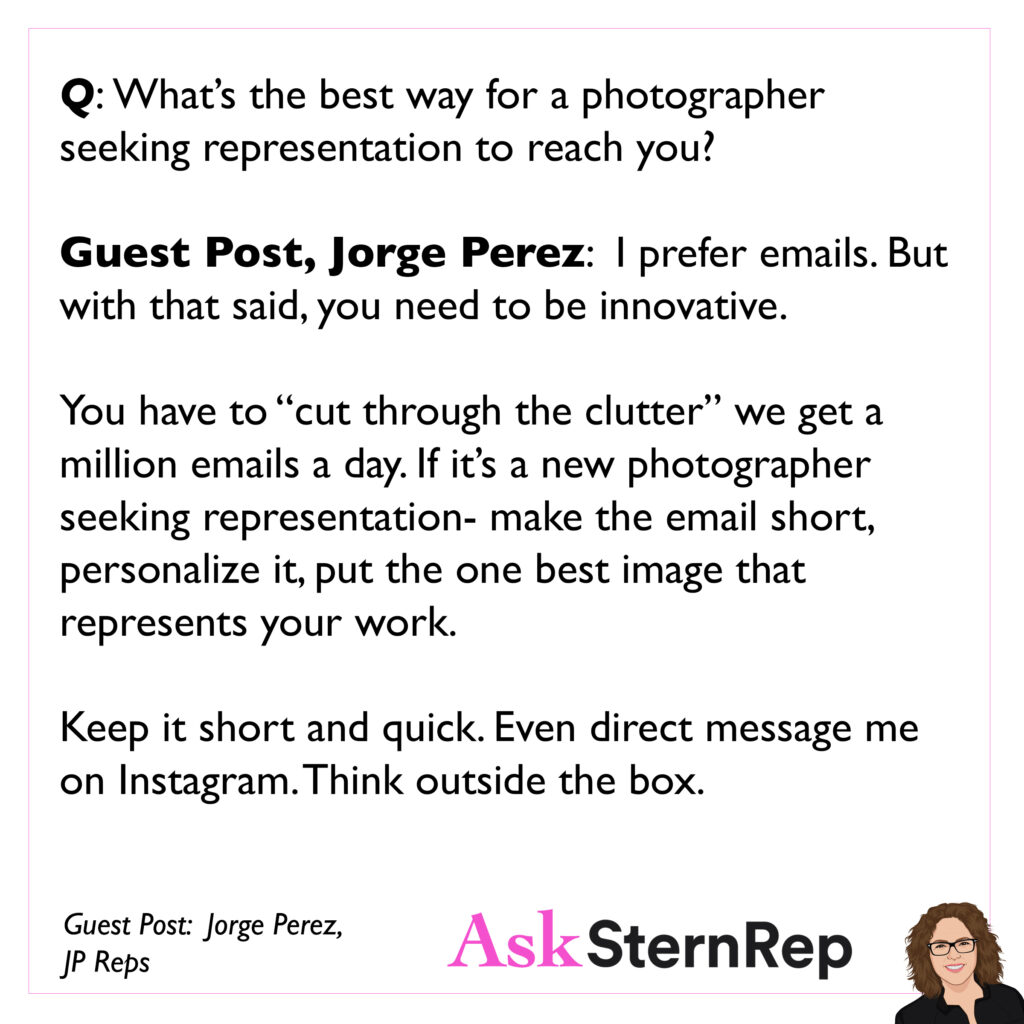
Q:
What’s the best way for a photographer seeking representation to reach you?
A:
Guest Post, Jorge Perez: I prefer emails. But with that said, you need to be innovative.
You have to “cut through the clutter” . We get a million emails a day. If it’s a new photographer seeking representation – make the email short, personalize it, put the one best image that represents your work.
Keep it short and quick. Even direct message me on Instagram. Think outside the box.
Guest Post: Jorge Perez, JP Reps
THE KEY TO SUCCESS
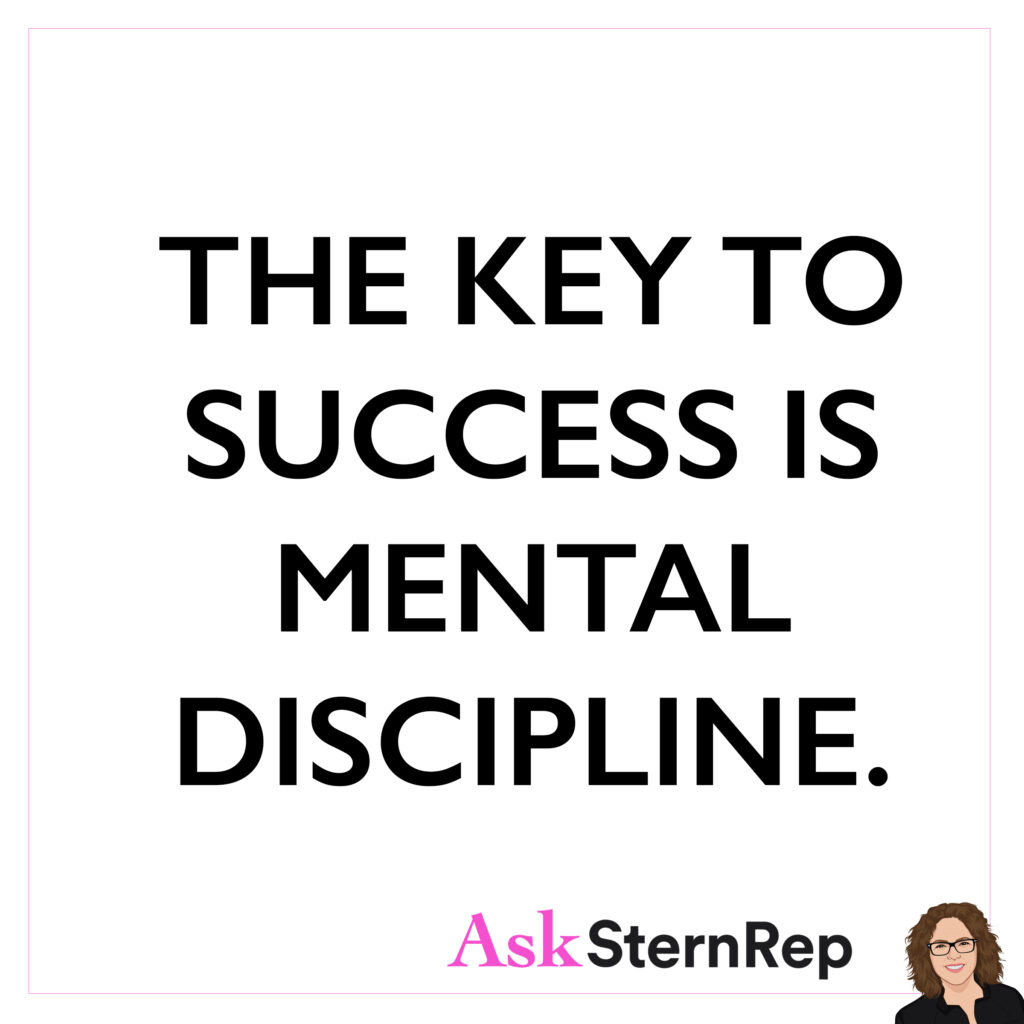
THE KEY TO SUCCESS IS MENTAL DISCIPLINE.
Appealing to Clients

Q:
Should I shoot portfolio work with the intention to appeal to certain kinds of clients?
A:
Paul Barshon: If you love the subject matter, then why not!? For example if you love shooting hyper-realism, there are a lot of commercial clients who primarily use this kind of photography. So why not focus on shooting portfolio work that focuses on hyper realism? Again, though, shoot what you love. That will garner the attention you are after.
Take Advantage Of Your Spare Time

Between jobs, take ADVANTAGE of the spare time by getting all your prep done. Be READY. Don’t postpone and wait until the last frantic minute. Get your bid forms ready, find your digital tech, get to know your retouchers, location scout, find your makeup artist, producer, etc
Contacting Brands for in House Marketing

Q:
How would I get in contact directly with brands for in house marketing? Who should I be looking for specifically and how can I find that person? Does Yodelist or Agency Access provide these contacts? Regarding Yodelist and Agency Access. Which do you use?
A:
In today’s market we now have so many more options of finding the right people. I would definitely suggest using Agency Access or Yodelist and then using all social media and LinkedIn. Look for creative (art director), art producer, or other terms that are a part of the marketing dept. Agency Access and Yodelist often do have those contacts. I have used both of these companies and they both seem to have solid information, sometimes one is better than the other.
Major In Business

When I meet young people who are interested in photography and they are going off to college, I usually tell them to major in business and do a fine art or photography minor.
Guest Post:
Karen McHugh, Samy’s Camera
Re-Use

Q:
What does “re-use” mean?
A:
Re-use is when an image is purchased to be used beyond its original licensing agreement. If this amount was not agreed upon in the original bid, the client will ask for a new price to use the image again based on the new usage they want to purchase.
Win Every Job You Bid On
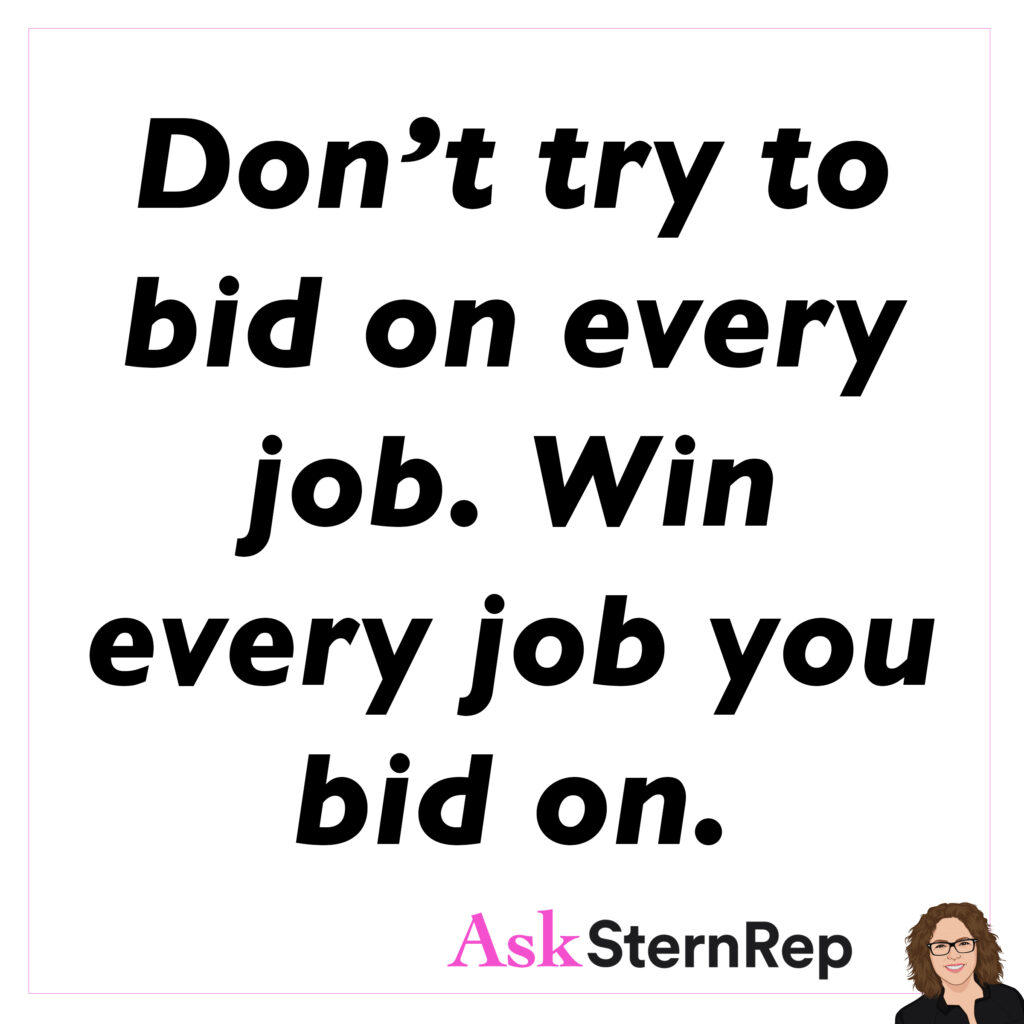
Don’t try to bid on every job. Win every job you bid on.
Selecting a Photographer

Q:
What factors make you want to put a particular photographer up for a job?
A:
Guest Post Mara Serdans: There are a few factors that come into play when recommending a particular photographer for a job. First and foremost, the photographer’s style is paramount. It needs to sync up with the art director’s vision. His/her level of experience is also a consideration. Where a photographer is located sometimes comes into play although many photographers these days are open to working as a local in larger markets. Lastly, budget is a factor. The photographer needs to fall within the ballpark to be considered a contender.
Guest Post: Creative Consultant, Mara Serdans
Learn the Lesson
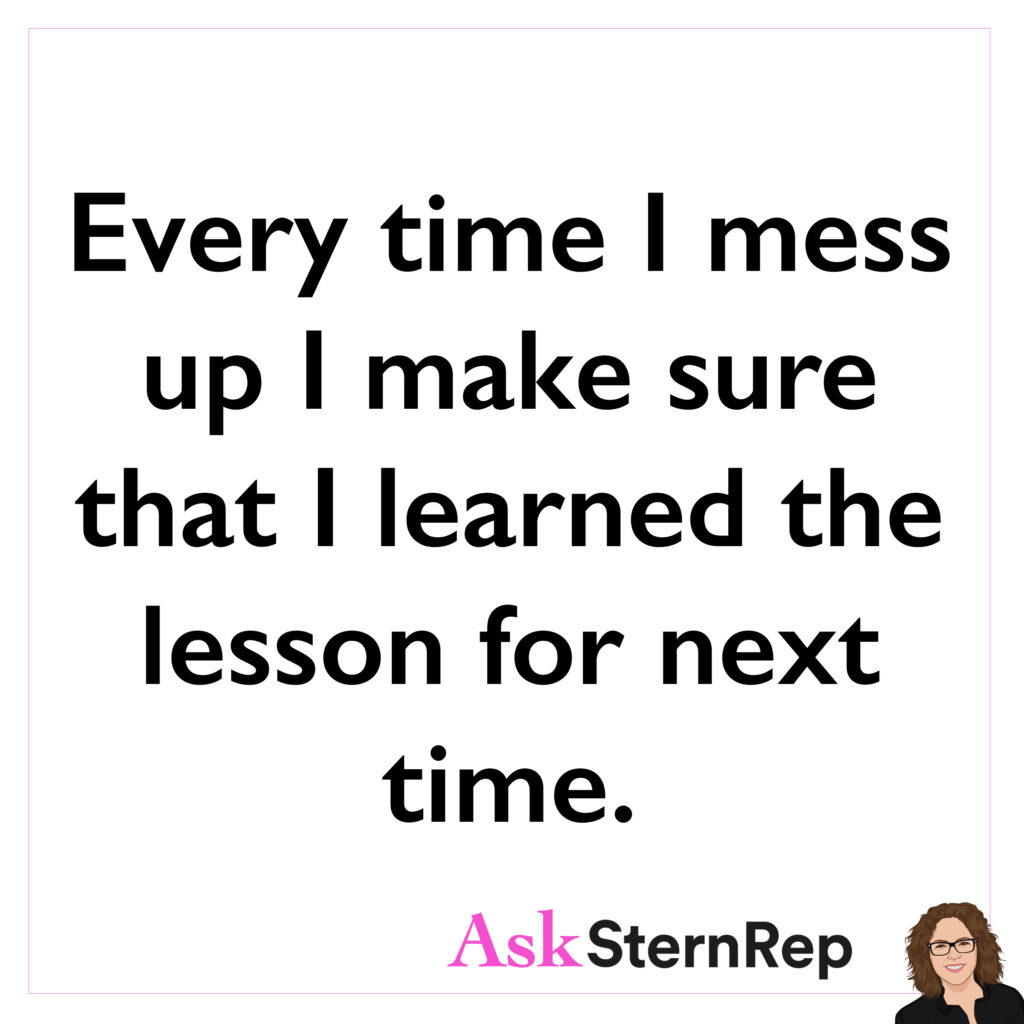
Every time I mess up I make sure that I learned the lesson for next time.
Finding Your Niche

Q:
I’m having trouble finding my place in this industry, do you have any advice for photographers who are still trying to find their voice and their niche?
A:
Paul Barshon: …and that will take a while to find. I found that when I started shooting, I shot loads of different subjects and tried different styles. Eventually I started focusing in one direction without even realizing it. There is always something that we most enjoy shooting and when we focus on this and try different techniques to find our specific style, this can eventually lead you to a career!
Delegate
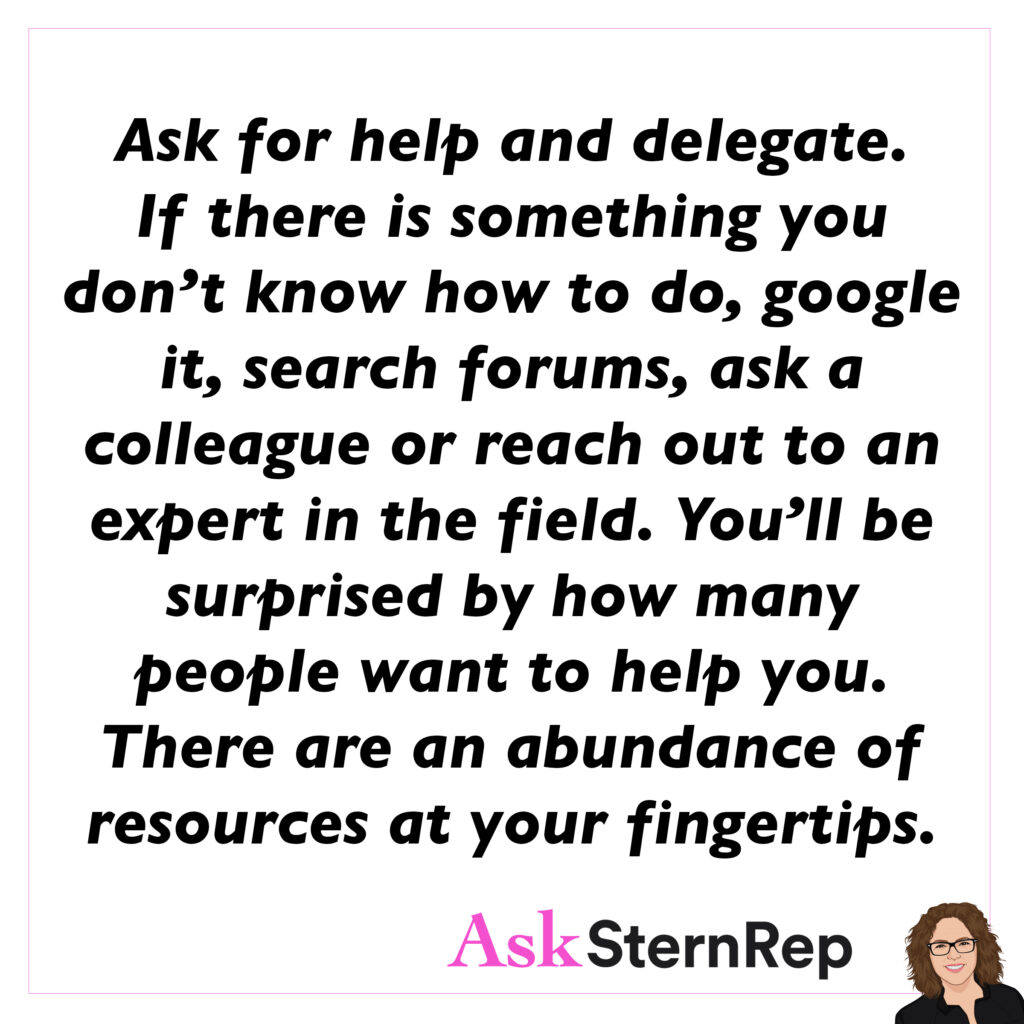
Ask for help and delegate. If there is something you don’t know how to do, google it, search forums, ask a colleague or reach out to an expert in the field. You’ll be surprised by how many people want to help you. There are an abundance of resources at your fingertips.
Hallmarks of a Great Photographer (Part 2)
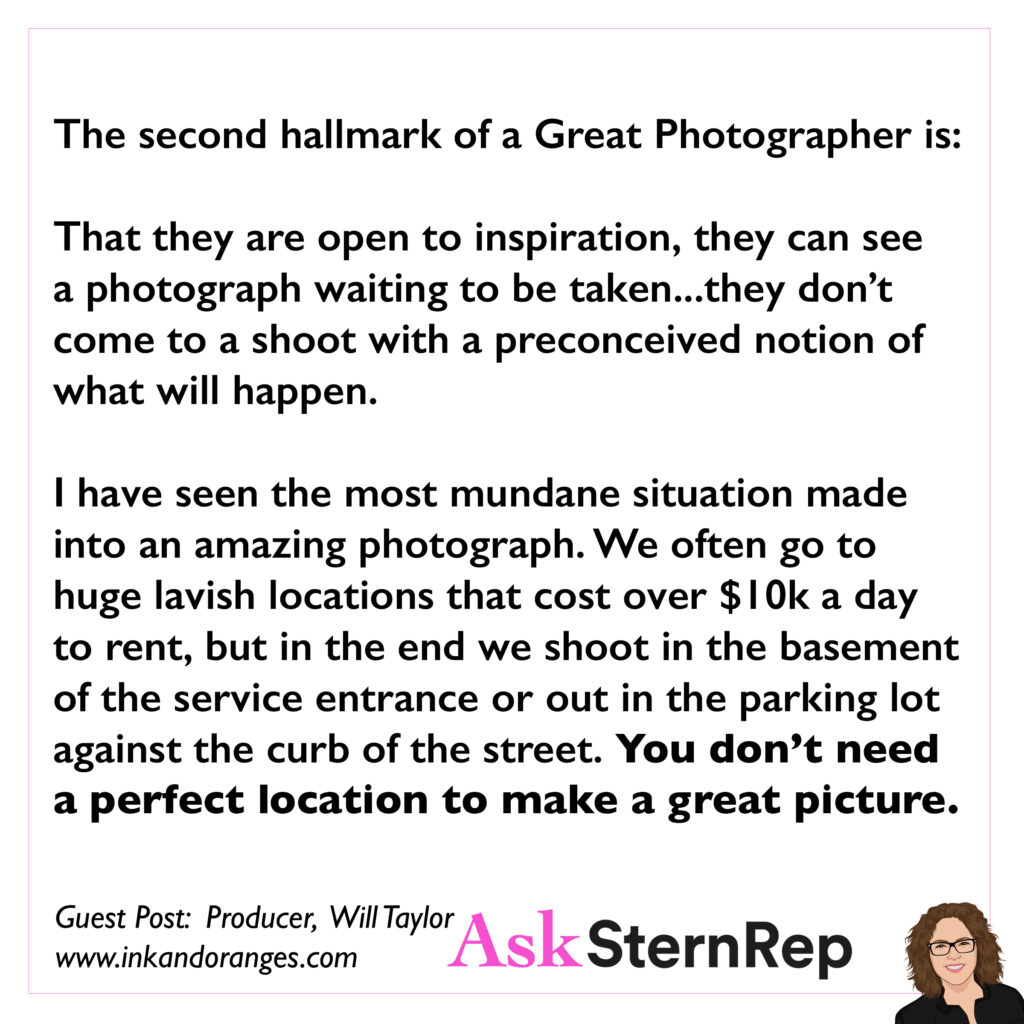
Q:
What are some hallmarks of a Great Photographer? (Part 2)
A:
The second hallmark of a Great Photographer is:
That they are open to inspiration, they can see a photograph waiting to be taken…they don’t come to a shoot with a preconceived notion of what will happen.
I have seen the most mundane situation made into an amazing photograph. We often go to huge lavish locations that cost over $10k a day to rent, but in the end we shoot in the basement of the service entrance or out in the parking lot against the curb of the street. You don’t need a perfect location to make a great picture.
Guest Post: Producer, Will Taylor
Your Portfolio

Your portfolio should not just be the jobs you have shot, it should be the jobs you want to shoot.
Advice on Marketing Strategies

Q:
Can you give us some advice about what we should be doing with our social media, website and marketing strategy in general?
A:
Guest Post, Art Producer: Social Media is very important these days, especially in the way clients are trying to reach their audiences. Hash-tagging can help to expand your discoverability, but of course it’s not the end all be all to becoming noticed.
Your website should be clean and easy to navigate, while also showcasing recent work to show you are still actively working/generating personal projects. I enjoy physical promos as well, but find they are most valuable when they come from the artist themselves (i.e. From a meet and greet).
Outside Your Box

Do something outside your box once a day.
PUSH Your Vision

Producer, Will Taylor:
Don’t misguide your efforts. Don’t worry about “what art directors want to see”. There is no guarantee that you will get the job based on trying to show them what you think they want to see, you might as well create great work that you are passionate about. But PUSH your vision.
You have an even better chance of getting a job if you are able to inspire the people who have the power to hire you. Shoot things for your portfolio that an art director will never have the freedom from the client, agency (and lawyers!) to shoot.
Guest Post: Producer, Will Taylor
www.inkandoranges.com
Always Have Your Website Link On Your Emails

Photographers, always have your website link on the bottom of your emails. Always.
Marketing Yourself
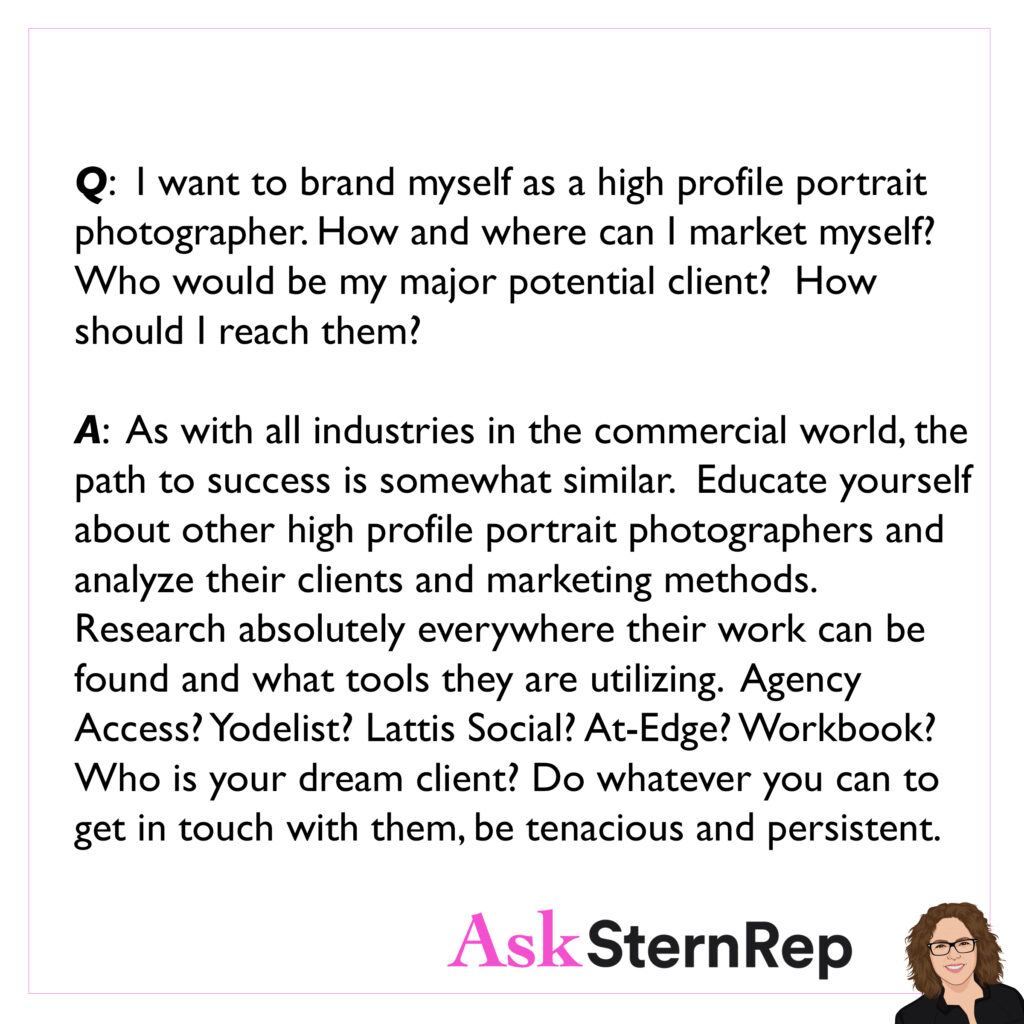
Q:
I want to brand myself as a high profile portrait photographer. How and where can I market myself? Who would be my major potential client? How should I reach them?
A:
As with all industries in the commercial world, the path to success is somewhat similar. Educate yourself about other high profile portrait photographers and analyze their clients and marketing methods. Research absolutely everywhere their work can be found and what tools they are utilizing. Agency Access? Yodelist? Lattis Social? At-Edge? Workbook? Who is your dream client? Do whatever you can to get in touch with them, be tenacious and persistent.
Source Books for New Photographers

Q:
Do you really look through source books for new photographers?
A:
Guest Post, Art Producer: I find source books useful when I need to break from the digital-format search engine, but I primarily use social media (Instagram, Tumblr, Pinterest) when searching for a specific kind of inspiration – especially if the brief is more open ended and still in blue sky stages. These platforms are very accessible while offering a way to focus in on the topics you’re trying to nail down.
Ask Questions

Ask questions instead of overloading your clients with information.
Website Design Elements

Q:
What are the 3 most important design elements to keep in mind when creating an impactful photography website?
A:
Rob Haggart, PhotoFolio: Your typeface, your logo, and your images are all that matter. The typeface should be modern, the logo should be minimal but professionally done, and the images should be the focus of the website. Art Directors love type and bad fonts can ruin great photography.
Emotional Reaction Does NOT = Business

Emotional reaction does NOT = Business
Hallmarks of a Great Photographer (Part 1)
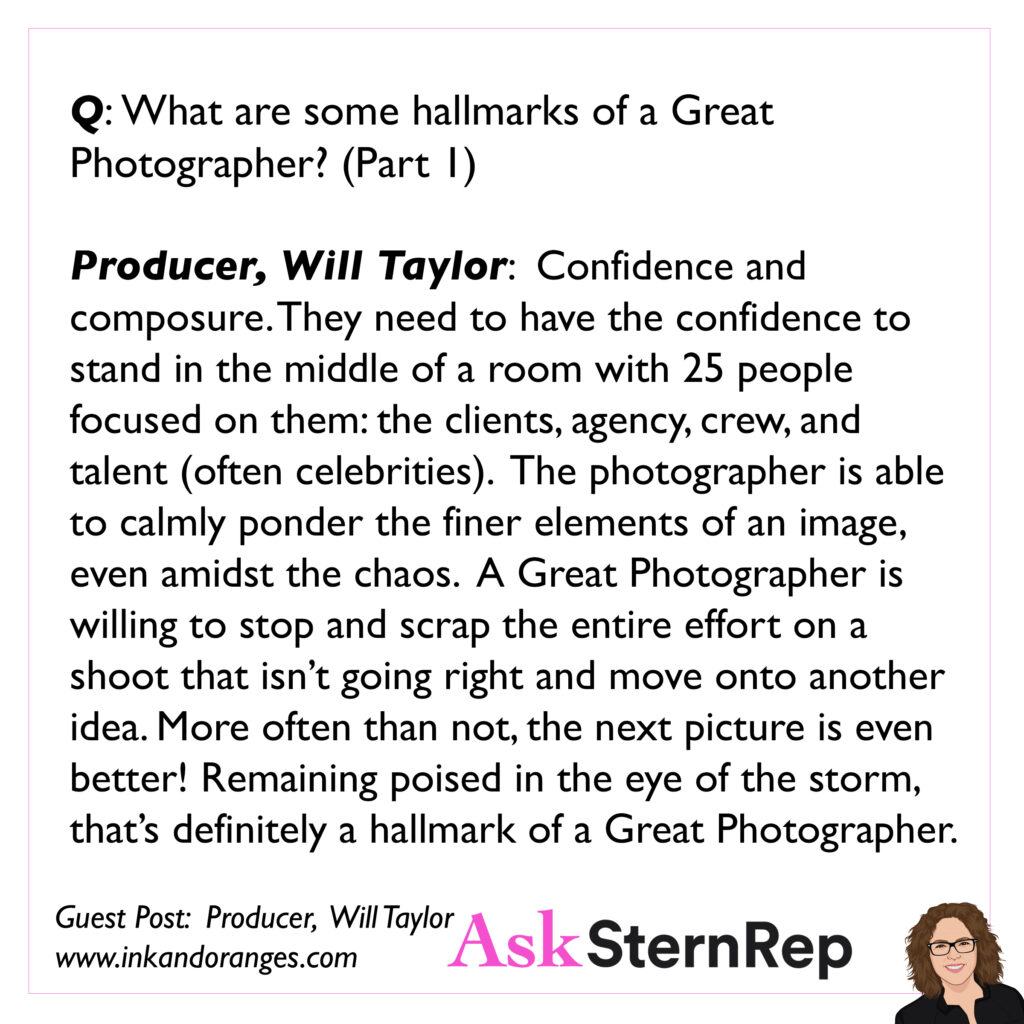
Q:
What are some hallmarks of a Great Photographer? (Part 1)
A:
Producer, Will Taylor: Confidence and composure. They need to have the confidence to stand in the middle of a room with 25 people focused on them: the clients, agency, crew and talent (often celebrities). The photographer is able to calmly ponder the finer elements of an image, even amidst the chaos. A Great Photographer is willing to stop and scrap the entire effort on a shoot that isn’t going right and move onto another idea. More often than not, the next picture is even better! Remaining poised in the eye of the storm, that’s definitely a hallmark of a Great Photographer.
Guest Post: Producer, Will Taylor
You Are A Business Owner

This is YOUR business. Do you have insurance? Are you tracking expenses and income? Do you have a business license? You are not just an artist anymore, you are a business owner, so take control and handle all necessary details.
Develop Your Style

Q:
How do I align my style/voice/aesthetic with clients? Or even figure out which market I best fit in?
A:
Paul Barshon: Stick with your style and the clients will come to you for your look. Trying to chase a style that’s in vogue at the moment always leaves you a step behind. It’s nice to look at other photographers to see what is new and look at new techniques, but your style is what will get you work. Stick with the subjects that you enjoy shooting – this will lead you to a place where the market will find you.
Know Your Audience

Best marketing tip: know your audience
The Right Photographer
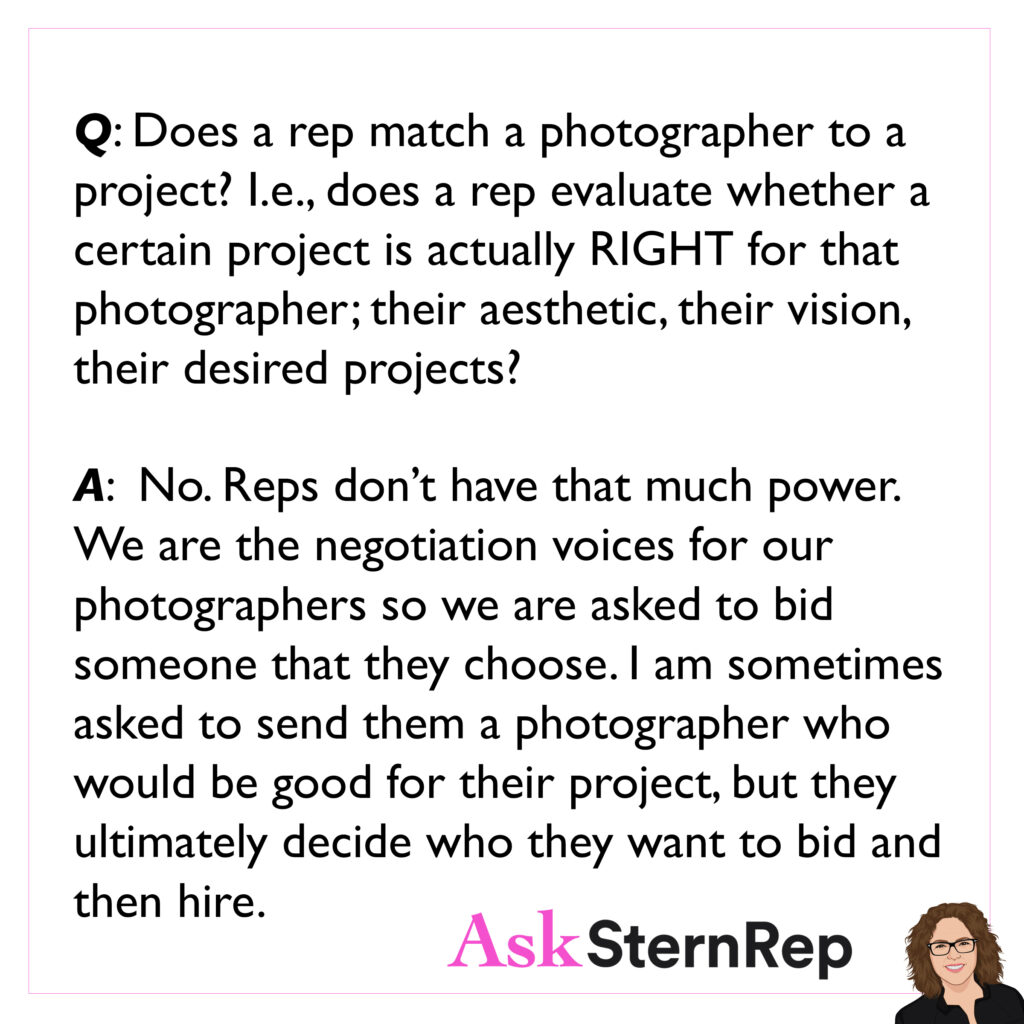
Q:
Does a rep match a photographer to a project? I.e., does a rep evaluate whether a certain project is actually RIGHT for that photographer; their aesthetic, their vision, their desired projects?
A:
No. Reps don’t have that much power. We are the negotiation voices for our photographers so we are asked to bid someone that they choose. I am sometimes asked to send them a photographer who would be good for their project, but they ultimately decide who they want to bid and then hire.
Never Blame Anyone Else

Never blame anyone else.
Engage your Audience
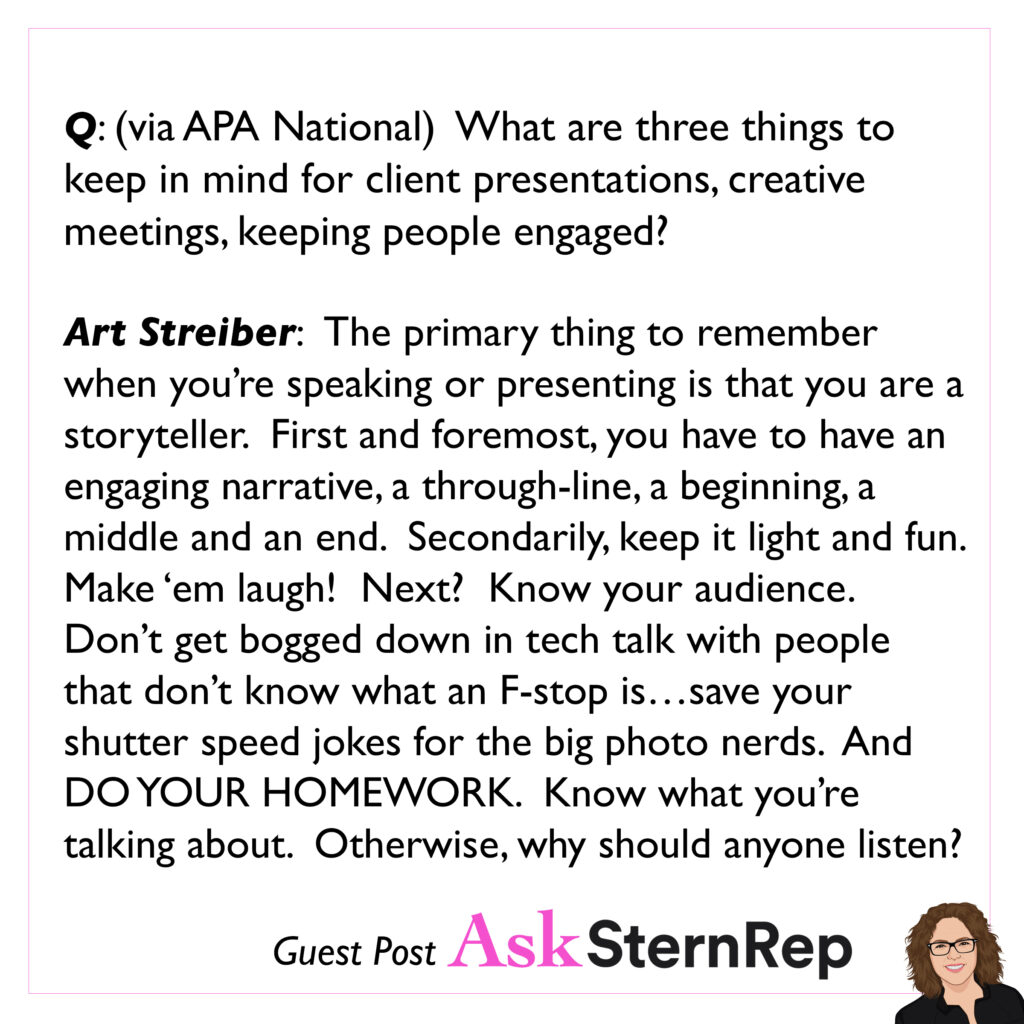
Q:
(via APA National) What are three things to keep in mind for client presentations, creative meetings, keeping people engaged?
A:
Art Streiber: The primary thing to remember when you’re speaking or presenting is that you are a storyteller. First and foremost, you have to have an engaging narrative, a through-line, a beginning, a middle and an end. Secondarily, keep it light and fun. Make ‘em laugh! Next? Know your audience. Don’t get bogged down in tech talk with people that don’t know what an F-stop is…save your shutter speed jokes for the big photo nerds. And DO YOUR HOMEWORK. Know what you’re talking about. Otherwise, why should anyone listen?
The Key To Getting More Out Of Your Rep

The key to getting more out of your rep is to supply them with fun new work. We are human! Excite us and we will run to the streets to show it off.
What Reps Look For
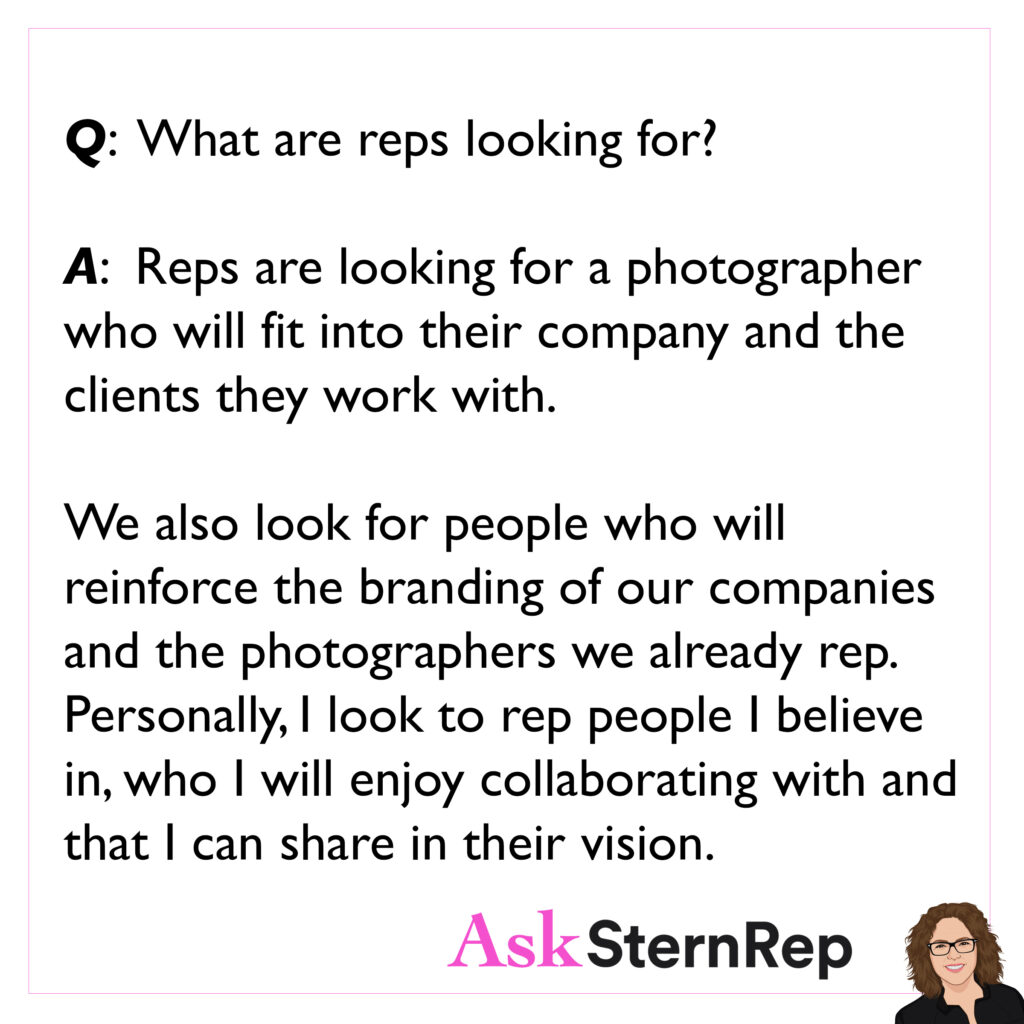
Q:
What are reps looking for?
A:
Reps are looking for a photographer who will fit into their company and the clients they work with.
We also look for people who will reinforce the branding of our companies and the photographers we already rep. Personally, I look to rep people I believe in, who I will enjoy collaborating with and that I can share in their vision.
TEST

Test, test, test, test, test, test,
test, test, test, test, test,
test, test, test, test,
test, test, test,
TEST
Assisting as a New Photographer

Q:
Do you think it’s important for a photographer to spend time assisting professional photographers before launching their own career? And if so, what kind of photographer should someone assist?
A:
This really depends on the photographer and what they need to learn. Some photographers never assist and end up wildly successful. But assisting can be extremely informative and build your confidence. If a photographer needs to learn what an editorial or commercial advertising job is like then they can assist any type of photographer in that market. If they need to learn more about the technicalities of shooting cars or people, then they should assist a photographer that does that kind of work. Figure out what you need to learn and assist in that. Or jump right in! There is no straight answer here…
Always Have A Signed Estimate

Trust me, always have a signed estimate that clearly describes what the bid is based on and what the licensed usage is. Be sure all costs are agreed on before beginning the job.
Designing a Website

Q:
What are some things to keep in mind when designing a website, as a photographer?
A:
Your website should look professionally designed and be easy to navigate. The site should immediately entice your visitor. This of who your audience is and use a web template like https://www.photofolio.com/ to speak their language.
GET IT DONE.

GET IT DONE.
Portfolios + Reps

Q:
What is considered a standard “book” for somebody seeking representation… is it a website? A physical book? Something else?
A:
The standard book question does not have one absolute answer but it is good to have a website, an active Instagram presence, and a printed book. An iPad can be your portfolio although right now printed books are the hot item.
Reps’ Percentage

Q:
What kind of percentage do reps typically take?
A:
25% of the photographer’s day rate or creative fee
Be Your Own Director
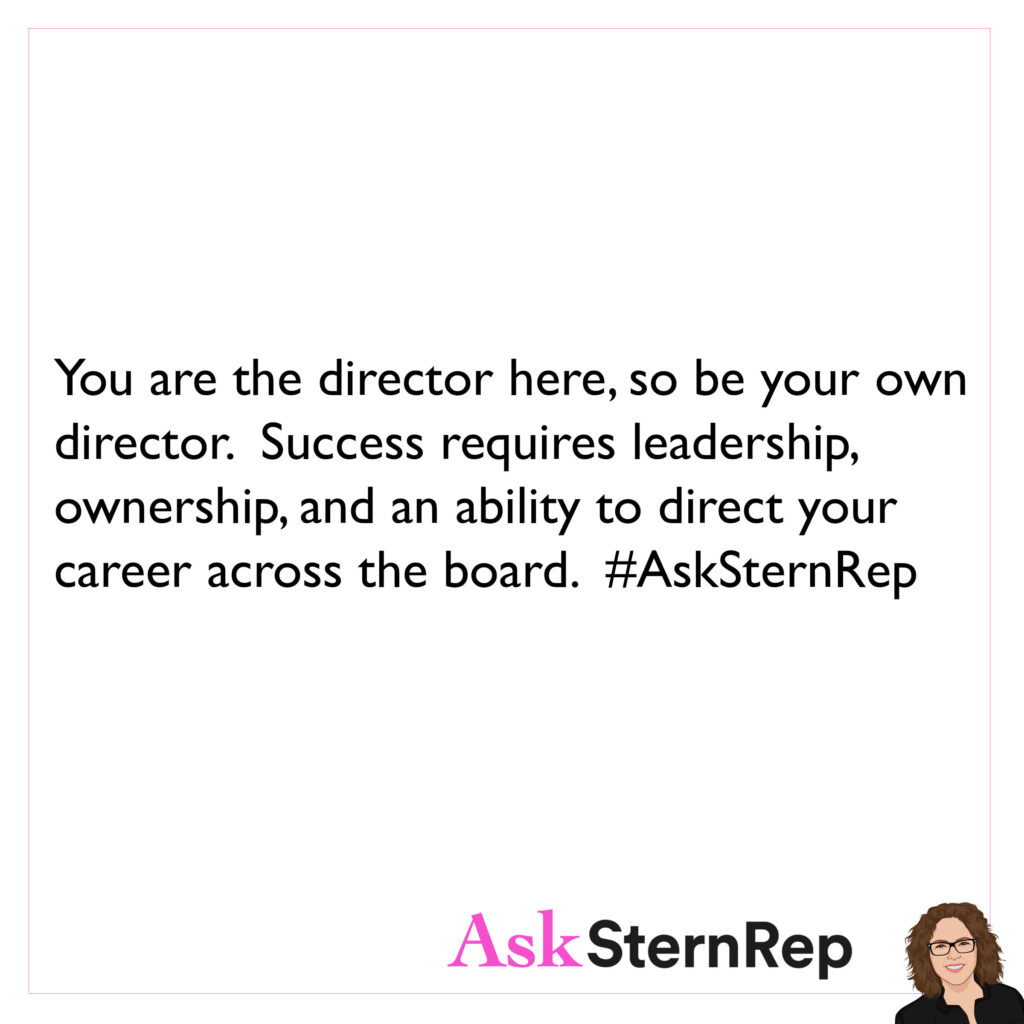
You are the director here, so be your own director. Success requires leadership, ownership, and an ability to direct your career across the board.
Think Of Your Audience

Sometimes the more you say, the less you will be heard. Think of your audience and how much time they have to read an email.
Treat others how you want to be treated. How much time do you have to read an email or take a phone call?
Have an Amazing Creative Call
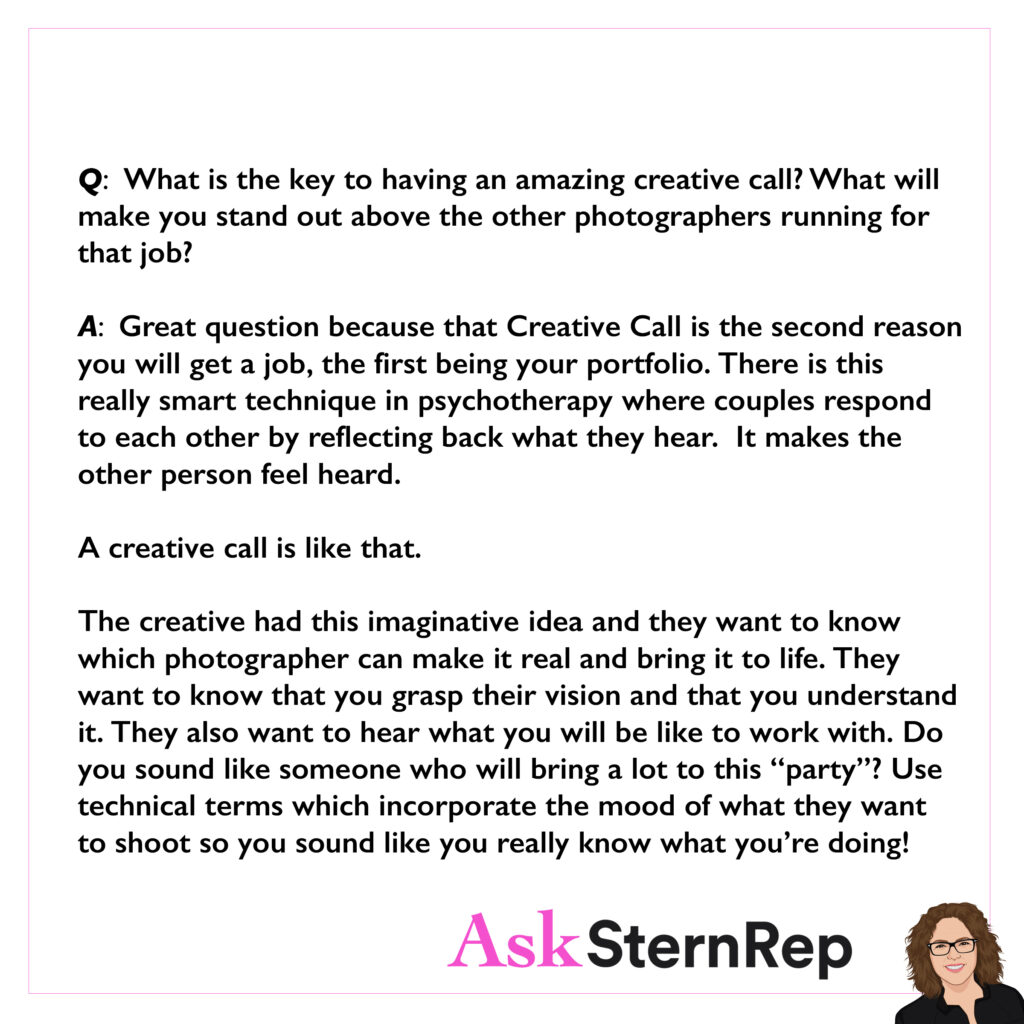
Q:
What is the key to having an amazing creative call? What will make you stand out above other photographers running for that job?
A:
Great question because that Creative Call is the second reason you will get a job, the first being your portfolio. There is this really smart technique in psychotherapy where couples respond to each other by reflecting back what they hear. It makes the other person feel heard.
A creative call is like that.
The creative had this imaginative idea and they want to know which photographer can make it real and bring it to life. They want to know that you grasp their vision and that you understand it. They also want to hear what you will be like to work with. Do you sound like someone who will bring a lot to this “party”? Use technical terms which incorporate the mood of what they want to shoot so you sound like you really know what you’re doing!
Fear Cannot Run The Show
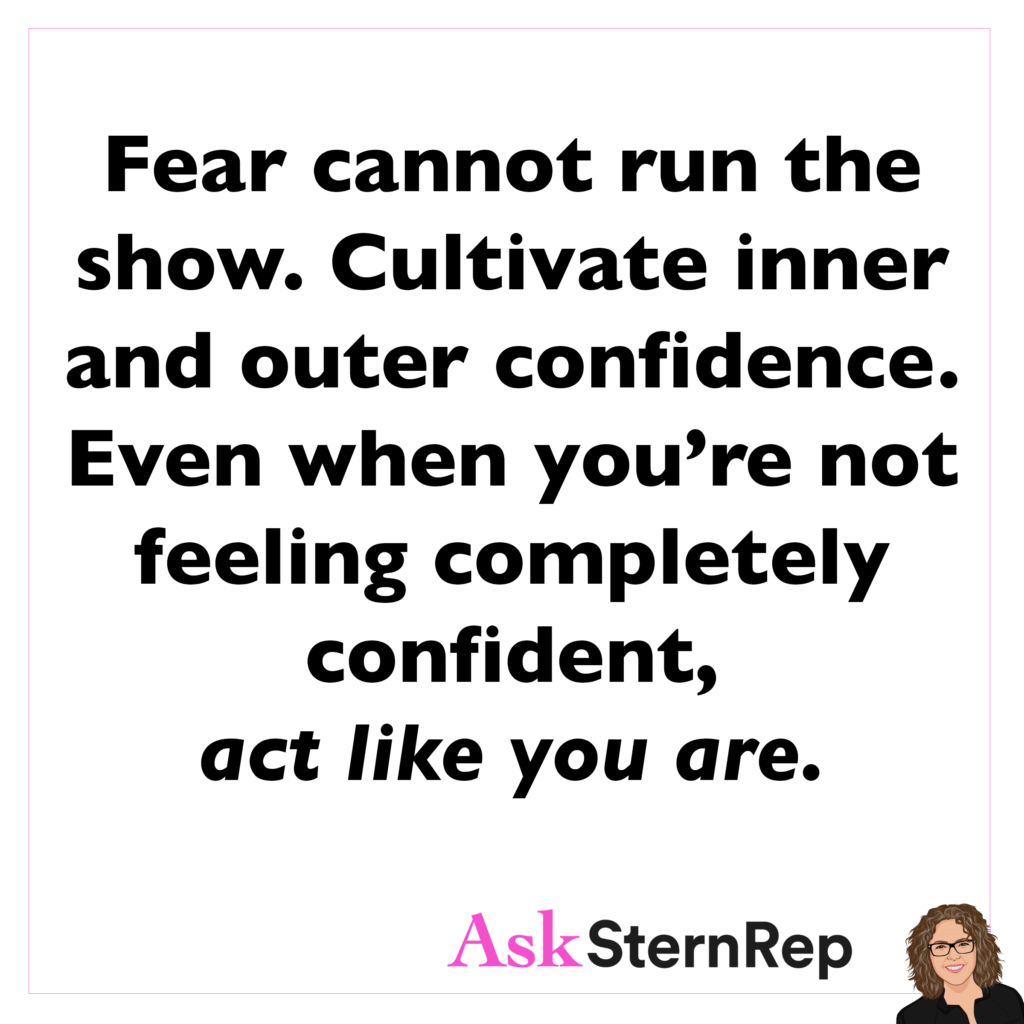
Fear cannot run the show. Cultivate inner and outer confidence. Even when you’re not feeling totally confident, act like you are.
Successful as a Creative

Q:
What is the secret to being successful as a creative?
A:
It is to be open to listening instead of being so busy with everything you already know.
Marketing Strategies
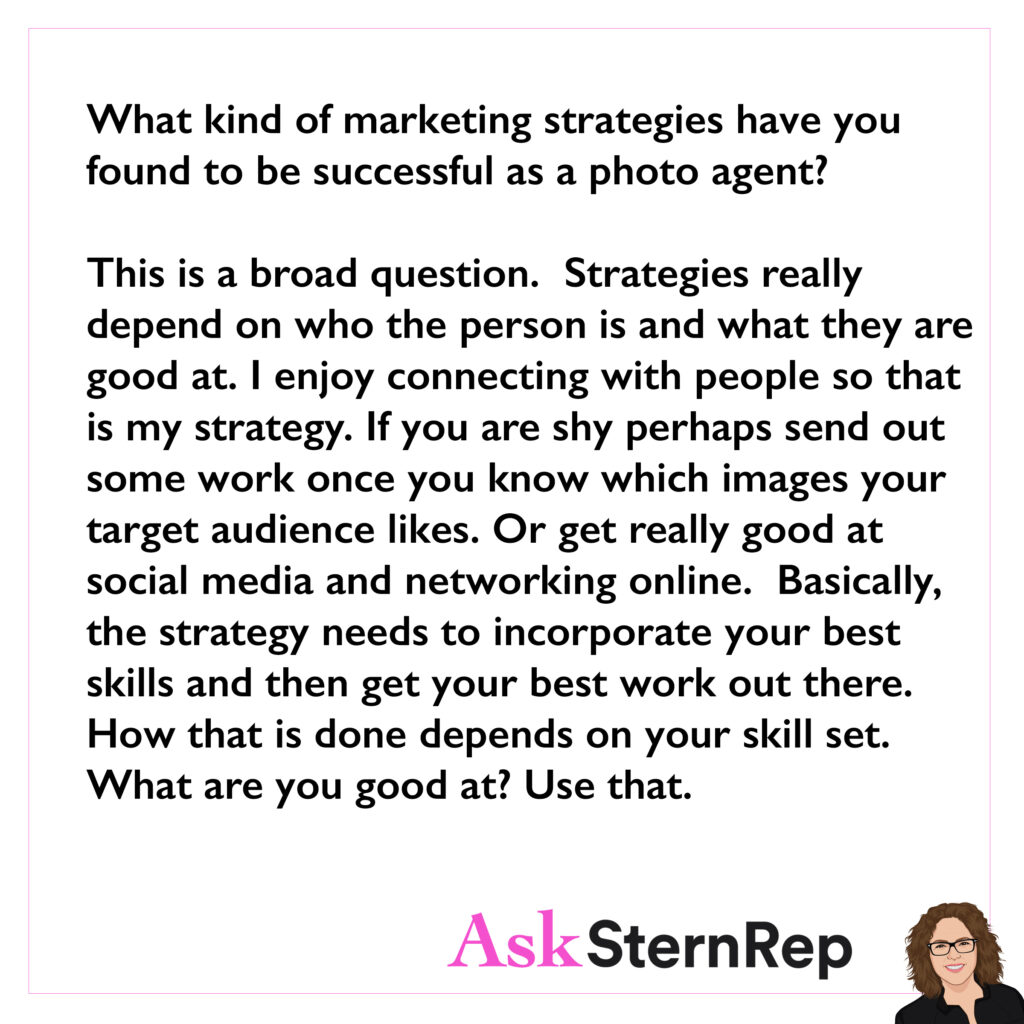
Q:
What kind of marketing strategies have you found to be successful as a photo agent?
A:
This is a broad question. Strategies really depend on who the person is and what they are good at. I enjoy connecting with people so that is my strategy. If you are shy perhaps send out some work once you know which images your target audience likes. Or get really good at social media and networking online. Basically, the strategy needs to incorporate your best skills and then get your best work out there. How that is done depends on your skill set. What are you good at? Use that.
How to Become Represented

Q:
How can I become represented? It’s always been a dream to stand out and have reps on my side.
A:
Get your book as strong as you can, find your specialty and build a cohesive portfolio. Find the reps that work in your industry and approach them with a personal and quick email. The quality of your work will speak for itself and doors will open. Just get your work out there once it’s ready!
Test With Purpose

Test with purpose.
Who is the client you want to target? What is the feeling you want to achieve? What are you selling and how are you using styling, lighting, models, and the right environment to target your desired audience and get the point across?
The Importance of Treatments

Q:
I would like to hear about the importance of treatments. What is a treatment? Do photographers create their own treatment? What needs to go into it and what should it look like?
A:
A great treatment is one of the 3 keys to getting the photographer the job. 1. Is the portfolio of course 2. Is the creative call and 3. Is the treatment.
A treatment is a pdf full of all the info to show the creative how the photographer will approach the job. It will include samples of images, locations, talent, wardrobe, etc.
Yes, photographers create their own treatment and I have to say, it’s like getting their teeth pulled. They are not writers and normally their portfolio speaks for them So this takes a sales type of showing off that photographers are uncomfortable with in general.
It needs to look slick and put together because the creative will read this to know what the photographer is bringing to the “party,” how they work, how they see this job, and how well they can deliver a packaged expression of their work.
Do What You’re Good At
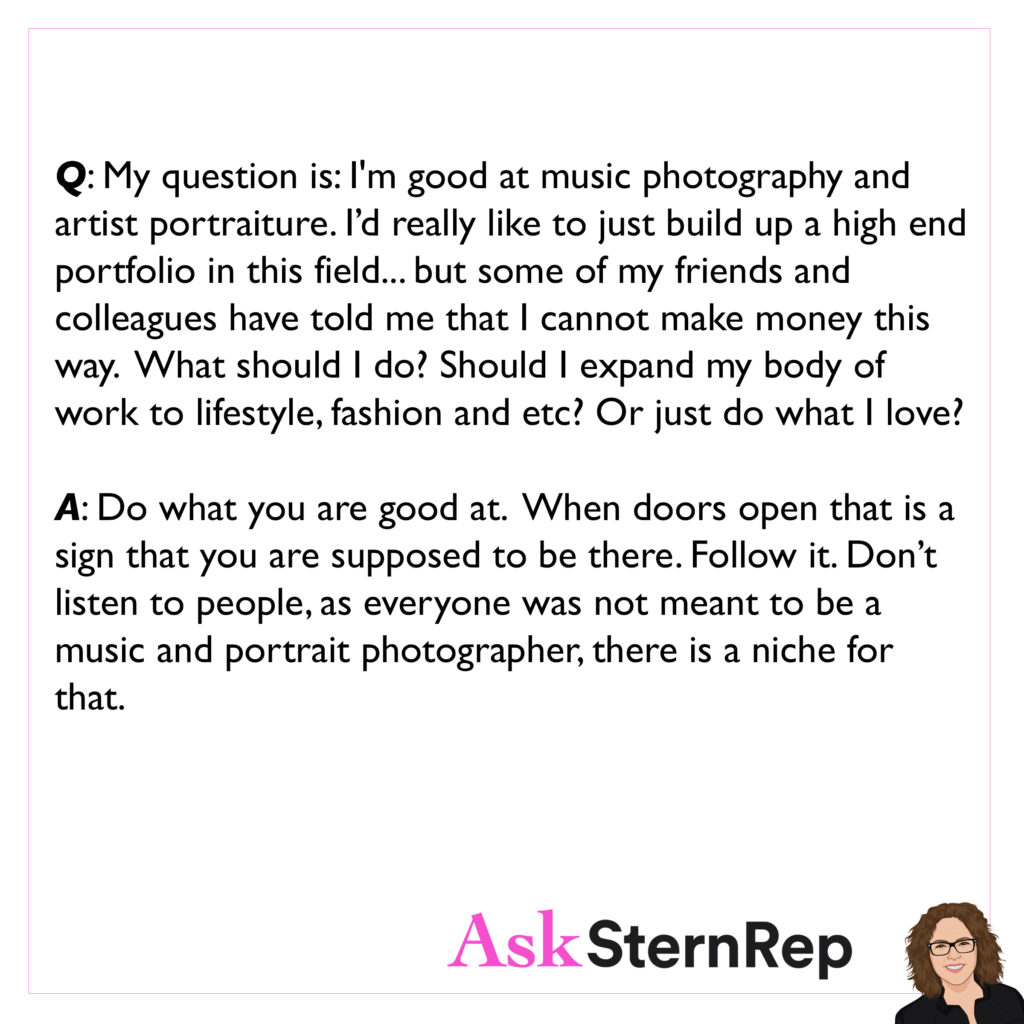
Q:
My question is: I’m good at music photography and artist portraiture. I’d really like to just build up a high end portfolio in this field… but some of my friends and colleagues have told me that I cannot make money this way. What should I do? Should I expand my body of work to lifestyle, fashion, etc? Or just do what I love?
A:
Do what you are good at. When doors open that is a sign that you are supposed to be there. Follow it. Don’t listen to people, as everyone was not meant to be a music and portrait photographer, there is a niche for that.



